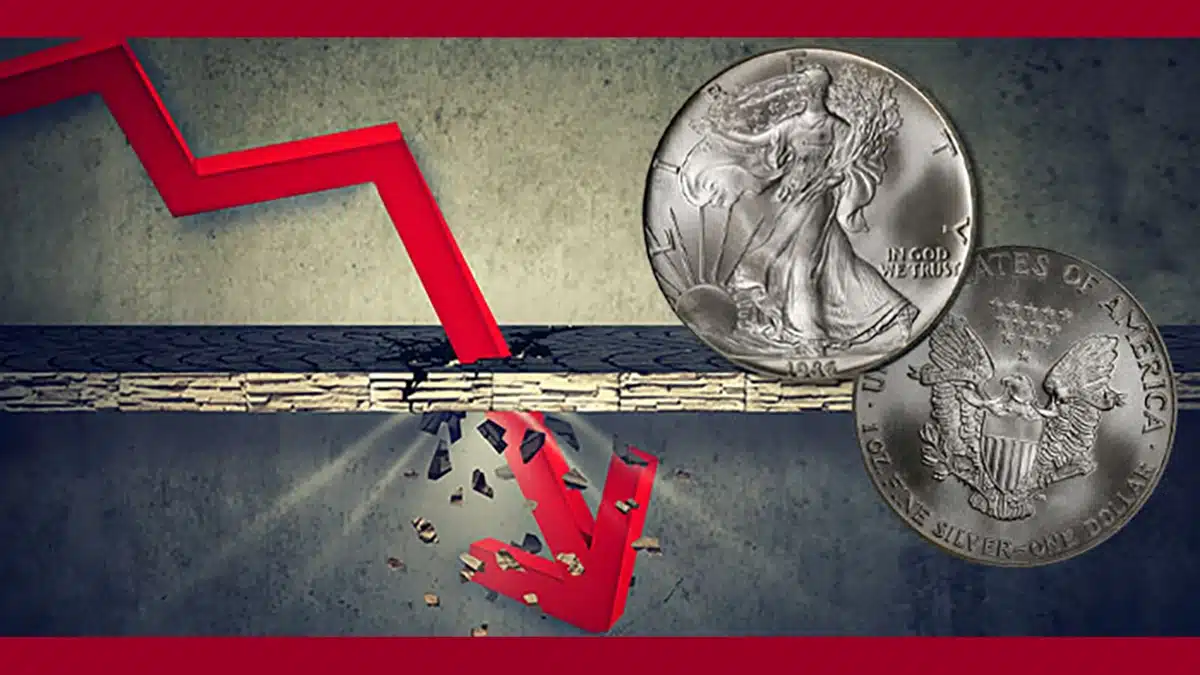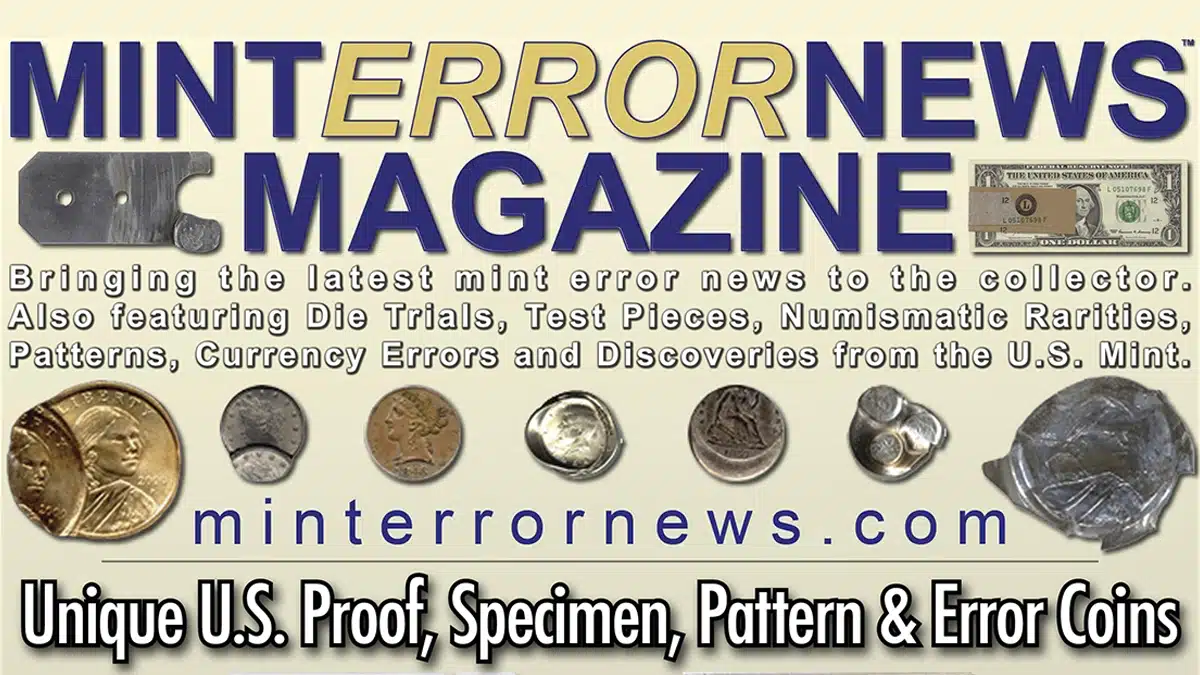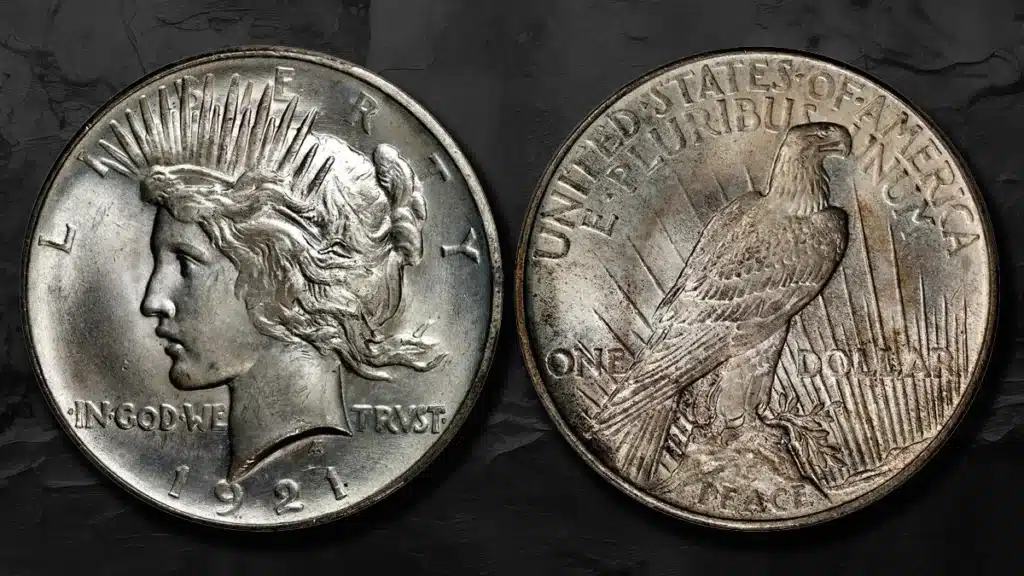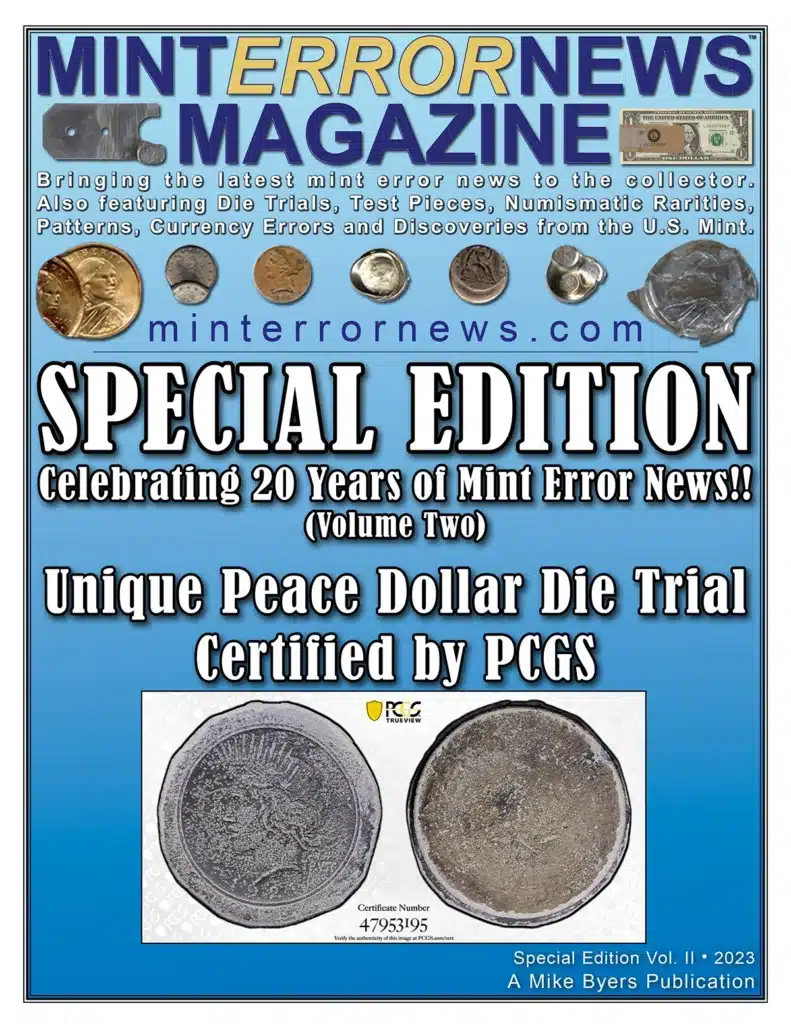Last week, on April 23, the U
James A. Garfield Presidential Silver Medal for $75
Crafted from 1 ounce of
First PCGS-Certified Gold TiffCoin by Tiffany & Co. in GreatCollections Auction
An 18k Gold TiffCoin by Tiffany & Co
2025 American Liberty Gold Coin and Silver Medal Candidate Designs Unveiled
The United States Mint unveiled an array of possible designs for the 2025 American Liberty Gold Coin and Silver Medal
Bob R. Simpson Collection, Part XII, Featured in Heritage’s CSNS US Coins Auction
There is ample reason why people refer to a “gift that keeps on giving
Clark Smith, Jr., Takes Helm at Gold Hill Coin At Gold Hill Coin, One Of Northern California’s Oldest Coin Stores
A change in ownership at Gold Hill Coin (www
US Mint Sales: Proof Products Dominate
Last week, with no new products released by the U
2024 Kennedy Half Dollars Released for Collectors
Coins honoring the 35th President of the United States, John F
2025 Marine Corps 250th Anniversary Commemorative Coin Designs Recommended
The United States Mint revealed over sixty potential designs for commemorative coins that recognize the 250th anniversary of the U
First Quarter 2024 Sees U.S. Mint’s Coin Production Plummet to 1.73 Billion, Lowest Since 2010
The United States Mint produced just over 1
March Australian Bullion Sales Turn Down, Perth Mint Reports
In March, demand for Australian bullion slowed down, data from The Perth Mint of Australia shows
US Mint Sales: Alabama Innovation $1 Rockets to Strong Debut
Last week, on April 8, the U
2026 Native American $1 Coin Candidate Designs Depict Oneidas at Valley Forge
On Monday, April 15, the United States Mint revealed 14 potential designs for the 2026 Native American $1 Coin, gearing up for their assessment before the Citizens Coinage Advisory Committee (CCAC) on April 16 and the Commission of Fine Arts (CFA) on April 18
Donivan Floyd of Idaho Wins 2024 PNG Scholarship
A young numismatist from Coeur D’ Alene, Idaho, Donivan Floyd, 19, is the winner of the 2024 Professional Numismatists Guild’s (www
Top-Tier Sovereigns Among Rarities Featured at Heritage’s May CSNS World & Ancient Coins Auction
One of the finest collections of high-end Sovereigns to come to market in the last decade will shimmer in the spotlight when the collection of Ayden Ezen is sold in Heritage’s CSNS World & Ancient Coins Platinum Session and Signature® Auction May 8-10
CCAC to Review Designs for 2025 Marine Corps Coins and 2026 Liberty Products
The Citizens Coinage Advisory Committee (CCAC) will hold a two-day public meeting on April 16 and 17 to review and discuss candidate designs for multiple medals and coins
US Mint Sales: New Quarters Set Leads, Followed by Other Silver Products
Last week, the United States Mint started selling their 5-coin set of silver 2024 quarters honoring Rev
Rosie the Riveter Bronze Medals Now Available
The United States Mint has started selling Rosie the Riveter bronze medals, which are now available in 1
Chapman Collection of Century-Old $1 Gold Coins Revealed
A previously unreported, nearly complete date set of 19th-century United States $1 denomination gold coins assembled by legendary Philadelphia dealer Henry Chapman has been revealed by Matador Rare Coins (www
Heritage’s March US Coins Auction Tops $6.2 Million
A rare 1921 Saint-Gaudens Double Eagle, MS62 PCGS sold for $144,000 to lead Heritage’s March 28-31 US Coins Signature® Auction to $6,241,741
2024 American Innovation Dollar for Alabama Released
Celebrating the invention of the Saturn V rocket in Alabama and its importance to NASA’s Apollo space program for human exploration to the Moon, the United States Mint today at noon ET releases the newest strike in its American Innovation® $1 Coin Program
2024 $20 Royal Canadian Air Force Centennial Silver Coin Released
2024 marks 100 years since a professional air force was created for the defence of Canadian freedom and sovereignty
CoinWeek Podcast: Franklin Half Dollars and 1950s-1970s Proofs.
https://www.youtube.com/watch?v=ZTd2pyhpHSk
Errors in U.S. Mint’s 2024 Proof Set COA
Those who bought and received the U
US Mint Sales: Patsy Mink Quarters Debut
Last week, the United States Mint began selling rolls and bags of 2024 Patsy Takemoto Mink quarters
2024 Quarters Celebrating U.S. Women in Silver Proof Set
The newest product from the United States Mint is the 2024 American Women Quarters Silver Proof Set™, which features five new 99
Silver Proof Sets and Alabama $1 Highlight U.S. Mint Products for April
April will be a busier month for the United States Mint, with four days designated for the release of seven numismatic products, compared to March, when only two days featured releases
Ghost Army Bronze Medals Now Available
The United States Mint has started selling Ghost Army bronze medals, available in 1
Patsy Takemoto Mink Quarters Available in U.S. Mint Rolls and Bags
Rolls and bags of the newest coin from the United States Mint go on sale today at noon ET with the release of the 2024 Patsy Takemoto Mink quarter
US Mint Sales: 2024 Proof Set Holds Top Spot, Greatest Generation Dollar Follows
The 10-coin clad 2024 Proof Set maintained its top sales position at the U
Ending Soon: Intro Pricing for Greatest Generation Commemorative Coins
The chance to pre-order the U
2024 Patsy Takemoto Mink Quarter Enters Circulation on March 25
On Monday, March 25, the United States Mint will begin shipping 2024 Patsy Takemoto Mink quarters to Federal Reserve Banks and their coin terminals for distribution into circulation
U.S. Mint Produces 644.86 Million Coins for Circulation in February
In February, the pace of striking U
Perth Mint Bullion Sales Rebound Strongly in February
In February, there was a rebound in demand for Australian bullion, as shown by data from The Perth Mint of Australia, with sales of silver products reaching a four-month peak, while sales of gold products reached a three-month high after approaching a four-year low
US Mint Sales: 2024 Proof Set Starts at 198,409
Sales figures for the clad 2024 Proof Set from the early days of its release are now available
Heritage’s March 28-31 US Coins Auction Includes Rare 1929 Double Eagle
After the conclusion of World War I, most Americans became accustomed to using the more convenient paper currency after no gold coinage was issued between 1917 and 1919, and no silver dollars since 1904
DLRC & D.L. Hansen Unveil Sale of Historic U.S. Coin Collection
DLRC and Dell Loy Hansen are excited to announce the sale of coins from the D
The Cherrypickers’ Guide, Volume III Coming Soon, Part II Has Landed
Whitman® announces the release of a second print run of the Cherrypickers’ Guide to Rare Die Varieties: Volume II, 6th Edition
US Mint Sales: 2024 Liberty & Britannia Ending Results, Greatest Generation Update
Last week, the United States Mint did not release any new products, resulting in a lack of items with truly explosive sales
U.S. Mint’s 2024 Proof Set: 10 Coins Including 6 Unique 1-Year Designs
One of the most eagerly awaited annual products from the United States Mint becomes available today at noon ET with the release of the 2024 Proof Set, priced at $35
U.S. Mint Welcomes 25 New Artists to Its Roster
Today, March 12, the United States Mint announced the selection of 25 new artists for its Artistic Infusion Program (AIP)
Century-Old Rolling Mill to Strike Souvenir 1652 Pine Tree Shillings at 2024 CSNS Show
Visitors can see $100 million of historic money and buy and sell rare coins, paper money, and gold and silver bullion with hundreds of professional dealers from the Midwest and across the country at the Central States Numismatic Society convention (www
MyCollect Launches Guess the Grade™ Coin Game
MyCollect is thrilled to announce the official launch of Guess the Grade™, an online interactive game where members can grade coins online and compete with other numismatists
Final Hours for Liberty & Britannia Gold Coin and Silver Medal
Just hours are left before sales end for the 2024 Liberty & Britannia Gold Coin and Silver Medal, a pair of collectibles described as a “First-Of-Its Kind Design Collaboration” between the world’s two largest mints, the United States Mint and Britain’s Royal Mint, and their Chief Engravers
US Mint Sales: Greatest Generation Coins and Proof Quarters Debut
Last week, the United States Mint introduced several new products, including commemorative coins honoring the service and sacrifice of American soldiers and civilians during World War II and a set of proof quarters celebrating the accomplishments made by American women
CSNS Honors Dennis Tucker With 2024 Q. David Bowers Award
The Central States Numismatic Society (www
Dual-Dated 1776~2026 Cent and Nickel Recommended for Semiquincentennial
Dual-dated Lincoln cents and Jefferson nickels have been recommended as a part of the United States’ 250th anniversary celebration in 2026, with circulating coins set to undergo redesign solely for that year
“Best of the Mint” 2026 Semiquincentennial Gold Coins Revealed
As part of the celebration of the semiquincentennial founding of America, in 2026, the United States Mint will issue redesigned circulating coins and offer “Best of the Mint” gold coins and silver medals
U.S. Mint Produces 756 Million Coins for Circulation in January
The pace of striking U
Gold Wraps Up February Near a 1-Month High
On Thursday, most precious metals saw gains, yet they all experienced declines for the month
Pre-Ordering Begins for 2024 Greatest Generation Commemorative Coins
Debuting today from the United States Mint are six coins issued as part of the 2024 Greatest Generation Commemorative Coin Program
US Mint Sales: Significant Drops in Multiple 2024 Products
Last week saw no new product launches from the U
Gold Prices Slip Slightly on Wednesday, Feb. 28
On Wednesday, prices for gold, silver, and platinum declined following their prior day’s gains, while palladium registered its third consecutive loss
Gold and Silver Rise Slightly on Tuesday, Feb. 27
On Tuesday, the prices of precious metals rose for gold, silver, and platinum, while palladium experienced a decline
PNG Embraces Incoming and Returning Members
The Professional Numismatists Guild (www
U.S. Mint Releases 2024 American Women Quarters Proof Set
Five collector’s grade quarter dollars are showcased together in the newest product debuting today from the United States Mint: the proof set of 2024 American Women Quarters
Design Candidates Unveiled for 2026 Semiquincentennial Lincoln Cent and Jefferson Nickel
In 2026, the United States will celebrate the 250th anniversary of its founding
Gold, Silver and Other Precious Metals Fall on Monday, Feb. 26
Precious metals kicked off the new trading week on Monday with losses, especially sharp ones for silver, platinum, and palladium
Gold and Palladium Post Weekly Gains
Precious metals gained on Friday, boosting weekly increases for gold and palladium and reducing weekly losses for silver and platinum
U.S. Mint Bullion Coin Revenue Falls 12.8% in FY 2023
The United States Mint’s bullion program saw higher sales volumes but lower revenue during the fiscal year ended Sept
Gold and Silver Dip, while Platinum and Palladium Rise on Thursday, Feb. 22
In Thursday’s precious metals prices, gold and silver experienced modest losses, while platinum and palladium registered solid gains
Eureka Serial #1 Banknote in GreatCollections’ Feb. 25 Auction
A rare banknote from the First National Bank of Eureka, California is set for auction by GreatCollections on Sunday, Feb
US Mint Sales: 2024-W Proof Platinum Eagle & Hayes Silver Medal Debut
The United States Mint introduced two products last week: the Rutherford B
Precious Metals Prices Fall on Wednesday, Feb. 21
Precious metals declined together on Wednesday, with losses ranging from 0
Gold Rises on Tuesday, Feb. 20, While Silver Declines
At the start of the new trading week on Tuesday, prices for silver declined, while those for gold, platinum, and palladium gained
Perth Mint Gold Sales Struggle, Silver Rebounds in January
In January, demand for Australian bullion took divergent paths, as indicated by data from The Perth Mint of Australia, with sales of silver products reaching a three-month high, while sales of gold products approached a four-year low
Heritage’s Long Beach US Coins Auction Tops $7 Million
A 1794 B-1, BB-1 Silver Dollar, VF30 PCGS sold for $234,000 to lead Heritage’s Long Beach Expo US Coins Signature® Auction to $7,009,931 February 8-11
Gold Marks Second Weekly Loss but Silver Prices Rally
Silver, platinum, and palladium recorded significant gains for the week, while gold climbed for a second day in a row but not sufficiently to secure a weekly win, as it continued to be plagued by its five-session streak of daily losses
Gold Breaks 5-Session Losing Streak
Precious metals rose together on Thursday, posting gains ranging from 0
2024-W Proof American Platinum Eagle Recognizes Right to Assemble
Premiering today at Noon EST, the 2024-W First Amendment to the United States Constitution Platinum Proof Coin – Right to Assemble marks the fourth of five unique designs from the United States Mint
US Mint Sales: 2024 Liberty & Britannia Products Debut
Two companion products from the U
Gold Marks 2-Month Low as Other Precious Metals Rally
Gold aside, prices of precious metals rallied Wednesday following their sharp losses the prior day
Gold and Silver Hit 1- and 4-Month Lows Amid Inflation Data
Precious metals posted sharp losses on Tuesday, ranging from 1
Rutherford B. Hayes Presidential Silver Medal for $75
Today at noon EST, the U
CSNS’ New State Showcase Program Starts with Iowa
The State Showcase, a new program to honor all 13 states that comprise the Central States Numismatic Society (www
Gold Dips While Other Metals Rise on Monday, Feb. 12
While gold prices fell modestly at the start of the new trading week on Monday, prices for silver, platinum, and palladium rose — significantly for the latter two
Gold, Silver, and Other Precious Metals Register Weekly Losses
Precious metals declined in tandem on Friday, deepening their weekly losses, which ranged from somewhat modest for gold to severe for palladium
Penny Costs 3.07 Cents to Make in 2023, Nickel Costs 11.54 Cents; US Mint Realizes $249M in Seigniorage
In its 2023 Annual Report, the United States Mint disclosed that the cost of manufacturing coins increased across all denominations, and for the eighteenth straight year, the unit cost for both pennies and nickels was above their face values
US Mint Sales: Debut of New Quarters and Dollars, Plus 2024-W Proof Silver Eagle Update
After a two-week hiatus, the U
Gold Eases, While Silver Climbs on Thursday, Feb. 8
On Thursday, there was a divergence in the prices of precious metals, as gold and palladium experienced declines while silver and platinum saw increases
2024 Liberty & Britannia Gold Coin and Silver Medal Launch
Gold Ends Nearly Flat on Wednesday, Feb. 7
In the precious metals market on Wednesday, gold remained relatively unchanged, edging up slightly, while silver, platinum, and palladium declined
United States Mint releases 2024 Liberty & Britannia Program products
Hover to zoom.
Washington — The United States Mint (Mint) will begin accepting pre-orders for products in the 2024 Liberty & Britannia Program on February 8, 2024, at noon EST
Gold and Silver Mark Modest Gains on Tuesday, Feb. 6
Tuesday witnessed little fluctuation in precious metal prices, as gold, silver, and platinum showed minor upticks, while palladium experienced a slight decrease
Veteran Publisher Dennis Tucker to Retire from Whitman
Following a nineteen-year career as publisher at Whitman Publishing, Dennis Tucker will retire at the end of February 2024
Dennis Tucker retiring as publisher at Whitman
Dennis Tucker, Publisher.
(Virginia Beach, Virginia) — Following a nineteen-year career as Publisher at Whitman Publishing, Dennis Tucker will retire at the end of February 2024
Gold and Silver Fall on Monday, Feb. 5
Precious metals diverged on Monday, with prices of gold and silver closing lower and those for platinum and palladium climbing higher
CCAC to Review Designs for Florida and Texas Dollars & Semiquincentennial Coins
The Citizens Coinage Advisory Committee (CCAC) will hold a public meeting on Tuesday, Feb
Reviewing your 2023 purchase history, part I
Hover to zoom.
Editor’s Note: Michael Bugeja’s columns are based on his online buying experiences
Gold Bucks Trend with Weekly Gain as Other Metal Prices Decline
Precious metals declined on Friday after a stronger-than-anticipated U
DLRC Unveils Red Carpet Rarities Auction Series
DLRC is premiering a brand new weekly auction event, closing every Thursday evening, starting in February
U.S. Mint sales report: Week ending January 28, 2024
Hover to zoom.
This U
Gold Marks 1-Month High at the Start of February
Gold and silver prices remained relatively stable at the start of the new month of February, showing modest gains, while platinum and palladium experienced more significant declines
Reverend Dr. Pauli Murray Quarters Available in U.S. Mint Rolls and Bags
Coins from three different U
Gold Shows Resilience: A Modest Decline Amidst January Losses
Most precious metals finished higher on Wednesday, the final day of the month, but they all recorded losses in January, with gold experiencing a very modest decline and palladium facing an exceptional one
2024 American Women quarters rolls and bags honoring Reverend Dr. Pauli Murray on sale February 1
Hover to zoom.
Washington — The United States Mint (Mint) 2024 American Women quarters rolls and bags honoring Reverend Dr
Gold Achieves Another Over Two-Week High with Slight Gain
Gold stood out among precious metals with an increase on Tuesday, reaching another more than two-week high
2024 Native American $1 Coins Released in Rolls, Bags and Boxes
Today, Jan
Two-Week High for Gold and Silver
Precious metals ushered in gains to start the new trading week on Monday, with increases ranging from 0
United States Mint opens sales for the 2024 Native American $1 coin on January 29
Hover to zoom.
Washington — The United States Mint (Mint) began accepting orders for products containing the 2024 Native American $1 coin on January 29 at noon EST
2024 Liberty & Britannia Coin and Medal Images, Prices and Release Date Revealed
The United States Mint announced prices, mintages, a release date, and published images of their 2024 Liberty & Britannia Gold Coin and Silver Medal
Gold Prices Ease on Week, Silver and Other Metals Notch Weekly Gains
In precious metals prices on Friday, and in a reversal of their direction from Thursday, gold and silver registered very slight losses, while platinum and palladium recorded significant gains
U.S. Mint sales report: Week ending January 21, 2024
Hover to zoom.
This U
PNG YN Scholarship Opportunity for ANA 2024 Summer Seminar in Colorado
The Professional Numismatists Guild (www
Gold and Silver Prices Rise Slightly on Thursday, Jan. 25
In precious metals prices on Thursday, gold and silver registered very slight gains, while platinum and palladium recorded solid losses
2024 American Innovation Dollar for Illinois Released
Today at noon ET, the United States Mint started selling 2024 Illinois dollars, marking the first issue of the year from their American Innovation® $1 Coin Program
Gold Falls, Other Metals Score Solid Gains on Wednesday, Jan. 24
In precious metals on Wednesday, gold declined by nearly $10 to reach a one-week low, while silver, platinum, and palladium notched solid pricing gains
U.S. Mint sales report: Week Ending January 14, 2024
Hover to zoom.
This U
2024 American Innovation Dollar Images Unveiled
As they prepare their upcoming products for coin collectors, the United States Mint has released images of the 2024 American Innovation dollars
Heritage’s January NYINC World & Ancient Coins Auctions Near $16 Million, Led by Charles II ‘Petition’ Crown
The second-highest-graded “Petition” Crown sold for a record $960,000 to lead Heritage’s January 8 NYINC Platinum Session World & Ancient Coins Signature® Auction to $12,154,981
Gold, Silver and Other Precious Metals Rise Slightly on Tuesday, Jan. 23
Precious metals rose modestly on Tuesday, following a day of losses where silver marked a nearly two-and-a-half month low and gold headed backwards after bouncing for two consecutive sessions from its weakest point since mid December
Gold Dips, Silver Marks 2-1/2-Month Low on Monday, Jan. 22
Precious metals declined on Monday, led by a 1
Bowers on Collecting: Coins of the presidential administrations — James Madison
By Q. David Bowers
The following is re-posted from the “Bowers on Collecting” column
This week I give another overview of the coins issued during the administrations of various presidents from George Washington to date with a small selection of illustrations
Gold, Silver and Other Metals Fall in Third Week of 2023
On Friday, the prices of precious metals showed minor changes, with gold and palladium registering gains while silver and platinum recorded losses
U.S. Mint Produces 11.38 Billion Coins for Circulation in 2023, Lowest Since 2012
In 2023, United States Mint data showed that the rate of producing coins for circulation continued to decrease for the third year in a row, with the annual output reaching its lowest point in more than a decade
Numismatic New Year: four must-have coins
Hover to zoom.
By Michael Bugeja
If you are considering collecting as a hobby, or if you want to update your own collection with some of the most desired coins, now is the time at the start of the New Year to save, bid on, and buy these four iconic coins, all available in lower grades or higher mintages for $300-500
Eric Lane’s Complete Collection of Early Silver Dollars Shimmers Spotlight at Heritage’s Long Beach US Coins Event
What started as a hobby shared by Eric Lane and his father grew into a lifelong passion
Gold, Silver and Other Metals Rise on Thursday, Jan. 18
Precious metals gained on Thursday, following two consecutive days of across-the-board losses
US Mint Sales: Harriet Tubman Coins Hold Top Spots
Commemorative coins in honor of Harriet Tubman maintained their top sales positions at the U
Gold Marks Seventh Loss in Eight Sessions on Wednesday, Jan. 17
On Wednesday, for the second consecutive day, precious metals declined as a group, with losses ranging from 1
Gold and Silver Prices Fall by 1% on Tuesday, Jan. 16
Precious metals kicked off the new trading week on Tuesday, registering losses that ranged from 1% for both gold and silver to 4
The Awaited 2024-W Proof American Silver Eagle Now Available
With hundreds of thousands sold each year, the United States Mint today released one of the most sought after products in its annual line-up: the 2024-W Proof American Silver Eagle
2024 Congratulations Set Includes “W” Proof American Silver Eagle
Gift-giving for almost any occasion of the year will become easier with the release of the 2024 Congratulations Set from the United States Mint
Gold and Silver Prices Rally, Rebounding for Weekly Gains
Gold and silver prices soared on Friday, driving prices for both slightly higher for the week, as U
Perth Mint Gold and Silver Bullion Sales Slow in 2023
In December, Australian bullion sales showed a slight increase for silver-struck products but experienced a significant slowdown for those minted in gold, according to the latest figures from The Perth Mint of Australia
Gold and Silver Mark More Lows Amid Elevated U.S. Inflation Data
Precious metals declined together for the fourth consecutive day on Thursday, except for palladium, which managed to gain on Wednesday
US Mint Sales: Commemorative Coins For Harriet Tubman Debut
The United States Mint started accepting pre-orders last week for their 2024 commemorative coins honoring the bicentennial of Harriet Tubman’s birth
Gold and Silver Decline, Palladium Snaps 11-Session Losing Streak
Palladium gained on Wednesday for the first time in twelve sessions, while gold, silver, and platinum fell as a trio for the third day in a row
U.S. Mint and Royal Mint Partner for Liberty & Britannia Coin Design
Following a successful joint project in 2021 featuring the 400th Anniversary of the Mayflower Voyage coins and medals, the United States Mint and The Royal Mint are working together once again on a different type of project
Both Gold and Silver Reach Nearly a 4-Week Low
Prices of precious metals declined together for a second day on Tuesday, with a 2
Heritage’s Jan. 10-14 FUN US Coins Auction Features 1855 $50 Gold Piece
The finest known example of a coin once dubbed “the most beautiful of all Pioneer gold coins, and one of the rarest” will take center stage in a new collection when it is sold in Heritage’s FUN US Coins Auction Jan
Gold Falls to Nearly 4-Week Low on Monday, Jan. 8
Monday saw a decline in precious metals, with losses spanning from silver, which remained nearly unchanged, to a 3
Gold, Silver, and Other Metals Mark Losses in First Week of 2024
On Friday, the prices of precious metals showed minimal changes, but for the first week of the year, they all experienced losses, with the majority of them being sharp
Gold and Silver Prices Rise on Thursday, Jan. 4
Precious metals showed split performances on Thursday, with gold and silver rising and platinum and palladium falling
Pre-Ordering Begins for 2024 Harriet Tubman Commemorative Coins
After a one-year hiatus from issuing new commemoratives, the United States Mint kicks off the new year with six coins available for order as part of the 2024 Harriet Tubman Commemorative Coin Program
Gold and Other Metals Fall on Wednesday, Jan. 3
Prices of precious metals declined on Wednesday, recording losses that ranged from 1
US Mint Sales: 2023 Mint Set Regains Top Spot
The sales of the uncirculated 2023 Mint Set rebounded after the previous weekly decline, which had followed two consecutive weeks as the top U
Tubman Coins, Silver Eagle, and New $1s Spotlight U.S. Mint Products for January
Anticipate a busy January at the United States Mint, as they have scheduled four specific days for the release of nearly twenty products
Rare Collectibles TV Offers Mystery Boxes Containing Precious Metal Coins
Rare Collectibles TV (www
Gold Edges Higher in 2024 Start, as Other Metals Decline
At the beginning of the new trading year on Tuesday, the prices of precious metals dropped, with the exception of gold, which experienced a slight increase
Gold Soars Over 13% in 2023, Silver Ends Nearly Flat
In 2023, the performance of precious metals varied, with gold showing a significant increase, silver making a very modest gain, platinum experiencing a solid decline, and palladium seeing a substantial decrease in value
2025 Native American $1 Coin Design Honors Mary Kawena Pukui
Ten candidate designs for the 2025 Native American $1 Coin, submitted by the United States Mint, have been reviewed by both the Citizens Coinage Advisory Committee (CCAC) and the Commission of Fine Arts (CFA)
Gold Retreats from Record on Thursday, Dec. 28
Three of four major precious metals declined on Thursday, including gold which fell for the first time in five sessions and from an all-time high
1986 American Silver Eagle Bullion Coin : History and Value
With the American Silver Eagle, the United States Enters the Bullion Coin Business
The American Silver Eagle is a one ounce silver bullion coin, produced by the United States Mint under the authority of the 1985 Liberty Coin Act (Public Law 99-61 – PDF Link).
Congress’s intent for producing the coin was born out of a desire to deplete the Federal Government’s massive silver stockpile, which at the time exceeded 139 million ounces.[1]The Liberty Coin Act called for the Mint to strike .999 fine silver coins measuring 40.6 millimeters in diameter and weighing 31.103 grams. The coin was to feature a design “symbolic of Liberty on the obverse side; and… of an eagle on the reverse side…”[2]
John Mercanti, the former Chief Engraver of the U.S. Mint and designer of the American Silver Eagle reverse, says in his 2012 book American Silver Eagles: A Guide to the U.S. Bullion Coin Program that the coin’s obverse design (featuring Adolph Weinman’s “Walking Liberty”) was predetermined – although he didn’t know by whom.[3] Research published later established that the choice to use the Weinman design on the American Silver Eagle, as well as the Saint-Gaudens Double Eagle design on the American Gold Eagle, was made almost immediately as the Mint did not have a sufficient amount of time to develop designs from outside artists.
But even with the convenience of having a classic design ready to use, a series of technical challenges had to be overcome to get the coin to fully strike up, and by the time it was finally ready, 1986 was almost over. The first coins didn’t roll off the press until Secretary of the Treasury James Baker initiated Coin Press 105 at the United States Assay Office in San Francisco at a striking ceremony for the coin held on October 29, 1986.[4] A number of coins were struck for and by VIPs in attendance.
November sales totaled 1,400,000 pieces, and 3,696,000 American Silver Eagles were sold in December.[5]
1986-dated Eagles were produced in two finishes: a bullion strike, which bore no mintmark but was struck exclusively at the San Francisco Mint (a fact the numismatic community did not know until a 2020 Freedom of Information Act (FOIA) request was fulfilled by the government, leading to a lengthy Coin World feature article by veteran journalist Paul Gilkes); and a Proof issue, which also was struck exclusively at San Francisco but did bear the ‘S’ mintmark.
The 1986 American Silver Eagle: A Popular Collector Coin and a Cautionary Tale of Vanishing Value
The American Silver Eagle is a bullion coin that is both widely held as a commodity and traded as a collectible. As a bullion play, American Silver Eagles from any date are seen as interchangeable. As a collectible, however, the first-year issue 1986 bullion strike is usually offered at a 15-30% premium over generic issues struck throughout the series’ 37-year run. This premium puts the 1986 issue on or near par with the scarcer bullion strike issues of 1995 and 1997.
With a mintage of 5,393,005 pieces, one should not confuse the 1986 American Silver Eagle with a scarce or rare coin. Pay a couple of dollars “numismatic premium” over spot for raw examples that come especially nice. Otherwise, pass.
Certified examples do carry a premium over raw ones and a very interesting story can be told about them.
To understand today’s pricing levels we must first take a step back and look at the certified Silver Eagle scene of 2013-2015.
Through the end of 2013, PCGS and NGC treated the 1986 American Silver Eagle (as well as other 1980s and early ’90s issues) differently. NGC owned a lion’s share of the market and represented in their census report bullion strikes in the grades MS69 and MS70. Some dates were tougher than others, but no dates were prohibitively rare.
PCGS took a different approach. While PCGS’ submission numbers for American Silver Eagles were lower, there were some dates where MS69 was the highest grade that submitters could reasonably expect to earn. So stingy was the PCGS policy pertaining to certifying MS70s that some dates had no MS70 coins, and others had MS70 populations in the single digits.
1986 was one of the latter dates, and for a time, the PCGS population of MS70 coins sat at just three.
In February 2013, Heritage Auctions sold one of those three PCGS MS70 coins for the brain-cracking sum of $21,150 USD. In the NGC white core holder, with a population of just over 1,200, the same coin would sell for about $775. The Heritage sale was not an outlier. Two years later, with the population still at three, GreatCollections sold another 1986 PCGS MS70 coin for $22,000.
Then something changed. In the summer of 2015, PCGS certified 30 Silver Eagles dated 1986 as MS70. The price level dropped to $5,000.
An insider bulk submitter told us on background at the time that the company was now giving out grades that it previously wouldn’t, and that this led to their company increasing the number of bulk submissions that they would give to PCGS. This is not to suggest the PCGS had told him that they would grade coins looser, just that his recent Monster Box submissions were netting a handful of valuable MS70 coins.
The 1986 Silver Eagle wasn’t the only conditional rarity date to see the impact of this seeming shift in direction.
While the service has never explicitly stated that it would not grade American Silver Eagles at 70, we believe that the milk spotting issue may have played a major factor in the company’s dearth of perfect coins.
We also observed, through cert number analysis, that several of the low-pop 70 issues saw the 70-graded coins come in groupings from a handful of submissions. For one date, half of all of the 70s came from one monster box and every coin in that Monster Box was represented after CoinWeek conducted a sequential cert number analysis.
Moving ahead to the present day, we see that PCGS MS70 Silver Eagles from 1986 have advanced to the point where NGC was in the fall of 2014. Current pop data published on PCGS CoinFacts shows 1,763 MS70s. CoinWeek’s market research puts the pricing level of these coins at between $750 and $800.
While we’re not in the habit of patting ourselves on the back when it comes to coin market analysis, we did predict a collapse in the 1986 MS70 price after the 2013 Heritage sale, writing that “[s]afer money could be probably be ‘invested’ elsewhere.” We held firm to that belief even when, in April 2015, GreatCollections sold another example for $22,000. We said the same thing about the record-breaking 1995-W American Silver Eagle, which we called a “burial coin” (the owner would be “buried” in it at that level).
Now that we see a sustainable yield for MS69 and MS70 coins from both services, we believe that prices for PCGS- and NGC-certified Silver Eagles will approach equilibrium. NGC maintains a clear lead on the number of submissions, due in large part to long-term relationships they have developed with major submitters of modern bullion material.
The 1986 American Silver Eagle and the Phantom “S” Mintmark Designation
Since the 2020 disclosure mentioned above that all Uncirculated strike American Silver Eagles came from the San Francisco Mint, the grading services have allowed submitters to market coins with the parenthetic “(S)” label. Coins in those holders are no different than the rest of the certified population. They do not warrant a special premium for the notation.
Design
Obverse:
Adolph A. Weinman’s Lady Liberty is depicted mid stride. She is seen as a full-body figure, dressed in a flowing gown, and draped with a large billowing American flag. She holds laurel and oak branches in her left hand that symbolize the civil and military glories of America, respectively. As Liberty strides confidently towards the rising sun, she also reaches out and presents a welcoming and open hand. So large is Lady Liberty that she is superimposed over the obverse legend “LIBERTY” ringing the obverse – in fact, she obscures half of the “BE” and almost the entire “R”. Above Liberty’s outstretched rear foot is IN GOD WE TRUST and below her is the date (1986).
The design bears a notable resemblance to sculptor Oscar Roty’s The Sower, a common image on French coins. Numismatist Roger Burdette posited in his book Renaissance of American Coinage (2007) that this was not a coincidence and while Adolph Weinman did not directly copy, he did derive significant inspiration from Roty’s work. Weinman’s Liberty Walking design quickly became one of America’s most iconic numismatic images and would be used with minor modifications on the American Silver Eagle bullion coin starting in 1986.
Reverse:
John Mercanti’s Heraldic Eagle is positioned at the center of the reverse. Clutched in its beak is a ribbon that bears the motto: E PLURIBUS UNUM. Above its head, is a constellation of thirteen stars configured in an upside-down pyramid formation. Wrapping around the design is the legend (top): UNITED STATES OF AMERICA; and the fineness and denomination (bottom): 1 OZ. FINE SILVER. ONE DOLLAR.
Edge:
The edge of the 1986 American Silver Eagle bullion coin is reeded.
Coin Specifications
| American Silver Eagle Bullion Coin | |
| Year Of Issue: | 1986 |
| Mintage: | 5,393,005 |
| Alloy: | 99.9% silver |
| Weight: | 31.10 grams |
| Diameter: | 40.60 mm |
| Edge: | Reeded |
| OBV Designer | Adolph A. Weinman |
| REV Designer | John M. Mercanti |
* * *
Notes
[1] http://www.gao.gov/products/LCD-79-410. First accessed 1/31/15.
[2] “Liberty Coin Act” (PL 99-61, July 9, 1985). 99th Congress. 99 STAT. 113.
[3] Mercanti, John. American Silver Eagles: A Guide to the U.S. Bullion Coin Program. Whitman Publishing, LLC. Atlanta, Georgia. 2012. 24, 29-31.
[4] Rochette, Ed. “Sales Start Slowly for the New Silver Eagle Dollars”, Chicago Sun-Times. December 28, 1986.
[5] http://www.usmint.gov/about_the_mint/index.cfm?action=PreciousMetals&type=bullion. First accessed 1/31/15.
* * *
The post 1986 American Silver Eagle Bullion Coin : History and Value appeared first on CoinWeek: Rare Coin, Currency, and Bullion News for Collectors.
Legend Rare Coin Auctions Ceases Operations
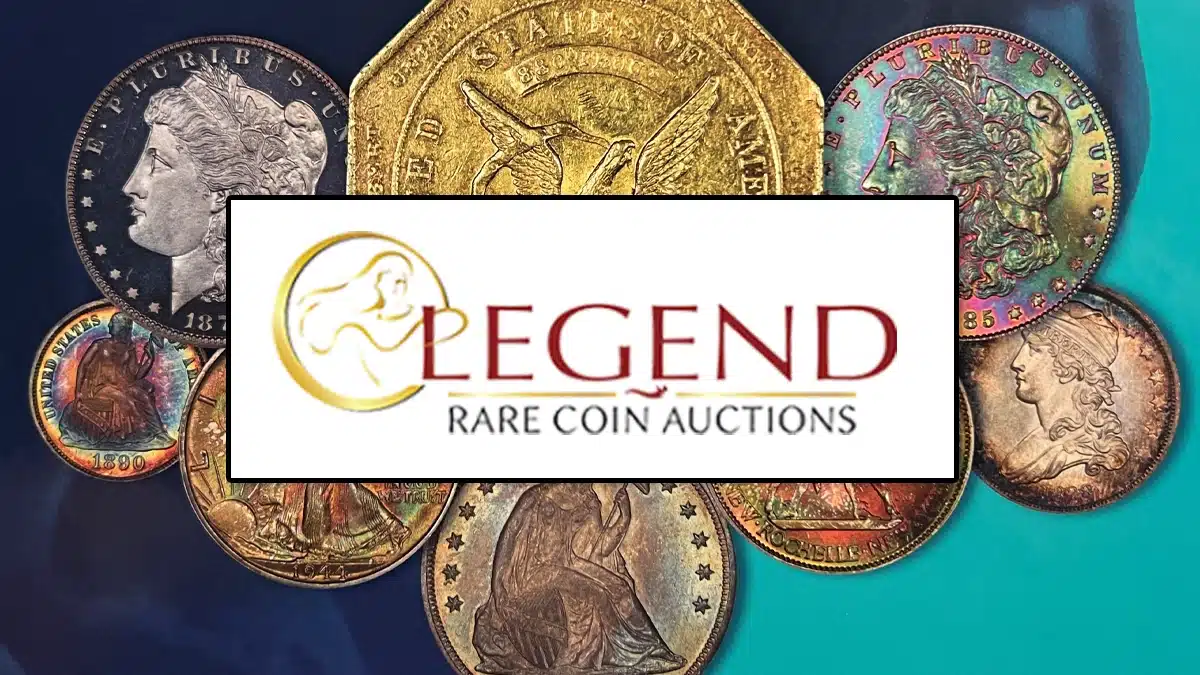
On Thursday, December 28, 2023, Laura Sperber, owner of Legend Numismatics and a partner of Legend Rare Coin Auctions, notified clients and members of the numismatic media that, effective immediately, the Legend auction firm would cease operations.
In her statement, Sperber discussed the impact of her recent health issues on her quality of life and her business. Sperber says these issues are behind her, and she intends to attend the January FUN Show and focus her full attention on Legend Numismatics, which she says is healthy and growing.
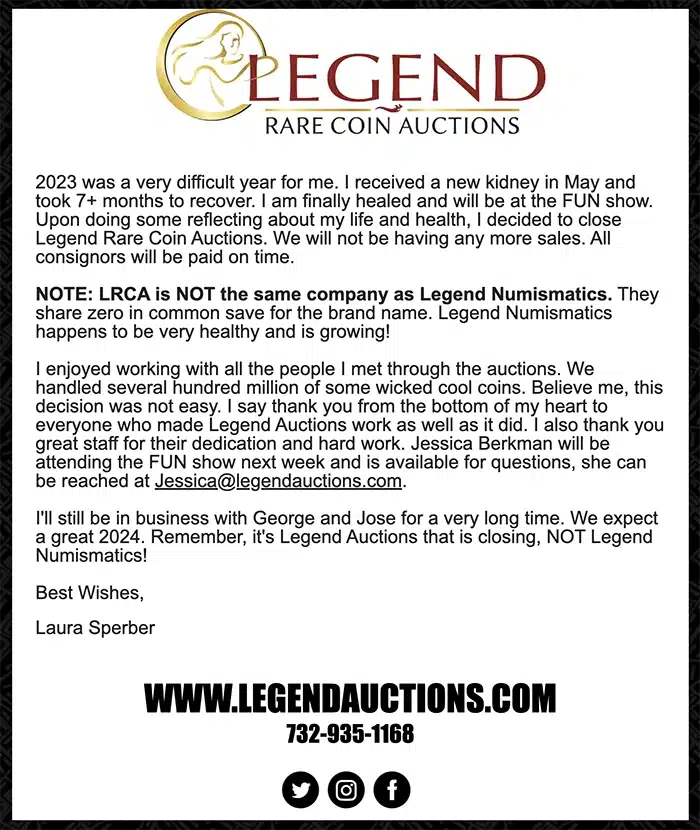
Legend Rare Coin Auctions started as a partnership between Sperber and Dan Morphy of Morphy Auctions of Denver, Pennsylvania. In 2014, the Morphy collaboration ended, and Legend conducted its Regency VIII sale exclusively under the Legend brand. November 2023’s Regency 62 will stand as the company’s final sale.
Under the leadership of Sperber, partner Bruce Morelan, and company presidents Julie Abrams and Jessica Berkman, Legend Rare Coin Auctions offered hand-curated auctions of high eye-appeal coins with a solid commitment to coins with CAC approval. This approach differentiated Legend from competing firms, which often conducted sales with thousands of lots over a dozen or more sessions.
Legend’s auction catalogs were issued in hardback and featured aggressive graphical styling. Sperber, a dealer with a direct communication style, would often comment on coins that she felt were worthy of collector enthusiasm. In her announcement, she invoked this unique style, saying that the firm had “handled several hundred million of some wicked cool coins.”
This direct style and Sperber’s eye for exceptional coins helped establish Legend Numismatics as one of the premier coin dealerships in the industry. Customers of Legend Rare Coin Auctions who want to keep in touch with Sperber or purchase coins from Legend Numismatics can do so by visiting their website: www.legendnumismatics.com.
The post Legend Rare Coin Auctions Ceases Operations appeared first on CoinWeek: Rare Coin, Currency, and Bullion News for Collectors.
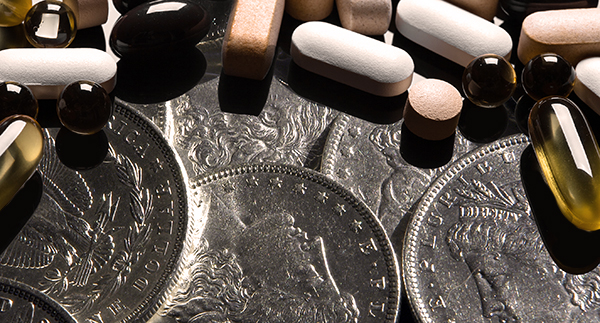
The Binion Hoard : A Morgan Dollar Murder Mystery
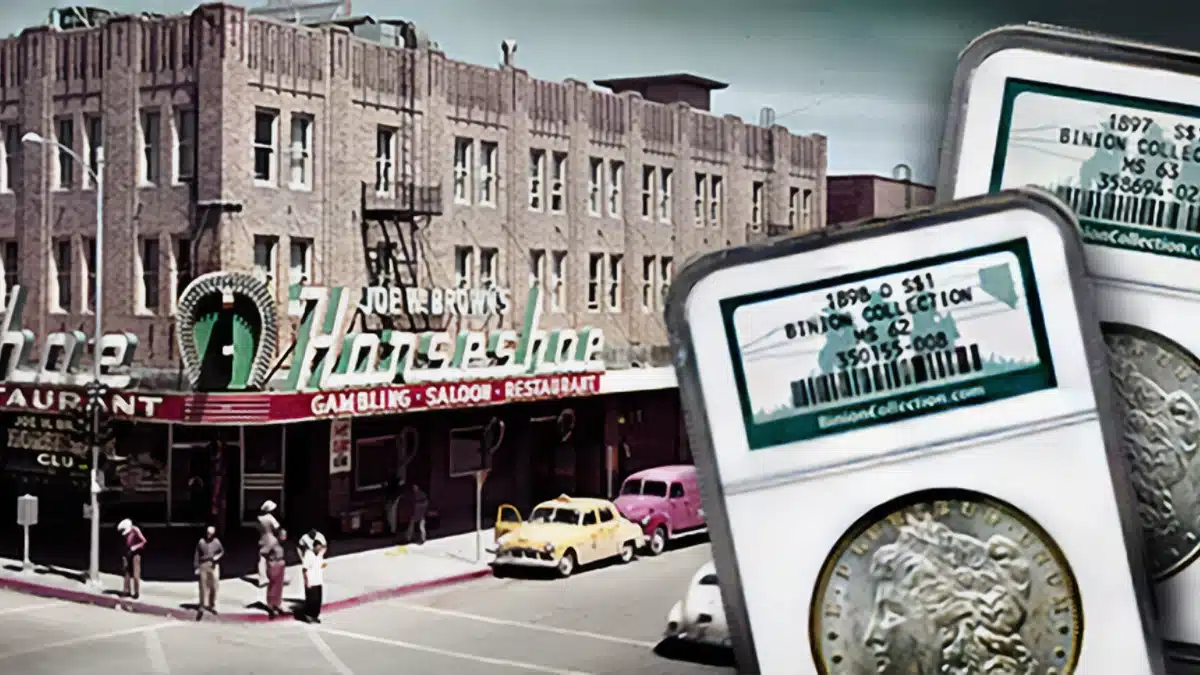
By Rick Bretz for CoinWeek …..
The Binion Hoard offers the collector a variety of ways to collect coins, currency, and memorabilia like ashtrays, dice, gambling equipment, photos, and casino chips (among other things). A collector could assemble a traditional date/mintmark set, or they could choose to assemble a set of the various souvenir items available. But what was the Binion Hoard? And who was its namesake, Ted Binion? In case you missed the Court TV documentary about him and didn’t read any of the several books written about him or his father, here it is in a nutshell.
Recipe for Tragedy
- Benny Binion: Father of Ted Binion
Benny was involved in gambling and other racketeering activities in Dallas, Texas, from around 1924 to 1946. In 1946 and just ahead of the law, Benny relocated his family to Las Vegas, where he became involved in gaming activities. In 1951, Benny purchased both the El Dorado Club and the Apache Club and reopened them as Binion’s Horseshoe Casino.
- Ted Binion: Youngest Son of Benny
Early in his life, Ted worked different jobs in Binion’s Horseshoe Casino and became well respected for his gaming knowledge. As he matured, he started associating with “undesirable” persons and eventually lost his casino license. This had a devastating effect on the younger Binion, as he loved the gaming industry and loved being part of the casino’s operations. Things got worse when Ted met Sandy Murphy, a stripper in Las Vegas, and he became more dependent on drugs and alcohol.
Ted had a fondness for silver bars and silver coins. He especially liked silver dollars, and stored them in the vault at the Horseshoe as well as at his residence. When he permanently lost his gaming license, he was forced to remove his silver dollars from the Horseshoe.
- Sandy Murphy: Girlfriend of Ted (and Rick)
A California transplant working as a stripper in a popular Vegas club. Shortly after she met him at her work, Sandy moved in with Ted and enjoyed all the amenities that his wealth could provide. She was 23; he was 55.
During Sandy’s time living with Ted, she developed and maintained a romantic relationship with one Rick Tabish.
- Rick Tabish: Itinerant Contractor
A traveling contractor (sometimes working, sometimes not) that befriended Ted. Tabish was married with two daughters while having a relationship with Sandy Murphy. When Ted needed a place to store/hide his silver dollars, Tabish was hired to bury them in an underground vault in Pahrump, Nevada, on property that Ted owned. As the story goes, Binion and Tabish met by chance–that “chance” having been arranged by Sandy.

Timeline of the Crime
“Take Sandy out of the will if she doesn’t kill me tonight. If I’m dead you will know what happened.”
July 4, 1998: The vault was completed and filled with 46,000 pounds of silver.
Sept. 16, 1998: During a telephone conversation, Ted told his lawyer that he wanted Sandy removed from his will. In later testimony, Ted’s lawyer stated that the younger Binion said: Take Sandy out of the will if she doesn’t kill me tonight. If I’m dead you will know what happened.
Sept. 17, 1998: Paramedics were called to the Binion home. Ted was found dead of a suspicious drug overdose.
Sept. 19, 1998: Rick Tabish was caught at 2 am digging up Binion’s buried treasure, estimated at the time to be worth $7 million USD. Also found was a note from Sandy Murphy to Tabish, professing her love for him and revealing the combination to the underground storage vault.
Tabish and Murphy were eventually charged with the murder of Ted Binion.
What Happened to the Treasure?
The company Spectrum Numismatic International (SNI) purchased the coins in November 2001 for $3 million. Marketing of the coins was assigned to Goldline International, Inc. There were over 100,000 Morgan and Peace silver dollars, and an unspecified number of silver half dollars. The coins were authenticated and graded by Numismatic Guaranty Company (NGC, formerly Numismatic Guaranty Corporation), and a unique white and green label was designed for the pedigree.
Population Statistics
Before I get into the technical features of population statistics, I’d like to offer a salute to NGC and the service they provide to the collecting public. PCGS, ANACS, and ICG are also involved in the pedigree authentication process and provide valuable services to the collector. However, NGC seems to have the leading edge in this collecting niche. And because of NGC’s reputation in the industry, SNI selected the grading service to validate the Binion Hoard.
So with that said, we can proceed to the population reports.
The last NGC Binion silver dollar population report that I’ve seen was contained in the October 2009 NGC Census and covered just silver dollars that received “hard” grades. No population reports were available for “soft” graded coins, or for coins merely authenticated as from the hoard and not graded. The 2009 report shows 28,788 Morgan silver dollars receiving official “hard” grades.
While population reports change over time (for a variety of reasons), I believe that the 2009 report is directionally correct and provides insight into the rarity of certain dates and mintmarks. It also provides the Binion collector with a valuable tool for determining the pedigree premium when purchasing a Binion coin.
Appearance and Grading
Eye Appeal
Compared to other hoards, collections, and general population coins, Binion silver dollars do not have great (or in many cases, even “good”) eye appeal. This is largely due to the storage and handling of the coins received while under Binion’s ownership and their subsequent storage as evidence by the State of Nevada. In both cases, the coins were commodities (evidence) and not collectibles. They were transferred in work trucks, tossed about like lumps of coal, and industrial equipment was used to load and unload the coins.
Grading
NGC-labeled Binion coins fall into three grading categories:

Coins in the first category were authenticated as being from the hoard and graded. Graded coins have a specific and defined grade–a “hard” grade–like MS63 or AU55.
Coins in the second category were authenticated and received “soft” grades. Examples of soft grades are “Uncirculated” or “Brilliant Uncirculated”. No numeric grade is assigned. Coins in this group are less desirable than “hard”-graded coins.
Coins in the third category were authenticated as from the Binion hoard but did not receive a grade. Many hard-to-find dates fall into this category. While they’re the least desirable to the refined collector, in many cases the rarity of the date/mintmark still creates a market premium for the coin.
Collecting Binion Silver Dollars
For clarification, there were other silver coins in the hoard besides silver dollars. Some very nice silver coin sets–with an example apiece of a Roosevelt dime, a Washington quarter, a Kennedy half dollar, and a Peace dollar–have been assembled. But the most popular way to collect coins from the Binion hoard is the traditional method of assembling a set with as many date/mintmark combinations as you can find.
Assembling a set by date and mintmark has become more difficult as time passes–with the rarer coins residing in private collections from which they may not resurface for many years. Most of the Binion coins available now are the most common of date/mintmark varieties; an experienced collector occasionally, however, may dissolve their collection, and rare varieties will suddenly appear at auction.
* * *
The post The Binion Hoard : A Morgan Dollar Murder Mystery appeared first on CoinWeek: Rare Coin, Currency, and Bullion News for Collectors.
Suspects in $200,000 Dime Theft Charged
By Hubert Walker for CoinWeek ….
As of October 21, 2023, charges have been filed against four suspects in the Philadelphia-area theft of $234,500 worth of dimes on April 13. The crime occurred in a Wal-Mart parking lot where the driver of a tractor-trailer coming from the United States Mint had stopped to take a break.
suspects robbed other tractor-trailers in the area
would attack when parked for break
removed driver
opened back with bolt cutters
hauled opportunistic stolen goods off in white cargo truck
had to break open pallettes of dimes
put dimes in small bags
put dimes into coinstar machines in MD over the next weeks
also deposited in banks near philly
but the coins deposited and sold to coinstar were only a couple grand in face
Rakiem Savage, 25
Ronald Byrd, 31
Haneef Palmer, 30
Malik Palmer, 32
all four from Philadelphia
currently held by FBI
charged w/ conspiracy, robbery, theft of government money
could face dozens of years in prison
Sources:
https://coinweek.com/200000-in-dimes-stolen-from-truck-in-philadelphia-cbs/
The post Suspects in $200,000 Dime Theft Charged appeared first on CoinWeek: Rare Coin, Currency, and Bullion News for Collectors.
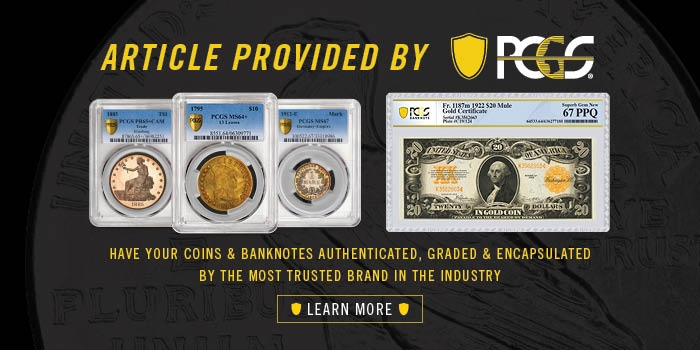
1905 Lewis and Clark Expo Coins and Medals From the U.S. Mint
By Vic Bozarth for PCGS ……
We wind our way to 1905 in this series covering the coins, medals, and tokens produced in conjunction with the seven largest expositions and world’s fairs held between 1876 and 1926 in the United States. Technically, the 1905 exposition is not considered a “world’s fair” by the Bureau of International Expositions. However, many Americans, especially numismatists, include the Lewis and Clark Expo of 1905, held in Portland, Oregon, on the list because of the two commemorative gold dollars it spawned and the historical significance of both the Lewis and Clark expedition and the Oregon Trail itself.
The Lewis and Clark Centennial Exposition commemorated the 100th anniversary of an expedition led by Meriwether Lewis and William Clark from St. Louis to the Pacific Coast. Their journey began in 1803 and was to help explore and survey land recently acquired in the Louisiana Purchase of 1803.
While commemorating a significant historical event, the exposition in Portland, Oregon in 1905 was held just seven months after the conclusion of the Louisiana Purchase Exposition in St. Louis in 1904. However, that event had purposely been postponed an entire year to allow greater participation including the 1904 Olympic Games and the 1904 Democratic National Convention.
Selling the Concept of a Fair
The Oregon Historical Society suggested the centennial celebration to “sell” the idea of the exposition, but ultimately it was all about promoting local and state business in Oregon. After all, the four prior United States expositions had been successful in terms of both promotion of their respective city or region and numerous advertising opportunities.
Local officials and dignitaries were able to unify behind the exposition theme: “Westward The Course of Empire Takes Its Way”. The real motivation behind the event was to promote Pacific trade. Once the idea was sold to a handful of businessmen and companies who invested funds, the backing for the exposition–including funds from the state–fell into place rather quickly.
The success of both the Columbian and Louisiana Purchase World’s Fairs in terms of advertising was hard to argue against. How can anyone buy a new product if they don’t know about it or where to buy it? Remember, there was no radio or television advertising at that time. Newspapers and circulars were the news outlets of the day.
And word of mouth, especially when it was something new, was a big deal!
Nearly 20 million visitors had attended the Louisiana Purchase Exposition, but regardless of the short period of time between that event and the Lewis and Clark Centennial Exposition, the Portland expo drew nearly 1.6 million paid visitors (50 cents admission for adults and 25 cents for children) and saw more than 2.5 million total visitors. The vast majority of those attending were from the Pacific Northwest, with only six percent of the total attendance visiting from east of the Mississippi River.
While “Westward The Course of Empire Takes Its Way” was the theme of the fair, the overall goal was trade with our Pacific Rim neighbors, including Japan and China. Portland was a major economic center near the West Coast, with the Northern Pacific, Southern Pacific, and Union Pacific railroads all having a terminus there. There is no question that the promoters had a strong international trade pitch with railroads from Portland serving (or connecting to) the entire U.S.
Oregon boasted several natural resources, but the two most noteworthy were wheat and lumber. Much of the wheat from the Northwest was milled in Portland at one of the largest flour mills in the West. Oregon’s timber industry was also exceptionally strong, with Oregon ranking second in wooded acreage in the U.S. and leading the nation in standing lumber with 300,000,000 board feet.
As early as 1895, a local dry goods merchant named Dan McAllen suggested that Portland needed “some sort of international fair” to “mark the new century and pull itself out of its economic slump.” Nothing happened for several years while economic conditions weren’t favorable, but by the middle of 1900 the idea of a fair was more attractive.
J.M. Long of the Portland Board of Trade is credited with bringing together a provisional committee that started preparations for a fair. Shortly after, a permanent board was established with Portland General Electric Company head Henry W. Goode as president.
Much of the success of the Portland expo was due to the cooperation of a fairly large group of local businessmen who either served on the board and/or donated substantial funds. Like successful fairs held previously, the overall unity in purpose embraced by the backers of the fair could be credited for much of the fair’s profit, too.
1905 Lewis and Clark Centennial Exposition Coins and Medals
The 1904 and 1905 Lewis and Clark Exposition Gold Dollars feature the only U.S. coin design with a two-head design (the two explorers both have a bust portrait on the coin, one appearing on the obverse and the other on the reverse). They were also the only U.S. commemorative gold dollars struck and dated in multiple years.
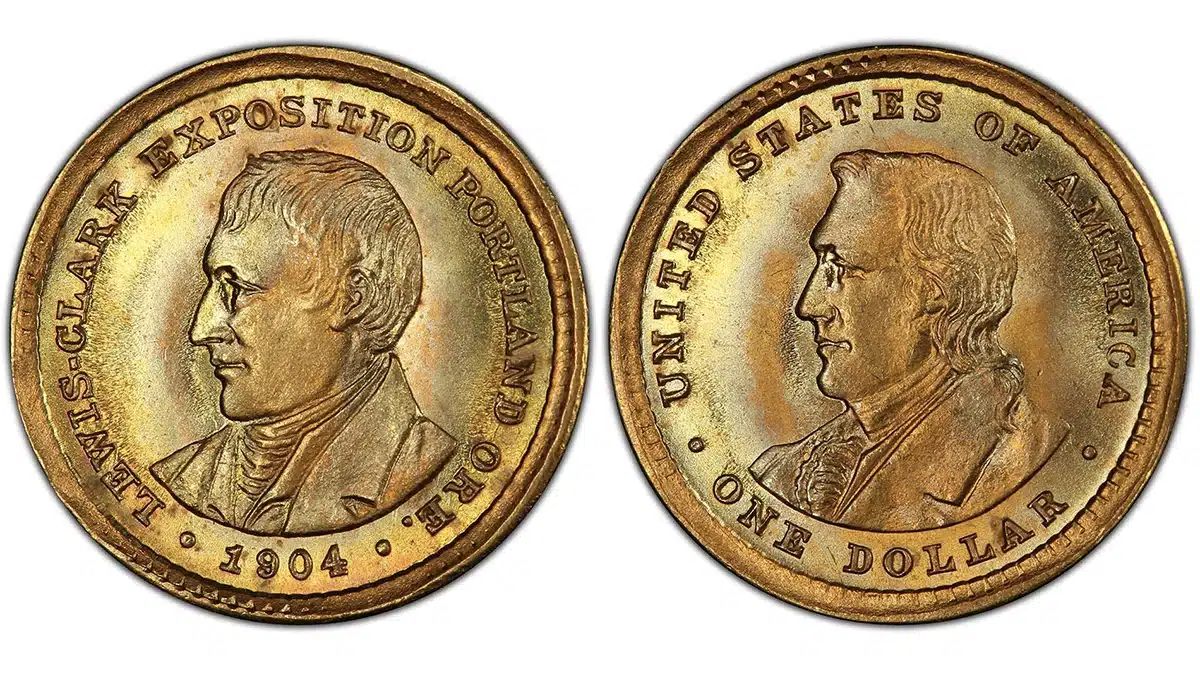
- PCGS #7447 – 1904 Lewis and Clark Gold Dollar, 10,025 minted
- PCGS #7448 – 1905 Lewis and Clark Gold Dollar, 10,041 minted
Much like the 1893 Isabella Quarter from the Columbian Exposition, both the 1904 and 1905 Lewis and Clark Gold Dollars are scarce today and command a significant premium. Conversely, the nation’s first two commemorative gold dollars, the 1903 Jefferson and McKinley Gold Dollars, sold in much larger numbers. This is most likely due to the overall larger attendance of the Louisiana Purchase Exposition versus that of the Lewis and Clark expo. The Louisiana Purchase Exposition drew 20 million versus the 2.5 million who attended the Lewis and Clark expo; thus, the Lewis and Clark expo offered a much smaller market.
Both of the Lewis and Clark Gold Dollars saw greater numbers produced than sold, but the unsold examples of each were melted quickly. Regardless of the surviving mintage of either, the scarcity and prices for both the coins, not to mention the medals, from the Portland expo are due to the smaller number of initial sales.
The Official Souvenir Dollar
The official souvenir dollar was designed by Mint Engraver George T. Morgan and struck at the expo by the United States Mint on the fairgrounds at an exhibit in the government building. They measure 34 millimeters in diameter and were struck in various metals.
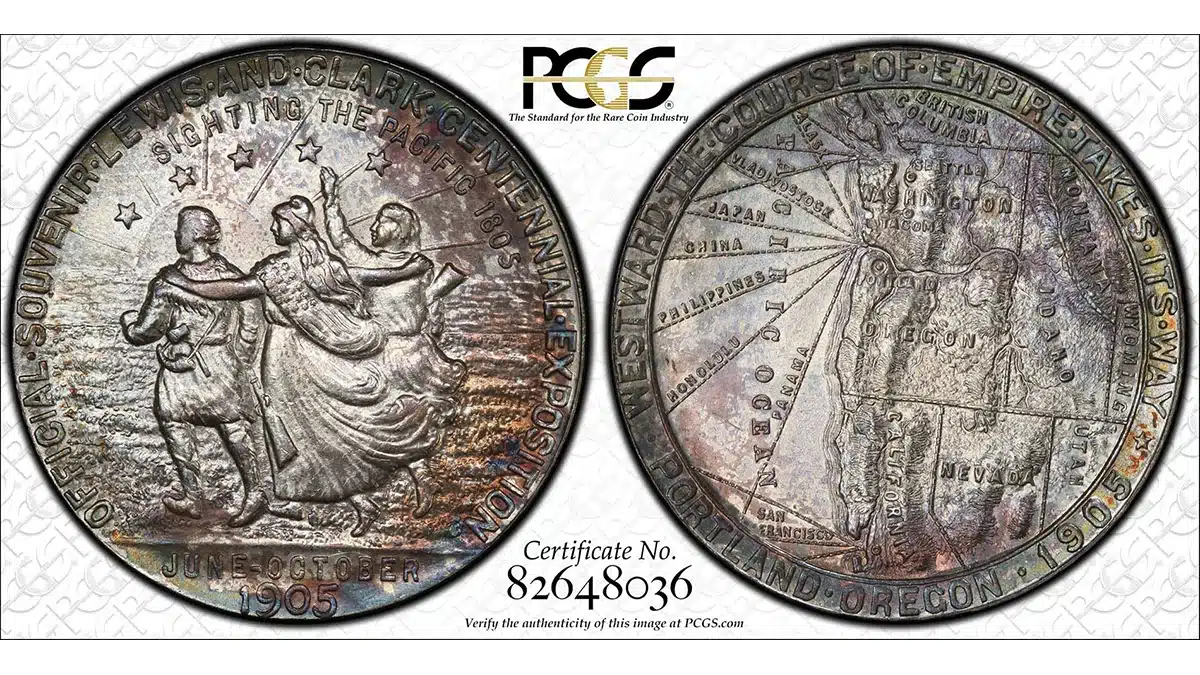
- PCGS #642740, HK-325 – 1905 L&C Souvenir Medal, .990-fine silver / 306 grains; issued for $1.25 (Rarity-5)
- PCGS #642671, HK-326 – Gilt-Bronze / 250 grains; issued for 50 cents (R-5)
- PCGS #642672, HK-327 – Bronze BN / 250 grains; issued for 25 cents (R-5)
- PCGS #642673 – Bronze RB; “
- PCGS #642674 – Bronze RD; “
- PCGS #620670, *HK-327a – Brass (250 grains); issued for 25 cents
*Not listed in the So-Called Dollars reference book, but numismatic researcher Bill Swoger claims most common.
Other Medals and Tokens
There are several issues of So-Called Dollars and Souvenir Gold Tokens that were issued for the Lewis and Clark Exposition. The So-Called Dollars related to the expo, originally identified as “souvenir” dollars HK-328 through HK-334, are detailed below:
- PCGS #642745, HK-328
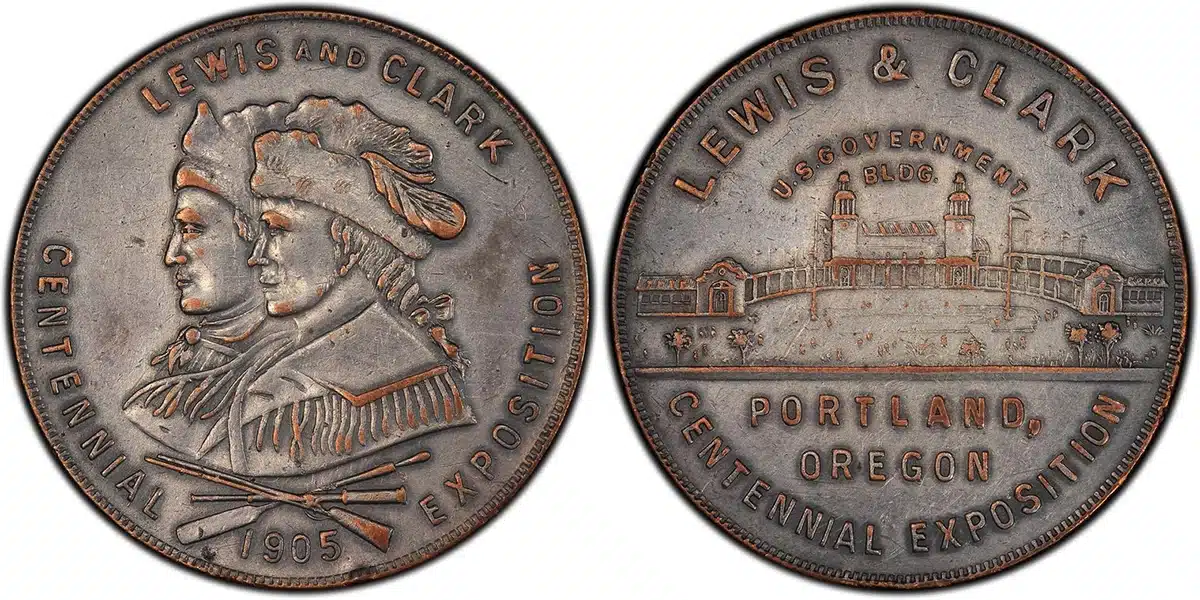
For the most part, these privately made medals were of the same design for HK-328 through HK-333b with the Government Building on the reverse, but HK-334 has a slightly different obverse and the Washington State Building on the reverse.
- PCGS #642758, HK-334
The souvenir Oregon Gold Tokens were issued in 1/4 (25 cent) and 1/2 (50 cent) denominations portraying Mount Hood on the obverse with the legend “L&C EXPO 1905” over and “Mt. Hood” underneath. The reverse sports a leafed vine with grapes surrounding the 1/4 or 1/2 and “OREGON” over and “GOLD” beneath.

- PCGS #527123, X-Tn1
- PCGS #532418, X-Tn2
Regional Pride
Visitors to the Lewis and Clark Exposition were treated to exhibits from 21 nations and 16 U.S. states. Curiously, this was really a Western exposition. Of the 16 states represented, only three – Maine, Massachusetts, and New York – were from the East. The U.S. government was well represented, including the Mint exhibit where the official medals were struck.
Some of the largest international exhibits included that of Japan, which cost more than a million dollars and featured amazing cultural artifacts in porcelain and silk. Italy’s pavilion featured lovely marble statuary. Both Germany and France spent enormous sums on their exhibits also.
When considering the distances and the potential modes of transportation available to an individual of that time, one realizes why Portland wanted their own fair. Attracting 16 states and 21 foreign governments to participate is quite impressive. The international participants had more logistical issues and farther to travel.
Not only were the vast majority of the population of Portland, the state of Oregon, and the entire West Coast much too far from Buffalo, New York, for the Pan-American Exposition in 1901, but the Louisiana Purchase Exposition in St. Louis in 1904 was itself a monumental journey in its day for someone traveling from the shores of the Pacific.
Where to Next?
The overwhelming support for a Panama-Pacific Exposition was evident early on, but no metropolitan area or region could or would try to sponsor a major international event until 1915, when the Panama-Pacific Expo was held in San Francisco. While there were historical anniversaries like the Jamestown Ter-Centennial Exposition in 1907, and both the Hudson-Fulton Celebration and the Alaska-Yukon Territory Exposition in 1909 on opposite coasts, none of them rose to world’s fair status.
In this seven-part article series reviewing the coins and medals that the U.S. Mint produced for our major U.S. Expositions from 1876 to 1926, the 50 years spanned in this coverage doesn’t seem long in historical terms. And yet, virtually everything had changed in that 50 years. Not only had the United States itself advanced immensely in terms of both communication and transportation, but indeed the world had become a much smaller place.
Telephone usage, while not widespread in 1905, continued to grow and would become commonplace by 1926. Ocean liner and rail travel were one’s best options for covering long distances in 1876, but by 1905 automobiles were gaining traction.
Air travel was still all but unknown in 1905, but humans had flown in a motorized aircraft by that time. By 1926, people had flown planes on combat missions during the Great War. Airshows had become popular events by the time the nation celebrated its Sesquicentennial Anniversary in 1926.
* * *
For more information from PCGS, the sponsor of this article, click on the image below.
* * *
The post 1905 Lewis and Clark Expo Coins and Medals From the U.S. Mint appeared first on CoinWeek: Rare Coin, Currency, and Bullion News for Collectors.
US Mint Sales: Core 2023 Sets See Drops
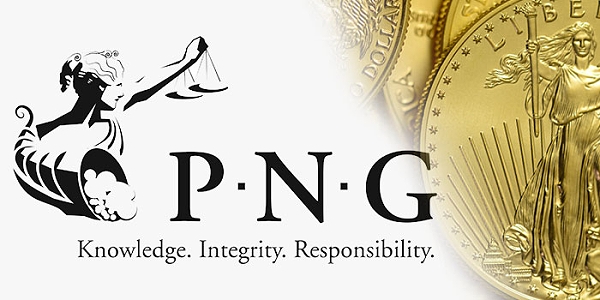
PNG to Allow Non-Dealers to Join With New Rule Changes

Made possible by recent changes to its Bylaws, the nonprofit Professional Numismatists Guild (PNG) now offers membership to a wider range of workers in the numismatic field besides coin and bullion dealers.
The new membership categories are known as Gold, Gold Associate, and Silver, with Gold membership being the former standard PNG membership. To be eligible for the new Gold level membership, an applicant must be at least 21 years old; have a minimum of three years experience as a professional numismatist; agree to binding arbitration as a way of settling disputes that may arise over the purchase, sale, or trade of numismatic items; agree to a background check; submit an application form, credit report, and $300 application fee to the executive director; and be sponsored by at least four PNG members. The applicant must then be approved by the full membership of the PNG and voted into the Guild by the Board.
The Gold Associate membership is for the employees of Gold members and would allow Gold Associates to have their own PNG Member Directory listing. Candidates must be over 21 years of age and have at least two years of professional numismatic experience. Current or former Gold members are not eligible for Gold Associate status. After approval by the Board, membership at this level is billed to a member’s employer.
The Silver membership level is open to individuals in the field who are not professional numismatists but are nevertheless involved in marketing, museums, trade shows, and similar numismatic support businesses. The executive director decides whether an applicant meets membership criteria before he or she sends their application to the Board once again for approval.
All members, regardless of level, must agree to abide by the PNG Code of Ethics. The full Code is available at www.PNGdealers.org/ethics.
For complete details about the new PNG membership levels and their requirements, as well as to apply, please visit www.PNGdealers.org/join, call (951) 587-8300, or send an email to info@PNGdealers.org.
* * *
The post PNG to Allow Non-Dealers to Join With New Rule Changes appeared first on CoinWeek: Rare Coin, Currency, and Bullion News for Collectors.
Gold Price Hits Record High on Wednesday, Dec. 27
Palladium declined on Wednesday, while other precious metals gained, with gold prices rallying to an all-time high and silver prices rising for the first time in a week
Dr. Pauli Murray American Women Quarters Begin Shipping Jan. 2
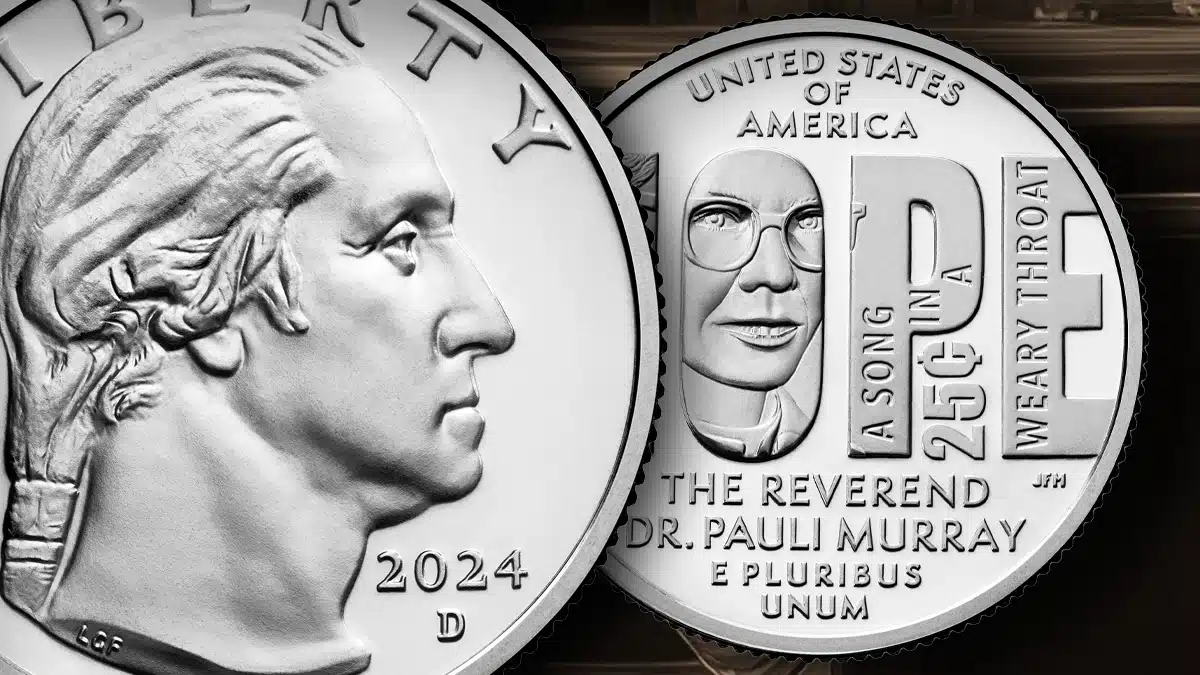
The first circulating 2024 American Women Quarters will be shipped out of the United States Mint starting January 2. Struck by the Philadelphia and Denver mints, they commemorate the Reverend Dr. Pauli Murray, one of the most important civil rights advocates of the 20th century.
In addition to being a fervent activist for civil rights, Murray was a writer and poet, a lawyer, and even an Episcopal priest. Her life circumstances and experiences led her to see the common traits of both racial and sexual discrimination. She published the landmark book States’ Laws on Race and Color in 1950, and its critical analysis of segregation laws around the country would acknowledgedly serve as a foundation for legal arguments in the historic Supreme Court case Brown v. Board of Education.
The Dr. Pauli Murray quarters should begin to find their way to local banks near you later in January or early in February.
Design of the Dr. Pauli Murray 2024 American Women Quarter
Every year from 2022 through 2025, as authorized by the Circulating Collectible Coin Redesign Act of 2020 (Public Law 116-330 – PDF Link), the U.S. Mint issues five quarters with reverse designs that celebrate the important social, cultural, political, and scientific accomplishments of a diverse selection of notable American women. In this case, the Reverend Dr. Pauli Murray is seen through the letters of the word “HOPE”, with the inscription A SONG IN A WEARY THROAT–from her poem “Dark Testament” (1944)–superimposed over the P and the E. Mint Artistic Infusion Program (AIP) Artist Emily Damstra designed the reverse, while Mint Chief Engraver Joseph Menna sculpted it.
The obverse, which features the Laura Gardin Fraser effigy she created to mark the bicentennial of Founding Father George Washington’s birthday in 1932 but which was ultimately passed over in favor of the John Flanagan design we have known ever since. The Gardin Fraser Washington obverse is common to all coins in the American Women Quarters Program. Legally mandated inscriptions include the legend LIBERTY, the motto IN GOD WE TRUST, and the date 2024.
* * *
The post Dr. Pauli Murray American Women Quarters Begin Shipping Jan. 2 appeared first on CoinWeek: Rare Coin, Currency, and Bullion News for Collectors.
How to Read Dates on Ancient Coins
CoinWeek Ancient Coin Series by Mike Markowitz …..
“Why put a date on a coin?” Most suggest that the mint used a date to monitor quality control, manage the workmanship, or protect its product from counterfeiting. In truth, mints starting placing dates on coins because they could (Cohen, 7).
DATES[1] ARE SO universal on modern coins that it may come as a shock to learn that most ancient coins provide no indication of when they were minted. The “Common Era” (or “AD”, Anno Domini) dating system used in our world to designate years did not come into general use on European coins until the 16th century[2]. A wide variety of dating systems were used by different cultures in the ancient world to keep track of years, and in some cases, these appear on coins.
Zankle
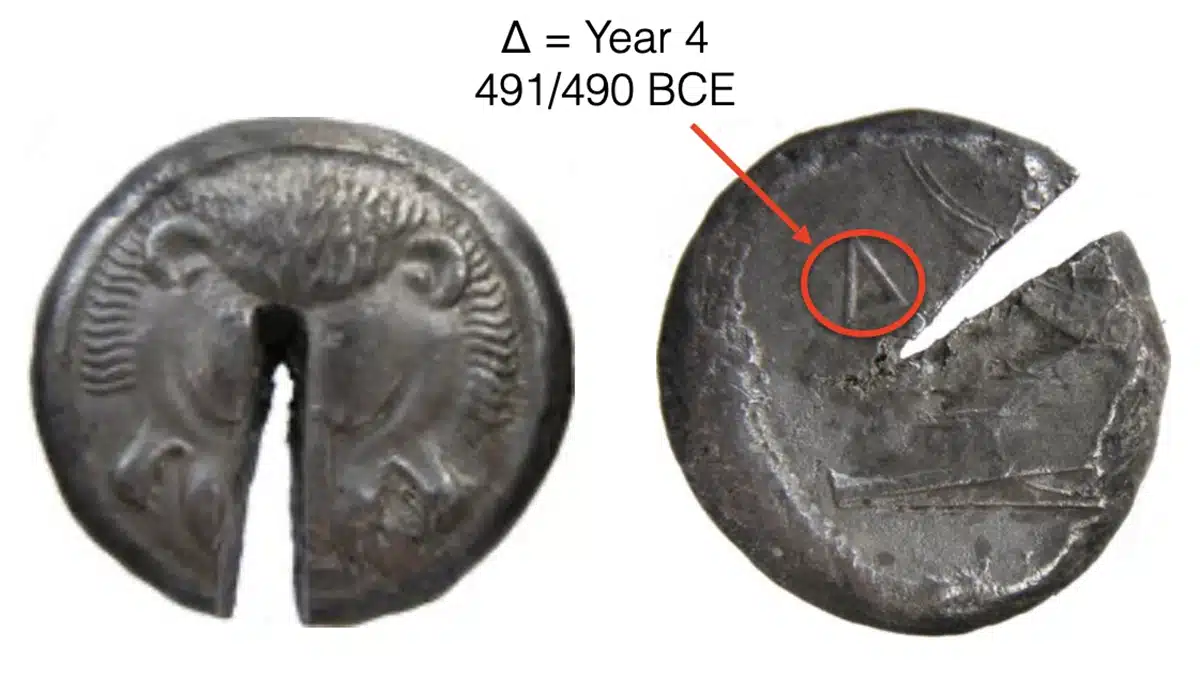
The earliest coins to bear a year date were a brief experiment – lasting just six years – by Greek refugees from the Aegean island of Samos who fled the Persian occupation of their homeland to settle at Zankle (today Messina, Sicily) in 494 BCE. On coins they struck, they dated their arrival as “Year One”, indicated by a prominent letter A (alpha, the Greek numeral for 1). Coins are known for Years 1, 2, 4, 5 and 6, but no coin of Year 3 has ever turned up. These silver tetradrachms show the head of a lion on the obverse, and the prow of a ship on the reverse. One of the few published examples of this series that I found is dated Year Four (with delta, Δ, the fourth letter of the Greek alphabet) in the collection of the American Numismatic Society (ANS) in New York[3]. The coin, from the famous Asyut Hoard found in Egypt in 1969, has a deep chisel cut that nearly broke it in half.
Samos
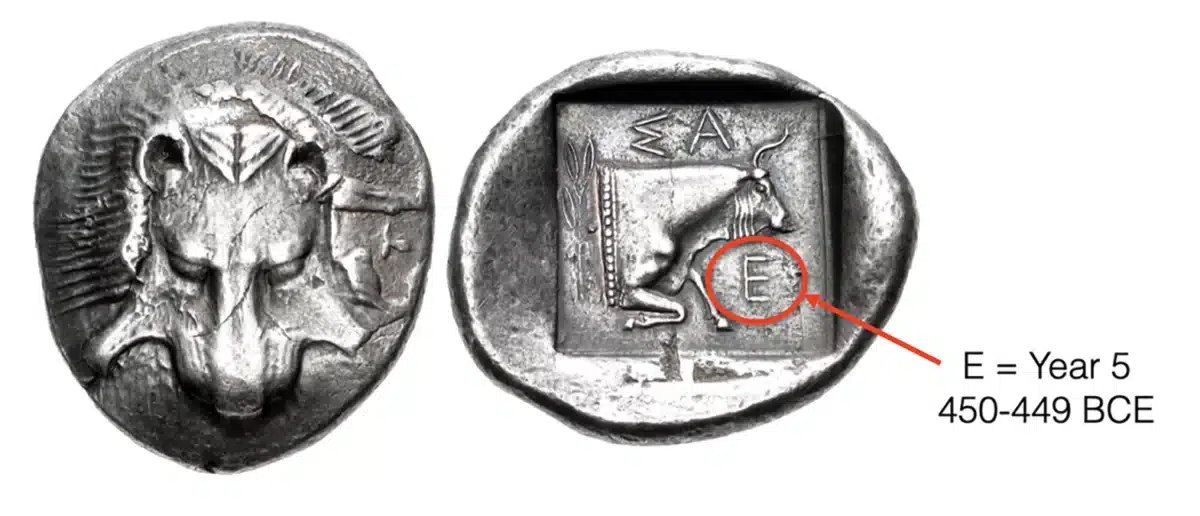
Back on Samos a few decades later, this experiment was repeated. From 454 to 440 BCE, silver tetradrachms of Samos were dated with a sequence of Greek alphabetic numerals. The date letter appears on the reverse, below the chin of a bull. A rare example with a date from Year 5 brought $8,000 USD in a 2021 U.S. auction[4]. The experiment was abandoned in 439 when Samos was defeated in a short war by Athens[5].
Arsinoe

Arsinoë II was the daughter of Ptolemy I, a Macedonian general who became the first ruler of Egypt’s Ptolemaic dynasty. Born in 316 BCE, Arsinoë died some time between 270 and 268. But before that happened, she became Queen of Egypt upon her marriage to her brother Ptolemy II in 273 (confusingly his first wife, Arsinoë I, a Macedonian princess, had the same name).
Coinage in the name of Arsinoë II is all posthumous; after her death she was deified (declared a goddess) by her brother-husband. Her name appears as ΑΡΣIΝΟΗΣ – ΦΙΛΑΔΕΛΦΟΥ (Arsinoes Philadelphou, “Brother-loving Arsinoe”). A massive gold octodrachm or mnaion (27.8 grams) from the mint of Ake-Ptolemais (today Akko, Israel) is dated to Year 35 of Ptolemy II, which corresponds to 251/250 BCE[6].
Cleopatra
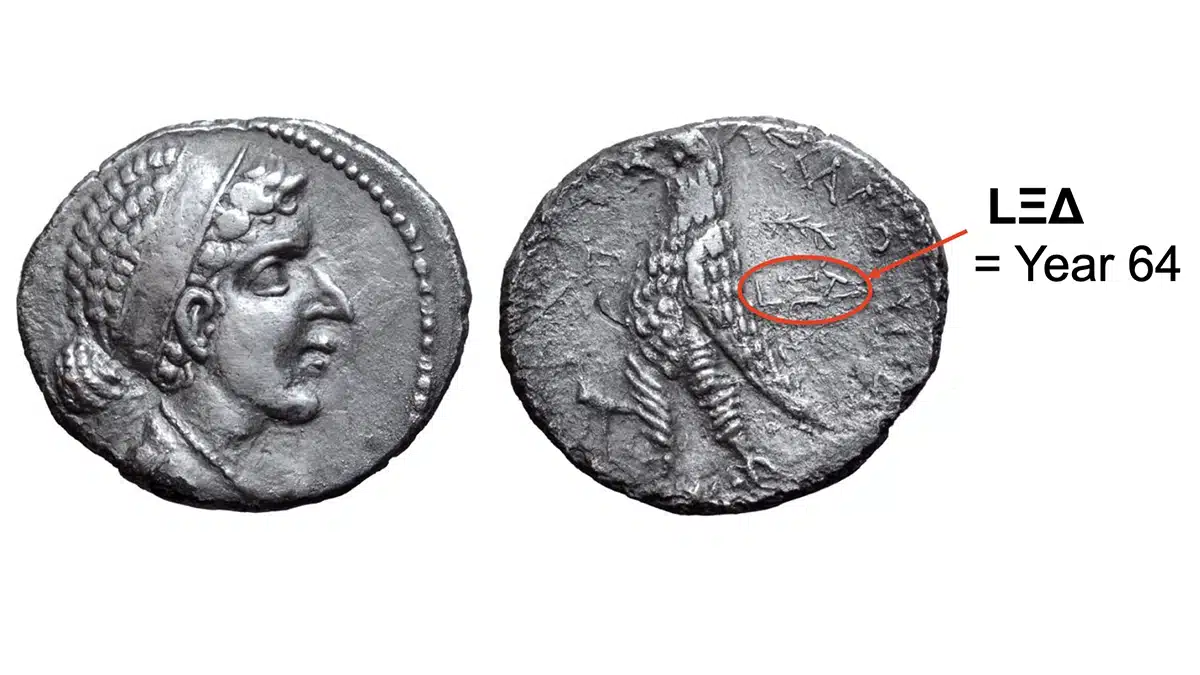
One of the most famous women of ancient history, Cleopatra VII of Egypt issued coins that are avidly sought by collectors. There are many bronze coins bearing Cleopatra’s portrait. But the only Ptolemaic silver coin on which she placed her own portrait is a very rare tetradrachm from the mint of Ascalon (or Ashkelon) on the coast of Palestine[7]. The date appears on the reverse as LΞΔ, meaning “Year 64”. “L” in this case is not a numeral; it’s not a Greek letter at all, but a kind of scribal abbreviation or shorthand for “year”. The date is based on the local era of Ascalon, which gained independence from the Seleucid Empire in 104/103 BCE, so Year 64 corresponds to 41/40 BCE, the 10th year of Cleopatra’s reign. On Harlan J. Berk’s list of the 100 Greatest Ancient Coins, this type is #30 (Berk, 82). Only about five examples of are known.
Tyre Shekel

The Phoenician city of Tyre (today Sur, Lebanon) was a major commercial power in the international trade of the ancient Mediterranean. Silver shekels and half-shekels of Tyre enjoyed a good reputation for the purity of their metal. Although they bore the graven image of the Tyrian city god, Melkart (identified as Herakles by Greeks and Romans), these were the only coins acceptable for payment of the annual Jewish temple tax in Jerusalem. These coins were dated in Greek numerals according to the local era of Tyre, which began in 127/127 BCE.
Among collectors of Biblical-related coins, the most desirable date is considered to be 33/34 CE, which many sources consider to be the year of the Crucifixion of Jesus. It is thought that these coins were the “thirty pieces of silver” paid to Judas Iscariot[8]. The date 33/34CE corresponds to Year 159 in the Tyrian civic era, written as rho-nu-theta (PNΘ) in Greek numerals[9]. On Harlan Berk’s list of the 100 Greatest Ancient Coins, this type is #62 (Berk, 94).
Pontius Pilate
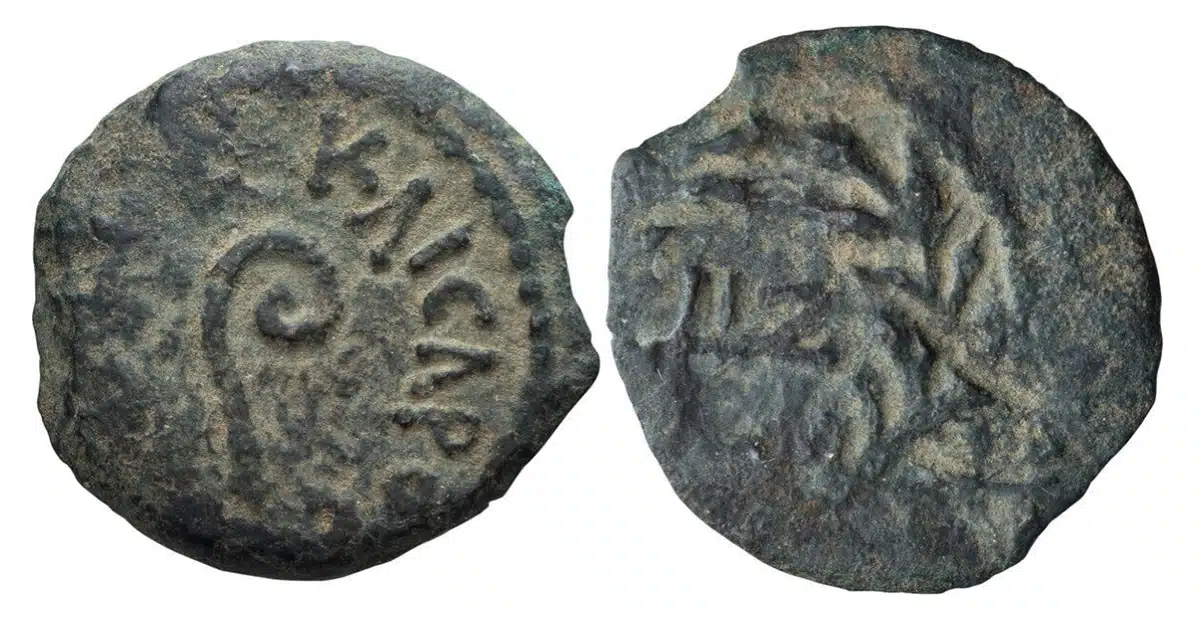
A series of Roman “procurators” governed Judaea in the first century. Small change in bronze was issued at Jerusalem by these procurators from time to time to meet local needs. Inscribed in Greek, these coins bear the name and sometimes the regnal year of the current emperor. The most famous of these was Pontius Pilatus (“Pilate” in the Gospels), under whose administration Jesus was crucified. Pilate served from 26 to 36 CE. The coins are not rare, with some 780 examples listed on CoinArchives Pro in November 2023. Pilate only issued coins in Years 16, 17, and 18 of Tiberius (corresponding to 29/30, 30/31 and 31/32 CE). Usually poorly struck and badly centered, these are some of the most popular Biblical-related coins. One type bears a lituus, a spiral wand used by certain Roman priests[10]. This pagan symbol would have been offensive to the Jewish population.
Hadrian
The usual way that Romans dated events was by reference to who were the consuls for that year[11]. Consuls were the chief executives of the Roman republic, elected annually. The sequence began in 509 BCE with the consulship of L. Junius Brutus (an ancestor of Caesar’s assassin) and L. Tarquinius Collatinus. For example, the year of Caesar’s birth, 100 BCE, was the “consulship of L. Valerius Flaccus and the sixth consulship of Gaius Marius.” But Roman coins were never dated by consulships.

A less common way of dating events was Ab Urbe Condita, “From the Founding of the City”, abbreviated AUC.This date is counted from the legendary founding of Rome on April 21, 753 BCE. A unique example of AUC dating in Roman numerals is found on a gold aureus of Emperor Hadrian. The coin commemorates Hadrian’s establishment of chariot races in the Circus Maximus[12], Rome’s huge stadium, on Rome’s birthday in 121 CE. The coin’s reverse shows a muscular reclining figure, the “spirit of the games”, with one arm wrapped around the stadium’s conical turning post, cradling a chariot wheel in his other arm. The Latin inscription is ANN DCCCLXXIIII NAT URB P CIR CON. The first part means “Year 874 from the birth of the city”; the meaning of P CIR CON is debated. Options include Populo Circenses Concessit (“Games in the Circus Given to the People”) and Primum Circenses Constituti (“Games in the Circus First Instituted”). On Harlan Berk’s list of the 100 Greatest Ancient Coins, this type is #66 (Berk, 103).
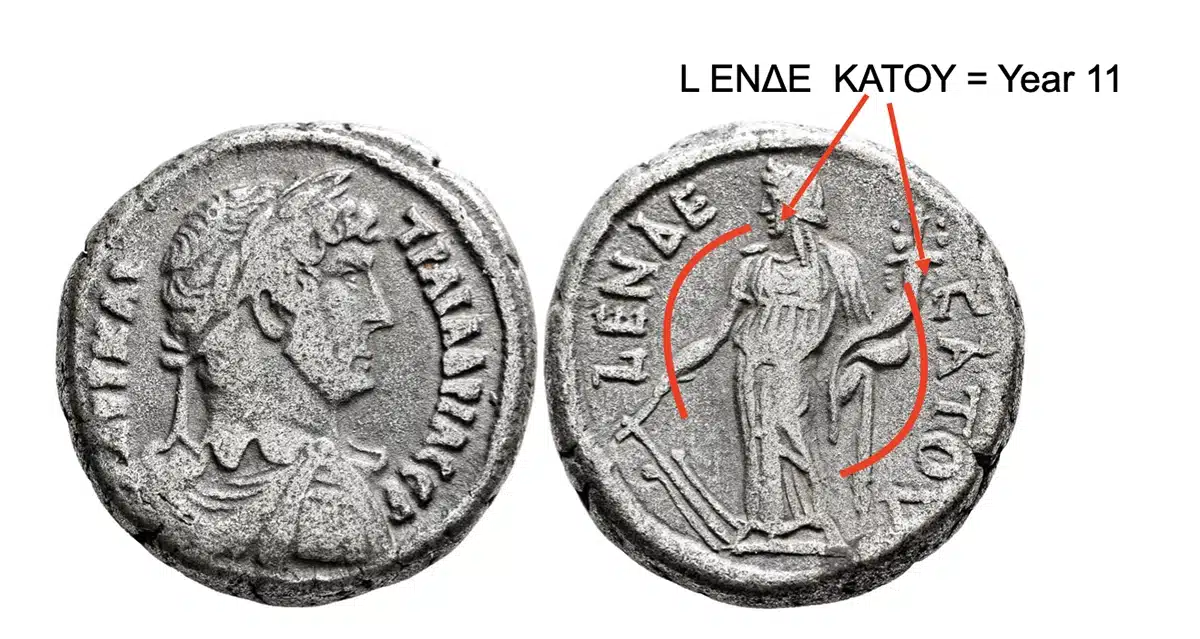
A series of coins issued in the name of Hadrian at Alexandria for circulation in Egypt are dated with the emperor’s regnal year as Greek words, spelled out in full. Greek was the administrative language of Roman Egypt and the native tongue of much of Alexandria’s population. A billon tetradrachm bearing the figure of Tyche, goddess of good fortune, is date to the 11th year of Hadrian (126/127 CE) with the inscription L ΕΝΔΕΚΑΤΟΥ[13] (endeka being the Greek word for “eleven”).
Pacatian
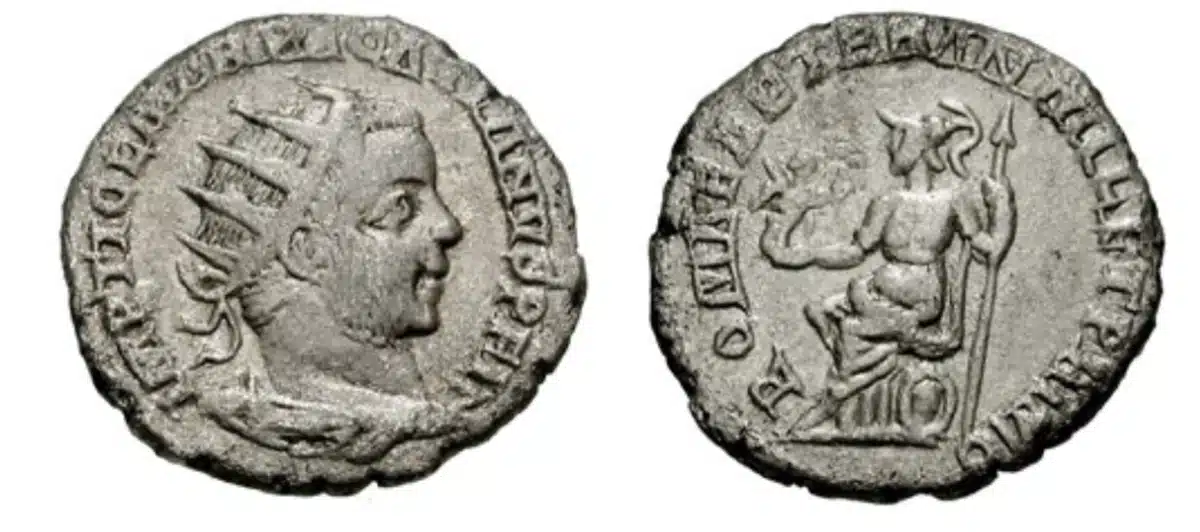
Very little is known about the life of Tiberius Claudius Pacatianus. He commanded one of the Danube legions during the chaotic third century CE and was proclaimed as emperor by his troops in the spring or early summer of 248. Emperor Philip I (“the Arab”, ruled 244-249) sent his general Trajan Decius to crush Pacatian’s revolt. After a few weeks, or possibly a few months, Pacatian was murdered by his own soldiers (a common fate of Roman usurpers during this period of “military anarchy”). Soon afterward, Decius’s troops proclaimed him emperor, and he defeated Philip, who was killed. Pacatian’s rare coins, possibly struck at Viminacium[14] in what is now Serbia, include one type[15] with a unique dating formula: ROMAE AETER[nae] MILL[esimo] ET PRIMO (“the Thousand and First Year of Eternal Rome”).
Justinian
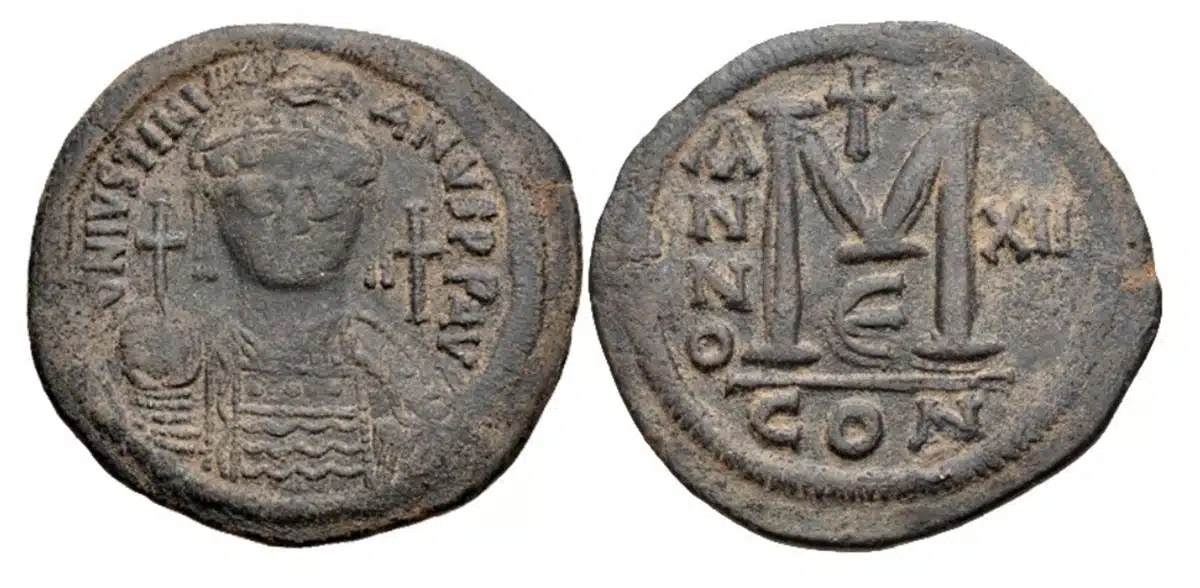 Electronic Auction 27916 May 2012 Lot: 645 realized: $65″ width=”1200″ height=”588″ />
Electronic Auction 27916 May 2012 Lot: 645 realized: $65″ width=”1200″ height=”588″ />Remembered as Justinian “the Great”, he ruled at Constantinople from 527 until his death in 565. In the Eastern Roman (“Byzantine”) Empire the year started on September 1st. Some gold coins were dated with Greek numerals according to the “Indiction”, a 15-year tax assessment cycle, but this was not used consistently. In 538, Justinian decreed that all official documents were to be dated according to emperor’s “regnal year” (often abbreviated as RY), which began when he came to the throne on August 1, 527. Justinian’s coins begin to carry these dates with Regnal Year 12, which corresponds to 538/539 CE. The reverse of Justinian’s bronze follis is inscribed with the Latin word ANNO (“in the year”) and the regnal year in Roman numerals[16]. On Harlan Berk’s list of the 100 greatest ancient coins, this type is #98 (Berk, 121).
Alfonso
 Triton X9 January 2007 Lot: 1165 realized: $3,000 ” width=”1200″ height=”675″ />
Triton X9 January 2007 Lot: 1165 realized: $3,000 ” width=”1200″ height=”675″ />Remembered as “Alfonso el Noble”, Alfonso VIII was king of the Spanish kingdom of Castile from 1158 until his death in 1214. He led a Christian coalition that shattered the Muslim Almohad Caliphate of Spain at the decisive battle of Las Navas de Tolosa[17] in 1212.
His wife Eleanor was a daughter of the English king Henry II. To commemorate his recapture of the strategic city of Toledo 1166, Alfonso issued the first European coins to bear a date since Roman times. The coin is a denier (1.08) struck in billon, a copper alloy with less than 50% silver[18]. The obverse bears a cross surrounded by the inscription ERA MCCIIII. This is the year 1204 in the local “Es-Safar” calendar, which was 38 years ahead of the Anno Domini (AD) system.
Valdemar II

20 November 2008. Lot 795/ 186. Estimate: DKK 250,000, approx $35,838. Unsold.
The first coin known to be dated according to the Anno Domini or “Common Era” was struck at Roskilde, capital of medieval Denmark, in the year 1234 CE. The coin was issued by Niels Stigsen, Bishop of Roskilde, during the reign of King Valdemar II “the Victorious” (ruled 1202-1241). The coin is a penning or “penny” struck in billon, weighing 1.00 gram. It bears a crown on the obverse with the inscription ANNO DOMINI (“Year of the Lord”) and a miter (bishop’s hat) on the reverse, with the inscription MCCXXXIIII (“1234”). Only seven examples of this coin are known, with six in museums. This example failed to find a buyer in a 2008 Danish auction, with an estimate of 250,000 Danish kroner (about $35,838[19]).
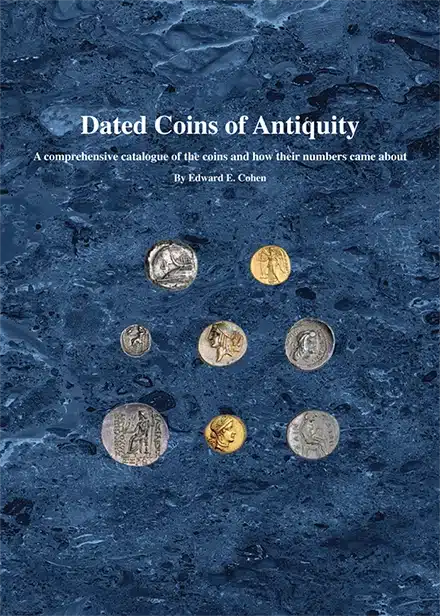
Collecting Dates on Ancient Coins
For collectors interested in dates on ancient coins, the essential reference is Cohen (2011); at 652 pages, a bargain for $135. The standard reference for medieval dated coins is Levinson (2007), at 336 pages which can be found for about $75.
* * *
Notes
[1] “Date” in this context means the numerical designation of a year, not the sweet fruit that grows on certain palm trees, or a social engagement with a prospective intimate partner.
[2] https://en.wikipedia.org/wiki/Common_Era
[3] http://numismatics.org/collection/2008.39.4
[4] CNG Auction 117, May 19, 2021, Lot 224. Realized $8,000 USD (estimate $3,000).
[5] https://en.wikipedia.org/wiki/Samian_War
[6] NAC Auctionn 66, October 17, 2012, Lot 79, realized CHF 130,000 (about $140,860 USD; estimate CHF 25,000).
[7] Roma Numismatics Auction XIII, March 23, 2017, Lot 428. Realized £70,000 (about $87,686 USD; estimate £50,000).
[8] Matthew, 26:15
[9] Goldberg Auction 135, June 18, 2023, Lot 1597. Realized $6,750 USD (estimate $7,500).
[10] Harlan Berk, Sale 223, June 22, 2023, Lot 370. Realized $250 USD (estimate $250).
[11] A complete list can be found at wikipedia.org/wiki/List_of_Roman_consuls
[12] https://en.wikipedia.org/wiki/Circus_Maximus
[13] Leu Web Auction 26, July 8, 2023, Lot 2847. Realized CHF 70 (about $79 USD; estimate CHF 50).
[14] https://en.wikipedia.org/wiki/Viminacium
[15] CNG Triton VII, Janaury 12, 2004, Lot 1018. Realized $13,000 (estimate $15,000)
[16] CNG E-auction 279, May 16, 2012, Lot 645. Realized $65 USD (estimate $100).
[17] https://en.wikipedia.org/wiki/Battle_of_Las_Navas_de_Tolosa
[18] CNG Triton X, January 9 2007, Lot 1165. Realized $3,000 USD (estimate $4,000).
[19] Bruun Rasmussen, November 20, 2008, Lot 795/186. Unsold (estimate DKK 250,000) $35,838.
References for Dates on Ancient Coins
Berk, Harlan J. 100 Greatest Ancient Coins. 2nd edition. Pelham, AL (2019)
Bickerman, E. J. Chronology of the Ancient World. 2nd edition. Ithaca, NY (1980)
Cohen, Edward. Dated Coins of Antiquity. Lancaster, PA (2011)
Cook, B. F. Reading the Past: Greek Inscriptions. Berkeley, CA (1987)
Friedberg, Arthur L. Coins in the Bible. Atlanta (2004)
Hartmann, John and George Macdonald. Greek Numismatic Epigraphy. Chicago (1969)
Hendin, David. Guide to Biblical Coins. 6th edition. New York (2021)
Kraay, Colin. Archaic and Classical Greek Coins. New York (1976)
Levinson, R.A. The Early Dated Coins of Europe 1234–1500. 2nd edition. Williston, VT (2019)
Sayles, Wayne G. Ancient Coin Collecting II: Numismatic Art of the Greek World. Iola, WI (1997)
* * *
The post How to Read Dates on Ancient Coins appeared first on CoinWeek: Rare Coin, Currency, and Bullion News for Collectors.
PNG Unveils Expanded Membership Options and Reinforced Ethics Pledge in Bylaw Updates
The Professional Numismatists Guild (www
Reverend Dr. Pauli Murray Quarter Enters Circulation on January 2
On Tuesday, Jan
Gold Inches Higher on Tuesday, Dec. 26
Palladium aside, prices of precious metals changed little at the start of the new trading week on Tuesday, following a break on Monday for Christmas
U.S. Mint Announces Harriet Tubman and Greatest Generation Commemorative Coin Prices
The United States Mint has released pricing information for its 2024 commemorative coins set to be issued in January and February
Legendary Coin Dealer John B. Love Has Passed Away
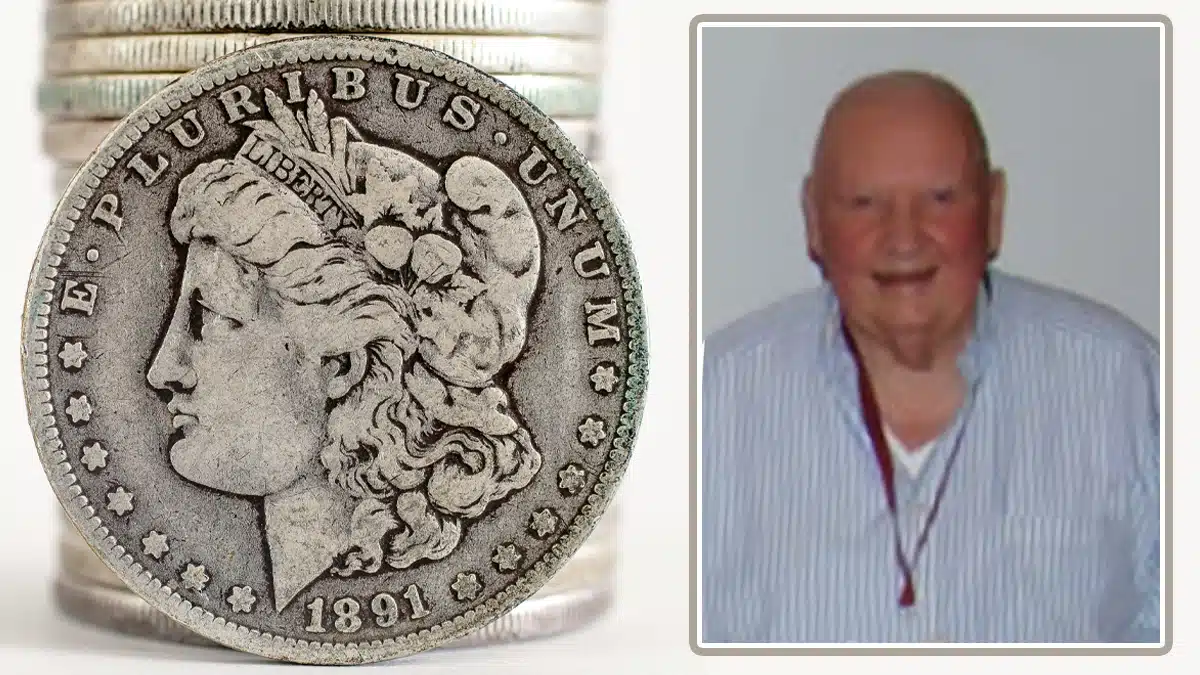
By CoinWeek Staff Reports …..
Longtime coin dealer John B. Love passed away on December 19, 2023, at his home in Whitefish, Montana. He was 87 years old. Love was a noted specialist in Morgan silver dollars and operated Record Coin Shop in the city of Cut Bank.
Love, along with fellow Morgan dollar specialist Wayne Miller, is widely regarded as one of the pioneers of the modern silver dollar market. The two were partners for a short time in the early 2000s.
John Love was born on June 6, 1936, in Carbondale, Illinois, to Virgil and Florence Bracy Love. Bracy was also John’s middle name.
He attended the University of Montana on a football scholarship as a young man, playing one year before switching to tennis. Love graduated in 1959 but already had his sights set on becoming a full-time coin dealer.
In 1962, he opened his business.
When the Redfield Hoard of Morgan dollars came to market, John was one of its three major distributors. He handled Morgan dollars by the bag, by the roll, and by the coin. Love was a mentor to PCGS and NGC coin grader Michael “Miles” Standish and is listed as a contributor to Standish’s book Morgan Dollars: America’s Love Affair with a Legendary Coin [Coin Analyst Louis Golino reviewed the book for us back in 2014. —CoinWeek]
John Love was a member of the Professional Numismatists Guild (PNG) and a Life Member of the American Numismatic Association (ANA). He was the 1990 recipient of the National Silver Dollar Roundtable’s Lifetime Achievement Award. In 2011, PCGS inducted Love into its Coin Dealer Hall of Fame.
* * *
The post Legendary Coin Dealer John B. Love Has Passed Away appeared first on CoinWeek: Rare Coin, Currency, and Bullion News for Collectors.
The Big Impact of Small Coin Collectors
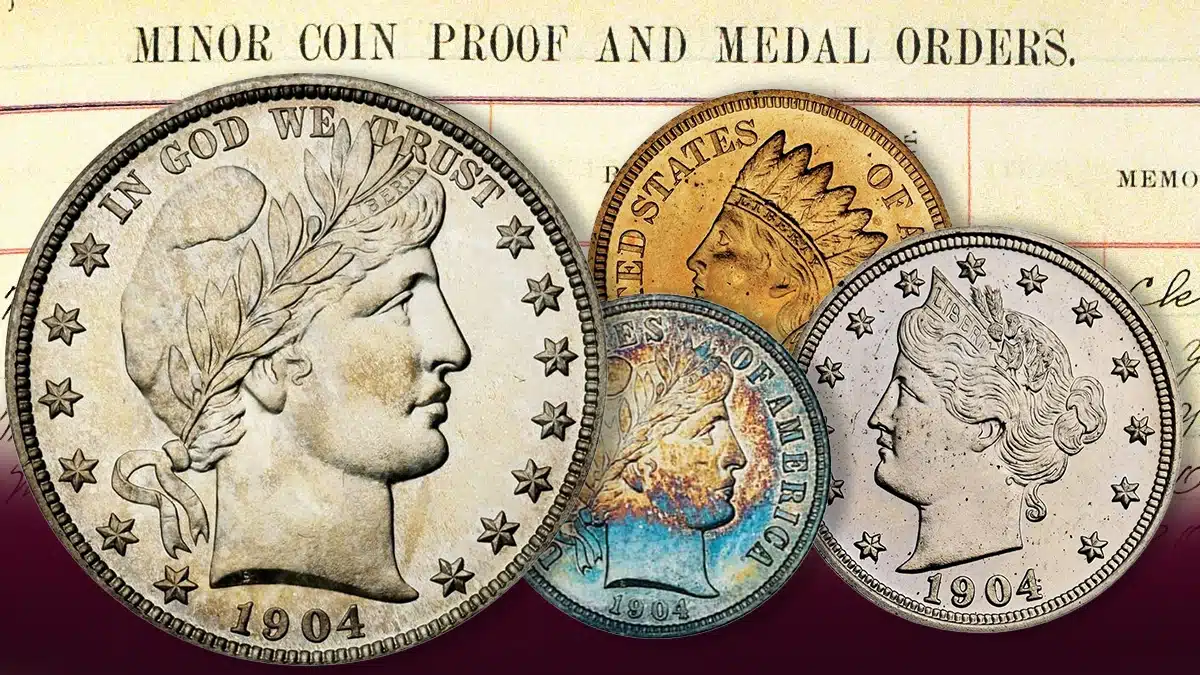
By Roger W. Burdette, special to CoinWeek …..
The Philadelphia Mint began selling sets of special coins to collectors in 1858. The new policy was not merely a bureaucratic whim, but a response to increased demand by coin collectors. With the old large copper cent supplanted by a smaller, copper-nickel alloy cent in 1857, large numbers of new coin collectors entered the hobby. At the time, officials at the United States Mint saw this as an opportunity to increase sales of medals and coins by producing special collectors’ versions of circulating coinage, and selling these at a small advance over face value.
Special “Master” or “Specimen” or “Proof” coins had been struck informally and sold to collectors for several decades, so the expertise in making a collectors’ specimen coin already existed. Likewise, presses and other equipment in the Medal Department could be used to make collectors’ coins when not engaged in striking medals. The Philadelphia Mint did what it could to promote coin collecting by selling annual sets of Proof coins and encouraging public tours of the Mint building.
By the 1870s, Philadelphia was striking and selling thousands of “Proof” coins directly to collectors across the country each year. In that era and up to the present, collections containing great rarities or those owned by wealthy and prominent people took the public spotlight. Yet, these “significant collections” were dwarfed in number and overall content by those of ordinary middle-class hobbyists. In effect, most collectable coins of today owe their origins to the John and Jane Does of past generations.
Few Mint records exist to detail collectors’ purchases. Letters requesting Proof coins were normally discarded after the order was shipped, and the Mint only sporadically maintained mailing lists of collectors. One extant source is an index to medal and Proof coin orders between 1895 and 1906[1]. The thick volume, probably one of what were once many similar volumes, lists thousands of collectors and institutions, their city and state, the amounts paid, and the Mint staff who responded to the order. Many orders were from banks and business in dollar amounts suggesting purchase of medals in silver and gold. But many others are clearly the orders of individual collectors – most of whom are unknown today.
A typical page from 1903 is printed below.
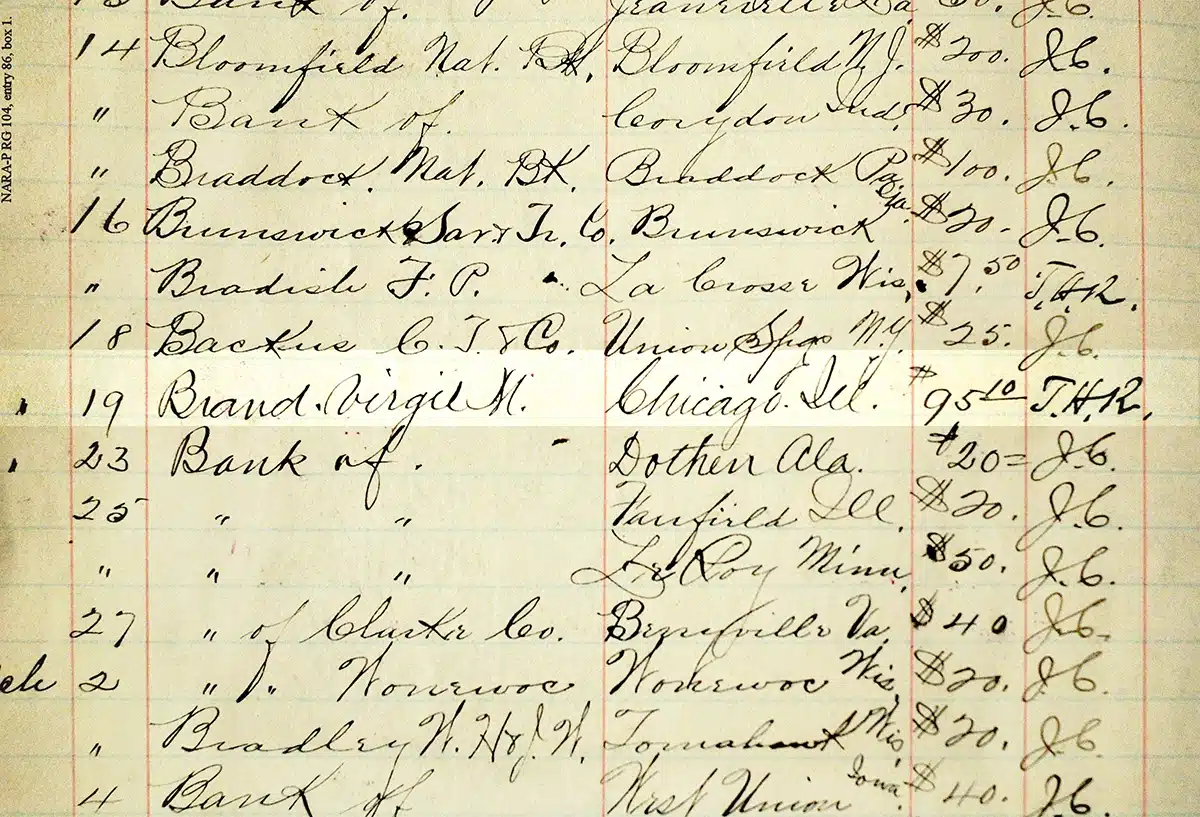
By knowing the cost of various Mint Proof sets, it is possible to estimate the contents of some orders. Notice that on February 20, L.R. Mixer from Brattleboro, Vermont, sent “8¢” in cash. Since we know that was the cost of a minor Proof set consisting of a cent and a nickel, evidently Mr. Mixer was adding to his coin collection during the New England winter. A minor and silver set, including the 1903 dollar, cost $2.25 plus postage. A complete set of all the 1903 Proof coins cost $40.75 or $38.50 for a glittering gold Proof set alone. Most orders were for medals, which generated more revenue than coins for the Mint.
Collectors also could order individual Proof coins, and this accounts for some of the odd amounts in the journal. Postage was often estimated, and the Mint took great pains to refund the correct amount of money.
Orders placed by big name collectors were handled just like the little guy’s 8¢ set. The detail below shows a March 1904 order by Chicago tycoon Virgil Brand. For his $94.00 postal money order, he likely received two gold sets, and multiple silver and minor sets. At times, he ordered minor sets by the hundred.
[[fig2]]
Collector Alexander Caldwell’s name also appears in this selection, although his $38.50 order seems modest when compared to Brand’s.
One of the few examples of Mint interaction with small coin collectors involved a Connecticut resident named Giles Anderson. The first letter about Proof coins is from 1897 concerning a missing 1896 order, which seems to have been resolved. We have nothing more until Anderson’s 1909 complaint about Proof Lincoln cents unfolds through correspondence long forgotten in Mint archives.
On December 6, 1909 Treasury Secretary Franklin MacVeagh forwarded a letter with enclosures to United States Mint Director Piatt Andrew:
Dear Mr. Andrew:
Here is a letter which came over from the White House, and I wish you would give it your personal attention. This is a matter that is Greek to me. The charge that there is something wrong in the handling of these numismatic matters in the Mint is something that needs investigation. Evidently this numismatist, Mr. Anderson, does not propose to let anybody or anything – not even the President nor any of his occupations – stand in the way of his coin fads. He is an American citizen, however, and his rights must be regarded.
Very sincerely yours,[2]
Giles R. Anderson, a coin collector from Waterbury, Connecticut, had written President William Taft in August 1909 to complain that he had ordered two sets of the minor Proof coins (including the VDB Lincoln cent) and not received his order or an acknowledgement from the Treasury Department. On December 1, he wrote a follow-up letter to Fred W. Carpenter, personal secretary to the president. The letter was passed to Secretary MacVeagh, who sent it to Mint Director Andrew to handle.
Last August I wrote the President and received your reply of August 20th, stating that my remittance for the Proof coins requested had been sent to the Secretary of the Treasury, for his consideration, but up to this date, I have heard nothing from the same at all.
It is not the amount of twenty-five cents, but the principle involved in my not having any reply at all, when I make a remittance for a definite object, that I complain about.
I desired to get one of the Proofs of the first issue of the Lincoln cents. The cost of the minor Proof set of one and five cent pieces is 8 cts. And I sent enough for two sets and the cost of registering the return package and one cent change.
As stated in my previous letter, I wrote to the Superintendent of the U. S. Mint at Philadelphia, when I heard that the new Lincoln cents were in the engravers hands and asked when Proofs could be obtained and received no reply, then finally saw that they were issued and sending for Proofs, find that they are at once recalled and none can be obtained.
These varieties are of interest to anyone who desires a complete collection of our country’s coinage and I have the Proofs from the date of my birth, to this present year and have regularly purchased the same from the Mint. Formerly the Mint would inform those who regularly purchased, if they did not get their order before the end of the year, so that the apparent oversight might be called to their attention, before it was too late to get them but during the past few years, in writing for information regarding any proposed new coinage and when Proofs could be obtained, there was either no reply, or a very misleading one and then all of a sudden the news through the papers, come that the new coin is issued and for some reason, being imperfect, is recalled and a new one is out and a FAVORED FEW ONLY, get the first Proofs issued.
This is not a S Q U A R E D E A L and as a citizen I have just as much right to the knowledge of when I can get Proofs, so that I can have a complete set, as speculators have, who walk in and buy them up and charge me higher rates for them.
I am well aware Sir, that this subject may seem a petty one when we compare the value of it to the country, to the investigation of the Sugar Trust etc. but it does seem to me, that when one has had his name on file, at the United States Mint in Philadelphia, as many years as I have, as a purchaser of the Proof sets, that in the event of new coins being issued, I should have the chance to get them.
An illustration of the above was in the issuing of the $20 gold piece.
At the very first when the first specimen coins were submitted to Bankers and others, there was immediately raised and [sic] objection to them, which objection was stated publicly as a very decided one, viz., that the knee of the Liberty projected so much that the pieces could not be stacked, as money is in a Bank and that they would therefore be very objectionable. Notwithstanding this fact, well known in advance of their issue, a small lot of them were issued, delivered to the favored few and immediately a “great discovery is made” Bankers do not like the new coins, call them in and change Liberty’s knee. This is done and at once the first issue are [sic] selling at prices ranging from $25.00 to $35 for a twenty dollar gold piece.
In this case, I had written the Mint B E F O R E they were first issued, asking when they could be had and received no reply for some time. I then had occasion to order some coins and asked the question again and with that package, written on an ordinary piece of scrap paper (not a Mint letter head) was the information, that the new coins would not be issued “this year” and it was only a short time after, before they were issued and recalled.
I know positively that in the time that was written to me, that the dies were in preparation, for their issue.
I believe Sir, that you can take this matter up and see that I am forwarded for my remittance Proofs of the first two issue of Lincoln cents which I desire and furthermore that such orders be given, that the Mint authorities would give notice by letter to all collectors who are getting Proofs each year, of any new issues, so they could keep their sets complete without paying tribute to any speculators.
Yours respectfully,
P.S. Kindly take this matter up before the time when the annual destruction of dies occurs, so that I may not be informed that it is too late[3].
Anderson had a number of “facts” regarding the Saint-Gaudens coinage incorrect, but his overall opinion was consistent with other disappointed collectors who failed to locate one of the high relief MCMVII double eagles, or who did not receive a 1909 VDB Proof cent with their order. Matters were further confused by inaccurate newspaper reports and wildly speculative estimates of the value of some of some coin varieties.
Director Andrew checked with Preston and others at Mint headquarters, and with Superintendent Landis in Philadelphia. He then prepared a memorandum dated December 7 for Secretary MacVeagh:
I have made some inquiries with regard to the question of Proof coins, referred to in the letter from Giles R. Anderson which you sent to me to-day. “Proof coins” are coins struck by hand by means of a hydraulic press upon discs which have been specially polished. The Mint is not obligated by law to sell such coins but makes a practice of doing so at a regular schedule of prices and the endeavor is to provide Proof coins of the current year for all those who ask for them. The Mint, however, sells no such coins of other than the current date.
Quite naturally, when a new coin is issued for only a few days and the design is suddenly changed, as was the case with the St. Gauden’s [sic] coins and as was the case with the Lincoln cents bearing the initials “VDB”, the Proof coins of the early issue very soon command an extraordinary price. It does not seem to me, however, that we are in any way obligated to provide collectors or others with Proof sets of designs whose coinage has been abandoned. Mr. Anderson and quite a number of other collectors have besieged the Department with demands for Proof sets of the Indian Head type bearing the numeral “1909”, of which a number were issued early in the year. As you know, the coinage of the Lincoln cent with VDB was stopped five days after the first issue and it appears that only one lot of Proofs of that coin were made. Only a few of those who ordered Proof coins of the Lincoln cents secured Proofs from those early dies and the other would-be buyers are naturally disappointed.
These Proof coins are only struck at the Philadelphia Mint and Mr. Landis says that orders are always filled there as received. I shall look into the matter when in Philadelphia at the end of the week, but one can easily see how utterly impossible it would be to meet the demand for such hand-made coins in the case of new coin models which have been abandoned soon after they began to be issued[4].
Two days later Mr. Anderson received a courteous “brush-off” from Director Andrew[5]:
Your letter of the 1st instant addressed to Mr. Fred W. Carpenter, Secretary to the President, has been referred to this Bureau by the Secretary of the Treasury. In reply you are respectfully informed that your former letter was referred to this Bureau by the Superintendent of the Mint at Philadelphia and it was supposed that officer would reply to you. Upon examination it appears that he returned your letter with the statement that there were no Proof Lincoln cent with the initials “V.D.B.” on hand. The Superintendent states that there was only one lot of Proof Lincoln cents with the initials made, as the coinage of these pieces was stopped five days after the first issue. He also states that orders were filled as received and the stock was soon exhausted. Having been directed to discontinue the coinage of the Lincoln one-cent pieces bearing the initials “V. D. B.” there was no alternative but to stop coining both the ordinary and the Proof pieces.
It is not considered a part of the duty of the Superintendent of the Mint to notify coin collectors when Proof coins can be had. I regret that you did not file your application in time with the Superintendent of the Mint at Philadelphia to obtain Proofs of the Lincoln one-cent piece with initials.
In the examination of the letter of the Superintendent of the Mint at Philadelphia returning your former letter to the Bureau the 25 cents forwarded by you was found enclosed and is returned herewith[6].
Nothing more appears in the Mint’s archives regarding Mr. Anderson’s search for 1909 Proofs. It is likely he had to buy the coins he desired from a dealer.
Fortunately, the Mint Bureau’s uncooperative attitude did not long dissuade Mr. Anderson from his “coin fads”. In 1921, we find him writing to the Mint Director in hopes of obtaining some of the new Peace dollars for his collection[7].
Although Anderson failed in his immediate quest for a 1909 VDB Proof, he continued his hobby, just as did thousands of other small coin collectors. Each year they bought Proof sets and individual coins, carefully admiring the coins and putting them in cabinets or custom made albums. Some vanished by chance at the local penny candy emporium; others disappeared during the Great Depression out of necessity. But many of these coiner’s gems, accompanied by pieces saved from circulation or traded with hobby friends, survived to be passed on to future generations of collectors.
The century-old coins we now admire were more likely once owned by the “little guy” than by some “big name” collector.
* * *
Notes
[1] NARA RG104 Entry 86 Box 1. “Minor Coin Proof and Medal Orders.”
[2] NARA-CP, RG104 Entry 229, box 284. Letter dated December 6, 1909 to Andrew from MacVeagh.
[3] NARA-CP, RG104, Entry 229, box 284. Letter dated December 1, 1909 to Fred W. Carpenter from Giles R.
Anderson.
[4] NARA-CP, RG104 Entry 229, box 284. Memorandum dated December 7, 1909 to MacVeagh from Andrew.
[5] RG104, Entry 235, vol. 380, Letter dated December 9, 1909 to Anderson from Andrew.
[6] A batch of 500 Proof 1909 Lincoln cents was struck on December 3, and another 298 on the 23rd. It’s strange that a coin or two could not have been located for Mr. Anderson.
[7] RG-104, Entry 235, vol 441. Letter dated December 27, 1921 from O’Reilly to Anderson.
* * *
The post The Big Impact of Small Coin Collectors appeared first on CoinWeek: Rare Coin, Currency, and Bullion News for Collectors.
Rare Chance to Own Tied-for-Finest Proof DCAM 1951 Franklin Half Dollar
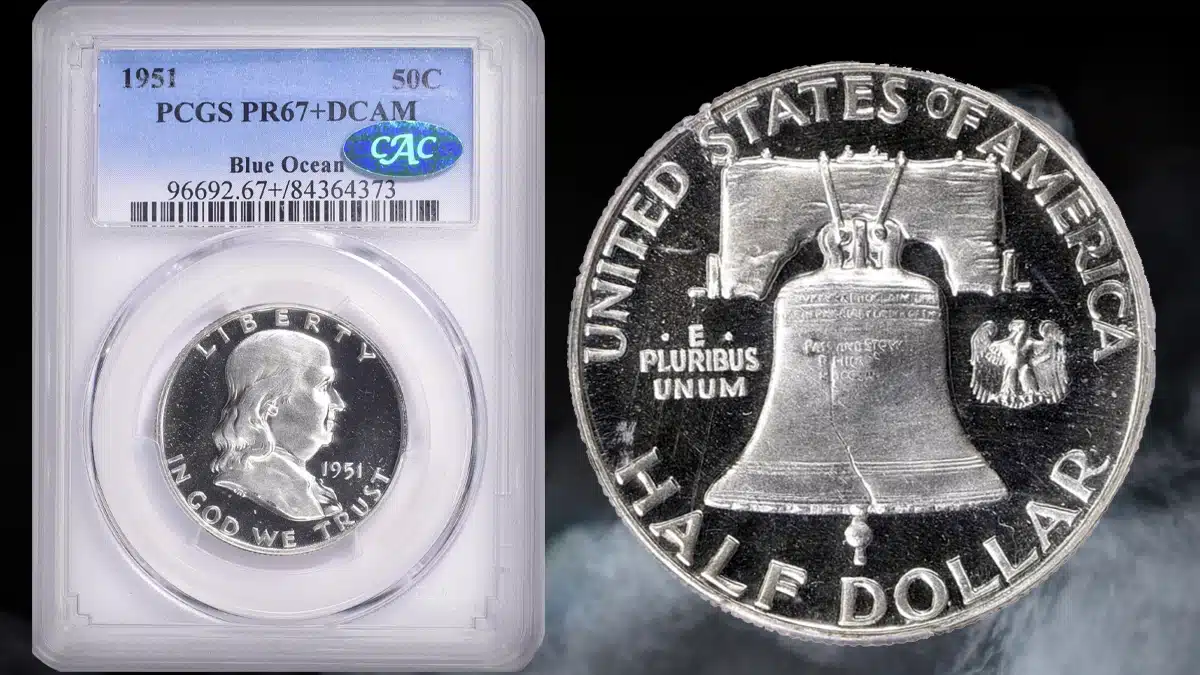
Among the 14-year run of Franklin half dollar Proofs, the second-year 1951 Franklin Proof is second only to the key date (and first-year issue) 1950 Proof, and as such it can be a real challenge for collectors. Yet the 1951 tends to come nicer than the inaugural Proof issue, with the United States Mint improving its production every year even as it ramped up the mintage numbers. Still, these mintage numbers were determined by demand for the Mint’s annual Proof set, and only 6,114 sets were sold in 1951.
Having said that, High Gem Cameo and Deep/Ultra Cameo examples are hard to come by – not least of which because the plastic sleeve that the 1951 Proof set came in was quite abrasive.
But not only does the December 31 auction from GreatCollections represent a rare opportunity to own such a quality piece but it’s also a chance for the competitive collector to obtain one of the two finest known Proof 1951 Franklin half dollars graded PR67+ DCAM by PCGS. On the PCGS CoinFacts page for the issue, this coin is one of the featured images at the top of the entry. Pedigreed to the Blue Ocean Collection, the coin is also approved by CAC as strong for the grade.
The Blue Ocean coin sold in an August 2017 public auction for $82,250 USD–an auction record for the date and grade. At the time of publication, PCGS estimates a Proof 1951 Franklin half in PR67+ DCAm to be worth $85,000.
With nine days left before the auction, the starting bid on this Deep Cameo 1951 Proof Franklin half dollar is $40,000.
* * *
To search through GreatCollection’s archive of over 600,000 certified coins the company has sold over the past eight years, please visit the GreatCollections Auction Archives.
* * *
The post Rare Chance to Own Tied-for-Finest Proof DCAM 1951 Franklin Half Dollar appeared first on CoinWeek: Rare Coin, Currency, and Bullion News for Collectors.
Gold Ends at 3-Week High Ahead of Christmas Break; Other Metals Also Gain
Precious metals were mixed for a third consecutive day on Friday, just before the extended weekend break for Christmas
2024 American Women Quarter Images Unveiled
The United States Mint has made available images of their 2024 American Women quarter dollars
Pert Mint Gold Bullion Sales Hit 5-Month High in November, but Silver Sales Sluggish
Demand for Australian gold bullion reached a 5-month high in November, while sales for Australian silver bullion slowed to a 45-month low, according to figures from The Perth Mint of Australia
Heritage’s Dec. 14-17 US Coins Auction Tops $5.65 Million, Led by 1815 Quarter
Nearly three dozen bids poured in for the finest-certified 1815 B-1 Quarter Dollar, CACG-Certified MS67 until it sold for $126,000 to lead Heritage’s US Coins Signature ® Auction to $5,654,911 Dec
Prices of Precious Metals Change Slightly on Thursday, Dec. 21
Precious metals were divided for a second session on Thursday, with pricing changes for each of them being very modest

1904 St. Louis World’s Fair Coins and Medals Struck by the U.S. Mint
By Vic Bozarth for PCGS ……
In part four of this series, we arrive at the 1904 Louisiana Purchase Exposition in St. Louis, for which the United States Mint struck two commemorative gold dollar coins and a slew of medals. We’ll also touch on a couple of the myriad of medals, tokens, and other items historically tied to the 1904 World’s Fair
The Significance of the 1904 St. Louis Exposition
In 1803, Napoleon Bonaparte of France sold the massive piece of land in North America involved in the Louisiana Purchase to Thomas Jefferson, the third president of the United States. Comprising some 827,000 square miles of land, the purchase nearly doubled the geographical size of the U.S. at that point in time. Jefferson was a forward thinker who had long-term goals of acquiring the Louisiana Territory, which secured the Port of New Orleans and access to the entire Mississippi River basin. Jefferson was also enamored with the possibility of an inland water route to the West Coast through the interior of the continental United States.
A Centennial Exposition celebrating the 100th anniversary of the Louisiana Purchase was proposed as early as 1898. Both Kansas City and St. Louis vied for the honor, given their central location in the nation in the territory consumed by the purchase. Strong local backing in St. Louis and early planning were crucial, but $10 million of the $15 million needed to host the expo was in place by 1901!
Ironically, one of the biggest proponents of the Louisiana Purchase Exposition was President William McKinley, who actively supported the St. Louis World’s Fair project after organizers visited him at the White House in February 1901. Later that year, on September 6, 1901, McKinley was shot while attending the Buffalo Pan-American Exposition in New York. He died of his injuries eight days later.
With widespread backing and sufficient funding, organizers were able to plan for the fair relatively early compared to other expos. City planner George Kessler created the master design for the fair, which sprawled across a fairground nearly two square miles in size and went on to draw some 20 million visitors. The formal opening of the fair occurred on April 30, 1904, with the 1904 Olympic Summer Games, the 1904 Democratic National Convention, and the 1904 American Numismatic Association (ANA) convention held concurrently with the expo.
St. Louis Exposition Commemorative Coins and Medals
Coins produced for the expo included the 1903 Jefferson Gold Dollar and the 1903 McKinley Gold Dollar, which were sold at the fair in a booth helmed by prominent numismatist Farran Zerbe.
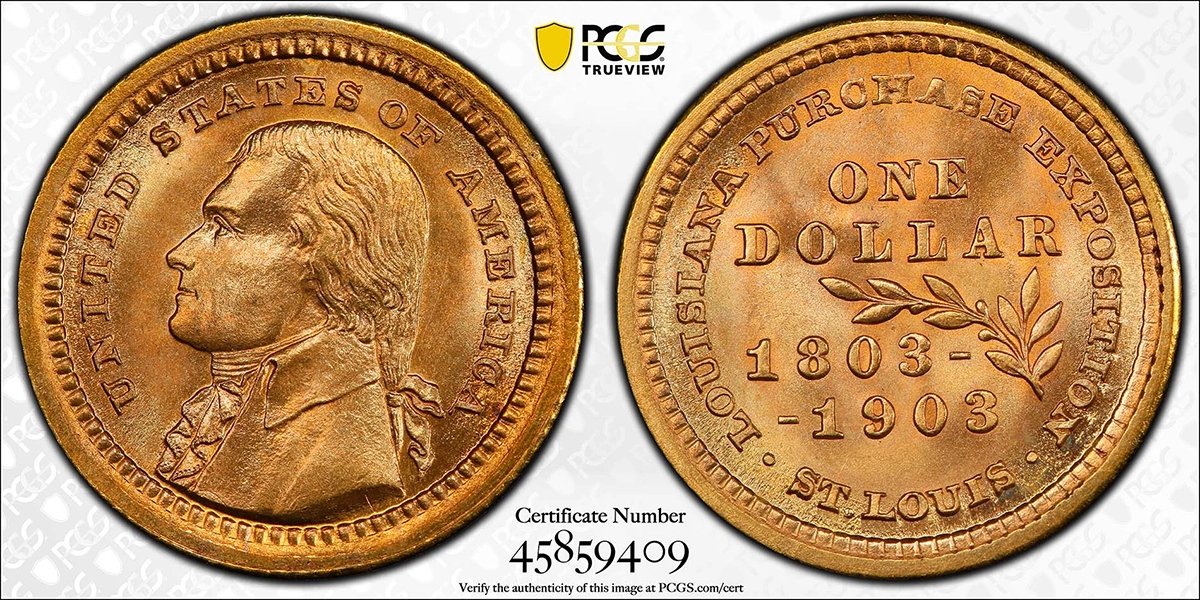

In addition to these commemorative gold dollars, the United States Mint also struck an amazing souvenir medal design across seven different metals. Engraver George T. Morgan designed the souvenir medal, most of which were struck on the grounds of the expo. While the obverse rightly portrays both Jefferson and Napoleons’ busts, Morgan’s reverse work is exceptional, depicting the continental U.S. with the Louisiana Purchase superimposed in high relief on the amazingly detailed map.
Also produced were five different award medals, some of which were struck in various metals. Adolph A. Weinman’s designs for all five award medals were exceptional in both aesthetic appeal and subject matter. Weinman’s later work on the Walking Liberty Half Dollar would be evident especially on the exceptional award medals for the Louisiana Purchase Expo.

Most of the medals were struck at and sold in the Government Building at the fair by Treasury Department employee Charles Stouthard Muir. Of the seven different metal issues of the Official Souvenir Medal, HK-299 through HK-304, are all obtainable with rarity ratings between R-3 and R-6, but for the unique gold issue HK-299a which is classified as R-10.
A total of nearly 90,000 of these medals were produced on the fairgrounds and most (copper and bronze) sold for 25 cents each. The exceptions were for the silver, which was originally priced at $1 and later $1.25 (evidently, 6,002 pieces were struck at the mint in 1905 and 1906), with the gilt and gold-plated bronze versions selling for 50 cents apiece.
- PCGS #642693, HK-299 – Silver (Rarity-4)
- PCGS #642694, HK-299a – Gold
- PCGS #642695, HK-300 – Gold-Plated Bronze
- PCGS #642696, HK-301 – Copper BN
- PCGS #642697 – Copper RB
- PCGS #642698 – Copper RD
- PCGS #642699, HK-302 – Yellow Bronze
- PCGS #642700, HK-303 – Bronze BN
- PCGS #642701 – Bronze RB
- PCGS #642702 – Bronze RD
- PCGS #642703, HK-304 – Gilt
St. Louis World’s Fair Award Medals
The award medals produced for the Louisiana Purchase Exposition comprise a highly impressive group of medallic art for the period. There were five levels of award medals given, all designed by Weinman and struck at the U.S. Mint.
Produced in several unique shapes, there were Grand Prize, Gold Medal, Silver Medal, Bronze Medal, and Commemorative Award Medals. All five of these award medals were made in “government bronze”, although the “gold” and “silver” medals were issued with a gilt and silvered finishes, respectively.
- Grand Prize Medal, PCGS #910671 – Five-Point Shield Design, 74 x 60 millimeters; H-30-90 (Mintage: 3,300)
- Gold Award Medal, (PCGS #910670 Gilt Silver, PCGS #888062 Gilt Copper) – Three-Point Shield Design, H-30-70

- Silver Award Medal, Square design, 2.625” x 2.625”; H-30-50 (PCGS #804837, Bronze)
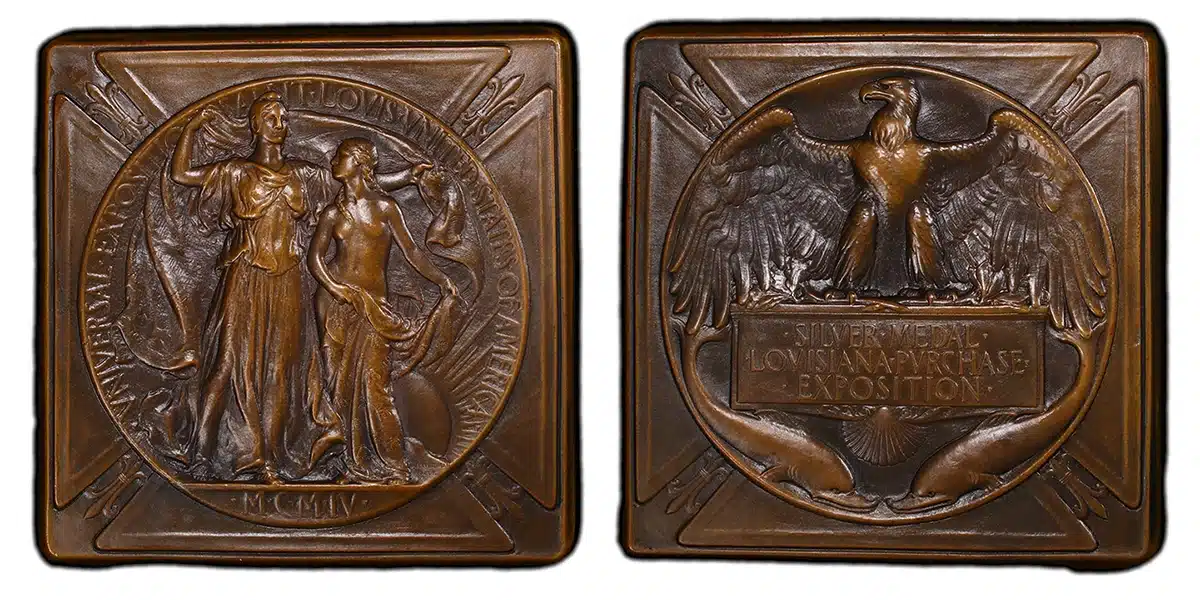
- Bronze Award Medal, Round Design, 2.5” diameter; H-30-40
- Commemorative Award Medal, Three-Point Shield Design, 3” x 3”; H-30-110
Among the many commercial medals and tokens produced at the Louisiana Purchase Exposition, a “Souvenir Coin of Admission” was issued by the Louisiana Purchase Souvenir Coin Company and is not related to the exposition company itself. The round and octagonal issues comprise So-Called Dollar numbers HK-305/305a for the round issues and HK-306 and 307 for the octagonal issues.
Both sizes of the medal were struck in brass, and while many are serial numbered on the medals themselves, there are also examples of each size without serial numbers. The round examples are under #25000 and the octagonal examples are all over #25000.
- PCGS #642705, Round
- PCGS #642707, Octagonal

These privately struck commercial issues were confused with official Mint issues, and the company itself disappeared. While many of the first 25,000 round St. Louis Expo medals had been sold, another order for 25,000 octagonal examples was placed without the vendor obtaining official recognition either as an official souvenir or concession dealer. Most of these octagonal issues were purchased by souvenir and coin dealers.
Other Collectibles Relating to the 1904 World’s Fair
There were many other interesting items produced that tie into the Louisiana Purchase Exposition. To be sure, anything presidential in nature demands attention, and President Theodore Roosevelt was prominently featured on numerous advertising items from the fair.
Postcards were also immensely popular in terms of both communication and advertising. Today, when many of us take an exciting trip or see something interesting, some of us post a photo of it on social media. In 1904, countless people shared these intriguing experiences via postcards. Postcards both conveyed a message and served as bragging rights, especially when sent from a famous location or event, such as the Louisiana Purchases Exposition.
Meanwhile, Zerbe, who was selling 1903 Jefferson and McKinley Commemorative Gold Dollars at his expo booth, also had other novelty items for sale there. Among them was a wooden postcard picturing the obverse of both Commemorative Gold Dollars. He offered to mount either coin or both in a pendant or stick pin as a marketing feature, though most purchasing these coins passed on the mounting.
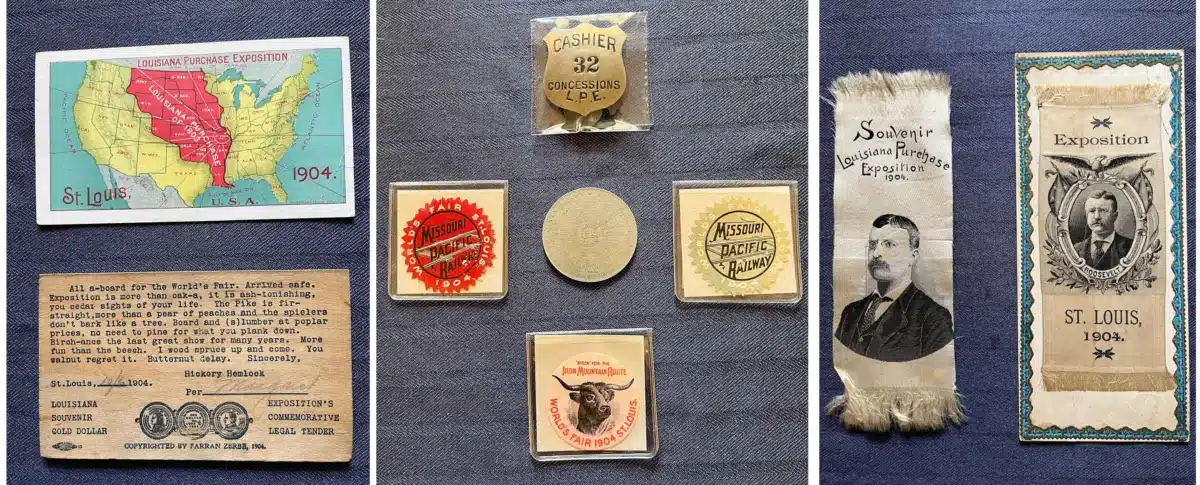
The Louisiana Purchase Centennial was commemorated in virtually every medium available at that period in time. And isn’t it human nature to want to bring a souvenir home? Decades later, many people still find Louisiana Purchase Exposition items fascinating and highly collectable. Someone who found them especially exciting was well-known coin dealer and collector Robert L. Hendershott, who authored fair guidebook 1904 St. Louis World’s Fair Mementos and Memorabilia (1994). Hendershott’s book lists and has images of hundreds of items from the fair. Why was he so fascinated with the Louisiana Purchase Exposition? He attended as a child in 1904!
* * *
For more information from PCGS, the sponsor of this article, click on the image below.
* * *
The post 1904 St. Louis World’s Fair Coins and Medals Struck by the U.S. Mint appeared first on CoinWeek: Rare Coin, Currency, and Bullion News for Collectors.
Stack’s Bowers Nov. 2023 Whitman Auction Earns Near $23 Million

The November 2023 Whitman Coin Expo auction held by Stack’s Bowers Galleries focused on U.S. coins, paper money, tokens, medals, and physical cryptocurrency. Live and online sessions offered select pieces from such noteworthy collections as the Louis Eliasberg, Sydney F. Martin, and Fairmont collections. Altogether, the sale earned a total of $22,958,460 USD (including buyer’s fee) that included several record prices.
CMQ and CMQ-X certified coins were met with a good reception in the November 14 Rarities Night session of the sale. Two Eliasberg coins lead the entire sale: an 1855 Kellogg and Co. $50 gold coin (PCGS PR63 CAM) went for $780,000 USD, and an 1860 Clark, Gruber, and Co. “Pikes Peak” $20 gold coin (PCGS AU-55) garnered $552,000.
Only a few 1907-D Liberty Head Proof $20 gold double eagles are known to exist. One of them, an example graded PCGS PR62, achieved a price of $432,000 in this Stack’s Bowers sale.
The Kronen Set of U.S. gold coins was the Fairmont selection offered in the Whitman auction. A Carson City 1872-CC $5 gold half eagle (PCGS EF45 CAC), Winter 1-B, sold for $18,000, and a Carson City $10 gold eagle (PCGS EF45) from 1875, Winter 1-A, went for $22,800. An 1866-S No Motto double eagle (PCGS AU53 CAC) garnered $45,600.
Stack’s Bowers also offered Part V of the Sydney F. Martin Collection of Colonial Coins and Medals at the Whitman Expo, which also hosts the annual meeting of the Colonial Coin Collectors’ Club (C4). Visit StacksBowers.com for prices realized.
Other colonial highlights include an Eliasberg (ca. 1616) Large Portholes Sommer Islands sixpence that sold for $72,000 and a gold “1799” (ca. 1800) Washington Funeral Urn medal that went for $66,000.
Outstanding results from the Muddy River Collection of Massachusetts Silver Coins include an R-8 1652 Noe-17.5 Oak Tree sixpence that garnered $9,600 and a 1652 Noe-6 Large Planchet Pine Tree shilling that achieved $20,400.
Numismatic Americana also featured strong action, highlighted by a freshly discovered 1789 East Florida Carlos IV Proclamation medal (4 reales) that went for $72,000.
American Paper Money achieved excellent price results in two sessions that earned a total of $2,873,156–visit the company’s website for more info.
The Stack’s Bowers November 2023 Physical Cryptocurrency offering also took place over two sessions, with a 2011 Casascius 1 Bitcoin leading the way at $55,200.
Complete prices realized for the Stack’s Bowers Galleries November 2023 Whitman Auction can be found at StacksBowers.com.
Stack’s Bowers Galleries is now accepting consignments of U.S. coins, medals, tokens, and paper currency for the Official Auction of the Spring 2024 Whitman Baltimore Expo. To find out how to consign to this or any other future Stack’s Bowers auction, please call 800-458-4646 or email Consign@StacksBowers.com.
* * *
The post Stack’s Bowers Nov. 2023 Whitman Auction Earns Near $23 Million appeared first on CoinWeek: Rare Coin, Currency, and Bullion News for Collectors.
The 1909-S VDB Lincoln Cent and How it Changed the Hobby: CoinWeek Streaming News
CoinWeek Streaming News is brought to you by NGC. For information about NGC’s current grading specials and services, as well as to look up certs, pricing information, and current populations, visit www.ngccoin.com.
* * *
CoinWeek editor Charles Morgan takes a deep dive into the 1909-S VDB Lincoln cent, the coin that changed American numismatics forever.
Buoyed by the issue’s low mintage and coupled with the controversy surrounding the removal of the designer’s rather prominent initials on the coin’s reverse, the 1909-S VDB Lincoln cent has been the stuff of numismatic lore for more than a century.
But there’s much more to this coin than its status as a series key. Not only was the 1909-S VDB the coin that popularized collecting coins by mintmark, but it also broadened the appeal of the numismatic hobby to the general public – with the help of an enterprising inventor, whose penny boards gave Depression-era Americans holes to fill.
After it quickly became apparent that the 1909-S VDB was hard to find, the rush was on. Learn about how one Maryland dealer turned a $250 investment into a $43,750 payday. Also, find out how Brenner’s beloved design almost met an early end when President Theodore Roosevelt tapped one of America’s most accomplished artists to reinvent all of America’s coinage from soup to nuts.
* * *
The reviews are in! Charles Morgan and Hubert Walker’s 100 Greatest Modern World Coins has gotten five-star reviews on Amazon and Lou Golino and David T. Alexander both gave the book their highest recommendations.
The post The 1909-S VDB Lincoln Cent and How it Changed the Hobby: CoinWeek Streaming News appeared first on CoinWeek: Rare Coin, Currency, and Bullion News for Collectors.
Prices of Precious Metals Split on Wednesday, Dec. 20
Prices of precious metals split on Wednesday following a day of across-the-board gains, with gold and palladium falling, and silver and platinum rising
1857 Flying Eagle Cent “Varieties” – Jack Young’s Fun With Fakes
By Jack D. Young, Early American Coppers (EAC), and the Dark Side Group ……
A new installment of my CoinWeek exclusive series documents three different counterfeit 1857 Flying Eagle cents, all with their own unique telling markers. I’ll start with this example that a friend posted to the Dark Side Group. He asked members which one they liked better:
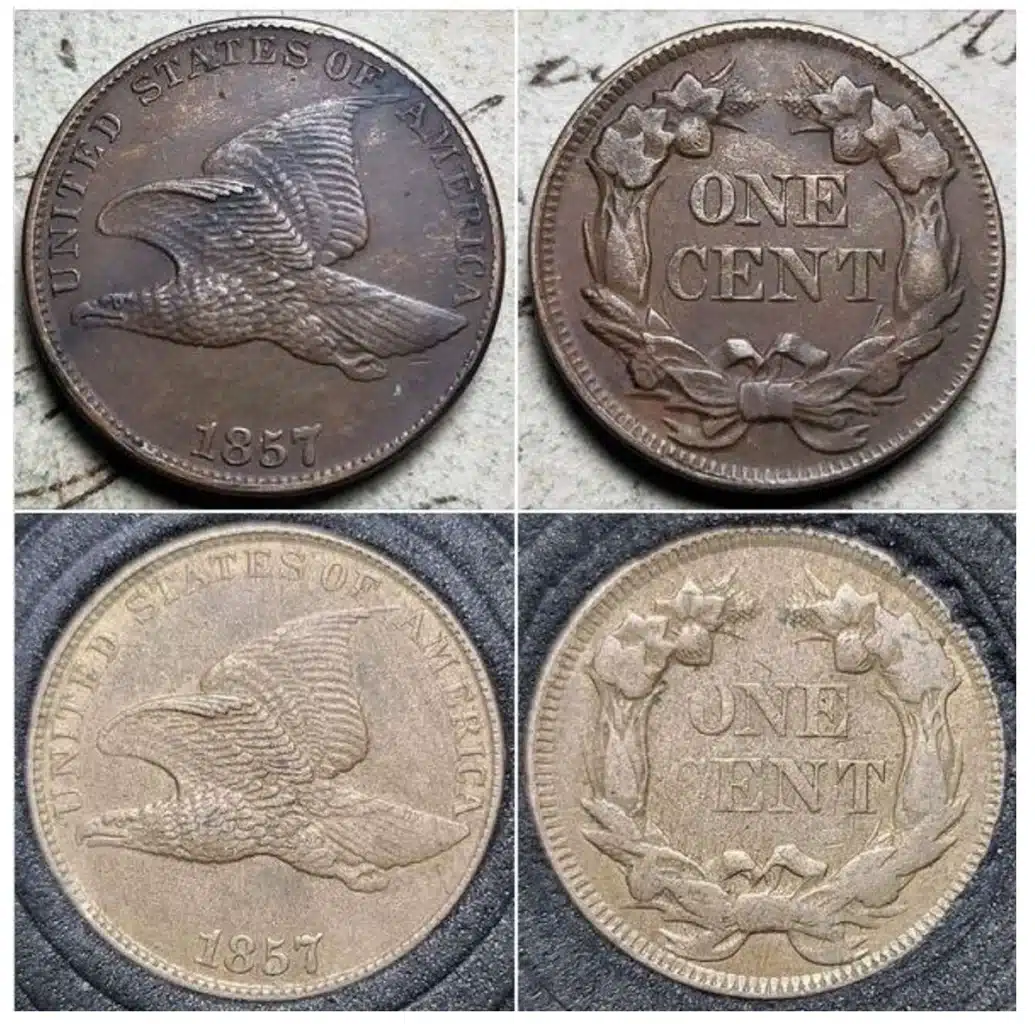
After review, the best answer in my opinion was “the not counterfeit one”!
One of the best “tells” for this variety of fake is the reverse “chip” as circled in red:

This particular type has been around for a while, as evidenced by this 2017 “Bay” sale and an article by NGC that documented it.
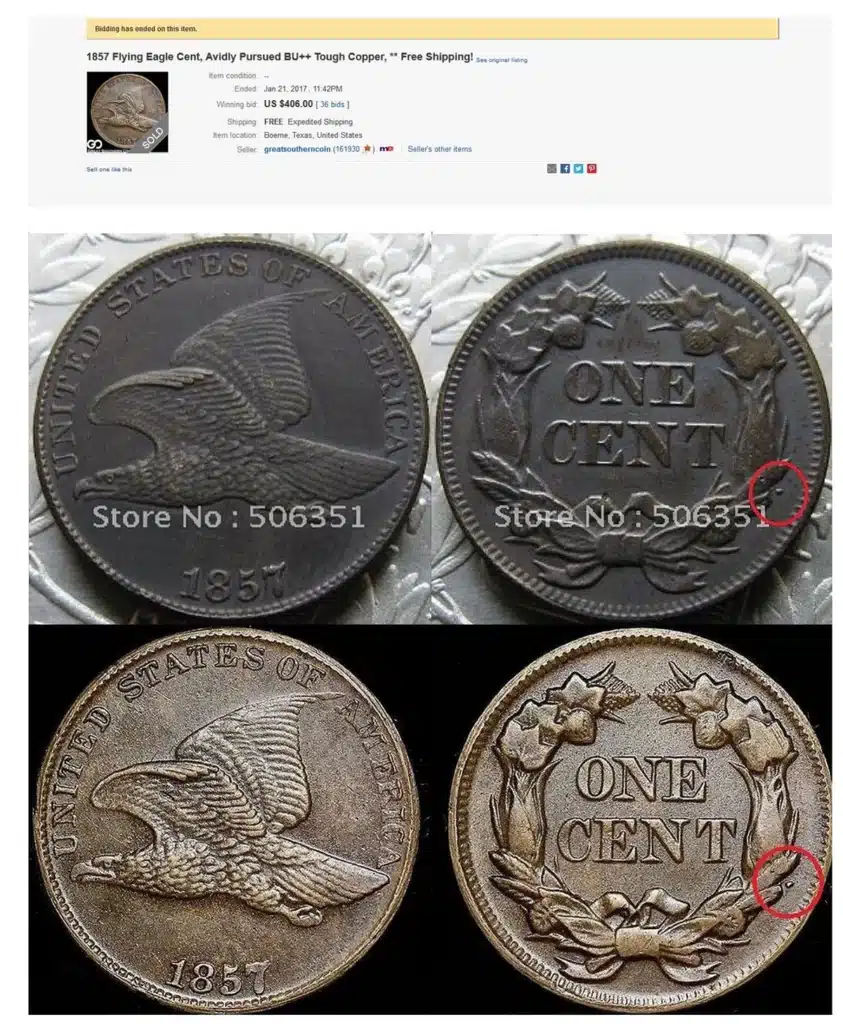
To read that article on counterfeit 1857 Flying Eagle cents, click here

But the research doesn’t stop, as there are others also in the marketplace currently. The following examples have an apparently shared reverse; I nicknamed them the “Notched T” counterfeits.
I sent a note to Flying Eagle and Indian Head cent expert Richard Snow and received the following information about the “T”: “it’s a defect in the transfer process” (for making the false dies).
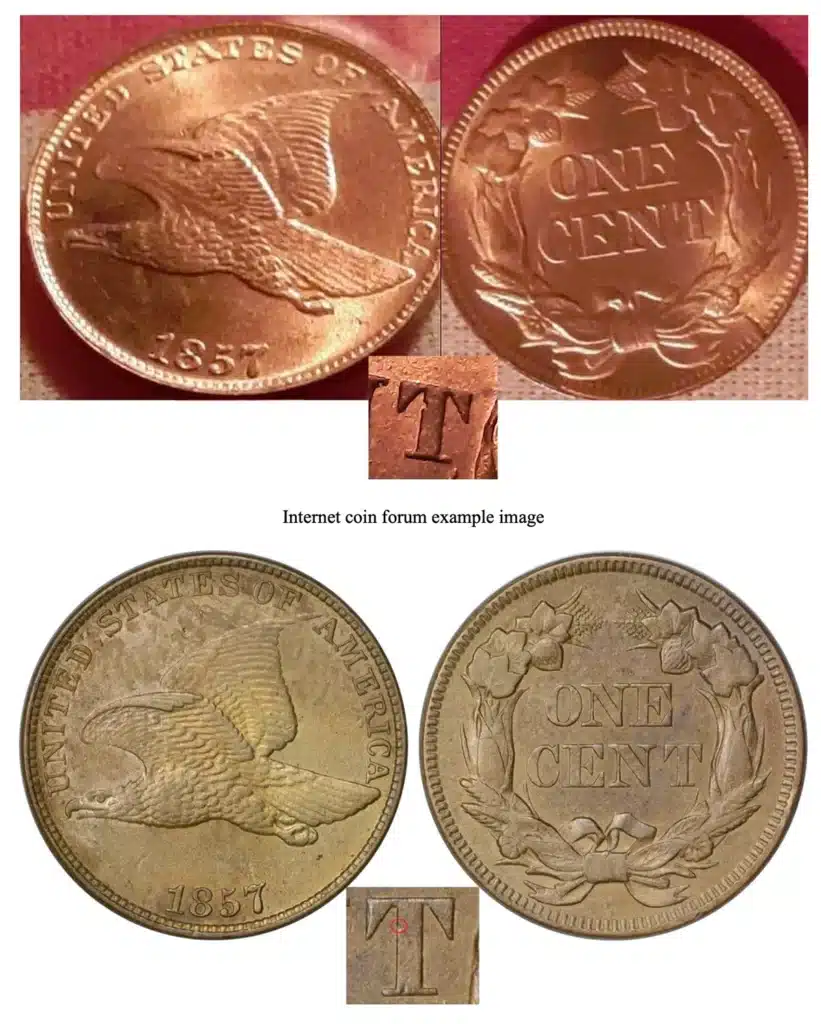
And an example submitted and returned body-bagged by NGC:
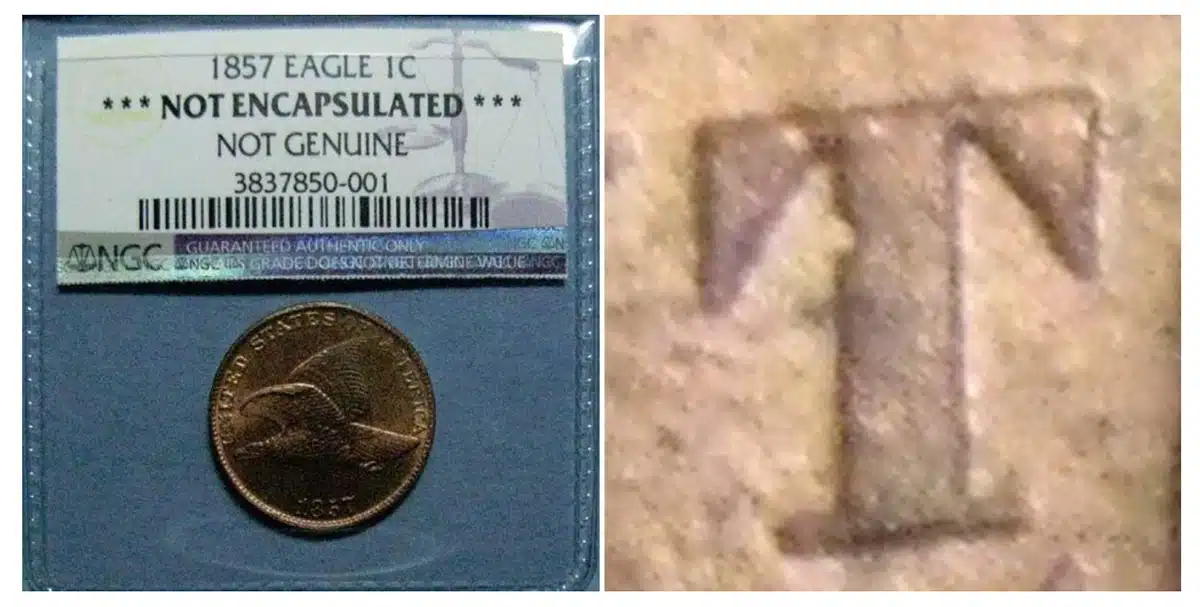
Continuing down the proverbial rabbit hole leads to the latest fake of the family, one I nicknamed the “Bad T” (of UNITED).
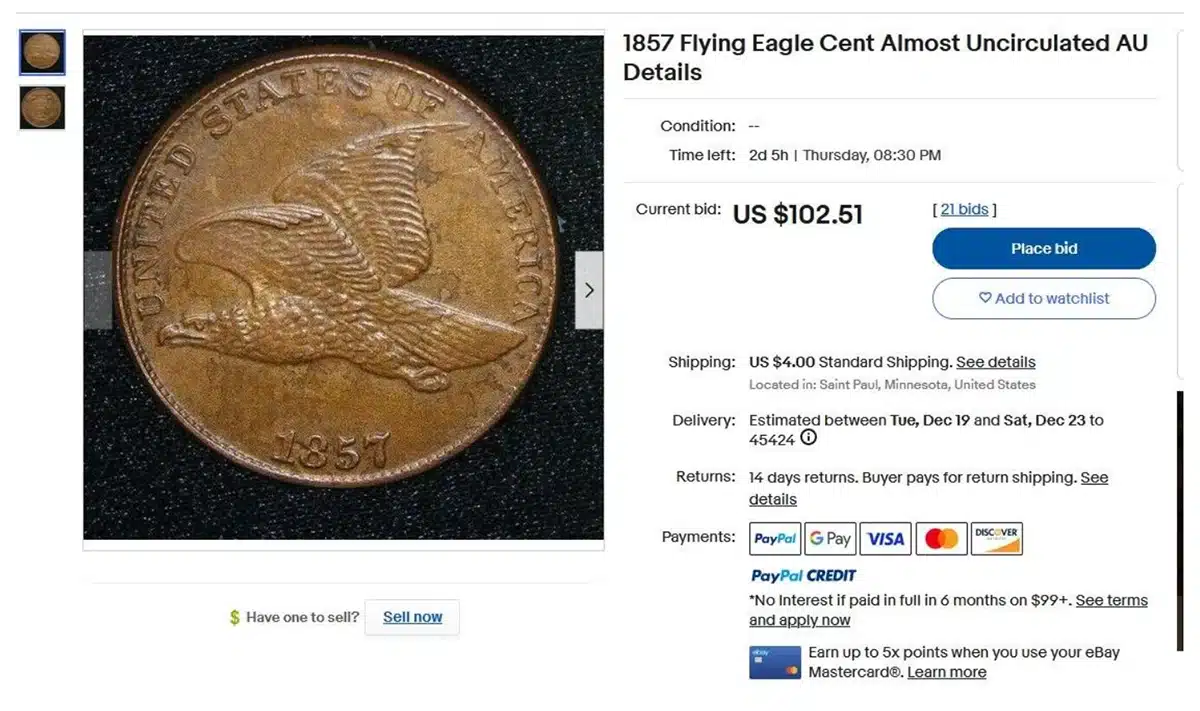
A fairly decent looking example until you examine it more closely; there are lots of depressions and surface irregularities, as well as the odd “T”:
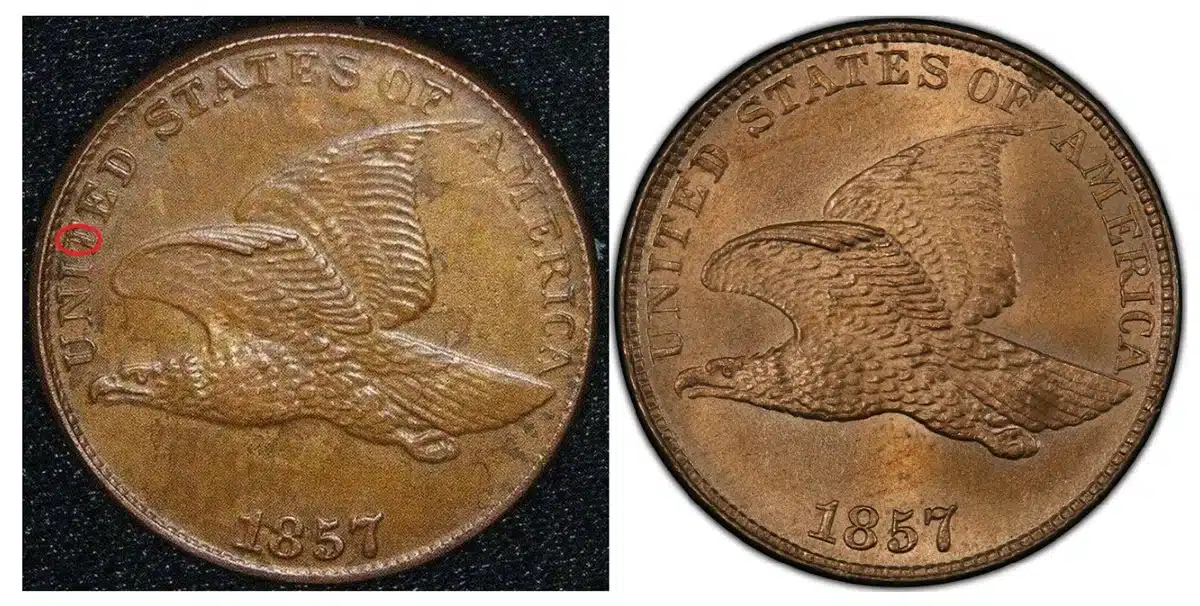
Didn’t take much looking to find others after this one was reported!
Here’s an example from Ecrater.com:

This counterfeit matches the eBay listed one exactly.
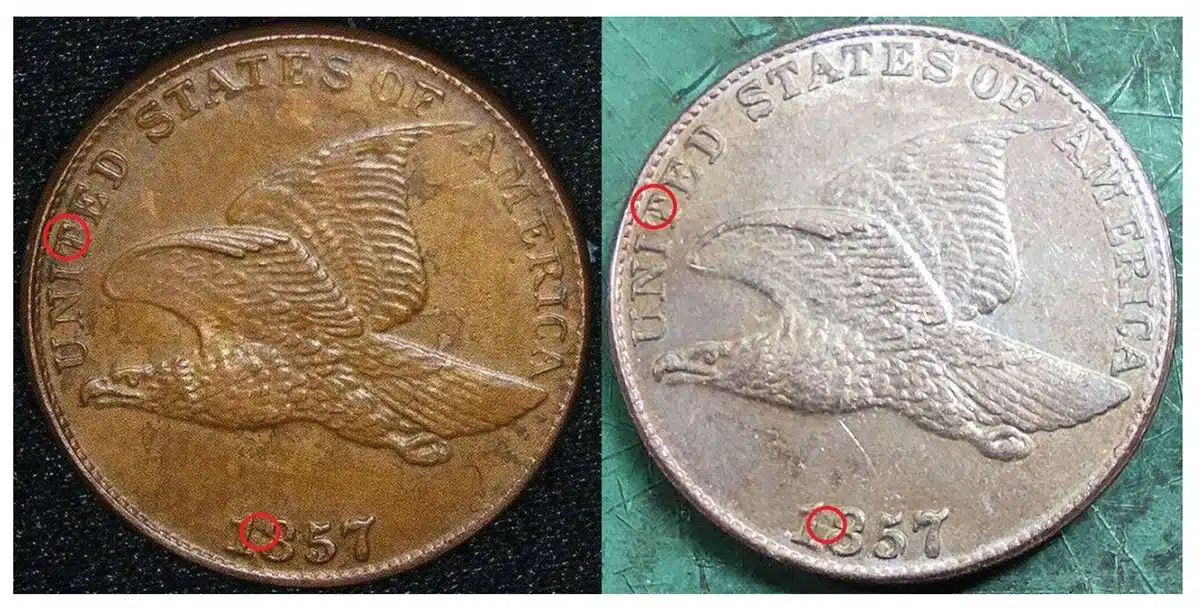
And another “Bay” example, this one showing some of the attribution marks even better:

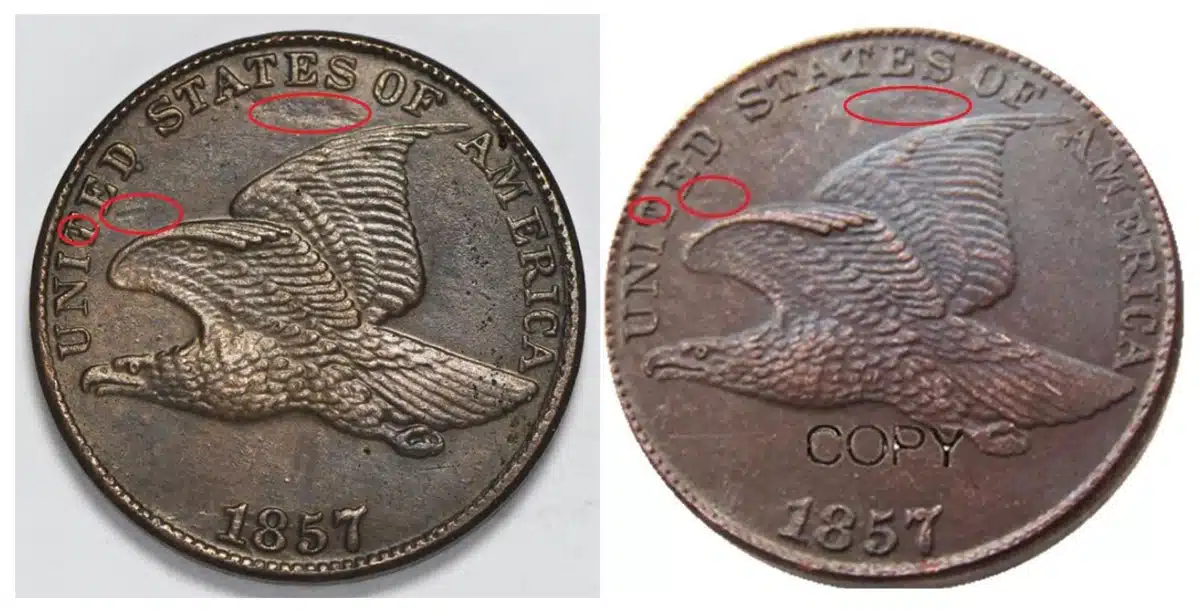
And let’s not leave Etsy out! More fun there with an 1856 and an 1858 thrown in for good measure!

And one major “twist”: this “PCGS” certed 1856 example:
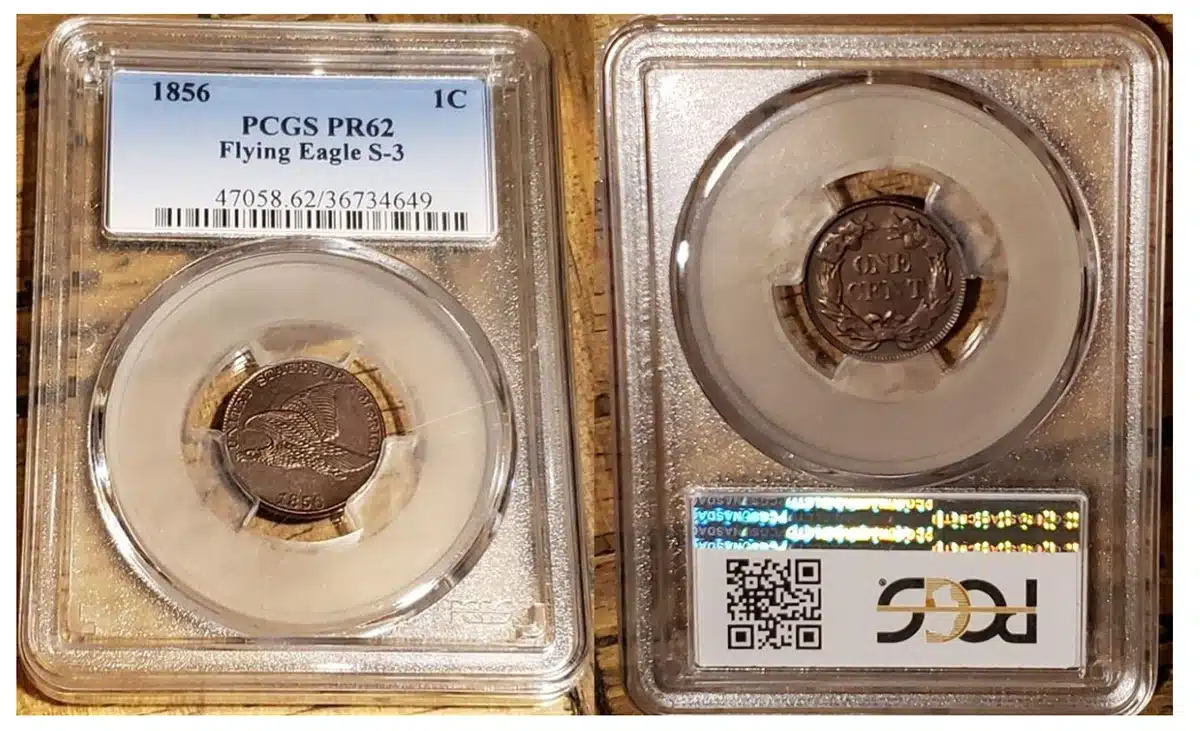
Poor images of this one won’t allow positive attribution by type, but the “6” is a pretty clear sign that it’s really bad…
Again, hopefully the information in this article information will help reduce the opportunity for fraudsters to sting collectors with these fakes, as it continues to be a real jungle out there!
Best as always,
—Jack
MORE Articles on Counterfeit Coins by Jack D. Young
* * *
The post 1857 Flying Eagle Cent “Varieties” – Jack Young’s Fun With Fakes appeared first on CoinWeek: Rare Coin, Currency, and Bullion News for Collectors.
CAC Grading Announces Grading Credit for All PNG Members
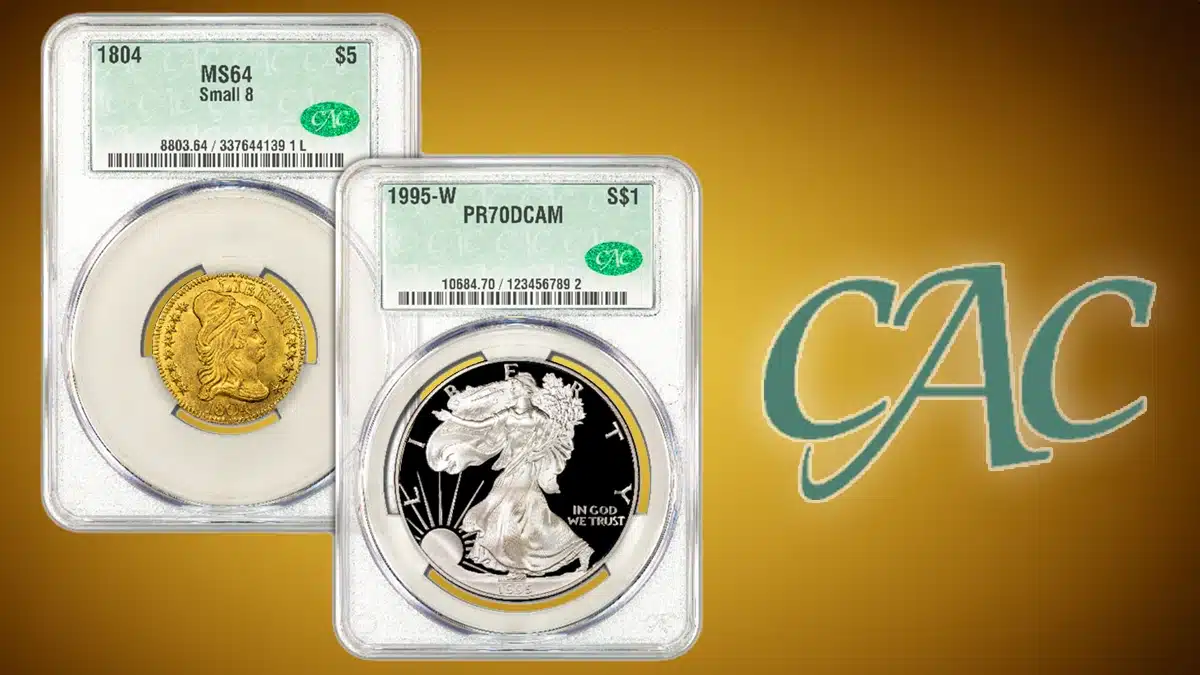
President and CAC Grading (CACG) Co-founder Ron Drzewucki has announced that the company is granting a grading credit good for five (5) Express submission items to every member of the Professional Numismatists Guild (PNG) members for grading services provided by the Virginia Beach-based firm. As a firm believer in the mission and values of the PNG–Knowledge, Integrity, and Responsibility–CAC offers this bonus to all coin dealers who support the organization’s work by becoming members or sustaining their memberships over the decades.
In order to utilize their CAC grading credit, members of the PNG must either put their member number on their submission form or include their number in the notes field on a online portal submission at caccoin.com. All credits expire if not used by March 31, 2024.
“PNG and CAC share similar views on the industry and the integrity required to work in it,” said Drzewucki, PNG member #532. “And we are glad to offer this benefit to the dealers who uphold these ideals.”
For more information, please contact CAC Grading, LLC care of Brian Kint at bkint@cacgrading.com or (757) 800-1750.
About CAC Grading
In 2007, Numismatist John Albanese and several other coin experts founded Certified Acceptance Corporation, or CAC. The new third-party grading service certified coins that had already been graded by other major grading companies (that Albanese had a hand in founding). If the coins were deemed strong for or stronger than the grade they had received, then CAC would approve them with either a green or a gold holographic sticker, respectively. It should be noted that coins with green and gold stickers tend to earn premiums when offered on the market.
CAC Grading LLC was founded in 2022 to certify coins directly. The company depends on the knowledge and experience of over 100 important figures in the coin industry.
* * *
The post CAC Grading Announces Grading Credit for All PNG Members appeared first on CoinWeek: Rare Coin, Currency, and Bullion News for Collectors.
US Mint Sales: New 2023 Mint Set Best Seller for the Second Week
For the second week in a row, the 20-coin uncirculated 2023 Mint Set topped the U
Precious Metals Rise on Tuesday, Dec. 19
Precious metals advanced as a group on Tuesday, with gains ranging from 0

Which of the Big Four New Orleans Eagles Is the Best Value?
By Doug Winter – RareGoldCoins.com ……
CoinWeek Content Partner
I think every collector would agree that the four rarest $10 gold eagles from the New Orleans Mint are the 1841-O, the 1859-O, the 1879-O, and the 1883-O. By analyzing PCGS and CAC population and price data, we should be able to reach some interesting conclusions. For the sake of brevity, let’s stick with coins that represent above-average quality for these four issues, which in this case is AU50 and higher. We won’t include MS60 and finer examples due to the extreme rarity of such coins for each of these four dates.[1]

First, let’s rank each issue by its original mintage figure:
- 1883-O: 800
- 1879-O: 1,500
- 1859-O: 2,300
- 1841-O: 2,500
It should be stressed that, on account of numerous factors, original mintages figures are not always accurate predictors of relative rarity.
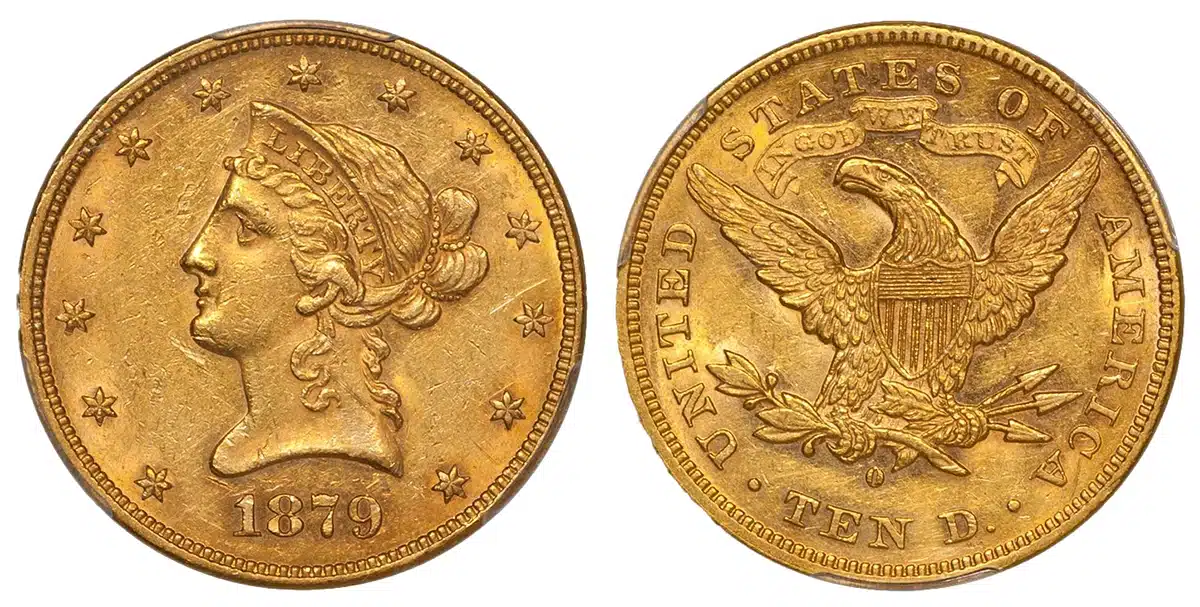
Next, let’s rank each issue in terms of overall rarity (total known) according to the updated 2020 version of my book Gold Coins of the New Orleans Mint, 1838-1909.
- 1883-O: 45-55
- 1859-O: 60-70
- 1841-O: 65-75
- 1879-O: 70-80
How do these figures align with the numbers graded at PCGS? First, let’s rank from fewest to most the total number graded at PCGS for each date:
- 1883-O: 38
- 1859-O: 45
- 1879-O: 48
- 1841-O: 69
How many of these coins grade AU50 and finer?
- 1841-O: 18
- 1883-O: 21
- 1879-O: 26
- 1859-O: 29[2]
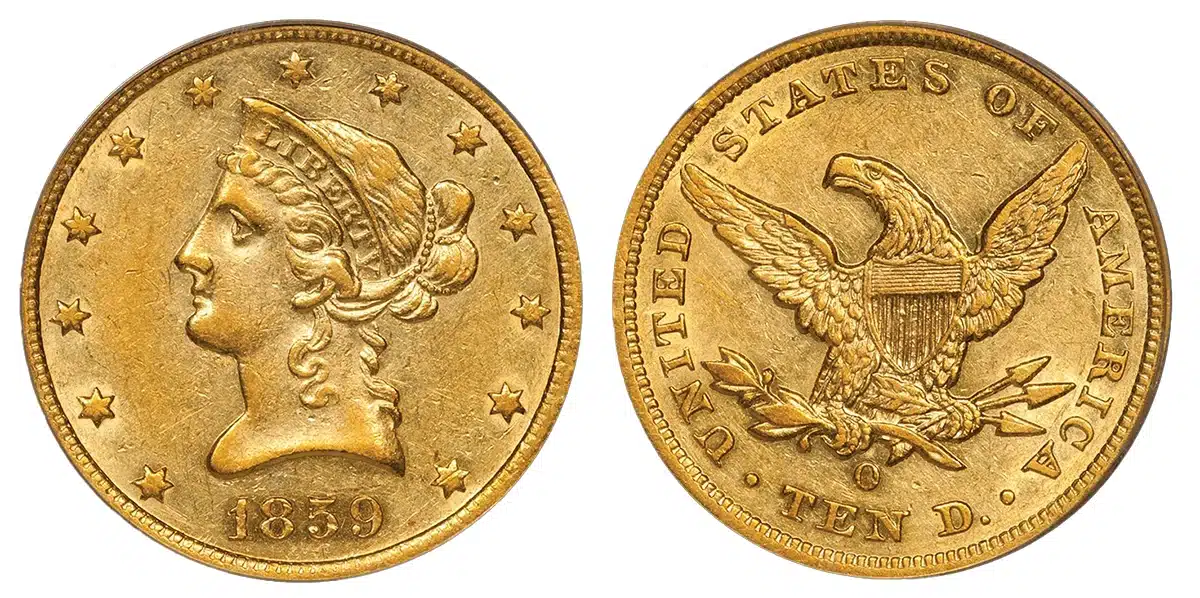
The percentage of coins graded in AU and finer versus the total number graded skews much higher than I would have thought, ranging from a low of 26% for the 1841-O to a high of 64% for the 1859-O. I have a quick answer for this: the population date for the 1859-O is absurdly high to due to resubmissions, plus many if not most of these coins are overgraded. This will be verified by the CAC population data I’ll be including in just a moment (see below).
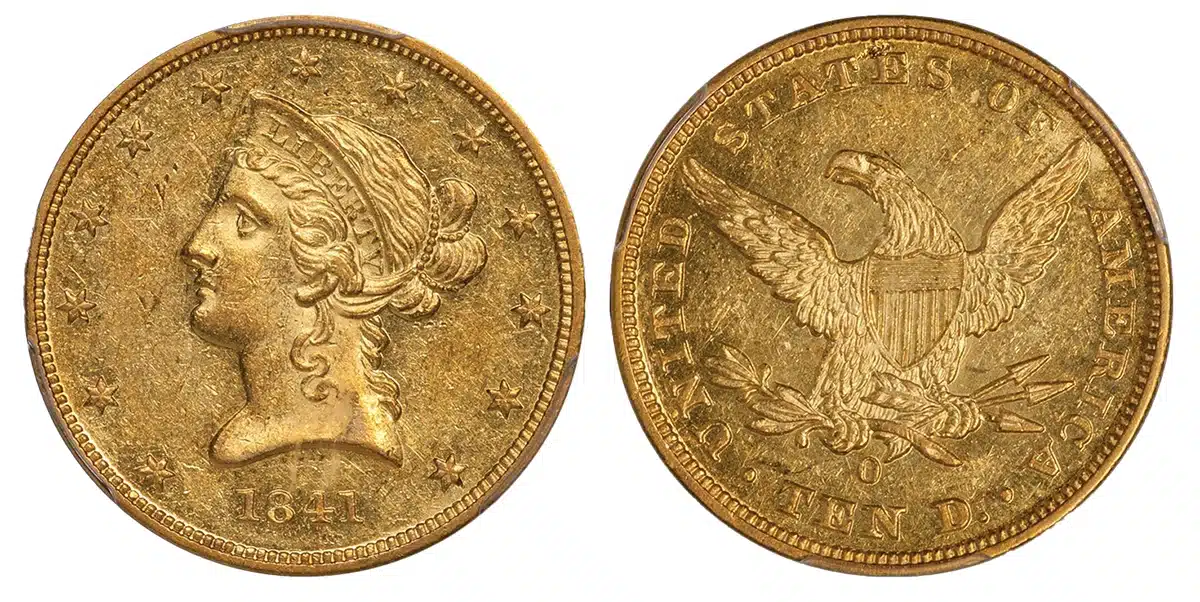
Another thing to consider: the 1841-O is a first-year-of-issue coin and it tends to be found in low grades (Fine to Very Fine) when it is available. The 1879-O and 1883-O have different grade distributions, which tend more towards higher grades as they didn’t see much circulation.
Given that so many of the 1841-O and 1859-O eagles graded AU50 and AU53 by PCGS are not fully AU coins, in my opinion, it make sense to change our parameters for high-grade coins and include only coins grading AU55 and AU58 (but not Mint State).
- 1841-O: 7
- 1883-O: 8
- 1859-O: 10
- 1879-O: 13
One would expect that CAC has not approved many of the Big Four New Orleans eagles. Let’s look at the population figures for all AU coins (50-58) and then for high-end AU (55 and 58 only).
- 1859-O: 2; Five total in all grades; one in 55; zero in 58
- 1841-O: 3; 10 total in all grades; zero in 55; one in 58
- 1883-O: 5; Six total in all grades; one in 55; one in 58
- 1879-O: 6; 10 total in all grades; three in 55; three in 58
We can make a few conclusions about each of the four dates from this rarity-based data.
The 1841-O is the most common of the four coins in terms of overall rarity, but it is actually tied for the rarest in terms of high-grade rarity (AU55 and finer). It is most often seen well-worn, and this is mainly due to the fact that it saw much more use in local commerce than the other issues; especially the two With Motto coins, which as a rule saw little use in commerce, and were mostly shipped to foreign countries to pay down incurred in trade.
Unless you really know the series, the 1859-O is misleading based on the submission data. There are a surprising number of AU coins at PCGS but, as I stated above, these figures are greatly impacted by resubmissions and by junky coins in holders. The CAC data confirms this date’s appearance rarity.
Given its low mintage, you would expect the 1883-O to be the rarest of these four dates, and it is from an overall perspective. It is somewhat disingenuous to compare its high grade rarity to the 1841-O and the 1859-O, as With Motto New Orleans eagles made after 1877 tend not to have circulated in the same manner as the coins made prior to the American Civil War.
The 1879-O is not as rare as its low mintage suggests. It is still a very scarce coin (and it is extremely rare in Uncirculated), but it has survived at a higher percentage than its With Motto counterpart the 1883-O.
Now let’s look at PCGS Price Guide pricing information for all four dates in all four AU grades. Next to each price in parentheses, I’ve listed the order from highest to lowest:

Now let’s enumerate the total numbers graded at each AU level by PCGS:

Based on these figures and applying all of the caveats associated with this kind of study, I’ll make the following conclusions:
The 1841-O and the 1859-O are both undervalued in AU55 and AU58. This is especially true for CAC-quality coins. If the sole PCGS/CAC AU58 1841-O became available, it could easily bring $250,000, if not a bunch more. I feel the same way about the 1859-O. The current PCGS price of $60,000 in AU55 is—for a nice CAC coin—way too low.
The 1879-O feels like it is priced properly. This is taking into account that others will likely be located in the coming years, and that they will have a better shot of being CAC-worthy than either of the No Motto issues.
The 1883-O is always going to sell for a higher price than it probably deserves, as a result of its tiny original mintage of 800. That is not to say that this New orleans eagle is overvalued from a macro perspective; it is slightly overpriced in relation to the 1841-O and the 1859-O, but certainly not when compared to an issue such as a better date Carson City eagle from the 1870s, or a low-mintage San Francisco eagle from the Civil War era.
* * *
Notes
[1] The 1841-O is unknown in Uncirculated, while the 1859-O is unique. Both the 1879-O and the 1883-O have an estimated two or possibly three Uncirculated pieces known as of late 2023, with none finer than MS61 for either issue.
[2] In my opinion, these numbers are VASTLY inflated by resubmissions.
* * *
* * *
The post Which of the Big Four New Orleans Eagles Is the Best Value? appeared first on CoinWeek: Rare Coin, Currency, and Bullion News for Collectors.
1815 Quarter, 1927-S Double Eagle in $5.65 Million+ Heritage Sale
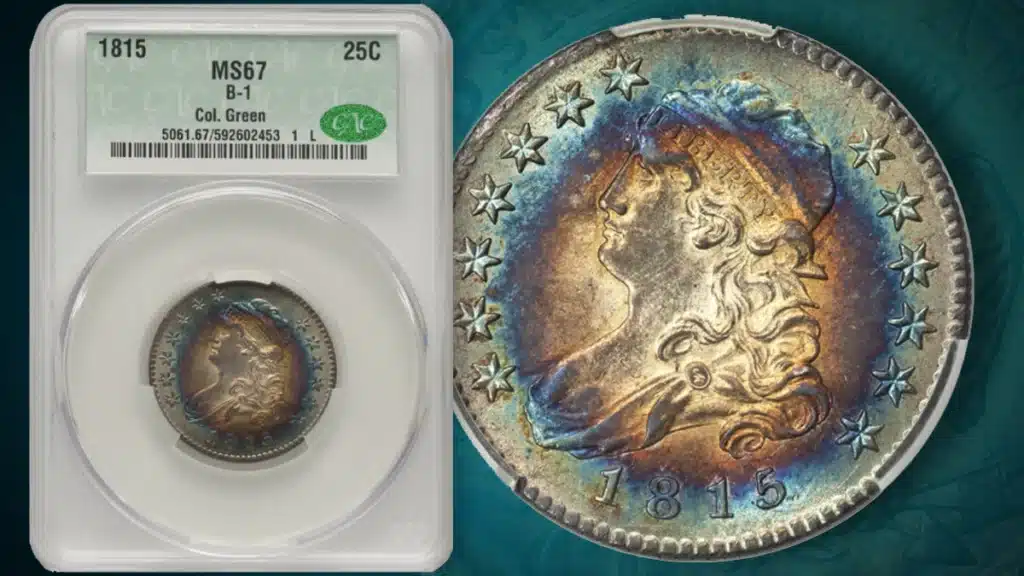
Among other U.S. coin highlights, Heritage Auctions sold the finest-certified 1815 B-1 quarter dollar (CACG MS67), ex Colonel E.H.R. Green, for $126,000 USD as part of its December 14-17 US Coins Signature Auction. The entire sale saw a final total result of $5,654,911.
The 1815 issue was the first quarter to feature engraver John Reich’s Capped Bust design. A second specimen of the B-1 graded NGC MS67 is generally considered to have less eye appeal than the quarter sold in last week’s auction.
An MS64 1927-S Saint-Gaudens $20 gold double eagle was another high-achieving coin from the sale. Even after the repatriation of double eagles from foreign banks in the latter half of the 20th century, the 1927-S remained one of the rarest issues of the Saint-Gaudens type. The example in Heritage’s December sale earned a hammer price of $108,000.
A tied-for-finest 1853-D Liberty Head half eagle (PCGS MS64+ CAC) from the Dahlonega Mint in Georgia achieved a record result of $90,000; the previous record for the date was $86,500.
A 1915-S Panama-Pacific Round Fifty Dollar (NGC MS63+) went for $78,000 after dozens of bids. Both the round and octagonal $50 gold commemoratives are extremely desirable entries in the classic U.S. commemorative coin series, and the round Pan-Pac $50 is in especially high demand from collectors.
Collectors also heavily pursued a 1864-S Liberty Head $10 gold eagle (NGC XF40) that eventually sold for $57,600. The Civil War-era 1864 is the rarest $10 from the San Francisco Mint and the second-rarest Liberty gold eagle overall. Only 2,500 pieces were struck, and after circulating out West, PCGS CoinFacts believes that only 22 to 26 survive in all grades today.
For more information about the highlights above–including the 1815 B-1 quarter dollar–or to view the remaining lots, click here.
* * *
The post 1815 Quarter, 1927-S Double Eagle in $5.65 Million+ Heritage Sale appeared first on CoinWeek: Rare Coin, Currency, and Bullion News for Collectors.
This Unique Eisenhower Dollar Was Found at a Department Store
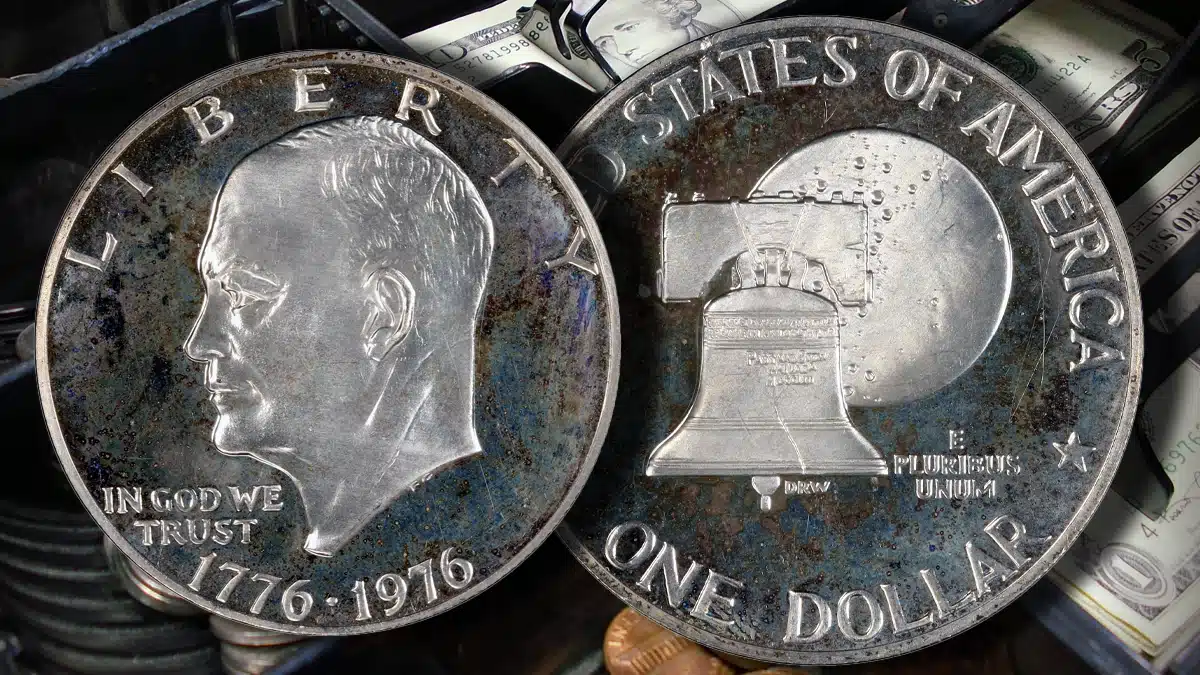
By Mike Byers for Mint Error News ……
The PCGS Price Guide valued this unique Eisenhower Dollar long ago at $850,000 USD. Today, Mike Byers estimates the value well into seven figures.
The 1976 Type 2 “No S” Silver Proof Eisenhower Dollar is one of America’s great mystery coins! It is a 1976 Proof Bicentennial dollar lacking the “S” mintmark for San Francisco, and was discovered at a Woodward & Lathrup department store in the Washington, D.C. area in 1977.
It is possible that this coin was struck as a presentation piece for a government or White House official in Washington and then entered circulation when it was accidentally spent.
Mitchell Spivack of Wondercoins is the owner of this unique Eisenhower Dollar and he exclusively commented on this coin for the readers of Mint Error News:
For the better part of around 10 years, PCGS has valued the Unique 1976 Type 2 “No S” Silver Proof Eisenhower Dollar at $850,000 in its Price Guide. This value was established well before I bought and then immediately resold one of the two known 1975 “No S” Dimes at public auction back in September 2019 for $516,000 (it had previously sold for around $350,000). Additionally, several other Eisenhower dollars have recently traded well into six figures at public auction. The Ike dollar series has really “taken off” and has come into its own!
Based upon the recent upward trajectory of the (current) mintage two 1975 “No S” Dimes, as well as many Eisenhower Dollars now being worth in excess of six figures, I currently believe that the 1976 Type 2 “No S” Silver Proof Eisenhower Dollar is a “strong seven figure” coin. I receive, on average, at least one random, unsolicited, communication a day from across the globe from non coin collectors who believe they have found another “holy grail” 1976 Type 2 “No S” Silver Proof Eisenhower Dollar. Of course, they have all found, to date, simply one of the millions and millions of business strike Type 2 Eisenhower Dollars produced in Philadelphia in 1976. But the word is spreading fast, especially via social media platforms such as YouTube, about the “holy grail” of Eisenhower Dollars – the Unique 1976 Type 2 “No S” Silver Proof Eisenhower Dollar! The 250th Anniversary of this great country is now less than three years away when this special coin will turn 50 years old!
1976 “No S” Bicentennial Proof Eisenhower Dollar – Provenance and Price History
The first sale was by Devonshire, raw, in 1982. It sold for $5,000. Martin Paul and Andy Lustig joint ventured it. It was subsequently sold to Alan Hager. Then it was certified PF65 by NGC. Martin Paul re-acquired it. It was in a Superior Auction, lot #1794, NGC PF65 in 1997.
At some point it upgraded to PCGS PR66. Then it was in a Bowers and Merena auction, lot #647, realizing $41,400 in 2002. Acquired by Mitchell Spivack. Re-designated CAMEO by PCGS.
* * *
The post This Unique Eisenhower Dollar Was Found at a Department Store appeared first on CoinWeek: Rare Coin, Currency, and Bullion News for Collectors.
2024 Native American $1 Coin Images Unveiled
The United States Mint released images of the 2024 Native American $1 Coin
Heritage’s Dec. 9-11 World Coins Auction Tops $8.68 Million, Led by 1911 “Long-Whiskered Dragon” Dollar
A Hsüan-t’ung silver Specimen Pattern “Long-Whiskered Dragon” Dollar Year 3 (1911) SP64+ NGC sold for $630,000 to lead Heritage’s HKINF World Coins Platinum Session and Signature® Auction to $8,685,913 December 9-11
Precious Metals Little Changed on Monday, Dec. 18
On Monday, prices of precious metals changed only marginally, with modest gains in gold and platinum and slight losses in silver and palladium

Jim Bisognani: 2023 Coin Market Year in Review – Part 1
Jim Bisognani Year in Review – NGC Weekly Market Report ……
Well, we’re only 10 days away from the night that the jolly old elf from the North will be circumnavigating the globe and spreading holiday cheer (I think that’s what he spreads). It also means that loved ones and friends only have a short time left to secure a wonderful numismatic gift for that special coindexter on their list (HINT!).
Gulp. Hey, there are only 17 little days left in 2023! That means it’s time for the 13th Annual NGC Jim Bisognani Year in Review!
Although I enjoy chatting with my fellow coindexters, collectors and dealers all year ‘round, I must admit that this annual review is the big enchilada. A lot of work goes into it. Everyone’s time is valuable, and I appreciate all of my contributors’ efforts. I realize that sometimes I can be a nudge, with my gentle prodding of my brethren for their learned responses. I appreciate their patience! Yet, it is worth it and has been great fun putting this review together for the past 13 years — wow, where has the time gone?
Now it is time to share the varying views from all those who make numismatics their treasured hobby or livelihood. So, without further hoopla, I proudly present the 13th Annual Bisognani NGC Coin Market Year in Review – Part 1.
What has been the biggest challenge for you and your business in 2023?

John Brush – President, David Lawrence Rare Coins (DLRC)
2023 was a very challenging year for us. It was a very successful one as far as business goes, but we went through a lot of changes and adjustments this year that we’re not used to doing. We replaced our CFO, we ramped up our staffing due to the amount of coins we’ve been adding to our auctions, and our office had an electrical fire in August that displaced us for a month. Thankfully, no people or coins were affected, but our office was flooded from the sprinklers and it forced us to rethink our office layout, get new walls and floorings, and all of that incredibly difficult stuff that distracts us from coins. All in all, it was an awful month, but our office space is so much nicer now and we’re excited to have a fresh new look and a better layout for our business.
Brian Hodge – Partner, Lee Minshull Rare Coins (LMRC)
With the cost of borrowing money so high, it has become more difficult to stock higher-priced items for long periods of time. This has obviously been a factor in making large purchases.
James Sibley – Collector
As a collector, my biggest challenge this year has been submitting winning bids at the Heritage, Stack’s and Great Collections auctions. The post-pandemic price increases for the US coins I collect (19th century type and early 20th century rarities, preferably in Gem grade or better) have far exceeded my expectations. The dilemma is always “reaching” to win the lot vs. overpaying so much that it will take many years to recoup what I paid.
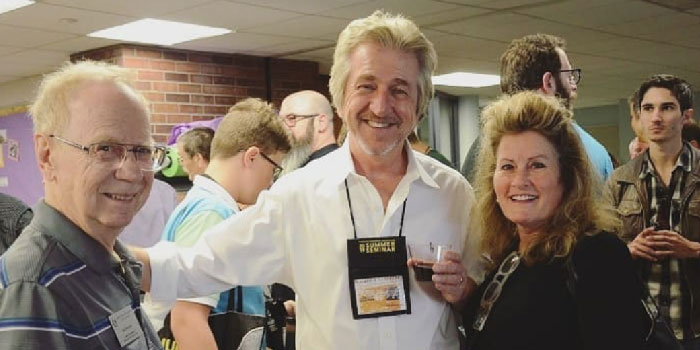
Jeff Garrett – Founder, Mid-American Rare Coin Galleries, Inc.
Without a doubt, finding fresh material for resale. I have been super lucky that a few cool things fell into my lap last year, most notably the Kentucky Gold Hoard. Finding a sufficient supply of new coins to meet the demand of my customer base is a continuing challenge. Rare coin prices were fairly stable this year and the incentive for sellers was less than in the recent past.
Jeff Kierstead – Owner, MintProducts Auctions
With expenses up across the board, keeping enough product coming in can be a challenge. We are fortunate to see our business still growing.
Bob Green – Owner, Park Avenue Numismatics
This year, explaining premiums for precious metals has been a little more difficult because of the amount of clients making purchases for personal use or precious metals IRAs. In addition, premiums for $20 gold pieces have fluctuated a tremendous amount and we have had to educate our clients on these changes.
Kevin Lipton – Owner, Kevin Lipton Rare Coins
I would say record gold prices with premiums lowering at the same time has been a bit of a challenge.
* * *
For the new numismatist on a limited budget, what series would be at practical entry point?
Kevin Lipton
A Silver Eagle set!
Bob Green
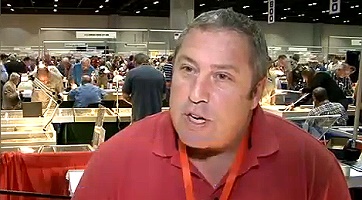
I think Silver Eagles are probably one of the nicer collections that can be started with a limited budget due to low silver prices, and they began in 1986 and continue each year. There are even some special issues that can be added at higher price points, but that could be a decision left up to the collector.
Dan Goevert – Rare Coins 101
I’m assuming by a “limited” budget, you mean a very limited budget; perhaps something appropriate for a youngster. I can make a couple of recommendations right off the bat:
Jefferson Nickels: It is still possible to complete a set of Jefferson Nickels plucked from circulation. There are still nickels from the early decades of the Jeffersons flowing in and out of cash registers and change counting machines. Even war nickels are waiting to be found in coin rolls!
State Quarters: The “50 State Quarters Program” was launched in 1999 to honor each of the 50 states and ran through 2008. Over the years, this initiative has drawn many new collectors into the hobby. With patience and diligent searching, every State Quarter album slot can be filled with coins that remain in circulation. Great fun on a low budget!
John Brush
I lean toward putting together some kind of type set. Maybe just 20th century, or 19th and 20th century. I love the variety of design types, the history behind them, the art and the options! Then you can figure out which series is best to focus on from there!
Jeff Kierstead
Indians and Lincolns Cents and Buffalo Nickels are a great place to start.
Christine Karstedt – Executive Vice President, Stack’s Bowers Galleries
Without a doubt, Morgan Dollars. The coins themselves are beautifully designed, significant in size, historically meaningful and are readily available in all grade and price ranges. The Morgan Dollar was produced in decades that saw dynamic changes in our nation, was struck at mints from coast to coast and saw its share of political intrigue. It remains the country’s most popular classic coin. A collecting budget can easily be established so that new acquisitions can be made regularly, important for maintaining the spark of interest in a new collector. It’s always fun to be adding something to the collection.
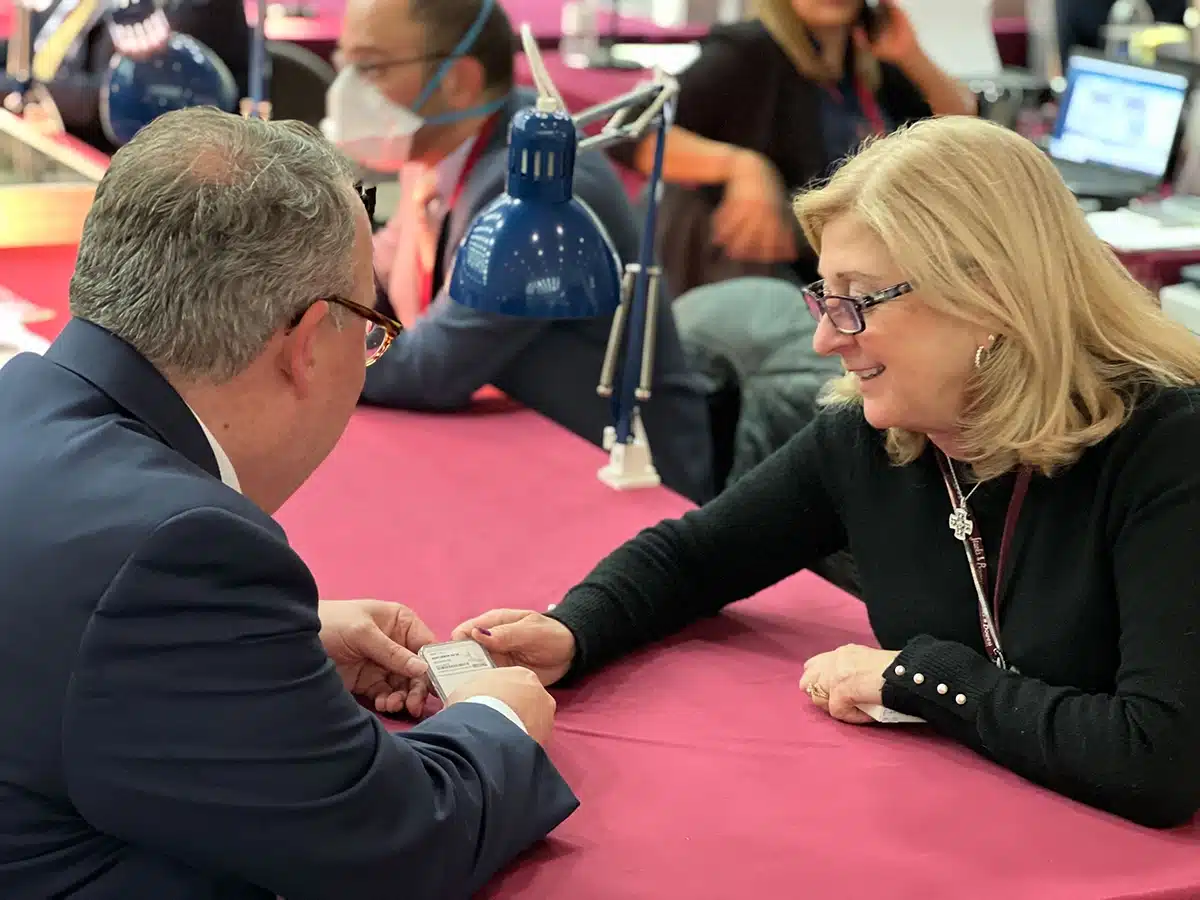
The series also has major rarities that can be acquired in much lower grades to “fill the hole,” but still give the buyer a great sense of accomplishment and pride when working toward completion. Q. David Bowers has produced a tremendous amount of information in several books on the subject. In fact, the first book he created in collaboration with Whitman Publishing was A Guide Book of Morgan Silver Dollars, now in its seventh edition. Having great reference material to study and enjoy adds to the pleasure of collecting and keeps interest high in between purchases.
A personal footnote: As a parent and now a grandparent, in my household the tooth fairy always brings a Silver Dollar to leave under the pillow along with other change!
Lianna Spurrier – Creative Director, Numismatic Marketing
There are plenty of easy answers — Wheat Pennies, Jefferson Nickels, etc. — but I’d like to suggest a Canadian type set. You’ll have to do some research to decide what you want to include, which will help you find some resources and get acquainted with researching numismatics. They’re easy to find on eBay if your budget is very low, but are familiar enough that you can find nicer examples on some of the larger coin-specific auction sites. In addition, a type set is always a good starting point to get a more varied taste of what’s out there. A US 20th-century type set would also be a good option, but I’m always an advocate for world coins.
James Sibley
For entry-level collectors, I suggest that they start with United States Mint products — Silver Eagles, Proof and/or Uncirculated sets. While the new collector probably won’t recoup their purchase price for a long time (if ever), the coins are beautiful and the cost is relatively low. If the modern issues are of no interest, there are a number of less-popular 19th-century series (think Two Cent pieces, Three Cent Nickels, and Shield Nickels) which, even in lower Proof grades, can be affordable.
Jeff Garrett
I love United States Silver Eagles. They have been produced since 1986 and completing a set is within the budget of most collectors. They are large and have one full ounce of silver. You can have fun collecting them with a side bullion play.
Brian Hodge
I started with Mercury Dimes. You can collect them for reasonably cheap, and there’s always the “grail” piece like the 1916-D that keeps you hunting and aiming higher when you finally earn your stripes.
* * *
Do you still attend all of the major coin shows on the calendar? Why or why not?
Christine Karstedt
Yes, I still enjoy attending all major coin shows. One of the most pleasurable aspects of my career is getting to personally know the amazing people who have been pillars in this hobby, whether they be dealers or collectors. And getting together at coin shows was and is a tremendous part of enjoying those ongoing relationships. I also like to meet in person those who are new to the hobby so I can provide encouragement or assistance as needed. All of us have busy lives in and out of work, but we make the time to attend these events because they are fun, and we get to share our enthusiasm with those who have the same interests. Nothing can replace the camaraderie of catching up and talking coins in such a dynamic numismatic environment.
Lianna Spurrier
I attend any shows where I have clients. I do media for the industry but don’t sell coins myself, so my show experience is quite different from that of a dealer; I spend shows running around to film different presentations or shoot videos on the show floor. In 2023, I attended NYINC, Central States, EAC, the ANA and winter Baltimore. The ANA is the only show I expect to attend every year.
Regardless of client work, it’s such a good networking opportunity, and even if I’m not doing any work at the show, I always end up talking to a lot of people. Any others are only worth the expense if I have a client covering part of travel costs. FUN is noticeably absent from that list. It was simply too close to NYINC this year, and even if I’m not attending NYINC, it’s too soon after the holidays for me unless I have a lot of clients. My dog is already stressed out from being shuttled around during Christmas — he might just melt into a puddle of anxiety if I tried to send him to the dog sitter right after!
John Brush
Yes, we attend all of the major shows. There are fewer major shows than there used to be, but we do so for several reasons:
- The relationships we have with fellow dealers and collectors
- To support the DLRC brand in various places throughout the country
- To purchase coins and other inventory items
- To further the educational mission of our hobby
James Sibley
As a collector, I only attend shows close to home (the Houston Money Show and the Texas Numismatic Association’s annual show). Frankly, the convenience of the major auctions has spoiled me — why spend a thousand dollars or more flying to a far-fetched show when I can buy coins from my desktop, especially if I have someone at the auction house I trust to look at the coin in-hand (thank you Mark Feld, Vicken Yegparian, and Ian Russell!)?
Jeff Kierstead
I attend about half the shows I did back in the 1980s and ’90s. There are a few reasons for this, but the main reason is that with the amount of business being done on the internet, it’s just not necessary.
Bob Green
For me, personally, I took a hiatus when my son Samuel was born in July and dedicated my time to being a father. My staff attends all major shows and I will start in 2024. I’ve missed the grind, but it has been so worth it for me personally.
Kevin Lipton
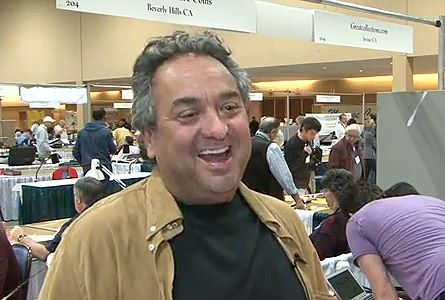
I do not. I am down to FUN, Central States, and the Summer ANA. Our business is mostly generated from the office. We do coin shows to “meet and greet” our best clients.
Jeff Garrett
I still attend every major show and a lot of the regional shows. As mentioned above, finding fresh material is a lot of work and attendance at these shows is vital. Being seen and considered when something new shows up is part of my business plan. Plus, I truly enjoy coins shows. I’m lucky in that my wife, Mary Lynn, enjoys going with me to most shows.
Brian Hodge
No. I can get most of what I need to do at a coin show done on my cell phone or computer. Most new dealer purchases I can find out about right before the show. Shows for me have now just become meet-and-greet opportunities or a chance to have dinner with customers and dealers.
* * *
Jolly Ol’ Saint Nick’s gnome friends have granted you a round-trip passage back to the year of your birth. You have 24 hours and $100 to spend. What coins or other collectibles will you try to locate and bring back to the present?
John Brush
1980: Man, that’s a boring year. And $100 wouldn’t buy me much silver. I’d probably try to find some early Lincoln and Jefferson Nickel rolls that I could buy cheaply and submit for grading in 2023.
Bob Green
I would buy as many $20 gold pieces as I could!
Jeff Kierstead
With the simplified grading back then (1960), I would try and cherry-pick as many superb red copper coins (probably Indian Cents) that I could.
Dan Goevert
For me, the gnomes would have to navigate their time-travelling vessel back to 1959, when dinosaurs still roamed the Earth! Like many collectors, I would seek out a highly prized coin of today that was undervalued and affordable back then. Starting with the BEST group on the Key Date List of Recommendations, I found a wonderful coin that does the trick — the 1870-CC Coronet $10 Eagle. Per the Red Book, in 1959 I could have purchased an example of this Carson City rarity in About Uncirculated for just under $100, presuming I could find one for sale in the 24-hour excursion.
Currently, Coin World estimates the retail value of the 1870-CC $10 Eagle in About Uncirculated condition to be somewhere around $250,000. If the gnomes had let me keep this coin, my $100 investment would have grown in value at an annual compounded rate of 13%. Incredible!
James Sibley
As many high-condition Fugios as $100 would buy.
Kevin Lipton
1959. I am gonna find a contemporary artist like Andy Warhol whose painting would be worth a million bucks today!
Jeff Garrett
1958: I would visit the offices of B. Max Mehl in Texas and look for ultra Gem coins that he has no idea will be worth a fortune someday.
Brian Hodge
It wasn’t a very eventful year for coins, so perhaps a couple Proof sets and some Ronald Reagan memorabilia.
* * *
Enjoy the holiday, my friends! I’ll be back next time with part two of the 13th Annual Bisognani Year in Review.
Until next time, be safe, happy holidays and happy collecting!
* * *
The post Jim Bisognani: 2023 Coin Market Year in Review – Part 1 appeared first on CoinWeek: Rare Coin, Currency, and Bullion News for Collectors.
Numismatic Crime – Coin, Bullion Theft an Ongoing Threat
Recent Alerts from Doug Davis – Founder & President, Numismatic Crime Information Center (NCIC) ……
Gold Bars Stolen in Texas Residential Burglary
The North Richland Hills, Texas Police Department is investigating a residential burglary resulting in the loss of 100 one-ounce gold bars from the Royal Canadian Mint. The carded bars were housed in boxes of 25. The investigation is on-going and investigators are asking for assistance from any dealer who may be offered this kind of bar in quantity.
Persons of Interest in Pennsylvania Coin Show Thefts

NCIC has been working with several law enforcement agencies who are investigating coin show thefts. The subjects pictured below are persons of interest and were photographed and videoed in or around the shows. Dealers or collectors who may have seen or come into contact with these subjects should contact Doug@numismaticcrimes.org.
Bad Check for California Bullion Order
A California dealer received a suspicious bullion order in the amount of $10,471.00 USD from a subject using the name of “Ethan Wootton”. The e-check was written on TD Bank. The dealer’s bank was unable to locate an account on the check and fortunately the product was not shipped.
Check information:
- TD Bank
Account Holder:
- Ethan Wootton
- San Francisco, CA
Routing number: 000000106
NCIC was unable to locate a TD Bank with routing number 000000106. Dealers should use caution if contacted by the subject or any checks written on TD Bank.
Numismatic Threat an Ongoing Fight
Collectors and dealers are facing tremendous challenges related to theft, fraud, and robbery as the incidence of numismatic and retail crime escalates across the country. Factors contributing to this trend include economic conditions, social issues, and the prevalence of organized crime.
The Numismatic Crime Information Center has seen a steady increase in organized criminal groups targeting coin shops and local shows. Numismatic items have significant market value, making them lucrative targets for theft by organized crime groups. This type of criminal activity is alarming due to the potential for violence against collectors and dealers.
NCIC is committed to safeguarding the integrity of the numismatic community and industry by tackling criminal activities such as organized crime, fraud, robbery, postal thefts, and counterfeits. Our recent efforts have resulted in numerous successful recoveries, arrests, and convictions:
- NCIC participated in the arrest and conviction of a postal employee involved in the theft of over one million dollars in coins and precious metals.
- NCIC’s email alert network system was responsible for the recovery of over $40,000 in currency that was reported in 2021.
- NCIC’s tracking of organized Romanian gangs targeting coin shows and shops resulted in six arrests with the assistance of U.S. and International law enforcement partners.
- NCIC’s growing email crime alert system and the ability to disseminate real-time numismatic crime information expeditiously has become a major investigative resource and crime prevention tool.
However, this important mission is not without its challenges. With rising expenses, your financial support is needed more than ever to sustain NCIC’s operations. This is where you can be effective.
Your financial support, will continue to directly contribute to:
- Funding investigations: your support will enable NCIC to investigate and resolve numismatic crimes effectively and bring criminals to justice.
- Educational Outreach: Your donation will aid in the creation of educational resources and outreach programs that promote awareness of numismatic crimes and teach collectors and dealers on how to protect themselves.
- Technology Enhancement: NCIC needs updated technology and databases to stay ahead of criminals. Your donation can help invest in tools necessary to combat on-going modern criminal threats.
- Community Building: By supporting NCIC, you are helping to strengthen the bonds within the numismatic community and law enforcement.
- Investigative tools and Resources: Your support allows NCIC to develop and create the necessary tools and resources to effectively investigate crimes related to coins and precious metals.
As the year ends, I hope you will consider sending a tax-deductible donation to help NCIC continue to provide the numismatic community and law enforcement with free investigative and educational resources.
Thank you for your unwavering support and dedication to the Numismatic Crime Information Center’s mission. Your generous tax-deductible donation matters in the fight against numismatic crime. Donations can be sent to P.O. Box 14080, Arlington, Texas, 76094, or PayPal.
Have a Safe and Happy New Year!
* * *
Please contact the Numismatic Crime Information Center’s (NCIC) Doug Davis if you have questions or information about any of the cases above. You can reach him at (817) 723-7231, or email him at doug@numismaticcrimes.org.
* * *
The post Numismatic Crime – Coin, Bullion Theft an Ongoing Threat appeared first on CoinWeek: Rare Coin, Currency, and Bullion News for Collectors.
Gold Posts More Modest Weekly Gain as Other Metals Soar
Precious metals registered losses on Friday, aside from palladium which sharply jumped for a second day in a row and padded its weekly increase
Second-Finest Charles II ‘Petition’ Crown Among British Rarities at Heritage NYINC Event

The British Charles II silver Pattern “Petition” Crown 1663 MS62 NGC was engraved by Thomas Simon, one of the most famous medalists and engravers of 17th-century England. The “Petition” aspect of the coin’s name represents Simon’s unsuccessful petition to become Chief Engraver at The Royal Mint under the restored monarchy of King Charles II. Not quite 20 specimens of this type exist, and seven are impounded in museum and institutional collections.
The example offered by Heritage Auctions in their January 16-18, 2024 NYINC World Coins Signature Auction is the second-finest certified of only three graded by Numismatic Guaranty Company (NGC).
The High Medieval Henry III gold Penny of 20 Pence ND (c. 1257) UNC Details (Bent) NGC offered in this auction is one of only four available to collectors, and just the second example of this type that Heritage has ever handled. A circulating gold coin would not replace this British emission until the Edward III Florin in 1344.
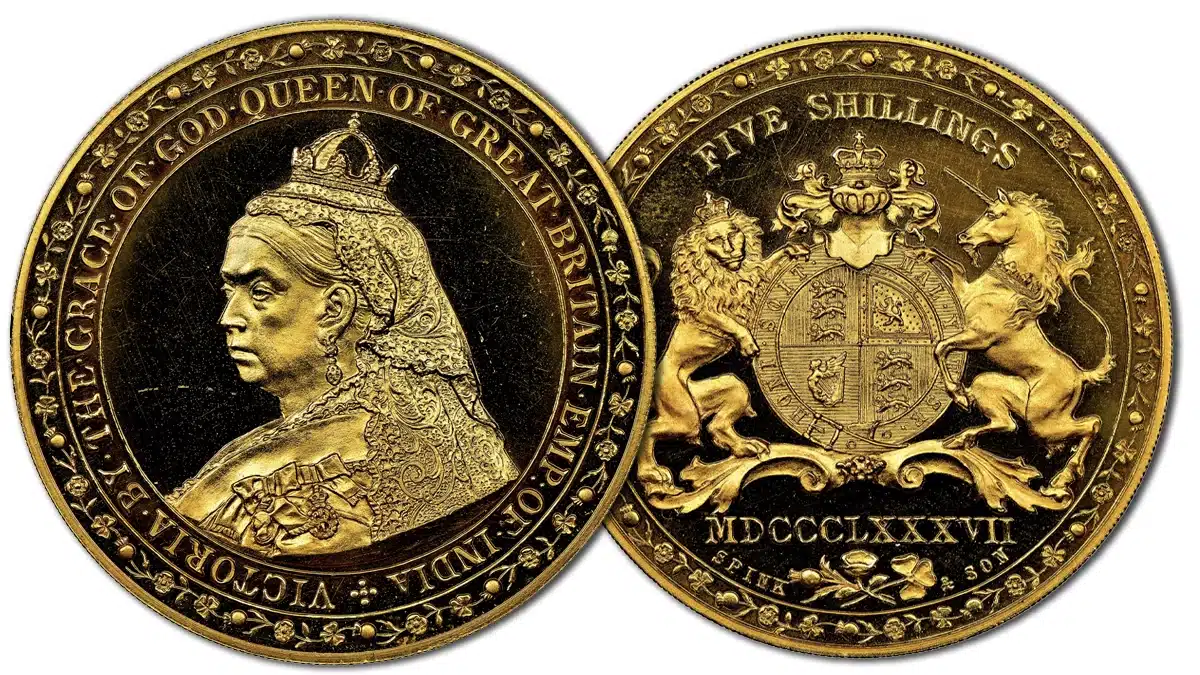
Moving forward more than half a millenium, Heritage is offering another rarity: a Victoria gold Proof Pattern Crown (5 Shillings) 1887 PR65+ Ultra Cameo NGC – one of only six struck. Produced for Spink and Son, it features a unique three-quarters facing bust of a mature Queen Victoria.
A masterpiece by Royal Mint Chief Engraver William Wyon, Heritage is also offering a George III silver Proof Pattern “Three Graces” Crown 1817 PR63 Cameo NGC that anthropomorphizes the countries of England, Ireland, and Scotland as the Three Graces of Greek mythology. The coin on offer has very good eye appeal, with a high-gloss finish in its fields standing in stark contrast to the design elements in relief.
A George III gold Proof Pattern 2 Guineas 1773 PR64 Cameo NGC is a highly desired Pattern coin, perhaps ranked behind only the George III 5 Guineas and the Edward VIII 5 Pounds. Heritage will be offering an example of this type, as well.
An Edward VII gold Specimen Pattern Crown 1902 SP62 PCGS, again produced by Spink and Son, is an extremely hard Pattern strike to obtain. Silver specimens appear on the market infrequently and command high premiums when they do… but gold versions might go on sale once in a decade. Obviously influenced by the Charles I Crown, the Edward VII Pattern Crown features the king on horseback, with a reverse oval shield and arms.
Visit here for more information on the “Petition” Crown and all other lots in the auction.
* * *
The post Second-Finest Charles II ‘Petition’ Crown Among British Rarities at Heritage NYINC Event appeared first on CoinWeek: Rare Coin, Currency, and Bullion News for Collectors.
Important Collection of Spanish Quarter Real Coins To Be Sold by Stack’s Bowers in January

CoinWeek Staff Reports…
Important Spanish Colonial Cuartillos from the Emilio Ortiz Collection
Featured in Stack’s Bowers Galleries’ January 2024 Auction
Collectors of Spanish colonial and treasure coins should take note of Stack’s Bowers‘ January 2024 offering of the Emilio Ortiz Collection. The Ortiz section of Spanish Colonial Cuartillos will be presented in a stand-alone catalog and auctioned at the January 2024 New York International Numismatic Convention.
Over several decades of considered collecting, Ortiz assembled a nearly complete collection of quarter Real coins produced during Latin America’s colonial period. Many of these coins represent once-in-a-lifetime opportunities for buyers due to their rarity and state of preservation.
The Emilio Ortiz quarter Real section comprises 422 lots and spans all colonial mints, including the mints at Lima, Potosi, Mexico, Guatemala, Bogota, Santiago, and others.
Among this offering’s many highlights is an impressive array of cob Cuartillos from famed assayer Alonso Rincon, including issues from both the Lima and Potosi mints. Cobs produced at the Bogota mint are among the series’ most challenging and well-represented in the finest condition here.
Quarter real coins struck during the closing period of Spanish colonial rule are also well represented. Among the offerings are rare royalist issues from emergency provincial mints in Mexico and Venezuela. Four examples of a curious copper issue, recently attributed to Cuba, appear in the catalog. An 1822-dated Cuartillo from Guatemala, struck in the year following the country’s official independence, rarely encountered at auction, makes an appearance.
Stack’s Bowers will commence live bidding on January 12, 2024, at 6:30 PM EST. Bidders can browse the catalog online and begin placing bids on their favorite pieces today.
For more information about this historic sale, contact Stack’s Bowers at Info@StacksBowers.com.
The post Important Collection of Spanish Quarter Real Coins To Be Sold by Stack’s Bowers in January appeared first on CoinWeek: Rare Coin, Currency, and Bullion News for Collectors.
U.S. Mint Strikes 604M Coins in November; Kennedy 50c Mintages Highest Since ’83
In November, the U
Gold, Silver, and Other Metals Soar with Gains of 2.4% to 15.7%
Prices for precious metals rallied on Thursday following the Federal Reserve’s adoption of a more dovish tone, signaling the end of its tightening cycle
US Mint Sales: Uncirculated 2023 Mint Set Leads All Products
The recently released uncirculated 2023 Mint Set jumped out of the starting gate according to the latest sales figures from the United States Mint
U.S. Marine Corps Bronze Medal Now Available for $20
Today, Dec
Schaumburg 2 Ducats Gold Coin at Atlas Numismatics
Season’s Greetings! There are 330 new coins and medals for your consideration and browsing enjoyment this month – including an outstanding Schaumburg-Lippe 2 Ducats medallic gold coin. We hope that you may find something of interest for your collection and look forward to hearing from you if have any questions.
From all of us at Atlas Numismatics, we wish all of you the very best this holiday season and a safe and happy New Year!
Notice Regarding Holiday Shipping
As we pause to gather with friends and family over the upcoming holidays, please note that orders received after December 20 may be delayed until we resume regular office operations the first week of January. If you have specific questions about shipping or need to have orders held for future shipping dates, please make a note in the comments during checkout or send us an email so we can assist with your requests.
Please contact us with any offers or other inquiries by sending an email to info@atlasnumismatics.com.
New Inventory
These four items are just a sample of the 330 recent additions to our inventory. We have added new material in the World (293), Ancient (29) and U.S. (8) categories.
Populonia 25 Asses
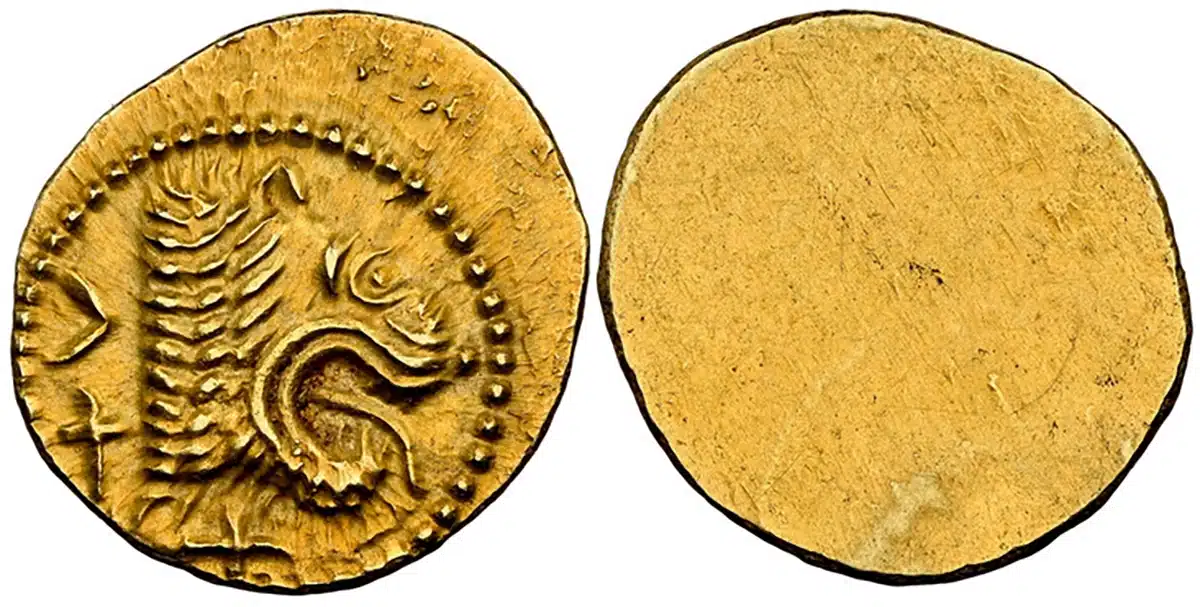
1076737 | ROMAN REPUBLICAN. ETRURIA. Populonia. Struck circa 300-250 BCE. AV 25 Asses. NGC Ch. AU (Choice About Uncirculated) Strike 5/5 Surface 4/5. 11.5mm-13mm. 1.39gm. ΧΧV (retrograde). Lion’s head with tongue protruding, right / (Blank). Vecchi 21.70, obverse die O1, this piece; Vecchi, SNR 67 (1988) 47.28, this piece; SNG ANS 2, same die; SNG Lloyd 10 = Jenkins AGC 475, same die).
Ex P.& P. Santamaria listino (1961) No. 2; Ex Münzen und Medaillen Auction 44, Basel (15 June 1971) Lot 1; Ex Peus Auction 336, Frankfurt (199) Lot 5; Ex Tradart (18 November 1993) Lot 5 (Color plate pg. 28); Ex European Connoisseur collection (formed before 2002).
Gem Napoleon III 5 Francs
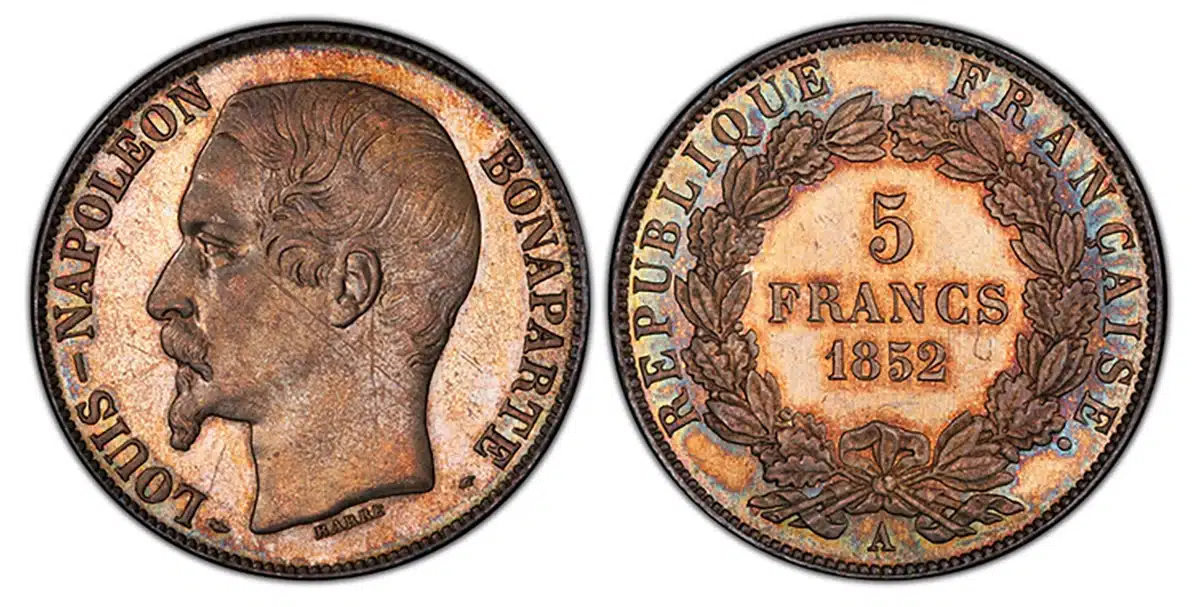
1076871 | FRANCE. Napoleon III. (Second Empire, 1852-1870). 1852-A AR 5 Francs. PCGS MS65. By Jean-Jacques Barre. Paris. Edge: DIEU PROTEGE LA FRANCE ***. (lamp) LOUIS-NAPOLEON BONAPARTE (hand). Head, left; signed below truncation /REPUBLIQUE FRANÇAISE. . Denomination within wreath. KM 773.1; Gadoury 726 (Tête étroite); F.-329.
Schaumburg-Lippe Medallic 2 Ducats
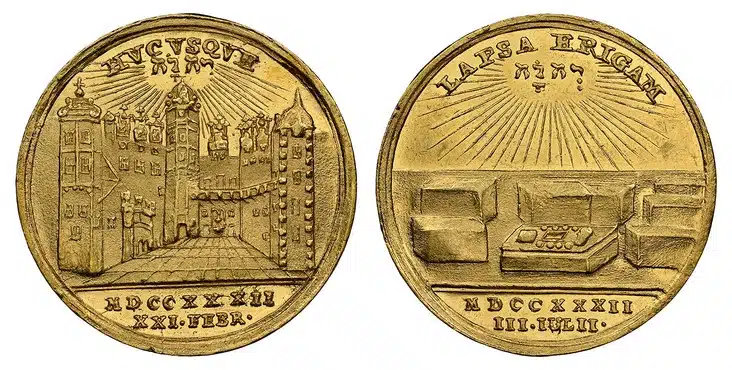
1076314 | GERMAN STATES. Schaumburg-Lippe. Albert Wolfgang. (1728-1748). 1732 AV Medallic 2 Ducats. NGC MS64. 25.5mm. 6.83gm. HVCVSQVE/ (Jehova). Radiant name of Jehovah in Hebrew letters over the view of the castle / LAPSA ERIGAM/ (Jehova). Radiant name of Jehovah in Hebrew letters over a foundation stone and seven ashlars. Weinmeister 32 (in Silver).
On the fire of Bückeburg castle, February 21 and the beginning of the restoration on July 3.
Exceptional Holland 6 Stuivers or “Scheepjesschelling”

1076069 | NETHERLANDS. Holland. 1730 AR 6 Stuivers, Scheepjesschelling. NGC MS66. Edge: Plain. MO: NO: ORD: HOLL: ET WESTFRI:. Crowned arms of Holland divides value, date above / VIGILATE DEO CONFIDENTES ·. Sailing ship. KM 45; CNM 2.28.116; V. 55.6.
* * *
Upcoming Events
The 52nd New York International Numismatic Convention (NYINC)
Empire Ballroom, Table #311
January 11-14, 2024
Venue address: 111 East 48th Street and Lexington Avenue, New York, NY.
For more information, visit www.nyinc.info.
Appraisal and Buying
Atlas Numismatics is actively buying individual items like the Schaumburg-Lippe 2 Ducats gold coin and other world coin highlights seen above, as well as whole collections. Please contact us if you have rare or exceptional ancient, United States, or world coins for sale; click here for more information.
* * *
The post Schaumburg 2 Ducats Gold Coin at Atlas Numismatics appeared first on CoinWeek: Rare Coin, Currency, and Bullion News for Collectors.
Sound Money Index 2024 – Positive Reforms and Problem States
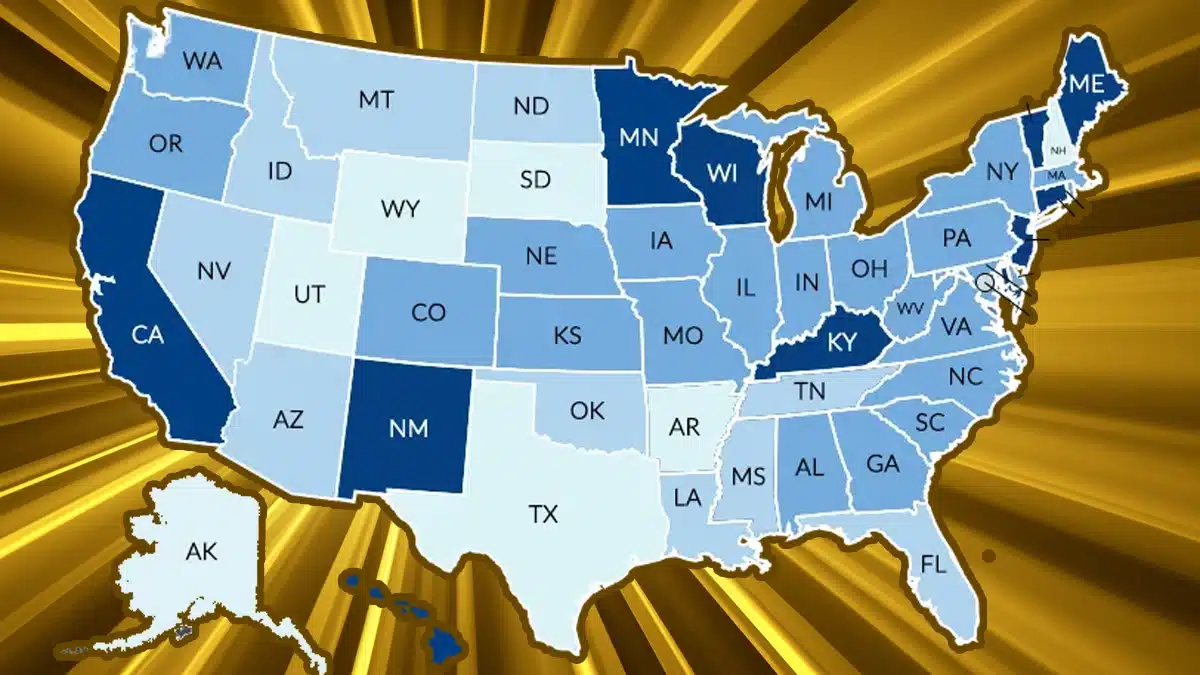
By Jp Cortez – Executive Director, Sound Money Defense League ……
Precious metals dealer and depository Money Metals Exchange has partnered with the Sound Money Defense League to create the 2024 Sound Money Index, ranking all 50 states based on their policies in this increasingly important public policy area.
The Index’s scoring system evaluates state laws such as sales and income tax policies concerning precious metals, whether a state affirms the role of gold and silver under the Federal Constitution; the existence of gold or silver in state pension funds or reserves; the existence of regulations that harm or otherwise punish precious metal dealers and investors; and other relevant issues.
Notable changes on the 2024 Sound Money Index since last year include Arkansas’s meteoric ascent from 30th to fifth place and Mississippi’s leap from 43rd to 16th.
Building on momentum from 2021’s precious metals sales tax repeal, then-Arkansas Governor Asa Hutchinson (R) signed a sound money bill to end all income tax liability on monetary metals, while also reaffirming gold and silver as legal tender and prescribing that state courts should require specific performance when enforcing contracts denominated in gold and silver.
After a multi-year legislative effort, Mississippi lawmakers canceled all sales taxes on precious metals. The Magnolia State became the 43rd in the country to remove taxes on purchases of gold and silver.
Meanwhile, Florida passed legislation in 2023 to roll back its laws targeting precious metals dealers, and Tennessee enacted legislation empowering its state treasurer to protect taxpayer reserves with a modest allocation to physical gold and silver.
This year’s Index includes a new, 14th criterion: Gross Revenue Tax. Such taxes are levied against total sales of companies in a handful of states. A gross receipts tax is a percentage of the topline revenue received by a business, and it ignores whether a business category has high or low gross profit margins
A gross revenue tax on precious metals businesses is extremely burdensome when compared to other types of businesses. That’s because precious metals dealers operate on extremely small gross profit margins — margins that are similar in scale to those on transactions involving real property, investments, or other goods sold by brokerages, which are usually exempt from state gross revenue tax schemes in the first place.
Oregon passed legislation in 2023 (HB 2073 – PDF Link) joining the vast majority of states that have exempted precious metals dealers from gross receipts tax or which don’t impose this tax at all. However, Ohio, Tennessee, Texas, and Delaware all lost points on the 2024 Sound Money Index for their controversial gross revenue tax regimes.
The complete 2024 Sound Money Index is available here.
* * *
The post Sound Money Index 2024 – Positive Reforms and Problem States appeared first on CoinWeek: Rare Coin, Currency, and Bullion News for Collectors.
Changes in the Use of Roman Money: Long Table 155 With Maria Cristina Molinari
Hoards dating to the third century BCE and associated with the establishment of sacred spaces have been found throughout the Romanized areas of the original territory of the Italic Latin people (Latium vetus or “Old Latium”), maritime Etruria (the home of the Etruscans), and the island of Sardinia. These kinds of deposits imply a relatively weak “economic” approach to the use of money by the Roman Republic at the time. Maria Cristina Molinari, Chief Curator of the Capitoline Museums in Rome, will discuss this religiously oriented practice and the emergence of a more “rational” approach during the Second Punic War against Carthage, when minting authorities became very aware of the monetary value of these donations to the spiritual realm.
Every Friday at 1:00 pm ET, the Long Table series brings together members from around the country. Lead by ANS staff, outside numismatic curators, authors, enthusiasts, historians, and many more, each talk offers the opportunity to take an hour away from your busy day to discuss all things numismatic, exchange views and ideas, and speak directly with fellow members and with the ANS.
For More on Roman Money and Other Ancient Coins, Watch Previous Long Tables on the ANS YouTube Channel Here
* * *
The post Changes in the Use of Roman Money: Long Table 155 With Maria Cristina Molinari appeared first on CoinWeek: Rare Coin, Currency, and Bullion News for Collectors.
Gold and Silver Prices Jump After FOMC Statement on Wednesday, Dec. 13
Gold aside, the prices of precious metals declined on Wednesday, with silver extending its losses for the eighth consecutive session
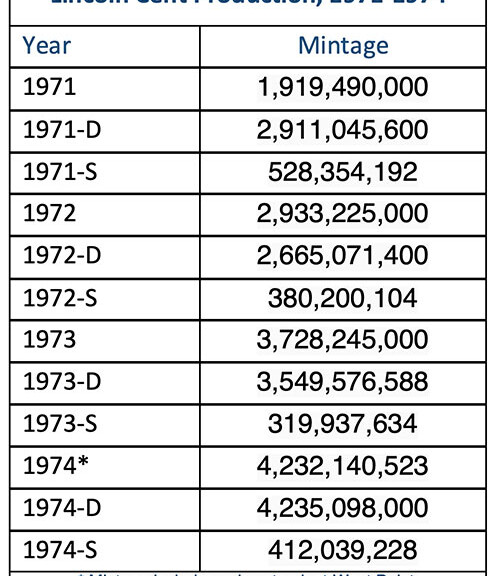
1974 Lincoln Memorial Cent : A Collector’s Guide | CoinWeek
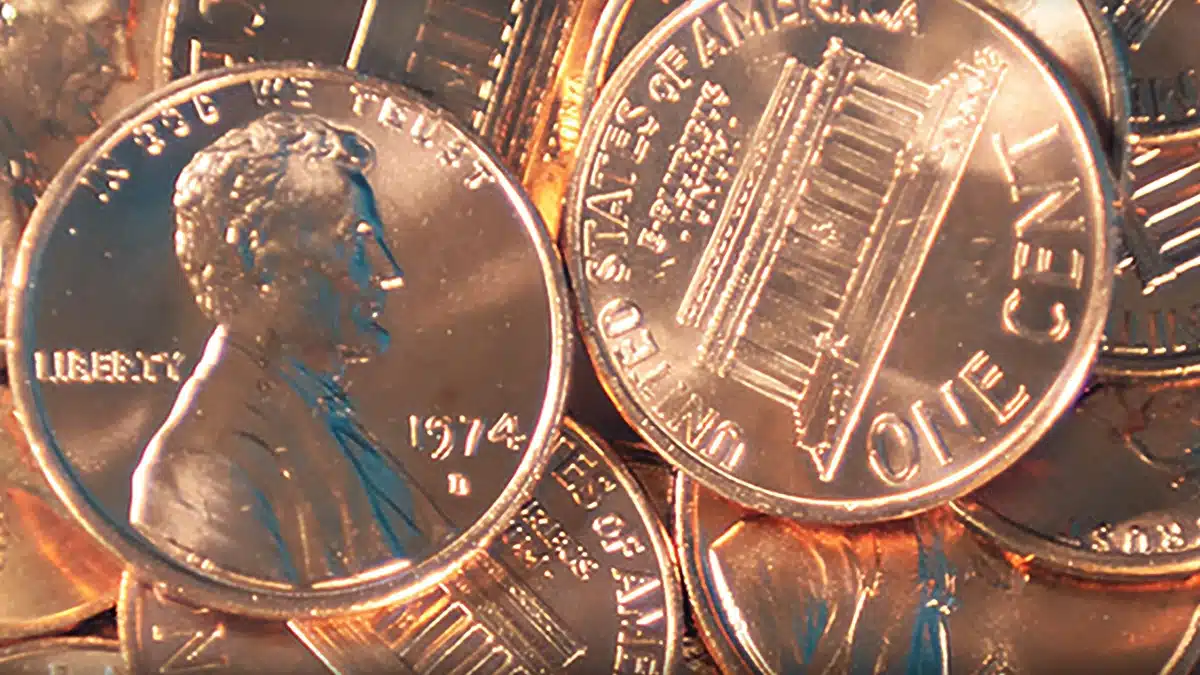
1974 was an interesting year in the annals of numismatic history. The country was putting the finishing touches on its planned Bicentennial celebrations. The United States Mint was gearing up to produce a range of commemorative coins and medals to mark the occasion. The year would also mark the final Blue and Brown Pack silver-clad Ike dollar issues and the Mint was hard at work contemplating the future of the country’s longest-serving denomination, the cent.
From 1971 to 1974, cent production increased dramatically, exacerbating a trend that began in the mid-1960s when the Mint transitioned from silver to clad coinage. Cent demand was so high by the late 1960s, that the Mint resumed production of circulating cent coinage at the San Fransico Assay Office in 1968. By 1974, demand for cents had gotten so high, that the Mint began to use the West Point Bullion Depository to strike cents as well. By the end of the year, West Point would contribute 128,957,523 cents toward Philadelphia’s reported mintage of 4,232,140,523. The West Point cents carry no mintmark and as far as we know, cannot be differentiated from coins struck at Philadelphia.
If original unopened mint bags of 1974 cents are ever located and can be traced to the facility, we would expect these coins to bring significant premiums over their Philadelphia Mint counterparts and that the third party certification industry would identify the coins as 1974 (W).
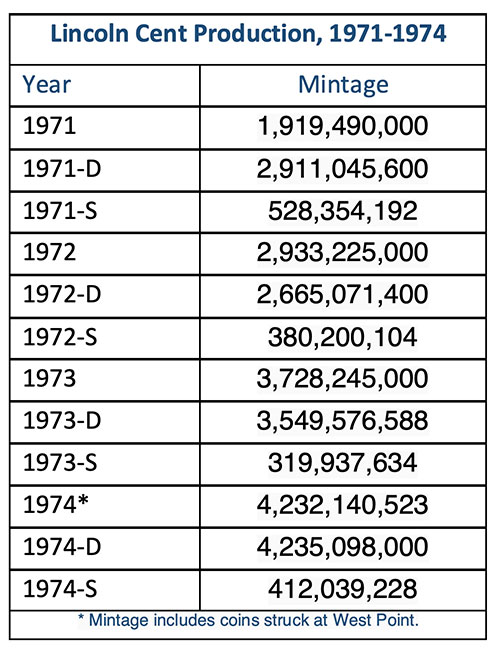 Complicating matters was a trend of volatility in the copper market.
Complicating matters was a trend of volatility in the copper market.
Copper prices rose by 43% from 1969 to 1970, before erasing most of those gains by the start of ’71. From 1971 to ’74, however, copper prices rose year to year reaching almost 86 cents a pound at the start of ’74.
To address this issue, the Mint began to investigate ways to lower the cost of cent production, settling on a 96% aluminum alloy as a possible replacement to bronze.
In total, the Mint struck approximately 1.5 million 1974-dated aluminum cents at the end of 1973. On March 27, the coins were reviewed by the Consumer Affairs subcommittee of the House of Representatives. After extended deliberation and pressure from the vending industry, Congress rejected the aluminum alloy, but did, on October 11, authorize the Secretary of the Treasury to reduce the amount of copper in the cent. By the end of 1974, copper prices receded to an acceptable level and the bronze alloy remained in use through the remainder of the decade.
In 1982, the issue would be revisited and a new alloy made of copper-plated zinc would replace the bronze cent.
How Much is the 1974 Lincoln Cent Worth?
Uncirculated Brown or Muted Red (Red Brown) Philly business strikes in high Mint State (above MS-65) can sell for anywhere from $10 to $15. Unless these coins are spectacularly toned, these coins have no foreseeable upside and should be avoided as a sufficient number of vibrant red examples survive.
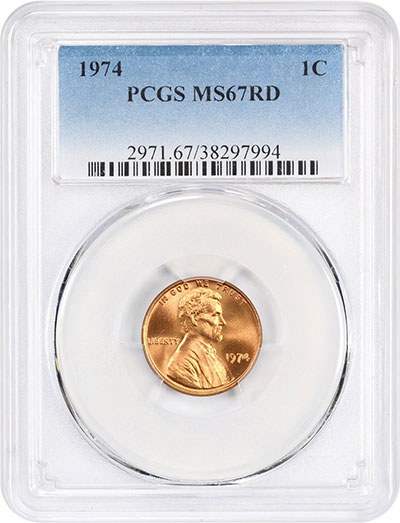 In full Mint State Red, MS65 examples have a value of between $10 and $20. The value of the 1974 Lincoln cent edges up by a few dollars in MS66 Red. Our expected value of a coin in this grade is between $20 and $30. These prices are more or less equivalent to the cost of submitting the coin for grading. 1974 cents have a larger premium in MS67 Red. One excellent example was sold in March 2020 at a David Lawrence Rare Coins online auction for $90.
In full Mint State Red, MS65 examples have a value of between $10 and $20. The value of the 1974 Lincoln cent edges up by a few dollars in MS66 Red. Our expected value of a coin in this grade is between $20 and $30. These prices are more or less equivalent to the cost of submitting the coin for grading. 1974 cents have a larger premium in MS67 Red. One excellent example was sold in March 2020 at a David Lawrence Rare Coins online auction for $90.
PCGS and NGC report a combined population of just two coins in MS68 Red (one each). With no public data available, it is a fool’s errand to try to ascertain a price for either of these pieces. But at just half a grade down, in MS67+ Red, two recent Legend Rare Coin Auctions results of $911 each suggest that a top pop 1974 Lincoln cent would easily realize a price exceeding $1,000 at auction.
As for the value of the priceless 1974 Aluminum cent patterns? This is a question we are asked quite frequently at CoinWeek. It is nearly impossible to quantify how unlikely it is that an authentic example heretofore unknown by the numismatic community would turn up, but it is possible. Of the 1.5 million examples struck, 11 are believed to be outstanding, and of that 11 only two are known.
One is currently on display at the Smithsonian Institution’s Value of Money Exhibit and is permanently impounded in the National Numismatic Collection, a donation of the United States Mint. The second example was discovered in 1973, reportedly by Albert Toven, a U.S. Capitol police officer. According to the story, the coin was dropped by a government official after a Congressional hearing on the efficacy of replacing the bronze alloy with an aluminum alloy. When Toven offered it back to the official, the official told Toven he could keep it.
This story has been published and repeated multiple times throughout the years but has all of the earmarks of a cover story. One told to “legalize” the private ownership of a pattern coin that was not officially released to the public. This example remains in private hands and was authenticated by PCGS in October 2005 and given the grade MS62. The value of this example likely exceeds six figures, but given its legally questionable status, a potential buyer would be advised to exercise caution when making an offer, or placing a bid as a protracted legal fight over the status of a privately-held 1974-D aluminum cent resulted in the coin being returned to the government.
Design
Obverse:
The obverse of the 1974 Lincoln cent was designed by Victor David Brenner and appears largely as it did when the type was first minted in 1909. The main difference on the 1974 obverse versus the 1909 version is the location of Brenners’ initials, V.D.B., which were added under Lincoln’s bust in 1918 after their removal from the reverse in late 1909. The date, 1974, appears to the right of Lincoln, and the motto IN GOD WE TRUST appears above the president. On the left of the 16th president is the word LIBERTY.
Reverse:
Frank Gasparro designed the 1959 Lincoln Memorial reverse that replaced the original 1909 Brenner wheat stalk design. Gasparro’s initials FG appear on the lower-right side of the Lincoln Memorial. Below the edifice and along the rim are the words ONE CENT, while the legend UNITED STATES OF AMERICA run along the top half of the reverse along the rim. Between the top of the Lincoln Memorial and UNITED STATES OF AMERICA inscription is the motto E PLURIBUS UNUM.
Edge:
The edge of the 1974 Lincoln cent is plain or smooth, without reeding or lettering.
1974 Lincoln Cent Designers
Lithuanian-born coin designer Victor David Brenner is best known for his iconic design for the Lincoln cent (1909-Present) (View Designer’s Profile).
Frank Gasparro was an American medalist and coin designer (View Designer’s Profile).
Coin Specifications
| Country: | USA |
| Year Of Issue: | 1974 |
| Denomination: | One Cent |
| Mint Mark: | None |
| Mintage: | 4,232,140,523 (includes 128,957,523 struck at the West Point Bullion Depository) |
| Alloy: | 95% copper, %5 tin and zinc |
| Weight: | 3.11 g |
| Diameter: | 19.05 mm |
| Edge: | Plain |
| OBV Designer | Victor David Brenner |
| REV Designer | Frank Gasparro |
| Quality: | Business Strike |
* * *
The post 1974 Lincoln Memorial Cent : A Collector’s Guide | CoinWeek appeared first on CoinWeek: Rare Coin, Currency, and Bullion News for Collectors.
Potentially Unique 1610 Teutonic Order 10 Ducat in Stack’s Bowers NYINC Auction
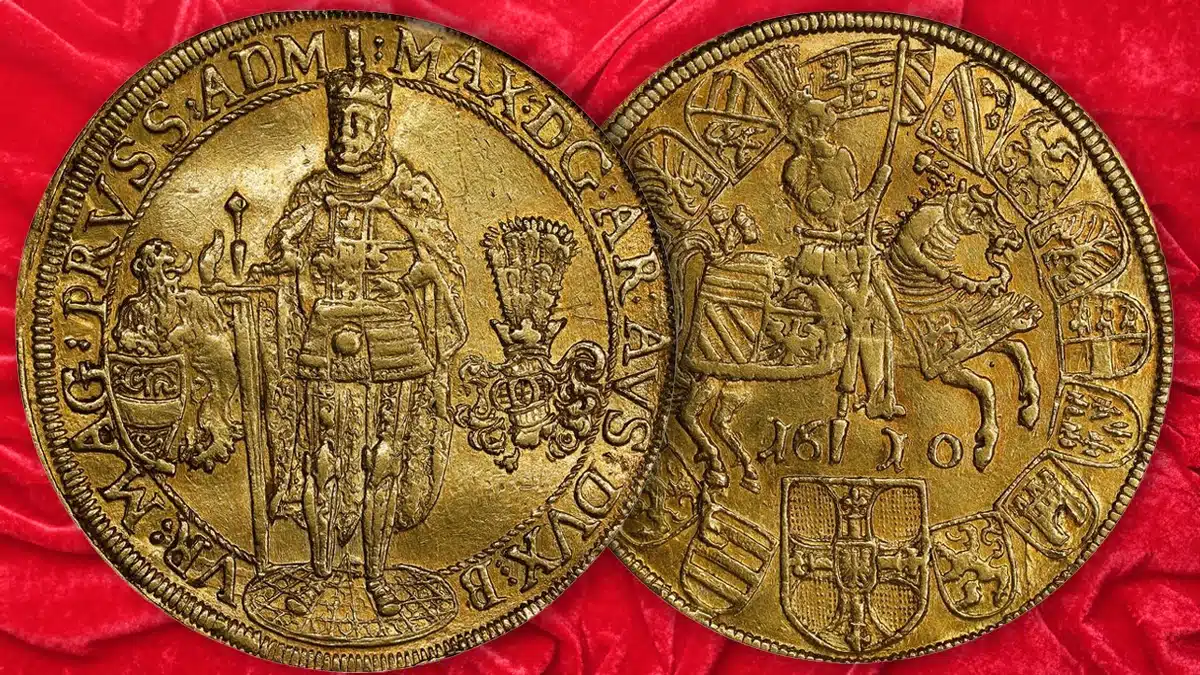
By Greg Cohen – Senior Numismatist, Stack’s Bowers Galleries ……
One of the highlights of the January 2024 New York International Numismatic Convention (NYINC) Sale from Stack’s Bowers Galleries, an impressive Teutonic Order 10 Ducat gold coin, was consigned from the Karl and Gertrude Pfatschbacher Collection. Dated 1610, this coin weighs a hefty 34.27 grams – more than one troy ounce of gold. It was produced at the Hall Mint in Austria and struck under Maximillian of Austria as the Grand Master of the Order.
The Grand Master of the Teutonic Order is depicted standing on the 10 Ducat obverse, wearing a crown, armor, and holding a sword, with the coin’s legend surrounding the portrait. The central device on the reverse is a knight on horseback, with the order’s arms below, surrounded by a circle of heraldic shields. In gold, this is listed as Fr-3379a and is unlisted in the KM reference.
These massive coins were struck from the same dies as the Talers, and were used either as a store of bullion, for use in large transactions, or most likely, as a presentation piece for some important person, perhaps even the Grand Master himself. As a type, the 1610 Teutonic Order 10 Ducats are extremely rare; in fact, our experts have been unable to locate another 1610, making the present piece potentially unique. Graded AU-55 by PCGS, it displays lovely and lustrous yellow gold color with only the barest trace of wear on the high points. This important European rarity (Lot 52086) carries an estimate of $40,000-$60,000 USD, and with such a dearth of examples of this denomination being sold, that level may well be exceeded.
The Teutonic Order is a Catholic religious institution, a military order founded during the Crusades in 1190. It was established to aid Christians on pilgrimage to the Holy Land. They also forced conversions in the Baltic during the Middle Ages, as well as protecting Catholics in Eastern Europe. At the time this coin was struck, the order was headquartered in Mergentheim, Germany. The Teutonic Order still exists today, awarding honorary knighthoods and administering hospitals.
While the deadline to consign to the 2024 NYINC Auction has now passed, we are always looking for consignments for future sales, including our Hong Kong and Showcase auctions, as well as our Collectors Choice Online (CCO) Auctions. If you have a consignment specialist you already work with at Stack’s Bowers Galleries, give them a call or email them to discuss your holdings. Otherwise, email consign@stacksbowers.com or call one of our offices to speak to a consignment specialist today.
* * *
The post Potentially Unique 1610 Teutonic Order 10 Ducat in Stack’s Bowers NYINC Auction appeared first on CoinWeek: Rare Coin, Currency, and Bullion News for Collectors.
U.S. Marines Bronze Medal on Sale December 14

The U.S. Marines Bronze Medal, part of the Armed Forces Medals Program, will be available for direct purchase from the United States Mint starting at noon Eastern on December 14, 2023. The bronze version of the silver medal has a diameter of 1.5″ (38.1 mm). It consists of 95% pure copper and 5% zinc.
The obverse design features three Marines armed with M4 rifles just after an amphibious landing. While two marines walk over a hill, another Marine hides in the grass to provide cover. At sea in the distance, a U.S. warship can be seen over the third Marine’s shoulder. Inscriptions on this side of the medal include U.S. MARINE CORPS and EVERY MARINE A RIFLEMAN. Mint Artistic Infusion Program (AIP) artist Emily Damstra designed the obverse, and U.S. Mint Medallic Artist Phebe Hemphill sculpted it.
The reverse design features the Marine Corps Eagle, Globe, and Anchor emblem surrounded by a border of rope. HONOR, COURAGE, and COMMITMENT, the core values of the Marine Corps, are inscribed clockwise along the top of the side. The Marines’ famous motto SEMPER FIDELIS (“Always Faithful”) is inscribed counterclockwise along the bottom. AIP artist Laurie J. Musser designed the reverse, and United States Mint Chief Engraver Joseph Menna sculpted it.
The initial retail price of the U.S. Marines Bronze Medal is $20 USD. “Remind Me” alerts can be set up on the Mint’s product page here (product code MMCS2). You can browse the Mint’s complete selection of Armed Forces medals and other medallic products here.
Armed Forces Silver Medals can be purchased through the United States Mint Product Subscription Program. Much like a magazine subscription, the program gives customers the peace of mind of being able to receive automatic shipments of products in a qualifying series. Product shipments continue until the customer cancels their enrollment; click on the link above to learn more.
* * *
The post U.S. Marines Bronze Medal on Sale December 14 appeared first on CoinWeek: Rare Coin, Currency, and Bullion News for Collectors.
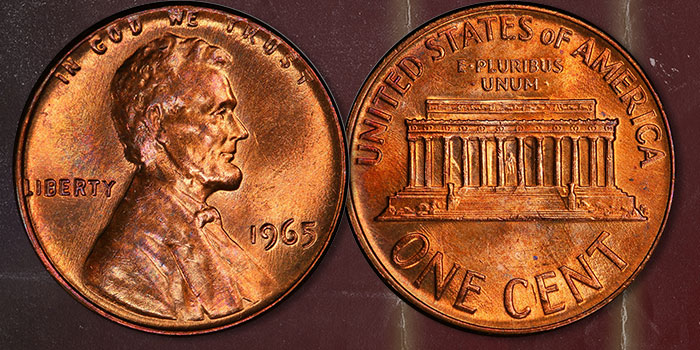
1965 Lincoln Cent : A Collector’s Guide

To collectors of U.S. coins, 1965 was an epoch in the history of the American monetary system. A coinage shortage and the rise of silver bullion prices begot a new clad composition for the dime and quarter, reduced the half dollar’s composition to silver billon, and doomed an effort to reintroduce the silver dollar.
But things were not quite so cut and dry as that and the United States Mint’s efforts to dissuade the American public from hoarding coins unfairly blamed collectors and tarnished the coin collecting hobby.
The Mint Establishes a Date Freeze
Under the direction of Mint Director Eva Adams, the U.S. Mint continued to strike coins dated 1964 through 1966. This order…
Nickels, quarters, and half dollars dated 1964 were struck in large quantities in 1964 and 1965, and dimes were struck in large quantities in 1964, 1965, a
nd 1966. In 1965, clad quarters and dimes entered production. Circulation quality 1965 silver-clad half dollars would not…
How Much Is the 1965 Lincoln Cent Worth?
1965 cents continue to circulate, although typical pieces found in pocket change will by in conditions Very Fine and below. The occasional Extra Fine or About Uncirculated example will reveal itself, most likely after an old accumulation of cents is emptied from a large jar of coins and deposited at a bank or at a CoinStar machine.
In numismatic channels, it is not at all difficult to acquire an uncirculated 1965 cent as large numbers of coins were saved in rolls and bags over the years. Notionally, an uncirculated 1965 cent will cost about $1 to $1.50. Beware of Special Mint Set coins masquerading as business strikes. Professional dealers know the difference, but the person listing the coin online or selling at your local store may not have paid too close
PCGS CoinFacts posts a price guide value of $8,000 for the sole 1980 cent. This appears to be a speculative price as there is no auction data to support this price. Given the approximately graded population of seven MS67+ cents in the PCGS population report, we believe that the 1980 Lincoln Cent in MS68RD guide price of $8,000 is high.
Design
Obverse:
The obverse of the 1965 Lincoln cent was designed by Victor David Brenner and appears largely as it did when the type was first minted in 1909. The main difference between the 1965 obverse and the 1909 version is the location of Brenners’ initials, V.D.B., which were added under President Abraham Lincoln’s bust in 1918 after their removal from the reverse in late 1909. The date 1965 appears to the right of Lincoln (viewer’s right), and the motto IN GOD WE TRUST appears above the president. On the left of the central motif is the word LIBERTY.
Reverse:
Frank Gasparro designed the 1959 Lincoln Memorial reverse that replaced the original 1909 Brenner wheat stalk design (the Wheat Cent). Gasparro’s initials FG appear on the lower-right side of the Lincoln Memorial. Below the edifice and along the rim are the words ONE CENT, while the legend UNITED STATES OF AMERICA run along the top half of the reverse along the rim. Between the top of the Lincoln Memorial and UNITED STATES OF AMERICA inscription is the motto E PLURIBUS UNUM.
Edge:
The edge of the 1965 Lincoln Cent is plain or smooth, without reeding or edge lettering.
Designers
Lithuanian-born coin designer Victor David Brenner is best known for his iconic design for the Lincoln cent (1909-Present) (View Designer’s Profile). Frank Gasparro was an American medalist and coin designer (View Designer’s Profile).
Coin Specifications
| Country: | United States |
| Year Of Issue: | 1965 |
| Denomination: | One Cent (USD) |
| Mint Mark: | None (Philadelphia) |
| Mintage: | 1,497,224,900 |
| Alloy: | .950 copper, 0.50 tin and zinc |
| Weight: | 3.11 g |
| Diameter: | 19.00 mm |
| Edge: | Plain |
| OBV Designer | Victor David Brenner |
| REV Designer | Frank Gasparro |
| Quality: | Business Strike |
* * *
The post 1965 Lincoln Cent : A Collector’s Guide appeared first on CoinWeek: Rare Coin, Currency, and Bullion News for Collectors.

United States 1965 Lincoln Cent

To collectors of U.S. coins, 1965 was an epoch in the history of the American monetary system. A coinage shortage and the rise of silver bullion prices begot a new clad composition for the dime and quarter, reduced the half dollar’s composition to silver billon, and doomed an effort to reintroduce the silver dollar.
But things were not quite so cut and dry as that and the United States Mint’s efforts to dissuade the American public from hoarding coins unfairly blamed collectors and tarnished the coin collecting hobby.
The Date Freeze
Under the direction of Mint Director Eva Adams, the U.S. mint continued to strike coins dated 1964 through 1966. This order…
Nickels, quarters, and half dollars dated 1964 were struck in large quantities in 1964 and 1965, and dimes were struck in large quantities in 1964, 1965, and 1966. In 1965, clad quarters and dimes entered production. Circulation quality 1965 silver-clad half dollars would not…
The Market for 1965 Cents
1965 cents continue to circulate, although typical pieces found in pocket change will by in conditions Very Fine and below. The occasional Extra Fine or About Uncirculated example will reveal itself, most likely after an old accumulation of cents is emptied from a large jar of coins and deposited at a bank or at a CoinStar machine.
In numismatic channels, it is not at all difficult to acquire an uncirculated 1965 cent as large numbers of coins were saved in rolls and bags over the years. Notionally, an uncirculated 1965 cent will cost about $1 to $1.50. Beware of Special Mint Set coins masquerading as business strikes. Professional dealers know the difference, but the person listing the coin online or selling at your local store may not have paid too close
PCGS CoinFacts posts a price guide value of $8,000 for the sole 1980 cent. This appears to be a speculative price as there is no auction data to support this price. Given the approximately graded population of seven MS67+ cents in the PCGS population report, we believe that the 1980 Lincoln Cent in MS68RD guide price of $8,000 is high.
Design
Obverse:
The obverse of the 1965 Lincoln cent was designed by Victor David Brenner and appears largely as it did when the type was first minted in 1909. The main difference between the 1965 obverse and the 1909 version is the location of Brenners’ initials, V.D.B., which were added under President Abraham Lincoln’s bust in 1918 after their removal from the reverse in late 1909. The date 1965 appears to the right of Lincoln (viewer’s right), and the motto IN GOD WE TRUST appears above the president. On the left of the central motif is the word LIBERTY.
Reverse:
Frank Gasparro designed the 1959 Lincoln Memorial reverse that replaced the original 1909 Brenner wheat stalk design (the Wheat Cent). Gasparro’s initials FG appear on the lower-right side of the Lincoln Memorial. Below the edifice and along the rim are the words ONE CENT, while the legend UNITED STATES OF AMERICA run along the top half of the reverse along the rim. Between the top of the Lincoln Memorial and UNITED STATES OF AMERICA inscription is the motto E PLURIBUS UNUM.
Edge:
The edge of the 1965 Lincoln Cent is smooth or plain and without reeding, as are all other Lincoln cents.
1965 Lincoln Cent Designer(s)
Lithuanian-born coin designer Victor David Brenner is best known for his iconic design for the Lincoln cent (1909-Present) (View Designer’s Profile). Frank Gasparro was an American medalist and coin designer (View Designer’s Profile).
Coin Specifications
| Country: | USA |
| Year Of Issue: | 1965 |
| Denomination: | One Cent |
| Mint Mark: | None (Philadelphia) |
| Mintage: | 1,497,224,900 |
| Alloy: | .950 copper, 0.50 tin and zinc |
| Weight: | 3.11 g |
| Diameter: | 19.05 mm |
| Edge: | Plain |
| OBV Designer | Victor David Brenner |
| REV Designer | Frank Gasparro |
| Quality: | Business Strike |
The post United States 1965 Lincoln Cent appeared first on CoinWeek: Rare Coin, Currency, and Bullion News for Collectors.
Apply Now: CCAC Medallic Arts or Sculpture Role – Deadline Jan. 3, 2024
U.S. Mint Striking Ceremony for 2024 Greatest Generation Coins at Philadelphia
Kristie McNally, Deputy Director of the United States Mint, will host a closed gathering at the Philadelphia Mint this Wednesday, December 13th, at 11 a
CCAC Member Darla Jackson Resigns, Joins United States Mint

By Hubert Walker for CoinWeek ….
Joining the Citizens Coinage Advisory Committee (CCAC) just earlier this year, sculptor Darla Jackson has resigned from the Committee to join the full-time creative staff of the United States Mint as a Medallic Artist. She had served on the 11-seat CCAC as the Committee’s specialist in the sculptural and medallic arts.
The Mint is currently seeking applications for her replacement, with a submission deadline of January 4, 2024. This notice was released to the public on December 1.
Background
Long committed to her community in Philadelphia, Ms. Jackson earned her Bachelor’s of Fine Arts in Sculpture from Moore College of Arts, a local visual arts school for women. She won Arts Challenge Grants from the John S. and James L. Knight Foundation in 2011 and 2013; according to their website, the Knight Foundation “support[s] a more effective democracy by funding free expression and journalism, arts and culture in community, research in areas of media and democracy, and in the success of American cities and towns where the Knight brothers once published newspapers.”
Jackson also founded the Philadelphia Sculpture Gym, a sculpture studio that community members can join like a gym. She currently teaches moldmaking and figure modeling as an Assistant Professor at Pennsylvania Academy of Fine Arts in Philadelphia, and is an elected member of the National Sculpture Society, where she serves on the Honors and Awards Committee. Ms. Jackson has also been a member of the Board of Philadelphia Sculptors since 2021.
She was appointed to serve a four-year term with the CCAC as the member “specifically qualified in medallic arts or sculpture” by Treasury Secretary Janet Yellen on March 23, 2023, and sworn in at the April 18 public meeting (PDF Link) at the Mint’s Washington, D.C., headquarters.
Artists at the United States Mint
The Engraving Department at the United States Mint utilizes two separate pools of talent.
Until recently, the Mint refered to its full-time, in-house staff as sculptor-engravers; these individuals are now called Medallic Artists. These employees create design work and sculpt models for new coins and medals. Besides Ms. Jackson, current U.S. Mint Medallic Artists include Craig Campbell, Eric David Custer, Renata Gordon, Phebe Hemphill, John P. McGraw, and Chief Engraver Joseph P. Menna.
To add fresh perspectives, styles, and ideas to contemporary American coin design, Congress established the Artistic Infusion Program (AIP) in 2003. While the nature of the work is somewhat freelance, AIP artists develop relationships with the Mint and work directly with Medallic Artists to created new designs. The U.S. Mint issues public invitations to professional artists to join the AIP when openings are available.
CCAC’s Jackson Not the First
Another former CCAC member has already followed a similar path to Jackson.
Heidi Wastweet, who served two terms as the Committee’s sculpture and medallics art expert from 2010 through 2018, has realized her designs on modern U.S. coins through the Artistic Infusion Program starting with the reverse of the 2021 National Law Enforcement Memorial and Museum commemorative half dollar.
About the CCAC
Established by Public Law 108-15 in 2003, the Citizens Coinage Advisory Committee (CCAC) advises the Secretary of the Treasury on the themes and artwork that grace our country’s coins and medals. This includes commemoratives, Congressional Gold Medals, Mint medals, bullion coins, other special numismatic programs, and all circulating coinage. The Treasury Secretary then makes the final decision. The CCAC can also suggest mintage level recommendations.
* * *
Sources
https://coinweek.com/ccac-medallic-arts-applications/
https://www.ccac.gov/aboutUs/bio_DarlaJackson.html
https://nationalsculpture.org/member/darla_jackson/
https://www.ccac.gov/media/calendar/transcripts/CCAC_Meeting_April%2018-ADA.pdf
https://www.ccac.gov/aboutUs/PL108_15.html
* * *
The post CCAC Member Darla Jackson Resigns, Joins United States Mint appeared first on CoinWeek: Rare Coin, Currency, and Bullion News for Collectors.
Marcus Agrippa and His Coins of the Roman Empire
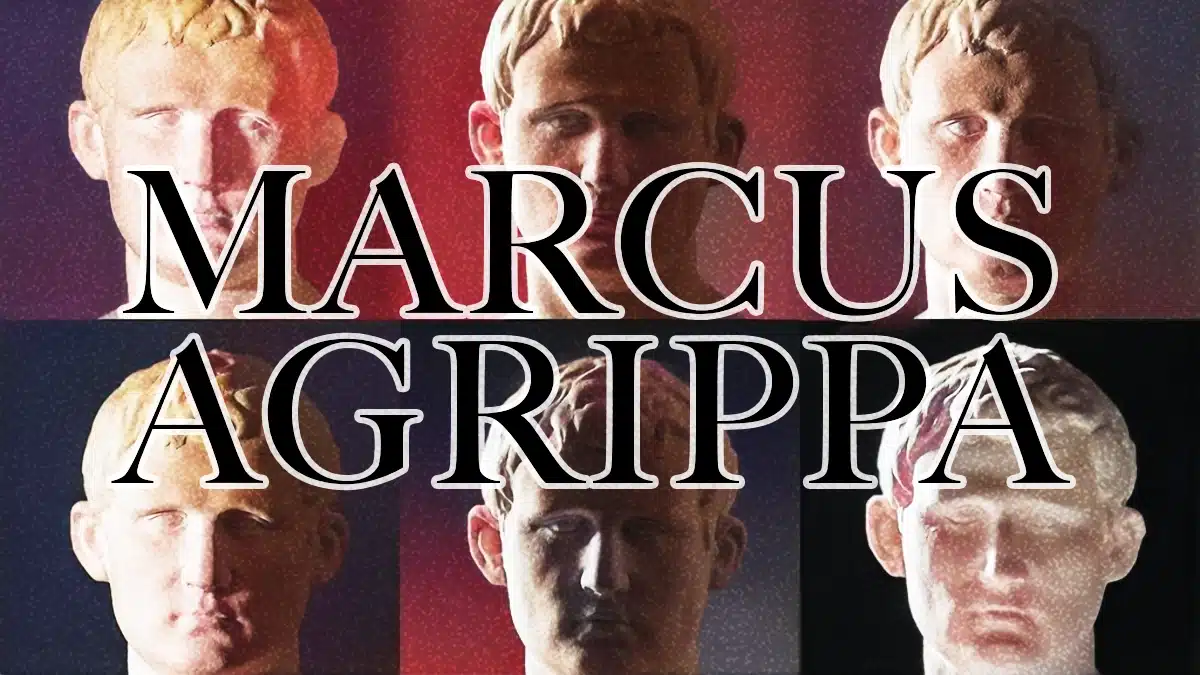
By Dr. Steve Benner for CoinWeek …..
Marcus Vipsanius Agrippa was born to a plebeian family near Rome or possibly Pisa in about 63 BCE. He was the same age as Octavian, the nephew of Julius Caesar, and they met at school in Apollonia, Illyria, becoming very close friends. For more than three decades, the two worked together to make Rome into the greatest empire in history. Agrippa served as Augustus’ general and admiral and oversaw the construction of some of the most important buildings in the capital city.
The Life of Agrippa and His Coins
To cover in detail all of the things that Agrippa did during his life would require a much larger article than I’m writing here, so I’m going to cover a few highlights of his career and the coins minted in his honor.
After the death of Julius Caesar in 44 BCE, Octavian returned to Italy with Agrippa from Apollonia in Illyria. In April 43, Octavian was acclaimed Imperator (imperator simply meant “commander” at this point), and, in December, Agrippa was elected tribune of the plebians. In 42, Agrippa served as a military commander under the triumvirs Marc Antony and Octavian in the Battle of Philippi, where two of Caesar’s assassins, Marcus Brutus and Gaius Cassius, killed themselves after losing the fight. Upon the pair’s return to Italy, Agrippa played a major role in the successful Perusine War against Lucius Antonius and Fulvia, the brother and wife of Marc Antony, in 41 BCE.
In 40, Agrippa was made praetor urbanus, or chief magistrate of Rome, with orders to stop Sextus Pompeius’ raids on the Italian coast. Later that year, he staged the Ludi Apolloniares, religious games held annually in honor of Apollo. Agrippa led successful military operations against M. Antony and S. Pompeius in southern Italy, which led to a peace agreement between the two triumvirs. Octavian appointed Agrippa governor of Transalpine Gaul in late 40. While in Gaul, Agrippa suppressed an uprising of Aquitanians and crossed the Rhine to attack Germanic tribes.
Agrippa returned to Rome and was offered a triumph but refused. In January 37 BCE, he was elected consul, and the first coin honoring him was minted (Figure 2). The denarius’ obverse has Julius Caesar facing Octavian with the legend DIVOS IVILIVS / DIVI F, which means “Son of the Divine Caesar”, and a reverse with M AGRIPPA COS/DESIG, which means “M. Agrippa, Consul Designate”. This coin was also issued with only Octavian on the obverse with the legend IMP CAESAR DIVI IVLI F. These coins tend to be expensive but not too rare.
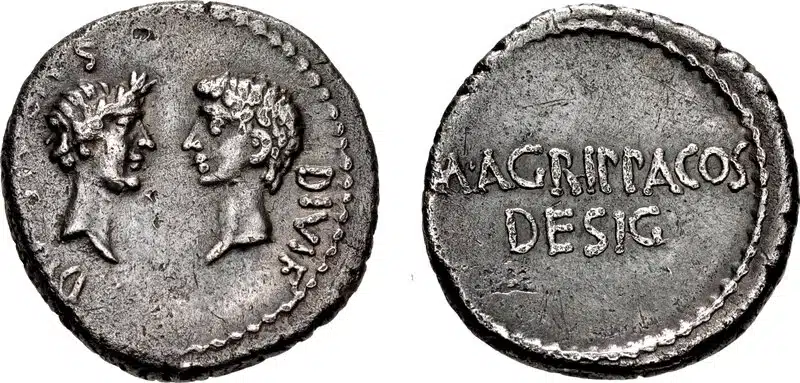
Also in 37, Agrippa married Caecilia Attica, who would provide him with a daughter, Vipsania Agrippina, the following year. Octavian entrusted Agrippa with the war against Sextus Pompeius, and Agrippa started work on cutting a channel from Lacus Lucrinus (near modern Naples) to the sea and joining Lake Avernus to Lucrinus. This created a protected harbor, Portus Iulius, that S. Pompeius could not attack, and he could train his 20,000 oarsmen.
In July 36 BCE, Agrippa took the offensive and defeated Pompeius’ admiral at Mylae and then Pompeius himself at the Battle of Naulochus in September. Pompeius fled to Miletus in Anatolia and was executed by a Roman official. As a result of his victory, Agrippa was awarded the Corona Navalis, a unique honor. Though minted much later in 12 BCE, the coin in Figure 3 shows Agrippa wearing the crown on the reverse with Octavian on the obverse; Lentulus is the moneyer. Again, this is an expensive coin and relatively rare.

In 35 BCE, Agrippa lead military operations along the coast of Dalmatia and then returned to Rome. In 34, he was appointed curule aedile, the official in charge of buildings and festivals, and began a program of public works and improvements. He built and repaired the aqueducts (including the Aqua Marcia), repaired streets, cleaned out sewers (including the Cloaca Maxima), constructed baths and porticos, laid out gardens, and organized exhibitions of art.
In October 32, the Senate declared war on Cleopatra (and M. Antonius). Agrippa was appointed admiral of Octavian’s fleet and began operations against the coast of Greece. On September 2, 31 BCE, the opposing fleets met at Actium, and Agrippa and Octavian were victorious. Antony and Cleopatra fled to Egypt, where they committed suicide. Agrippa withdrew the troops back to Italy and exercised interim powers in Rome with Maecenas. In 29, Octavian celebrated a triple triumph and awarded Agrippa more honors, including a sea-blue vexillum pennant.
In January of 28 and 27, Agrippa was appointed his second and third consulships with Octavian. Caecilia apparently having died, Agrippa married Claudia Marcella, Octavian’s niece, in October 28. In 27, Octavian was granted the honorific title of Augustus, and Agrippa supervised improvements in the Campus Martius, completed construction of the Parthenon, the Saepta Iulia, and the Basilica of Neptune, and began construction of the Baths of Agrippa.
In 23 BCE, Agrippa began a tour of the eastern provinces, where he negotiated the return of the aquilae (eagle standards) from the Parthians and received the title of proconsulare imperium. Returning to Rome in 21, he divorced Claudia to marry Julia the Elder, the only daughter of Augustus, and was put in charge of Rome while Augustus was away in the East. A son, Gaius Vipsanius Agrippa, was born to Agrippa and Julia in 20. Next year, Agrippa traveled to Narbonensis in southern Gaul to drive back a German invasion and reorganize the Gallic provinces. Also, that year, Vipsania Julia Agrippina, another daughter, was born to Agrippa. He then traveled to the Iberian Peninsula to conclude the Asturian-Cantabrian War and returned to Rome in 18, where his imperium and tribunicia potestas were extended for five years.
In 17 BCE, another son, Lucius Vipsanius Agrippa, was born, and Augustus adopted both Lucius and Gaius. Figure 4 is a coin that was minted starting in the year 2 BCE, 10 years after Agrippa’s death, but it shows Agrippa’s children as the heirs of Augustus. The obverse is Augustus, and the reverse shows Gaius and Lucius facing forward with a shield between them and sacred instruments above. The reverse legend translates as “Gaius and Lucius, sons of Caesar Augustus, consuls elect, princes of the youth.” This was minted in large quantities and can be relatively easy to find, though in VF can still be a little pricey.
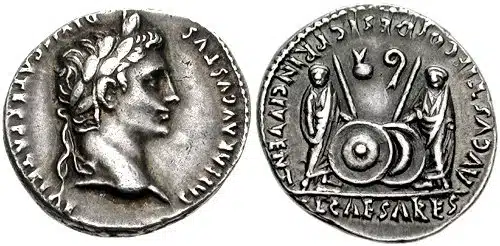
In 16 BCE, Agrippa traveled to the East again, and another daughter, Vipsania Agrippina, was born to him in 14. He returned to Rome in the year 13, and his tribune powers and imperium were renewed. Agrippa left for Illyricum and Pannonia to quash the revolt there. By now it was obvious that Augustus was grooming his two grandsons as his successors, with Agrippa taking over should Augustus die before the young men were old enough. Agrippa now had almost as much power as Augustus without all the titles. As a result of this prominence in political affairs, two out of the three moneyers for the year 13 included Agrippa on their coins – with moneyer C. Sulpicius Platorinus focused entirely on Agrippa. Figures 5 and 6 show examples of this. Figure 5 has Augustus on the obverse and M. Agrippa on the reverse with the word VIRTUS (courage) in the legend. This coin is a little rare and comes with a hefty price tag.

Figure 6 again has Augustus on the obverse, and the reverse shows Augustus and Agrippa bare-headed wearing togas and seated on a bisellium (a double throne), placed on a platform with three rostra. This clearly indicates that Agrippa had been elevated to a role similar to the emperor and that he was intended to be the heir to the throne. This coin was also moneyed by Platorinus. Like the previous coin, it is somewhat rare and expensive.
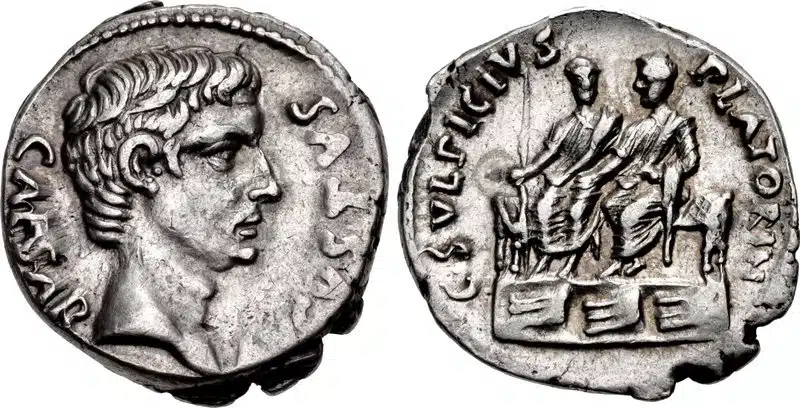
In 12 BCE, while attending the festival of the Quinquatria in Campania, Agrippa became ill and died. After a state funeral, Agrippa’s ashes were placed in the Mausoleum of Augustus. Agrippa Postumus was born to Julia soon after. Figure 7 has a reverse showing Augustus crowning a statue of Agrippa with a star. The star is usually associated with divinity (like Julius Caesar) but can be used for renowned dead. Lentulus’ title of Flamen Martialis seems to associate the statue with Mars and may have been in the temple of Mars Ultor.
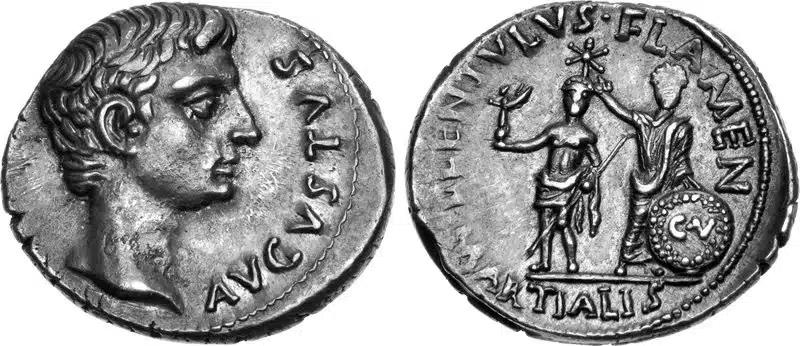
Figure 8 shows a reverse with an equestrian statue of Agrippa with the legend saying “Lentulus, son of Cornelius,” as the coin’s moneyer.
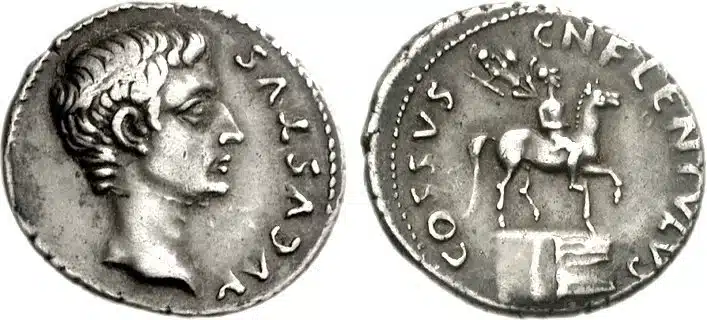
The coin in Figure 9 is a little more difficult to understand. The obverse is a very young head of Augustus (the oak wreath is his signature), and the reverse has a candelabrum. The young Augustus portrait may have been a result of the coin not being minted at a regular imperial mint, so a generic portrait was used. The candelabrum reverse is not only religious but funeral, referring to Agrippa’s death. It has been proposed that this issue was struck in Pannonia to pay the now leaderless, and perhaps restless, Pannonian legions, without having to wait for a military mint issue.
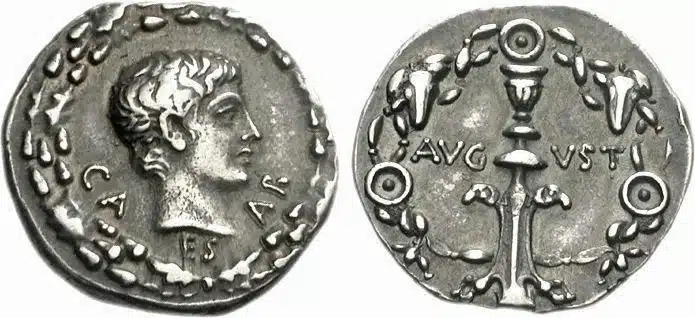
I have only covered Agrippa’s imperial coins, but there were many local pieces struck with his portrait on them. He traveled all over the Roman Empire and did a lot of good works for the cities he visited. For example, Cnossus in Crete, Sparta, Corinth, Bithynia, and Nicopolis (Epirus), to name just a few, issued coins with his portrait. The kings of Bosporus issued a gold stater with his head on the reverse.
But there is one coin I have to include because it is so neat and famous.
Figure 10 shows a bronze AE As minted in Nemausus, Gaul (modern Nîmes). The obverse has the heads of Augustus and Agrippa facing in opposite directions. The reverse has a crocodile chained to a palm frond. It is believed the crocodile refers to the subjugation of Egypt by Augustus in 30, and the design may have been initiated by one or more legions sent to the area after participating in the campaign. Augustus created a mint in Nemausus and helped make the city very prosperous. Today there is a sculpture of the crocodile in the city center. This coin was struck in large quantities and can be found in many sales at a reasonable price (I have one).
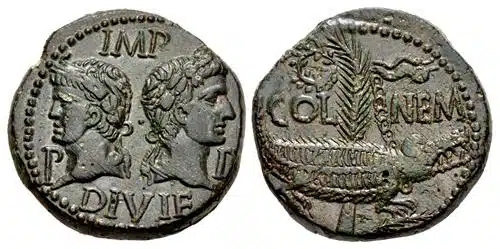
The last coin I need to cover is the most common.
Figure 11 shows an AE as minted by Caligula (37 to 41 CE), Agrippa’s grandson. It has Agrippa facing left on the obverse of the coin, and Neptune standing facing left holding a small dolphin on the reverse. The obverse legend says, “M. Agrippa, son of Lucius, Consul three times.” Neptune on the reverse refers to Agrippa’s victories at Actium and against S. Pompeius. This coin was also minted by the Flavian emperors Titus and Domitian. The former has IMP T VESP AVG REST on the reverse and the later has IMP D AVG REST, the “REST” saying that it is a restored coin. The Caligula type was issued in large quantities and is readily available at a reasonable price. Later versions are not as common.
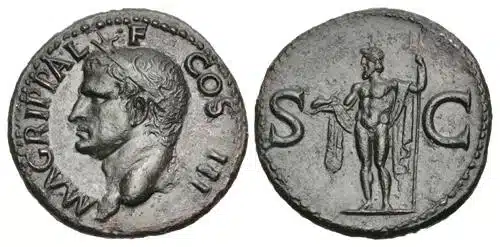
From second-century CE Roman historian Cassius Dio:
Agrippa … had in every clearly shown himself the noblest of the men of this day and had used the friendship of Augustus with a view to the greatest advantage both of the emperor himself and of the Commonwealth.
From former Harvard classics professor Glen Bowersock (Encyclopedia Britannica):
Agrippa deserved the honours Augustus heaped upon him. It is conceivable that without Agrippa, Octavian would never have become emperor. Rome would remember Agrippa for his generosity in attending to aqueducts, sewers, and baths.
* * *
References
Classical Numismatic Group (CNG)
Hornblower, Simon, and Antony Spawforth, ed. The Oxford Classical Dictionary, 3rd edition. Oxford (1996)
Madden, F.; Smith, C.R.; and S.W. Stevenson. A Dictionary of Roman Coins. London (1889)
Powell, Lindsay. Marcus Agrippa Right-hand Man of Caesar Augustus. Pen and Sword Military: Yorkshire (2015)
Sear, David. Roman Coins and Their Values, Vol I. Spink (2000)
Sutherland, C.H.V., and R.A.G. Carson. The Roman Imperial Coinage, Vol I. Spink and Son: London (1984)
Vagi, David. Coinage and History of the Roman Empire (2 volumes). Coin World (1999)
* * *
The post Marcus Agrippa and His Coins of the Roman Empire appeared first on CoinWeek: Rare Coin, Currency, and Bullion News for Collectors.
Precious Metals Mixed on Tuesday Amid U.S. Inflation Data
Prices for precious metals split on Tuesday amid U
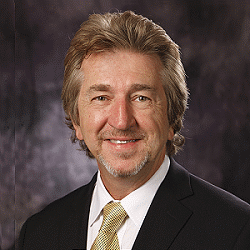
The 1922 Lincoln Cent and Its Varieties
By Jeff Garrett for Numismatic Guaranty Company (NGC) ……
 Before 1922, the United States Mint struck huge numbers of Lincoln Cents each year. Production peaked in 1919, when the Philadelphia, Denver, and San Francisco mints struck just under 589 million coins. However, the mintage plunged in 1922, when only the Denver Mint created 7.16 million coins.
Before 1922, the United States Mint struck huge numbers of Lincoln Cents each year. Production peaked in 1919, when the Philadelphia, Denver, and San Francisco mints struck just under 589 million coins. However, the mintage plunged in 1922, when only the Denver Mint created 7.16 million coins.
The end of World War I sparked a painful nationwide recession that crushed demand for additional cents. In the August 1922 issue of The Numismatist, Mint Director F.E. Scobey stated:
There have been approximately $46 million worth of pennies coined since the Mint began in 1792. So, what’s the use of making more, when about the only nothings you can buy with a penny nowadays are lollypops?
Today, the cent buys far less, and the U.S. Mint still make billions of coins each year.
When Lincoln Cent production was stunted in 1922, the year created some of the most fascinating yet complicated issues of the series. Although much has been written about the different cents of 1922, the popularity and complexity of the issues deserves a brief examination. Collectors are sometimes confused about which pieces they need for their collection.
The following are some of the different variations of 1922 Lincoln Cents to consider.
1922-D Lincoln Cents

As would be expected due to its relatively low mintage, the 1922-D Lincoln Cent is scarce in all grades. Average circulated examples can be purchased for about $50 USD each. Higher-grade coins are somewhat available, especially if you’re satisfied with a coin that is brown or reddish brown in color. The finest graded have been two MS66 RD examples, neither of which have sold at public auction. Just 26 have been graded by NGC as MS65 RD, with the auction record being $2,790 for a coin sold in 2022. Most coins designated as 1922-D Lincoln Cents are well struck.
This brings into play the other interesting but complicated varieties of 1922 Lincoln Cents. Starting around 1928, letters in The Numismatist started to mention the observation of 1922 Lincoln Cents with missing or mushy ‘D’ mintmarks. Collectors could not agree on what they were seeing. During the 1950s, Whitman Publishing created demand for the 1922 Plain Cent when they added a hole in their albums for the coin. It was not until years later that researchers defined what different coins were created in 1922 at the Denver Mint. Modern research has defined the following varieties as collectible 1922 No D or Weak D Lincoln Cents.
1922 Weak D Lincoln Cents
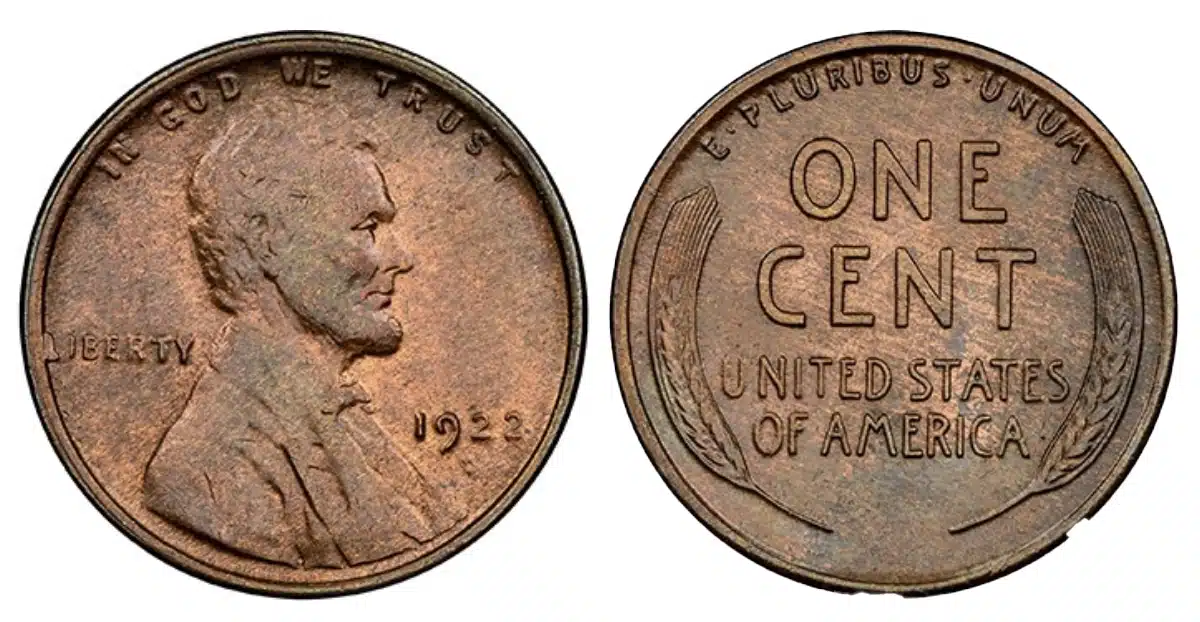
The basic explanation for the No D or Weak D cents of 1922 is that die clashing created the need to abrasively polish the obverse die and this removed or obscured the ‘D’ mintmark. The coins designated as 1922 Weak D bring a relatively small premium. The NGC MS64 RB coin illustrated above sold for $660 in May 2023. As can be seen from the picture, the ‘D’ is barely visible.
1922 No D Weak Reverse
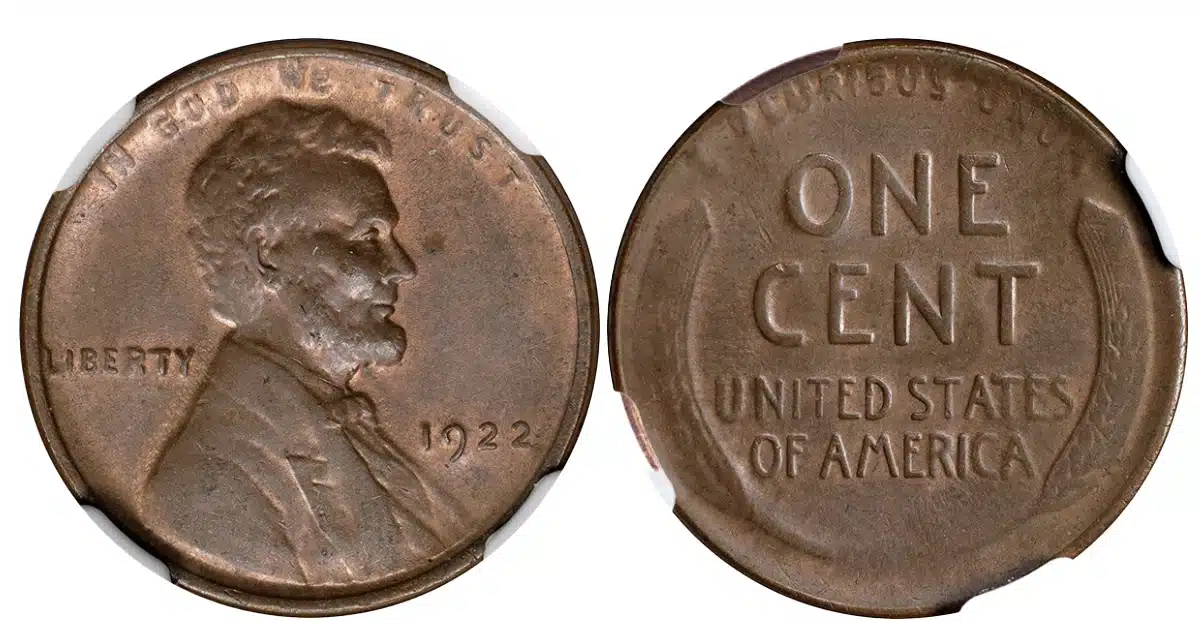
This die pairing was created from a very worn reverse die. The wheat ear lines are barely discernable. Although this variety has no trace of the ‘D’ mintmark, the weak reverse makes the coin less desirable for collectors. The MS63 RB example pictured above sold for $3,600 in June 2022. Fully red color examples are nearly nonexistent. NGC has only certified one example as such. Extremely Fine examples can be purchased for about $650. The 1922 No D Weak Reverse is the more affordable alternative for budget-minded collectors.
1922 No D Strong Reverse
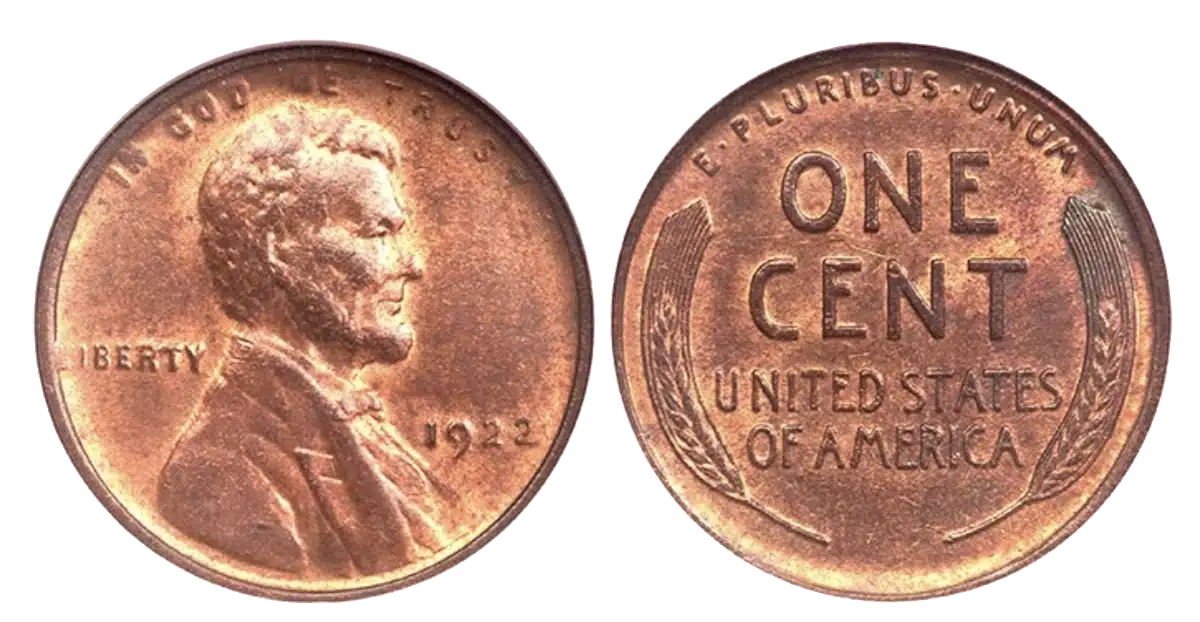
This die pairing is by far the most desirable and the one collectors consider as the “true” 1922 Plain Cent. The ‘D’ mintmark is completely missing, and the reverse is well struck. The 1922 No D Strong Reverse sells for around $750 in Very Fine condition, but even in low grade, problem-free coins are not easy to locate. The 1922 No D Strong Reverse is increasingly rare in high grade and Mint State coins are seldom seen or available.
The MS64 RB example pictured above sold for $37,375 in June 2010. This variety is virtually unknown with full red color remaining — none have been certified by NGC. Amazingly, a Mint State 1922-D Lincoln Cent can be purchased for about $125. The same coin without the ‘D’ mintmark sells for nearly $10,000. Knowing exactly the different varieties available for the issue is imperative.
Words of Caution
Beware of cleverly crafted counterfeit examples of 1922 Lincoln Cents. Removing the ‘D’ mintmark is simple work for skilled counterfeiters. Buying certified examples, regardless of grade, is highly recommended.
Sadly, collectors should also be careful of well-made Chinese fakes of this issue. Be careful when buying this or any Lincoln Cent that has been certified as “Red Brown” or “Red”. Color on Lincoln Cents can sometimes fade over time and is NOT guaranteed long-term by any grading service.
* * *
* * *
The post The 1922 Lincoln Cent and Its Varieties appeared first on CoinWeek: Rare Coin, Currency, and Bullion News for Collectors.
Mint Error Coins News Magazine #68 Features Unique U.S. Errors
Mint Error News Magazine Issue 68: Unique U.S. Proof, Specimen, Pattern & Error Coins
Many numismatists, dealers, and collectors consider unique coins to be the most coveted, prized, and valuable. Many of these unique coins were documented by the United States Mint or one of the Mint branches, while others have no documentation at all but there are logical assumptions as to how and why they were struck.
Some of the most famous American coins were struck under mysterious circumstances, and the story behind each coin’s production adds to their rarity, prestige, and value. Examples of these “mysterious” coins include pieces struck in Proof where only one example is known or a special specimen striking produced using polished dies. Many other unique and unusual coins are patterns, trial strikes, or mint errors.

This issue of Mint Error News showcases some of the unique U.S. coins struck as a Proof, as a specimen strike, as a piece de caprice, or as a deliberately produced mint error rarity.
* * *
Mike Byers is the Publisher and Editor of Mint Error News. Consultants are numismatic experts recognized worldwide, including Heritage Auctions, Dave Camire, Ron Guth, Marc Crane, Andy Lustig, Saul Teichman, Michael Faraone, Steven Contursi, Jeff Ylitalo, John Wang, and Fred Weinberg (retired).
For more information about Mike Byers and his magazine, check out his website here.
* * *
The post Mint Error Coins News Magazine #68 Features Unique U.S. Errors appeared first on CoinWeek: Rare Coin, Currency, and Bullion News for Collectors.
Gold Slides 1% and Silver Records Sixth Loss on Monday, Dec. 11
Aside from palladium, precious metals kicked off the new trading week on Monday with losses, led by gold, which shed 1% to end the day near a three-week low
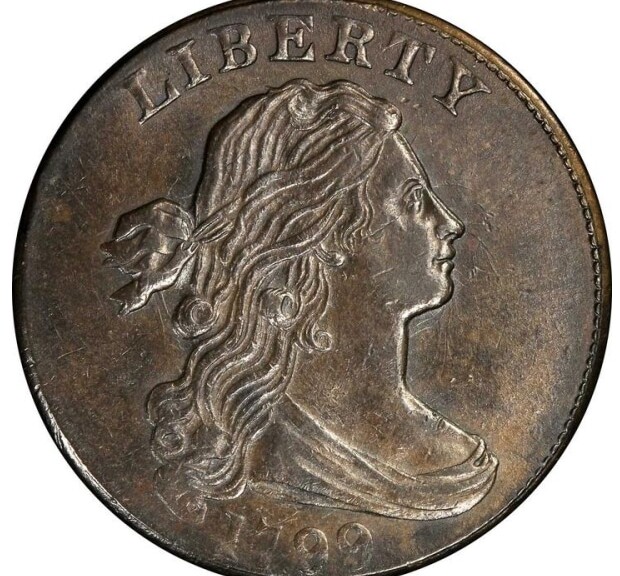
Coin Production at the US Mint: Questions and Answers
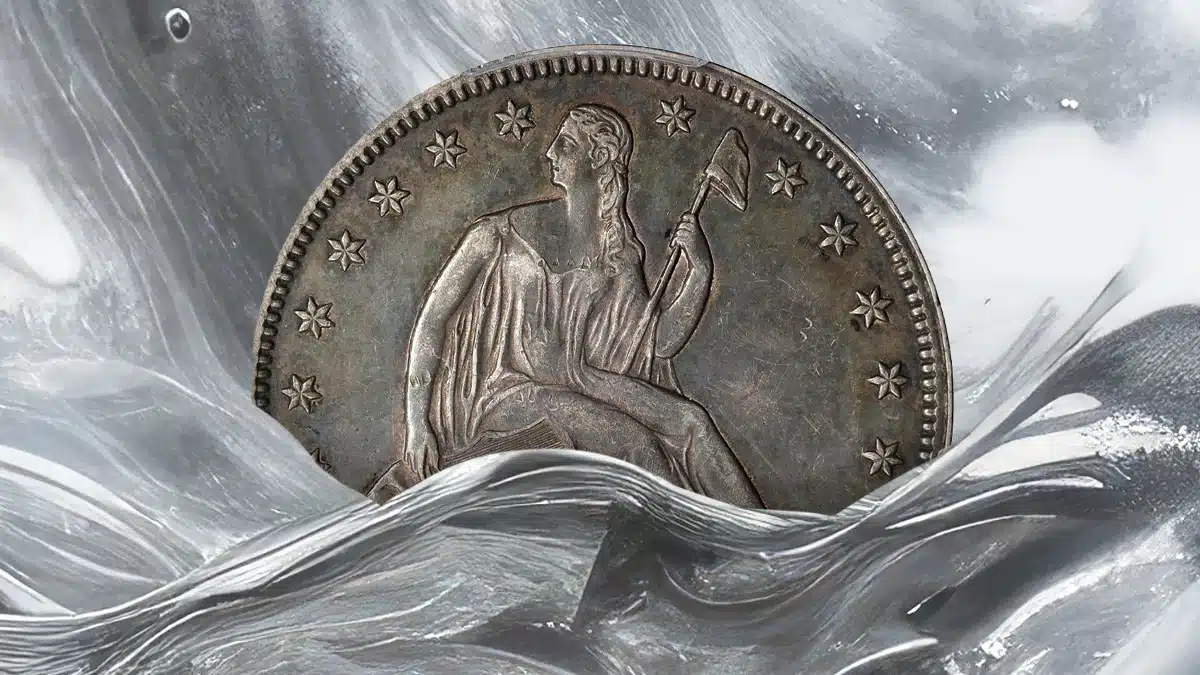
By Roger W. Burdette, special to CoinWeek …..
In the “old days” we’d call this a “mail bag column”. But now that everything’s electronic mail, is this an “inbox column”?
Anyway, my articles for CoinWeek have generated quite a few comments and questions from collectors about coin production at the United States Mint. Here is a selection I recently received followed by brief answers. For more extensive answers, you’ll find details and citations for original documents in my books and articles. You might begin with From Mine to Mint (2013), which deals with Mint operations, processes, equipment and machinery. If you want a list of my publications, send an email to CoinWeek and I’ll get one to you.
Having said that, let’s get down to it.
What Determines Mintage Size?
Who or what determines the mintage size? Time, bullion on hand, a superintendent’s orders for 3,844,000 coins one year and 1,766,000 the next?
First, the Treasury Department and the Mint operated on the Federal Government’s fiscal year, so that is how all the officers looked at coinage. That meant that a calendar year, as required for dating coins, was an exception to all normal accounting. This is the main reason for inconsistency in coin production from one calendar year to another: the fiscal year was more important.
There were several ways used to determine how many coins were needed. For copper coins made from 1793 through 1857, demand from large cities and regions filtered its way through the largest banks and the United States Treasurer to the U.S. Mint at Philadelphia. The Mint, in turn, ordered planchets from suppliers, mainly Boulton and then Crocker Bros. Early coppers, and the later base metal minor coins, were also very profitable for the Treasury.

Gold and silver coins were made to the demand of depositors rather than for Government account. Production was erratic and depended on banks and deposits from specie brokers and the denominations of coin they requested (the only way the Mint or the Treasury could make certain denominations was by persuading large depositors to request them – such as quarters or dimes). This process was also affected by the delay between the deposit of specie and the Mint’s delivery of coins made from that deposit. Half dollars were popular with large depositors because it took less time to deliver $100,000 in halves than $100,000 in, say, half dimes.
After the Act of 1873 went into effect, the Government bought gold and silver for coinage on its account. Thereafter, coin production was more closely related to commercial demand and was commonly determined by the Treasurer of the U.S., the Mint Director, the Comptroller of Currency, and informal conversations with bankers and Assistant Treasurers in various regions. As before, the fiscal calendar was dominant. Congress also got into the act by ordering certain production quotas, such as for Morgan dollars made from required bullion purchases.
Where’s Your Evidence for Excess Coin Production?
Do you have evidence that more coins were minted than asked for by the superintendent?
Before the law changed in 1873, the Mint delivered as many coins as the owner’s bullion would make. After the change, coin production was always requested in dollar amounts, such as “Make $1,000,000 in double eagles.”
But gold and silver were always handled internally in Troy ounces and grains. That meant calculations had to be made by the Melter and Refiner (M&R) and Coiner to convert bullion into coin while allowing for normal wastage and defective pieces. The Coiner would eventually deliver to the Superintendent the required $1,000,000 in $20 gold double eagles.
Was Melting Common for All Coins?
We certainly know there was considerable melting of classic commemoratives. Was this common for all coins?
Well… not quite. The commemoratives were special coins, with legislation specifying coin production limits and allowing for the melting of unsold pieces. This was not the case for circulating coinage.
Production coinage was subject to multiple tests for weight and purity during manufacture on up to delivery. Even after delivery, test pieces–called “Special Assay Pieces”–were examined by the assayer at Mint headquarters in Washington, D.C. (or by a nearby mint such as Carson City testing coins from San Francisco). This was supposed to be completed before the coins were released by a mint. If a Special Assay coin was too heavy, too light, or out of tolerance for purity, then the whole delivery was tested and occasionally condemned – meaning all of that delivery was melted and recoined.
Sometimes this happened quickly, but other times it took a year or more to recoin – there are some interesting examples of this from the Carson mint.
And What About Half Dollars?
How about regular circulation halves or other denominations? Were they also melted?
In only one clearly documented instance were normal half dollars deliberately melted for recoinage into other denominations. This involved an excess of 1877 half dollars that were sitting in a vault. In 1886, there was a very high demand for dimes but no bullion available, so the Treasurer of the U.S. ordered the 1877 halves recoined.

There were also instances where Congress made changes to our coin weights or precious metal content, and older coins were classified as “obsolete” or “uncurrent” and melted. The metal was used to produce new coins.
Were Planchets and Blanks Standardized?
Was there a standard blank or planchet sheet size? How many planchets can be cut from a standard sheet if they exist?
Except for early coppers, where blanks were cut from rolled sheets of metal, blanks were cut from long strips. The M&R was supplied with iron molds of different widths and thickness. Each size was determined by the dimensions of the coins that would be produced. Gold or silver was poured into these depending on the coin denomination that was to be made. The cooled metal was in the form of an ingot usually about 12-1/2 inches long (an ingot for making standard dollars was 12-1/2 inches long, 1-1/2 inches wide, and 7/16th inch thick. An ingot for quarters was 12-1/2 inches long, 1-1/16th inch wide and 3/16th inch thick).
Here’s a table of ingot sizes for the four primary gold denominations:

Ingots were run through compression rollers multiple times to reduce thickness and produce long thin strips from which blanks were cut. The number of blanks made from each strip depended on denomination and whether blanks were cut singly or in pairs.
How Are Coins Counted?
How are coins counted? Are they counted by weight?
All Mint facilities used manually operated counting boards, patented in the 1840s, until about the 1920s. These were made of wood with metal dividers and could hold up to 250 dollar coins at one time. Other board sizes accommodated various denominations. They were preferred to mechanical counters because they caused little damage to coins, were easy to use and rarely broke down (Mint employes worked hard to produce the best looking coins they could, and Mint Officers actively supported this – at least until the 1920s, when quality deteriorated under Mint Director Robert Grant).
Gold coins were put in bags of $5,000 value but each bag also had a weight tolerance of plus or minus nine grains. Silver and minor coins did not have this bulk tolerance; however, samples were frequently taken and compared to legal tolerance. Twenty-first-century U.S. coins for delivery are not counted; instead, they are estimated by bulk weight.
Let’s pause for now. We can do this again if there’s enough interest. You can send your Q&A comments to me down below.
* * *
The post Coin Production at the US Mint: Questions and Answers appeared first on CoinWeek: Rare Coin, Currency, and Bullion News for Collectors.

1901 Pan-American Exposition Medals From the U.S. Mint

By Vic Bozarth for PCGS ……
This entry in my series of articles about the World’s Fair expositions held between 1876 and 1926 details the medals and tokens of the 1901 Pan-American Exposition, which was held in Buffalo, New York. While there are only three different Pan-American Medals or So-Called Dollars from the Expo, the tragedy that occurred there mandates its inclusion in any survey of the most important fairs.
Triumph and Tragedy at the Buffalo Expo
The Expo was held from May 1 to November 2, 1901, and drew more than eight million attendees. There were at least 5,300,000 people who paid the 50-cent admission price. Subscriptions of both stock and capital bonds totaling $5,000,000 USD sold out very quickly, and an additional $800,000 was raised between state and federal grants.
Ultimately, the success or failure of these expositions was due to the rail service available for potential attendees. The Chicago and North-Western Railway advertised “through” train service to multiple major cities. Buffalo had won out as the host city versus Niagara because of the rail services they had available.
On the grounds themselves, the miniature railway built and operated by the manufacturer McGarigle Brothers was a big hit. For 10 cents, attendees could ride the train, its nine-foot engine pulling small gondola cars with double seats over a 15-inch track accessible via six locations on the fairgrounds. These miniature railways manufactured by the McGarigle Brothers were quite popular at other fairs as well.
The significance of the Buffalo Pan-American Exposition in U.S. history is pivotal. Electricity lit the fairgrounds, which was still a novel concept at time.
Among the other headlines was an appearance on September 5, 1901, by President William McKinley, who spoke these words in an address at the exposition:
“Expositions are the timekeepers of progress. They record the world’s advancement. They stimulate the energy, enterprise, and intellect of the people; and quicken human genius. They go into the home. They broaden and brighten the daily life of the people. They open mighty storehouses of information to the student.”
Probably no president before or after McKinley did more to promote international expositions and world’s fairs. But his connection to the fair is known for much more tragic reasons. While greeting citizens at the exposition on September 6, President McKinley was shot in what can only be regarded as an act of terrorism. McKinley succumbed to his injuries nine days later and his young vice president, Theodore Roosevelt, succeeded him.
In a pamphlet published for the Louisiana Purchase Exposition of 1904, President McKinley’s “Last Public Address and Proclamation” from the Buffalo Pan-American Exposition was included. The quote cited above from McKinley’s 30-minute address at the 1901 expo is but a snippet of his amazingly prescient speech.
The assassination of McKinley was a tragedy for our nation, and the events that unfolded in the coming days would signal a transition for our nation culturally. While McKinley was a steadfast, conservative product of the 19th century, Roosevelt proved revolutionary in many ways, most notably for numismatists as the catalyst for a redesign of our U.S. coinage. Events like this “connect the dots” in the inevitable march of history.
Pan-American Expo Medals and Tokens
The United States Treasury Department exhibit at the exposition was housed in the U.S. government buildings, situated near where visitors entered from the esplanade. Within the Treasury Department exhibit, the United States Mint struck the official medals for the exposition.
The U.S. Mint official medal was struck on the grounds in silver, copper, and brass. This medal, designed by G.T. Brewster, depicts an Native American figure astride a soaring eagle on the obverse, with a relief map of the Western Hemisphere and the logo from the fair on the reverse.
These official medals are designated as follows:
- PCGS #642671, HK-287 – Silver (Rarity-6)
- PCGS #642672, HK-288 – Copper BN (R-7)
- PCGS #642673 – Copper RB
- PCGS #642674 – Copper RD
- PCGS #642675, HK-289 – Brass (R-8)
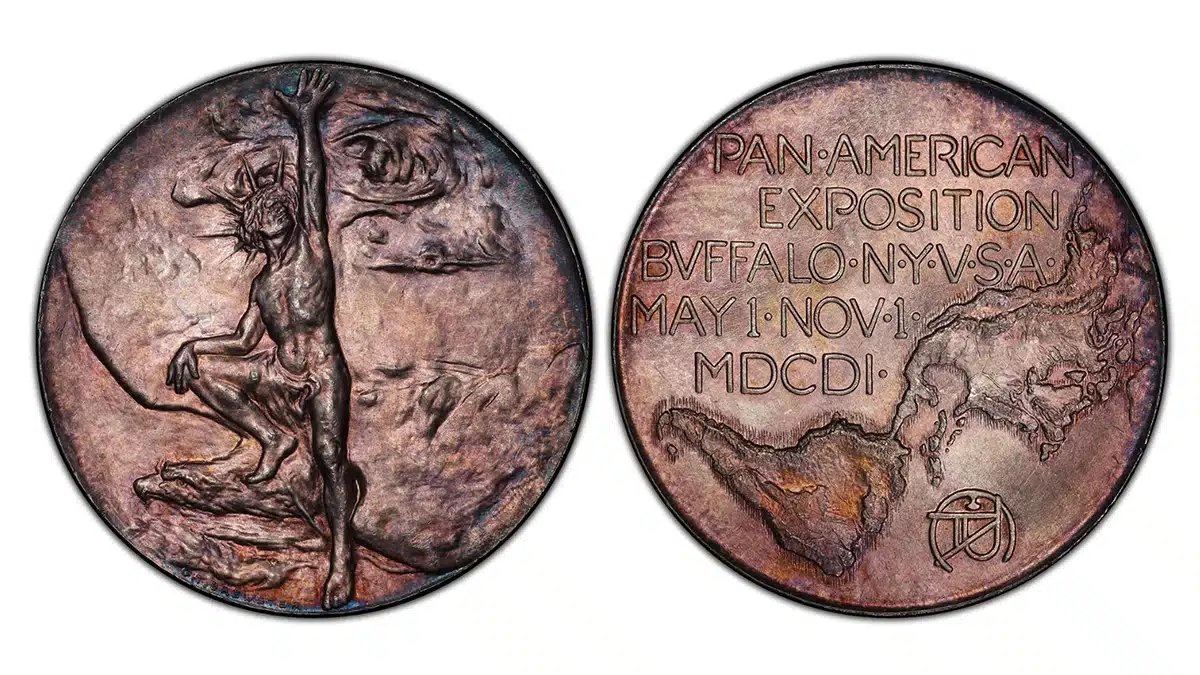
Other So-Called Dollars issued for the Pan American Expo include the President McKinley Assassination Dollar and the Buffalo Dollar. These medals are designated as:
- PCGS #642676, HK-290 – McKinley Brass (R-6)
- PCGS #642677, HK-290a – Aluminum (R-6)
- PCGS #642678, HK-291 – Buffalo Brass (R-5)

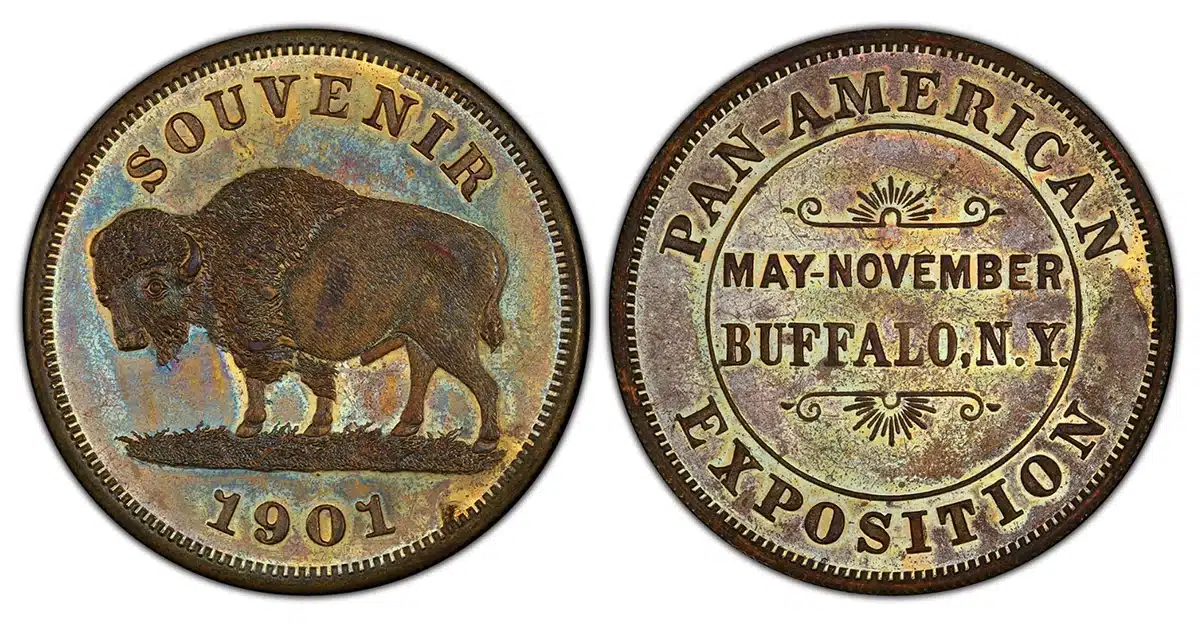
In addition to the Mint and Treasury Department installation, there was another highly significant numismatic display at the Pan-American Expo. Separate from the Mint exhibit, in a small dedicated building bordering the midway, was an exhibit housing what was dubbed the “First Coin Machine Used By the U.S. Mint” serving as a souvenir concession. This steam press, which was used at the Philadelphia Mint from 1836 through 1874, was earlier displayed at the Centennial and then the Columbian expositions in 1876 and 1893, respectively.
This steam-operated press struck souvenir medals in two designs, including one serving as a Pan-American memento and the other featuring the Lord’s Prayer. They were offered from 25 cents to $2.50 for gold-plated and 14K compositions. The Lord’s Prayer design was offered in sterling silver for 35 cents, in addition to the gold issues.
Lord’s Prayer Medal
- Gold-plated
- Sterling Silver
- 14K gold
Pan-American Medal
- Gold-plated
- 14K gold
Each of these souvenir coins included a card describing the press itself and the two souvenir token designs available from Historic Coin Press Co. of Buffalo, NY.
After the Expo
As with most fairs, the majority of the buildings and grounds of the Buffalo Pan-American Expo were cleared afterward. The only major building to survive from the fair is the New York State Building. But in a case of pure happenstance, the souvenir Pan-Am Coin Concession Hut survived the teardown. William Simon of the Simon Brewing family bought the hut and moved it to his property in Gardenville, New York, shortly after the fair.
The hut, used as a gazebo and goat shed, was rediscovered in 1999, although the story of the hut’s history was known to the family. The Werner family, current owners of the Gardenville property, contacted the Buffalo History Museum in 1999, inquiring if they would be interested in having it. Today, the shed has been restored to its original glory and is housed at the Forest Avenue Resource Center of the Buffalo Museum. Incidentally, the original fairgrounds has been a residential neighborhood for more than a century.

* * *
For more information from PCGS, the sponsor of this article, click on the image below.
* * *
The post 1901 Pan-American Exposition Medals From the U.S. Mint appeared first on CoinWeek: Rare Coin, Currency, and Bullion News for Collectors.

Greatest Generation Commemorative Coin Designs Revealed
By Hubert Walker for CoinWeek ….
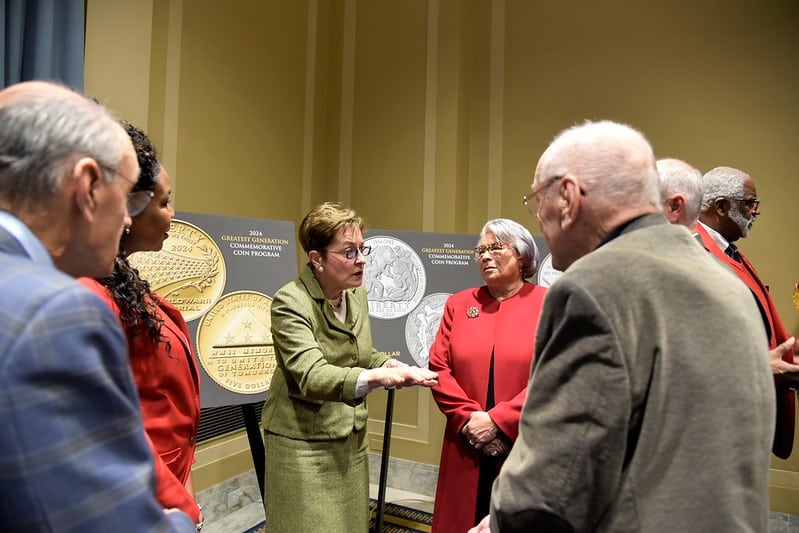
Designs for the 2024 Greatest Generation Commemorative Coin Program were revealed on Monday, December 4, at a Capitol Hill event led by U.S. Representative Marcy Kaptur (D-OH9). Congressman Kaptur introduced the bill (H.R. 1057) authorizing the commemoratives on February 15, 2021, and President Joe Biden signed it into law (Public Law 117-162 – PDF Link) on August 3, 2022.
The coins are currently scheduled to go on sale February 29, 2024.
The 2024 Greatest Generation Commemorative Coin Program is a standard modern commemorative program. It includes a $5 gold, a $1 silver, and a half dollar clad coin in Proof and Uncirculated finishes, and like most recent programs, respective maximum mintage limits of 50,000, 400,000, and 750,000 are determined by the authorizing legislation. Designs for each coin are mandated to simply be “emblematic” of the National World War II Memorial in Washington, D.C., as well as the soldiers and civilians who served and often gave their lives in the war. Representative Kaptur was also responsible for introducing the first legislation for such a memorial back in 1987.
Ground was broken for the National World War II Memorial between the Reflecting Pool and the Washington Monument on November 11, 2000; it opened to the public on April 29, 2004.
The term “Greatest Generation”, popularized by NBC television news anchor Tom Brokaw in his 1998 book of the same name, refers to the generation of Americans born between 1901 and 1927 who actively participated in the war.
Designs of the 2024 Greatest Generation Commemorative Coins
$5 Gold
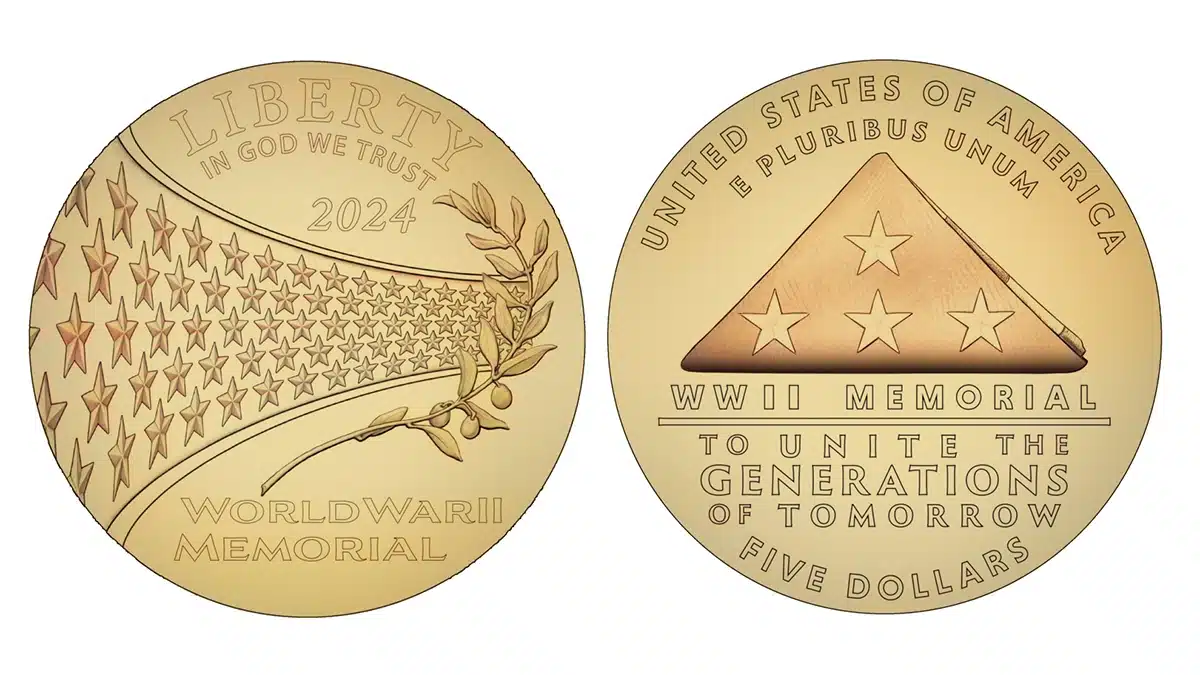
The obverse of the $5 gold coin was designed by United States Mint Artistic Infusion Program (AIP) artist and former Citizens Coinage Advisory Committee (CCAC) member Heidi Wastweet and sculpted by Mint Medallic Artist Eric David Custer. It depicts the Wall of Stars at the World War II Memorial, on which each star represents 100 Americans who gave their life for the war effort. The olive branch on the right side symbolizes the subsequent peace for which these sacrifices were made.
The reverse was designed by AIP artist Benjamin Sowards and sculpted by U.S. Mint Chief Engraver Joseph Menna. It features a folded flag of the kind traditionally presented to the family members of fallen servicemen.
$1 Silver
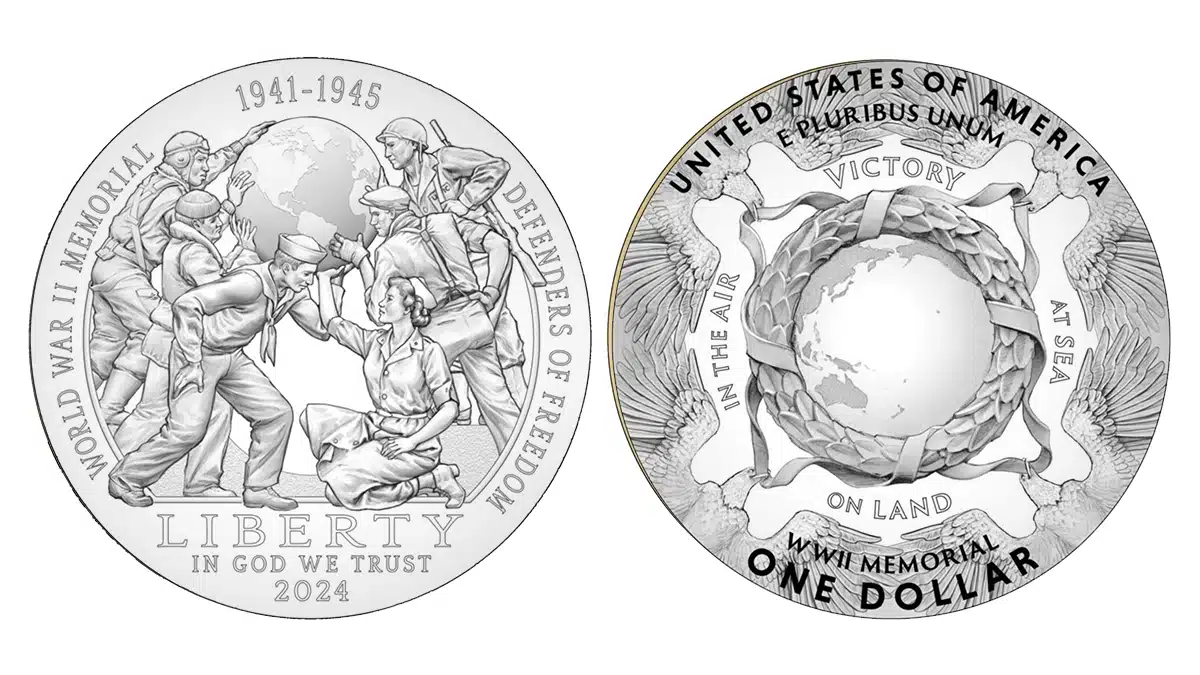
The obverse of the silver dollar was designed by AIP artist Beth Zaiken and sculpted by Medallic Artist Phebe Hemphill. Six figures representing the U.S. Army, Navy, Coast Guard, Marines, Army Air Force, and Merchant Marines lifting a globe centered on the Atlantic Ocean.
The reverse was designed by Ben Sowards and sculpted by Medallic Artist Renata Gordon. It recreates in miniature a sculptural canopy that can be found inside the Victory Pavilion of the National World War II Memorial. Four eagles hold a laurel wreath, inside of which is a globe showing the Pacific Ocean, representing the Pacific Theater of operations.
Clad Half Dollar
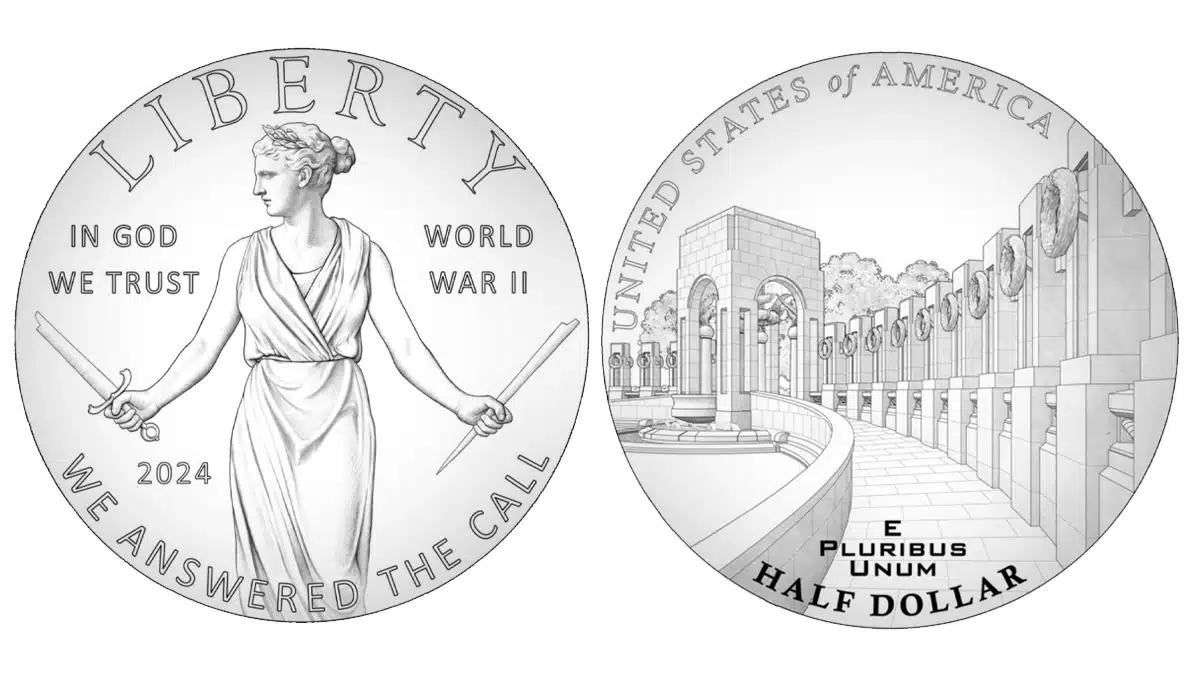
The obverse of the clad half dollar was designed by AIP artist Elana Hagler and sculpted by Medallic Artist Craig A. Campbell. It is based on the World War II Victory Medal designed by sculptor Thomas H. Jones, who also designed the Tomb of the Unknown Soldier at the National Cemetery in Arlington, Virginia. On the coin, Liberty (or perhaps “Liberation”, as on the medal) is seen from the knees up holding two halves of a broken sword, facing the hilt end on her right. Interestingly, the Memorial itself features a depiction of the complete face of the medal in an engraving on the Memorial’s floor.
The artwork on the reverse was designed by AIP artist Matt Swaim and sculpted by Medallic Artist John P. McGraw. It presents a view of the walkway to one of the Memorial’s two “towers”.
Surcharges
The surcharges added to the price of each coin is typical for contemporary commemorative coin legislation: $35 for the gold coin, $10 for the silver coin, and $5 for the clad half dollar. As authorized by Public Law 117-162, these surcharges will go to the Friends of the National WWII Memorial, the 501(c)(3) organization that produces educational materials, displays, and events centered around the Memorial.
Other 2024 Commemoratives
The Greatest Generation Commemmorative Coin Program is the second of two commemorative programs set for issue in 2024. The U.S. Mint recently held a first strike ceremony for the Proof version of the 2024 Harriet Tubman Bicentennial commemorative silver dollar not quite a week earlier on November 28. Sales for the Harriet Tubman commemoratives open on January 4, 2024.
* * *
Sources on the 2024 Greatest Generation Coin Design Event
https://twitter.com/usmint/status/1732119462306865624
https://www.usmint.gov/learn/coin-and-medal-programs/commemorative-coins/greatest-generation
https://catalog.usmint.gov/greatest-generation-commemorative-coin/
https://www.govtrack.us/congress/members/marcy_kaptur/400211
https://www.govinfo.gov/content/pkg/PLAW-117publ162/pdf/PLAW-117publ162.pdf
https://catalog.usmint.gov/product-schedule/2024/
https://www.wwiimemorialfriends.org/
* * *
The post Greatest Generation Commemorative Coin Designs Revealed appeared first on CoinWeek: Rare Coin, Currency, and Bullion News for Collectors.
Famous Sacagawea Dollar Mule Error Offered by GreatCollections

In numismatics, a “mule” is a coin struck with the obverse die of one denomination and the reverse die of another. And no mule is more famous than the (2000)-P Sacagawea Dollar/Washington Quarter mule offered in GreatCollections’ auction on Sunday, January 21, 2024. It was ranked #1 in David Camire, Nicholas Brown, and Fred Weinberg’s book The 100 Greatest U.S. Error Coins (Whitman, 2010), where it even served as the centerpiece on the cover.
The mule features the obverse of a Washington Quarter of the time and the reverse of a Sacagawea Dollar coin. Because both of the sides involved in the creation of the coin include their respective denominations, it has a total face value of $1.25.
The error was first discovered by Frank Wallis in a roll of uncirculated dollar coins he got from a bank in Arkansas in May 2000, the year of the error coin’s issue. Confirmed as authentic by the United States Mint, it was the first such mule that the Mint is known to have (inadvertently) released into circulation. Tied for finest at PCGS, the grading company’s estimated value for the piece is $125,000 USD.
In the 20-plus years since the Sacagawea Dollar/Washington Quarter mule’s discovery, about two dozen examples have been found in the wild. Of this number, three different dies are known to collectors; the discovery coin features Die 1, with the main diagnostic being the space between F in the word OF and the edge of coin on the Sacagawea side.
Graded MS-66 by Professional Coin Grading Service (PCGS), the company reports no public auction listings for the coin since it has been in this holder.
“For one of the most famous errors to ever leave the U.S. Mint, only a few are available for collectors to own, as all others have been purchased over the years by a single collector. It’s a striking error and understandable why it’s been atop modern error lists for over 20 years since it was first discovered,” said GreatCollections President Ian Russell.
At the time of writing, bidding has barely started on the Sacagawea Dollar/Washington Quarter mule discovery piece, but it won’t stay that way forever. This is an incredible example of a modern U.S. Mint error coin. Check out the high-quality photos and place your bid at www.GreatCollections.com.
* * *
To search through GreatCollection’s archive of over 600,000 certified coins the company has sold over the past eight years, please visit the GreatCollections Auction Archives.
* * *
The post Famous Sacagawea Dollar Mule Error Offered by GreatCollections appeared first on CoinWeek: Rare Coin, Currency, and Bullion News for Collectors.
Rare U.S. Mint Mule Dollar/Quarter Error in GreatCollections Auction
The Sacagawea Mule – one of the most famous modern coin errors – is set to be auctioned by GreatCollections on Sunday, January 21, 2024
How the $20 Bill Has Changed Since 1976
CoinWeek Streaming News is brought to you by NGC. For information about NGC’s current grading specials and services, as well as to look up certs, pricing information, and current populations, visit www.ngccoin.com.
* * *
CoinWeek editor Charles Morgan takes a survey of all of the different $20 bills that have been issued since roughly 1976. Quite a few signature combinations and design changes have taken place over the period. You think American currency doesn’t change much? You’re about to be proven wrong, my friend!
$20 Bill from the Series 1974
We start with the Series 1974 $20 note featuring the signature of Francine Irving Neff and William Edward Simon. Neff was the 35th Treasurer of the United States, serving from June 21, 1974, to January 19, 1977.
Neff was appointed by President Nixon and served under both Nixon and President Ford.
As Treasurer, Neff oversaw the Bicentennial program and saw the reorganization of her position, which was to report to the Undersecretary for Monetary Affairs.
Neff was a resident of New Mexico and passed away in 2010.
Simon was the nation’s 63rd Secretary of the Treasury. Appointed in 1974 by Richard Nixon, he served from May 9, 1974, until January 20, 1977.
A laissez-faire capitalist, Simon was against government bailouts for companies, thinking that competition in the free market was what created wealth and innovation. After his government service, he worked tirelessly for the U.S. Olympic Committee and served on the boards of various sports organizations, including the National Basketball Hall of Fame. Simon died in 2000.
The note we feature was issued for Boston and is one of 56,960,000 released.
There are serial star note issues with printings under a million. 2071-F Atlanta has a release of 480,000, while Dallas Star notes have a slightly higher emission- 608,000 but are somewhat more scarce.
A typical choice uncirculated note for this issue trades for $60 or more.
$20 Bill from the Series 1977
Here is a cool offset print error. You can see the image from the reverse has been printed by mistake on the note’s front. This is a scarce error type but there are quite a few of these that turn up in 1977.
This example was printed for the Federal Reserve Branch of Cleveland. A common bank for the series. The note features the signatures of Azie Taylor Morton and W. Michael Blumenthal.
Morton served as Treasurer from September 12, 1977, to January 20, 1981.
She is, to date, the only African American to hold the position.
Born in Dale, Texas, she attended school in the segregated south and graduated from high school at the top of her class at age 16. In 1952, she matriculated to the Houston-Tillotson College and graduated cum laude but was denied admission to the University of Texas due to segregationist policies.
Morton took a job at a school for delinquent girls and became involved in Democratic politics. She was nominated to the position of Treasurer by President Jimmy Carter.
A side note, in 2018, Austin’s Robert E. Lee Rd was renamed Azie Morton Road.
Blumenthal was born in Germany to a Jewish family who narrowly escaped the nazi regime. Upon leaving Europe, his family traveled east and were forced to live in a ghetto in Japanese-occupied Shanghai. He immigrated to the US with his family in 1947.
Blumenthal became active in democratic politics starting in 1961 and was considered for a senior role in the State Department during the Carter administration but ultimately took the position at Treasury. In 1979 he traveled to China as the Treasury Secretary and gave a speech in Chinese. His tenure ended in 1979 when President Carter turned over his cabinet following the US economic and energy crisis.
There are quite a few issues in the series of 1977 worth seeking out. The key to the series is the Minneapolis Star note, with a printing of just 512,000 pieces. Error aside, this Cleveland issue is one of the more common releases, with 189,440,000. Of course, expect many times more than the $50-$60 that a properly printed Cleveland sells for this dramatic error.
$20 Bill from the Series 1981
There are two series for 1981.
The first one features the signatures of Angela Marie “Bay” Buchanan and Donald Thomas Regan.
G. William Miller actually preceded Secretary Don Regan, but there are no $20, $50, or $100 notes bearing Miller’s signature. There are, however, $1, $5, and $10 notes with Miller’s John Hancock.
Donald Regan served as Treasury Secretary from 1981 to 1985, and later was the White House chief of Staff during the majority of President Reagan’s second term. Regan has an incredible biography. He studied at Harvard and earned a bachelor’s degree before leaving Harvard Law School to join the US Marine Corps to fight in World War II.
After the war, Regan found success in banking, serving as the Chairman and CEO of Merrill Lynch from 1971 to 1980.
Bay Buchanan is the sister of former Republican official and presidential candidate Pat Buchanan.
Bay was heavily involved in Republican politics throughout her life and was especially close to California Governor Ronald Reagan as he sought the Republican presidential nomination in 1976 and again in 1980. When she took on the position of Treasurer of the United States on March 20, 1981, she was the youngest person ever to hold the position, at the age of 32. Buchanan served until July 5, 1983.
In our video, we feature a Boston note. Boston saw a distribution of 191,360,000 pieces. The key to this issue is the Minneapolis Star note with an emission of 256,000. That note trades for over $200. Also, the Philadelphia Star note, with its emission of 384,000, sells for about $200.
A Second Series of 1981 note features the signature combination of Ortega & Regan. These were prepared after Treasurer Katherine Ortega assumed the role in September 1983.
None of our references point to a date of emission for the Series 1981-A notes.
Ortega served from September 26, 1983, to July 1, 1989, under Presidents Reagan and George H.W. Bush.
Like Francine Neff, Ortega was a New Mexico resident. Ortega was born to Spanish-speaking parents who trace their family lineage to the New Mexican territory before it became a state. Ortega worked in the banking industry, starting as a teller and worked her way up to the position of Vice President of the Pan American National Bank. Later she served as the president of the Santa Ana State Bank.
The note we feature was also issued by the Boston, Massachusetts bank and is indicative of the type. None of the Ortega / Regan notes are particularly scarce.
There was a Series 1985, but unfortunately we don’t have an example to show you. The star notes from this issue are worth roughly twice the amount of the regular issues. They feature the Ortega and James Baker signature combination.
$20 Bill from the Series 1988-A
There were no Series of 1988 $20 bills issued, instead we get Series of 1988-A with the combination of Catalina Vasquez Villapando and Nicholas F. Brady.
Villapando served as the 39th Treasurer of the United States, serving from December 11, 1989, to January 20, 1993.
She was appointed to the position by President George W. Bush.
Villapando was active in Texas Republican politics since the late 1970s and was a supporter of George H. W. Bush’s 1980 presidential bid. At the time of her service, she was the highest-ranking Latina in the federal government.
Unfortunately, Villapando’s tenure as Treasurer was marred by claims of illegal and unethical conduct concerning her personal use of substantial funds and benefits from a Georgia-based telecommunications company. She plead guilty to multiple crimes including tax evasion and was sentenced to four months in prison, three years of supervised release, 200 hours of community service, and a $150 special assessment for tax evasion.
Villalponda retired to Maryland.
Brady was born in Manhattan in 1930 but grew up in Far Hills, New Jersey.
After getting an MBA from Harvard, Brady went into the banking industry.
He was appointed to a Senate position by Republican Governor Thomas Kean, filling a vacancy caused by the resignation of Harrison Williams, Jr., Brady served for eight months and did not seek election.
Brady’s tenure at Treasury began in the final four months of the Reagan presidency and continued through the duration of the Bush administration.
This is an issue from the New York branch- the most heavily produced issue of the series with a total of 1,446,400,000 pieces. A couple of star notes to look for – none are particularly rare but are good to obtain examples: Philadelphia, Atlanta, Chicago, Kansas City, Dallas, and San Francisco.
$20 Bill from the Series 1990
For our video, we show a Series of 1990 star note from Cleveland. 3,200,000 were printed of this type. Boston star notes, Atlanta star notes, and St. Louis notes are worth a slight premium over regular issues.
$20 Bill from the Series 1993
This example has the Withrow / Bentsen signature combination and was printed in Washington, D.C. for the Boston Federal Reserve Bank. A robust 288,000,000 were printed making this a common issue for the series. For the lower print runs in this series you are looking for star notes from Boston, Atlanta, and Cleveland. Some notes this year were printed at the Fort Worth facility.
Mary Ellen Withrow was the 40th Treasurer of the United States, serving in the Clinton administration from March 1, 1994, to January 20, 2001.
Redesigns of notes were initiated under her tenure- seeing updates to all denominations except the $1. A native of Marion County, Ohio, Withrow also serves as Treasurer from the state of Ohio from 1892 until she was nominated for her role in the Clinton administration.
$20 Bill from the Series 1995
Moving on to the Series of 1995.
This note features the Signatures of Withrow and Rubin.
Robert Rubin was a career banker who served as the co-chairman of Goldman Sachs before getting the nomination. He was born in New York City and is the son of a wealthy Jewish family. Rubin was a prodigious student and active in the Boy Scouts, earning the coveted Eagle Scout rank. He graduated summa cum laude in economics from Harvard. He continued his post-graduate work at the London School of Economics and then later received a master’s from Yale.
Rubin was a key figure in Clinton’s economic policy team, serving as the first director of the National Economic Council for two years, before moving over to head Treasury.
Rubin’s term was consequential. Dealing with weak global financial markets, Rubin worked to secure loans for Mexico to help it navigate financial trouble and to stop the country from defaulting on its foreign obligations. He also worked with Fed Chairman Alan Greenspan to strengthen the International Monetary Fund (IMF).
This example is a star note from New York. 5,760,000 were made of this type. This is the last Series of this design type.
Two variations- The sample seen in our video, a Friedberg 2081 note, was printed in Washington, D.C. and covers New York, Philadelphia, Cleveland, and Richmond releases.
Friedberg 2082 notes were printed at the Western facility in Fort Worth, Texas, and covers Atlanta, Chicago, St. Louis, Minneapolis, Kansas City, Dallas, and San Francisco.
The Cleveland star notes are scarce, with 640,000 printed. But the rest of the issue is plentiful. Do expect to pay a premium of 50% to double face value for a choice uncirculated note.
$20 Bill from the Series 1996
The Series of 1996 saw a major design change for the $20 note.
A larger, younger portrait of Jackson is used. It is thematically similar to the previous portrait, with several modifications. The new $20 slightly offset this portrait, eliminated the scrollwork on the legend, minimized the spirograph motifs, removed the Federal Reserve Branch bank seal, among other refinements.
The reverse is also simpler in its layout, featuring the portico of the White House. A change of perspective. This note was issued for the New York branch. New York issued 896,000,000 notes. This note features the Withrow and Rubin signature combination. In choice uncirculated, this issue carries a small premium over face.
$20 Bill from the Series 1999
For the Series of 1999 note, we see Withrow and Summers signature combination. Larry Summers replaced Rubin on July 2, 1999, and served for the remainder of Clinton’s second term. Summers is the first baby boomer to serve as Treasury Secretary.
Born in New Haven, Connecticut, Summers was trained as an academic economist, taught at Harvard University, served as Chief Economist at the World Bank before taking a position as Under Secretary of the Treasury for International Affairs in the Clinton administration in 1993. This example has a radar serial number that was printed for the Cleveland branch.
$20 Bill from the Series 2001
This 2001 series was issued during the first year of the George W. Bush administration. This series features the signature of Rosario Marin and Paul H. O’Neill.
Marin was the 41st Treasurer of the United States, serving from August 16, 2001, to June 30.
Marin was the first Treasurer of the United States since William Clark in 1828 to be born in another country. Marin was born in Mexico City and immigrated to the United States at the age of 14 after her father was hired to work a factory job in California.
Marin gravitated towards Republican politics in her mid-20s and began a career in the banking industry, working for a regional California bank, first as a receptionist and later as the assistant vice president. For much of her professional life, Marin devoted much time and energy to advocate on behalf of the mentally disabled.
Paul O’Neill was 66 years old when he took the position of Secretary of the Treasury.
Born in St. Louis, Missouri, and spent years working for Alcoa and International Paper.
In the Bush administration, O’Neill was a fiscal conservative who often clashed with Bush and his other advisors. He opposed the war in Iraq, the second Bush tax cut, and navigated the country through the 2001 recession and the immediate financial fallout from the 9/11 attack.
$20 Bill from the Series 2004-A
Marin and Snow feature on the Series of 2004.
This is Series 2004-A with a different signature combination of Cabral and Snow.
This note features the large younger Jackson portrait. The frame has been removed. In addition, color-shifting ink is used in the numeral. A large blue eagle is depicted on the left, blue-colored printing appears on the right.
The note’s front and back features a blue and peach background color. Other security features, such as microsized printing was utilized to thwart counterfeiters.
Anna Escobedo Cabral served as the 42nd Treasurer of the United States, serving from January 19, 2005, to January 20, 2009. She was the highest-ranking Latina in the George W. Bush administration.
Cabral worked in the Justice Department in the 1990s and was part of the Senate Republican Conferences’ Task Force on Hispanic Affairs. Her appointment to the Treasurer position ended a year-and-a-half long vacancy after the departure of Rosario Marin. While Treasurer she pursued her JD at Georgetown University. John W. Snow served as Treasury Secretary from February 3, 2003, to June 28, 2006.
Snow served in the Nixon administration as the Deputy Undersecretary of Transportation and later served as the Administrator of the National Highway Traffic Safety Administration. After Carter’s election in 1977, Snow taught economics at the University of Virginia.
Snow’s tenure at Treasury was short and relatively uneventful. He was replaced by Hank Paulson.
The example shown in our video was printed for the Boston Branch location and is one of 134,400,000 issued. A scarce issue of this series is the Boston star Note – with an emission of 384,000 pieces.
$20 Bill from the Series 2006
Moving on to the Series 2006 $20, we have the Cabral / Paulson note.
Hank Paulson was born in 1946 and served as the 74th Treasury Secretary, serving from July 10, 2006 to the end of Bush’s second term.
His tenure as Treasury Secretary took place at one of the most consequential economic periods of modern American history. Paulson directed the federal response at the outset of the Great Recession of 2008/2009.
Before serving in the Bush administration, the Harvard-educated Paulson served as the CEO of Goldman Sachs. He now works to promote economic growth and environmental initiatives.
The note in our video was issued for the Richmond branch and is one 390,400,000 of the release. The San Francisco Star note is of particular interest for collectors, as it has a very low total of 128,000 pieces.
$20 Bill from the Series 2009
The Series 2009 features two new signatures: Rosie Rios and Timothy Geitner.
Rios was born in San Jose, California, and studied at Harvard University and Berkeley.
Rios was very friendly to the numismatic community and we had the opportunity to meet her once.
She now serves as a consultant for a private firm specializing in real estate development and modernizing infrastructure to comply with California earthquake regulations.
Timothy Geithner led the New York Fed before getting the job as Treasury Secretary.
Geitner was 48 at the time of his appointment.
Geithner received some strong scrutiny for the Treasury’s policies towards Wall Street in the aftermath of the Great Recession and the Financial Crisis that was born out of Wall Street greed, bad policies, and poor government oversight.
The AIG bailout proved to be a particular sticking point, once the company paid its senior employees bonuses with bailout money.
This note, issued by the Philadelphia bank, features a repeater serial number of 68686868. It is one of 345,600,000 notes issued for that bank. If you can, try to find a Chicago star note for this issue. It has a low emission of 320,000 pieces.
$20 Bill from the Series 2013
The Series of 2013 has the Rios / Lew signature pairing. This release was intended to serve as the final Series featuring the likeness of Andrew Jackson. Treasury Secretary Jack Lew ordered the replacement of Jackson after a public petition garnered national attention. The Women on 20s campaign allowed the public to vote on a replacement figure for Jackson, citing the seventh President’s horrific record on race- he was a slaver who owed his entire fortune by forcing black men, women, and children to work tirelessly on his cotton plantation and as President, he disobeyed a United States Supreme Court decision and compelled the removal of Native Americans from lands that were discovered to contain gold deposits sufficient enough to warrant the opening of the branch mints of Charlotte and Dahlonega. Lew, following the lead of Women on 20s, chose to place abolitionist and civil rights advocate Harriet Tubman on the note.
With the election of President Donald J. Trump, the Treasury rescinded Lew’s directive and decided to continue using the Jackson design.
We’ll have more on that subject in a forthcoming episode of the CoinWeek Podcast, where we reveal new information about the shelved/delayed redesign. For more information about the timeline of the events in the Jackson/Tubman design change drama, click here.
Another funny story about Lew- he had this nonsensical looping signature that he had to reconfigure in order to sign the notes. His signature looked like a well-practiced series of loops drawn by somebody who had never learned the alphabet.
Lew was active in Democratic politics for years, his father was a rare book dealer. In our video, we show another example with a repeater serial number.
$20 Bill from the Series 2017
With the Series of 2017 note we are now up to date.
The 2017 issue features the signature combination of Carranza and Mnuchin.
Jovita Caranza studied at the University of Miami and served as Treasurer from June 19, 2017 to January 14, 2020. She is now the Administrator of the Small Business Administration (SBA). Kind of an important job at the moment.
Carranza worked in a senior position at UPS before taking a job in the current administration.
Steve Mnuchin is a billionaire investment banker who worked at Goldman Sachs as its Chief Information Officer before taking a job in the Trump administration.
Trivia: he visited Fort Knox in time to view the solar eclipse in 2017. I assume the gold was all in order. Also curiously, he was an executive producer of the Lego Batman movie (2017). And remember that Suicide Squad (2016) movie that sucked? He was executive producer of that too.
* * *
The reviews are in! Charles Morgan and Hubert Walker’s 100 Greatest Modern World Coins has gotten five-star reviews on Amazon and Lou Golino and David T. Alexander both gave the book their highest recommendations.
The post How the $20 Bill Has Changed Since 1976 appeared first on CoinWeek: Rare Coin, Currency, and Bullion News for Collectors.
Gold and Silver’s Milestone Highs Followed by Weekly Losses
Most precious metals declined on Friday, adding to their weekly losses
Royal Mint Mercanti Coin Features British Lion, American Eagle
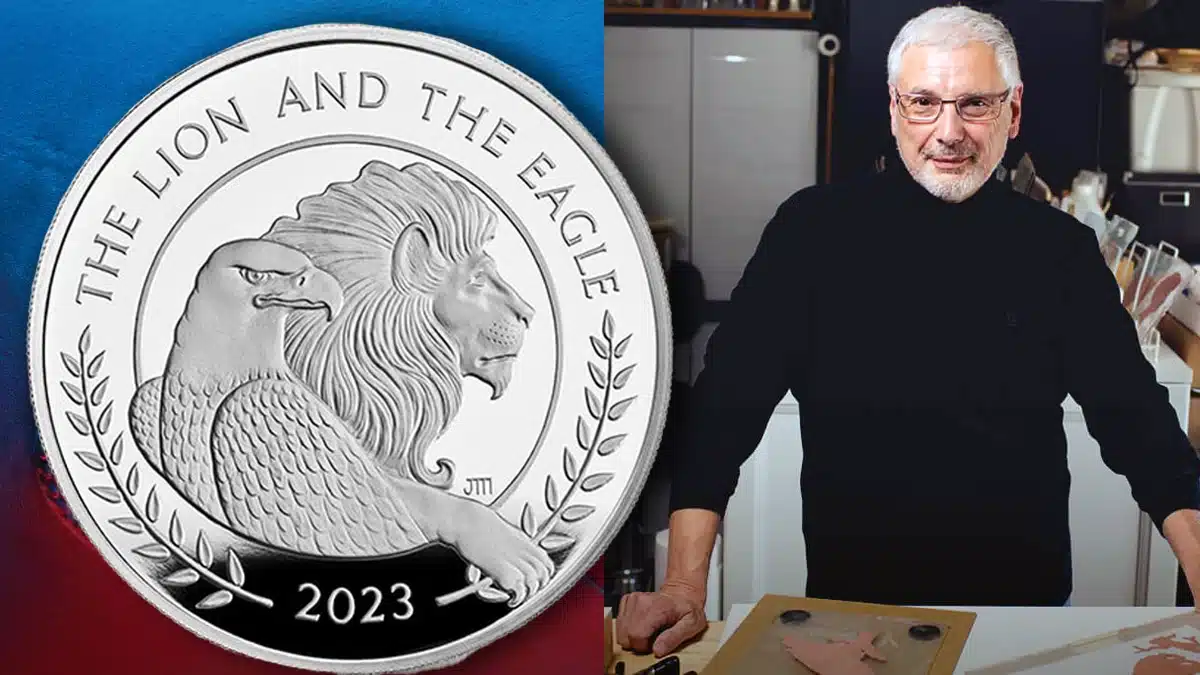
The Royal Mint has released a commemorative coin with a design by former United States Mint Chief Engraver John M. Mercanti that features a British lion alongside an American eagle. As the designer for the Type 1 American Eagle bullion coin reverse, Mercanti has a lot of experience creating and engraving eagles on coins. Both animals are longtime numismatic symbols of their respective countries, and this coin represents the special relationship that has historically existed between our nations.
Private mint GovMint.com has paternered with The Royal Mint to produce this coin. In a Royal Mint press release, GovMint Chief Commercial Officer Ted Smetana said that the company is “thrilled and honored to partner with the Royal Mint on the creation and development of this program and also be the exclusive distributor for The Lion and The Eagle Program.”
In that same release, The Royal Mint’s Director of Commemorative Coin, Rebecca Morgan, said:
“We are delighted to unveil the commemorative coin featuring the British Lion and American Eagle, two icons of coin design which are recognised worldwide. It has been a pleasure to work with John Mercanti, one of the most prolific coin designers in United States Mint history, with over 100 coin designs to his name. John’s reverse design skilfully brings the two icons together in one harmonious composition.”
The lion is a time-honored heraldic motif in Europe but its use as a symbol of royal power goes back into deep antiquity. Similarly, while the eagle was chosen as a symbol of the United States (much to Founding Father Ben Franklin’s chagrin) in the 18th century, as a symbol it, too, reaches back into antiquity, even serbing as the avian symbol of the Olympian god, Zeus. Indeed, the depiction of eagles on U.S. coinage was originally based on Renaissance art that was inspired by ancient Greek and Roman art, including that found on coins.
The Royal Mint has issued the new Mercanti coin in one-kilo, five-ounce, two-ounce, and one ounce gold and silver Proof editions, for a total of eight different product options.
More information on The Royal Mint Lion and Eagle commemorative coin by John Mercanti is available on The Royal Mint’s website.
* * *
The post Royal Mint Mercanti Coin Features British Lion, American Eagle appeared first on CoinWeek: Rare Coin, Currency, and Bullion News for Collectors.
Tied-for-Finest 1893 Morgan Dollar at David Lawrence Rare Coins
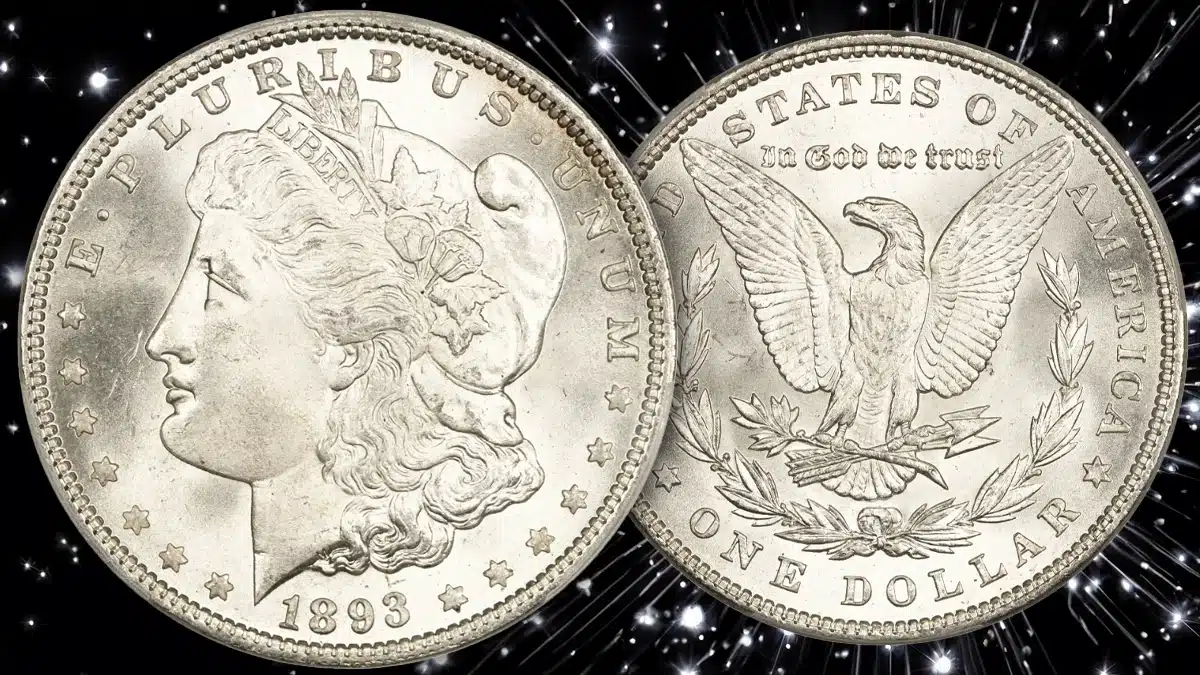
The more than 500 lots in the December 17 Online Auction from David Lawrence Rare Coins (DLRC) is live online and includes 150 No Reserve and 150 Recently Reduced items.
Among the CAC-, NGC-, and PCGS-certified coin highlights in the sale is a tied-for-finest-known 1893 Morgan silver dollar PCGS MS66; a Gem 1897 Proof Morgan dollar NGC PF65; a Civil War-era slider 1864 three-dollar gold piece PCGS AU58; a Gem 1908-D $5 half eagle PCGS MS65; an 1846 $10 eagle NGC AU55 from the SS Republic; and a 1908 $20 double eagle NGC MS67 (No Motto).
Check out all of these lots and more before the auction closes on Sunday, December 17.
Ready to Sell Your Rare Coin or Collection?
Like the finest known 1893 Morgan dollar and other rare classic and modern U.S. coins offered above, David Lawrence Rare Coins always needs coins. When you are ready to sell, we’re here for you. David Lawrence offers three options that provide maximum flexibility to meet your needs while providing the highest quality personal service in the industry:
- You can sell your coins to us outright.
- You can consign your coins.
- You can participate in our Guaranteed Auction Program.
David Lawrence Rare Coins Consignment Special
Check out our Collector Consignment Special! We are offering the following options that can be combined, or adjusted for your specific needs:
Maximum Returns – For coins over $10,000, consign with a reserve and receive 90% or consign with no reserve and receive 92%.
Immediate Cash Advance – For collections over $10,000, receive an immediate cash advance of up to 75% on unreserved consignments.
Fastest Turnaround – We will get your coins to auction within 3-5 business days of receipt, ending in approximately two weeks.
Standard terms still apply:
- Coins from $1,000 to $10,000 – consign with a reserve and receive 85%; consign with no reserve and receive 90%
- No fee guarantee – no listing fees, no imaging fees, and no buyback fees
- Fast payment – payment within 30 days of sale; for this promotion, we can accelerate payment to two weeks in most cases
* * *
The post Tied-for-Finest 1893 Morgan Dollar at David Lawrence Rare Coins appeared first on CoinWeek: Rare Coin, Currency, and Bullion News for Collectors.
Twelve Caesars Auction of Ancient Roman Coins at Heritage
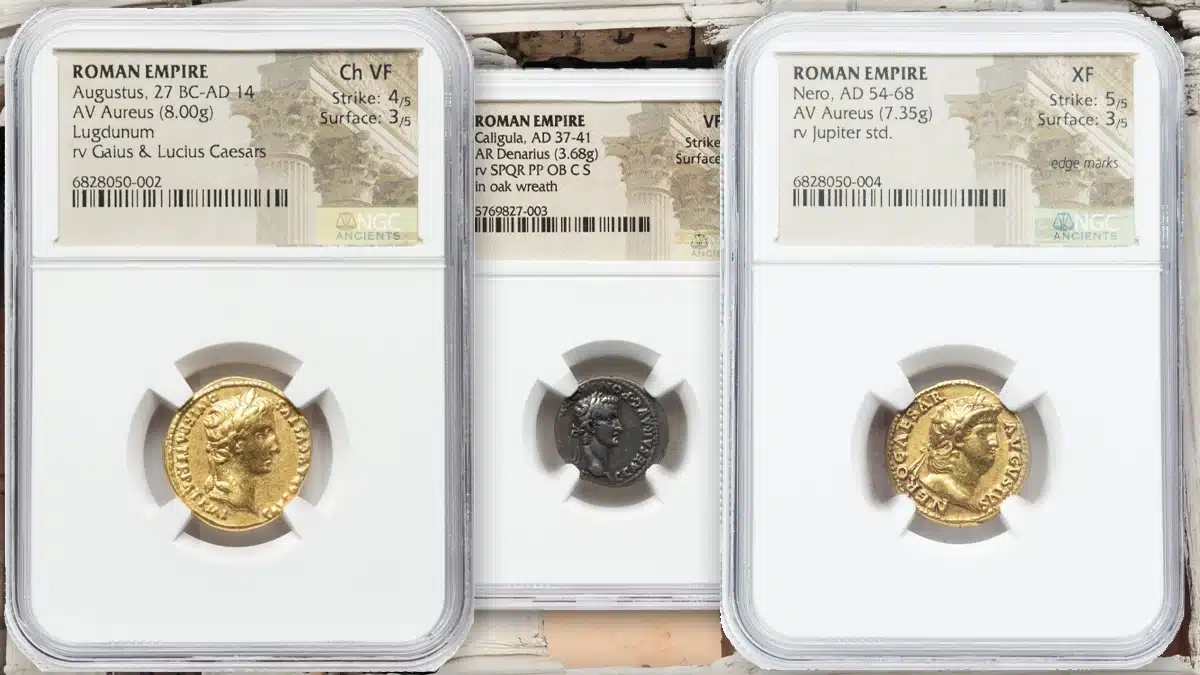
The Twelve Caesars has been a popular set among collectors of ancient Roman coins for generations. Getting its name from the book by ancient Roman historian Suetonius, the set usually features coins from dictator Julius Caesar and his nephew Augustus, the first Roman emperor, on through Emperor Domitian of the Flavian dynasty. In between are the Roman emperors Tiberius, Caligula, Claudius, and Nero finishing out the Julio-Claudian dynasty; Galba, Otho, and Vitellius of the “Year of the Four Emperors”; and Vespasian and his son Titus of the Flavian dynasty again.
Heritage Auctions is offering a selection of Twelve Caesars coins in a special Showcase Auction at 7 PM Central Time (8 PM Eastern) on Monday, December 11.
One of the highlights is a gold aureus of Augustus, graded Choice NGC VF 4/5 – 3/5, in Lot 24032. A laureate head of Augustus facing right is depicted on the obverse, while his beloved grandsons and heirs apparent Gaius and Lucius Caesar are featured on the reverse. These coins were struck in both gold and silver and served as propaganda in Augustus’ effort to establish a ruling dynasty. Unfortunately, both Gaius and Lucius died very young, establishing a pattern of the elimination of Augustus’ preferred heirs in favor of the family of his wife Livia.
Other highlights of the special Twelve Caesars auction include:
- Julius Caesar, as Dictator (49-44 BCE). AR denarius. NGC XF 5/5 – 3/5, bankers mark. Military mint traveling with Caesar in northern Italy, ca. 49-48 BCE
- Tiberius, as Augustus (14-37 CE). AV aureus. NGC VF 5/5 – 3/5, edge marks. Lugdunum, ca. 14-17 CE
- Gaius (Caligula) (37-41 CE). AR denarius. NGC VF 4/5 – 3/5. Rome, 41 CE
- Claudius I (41-54 CE). AV aureus. NGC Choice XF 5/5 – 2/5, brushed. Rome, 46-47 CE
- Nero, as Augustus (54-68 CE). AV aureus. NGC XF 5/5 – 3/5, edge marks. Rome, ca. 65-68 CE
- Otho (January-April 69 CE). AR denarius. NGC Choice XF 3/5 – 4/5. Rome
- Vitellius (late April-20 December 69 CE). AR denarius. NGC Choice XF 4/5 – 3/5. Rome
- Titus, as Caesar (79-81 CE). AV aureus. NGC Choice VF 5/5 – 2/5, scratches, edge scuffs. Rome, 77-78 CE
* * *
The post Twelve Caesars Auction of Ancient Roman Coins at Heritage appeared first on CoinWeek: Rare Coin, Currency, and Bullion News for Collectors.
Designs for 2024 Flowing Hair Coin and Medal Get the Nod
In 2024, the United States Mint will release a 1 oz
Gold and Silver Edge Lower on Thursday, Dec. 7
On Thursday, prices for precious metals were mixed, with gold and silver registering modest losses and platinum and palladium recording solid gains
US Mint Sales: The 2023 Limited Silver Set Debuts, with 11 Other Products Shining Brightly
Last week, the United States Mint began selling their premium 2023 Limited Edition Silver Proof Set for $220
CAC Coins and CACG Bring Higher Premiums in November
CAC-approved coins fared well in many public sales during the month of November, and in live auctions in Texas, New Jersey, and California. Here are 10 examples selected from a large number of results that could have been listed.
A Selection of CAC and CACG Coins Earning Higher Premiums
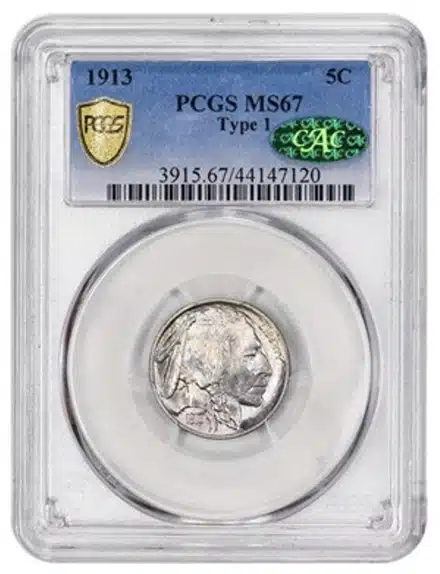
1. 1913 Buffalo Nickel in MS-67
On Nov. 2, Legend Rare Coin Auctions (LRCA) sold a CAC-approved MS-67 grade, 1913 ‘Type One’ Buffalo nickel for $1,468.75 USD. On October 17, Heritage Auctions sold a PCGS-graded MS-67 1913 ‘Type One’ Buffalo nickel, without a CAC sticker, for $900.
2. 1875-CC Twenty Cent Piece in MS-63
On Nov. 2, Legend auctioned a CAC-approved MS-63 grade 1875-CC Twenty Cent piece for $4,112.50. On December 15, 2022, Heritage auctioned a PCGS-graded MS-63 1875-CC Twenty Cent piece, without a CAC sticker, for $3,120. Market levels for these were only slightly higher, if higher at all, in November 2023 than they were in December 2022.
3. 1904 Barber Quarter in Proof-67
On Nov. 2, Legend auctioned a CAC-approved PCGS-certified Proof-67 1904 quarter for $5,405. On May 22, Heritage sold a PCGS-certified Proof-67 1904 quarter, without a CAC sticker, for $2,100.
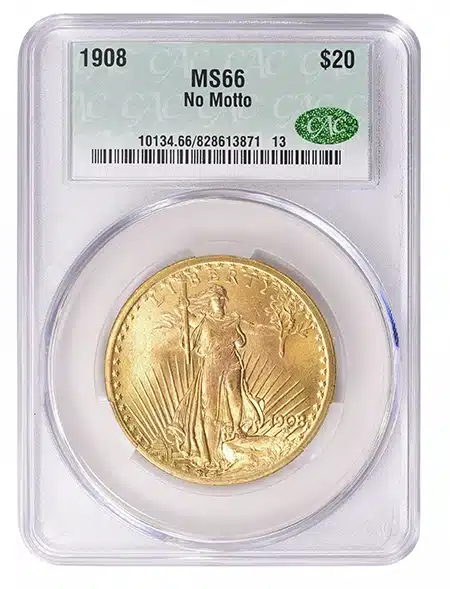
4. 1908 No Motto Saint-Gaudens $20 Gold Double Eagle in MS-66
On Nov. 5, GreatCollections sold a CACG-graded MS-66 1908 ‘No Motto’ $20 gold coin for $4,840. On August 18, Stack’s Bowers auctioned a PCGS-graded MS-66 1908 ‘No Motto’ $20 gold coin, without a CAC sticker, for $3,120.
5. 1857 Flying Eagle Cent in Proof-65
On Nov. 14, Stack’s Bowers auctioned a CAC-approved, PCGS-certified Proof-65 1857 Flying Eagle cent for $33,600. On August 24, 2022, Heritage auctioned a PCGS-certified Proof-65 1857 Flying Eagle, without a CAC sticker, for $22,800. Market levels for these were not higher in November 2023 than they were in August 2022.
6. 1915-S Panama-Pacific Commemorative Half Dollar in MS-67
On Nov. 16, Stack’s Bowers auctioned a CAC-approved MS-67 grade 1915-S Pan-Pac commemorative half dollar for $7,800. In March 2020, Stack’s Bowers auctioned this exact same coin, for the same price, $7,800. On July 21, 2023, Heritage sold two PCGS-graded MS-67 1915-S Pan-Pac commemorative half dollars, without CAC stickers, for $4,200 and $4,560, respectively.
7. 1850-C Liberty Head $2.50 Gold Quarter Eagle in AU-55
On Nov. 16, Stack’s Bowers auctioned a CAC-approved AU-55 grade 1850-C $2.5 gold coin for $7,200. On Aug. 27, 2022, Stack’s Bowers auctioned a PCGS-graded AU-55 1850-C $2.5 gold coin, without a CAC sticker, for $4,920. Market levels for these were a little higher in August 2022 than they were in November 2023.
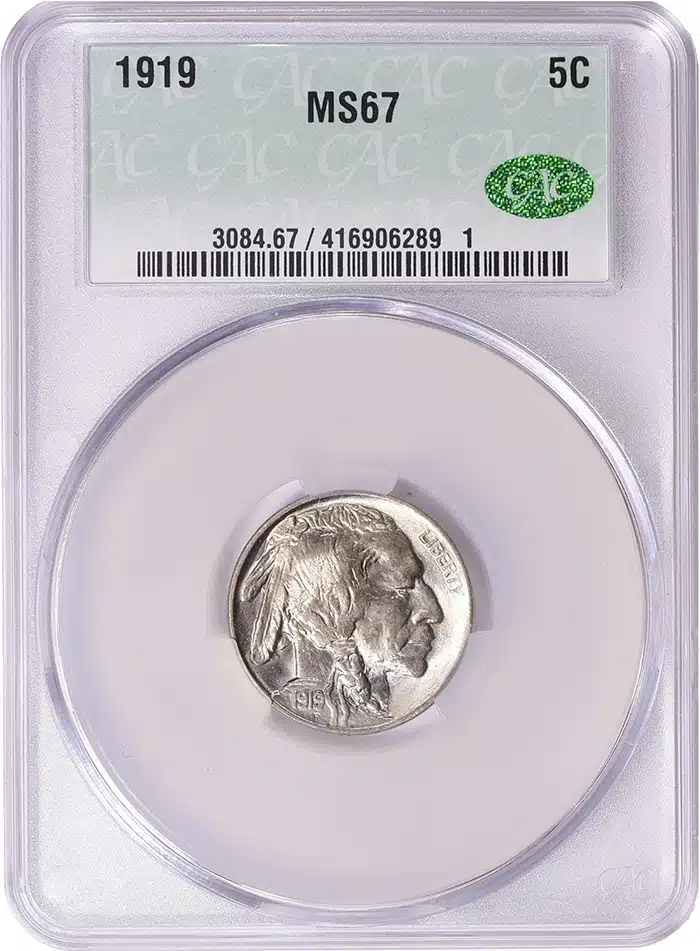
8. 1919 Buffalo Nickel in MS-67
On Nov. 19, GreatCollections sold a CACG-graded MS-67 1919 Buffalo nickel for $5,791.50. On May 4, Heritage auctioned a PCGS-graded MS-67 1919 Buffalo nickel, without a CAC sticker, for $3,120. On March 5, GreatCollections sold a different PCGS-graded MS-67 1919 Buffalo nickel, without a CAC sticker, for $3,054.70.
9. 1938 Walking Liberty Half Dollar in MS-64
On Nov. 19, GreatCollections sold a CACG-graded MS-64 1938 half dollar for $425.69. On September 10, Great Collections sold a PCGS-graded MS-64 1938 half, without a CAC sticker, for $139.69. On Aug. 30, Stack’s Bowers sold a different PCGS-graded MS-64 1938 half, without a CAC sticker, for $192. A week earlier, Stack’s Bowers sold another for that same price, $192. A CACG-graded coin thus brought more than twice as much as each of three PCGS-graded MS-64 1938 half dollars.
10. 1884-CC Morgan silver dollar
On Nov. 19, GreatCollections sold a CACG-graded MS-66+ 1884-CC Morgan silver dollar for $1,705. On Oct. 8, GreatCollections sold a PCGS-graded MS-66+ 1884-CC Morgan, without a CAC sticker, for $1,266.10.
* * *
The post CAC Coins and CACG Bring Higher Premiums in November appeared first on CoinWeek: Rare Coin, Currency, and Bullion News for Collectors.
Gold and Palladium Prices Rise on Wednesday, Dec. 6
Precious metals diverged on Wednesday, following two days of across-the-board losses
The Importance of Natural Toning on Early U.S. Coins
By Greg Shishmanian …..
Retired chemist and prolific numismatic author Weimar White is a purist representing one end of the spectrum regarding toning. His numismatic research and opinions are well known and respected, and this article does not dispute White’s chemical analysis of the oxidization process. Nevertheless, many numismatists passionately disagree with his conclusions regarding toning on early U.S. coins, as he equates any form of toning or oxidation as “wear”.

There are several simple and effective ways to slow the progression of natural toning. For example, in a book entitled Coin Chemistry, White suggests storing a few copper pennies with your silver coins to act as sacrificial corrosion targets. This method has proven to be an effective and inexpensive way to drastically slow the oxidization process. Reducing moisture is also important and can be accomplished by using a desiccant or a sealed plastic bag. Another good but more expensive solution is to use Intercept Shield storage containers which, the company claims, provide 10 years of effective corrosion protection. The inner walls of their containers are covered with a material containing copper that reacts with and permanently neutralizes corrosive gases. The shield acts as a moisture barrier and thus provides a dual form of protection that eliminates the two elements needed to form atmospheric corrosion.

Mr. White states the following in his article titled “Protecting your LSCC 40th Anniversary Medal”, published in the Liberty Seated Collectors Club (LSCC) Gobrecht Journal volume #117:
“Good coin care is very important since the tarnishing of silver is the oxidation of the silver, the loss of some of its electrons. There are two kinds of coin wear, physical wear and chemical wear. The tarnishing of silver is chemical wear just as when iron oxidizes to form rust in the form of iron oxide.”
Silver and copper are highly reactive metals, which means they easily lose electrons when they come in contact with other substances – especially oxygen, hydrogen, nitrogen, and sulfur. This explains why all silver and copper coins will tone naturally when exposed to the atmosphere. It should be noted that one important benefit of toning is that it serves as a protective barrier between the metal and the air that stabilizes the surfaces of coins.
The Impact of Storage on Toning on Early U.S. Coins
Early U.S. coins were not stored in a vacuum. They were exposed to and reacted with a wide array of elements in the air during wide-ranging temperature and humidity cycles. Coins were stored in many different ways and came in contact with many different materials over their lifetimes. Examples include wooden drawers and cabinets, cloth bags, leather pouches, paper envelopes and rolls, and cardboard coin holders.
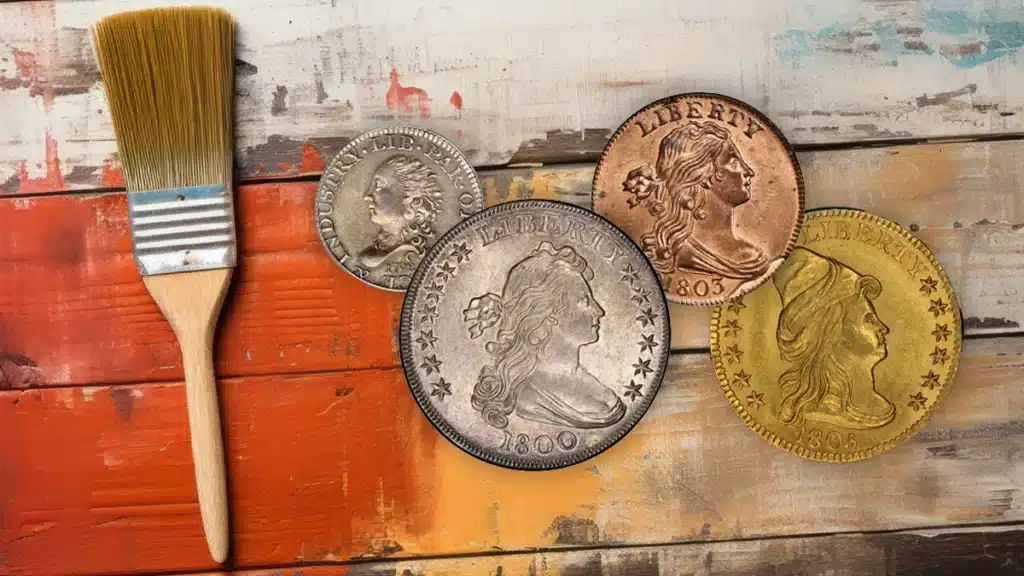
Wood stain and varnish were commonly applied to wooden drawers and cabinets. Oil-based wood stains contain ingredients such as petroleum, alcohol, formaldehyde, sodium hydroxide, and glycol. Wood varnish is made from three basic ingredients: solvent, resin or oil, and pigment or dye. These chemicals and materials react with the coin’s surface and subsequently affect the toning process.
Some of these storage methods will slow the toning process while others will accelerate it, but none of them will prevent toning over long periods. Mr. White’s article titled “Encapsulated Coins May Continue to Tone While in Their Holders”, published in the LSCC Gobrecht Journal volume #70, states:
“This is important information for the collector who wants to keep his coins in a state of “original purity” over a period of years.”

What he omits is the crucial fact that toning has occurred to some degree on nearly all early U.S. silver and copper coins over the past 150 years. Therefore, this toning would have to be removed to achieve his goal of “original purity”.
In White’s book The Liberty Seated Dollar 1840-1873 (1985), he includes a paragraph entitled “The Thickly Toned Dollar Trap”. In it, he discusses the results of dipping thickly toned coins. He states:
“Those collectors who are bold enough to try cleaning these coins by dipping them in a sulfide removal solution are more often than not disappointed because they soon discover that they now have an About Uncirculated coin and consequently a financial loss.”
If you change the word “bold” to “foolish”, then White’s statement would be much more accurate. He fails to mention that dipping particularly thickly toned coins changes the surfaces of the coins.
The resulting metal loss and possible redistribution changes the flow lines and the way light reflects off the coin’s surface. “Flow lines” are defined as the microscopic lines on the surface of a coin created by the outward flow of metal during the striking process. This transformation of the flow lines changes the way we see the light that reflects off the coin surfaces. This is critically important and is referred to as a coin’s luster.
Instead of accepting White’s definition of “chemical wear” as the tarnishing of silver, it is more accurate to define the term “chemical wear” as the result of using chemicals to strip the layers of toning from the surface of a coin.
For years, White has claimed that toning prevents coins from having original surfaces and grading Mint State because they do not look the same as the day they were minted. He claims this is true for all coins regardless of their composition or when they were minted. White has even said that lightly toned coins should not be graded Mint State because of the chemical alteration of their surfaces, though he eventually modified this opinion to permit it when the toning is light enough that the surfaces can be unambiguously assessed to be free of physical wear.
Mr. White’s position is based on chemistry, yes, but he ignores the fact that real-life storage methods used over the past two centuries directly affected the toning process. His article entitled “How Some Carson City Coins May Have Escaped Heavy Toning” (Gobrecht Journal #65) attempts to justify his position by suggesting possible storage methods that would have prevented toning. His experiment consisted of placing a silver spoon in a blue Milk of Magnesia bottle with a closed screw cap and in a Nestle’s Toll House Morsels tin for about one year (the vessels representing possible bottle or tin types available 100-plus years ago). An assortment of bottles, glass hens, and tin containers, are pictured in this article as potential storage vessels. White concedes that the Shaker boxes shown would not give the best long-term protection from sulfur chemistry since they are porous and made of wood.
From this experiment in the above-mentioned article, he concludes that:
“The Carson City silver coins that today remain brilliant with full mint luster or bloom are few and far between. Is it possible that they were intentionally placed in covered containers to keep out the corrosive sulfur atmosphere? The experiment described in this article may provide a partial answer to this question.”
We’ve all heard the saying “anything is possible”. However, while one is unable to calculate the probability of White’s early Carson City coins being stored in a blue Milk of Magnesia bottle with a closed screw cap or a glass hen cookie jar for 150 years, one can be assured that it’s extremely low. In addition, these vessels are not airtight, and although they would likely slow the toning process, they would not prevent some degree of natural toning over long enough timespans. One only needs to look back at old-time collections and confirm the overwhelming number of toned early silver and copper coins.
The truth is that White’s opinion has contributed to people destroying the original surfaces of coins by repeatedly dipping them to remove multiple layers of natural toning. It’s alarming to see the toning on so many rare early U.S. coins permanently ruined by over-dipping from people attempting to produce white, untoned coins. Most early coins have already been cleaned in some way and have re-toned during their lifetime. Experience has proven that coins with natural toning and unmolested surfaces that retain some original luster are scarce and preferred by the vast majority of knowledgeable numismatists. As most numismatists mature in the hobby, their appreciation and desire to own coins that display these characteristics grows exponentially.
One wonders what storage methods and atmospheric conditions combined to prevent even a very small percentage of coins from toning. Regardless of how few survived, one is in awe of the magnificent beauty of frosty white early silver or blazing red copper coins that have retained their untoned, unmolested, lustrous, surfaces. The numismatic market recognizes their rarity and often places a strong premium on these coins.
Antiques such as paintings, sculptures, furniture, vehicles, and ancient artifacts, were made of many different materials. As with coins, nearly all antiques that were made of or contained reactive metals acquired toning (often called “patina”) and wear patterns over time. Very few of them look the same as when they were created. Their value is usually reduced significantly if they are restored to look like new. The vast majority of numismatists and antique collectors want examples that have survived with unmolested surfaces.
Respected senior numismatists have published articles on this topic. For example, Greg Reynolds is a numismatic writer, researcher, and analyst, and has explained the meaning and importance of natural toning. He has examined almost all of the greatest U.S. coins and most of the finest type coins and patterns. Reynolds has extensively researched the pedigrees of important numismatic properties and has written about and analyzed numerous auctions, private sales, and collections. He has contributed hundreds of articles to Numismatic News and other Krause publications and had a weekly column on CoinWeek.com.
The Reynolds article entitled “The Basis for Collecting and Appreciating Naturally Toned Coins” is divided into three parts and contains a wealth of valuable information. It was published on CoinLink.com in the fall of 2009. The following quotes are a few of my favorites:
“In the history of coin collecting in the U.S., most of the greatest all-time collections were characterized by many coins with attractive, natural toning, especially including many coins that had never been cleaned, dipped, or otherwise deliberately modified.”
Reynolds refers to the Eliasberg, Norweb, Pittman, and Garrett collections, calling them the four greatest collections to be auctioned over the last half-century. It’s no coincidence that virtually all the coins in these auctions displayed natural toning on their original surfaces.
He states:
“I always believed that most sophisticated and knowledgeable collectors, plus advanced dealer experts agree that usually, the naturalness and originality of the coin is a substantial and very important factor in determining the greatness and importance of a collection of U.S. coins.” He makes the following sage statements, “Rare coins with natural toning and original surfaces command respect among experts, have historical and cultural significance, and are satisfying to a knowledgeable owner. I emphasize the superiority of natural toning and/or mostly original surfaces.”
The professional graders at the major coin grading services have never endorsed or applied White’s philosophy that toning eliminates coins from being graded Mint State. A strong case can be made that coins that have been conserved by over-dipping or other methods of removing toning have been altered and can no longer claim to have original surfaces. Another problem is improper rinsing after dipping in an acid-based solution. This can leave contamination by products remaining on a coin’s surface.
Another well written article, “The Science of Dipping and Toning” by Thomas Bush (who has PhDs in both chemistry and biology), provides a detailed explanation of what dipping does to a coin.
There are some great articles on natural toning and patterns that include detailed color classification systems for natural toning. Doug Kurz developed a classification system that uses this color progression to concisely describe the toning on silver coins. He assigned classification codes to the colors typically found along the thin film progression. While there are infinite gradations and multiple possible color cycles that introduce subjective color assignments, our eye’s ability to see, process the reflected light, and distinguish certain colors is impressive.

Professional graders use the term questionable toning when they are unable to determine if toning is natural or artificial. Doug also notes that “artificially toned coins can still obey the standard progression, and there are also some naturally toned coins that do not. This can happen if there are unusual contaminants present during storage, such as chlorine, or excess sulfur. Such coins may fit our generally accepted notions of natural toning, while still exhibiting some unusual colors. But the vast majority of toned silver coins will conform to the standard progression.” In addition, a coin’s surface quality and finish can affect toning progression and patterns.
The final stage of toning or thin-film progression is called “terminal toning”. It is dull black in color, unattractive, and masks the details of the coin. It’s crucial to remember that a coin’s natural luster can’t be recreated or restored once lost. Luster is very important, but when dipped coins are preferred over naturally toned coins, the scale has tilted too far in the direction of luster and away from natural toning on early U.S. coins.
In Conclusion
Numismatists should learn to appreciate the fact that un-dipped coins are antiques that have survived their historic journey with their natural surfaces. Recognize and value coins with natural toning achieved over many decades rather than coins that have been intentionally tampered with to strip their surfaces clean in an often futile attempt to make them look like the day they were minted.
I recognize and value the fact that a coin is in the condition it is today because of the minting process used to make it, the period in which it was made, and whatever natural processes (aging, toning, oxidizing, etc.) occurred during its journey down the historic road it traveled. I appreciate nature’s beautiful and unique toning and do not feel the need to try and reverse the process to create the illusion that a coin was minted yesterday. Many numismatists embrace the following philosophy. Every time an original coin is improperly cleaned or conserved, it makes the ones that remain that much rarer and that much more valuable. I hope that you will join me and preserve the surfaces of these historic works of art rather than destroying nature’s work.
* * *
The post The Importance of Natural Toning on Early U.S. Coins appeared first on CoinWeek: Rare Coin, Currency, and Bullion News for Collectors.
2024 Greatest Generation Commemorative Coin Images Unveiled
The United States Mint unveiled images of the 2024 commemorative coins honoring the Greatest Generation
Harriet Tubman Commemorative Coin Strike Ceremony Held at U.S. Mint
By Hubert Walker for CoinWeek ….
A first strike ceremony for the Proof 2024 Harriet Tubman Bicentennial commemorative silver dollar was held at the United States Mint facility in Philadelphia on Thursday, November 28. Hosted by Mint Director Ventris C. Gibson, representatives of stakeholders in the commemorative coin program and other interested parties attended the event.
These representatives included:
- Karen Hill – President and CEO of the Harriet Tubman National Historical Park (Auburn, New York);
- Woodrow Keown, Jr. – New President and COO of the National Underground Railroad Freedom Center (Cincinnati, Ohio);
- Bishop Dennis Proctor – Presiding Prelate for the North Eastern Episcopal District, African Methodist Episcopal Zion Church;
- Damon Jones – Chief Communications Officer, Procter & Gamble (Cincinnati);
- Robert Portman – Former U.S. senator (R-OH); and
- John Katko – Former U.S. representative (R-NY24).

Attendees that struck their own Proof coins were able to buy those coins for the initial retail price that will be in effect at the commemorative’s currently scheduled release on January 4, 2024. According to the Mint’s online 2024 product release schedule at the time of writing, that price has not been determined or made public. The coins would then ship at the same time as all regular orders processed by the Mint, meaning that attendess could not take immediate possession of the coins they struck.
All other Harriet Tubman commemorative Proof dollars struck at the November 28 ceremony will enter the same pool of inventory from which customer orders will be drawn starting next month and continuing until the end of the year.
The 2024 Harriet Tubman Bicentennial Commemorative Coin Program
The 2024 Harriet Tubman Commemorative Coin Program was authorized by the Harriet Tubman Bicentennial Commemorative Coin Act (Public Law 117–163; PDF link), which was signed into law by President Joe Biden on August 3, 2022. The program celebrates the bicentennial of the birth of anti-slavery activist and national hero Harriet Tubman.
Like many other modern U.S. commemorative coin programs, the Harriet Tubman Commemorative Program consists Proof and Unicrculated versions of a $5 gold coin, a silver dollar, and a clad half dollar, for a total of six coins (three different obverse/reverse design pairings in two finishes each). The authorizing legislation has established maximum production limits of 50,000 gold coins, 400,000 silver dollars, and 750,000 half dollars – though the actual respective mintages will depend on total orders for each product.

The designs on each coin represent Tubman’s legacy of abolitionism, and were selected by the National Underground Railroad Freedom Center in Cincinnati; the Harriet Tubman Home, Inc. in Auburn, New York; and the United States Commission of Fine Arts (CFA). These designs were then reviewed by the Citizens Coinage Advisory Committee (CCAC).
As determines by the Harriet Tubman Bicentennial Commemorative Coin Act, surcharges of $35 per gold coin, $10 per silver coin, and $5 per clad half dollar are to be distributed to the National Underground Railroad Freedom Center and the Harriet Tubman Home.
Current U.S. Code allows the Mint to produce only two commemorative coin programs each year. The other commemorative program of 2024 celebrates the “Greatest Generation” of Americans who fought and won World War II. Those products are currently slated for a February 29 release.
Harriet Tubman Bicentennial Commemorative Coin Designs
$5 Gold
The $5 coin honors Tubman’s life after the American Civil War.
The obverse, designed by Artistic Infusion Program (AIP) artist Chris Costello and sculpted by United States Mint Chief Engraver Joseph Menna, features a close-up portrait of Harriet Tubman looking towards the future.
The reverse, designed by AIP artist Benjamin Sowards and sculpted by Mint Medallic Artist Eric David Custer, features one person grasping another person’s hand with both of theirs, symbolizing the care and concern Tubman offered her fellow man.
$1 Silver
The $1 coin commemorates Tubman’s death-defying work with the Underground Railroad, which freed slaves by smuggling them out of the South and into the North and even Canada through a network of safe houses and brave accomplices.
The obverse, designed by AIP artist Beth Zaiken and sculpted by Medallic Artist Phebe Hemphill, features Harriet Tubman offering the viewer her hand and a chance at freedom.
The reverse, also designed by Zaiken and sculpted by Medallic Artist Craig Campbell, features a nighttime scene of a group of people in silhouette crossing over a pair of clasped arms as they follow the Big Dipper and the Northern Star to freedom. Interestingly, the Northern Star replaces the letter “O” in the legend UNITED STATES *F AMERICA. The replacement of the letter with an object and the depiction of nighttime on a coin are unusual if not unique among the whole catalog of U.S. coins.
Clad Half Dollar
The Harriet Tubman Bicentennial clad half dollar honors her work as a scout, spy, and nurse for the Union Army during the Civil War.
The obverse, designed by former Mint Medallic Artist and now AIP designer Don Everhart and sculpted by Medallic Artist Renata Gordon, features Harriet Tubman in front of a scene depicting the 1863 Combahee River Raid in South Carolina, which Tubman enabled with key intelligence on Confederate positions and ultimately freed over 700 people from slavery.
The reverse, designed by AIP artist Thomas Hipschen and sculpted by Medallic Artist John P. McGraw, is based on a famous contemporary woodcut of Tubman in wartime garb. The woodcut, however, depicts Tubman holding the barrel end of a rifle, which has been replaced by a spyglass on the coin.
A Busy Decade for Tubman
In some ways, the 2024 Commemorative Coin Program is a consolation prize for Tubman after years of activism that sought to place her on the $20 bill. For more on that story, click here.
* * *
The post Harriet Tubman Commemorative Coin Strike Ceremony Held at U.S. Mint appeared first on CoinWeek: Rare Coin, Currency, and Bullion News for Collectors.
Precious Metal Decline Together for a Second Day on Tuesday, Dec. 5
The prices of precious metals dropped in unison for a second consecutive day on Tuesday, with losses varying from a modest 0
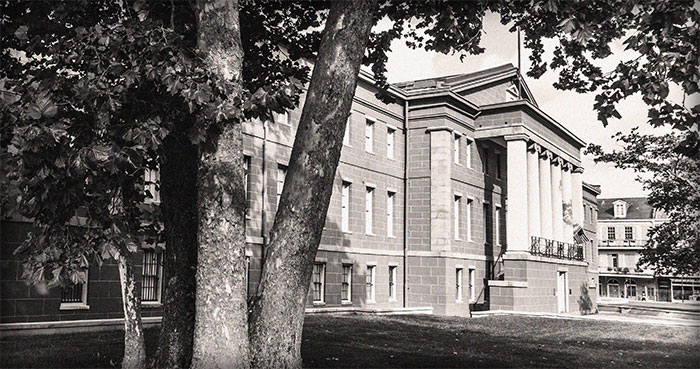
Unique Proof 1891-O Seated Liberty Dime Among New Orleans Special Strikes
By Mike Byers for Mint Error News ……
This is the only known 1891-O Seated Liberty Dime struck in Proof. Authenticated and certified by NGC as Proof 66, this unique branch mint Proof is a world-class rarity. It is listed in The Official 2024 Mega Red Book of U.S. Coins, Deluxe 9th Edition on page 422 and described as extremely rare.
This dime has been recently reholdered in the latest NGC holder with an enhanced label, better visibility and a higher-security hologram.

The United States Mint in New Orleans has one of the most interesting histories of all the mints. At one point, it was taken over and the United States of America no longer held control of it due to the Civil War. The New Orleans Mint officially became a branch mint on March 3, 1835, and first produced coins in 1838, staying in operation until 1861 when the war started. After the period of Reconstruction, it began operations again in 1879 and continued until 1909.
The New Orleans Mint resumed striking Seated Liberty Dimes in 1891, which had not been struck since 1860. This created a lot of publicity – which included a New Orleans Times-Picayune article published on July 26, 1891. This article reported the resumption of the silver dime production:
“The United States mint is now engaged in coining one million dimes a month. The dime banks and other causes have created a scarcity and Uncle Sam has ordered his money factories to the rescue. There is considerable demand for the dimes. They are the first coins of that smallness the mint has made, and the same presses with which the dollars were coined are used, the ingots being also of similar size. The new dies reached here about the 1st of the month, and the dimes commenced to roll out on the 5th.
The mint has on hand the bullion representing 3,000,000 trade dollars, shipped from the Philadelphia mint about two months ago, and the 863,000 ounces of uncurrent money sent from various sub-treasuries; so that there is no lack of silver to keep the presses going.”
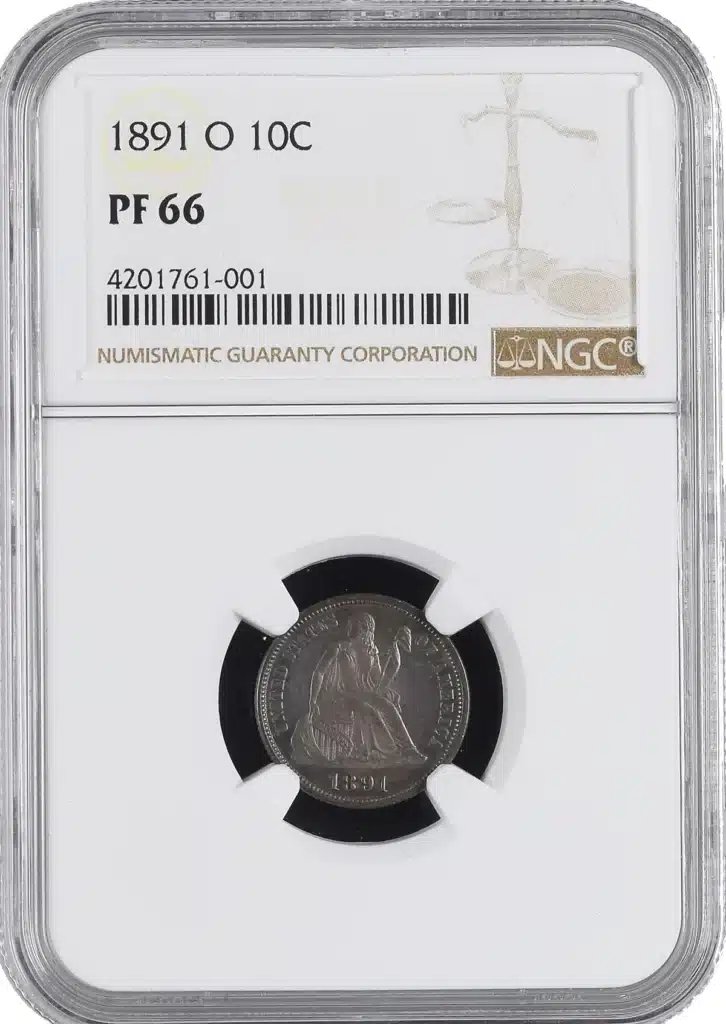
This was the only Proof silver dime struck by the New Orleans Mint in 1891. It was unknown to Walter Breen and was not recorded in his Encyclopedia of United States and Colonial Proof Coins (1987). It is widely believed that this Proof striking commemorated the New Orleans Mint in 1891.
This unique proof 1891-O Seated Liberty Dime is not recorded on numismatist Gerry Fortin’s website (seateddimevarieties.com), but he researched this dime and determined that:
“The obverse is unlisted and the reverse is Reverse P. The obverse die is perfect, with no trace of date repunching, no clash marks, and no die cracks. There is no evidence of die lapping on the obverse. Similarly, the reverse die is perfect, also with no repunching of the mintmark, no clash marks, no die cracks, and no evidence of die lapping. The mintmark is close to the bow knot, and tilted sharply to the left.”
A “perfect” and “unlisted” die was used to strike this dime. It is in Gem Proof condition with exceptional eye appeal and original toning. It has a full strike with full detail since it was struck on a large press setup for silver dollar coinage. This piece was most likely struck as a special Proof presentation piece, prior to striking regular dime coinage at New Orleans on Sunday, July 5, which was the first day reported.
There are also two known 1891-O Seated Liberty Quarters, both certified by specimens by NGC, which are obviously special strikes as well. Both of these are valued at and have traded for six figures.
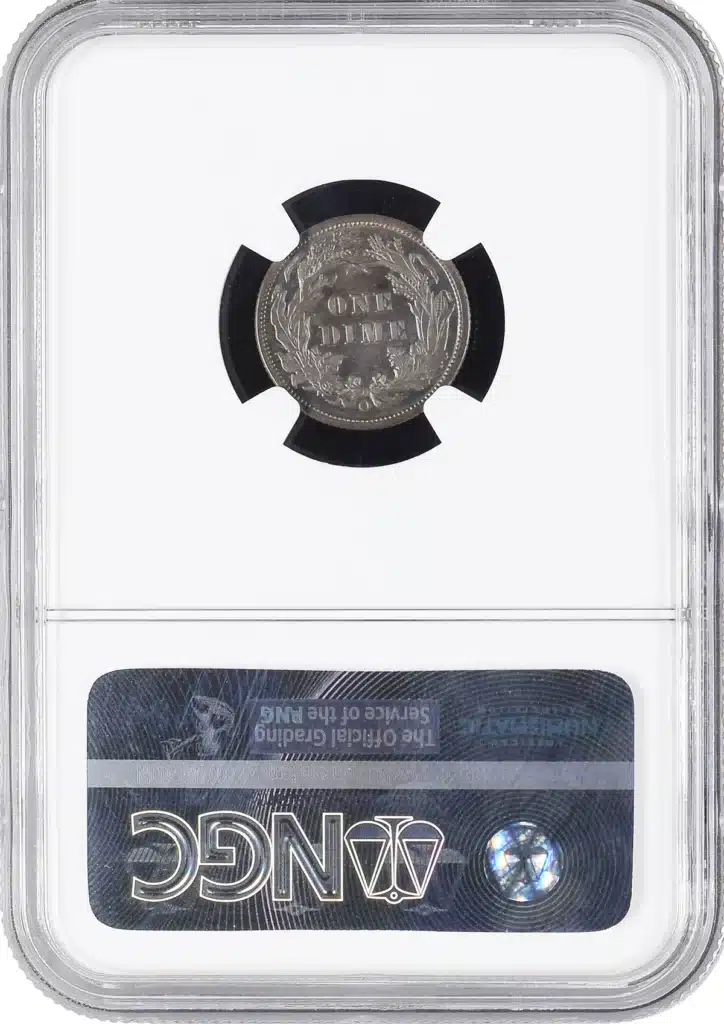
The New Orleans Mint, throughout its history, struck unique Proof and specimen coinage. A few examples are the classic 1838-O Proof Cap Bust Half Dollar, the 1839-O Proof Cap Bust Half Dollar, the 1844-O Proof $5 Eagle and Proof $10 Eagle, the 1895-O Proof Morgan Dollar, and the 1883-O Proof Proof Morgan Dollar.
This unique 1891-O Branch Mint Proof Seated Liberty Dime is in a category by itself; the closest comparison would be the extremely rare 1894-S Branch Mint Proof Barber Dime. Although there is not any official documentation or Mint records pertaining to the striking of this unique Proof dime, not every unique Proof coin struck at the New Orleans branch mint or at any other U.S. Mint has official records or documentation. Although not nearly as famous as the 1894-S Branch Mint Proof Dime, of which 24 were struck, the 1891-O Branch Mint Proof Dime merits comparison to the 1894-S Branch Mint Proof Dime that sells for seven figures.
Many ultra-rare coins struck by the Mint in Philadelphia and in the branch mints are unique or produced in extremely small numbers under clandestine circumstances. A few examples are the 1804 silver dollar and the 1913 Liberty Head nickels. Other examples include the gold Indian Head cents and the unique 1913 Liberty Head nickel struck in gold. Although the 1894-S Barber Dime is documented in U.S. Mint records, there is still controversy surrounding the purpose for striking these. Additionally, many branch mint Proofs and specimens are controversial and lack official U.S. Mint documentation.
This unique 1891-O Branch Mint Seated Liberty Dime combines rarity, quality and history and belongs in an advanced collection of Seated Liberty coinage or unique coinage from the United States Mints.
The post Unique Proof 1891-O Seated Liberty Dime Among New Orleans Special Strikes appeared first on CoinWeek: Rare Coin, Currency, and Bullion News for Collectors.

Five Observations About the November 2023 Fairmont Gold Sale
By Doug Winter – RareGoldCoins.com ……
CoinWeek Content Partner
Stack’s Bowers held the most recent installment of the Fairmont Hoard on November 15, 2023. As with the last sale (August 2023 and held during the ANA convention to my endless chagrin), prices were mixed, with some coins selling for very strong numbers and others selling at discounts in relation to their most recent auction comparable sale and/or the current PCGS Price Guide.
Here are five observations about the rare date gold coin market based on prices realized at the auction, as well as my personal observations from the last few months (post-ANA, to be more concise). Please note that all prices include the 20% buyer’s premium charged by the auctioneer.
1. Dahlonega Half Eagles Are On Fire
The quality of the Dahlonega $5 gold half eagles in this edition of Fairmont fell short of those seen in earlier sales. But as I’ve written before, a low-end Fairmont coin still wipes the floor with an average quality pre-1933 U.S. gold coin in virtually every dealer’s inventory. There were 14 different Dahlonega half eagles sold, ranging in grade from a low of EF40 to a high of AU55.
A total of four were approved by CAC, with these selling as follows:

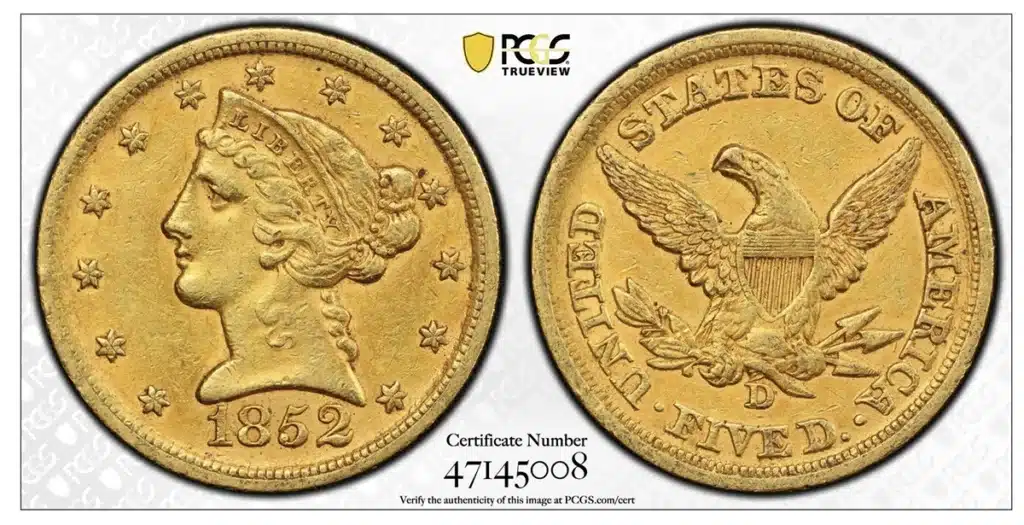
Considering that the current PCGS prices were—in my opinion—significantly inflated right before November 15, I think these are exceptional prices. When one considers that, for years, very decent quality (the equivalent of CAC-approved or near-CAC quality) Dahlonega fives were available in the $2,500 to $3,000 USD range, that era seems done.
2. Nice and Rare Still Sold for Plenty
As I said above, the quality and the depth of this session paled in comparison to some of the earlier Fairmont sales. However, there were still pretty decent individual coins available.
Three quick examples:
1884-CC $10, PCGS/CAC AU58 (Lot 5213): I really liked this coin. It was 100% natural in appearance with lovely deep green-gold color… a PQ example of this conditionally scarce date if ever one deserved this appellation.
I intended to bid $15,000 but I stretched to $16,500 ($19,800 all in). Which still didn’t win the coin as it hit $17,000 ($20,400 all in). This is a record price for this date in this grade. The scary thing is there could easily be at least two or three more comparable–or better–coins in this deal.

1858-O $20, PCGS/CAC AU55 (Lot 5291): There might be a nicer AU55 example of this date somewhere, but if there is, I haven’t seen it (I almost liked the Stack’s Bowers 6/2018: 186 coin as much but that one somehow didn’t get stickered by CAC). I was determined to acquire this coin and I thought I’d have to stretch over my intended floor of $35,000. I wound-up stretching a bit and still struck-out on this coin, which set a price record for the date and grade.
It was just the second CAC-approved 1858-O $20 in AU55 to ever sell at auction, and I actually liked it more than the two Fairmont PCGS/CAC AU58s that sold for $40,800 and $43,200 in 11/2022 and 8/2022, respectively. It was nice, it was rare, and it sold for plenty – despite the fact that the Type One Liberty Head $20 gold double eagle market is very flat right now.
1879-CC $20, PCGS/CAC AU55 (Lot 5339): All Carson City double eagles are technically overvalued when it comes right down to it. The 1879-CC is considered a “rare” date within the CC $20 series, yet as many as 300 to 400+ exist. Problem-free AU55 and better coins are genuinely scarce, especially with CAC approval. The current CAC population stands at eight in AU55, five in AU58, and just a single coin (an MS62) finer.
I knew this coin was going to be tough to buy as there was an outlier APR of $50,400 for a PCGS/CAC AU55 in August, 2022. The only Fairmont example to trade in the last few years in PCGS AU55 brought $26,400 in March 2023; it was non-CAC but pretty nice overall. The coin brought $48,000 with me as the frustrated and somewhat spiteful underbidder.
3. It’s About the Coins, Stupid
Lots of very smart collectors (some of them are good Douglas Winter Numismatics clients) have had it with Fairmont (said in the whiniest voice(s) imaginable: “But I’m tired of these sales…” or “But I want to know the back story of where the coins are from..” or “But Stack’s could have a bag full of 18xx-CC double eagles in their back office…”
Enough already!
Like the header says: It’s about the coins, stupid. You don’t know the back story of the halibut filet on your dinner plate, so is that going to stop you from wolfing it down?
Fairmont is the gift that keeps on giving for collectors of truly unadulterated Liberty Head gold coins.

Case in point: I LOVE 1876-S eagles. Prior to Fairmont, I think I had seen maybe three nice AUs in over 35+ years of searching. Since 2022, Stack’s Bowers has now sold four (55+/55/55/50), and each one has been delightful. I’d like to think the market for a coin of this rarity can absorb these four coins as well as a few more.
Here’s the bottom line: these coins will dry up sooner than you think (the truly rare ones, that is). And when they’re gone, your chance to buy a nice 1876-S $10 will revert to next to nil. As the old cliché goes, “make hay while the sun is shining.”
4. “Let’s Run the Numbers, Triple R”
Courtesy of my numbers guru, Richard Radick (big ups, Triple R), here are the sale by the numbers:

A few quick takes:
As with the last Fairmont offering (8/2023), the strength of the sale was in the half eagles–especially the Dahlonega and New Orleans issues.
CAC coins in Fairmont sales consistently bring a 10-20% premium over non-CAC coins. This is actually lower than in many auctions, and I believe this is due to the fact that there are so many “really nice but just a teeny bit too (choose one or more): cleany/marky/dull/liney for JA” coins. I am still an avid buyer of such coins, especially if they can be bought at significant discounts.
The $20 Lib market is broken. What can be done to fix it? See a future article for possible answers.
5. The Negative Impact of Fairmont on Indian Head Half Eagles and Eagles
With very few exceptions, the impact of Fairmont on the Liberty Head gold market has been positive. Half eagles have been a stellar performer, with all branch mints showing strong upticks and demand and prices. Eagles have, for the most part, benefited by the availability of high-end circulated pieces, although my guess is that rare San Francisco issues probably could stand a moratorium on incoming coins.
My personal observation is that the Indian Head gold market has been the most negatively impacted.
Let’s look at the 1911-D $5 in PCGS MS63.
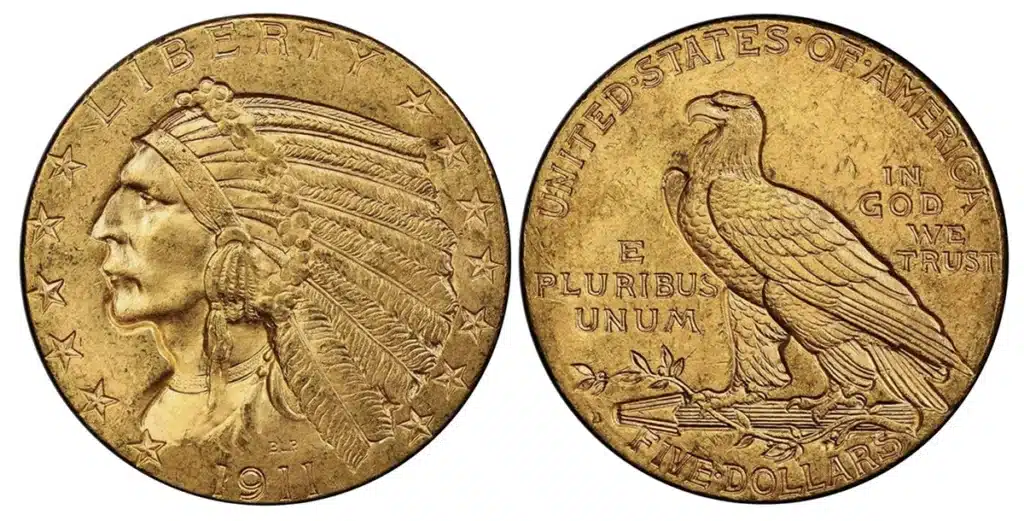
In the 11/2023 Stack’s Bowers sale of Fairmont gold coins, a PCGS MS63 example brought $22,800. In March 2019, Stack’s Bowers sold a PCGS/CAC MS63 for $36,000.
And what about the popular 1909-O $5? In the recent sale, a nice PCGS MS62 brought $28,800. In 11/2022, the same date in the same grade brought $31,200, while another PCGS MS62 brought $50,400 in the 4/2022 SB auction. This date is clearly trending downwards, and I believe that as more come onto the market, it will drop further in price.
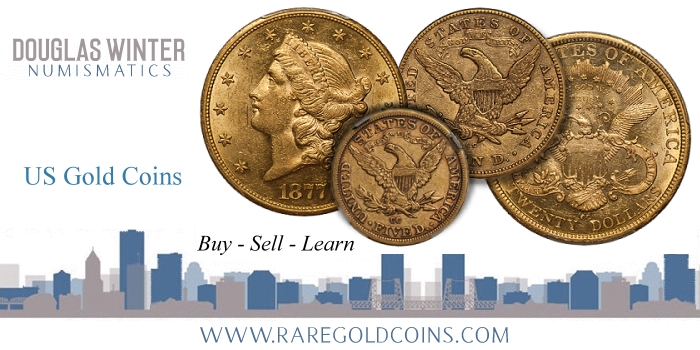
* * *
* * *
The post Five Observations About the November 2023 Fairmont Gold Sale appeared first on CoinWeek: Rare Coin, Currency, and Bullion News for Collectors.
U.S. Mint 2023 Uncirculated Coin Set Released With Reduced Limit
Just in time for holiday gift-giving, today the United States Mint unveils one of its most sought-after annual offerings
US Currency Realizes Over $2.8 Million in Stack’s Bowers Auction
The Stack’s Bowers November 2023 US Currency Auction, the Official Auction of the Whitman Coin and Collectibles Expo in Baltimore, realized more than $2.8 million USD (all prices including buyer’s fee).
One highlight from the selection of rare Continental and Colonial issues was a rare CC-9 Continental $20 note graded PMG Choice About Uncirculated 58* EPQ printed on marbled paper supplied by Founding Father Benjamin Franklin, who also personally drew its motifs. This note realized $156,000.

A Fr. 2231-C. 1934 $10,000 Federal Reserve Note graded Choice Extremely Fine 45 and pedigreed to poker player Johnny Chan realized $180,000. A Fr. 2221-G. 1934 $5000 Federal Reserve Note graded PMG Choice Extremely Fine 45 achieved the same result.
A PA-45. Pennsylvania. August 10, 1739 20 Shillings graded PMG VF-35 sold for $55,200 due to strong demand. One of only two uncirculated examples of the Fr. 1132-L. San Francisco 1918 $500 Federal Reserve Note, graded PMG Choice Uncirculated 64, went for $150,000, and one of only 10 examples of the Fr. 1218f. 1882 $1000 Gold Certificate in private hands, graded PMG Very Fine 25, garnered $204,000.
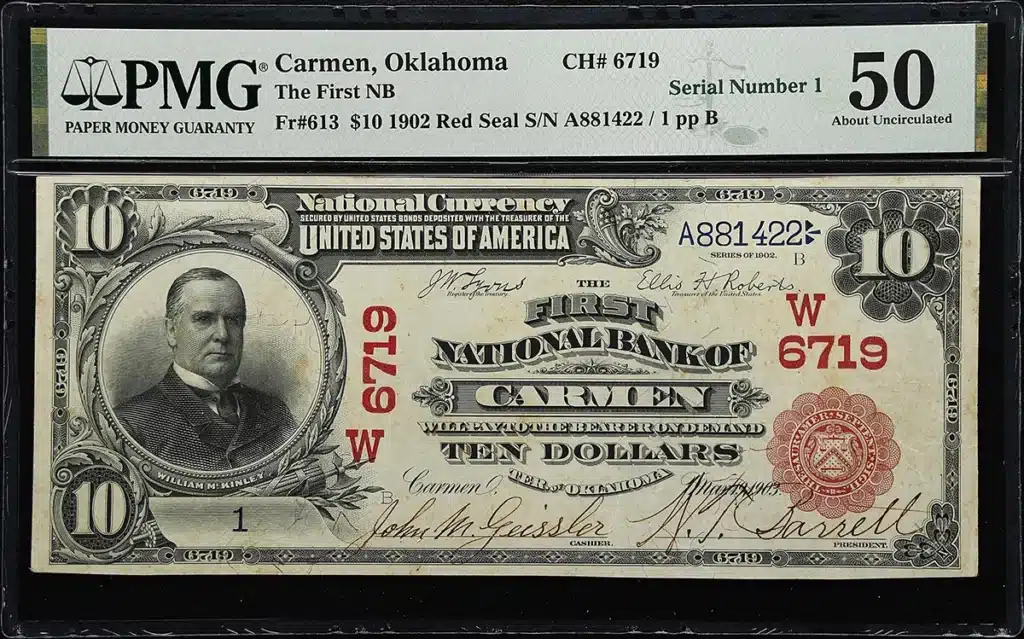
An extremely rare piece of US currency, a 1902 $10 Red Seal National Bank Note from the First National Bank of Carmen with serial number 1, achieved $57,600 at the auction, and a rare Fr. 1186. 1906 $20 Gold Certificate graded PMG Gem Uncirculated 66 EPQ earned $31,200. An 1899 $5 “Chief” Fr. 281m Silver Certificate graded PMG Superb Gem Uncirculated 67, the finest certified at that service, went for $36,000.
A complete list of hammer prices from the November US Currency Auction is available at StacksBowers.com. Stack’s Bowers is now accepting consignments to their Official Auction of the Spring 2024 Whitman show, their summer Global Showcase Auction as an official Auctioneer Partner of the ANA World’s Fair of Money, and upcoming Collectors Choice Online (CCO) auctions. For more information or to consign your coins to a future sale, contact Stack’s Bowers Galleries at Consign@StacksBowers.com or call (800) 458-4646.
* * *
The post US Currency Realizes Over $2.8 Million in Stack’s Bowers Auction appeared first on CoinWeek: Rare Coin, Currency, and Bullion News for Collectors.
Finest 1815 B-1 Quarter Highlights Heritage US Coins Auction

Engraver John Reich emigrated to the future United States shortly after the Revolution against Great Brtain. His medal work made an impression on Founding Father Thomas Jefferson, which led to a position at the United States Mint in Philadelphia. It was here that Reich created the Capped Bust that appeared on numerous denominations of federal coinage–from the large cent to the $5 gold half eagle–for decades.
The finest-certified 1815 B-1 Quarter Dollar, CACG MS67, is one of the outstanding highlights of Reich’s work that appear in the December 14-17 US Coins Signature Auction from Heritage. NGC reports one other grading event for this coin at MS67, but that coin has traditionally been judged inferior to this example, pedigreed to famous collector “Colonel” E.H.R. Green. Green was a London-born, New York millionaire by inheritance who knew President William McKinley, brought the first automobile to the state of Texas, and as a stamp collector owned the entire sheet of “Inverted Jennies”.
An 1864-S Liberty Eagle, XF40 NGC is the rarest S-Mint Ten and the second-rarest Liberty Head Ten. It is the only example with a grade of 40, with only four coins reported in higher grades. Early on, the San Francisco Mint focused predominantly on $20 gold double eagle production, which was thought the most effective way to convert enormous amounts of gold bullion into coins. San Francisco produced just 2,500 Liberty eagles in 1864, coins that saw circulation in the West when gold coins rarely circulated in the East. Today, the 1864-S is still an absolute rarity. PCGS CoinFacts gives an estimate of the surviving population at 22 to 26 pieces, in all grades. Both NGC and PCGS together have certified 40 examples, though this number certainly includes resubmissions and crossovers.
An 1853-D Liberty Half Eagle, MS64+ PCGS. CAC, is also featured in the auction. This specific coin is tied with one other MS64+ example at PCGS as the finest certified.
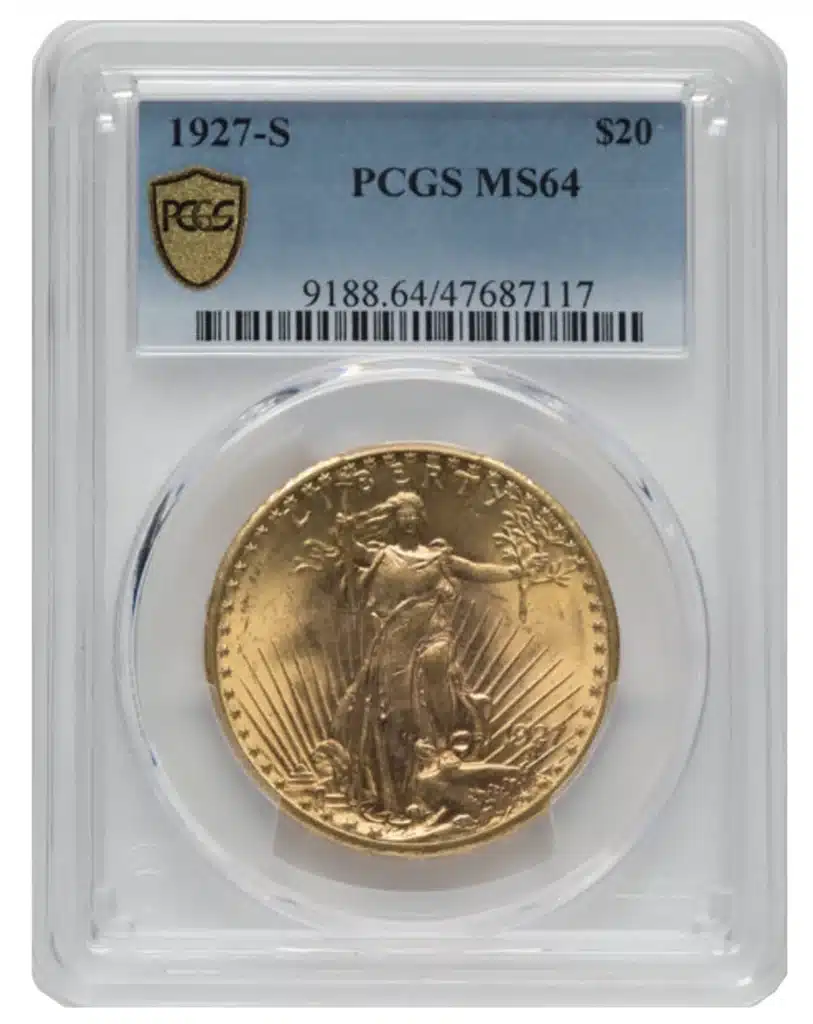
Another highlight is an amazing example of the popular 1927-S Saint-Gaudens Double Eagle. It was believed in the 1940s to be the fourth-rarest Saint-Gaudens $20 gold double eagle, behind the 1924-D, the 1926-S and the 1926-D. But 1927-S double eagles were used in foreign trade, putting them out of reach of the federal recall in 1933. After the end of World War II, coin dealers began to import these $20 Saints from abroad. But only a few 1927-S double eagles were discovered in these foreign banks, and they remain a conditional rarity in MS65 and higher.
Heritage will also sell the only 1855 Gold Dollar that NGC has certified as MS66+. The Type Two design was introduced in 1854, which not only feature an “Indian princess” on the obverse but were also struck on thinner planchets with larger diameters. Unfortunately, this resulted in strike problems that necessitated a second redesign in 1856 and made the Type Two a highly desierd collectible.
For more information on the 1815 B-1 Quarter and all other lots in the sale, click here.
* * *
The post Finest 1815 B-1 Quarter Highlights Heritage US Coins Auction appeared first on CoinWeek: Rare Coin, Currency, and Bullion News for Collectors.
Ron Drzewucki Takes on the Role of President at CAC Grading
CAC Grading, LLC (www
Gem 1876-S Trade Dollar Among Highlights at David Lawrence
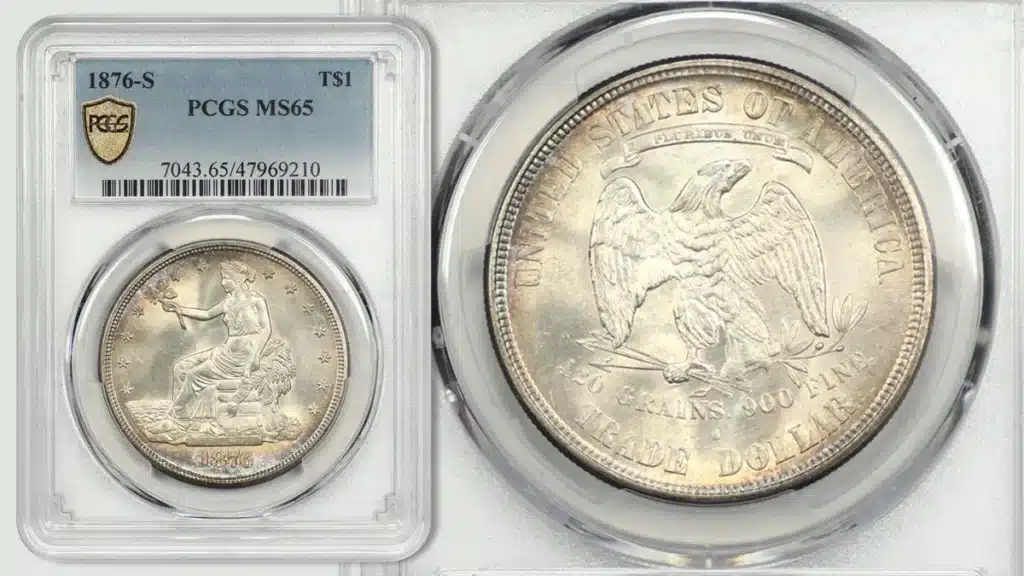
The more than 475 lots in the Sunday, December 10 Online Auction from David Lawrence Rare Coins (DLRC) is open for bidding – including 225 No Reserve and 40 Recently Reduced items.
PCGS-, NGC-, and CAC-certified highlights include a Gem 1876-S Trade Dollar PCGS MS65; a key 1879-CC $1 PCGS/PQ MS65; an original 1887 $3 PCGS/CAC PR63CAM; a 1913 $5 NGC MS65; a 1907 $20 High Relief PCGS MS63 (Flat Edge); and a tied-for-finest 1938-S Texas commemorative half dollar PCGS MS68.
Make sure to look for something that catches your eye before closing on Sunday, December 10.
Ready to Sell Your Rare Coin or Collection?
Like the Gem Mint State 1876-S Trade Dollar and other rare classic and modern U.S. coins offered above, David Lawrence Rare Coins always needs coins. When you are ready to sell, we’re here for you. David Lawrence offers three options that provide maximum flexibility to meet your needs while providing the highest quality personal service in the industry:
- You can sell your coins to us outright.
- You can consign your coins.
- You can participate in our Guaranteed Auction Program.
David Lawrence Rare Coins Consignment Special
Check out our Collector Consignment Special! We are offering the following options that can be combined, or adjusted for your specific needs:
Maximum Returns – For coins over $10,000, consign with a reserve and receive 90% or consign with no reserve and receive 92%.
Immediate Cash Advance – For collections over $10,000, receive an immediate cash advance of up to 75% on unreserved consignments.
Fastest Turnaround – We will get your coins to auction within 3-5 business days of receipt, ending in approximately two weeks.
Standard terms still apply:
- Coins from $1,000 to $10,000 – consign with a reserve and receive 85%; consign with no reserve and receive 90%
- No fee guarantee – no listing fees, no imaging fees, and no buyback fees
- Fast payment – payment within 30 days of sale; for this promotion, we can accelerate payment to two weeks in most cases
* * *
The post Gem 1876-S Trade Dollar Among Highlights at David Lawrence appeared first on CoinWeek: Rare Coin, Currency, and Bullion News for Collectors.
Gold Prices Rally Early, Then Fall from Record High
Prices for precious metals dropped on Monday, with silver leading the way with a 3

Numismatic Crime – Major Thefts From Dealers After Coin Shows
Recent Alerts from Doug Davis – Founder & President, Numismatic Crime Information Center (NCIC) ……
Facebook Counterfeit Bullion Suspect Arrested in Alabama
A Sylacauga, Alabama man has been arrested for selling counterfeit gold bars. Dylan Jemison was arrested after selling counterfeit carded gold Argor Heraeus bars to individuals on Facebook Marketplace. The suspect was in possession of dozens of counterfeit bars. Jemison was charged with a third degree felony.
The Anti-Counterfeiting Task Force (ACTF) is seeking additional victims who might have come into contact with this suspect.

Major Dealer Theft After Canadian Coin Show
Dealer Pieter Liem of the Coin and Currency Exchange was the victim of theft after leaving the recent Nuphilex Coin and Stamp Show in Montreal, Canada on November 5, 2023. The victim stopped in Kingston, Ontario, where the suspect or suspects removed several bags from Liem’s vehicle. The stolen bags were tracked to an apartment in Montreal but trackers were disabled shortly before authorities arrived. It is believed that the suspect/suspects and stolen inventory is in the Montreal or greater Quebec area. The investigation is on-going and further details will follow.
A partial list of stolen inventory:
- 10 ounces of gold in RCM coins
- Emirates gold one ounce bar
- Platinum 1/10th oz-1oz set
- 400 one ounce silver bullets
- 19 2-ounce silver bullets
- 4- 5-ounce silver bullets
- 2-10-ounce silver bullets
- 500- 1-ouce silver coins ( maples, ASE, Pandas, Kangaroos, Kookaburras, Libertads)
- 60 sets 1 cent-$1 from 1961-67 in hard plastic holders
- 300-500 graded bank notes
- 1969 Specimen $20 bill with Serial #1
- Devils Face $1000 PCGS 53
- Various Chartered Banknotes
- Large number of slabbed World Bank notes Indonesia, Bahamas, Netherlands, France, England, Zimbabwe, Ireland, Scotland, Timor
- U.S. currency $85,000 including several mint packs of $5, $10 and $20’s
- Canadian currency $30,000
- Key date Morgan and Peace dollars and many other coins
Dealer Theft After Pennsylvania Coin Show
A dealer attending the Meadville, Pennsylvania coin show on November 5, 2023, was packing up after the show and when he left the bourse floor to get his vehicle, an unknown suspect took two black catalog-style carrying cases containing gold coins from his table. The suspect left and video shows a second suspect waiting outside. Investigators are reviewing video for photos and possible suspect vehicle.
A partial list of the stolen coins:
- American Eagle sets 4 coins each
- 12- Gold coins type set
- 1990 Proof Eagle set in box (5 coin set)
- 2008 Gold Buffalo 4 coin set
- 2-Rolls 1/10 gold Eagles, Krugerrand, Maples
- 4-1986 gold 1/10 Eagles
- 4-Gold ¼ oz Eagles
- 1904 20 Dollar Gold ANACS MS Details
- 1924 20 Dollar Gold ANACS 7205024
- 1907 10 Dollar AU50 5138343
- 1908-S 10 Dollar VF35 4631216-031
- 1909-D 10 Dollar EF40 5154527
- 1913 10 Dollar EF45 7545015
- 1913 10 Dollar AU53 25542313
- 1926 MS61 10 Dollar 222391-005
- 1881 10 Dollar A-56 7125549
- 1881-S 10 Dollar AU58 5153517
- 1961 10 Dollar HS 02 6677686-001
- 1882 10 Dollar AU50 Details 7355676
- 1894 10 Dollar AU55 7355077
- 1907 10 Dollar AU50 Details 5138343
- 1881 5 Dollar AU55 5287398
- 1881 5 Dollar AU55 5013180
- 1882 5 Dollar AU50 528746
- 1893 5 Dollar AU50 5212689
- 1893 5 Dollar AU53 7185550
- 1893-CC 5 Dollar AU Details 6677686-004
- 1895 5 Dollar AU53 5287397
- 1895 5 Dollar AU58 Details 7546423
- 1900 5 Dollar AU50 cleaned 7546427
- 1901-S 5 Dollar AU58 5153515
- 1908 5 Dollar AU50 NGE 634496-001
- 1911 5 Dollar AU58 5229647
- 1912 5 Dollar AU58
- 1913 5 Dollar Details 5957140-004
- 1903 2.5 Dollar A55 cleaned 5229646
- 1908 2.5 Dollar AU58 Details 5153875
- 1910 2.5 Dollar AU53 5211854
- 1911 2.5 Dollar AU50 Details 7396013
- 1911-D 2.5 Dollar AU55 NGC 2599252-001
- 1912 2.5 Dollar AU55
- 1914-D 2.5 Dollar AU55 5138213
- 1927 2.5 Dollar 1CG
- 1926 2:5 Dollar AU58 5213042
- 1927 2.5 Dollar AU58 735503
- 1928 2.5 Dollar AU58 7546430
- 1906 20 Franc AU55 Details 5155112
- 1854 1 Dollar AU Details 6677686-008
- 651AD Byzantine Heraditus (Type 2?) Gold Coin
- 651AD Byzantine Gold Coin Maurtiberi
Lost/Stolen from Mail: USPS – California to Florida
A package being sent overnight via USPS has been reported lost/stolen. The package was last scanned in Boca Raton, Florida.
The package contained the following two notes:
- $50 gold certificate star note in a PMG 12 holder Serial #00008795A
- 1935-F $1 star note with serial number *65399715F
Stolen from Mail: USPS – New Jersey to California
A package shipped USPS from New Jersey to California has been reported missing/stolen. The package was received damaged and contents missing.
The package contained the following coin:
- 1888-O TOP-100 $1 Vam-183 DBO Scarface LDS NGC MS63 6510768-001
Stolen from Mail: USPS – Austin, Texas
A package shipped to Austin, Texas has been reported stolen. The package was delivered and stolen from the recipient’s public mailroom.
The package contained the following coins:
- 3- 1986 Silver Eagle NGC MS70 Cert# 6615570-002,003,004
- 1- 1987 Silver Eagle NGC MS70 Cert# 6615570-007
- 7- 1988 Silver Eagle NGC MS70 Cert# 6615570-017,018,019,020021,022,023
- 3- 1990 Silver Eagle NGC MS70 Cert# 6615570-024,028,032
- 1- 2000 Silver Eagle NGC MS70 Cert# 6615570-036
* * *
Please contact the Numismatic Crime Information Center’s Doug Davis if you have questions or information about any of the cases above. You can reach him at (817) 723-7231, or email him at doug@numismaticcrimes.org.
The Numismatic Crime Information Center (NCIC) is a 501(c)(3) non-profit corporation whose mission is to serve as a national and international resource for collectors, dealers and law enforcement in the education, prevention and investigation of crimes involving coins, paper money, tokens, medals and related numismatic items.
NCIC disseminates current crime related issues to the numismatic industry and provides local, state and federal law enforcement agencies with the fundamental investigative techniques, knowledge and understanding to respond effectively to the complex challenges encountered during a crime.
* * *
The post Numismatic Crime – Major Thefts From Dealers After Coin Shows appeared first on CoinWeek: Rare Coin, Currency, and Bullion News for Collectors.
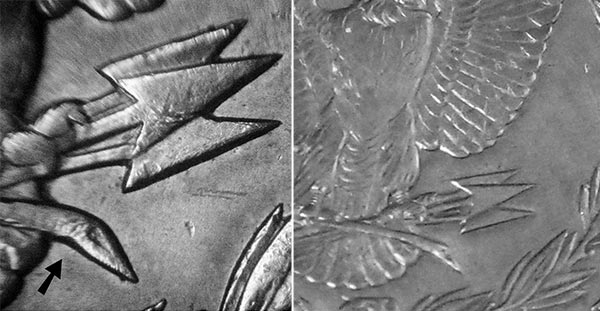
The 1964 Morgan Dollar Hubs : A Design Analysis
By Leroy Van Allen, Special for CoinWeek …..
In November 2016, CoinWeek Editor Charles Morgan sent me an e-mail with three overall photographs of the two Morgan dollar hubs dated 1964 recently found by numismatists at the Philadelphia Mint. He wanted to know if I had any information on these hubs. This was the first time I had seen the photographs.
It resulted in a short examination and research on the history of these hubs. My search led to the excellent book by Roger W. Burdette entitled A Guide Book of Peace Dollars by The Official Red Book (Whitman, 2008). A chapter covered the 1964-D Peace dollar evolution in detail, with many quotes and references to the United States Mint letters and memoranda.
There was no mention of the specific preparation of these two 1964 Morgan dollar hubs in this chapter. However, there were several correspondence and letters cited that included the possible reuse of the old pre-World War I silver dollar design. Mint Director Eve Adams sent a memorandum dated February 18, 1963 to Secretary of the Treasurer Robert Wallace about the problems of manufacturing additional silver dollar supplies in the near future as present supplies were being sent into circulation.
During the following months, Western state senators, led by Senate majority leader Mike Mansfield (D-MT) wanted more silver dollars struck to maintain the supply and provide for continued Western use of silver dollars.
The Adams memorandum on July 31, 1963 states that a decision had been made for the Mint to produce silver dollars when the present supply was exhausted. She added that it would be advantageous to reuse one of the old designs to discourage collector interest, preserve the traditions of the artistic beauty of the older dollars, and affect savings as the Mint retains the old designs, thus eliminating the preparation of new designs and models. Wallace repeated Adams’ recommendations in a memorandum for Secretary Dillon and added to re-issue the pre-World War I Liberty Head design.
This was the first mention of using the Morgan silver dollar design.
The U.S. Mint letter of September 27, 1963 suggested that Fern Miller, Superintendent of the Denver Mint, prepare for dollar production. The Denver Mint coining division noted in a letter of October 15, 1963 that they had 32 leftover reverse dies for the years 1934, 1935, and 1936. These dies were received by the Philadelphia Mint on September 17, 1964, but the dies were in poor condition and were to be destroyed. The last mention of using the pre-WWI Liberty Head design was in a letter from Director Adams to Treasurer Wallace on April 9, 1964.
So between April and September 1964 when the leftover Peace dollar dies were received, a decision had been made to use the Peace dollar design instead of the Morgan dollar design, possibly because of the reverse Peace dollar dies’ availability. The manufacture dates stamped on the Morgan dollar hubs are 12-6-63 for the obverse and 12-13-63 for the reverse. So they were prepared shortly after the U.S. Mint’s letter to the Denver Mint on September 27, 1963, to plan for dollar production.
Examination of Two 1964 Morgan Dollar Hub Photographs
The first impression of the photographs of the two hubs is a very good rendition of the obverse and reverse design. There were no existing hubs or working dies of the pre-WWI Morgan dollar since all previous hubs and dies were destroyed by the Mint in 1910. The most accurate rendition available therefore were the struck Morgan dollars. Photograph enlargements of the obverse and reverse of the coin of six to eight times could then be traced onto a plaster basin (plastilene) to prepare a positive model, complete with letters and the new date of 1964.
It is not known whether the Chief Engraver or an assistant engraver prepared the models and subsequent steps to the final hubs.

Once the positive model was checked over and approved, a negative plaster mold was prepared. Then the 1963 standard hub preparation steps followed to saturate the plaster mold with hot beeswax in an oven, cover it with copper dust, electroplate copper onto the mold, separate the copper shell from the mold, and back it with plaster to form a galvano. Then a Janvier reducing lathe transferred the galvano design down in size to the hub face. The hub was touched up to remove tool marks, turned down in a lathe, and then heated and quenched to form a hardened hub.
Only one hub of obverse and reverse was made since they could make enough working dies for the anticipated coin production of 45 million silver dollars.
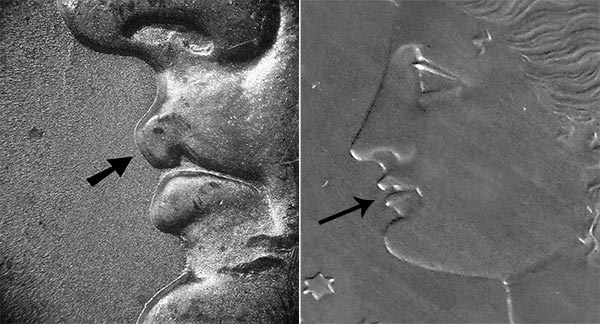
The next questions are the quality of the design reproduction, the accuracy of the Morgan dollar design, and any noticeable design differences or flaws.
The first step was to enhance the two available obverse and reverse photographs with a computer photograph program. It turned out that the photographs of the two hubs were taken at a slight angle with the hub face’s middle in focus but the top and bottom parts slightly out of focus. So detailed examination was confined mainly to the clearer photograph center slice. The obverse hub was of the III3 type design used from 1879 through 1904, with unevenly divided ear rear. The hair strand fineness appeared to match the normal Morgan dollar, but it could not be determined if the wheat leaves had the required fine lines or the cotton bolls with dots. The peripheral lettering appeared to match closely the letter designs of a Morgan dollar coin, but the letters at the top could not reliably be checked based on the photographs.

An obvious slight design difference was noted in the Liberty Head lips, with the hub upper lip protruding more and a straight line design edge from the lower lip to the chin instead of a correct curved edge.
For the reverse, the most noticeable feature of the design type was the seven tail feathers and a wide round gap at the eagle’s left wing and neck of the C4 type design reverse. This type was used on some 1900-P; 1901-P, -O, -S; 1902-P, -O, -S; 1904-S and all 1903-P and 1904-P, -O issues.

The somewhat fuzzy image of the olive at the top of the left end of the olive branch appeared to have two parts. Both the C3 and C4 normal reverse have only a single olive of slightly different size and design. It is possible a so-called “two olive reverse” of a dual hub C4 over C3 reverse coin was copied. The dual hubs were used on some 1900-P, -S; 1901-P, -O, -S; 1902-P, -O, -S; 1903-O, -S; and 1904-S issues.
Another noticeable design difference was the right end of the olive branch that had a long, curved bottom edge instead of the correct slight bend and longer than normal appearing arrow shafts near the arrowheads.
Some of the reverse lettering had slight differences, such as thicker serifs and thinner vertical shafts.
Conclusions
As expected, the U.S. Mint Engraving Department at Philadelphia prepared an excellent accurate copy of the pre-WW I Morgan dollar design without noticeable roughness, extraneous lines, or surface flaws. It was likely a copy of an existing Morgan dollar coin since all prior hubs and dies were destroyed in 1910.
The obverse was of the correct III3 type used from 1879 to 1904 with only slight differences noticed at the Liberty Head lips.
The reverse was of the correct C4 type used from 1900 to 1904. There were slight design differences from the normal design at the right end of the olive branch, the arrowhead shafts, and the peripheral lettering of thicker serifs and thinner vertical bars. It possibly had two olives at the top of the left side of the olive branch evident on some dual hub dies of the same period of 1900 to 1904.
* * *
The post The 1964 Morgan Dollar Hubs : A Design Analysis appeared first on CoinWeek: Rare Coin, Currency, and Bullion News for Collectors.

Can This AI Collecting App Correctly Identify and Grade Coins?
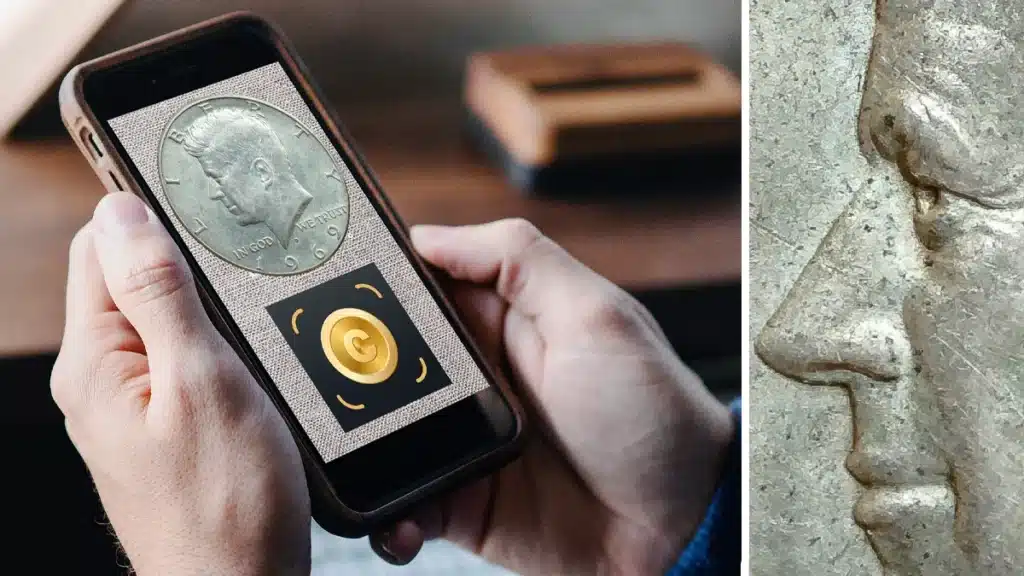
By Austin Purvis for CoinWeek …..
Collectors and dealers have traditionally needed experience, knowledge, and a keen eye to accurately identify and grade coins. While this is still true, new tools and technology are constantly being developed and improved that may impact the hobby significantly. One of those technologies is “Artificial Intelligence”, or AI.
The company Next Vision Limited is an AI technology group that developed the mobile collecting app CoinSnap. CoinSnap is described on the app store as a tool “that utilizes AI-driven image recognition technology to accurately identify any coin” and “has a coin grading feature and gives a reference price for each coin.” At the time of publication, the app has over one million downloads on the Google Play store and is the #3 reference app on Apple.
How accurate is this AI tool? We used the coin collecting app for an afternoon, and here is what we found.
How CoinSnap Works
After opening the app, users are asked to sign up for a subscription but they can still use the app on a free seven-day trial period. Note: you will need to cancel your trial before it’s over to avoid being charged for the application. For this test, the free version was used.
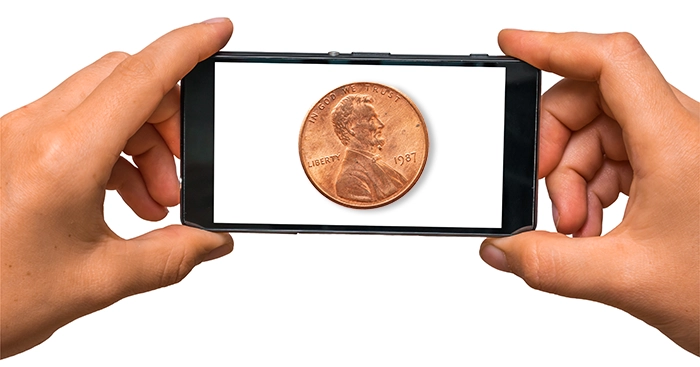
At the main menu, users can click a camera button at the bottom of their screen to immediately open the identification feature. Additionally, there are “Grade my coin” and “Identify my coin” options at the top of the screen. Users are asked to take obverse and reverse pictures of their coin or upload an image from their phone gallery. The app will then match these images to the information on their database to provide a result. The app offers an overview of the coin, including its name, country of origin, and year of issue, among other important details.
The grading option works exactly the same as the identification option, but the results also include a grade that the AI has determined the coin falls under based on the image provided. Note: this result does not include a number along with the grade. For example, a user would be shown an estimated grade of “MS” (Mint State), not “MS-65”. Users are given a price range that the coin may fall under and are prompted to provide mint mark and date information to receive a more accurate price estimate.
A Note on Privacy While Using CoinSnap
Since this application requires user information and content uploads, anyone who is interested in trying this application should be aware of and read the Terms of Service and Privacy documents. Below is a brief analysis but not a comprehensive overview of these policies.

While it reads like many user agreements one would typically see on applications, users should be aware of the following:
The Privacy Policy goes over what information the application collects from your device and states that cookies are used by Next Vision and third-party services. These cookies have permission to collect data from you, which could include web pages visited by the user, and time spent on websites. Next Level also states: “We are not responsible for the privacy practices of these third parties, and the information practices of these third parties are not covered by this Privacy Policy.”
The Terms of Services agreement states that when using the application, you grant Next Vision “a worldwide, non-exclusive, irrevocable, royalty-free, fully-paid, perpetual, sublicensable (through multiple tiers), fully transferable license to use, distribute, reproduce, create derivative works from, publish, translate, publicly perform and publicly display any Content that you upload or publish.” Effectively, you do not have exclusive ownership rights to the photographs of coins you submit to this application. That is an extremely important detail for dealers or collectors who may have paid for high-quality photographs of coins to consider before they submit those same images to this application.
It is also part of a larger trend of developers teaching their AI to work better (and therefore make them more money) using datasets of other people’s information without fair compensation in the currently under-regulated AI field. Just look at news reports of how image-rendering AI is exploiting copyrighted material from artists for an indication of where this could be going. Use your own better judgment, but you should be doing that whenever you use apps on your phone anyway.
As of the publication of this article, there are no news reports or press releases that would indicate any issues with Next Vision Limited’s data security. On the CoinSnap website FAQ, Next Vision answers the question “Is my information safe?” with the following response:
“We are cautious about sharing personal information. Although we require access to your photo gallery, we never process any photos without your permission. Rest assured that we will NEVER share your information with anyone.”
That being said, users should always be aware of how their data is being used with any application, so read the Terms of Service and Privacy Policy. Additionally, you should never provide critically important information (financial account numbers, social security numbers, etc.) to an unknown application or entity.
Putting an AI Coin Collecting App to the Test
To test the app ourselves, we scanned 15 coins: 10 uncertified and five certified. Each coin was photographed in the same set-up, and each coin was scanned three times. This test could benefit from more coins to create a larger sample size, and we already have plans to test this app further.
The uncertified group included the following coins: U.S. coins in circulation (a penny, a nickel, a dime, a quarter); a U.S. Presidential $1 coin; a South Korean won; an Australian silver dollar; an Eastern Caribbean 25-cent piece; and a commemorative United States half dollar.
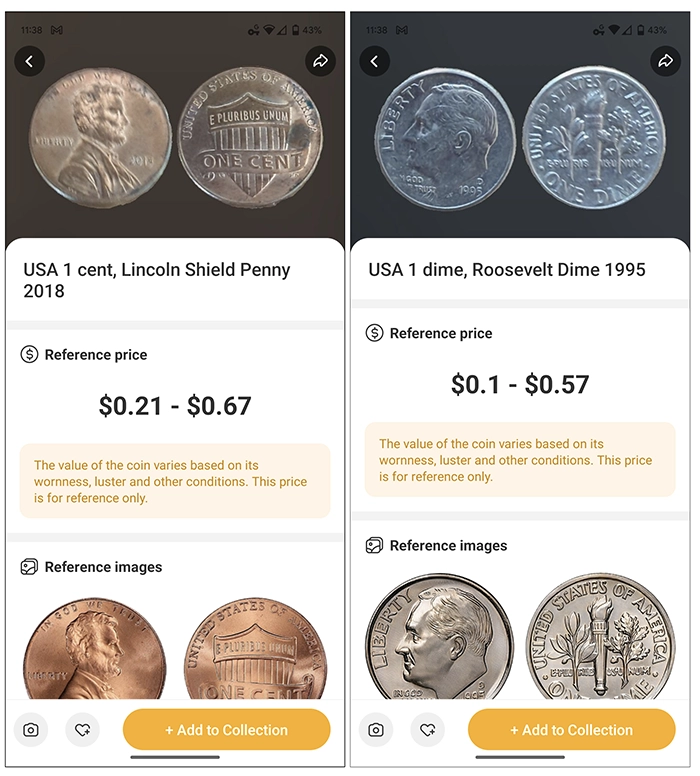
Four of the certified coins were all graded MS and included a Buffalo nickel; a Morgan dollar; a Peace dollar; and a Mercury dime. The final coin was an ancient Roman T. Quinctius Flamininus silver denarius graded XF. In total, we tested three coins certified by PCGS and two graded by NGC.
CoinSnap was able to accurately identify 14 out of the 15 coins provided, coming to 93% accuracy. The coin it was unable to identify was the single ancient coin, graded by NGC. To explore this further, we took ancient coin images from our latest article from Mike Markowitz and submitted them. The app was not able to accurately identify any of these additional coins. The app provided a list of potential matches for these coins, spanning from other ancient coins that were incorrect to a Canadian one-cent piece.

While anecdotal, these results seem to suggest the ancient coin category within the AI model needs additional training.
As for the grading tool, CoinSnap was able to accurately determine the MS grade of both the Morgan and the Peace dollar but it provided contradictory grades for the Mercury dime and the Buffalo nickel (AU and XF). No grading results for the ancient coin were obtained because it could not identify the coin. For this modest test group, only 40% were graded correctly.
Can the CoinSnap AI Accurately Identify and Grade Coins?
Based on these results, it seems that this AI collecting app can be extremely accurate when identifying many coins but significantly less so when faced with ancient coins and niche examples. Especially with popular series/types of U.S. and world coins, CoinSnap should be able to let you know what type of coin you have. Additionally, users should be aware that CoinSnap does not support the identification of errors or counterfeits at this time.
As for grading, there are a couple of factors to consider. First and foremost, many aspects of coin grading can be subjective, so translating what an experienced dealer, grader, or collector may value into a specific AI model could be difficult. One grader may interpret a detail on a coin differently than another. There has also been debate among experts on certain coins as to whether they are over-graded or under-graded. While certain objective measures of quality exist that a computer may be able to identify, the nuances of grading may be lost when asking an artificially intelligent program of the current generation to do it.
Photo quality is also a huge factor when using this app.
While quality was controlled for this test, the ability of the AI to identify details on the coin naturally depends on the quality of the photo. This means the grade offered by the app may be more of a reflection of your photography skills and/or the quality of your camera than the actual grade of the coin.
Another idea to consider is the strength of the AI model that CoinSnap is utilizing to identify different coins or grade coins. AI programs are “trained” by being given data (photographs, text, etc.). They use these data points to better understand something, like how the obverse and reverse of a coin may look (with different dates, conditions, et al.). Using this data, the application can compare user-provided input against the database of information it was “trained” on. The more examples an AI has been given, the better the program will be at performing its desired function. So if AI is poorly trained (low data quality, or too little data), then it won’t produce accurate results. This application has an option for users to provide input if the results they received are wrong, which can also help further train the AI model.
A final idea to consider is the following hypothetical: if the photo provided is excellent quality, and if the AI has been accurately trained, then, ceteris paribus, is the grade CoinSnap gives more accurate than a grade given by a third-party grading service? This debate spans many areas, as AI and computer learning challenge the conventional anthropocentric approaches of many industries. AI is now helping doctors diagnose diseases, businesses handle complicated logistics, and factories automate many tasks. So one may ask: can a computer grade a coin better than a human? Let us know in the comments.
Final Thoughts
Overall, CoinSnap seems to be a useful option for people in the hobby, especially if you’re new to coin collecting. Using this app for the simple identification of coins found in an attic or inherited by a relative would be extremely helpful for people with limited numismatic knowledge. The AI grading tool could potentially help a new collector get an idea of quality, but it probably should be confirmed by a trained eye if you are considering selling the coin with confidence. As for veteran collectors or dealers, we say the jury is still out. Along with the concerns raised earlier, these two groups would usually be able to identify a coin and would have an idea of what to look for grade-wise. Look out for future articles as we continue to explore this app and any additional improvements that roll out.
* * *
The post Can This AI Collecting App Correctly Identify and Grade Coins? appeared first on CoinWeek: Rare Coin, Currency, and Bullion News for Collectors.
1865 Two Cent Piece : A Collector’s Guide
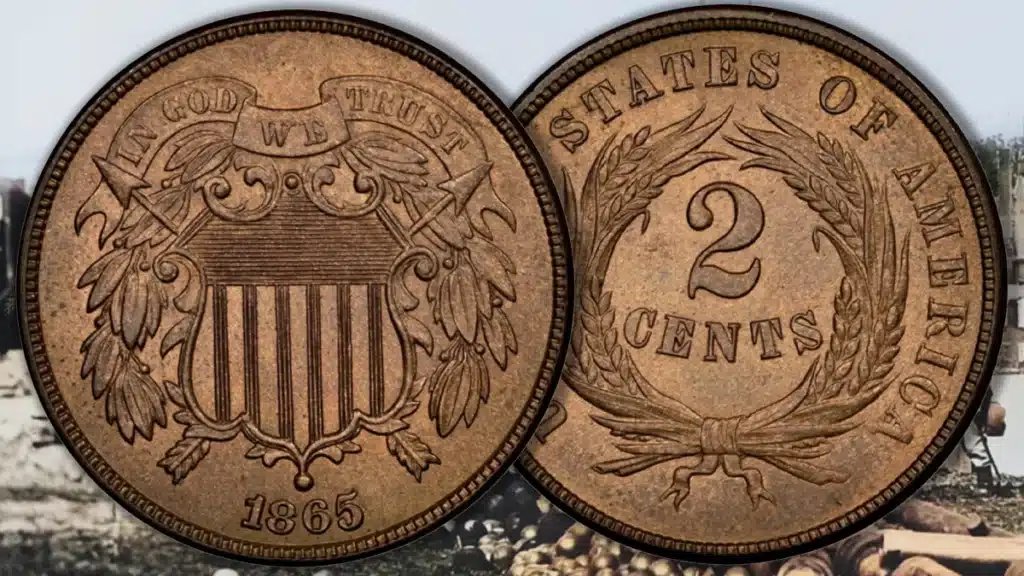
First struck in 1864 in an attempt to solve the nationwide coin shortage, caused by the onset of the U.S. Civil War, the Two Cent piece never truly caught on and suffered from a consistently shrinking mintage. As only the second issuance, the 1865 type still had a significant mintage of 13,640,000 specimens (for comparison’s sake, the Mint would strike only 3,177,000 coins in 1866, a further 77% decrease). As such, the 1865 is the second-most-common date after the 1864 Large Motto type. The years of high mintages ended with the conclusion of pitched battle and the slow release of hoarded coins, a process that gradually negated the need for this odd denomination.
In God We Trust Is Adopted on Other Coins
The major innovation resulting from this denomination was the use of the motto “In God We Trust”. So popular was this new addition that Congress passed legislation on March 3, 1865 to mandate its placement on all coins large enough to contain it. Implemented in 1866, this included all gold coins as well as the silver dollar, half-dollar coin, and quarter, as well as the three-cent nickel. Later, in the Coinage Act of February 12, 1873, Congress ordered the motto be “inscribed on such coins as shall admit” it.
1865 Two-Cent Piece Varieties Worth Collecting
Adding interest to this date for type collectors is the large number of die-punch varieties, the two most famous of which are the Plain 5 and the Fancy 5. The Plain 5 displays a normal crossbar on the five in 1865, while the Fancy 5 has a distinctly curved or flipped arm. While PCGS did not denote this until recently, they have now begun offering the designation. Since then, the combined population of PCGS and NGC Fancy 5 1865 Two Cent coins totals only 427 pieces, of which 44 total are designated as Red (RD) (the rest being either Brown (B) or Red Brown (RB)). Interestingly, NGC only records one Fancy 5 1865 RD example, graded MS 66.
How Much is the1865 Two-Cent Piece Worth?
Like all copper coins, the 1865 Two Cent piece’s value is heavily dependent on its grade and, if in Mint State, its color designation. As a result, if a collector is not particular about having an RD-designated coin, then it’s relatively easy to find a BN or RB example in up to low Mint State grade. In lower circulated grades, the 1865 Two-Cent piece is worth about $15 to $20. This price increases to $50 to $85 in high circulated grades.
Coins certified by CAC, NGC, and PCGS will sell for a premium. An October 2023 listing on eBay for a PCGS-graded 1865 Two-Cent piece graded AU55 sold for $131. In November 2023, an NGC AU53BN sold for $120.
Fully red examples are relatively easily available in grades up to MS 65. However, the total combined population of all RD examples in MS 66, graded by both NGC and PCGS, consists of only 72 coins. From this total, CAC has approved 25 coins. To date, CAC has not yet encapsulated coins in its own holder at this grade. Meanwhile, only three MS 67s are are reported at NGC and PCGS in both the Plain 5 and Fancy 5 varieties, making it a true condition rarity.
Collectors should be aware that while the Fancy 5 variety is slightly rarer than the Plain 5, it does not hold a significant premium. One MS67 Fancy 5 example, sold by Heritage Auctions in their January 9, 2014, sale, hammered for $25,850 USD. Despite being one of the first pieces to earn the Fancy 5 designation from PCGS, this coin proved to be an outlier. It displays the soft orange of a true red copper coin and is simply dripping with luster. Similarly nice examples that were graded MS 66+ earn less than half of the astronomical auction record. Instead, a MS 66+ RD Fancy 5 with an extremely sharp strike and smooth satin copper luster hammered for $10,200 in 2020. A coin with the same grade was sold in 2021 for $8,225; this coin, however, has a significant reverse die crack and die cud.
Design
Obverse:
As one of the few American coin series not to feature a bust on the obverse, United States Mint Chief Engraver James B. Longacre decided to use his own interpretation of the Great Seal of the United States as the main device. By focusing on the defensive shield with six vertical and 20 horizontal bars, the shield strikes a markedly different tone. The shield stands in front of a pair of crossed arrows, which, while martial in nature, actually represent alliance and friendship for many Native American cultures. Behind the arrows is the traditional symbol of victory, a laurel leaf. The date 1865 is placed in the empty field below the shield. Lastly, surmounting the entire design is a flowing banner with the motto “In God We Trust”. Taken cumulatively, the obverse is a visual display of the Federal Government’s drive to maintain the Union as the Civil War raged.
Reverse:
Centered on the reverse is an ornate wheat wreath, the arms of which encircle the denomination 2 CENTS written in two rows. The country name UNITED STATES OF AMERICA wraps around the reverse, covering more than three-quarters of the empty fields outside of the wheat wreath. Lastly, since the Philadelphia Mint was responsible for striking all Two Cent pieces, the design does not include a mintmark.
Edge:
The edge of the 1865 Two Cent piece is smooth or plain.
Designer
James Barton Longacre (1794-1869) was one of the most famous US engraver and medallic artists of the 19th century. Longacre was appointed the fourth Chief Engraver of the United States Mint by President John Tyler after Christian Gobrecht died in 1844. Before his appointment, Longacre worked for the Philadelphia engraving company Murray, Draper, Fairman & Co. until he began working for himself in 1819. As an independent engraver, Longacre produced a series of famous plates that featured the Founding Fathers, President Andrew Jackson, and Senator John C. Calhoun. Once he became Chief Engraver at the Mint, he produced such famous pieces as the Flying Eagle cent, the Indian Head cent, the Shield nickel, and the Coronet Head $20 double eagle gold coin.
Coin Specifications
| Country: | USA |
| Year Of Issue: | 1865 |
| Denomination: | Two Cents |
| Mint Mark: | None (Philadelphia) |
| Mintage: | 13,640,000 |
| Alloy: | 95% Copper, 5% Tin and Zinc |
| Weight: | 6.22 g |
| Diameter: | 23.00 mm |
| Edge: | Smooth |
| OBV Designer | James Barton Longacre |
| REV Designer | James Barton Longacre |
| Quality: | Business Strike |
* * *
Sources
https://www.govinfo.gov/content/pkg/CRPT-112hrpt47/html/CRPT-112hrpt47.htm
The post 1865 Two Cent Piece : A Collector’s Guide appeared first on CoinWeek: Rare Coin, Currency, and Bullion News for Collectors.
Gold Reaches Historic High as Silver Skyrockets for the Week
Gold prices rallied to an all-time high on Friday, marking a significant weekly gain, their third in a row
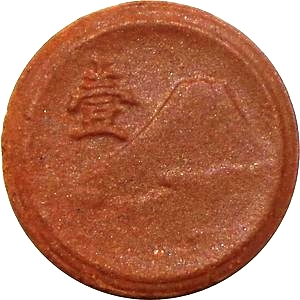
How World War II Created Strange and Unusual Coins

By Lianna Spurrier for CoinWeek …..
World War II affected coins almost everywhere around the world.
In the United States, the most dramatic effect that the war had on our coinage was the steel penny. The composition of our nickels changed as well, but that wasn’t an immediately noticeable change in the appearance of the coin. Both changes are well-known by collectors today.
But in other countries, the coinage was changed in much stranger and farther reaching ways than steel cents and partially-silver nickels. This article presents a sampling of the fascinating coin experiments conducted abroad.
The World War II Clay and Cardboard Coins of Japan
Japan got very creative with alternative materials, both at home and in some of the occupied territories.
The composition of the Japanese 1 sen coin began to change in 1938. Previously produced in brass, the copper percentage was reduced to create a bronze coin. Later the same year, they released a significantly smaller and lighter 1 sen coin struck in aluminum. This composition stuck and was used through 1943, though the size was reduced again in 1941. Between 1938 and 1941, the denomination shrunk from 23mm to 16mm, and from 3.75g to 0.65g.

The most dramatic change, however, occurred in 1945. As the end of WWII approached, Japan was suffering from a serious shortage of metals – wasting them on coins was not an option. Instead, they tested making experimental 1 sen coins from baked clay. They appeared red, and were produced by private companies for the mint.
Some patterns were made for other denominations, but the 1 sen clay coins are the only ones that may have circulated. According to Krause’s Standard Catalog of World Coins, they circulated for just a few days before the war ended and were quickly withdrawn. No other English-language source has been found that claims they were ever put into circulation, but it is known that significantly more 1 sen clay coins were made than any other of the test denominations. If the war had continued, they would have circulated.
Japan also minted coins for many external territories, and some of these were affected as well. The region known as Manchukuo (Manchuria), which now makes up the northeast section of China, was controlled by Japan from 1931 to 1945.
The Japanese Empire had been minting coins for the territory since 1932, but when metals became scarce, Manchukuo’s coins were an early casualty. In 1944, Japan began producing the territory’s 1 fen and 5 fen coins in a reddish fiber that resembled corrugated cardboard. These experimental coins did circulate, and while mintage numbers aren’t known, they’re not overly expensive to purchase today.
Together, these instances are some of the very few non-metallic coins that have circulated in the modern world, though none seems as though it would hold up very well.
The Wartime Tombac Coins of Canada
Like the United States, Canada also had to adjust the composition of their nickels, but their change wasn’t nearly as subtle. In late 1942, Canada switched to a brass alloy called tombac, which was a copper-gold color. Hoping to make them easier to distinguish from pennies, they made the nickels 12-sided instead of round.

But this wasn’t enough. When not paying attention, people still had too much trouble separating the new nickels from pennies.
In 1943, Canada changed the reverse design from the usual beaver to a large V behind a torch. The V was intended to stand for both the denomination and Victory. In addition, the normal nickels had a beaded border; they changed the shape and size of the beads to spell out “We win when we work willingly” in Morse code.
The same design was used through 1945, but they changed the composition in 1944 to steel, plated first in nickel and then steel. This gave them a slightly blue-tinted silver color that looked similar to nickel. The change was welcomed by the Canadian public, finally putting the complaints about tombac to bed. The Royal Canadian Mint did have some trouble with the chrome-plating process, and a few were accidentally released without chrome. Those with the chrome plating scratch very easily.
After the war, Canada returned to the normal nickel alloy and beaver design, but the coin remained 12-sided until 1964.
The World War II Zinc and Steel Coins of Belgium

Belgium was occupied by Germany from 1940 until 1944, when it was liberated by Allied forces. During the occupation, their previously silver coins were withdrawn from circulation and replaced with zinc variations.
The interesting change came in 1944, after liberation. The United States used leftover steel planchets, originally intended to produce steel cents in 1944, to strike 2 franc coins to circulate in Free Belgium. The 2 franc denomination had been discontinued and removed from circulation during the German occupation. However, the steel coins were minted only in 1944, after which no 2 franc coins were struck.
It seems as though the Belgians may have disliked the steel coins as much as Americans did.
Altered Wartime Coinage in Europe at Large
Like in Belgium, zinc was used for the coinage in many countries under German control.
In the Netherlands, all coins valued higher than 25 cents were discontinued, and all that remained were redesigned and issued in zinc. Previously, they minted coins in an array of metals, such as bronze and silver. All of these disappeared and were replaced by the dark and dull zinc coins.
With a few exceptions, most of the coins of Denmark were also replaced by zinc, the smaller denominations of which remained through the 1970s. Many of Norway’s coins were issued in zinc, though the smaller denominations appeared in iron. The area was particularly rich in the metal, so it made sense to use it for coinage.
Poland, the invasion of which ignited World War II, stopped officially issuing coins altogether after 1939. That year, however, limited quantities were produced in iron and zinc. Two denominations – the 10 and 20 grosz – were struck using old dies, dated 1923. The original 1923 issues were made in nickel, so the two are easily distinguishable.
France was controlled by a puppet state run by Germany, the Vichy French State, which issued coinage with new designs. On the 1 franc, for example, an artistic portrait was replaced by a labrys, or double-bladed axe. As for composition, the “experimental” coins used both zinc and aluminum.
However, even European countries that weren’t controlled by Germany made drastic changes to their coinage systems in response to the war. In Italy, previously bronze coins were made in aluminum-bronze and higher denominations in stainless steel. The same metals were used in Albania, which was occupied by Italy, though the end of the war. After liberation, Albania switched to zinc.
Iceland remained neutral for most of the war, but nickel shortages led them to stop producing 10 aurar and 25 aurar coins in 1940. In 1942, both denominations were issued in zinc, and then discontinued altogether until 1946. Switzerland, another neutral country, had to replace their bronze coins with zinc, although no modifications were made to silver or nickel denominations.
Compared to many of these places, the changes that took place in America were minor. World War II did not cause our coins to be redesigned entirely; they didn’t change size, and we certainly didn’t have any non-metallic pieces (though experimental glass pennies were cut).
Other countries faced an entire overhaul of their coinage system within a year or two, but a steel penny was far too much trouble for Americans to deal with.
* * *
The post How World War II Created Strange and Unusual Coins appeared first on CoinWeek: Rare Coin, Currency, and Bullion News for Collectors.
CCAC Seeks Applications for Medallic Arts Specialist
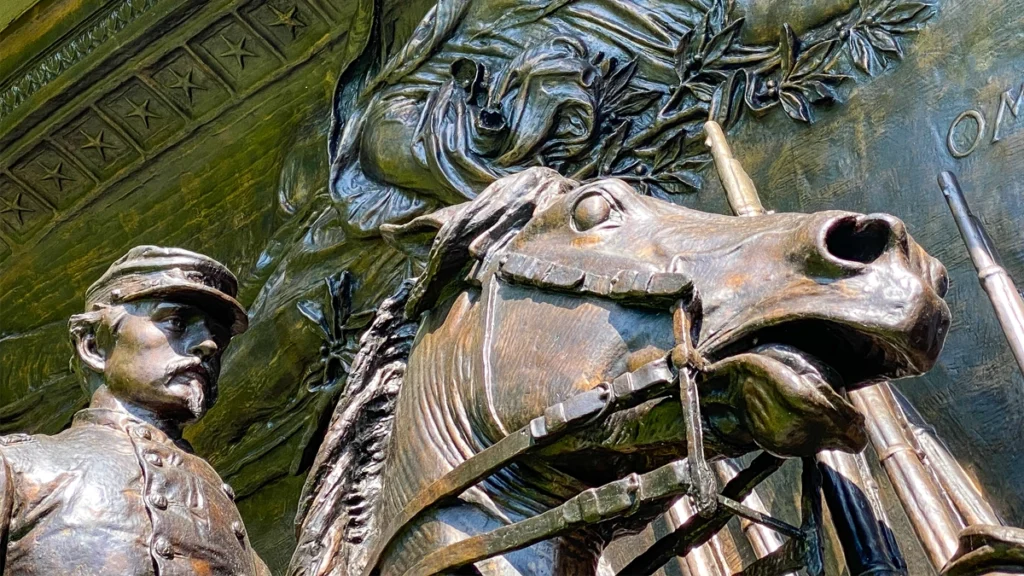
The Citizens Coinage Advisory Committee (CCAC) is one of the governmental bodies that advises the Secretary of the Treasury on the design of the nation’s coinage and medals. It is made up of 11 members, each fulfilling a more or less different role. Now, the United States Mint is soliciting applications on behalf of the CCAC for the member with training and or experience in sculpture and the medallic arts. Once the Mint has reviewed all the applications it receives, it will forward its recommendations to the Treasury Secretary for the final decision.
Each member is appointed for a term of four years, and must be able to attend each CCAC meeting during that time. No government employee or officer may be appointed to the Committee while they are employeed in such a facility. It is required that an applicant be a citizen of the United States to serve. CCAC members are categorized as Special Government Employees and are subject to conflict of interest laws and ethics regulations.
Those seeking to apply for appointment as the CCAC medallic arts specialist must send a resume or curriculum vitae that presents their specific training or experience, along with a cover letter describing their motivation for applying, by email to info@ccac.gov, Attn: Jennifer Warren.
The submission deadline for emailing your application is no later than 5 p.m. Eastern Time on Wednesday, January 3, 2024.
* * *
About the CCAC
In accordance with 31 U.S.C. 5135, the CCAC:
-
Advises the Secretary of the Treasury on any theme or design proposals relating to circulating coinage, bullion coinage, Congressional Gold Medals, and national and other medals.
-
Advises the Secretary of the Treasury with regards to the events, persons, or places to be commemorated by the issuance of commemorative coins in each of the five calendar years succeeding the year in which a commemorative coin designation is made.
- Makes recommendations with respect to the mintage level for any commemorative coin recommended.
The CCAC was established in 2003 by Congress under Public Law 108-15.
-courtesy of the Citizens Coinage Advisory Committee
* * *
The post CCAC Seeks Applications for Medallic Arts Specialist appeared first on CoinWeek: Rare Coin, Currency, and Bullion News for Collectors.
Ron Drzewucki Named President of CAC
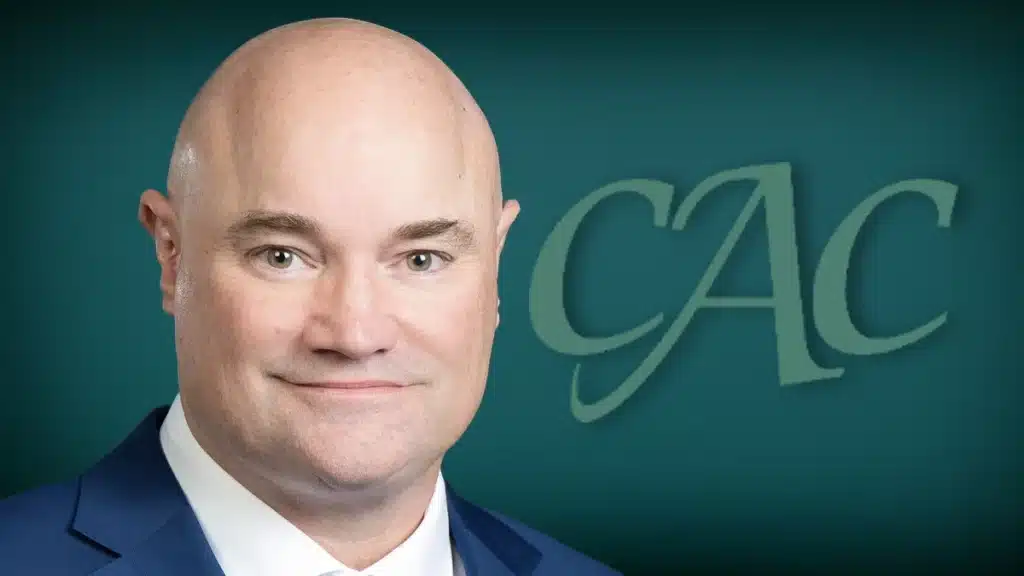
(Virginia Beach, Virginia) December 1, 2023 – CAC Grading, LLC, which recently launched its full operations for rare coin authentication, grading, and certification, has named long-time professional numismatist Ron Drzewucki as its new President. Ron Drzewucki succeeds John Albanese at CAC, who remains Chief Executive Officer after serving as both President and CEO since the company’s founding in 2022.
“Ron was among the CACG co-founders and has served as our Senior Finalizer. He has been involved in the authentication and grading of more than 100,000 coins since we began accepting submissions in June, first during a soft launch and then with full operations starting in October,” explained Albanese. “Ron is well-known and respected in the profession as a world-class grader.” A life member of both the American Numismatic Association and the American Numismatic Society as well as a member of the Professional Numismatists Guild, Drzewucki has been a full-time professional numismatist for 40 years. In addition to extensive business experience as a dealer, he worked for seven years at Numismatic Guaranty Corporation where he was described as “having a superb eye for coins” and “has the experience and discriminating eye to make the important distinctions between grades.”
“I’m looking forward to 2024 and excited to be a part of the leadership team and guide the day-to-day operations at CAC Grading,” said Drzewucki. “I will continue implementing John Albanese’s mission of grading with the utmost transparency for vintage and modern coins while working with new collectors to help usher in the next generation of coin enthusiasts.”
CAC Grading Co-Founder and Finalizer John Butler stated: “I’ve known Ron since he was 14 years old and working in his father’s coin store in St. Charles, Missouri, and since that time I have watched him travel through his numismatic journey. I see Ron being named the President of CAC Grading as the culmination of many years of his staying focused on his goals and working very hard to get himself to this elite level in the numismatic community. I’m proud to see him accomplish this achievement and am excited to see where his numismatic journey will lead CAC Grading in the future.”
Many collectors and dealers have embraced CAC Grading since its launch.
“We are continuing to build momentum and, with Albanese and Drzewucki leading the charge, look forward to a strong 2024,” stated Brian Kint, CAC Grading Chief Financial Officer.
In 2007, Albanese and two dozen veteran numismatists founded Certified Acceptance Corporation (CAC) to provide buyers and sellers verification that their coins certified by third-party grading services met stringent standards. Coins that met their standards received a coveted green CAC sticker on the encapsulation holders.
In 2022, Albanese organized over 150 leading members of the numismatic community including Drzewucki to expand their mission for accuracy and consistency by creating a new third-party grading and encapsulation service, CAC Grading.
For additional information about CAC Grading, visit www.CACgrading.com, email help@CACgrading.com, or call 888-537-3798.
The post Ron Drzewucki Named President of CAC appeared first on CoinWeek: Rare Coin, Currency, and Bullion News for Collectors.
U.S. Mint 2023 Uncirculated Coin Set on Sale December 5
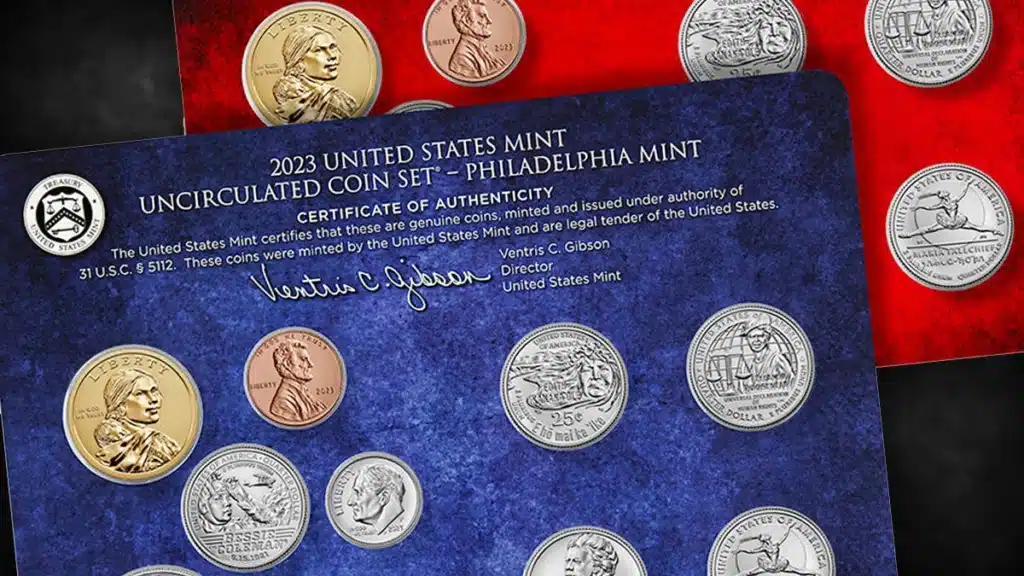
Collectors will be able to purchase the 2023 Uncirculated Coin Set directly from the United States Mint starting at 12:00 p.m. Eastern Standard Time on Tuesday, December 5. The set consists of 20 coins: 10 from the Philadelphia Mint and 10 from Denver.
Along with a certificate of authenticity, the Uncirculated Coin Set contains:
- Five 2023 American Women Quarters featuring Bessie Coleman, Edith Kanakaʻole, Eleanor Roosevelt, Jovita Idar, and Maria Tallchief
- One Native American dollar coin again featuring Maria Tallchief. Additionally, four other American Indian ballerinas achieved international recognition in the 20th century, including Marjorie Tallchief, Maria’s younger sister. The others were Yvonne Chouteau, Rosella Hightower, and Moscelyne Larkin. Together with Maria Tallchief, they were called the “Five Moons”–this is represented on the coin with a lunar motif, while the four ballerinas in the background are symbolic of both Tallchief’s American Indian ballerina contemporaries and their legacy. Inscriptions include “UNITED STATES OF AMERICA,” “MARIA TALLCHIEF,” “$1,” and “AMERICAN INDIANS IN BALLET.”
- One Kennedy half dollar
- One Roosevelt dime
- One Jefferson nickel
- One Lincoln Shield cent
The initial retail price of the 2023 Uncirculated Coin Set is $29 USD. There is a production limit of 185,000 units.
The United States Mint Uncirculated Coin Set can also be purchased through the Mint’s Product Subscription Program. Like a magazine subscription, this program affords customers the convenience of signing up to receive automatic shipments of products in a series. The shipments continue until the subscription is cancelled. Click here for more information.
This set is also sold through the Authorized Bulk Purchase Program and is available to Authorized Bulk (AB) members. Products listed in this program will be eligible for early release, carry an AB suffix to the product code, and may carry a premium. Early released products are not eligible for discounts.
* * *
The post U.S. Mint 2023 Uncirculated Coin Set on Sale December 5 appeared first on CoinWeek: Rare Coin, Currency, and Bullion News for Collectors.
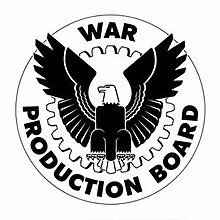
1944-P Jefferson War Nickel : A Collector’s Guide

Struck against the backdrop of war from an alloy developed to save copper and nickel, the 1944-P Jefferson nickel is one of the most abundant dates of the silver alloy subtype. Uncirculated examples are plentiful and can be purchased inexpensively, though fully-struck examples are elusive. The date was counterfeited in the 1950s by Francis Henning, the only wartime date the counterfeiter chose. That choice would prove a factor in his undoing, as he neglected to include the subtype’s distinctive large mint mark over Monticello.
A New Alloy for the 1944-P War Nickel
 Established in January of 1942, the War Production Board (WPB) converted domestic factories to wartime production and procured the resources necessary to manufacture weapons, vehicles, munitions, and other supplies. Lists of critical raw materials, which included copper and nickel, were drawn up, and the WPB allocated the material based on the needs of defense industries.
Established in January of 1942, the War Production Board (WPB) converted domestic factories to wartime production and procured the resources necessary to manufacture weapons, vehicles, munitions, and other supplies. Lists of critical raw materials, which included copper and nickel, were drawn up, and the WPB allocated the material based on the needs of defense industries.
As numismatic researcher and author Roger W. Burdette puts it in his 2012 book United States Patter & Experimental Coinage of WW-II, “the WPB had the authority to tell any government agency or private company how much metal they could use, and it was only through persistent work that the Mint found enough copper to continue coinage through 1942.”
These restrictions posed a particular challenge for the United States Mint, which had to change the composition of much of the country’s circulating coinage. Zinc-coated steel cents, introduced in 1943 to save copper, attracted public ire as the greyish coins were easily confused with dimes and tarnished quickly in circulation.
 The nickel also proved problematic. Until 1942, the nickel’s alloy was 75% copper and 25% nickel, the same composition used for nickel five-cent pieces since the denomination’s introduction in 1866. Both metals were on the WPB’s list and a new alloy was sought.
The nickel also proved problematic. Until 1942, the nickel’s alloy was 75% copper and 25% nickel, the same composition used for nickel five-cent pieces since the denomination’s introduction in 1866. Both metals were on the WPB’s list and a new alloy was sought.
In November of 1941, the Mint began experimenting with new alloys for the nickel. The vending machine industry offered input as well, to ensure that the new alloy would function in their machines. The Mint toyed with the notion of reintroducing a silver half dime, a denomination phased out in 1873.
Congress passed a law in March of 1942 authorizing a five-cent coin with a 50% silver, 50% copper composition but providing the Mint latitude to modify the new alloy as necessary.

The Numismatist took note of the nickel’s changing composition in its April 1942 issue, noting that “numismatists will be interested to know that silver is less valuable than nickel. Nickel can do work where silver cannot. For example, the nickel that goes into our coinage can be redirected in channels which will supply adequate metal to harden the steel for 1,000 heavy tanks.”
In August 1942, after months of experiments, the Mint arrived at an alloy of 35% silver, 56% copper, and 9% manganese, which was approved in early September. Striking of the war nickels began on September 21. The new alloy proved difficult to strike but the Mint’s staff persevered, producing hundreds of millions of “war nickels” between September 1942 and the end of 1945. Burdette, in his United States Pattern & Experimental Pieces of WW-II, points to “[p]oor alloy mix, oxidation, segregation, inconsistent annealing” as among the persistent issues the Mint confronted in striking war nickels.
To differentiate the silver war nickels from their base-metal predecessors, a larger mint mark was added above Monticello on the reverse. Mint Director Nellie Tayloe Ross explained in a letter to F.J. Haggerty dated September 14, 1942:
“…The engraver at Philadelphia is instructed to place a Mint Mark somewhat larger than usual, directly over the dome of Monticello, on the reverse of the new coin. This, it is believed, will facilitate identification of the coins when they come in as uncurrent. However, Mr. Miller states that view that the difference in color between the new and the old coin will be sufficient to identify them readily.”
The Philadelphia Mint struck 119,150,000 nickels in 1944, the third-highest mintage of the wartime subtype. 271,165,000 were struck at the same facility the previous year, while the 1945-P has a mintage slightly higher at 119,408,000.
Certified Examples of the 1944-P War Nickel
According to Bernard Nagengast in his The Jefferson Nickel Analyst:
“The silver alloy nickels issued from 1942-1945 had an entirely different, more appealing look than the earlier nickels. This appearance no doubt encouraged saving of these coins, since as a general statement the wartime silver nickels are much more available than the earlier coins, even for the 1942 issues.”
The completeness of Monticello’s steps is used to determine the quality of a Jefferson nickel’s strike. Examples on which all (or most) of the six steps are well-defined were fully struck from fresh dies. Many nickels have five of the six steps defined, indicating a better strike that still fails to qualify as Full Steps; NGC attributes both Five Full Step (5FS) and Full Step nickels.

War nickels do not typically have a stronger or weaker strike than their copper-nickel predecessors or replacements. Nagengast again:
“[T]he WT [wartime] alloy must have been similar to the copper-nickel in terms of strike ability. Striking problems seem to vary with the individual mint practices.” He describes the Philadelphia Mint’s nickels of the 1940s as “grainy looking,” and specifies that the 1944-P “often exhibits surface roughness, however, smooth coins can be found with some searching.”
Uncirculated 1944-P war nickels typically display “brilliant satin to frosty surfaces,” according to Nagengast.
1944-P Jefferson nickels displaying five full steps are widely available, but those with all steps well-defined are rare.
Because of their silver content, some 1944-P Jefferson nickels (and all other war nickels) will sometimes sport more colorful toning than their base-metal counterparts.
As of the beginning of December 2023, PCGS records 3,879 grading events for 1944-P Jefferson nickels without Full Steps and 915 with that designation, while NGC records 5,123 without Full Steps, 400 with 5 Full Steps (5FS), and 34 with Full Steps (6FS).
One coin graded MS67 6FS is listed in the NGC Census.
Variety Vista lists four doubled die obverse (DDO) and seven doubled die reverse (DDR) varieties of the 1944-P Jefferson nickel. The date’s obverse design is listed as Obverse Die Variety #5, used only in 1944. Its reverse is listed as Reverse Design Variety #3. NGC’s Census lists two P/P varieties.
Auction results suggest that 1944-P Jefferson nickels are worth less than $100 USD in all grades below MS67. In MS67, values can cross the $100 threshold, and coins in MS67+ often sell for between $200 and more than $1,000.
Counterfeit Henning Nickels
The oversize mint marks on the wartime silver nickels’ reverse were meant to aid in identifying the coins for postwar identification, but they also helped uncover one of the 20th century’s most famous counterfeiting operations.
In 1954, Jefferson nickels dated 1944 without a mint mark above Monticello’s dome began circulating in New Jersey.
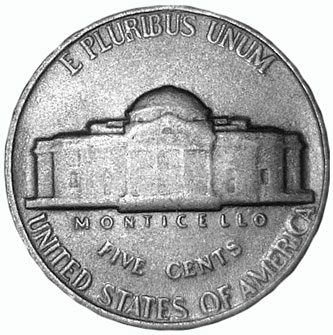 Francis LeRoy Henning counterfeited Jefferson nickels dated 1939, 1944, 1946, 1947, and 1953 from a building in Erial, New Jersey, which some numismatic writers wryly call the “Erial Mint”. Henning worked as an engineer in Philadelphia and claimed to have created six obverse and six reverse dies (examples struck from only two of the reverse dies have been identified) for Jefferson nickels from which he struck thousands of counterfeit pieces. Two of the obverse dies are thought to be dated 1944.
Francis LeRoy Henning counterfeited Jefferson nickels dated 1939, 1944, 1946, 1947, and 1953 from a building in Erial, New Jersey, which some numismatic writers wryly call the “Erial Mint”. Henning worked as an engineer in Philadelphia and claimed to have created six obverse and six reverse dies (examples struck from only two of the reverse dies have been identified) for Jefferson nickels from which he struck thousands of counterfeit pieces. Two of the obverse dies are thought to be dated 1944.
Henning failed to include the large “P” mint mark over Monticello, alerting observant consumers, collectors, and authorities. A defect on the “R” in “PLURIBUS” was noted by the Director of the Mint in Washington, William Brett. Both mistakes helped identify the counterfeits. The composition of the counterfeits is also different, similar to the prewar alloy: 79.1 percent copper, 20.5 percent nickel, and 0.4 percent iron.
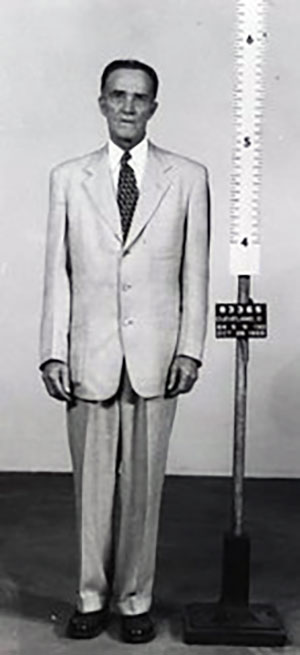 The late David Lange wrote that a numismatist may have been the first to detect the counterfeits in October 1954. Members of the Camden County Coin Club noted many 1944 Jefferson nickels without mint marks and put a story into a local newspaper in the spring of 1955; larger regional papers picked the story up shortly thereafter. Henning saw the story, stopped counterfeiting the nickels, dumped thousands into Cooper Creek and the Schuylkill River, and moved to Cleveland.
The late David Lange wrote that a numismatist may have been the first to detect the counterfeits in October 1954. Members of the Camden County Coin Club noted many 1944 Jefferson nickels without mint marks and put a story into a local newspaper in the spring of 1955; larger regional papers picked the story up shortly thereafter. Henning saw the story, stopped counterfeiting the nickels, dumped thousands into Cooper Creek and the Schuylkill River, and moved to Cleveland.
The June 3, 1955 edition of the Delaware County Daily Times posed a prescient question: “Biggest mystery is why anyone would want to go through the time, trouble and expense to coin the lowly nickel these days when it can’t even buy a telephone call or a cup of coffee[?]” After his arrest, Henning claimed that he had created dies for half dollars, quarters, and dimes, but elected to counterfeit nickels because of their concealability, according to Dwight Stuckey’s 1982 monograph on Henning.
The United States Secret Service received reports of the counterfeits in December 1954. They eventually found the Erial Mint and talked to Henning’s coworkers, who informed them of his move to Cleveland. He was arrested there on October 27, 1955, and received a three-year sentence.
Winston Zack, author of Bad Metal: Circulating Contemporary Counterfeit United States Coins, described Henning in a phone interview as “possibly the most documented counterfeiter of circulating coins in U.S. history.”
Henning nickels, as the counterfeits are known, are relatively affordable. Attractive examples can be purchased for less than $100. The counterfeits are legal to own but illegal to spend; considering the premium over face value that a collector will pay for one of Henning’s counterfeits, that should be an easy temptation to resist.
Conclusion
Wartime exigencies produced a widely-collected, widely-covered subtype of the Jefferson nickel, of which the 1944-P is one of the most abundant issues. The coins are accessible to any collector interested in artifacts that attest to the impact of WWII on the homefront, while 1944-dated Henning nickels offer a shady complement to any set including the wartime issues.
War Nickel Design
Obverse:
A left-facing bust of President Thomas Jefferson, including a colonial-era pigtail and strikingly similar in detail to the profile of Jean-Antoine Houdon’s 1789 bust, takes up the majority of the obverse. The top of his head almost touches the rim, and the barest of truncations is visible at the bottom where Jefferson’s left shoulder meets the edge of the coin. The motto IN GOD WE TRUST–which became the national motto in 1956–arcs clockwise along most of the length of the left side of the coin, starting from Jefferson’s chest and extending to his hairline. The inscriptions LIBERTY and the date 1939 run clockwise along the right side behind Jefferson. A small five-pointed star divides the two inscriptions.
Reverse:
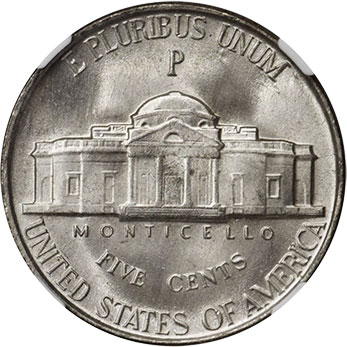 The reverse features a front view of Monticello, Jefferson’s mansion near Charlottesville, Virginia. The polymath Jefferson designed the neoclassical building himself, based on architectural principles from the Italian Renaissance; the name “Monticello” comes from the Italian for “mound” or “little mountain”. The building loses much of its dimensionality in the flattened rendering, but the octagonal nature of the dome can still be interpreted, and better strikes reveal significant detail in the steps and portico.
The reverse features a front view of Monticello, Jefferson’s mansion near Charlottesville, Virginia. The polymath Jefferson designed the neoclassical building himself, based on architectural principles from the Italian Renaissance; the name “Monticello” comes from the Italian for “mound” or “little mountain”. The building loses much of its dimensionality in the flattened rendering, but the octagonal nature of the dome can still be interpreted, and better strikes reveal significant detail in the steps and portico.
Atop the reverse is the motto E PLURIBUS UNUM (“Out of Many, One”). The name MONTICELLO–the placement of which on the coin was one of the Mint’s revisions forced upon the coin’s designer Felix Schlag–is found in a straight line immediately under the building; the positions and spacing of the other inscriptions had to be adjusted to make room for it. The denomination FIVE CENTS forms a gently curving line beneath that, and the inscription UNITED STATES OF AMERICA runs counterclockwise along the bottom edge of the coin. A large mint mark, P, D, or S appears above Monticello’s dome to identify nickels struck from the copper-silver-manganese alloy from 1942 to 1945.
Edge:
The edge of the 1944-P Jefferson nickel is plain, without reeding or lettering.
Coin Specifications
| Country: | United States |
| Year Of Issue: | 1944 |
| Denomination: | Five Cents (USD) |
| Mint Mark: | P (Philadelphia) |
| Mintage: | 119,150,000 |
| Alloy: | 56% Copper, 35% Silver, 9% Manganese |
| Weight: | 5.00 grams |
| Diameter: | 21.21 mm |
| OBV Designer | Felix Schlag |
| REV Designer | Felix Schlag |
| Quality: | Business Strike |
* * *
The post 1944-P Jefferson War Nickel : A Collector’s Guide appeared first on CoinWeek: Rare Coin, Currency, and Bullion News for Collectors.
2023 Mint Set and U.S. Marine Corps Bronze Medal for December
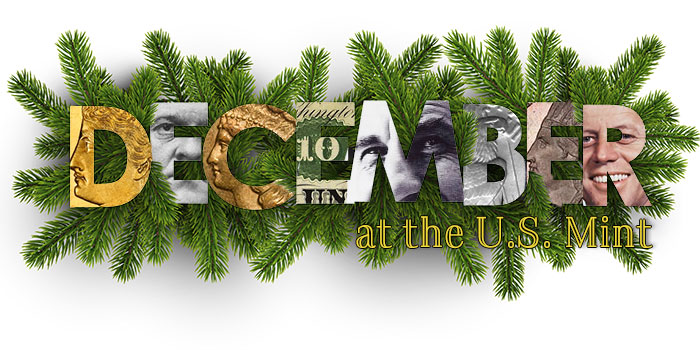
Big Things Happened at the United States Mint in December

By CoinWeek …..
The month of December has historically been a time for Americans to take it easy, spend time with their family, celebrate the holidays, and prepare for the New Year. Not so for the United States Mint. Since its founding in 1792, the Mint has worked month after month, often around the clock, through war and peace to strike the nation’s coins.
CoinWeek has dug through more than 228 years of Mint history to provide this list of important December goings-on at the U.S. Mint. This list denotes important visits, important personnel changes, and historic strikings.
* * *
December 1, 1794: The Mint delivers its first shipment of half dollars, 5,300 to be exact. No silver coinage is delivered for the rest of the year.
December 1, 1862: United States Mint Superintendent James Pollock writes Treasury Secretary Salmon P. Chase raising concerns about the Mint’s ability to obtain sufficient quantities of nickel to strike one-cent coins.
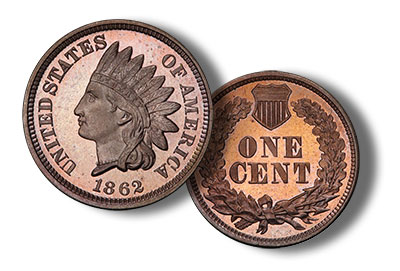
December 1, 2016: The Uncirculated version of the 30th Anniversary American Silver Eagle goes on sale.
December 2, 1850: In his first message to Congress, President Millard Fillmore recommends that a branch mint be established in California.
December 2, 1854: Chief Coiner Franklin Peale, no friend to Chief Engraver James Longacre, whose position he clearly coveted, is forced to leave the employ of the United States Mint. Peale did appeal to Congress numerous times for remuneration for unpaid work. Congress ultimately paid $10,000 to his daughter, three years after his death, in 1873.
December 2, 1877: Mint Director Linderman sends Philadelphia Mint Superintendent James Pollock design details for the Mint to create “goloid” patterns based on William Wheeler Hubbell’s proposal.
December 3, 1833: The Director of the Mint writes a letter to Congress discussing proposals to reform U.S. coinage. Included with the letter were pattern pieces struck in various alloys.
December 4, 1987: The U.S. Senate confirms Cynthia Grassby Baker for the position of Superintendent of the Denver Mint.
December 5, 1848: President James K. Polk proposes the establishment of a new branch mint in San Francisco, California.
December 5, 1968: The Joint Commission on the Coinage meets to discuss the introduction of a non-silver dollar coin. These talks lead to the creation of the Eisenhower dollar. The commission also determined that the GSA cannot sell 2.9 million silver dollars on hand without specific authorization by the United States Congress.
December 6, 1994: President William Jefferson “Bill” Clinton nominates Robert Rubin to replace retiring Lloyd Bentsen as Treasury Secretary.
December 8, 1921: First Peace dollars are struck.
December 8, 1958: The Commission on Fine Arts (CFA) approves Gasparro’s revised design for the Lincoln Memorial cent.
December 10, 1860: Treasury Secretary Howell Cobb resigns his post to join the Confederacy.
December 11, 1891: United States Mint Superintendent Oliver C. Bosbyshell requests a delay in the production of the new Barber coinage until dies can be properly tested. Mint Director Edward O. Leech would write back three days later denying Bosbyshell’s request.

December 12, 1838: Mint Director Patterson writes a letter to Treasury Secretary Levi Woodbury informing him of the delivery of four 1838 Eagle gold coins of the new design sent to him on December 6. These were the first gold issues of the denomination struck for circulation in 34 years.
December 12, 1860: Philip F. Thomas is appointed Secretary of the Treasury. Thomas, the former Governor of Maryland, reluctantly took the job as the country was careening towards financial and political disaster. He would resign after only a month after failing to secure funding to pay interest on the public debt.
December 13, 1978: The Philadelphia Mint begins production of the 1979 Susan B. Anthony dollar. The coin was the first U.S. coin to feature the P mintmark since World War II.
December 13, 2011: Seeing it as another dollar coin boondoggle, Treasury Secretary Timothy Geithner suspends coinage of Presidential dollar coins for circulation.
December 14, 1891: After a lengthy back-and-forth between Philadelphia Mint Superintendent Oliver C. Bosbyshell and United States Mint Director Edward O. Leech concerning Barber’s new coin design, Leech orders the dies to be prepared without delay.
December 14, 1899: The entire mintage of the Lafayette half dollar is struck. 26 of which are held for assay.
December 15, 1848: The Mint receives $3,910 of California gold from War Secretary William L. Marcy. This deposit is used to strike the famous 1848 CAL. quarter eagles.

December 15, 1883: The Philadelphia Mint delivers the year’s entire mintage of business strike Three Dollar gold coins, 900 pieces.
December 15, 1983: President Ronald Reagan presents composer Fred Waring with a Congressional Gold Medal.
December 17, 1810: The United States Mint delivers the second (and final batch) of 1809-dated dimes struck in 1810.
December 17, 1863: Following a string of military successes, the Senate passes House resolution requesting that the President of the United States to cause a gold medal to be struck and given to Major General Ulysses S. Grant on behalf of the people of the United States.
December 17, 1878: Mint begins to issue gold coins into the market for the first time since 1861. In short order, gold achieves parity with paper money in circulation.
December 17, 1985: Congress authorizes the production of gold bullion coins.
December 18, 1882: Mint Director Burchard notifies Mint Director Snowden that the nickel design would need to be altered per the instructions of Treasury Secretary Charles Folger in accordance with the Coinage Act of 1873. The ordered revisions were to place LIBERTY and the date appear on the obverse and that the legend: UNITED STATES OF AMERICA, the motto: E PLURIBUS UNUM, and the coin’s denomination appear on the reverse.
December 18, 1922: A guard is shot after four men rob a Federal Reserve truck stationed outside of the Denver Mint. As a result, the United States Mint closes the Philadelphia and Denver facilities to the public. This event leads the Mint to transfer its coin cabinet to the Smithsonian Institution.
December 19, 1921: President Hoover selects De Francisci’s design for the Peace dollar.
December 20, 1860: South Carolina secedes from the Union. Within days, Louisiana state officials visit the New Orleans Mint and inform the staff that the facility is now under state control.
December 20, 1882: Snowden appeals Burchard’s decision (see December 18, 1882), arguing that the Treasury Secretary had misinterpreted the Coinage Act of 1873 and that the proposed design was not in violation of the law.
December 20, 1906: Roosevelt writes to the ailing Augustus Saint-Gaudens to exclaim his enthusiasm for the artist’s $20 gold coin design, calling the design “immense” and ordering that the Mint produce dies just as quickly as possible and just as they are.”
December 20, 1958: President Dwight D. Eisenhower announces a change to the reverse of the Lincoln cent, adopting Frank Gasparro’s Memorial design.
December 21, 1933: President Franklin D. Roosevelt issues executive order mandating that the U.S. Mint pay $4.64 per ounce of silver.
December 22, 1849: After an arduous development cycle, James Longacre’s finished $20 gold coin dies are used to strike at least two 1849 double eagles. Today, the only known example is housed at the National Numismatic Collection at the Smithsonian Institution and is valued by Jeff Garrett at over $25 million. We value it at $17.28 million, with the juice, but who’s counting?
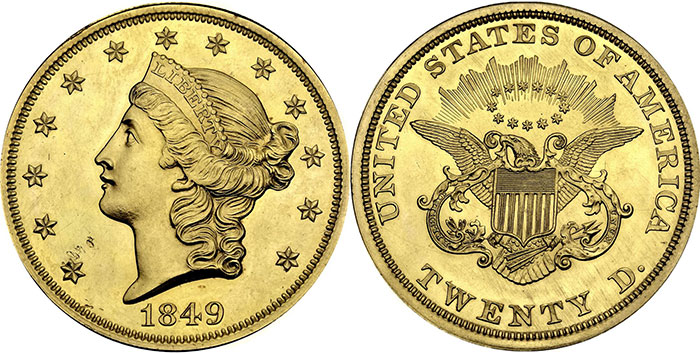
December 23, 1936: The Commission of Fine Arts approves the Arkansas half dollar reverse design depicting Senator Joseph Taylor Robinson.
December 26, 1849: Treasury Secretary William Meredith approves Longacre’s $20 gold coin design. The coin enters regular production in 1850.
December 27, 1864: Treasury Secretary Hugh McCulloch appoints Henry Rice, Abraham Curry, and John H. Mills to obtain land and oversee the construction of the Carson City Mint.
December 27, 1904: President Theodore Roosevelt writes to Treasury Secretary Leslie Mortier Shaw: “I think our coinage is artistically of atrocious hideousness” and then asks “would it be possible, without asking permission of Congress, to employ a man like Saint-Gaudens to give us a coinage that would have some beauty?”.
December 28, 1792: President George Washington visits the Mint to inspect its operations. The previous day, the Mint had assayed a deposit of foreign silver coins.
December 28, 1836: Mint Director Patterson writes a letter to Congress discussing the various weights and sizes of small gold coins as Congress considers adopting a one dollar gold coin.
December 29, 1799: The Bank of the United States deposits $44,015.71 worth of French Crowns for coining into U.S. silver dollars. The Mint delivers the coins in February 1800.
December 30, 1861: New York banks suspended specie payments for Greenbacks. This move would reverberate through the country.
December 30, 1963: A week after President John F. Kennedy is assassinated in Dallas, Texas, legislation authorizing the production of the Kennedy half dollar is signed into law by President Lyndon Johnson.
December 31, 1829: The United States Mint reports that it has a stockpile of 900,000 half cents in its vault.
December 31, 1836: 600 “Gobrecht” dollars are reported as struck. These coins weigh 416.8 grains with the obverse and reverse showing a “coin turn” orientation. Some researchers believe that these coins may actually have been produced in early 1837.
December 31, 1873: The Carson City Mint strikes 5,000 $20 gold coins, wrapping up the year’s total output of 22,410 for the denomination.
December 31, 1912: Coinage of Liberty Head nickel design officially ends.
December 31, 1969: Order cut-off date for 1970 Proof Sets, the last Proof set to include the 40% silver Kennedy half dollar featuring the Gasparro eagle reverse.
December 31, 1974: Reversing a policy that lasted 31 years, private ownership of gold bullion is legalized in the United States.
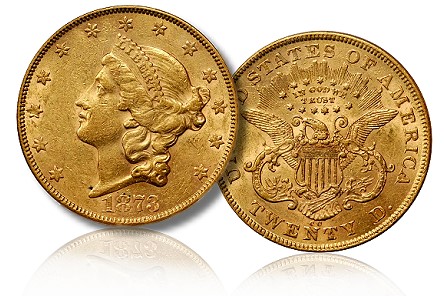
Also Happening at the United States Mint in December
December 1815: The Mint strikes 69,000 quarters and ships 60,000 of them to Planter’s Bank of New Orleans. This is the first order for the denomination since 1807, prompting the creation of a new design.
December 1835: France and America settle a diplomatic dispute dating back to the undeclared naval war of 1799-1800. France agreed to pay America 25 million francs in gold. The Mint recoined these francs into American gold coins and paid them out to ship owners and merchants impacted by the conflict.
December 1836: The Mint strikes more than 1,000 Gobrecht silver dollars on a screw press in Philadelphia. These are the first U.S. coins bearing the Seated Liberty motif.
December 1840: Mint revises the obverse of the dime.
December 1863: Geologist H.P. Bennett returns to Washington after surveying the Comstock region for the Treasury Department.
December 1877: Silver dollar patterns utilizing designs by William Barber and George T. Morgan are struck for Linderman’s examination.
December 1878: Mint begins to issue gold coins into the marketplace for the first time since 1861.
December 1937: Mint and Treasury officials meet to discuss changing the nickel design to honor Thomas Jefferson.
December 1942: U.S. Mint hires Frank Gasparro.
December 2016: Mint Engraver Jim Licaretz retires.
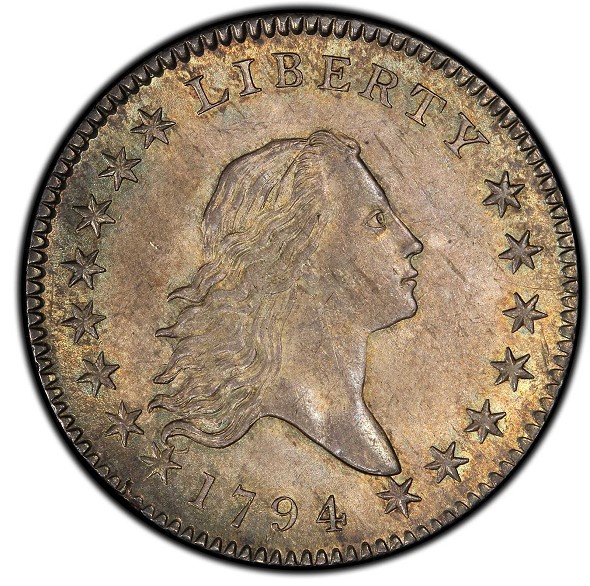
Late December 1838: The New Orleans Mint strikes 35,000 dimes, wrapping up dime production for the branch mint’s inaugural year. The 30 dimes struck at New Orleans on May 8 were the first coins struck at the new mint.
* * *
The post Big Things Happened at the United States Mint in December appeared first on CoinWeek: Rare Coin, Currency, and Bullion News for Collectors.
Gold Rallies in November, Silver Records Double-Digit Gain
Except for silver, which reached another 6
Juno on Ancient Coins – Roman Queen of the Gods
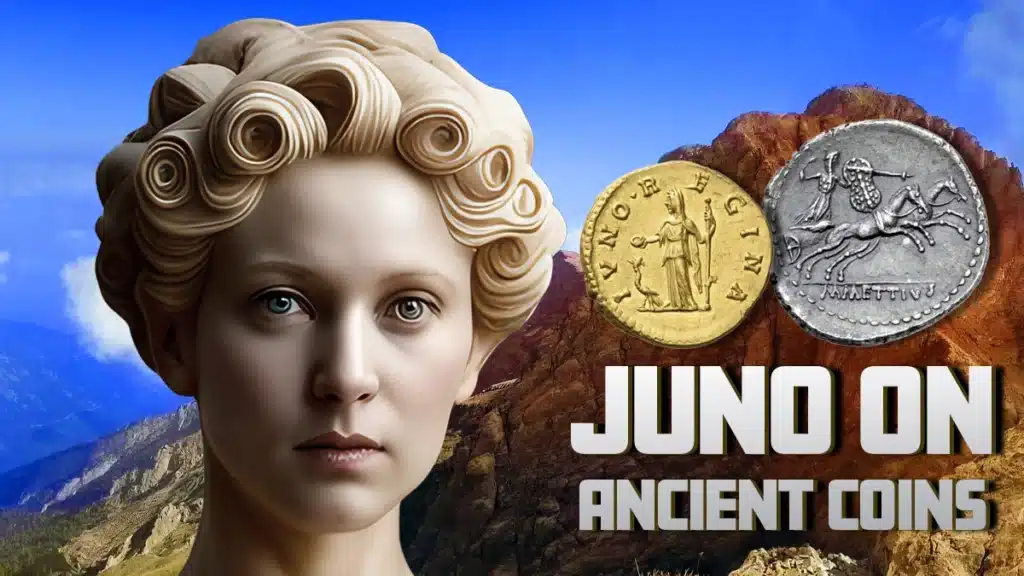
CoinWeek Ancient Coin Series by Mike Markowitz …..
FOR ANCIENT ROMANS, Juno (Iuno in Latin[1]) was the queen of the gods, sister and wife of the supreme deity, Jupiter. She was identified with the Greek goddess Hera[2], although Romans worshipped her under many different local cults.
As Juno Sospita (“Savior”), she was a war goddess, armed with spear and shield.
As Juno Moneta (“The Warner”) she was the guardian of Rome, and later the patroness of mint-workers, since Rome’s mint was located in her main temple[3].
As Juno Lucina (“Light-Bringer”) she was the protector of childbirth.
Many other attributes and epithets became attached to this complex goddess, and these symbols found their way onto coins produced over the course of centuries. In the ancient world there was no separation of church and state, and the official state religion was widely illustrated and celebrated on the coinage. During the time of the Western Roman Empire, images of Juno were especially common on coins issued in the names of empresses. On the CoinAchives Pro online database, which records some 2,274,000 ancient coin sales from over 5,500 auctions, a recent search for the term “Juno” returned 12,444 hits. A search for the Latin inscription IVNO yielded 4,298 hits.
Juno Sospita
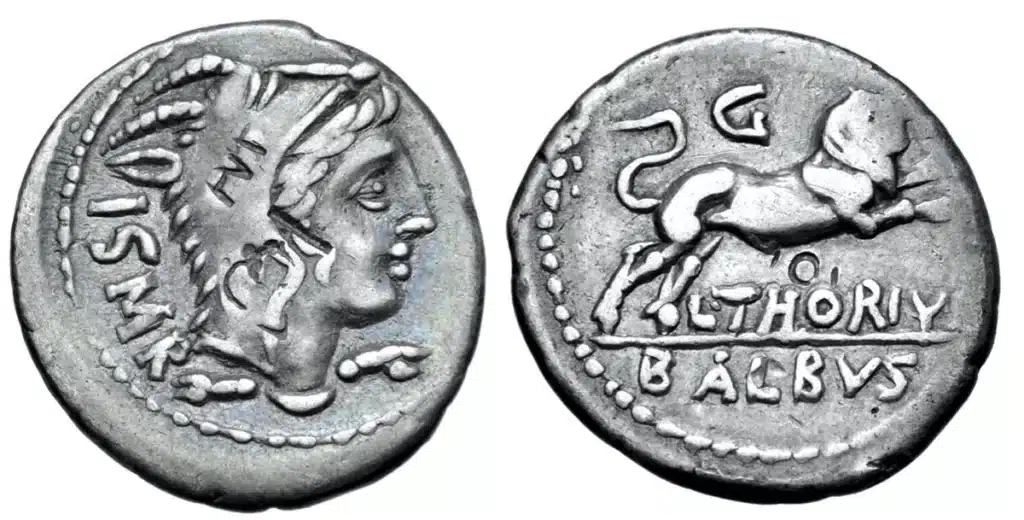
16 June 2021. Lot: 1305. Realized: £130. Approx. $183.
An early appearance of Juno Sospita is on the obverse of a silver denarius issued by the moneyer L. Thorius Balbus in 105 BCE[4]. On the obverse, she is depicted wearing a goatskin headdress with the horns still attached. The inscription I S M R stands for the Latin phrase Iuno Sospita Mater Regina (“Juno the Savior, Mother [and] Queen”).
Moneyers were mint officials, elected annually and responsible for producing the coins. They often used this opportunity to promote their political careers. Thorius came from the town of Lanuvium[5], 20 miles (32 km) southeast of Rome, where there was an important temple dedicated to the goddess.

13 May 2020. Lot: 629. Realized: $3,000.
Juno Sospita with her goatskin headdress appears on numerous coins from the “Imperatorial” period (59 to 27 BCE) when Rome was wracked by a series of civil wars. L Papius Celsus, a moneyer who is known only from his coinage, also came from Lanuvium, and the reverse of his silver denarius[6] issued in 45 BCE has a strange scene from the legendary founding of that city:
When a fire broke out spontaneously in the forest, a wolf, they say, brought some dry wood in his mouth and threw it upon the fire, and an eagle, flying thither, fanned the flame with the motion of his wings. But working in opposition to these, a fox, after wetting his tail in the river, endeavoured to beat out the flames; and now those that were kindling it would prevail, and now the fox that was trying to put it out. But at last the two former got the upper hand, and the other went away, unable to do anything further. 5 Aeneas, on observing this, said that the colony would become illustrious and an object of wonder and would gain the greatest renown[7].
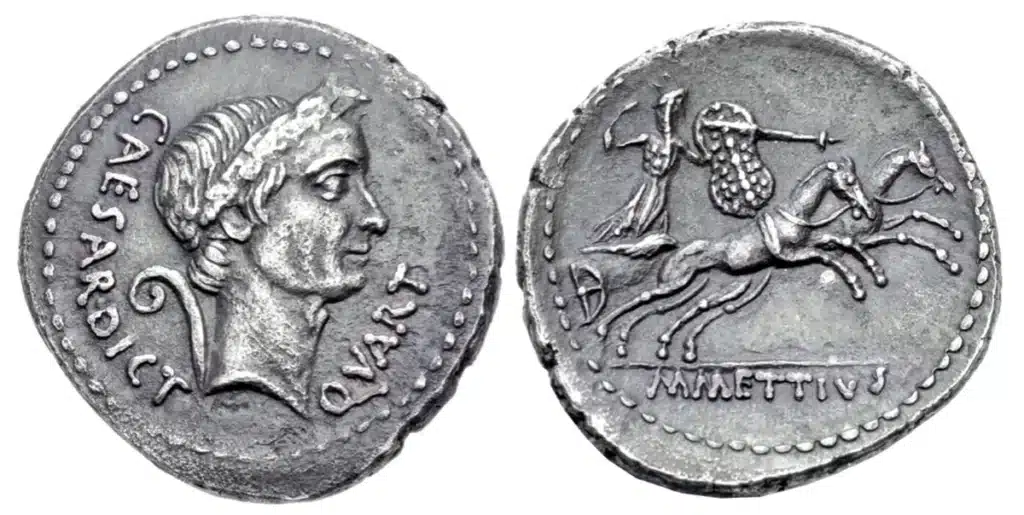
Coins bearing the portrait of Julius Caesar issued during his lifetime are in great demand from collectors, and often command fabulous prices at auction. Elite Romans of this era, much like modern Americans, were against the depiction of living persons on the money. They regarded this as a decadent “Eastern” custom. Early in 44 BCE, when Caesar was declared dictator for the fourth time, yet another Lanuvian, M. Mettius, placed the image of Juno Sospita on the reverse of Caesar’s portrait denarius[8]. The goddess, armed with a spear and a figure-of-eight shield, stands in a chariot drawn by two slim leaping horses.
Three months after this coin was struck, Caesar was assassinated.
Juno Moneta
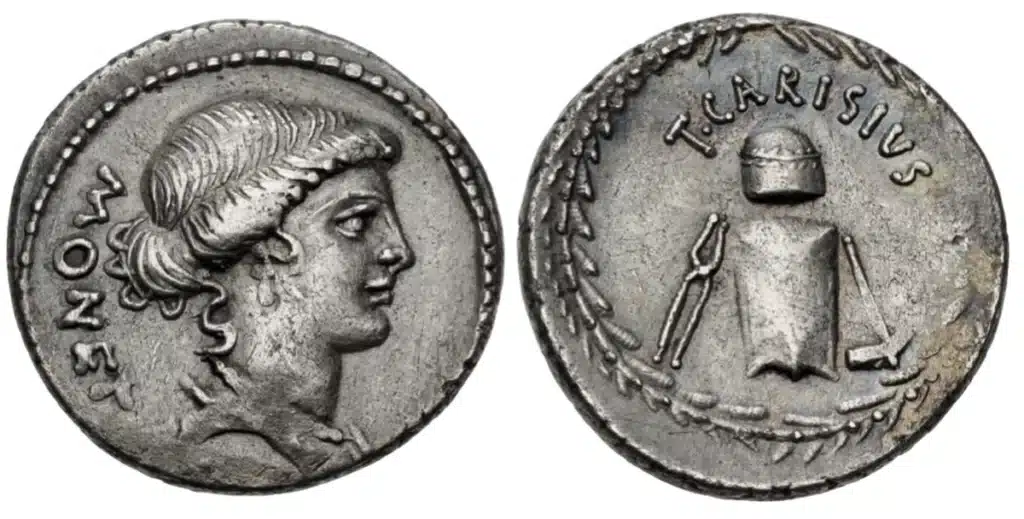
Lot: 749. Realized: $2,000.
Juno Moneta (“the Warner”) appears on a denarius of the moneyer T. Carisius issued in 46 BCE. Her hair is tied back with ribbons and her epithet MONETA is inscribed behind her head. Not much is known about Titus Carisius. He was a supporter of Julius Caesar who survived the civil wars and was “defeated the Astures in Hispania circa 25 BCE but in consequence of his cruelty and insolence, the Astures took up arms again in 22 BC[9].”
This coin is enormously popular with collectors because it is one of the few types that depicts the implements used to strike ancient coins[10]. One the reverse, we see a hammer, an anvil, a pair of tongs used to handle hot blanks, and a decorated rounded object that is usually described as a “Vulcan’s cap”, the leather hat worn by metal workers to keep flying sparks from setting their hair on fire. Some sources describe this object as a “garlanded punch die”, but this now seems to be a minority opinion.
Juno Lucina
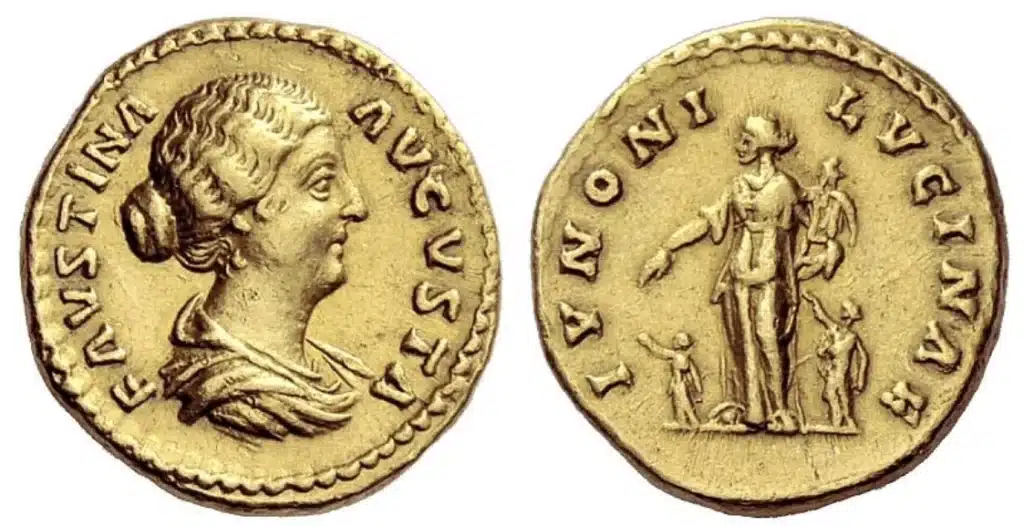 Auction 67 17 October 2012 Lot: 353 realized: 4,500 CHF Approx. $4,876 ” width=”696″ height=”358″ />
Auction 67 17 October 2012 Lot: 353 realized: 4,500 CHF Approx. $4,876 ” width=”696″ height=”358″ />Faustina “the Younger” (born about 130 CE) was the daughter of Emperor Antoninus Pius (ruled 138-161) and the wife of Emperor Marcus Aurelius (r. 161-180). She is known as Faustina Junior, or “the Younger” to distinguish her from her mother Faustina “the Elder”. In 30 years of marriage, she bore 14 children, of which six survived to adulthood: five daughters and one son, and the future emperor Commodus.
The reverse of a gold aureus in Faustina’s name, dated to c. 161-176 CE, bears a standing figure of Juno flanked by two small children and holding an infant in her arms. The inscription is IVNONI LUCINAE (“to Juno Lucina”), an appropriate invocation to the patron deity of childbirth. This coin, formerly in the famous collection of Archer Huntington, brought over $4,800 USD in a 2012 Swiss auction[11].
Juno on Coins of Bruttia Crispina
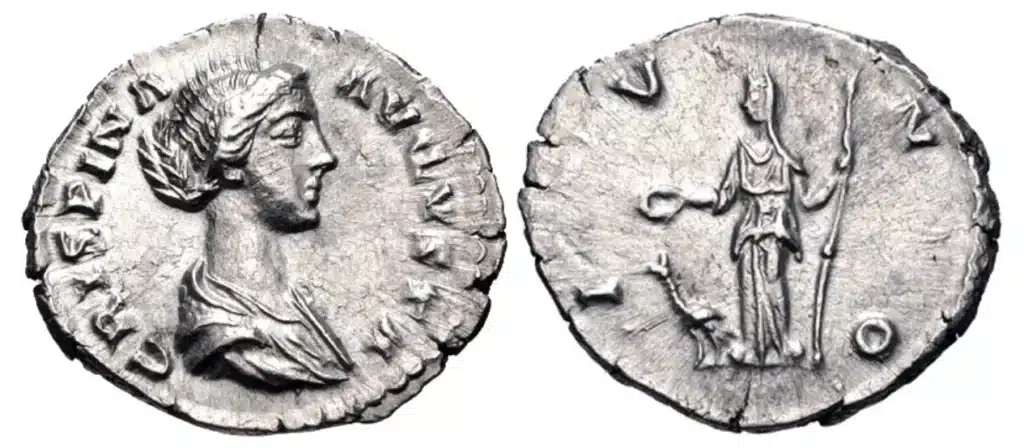 Electronic Auction 42525 July 2018 Lot: 466 realized: $100 ” width=”696″ height=”305″ />
Electronic Auction 42525 July 2018 Lot: 466 realized: $100 ” width=”696″ height=”305″ />Born to a wealthy Senatorial family, Bruttia Crispina (164-191 CE) married the 16-year-old future emperor Commodus in 178. Failing to produce an heir to the throne, she was falsely accused of adultery by her increasingly paranoid husband in 188. Banished to the island of Capri in the Gulf of Naples, she was executed a few years later. She was only about 26 years old. Her portrait appears on a long series of imperial coins, such as a silver denarius dated to c. 178-182[12]. A standing figure of Juno, accompanied by her familiar peacock, appears on the reverse holding a long staff and a patera, a shallow bowl used to pour out ritual offerings[13]. The simple inscription is IVNO.
Juno on Coins of Manlia Scantilla
 Auction 135: 21 November 2022 Lot: 317 realized: 240,000 CHF Approx. $252,260″ width=”696″ height=”349″ />
Auction 135: 21 November 2022 Lot: 317 realized: 240,000 CHF Approx. $252,260″ width=”696″ height=”349″ />: 21 November 2022. Lot: 317. Realized: 240,000 CHF. Approx. $252,260.
Manlia Scantilla was the wife of Emperor Didius Julianus, who ruled for just 66 days in the chaotic year 193 CE. Almost nothing is known about her life; the gold aureus issued in her name is one of the great rarities of Roman imperial coinage. An example described as “among the finest specimens known,” brought over $250,000 in a 2022 Swiss auction[14]. The reverse bears a draped and veiled standing figure of Juno, with her staff, patera, and peacock, surrounded by the inscription IVNO • REGINA (“Juno Queen”).
Juno Conservatrix
6 November 2022
Lot: 808
realized: €120 Approx. $1195 May 2010 Lot: 1320 realized: $23,000. Numismatik Naumann (formerly Gitbud & Naumann) > Auction 122 6 November 2022 Lot: 808 realized: €120 Approx. $119″ width=”696″ height=”363″ />
Julia Avita Mamaea (182 – 235) was born to an elite family in Emesa (today Homs), Syria. Her mother, Julia Maesa, was the elder sister of Empress Julia Domna, wife of Emperor Septimius Severus (r. 193-211). These ruthless and intelligent Syrian women, all rather confusingly named Julia, dominated the politics of the Empire for a troubled generation.
Julia Mamaea’s son, Severus Alexander (r. 222-235), became child emperor at the age of about 14 when his depraved cousin, the emperor Elagabalus, and his mother, Julia Soaemias, were murdered in a palace coup on March 11 or 12 in the year 222 CE.
Julia Mamaea was the effective ruler of the Empire during her son’s reign, and an extensive coinage was issued in her name bearing her portrait. The reverse of a silver denarius[15] bears the standard standing image of Juno, with star, patera, and peacock, surrounded by the unusual inscription IVNO CONSERVATRIX (“Juno the Preserver”).
Juno Martialis
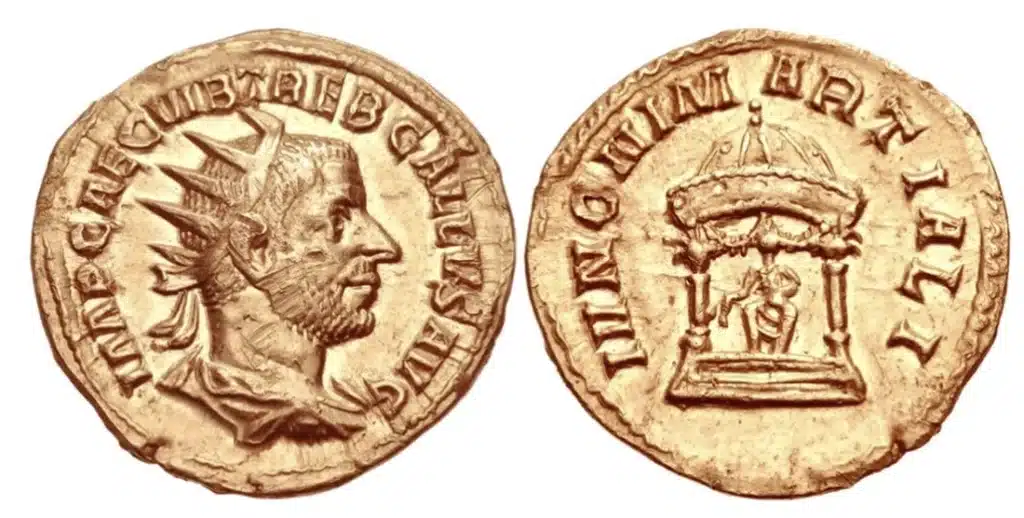 Mail Bid Sale 845 May 2010 Lot: 1320 realized: $23,000 ” width=”696″ height=”352″ />
Mail Bid Sale 845 May 2010 Lot: 1320 realized: $23,000 ” width=”696″ height=”352″ />Born about 206 CE to a respected elite family, Trebonianus Gallus had a successful military career, becoming governor of the strategic province of Moesia Superior (now mostly modern Serbia) under Emperor Trajan Decius. After Decius was killed in battle against the Germanic Goths, Trebonianus was confirmed as emperor by the Roman Senate, with his son Volusian as co-emperor. Trebonianus adopted Juno Martialis (Juno in her aspect as mother of the war god Mars) as his patron deity.
On coins[16] of Trebonianus and Volusian, the goddess is depicted enthroned under an elaborate columned canopy, with the inscription IVNONI MARTIALI (“to Juno Martialis”). When the legions under Aemilian revolted in 253 CE, Trebonianus and his son were murdered, a common fate for emperors during the Crisis of the Third Century.
Juno Victrix
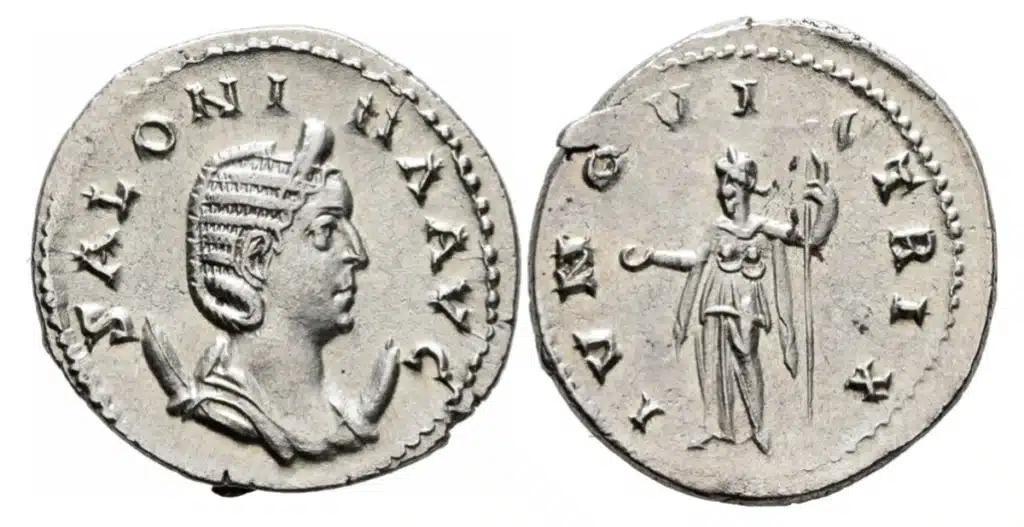 Web Auction 24. 3 December 2022. Lot: 3100.Realized: 220 CHF Approx. $234″ width=”696″ height=”358″ />
Web Auction 24. 3 December 2022. Lot: 3100.Realized: 220 CHF Approx. $234″ width=”696″ height=”358″ />Lot: 3100
realized: 220 CHF. Approx. $234
Cornelia Salonina was the wife of Emperor Gallienus (r. 253-268), who became co-emperor with his father Valerian in 253. After his father was captured in battle against the Persians in 260, Gallienus ruled alone until he was assassinated in 268. Salonina’s fate after her husband’s death is unknown, but she bore him three sons.
Coins issued in her name bear a variety of symbols and goddesses, including Vesta, Venus, Ceres, and Juno. One type of silver antoninianus[17] depicting Juno has the unusual inscription IVNO VICTRIX (“Juno the Conqueror”), which appears on no other Roman coins. “Conqueror” is a peculiar epithet for a goddess, but understandable, perhaps, in this strife-torn era.
Zenobia
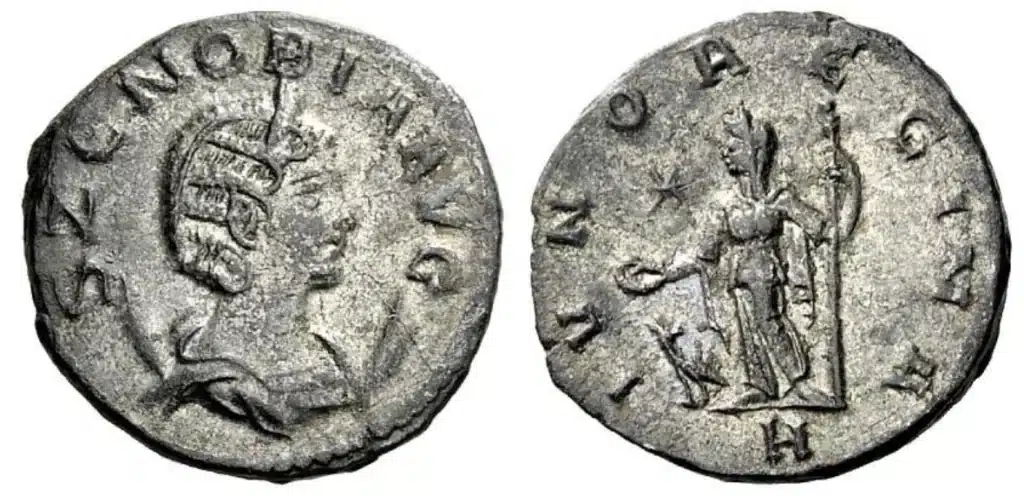 Auction 6417 May 2012 Lot: 1266 realized: 18,000 CHF Approx. $19,044″ width=”696″ height=”337″ />
Auction 6417 May 2012 Lot: 1266 realized: 18,000 CHF Approx. $19,044″ width=”696″ height=”337″ />One of the most remarkable women of the third century CE, Zenobia[18] (born about 240) was queen of the wealthy Syrian oasis city of Palmyra[19]. As a client of the Roman Empire, her husband, King Odaenathus, fought successfully against the Persians until he was assassinated in late 267. As regent for her son Vaballathus, Zenobia led a series of campaigns that brought much of the Roman Empire in the East, including Egypt, under her control. Fluent in Greek, Latin, Coptic, and her native Aramaic, she was a cultured and tolerant ruler of a vast multi-ethnic state.
Rare coinage in her name[20], issued from Antioch or possibly Emesa, followed standard Roman conventions, with Latin inscriptions and a reverse depicting IVNO REGINA (“Queen Juno”). Defeated by Emperor Aurelian in 272, Zenobia was paraded triumphantly in Rome (according to legend, in golden chains) and lived out the rest of her life in comfortable retirement.
* * *
Notes
[1] There is no letter “J” in Classical Latin. The letter only came into use in modern languages after the development of printing in the 16th century CE.
[2] https://en.wikipedia.org/wiki/Interpretatio_graeca
[3] https://en.wikipedia.org/wiki/Temple_of_Juno_Moneta
[4] Roma Numismatics e-Sale 64,June 16, 2021, Lot 1305. Realized £130 (about $183 USD; estimate £100).
[5] https://en.wikipedia.org/wiki/Lanuvium
[6] CNG Auction 114, May 13, 2020, Lot 629. Realized $3,000 USD (estimate $500).
[7] Dionysius of Halicarnassus (1937) i, 59.
[8] CNG Triton XV, January 3, 2012, Lot 1481. Realized $55,000 USD (estimate $20,000).
[9] http://numis.org/coins-of-the-month/may-2022-spotlight/
[10] CNG Auction 124, October 6, 2022, Lot 749. Realized $2,000 USD (estimate $1,000).
[11] NAC Auction 67, October 17, 2012, Lot 353. Realized CHF 4,500 (about $4,876 USD; estimate CHF 3,750).
[12] CNG E-auction 425, July 25, 2018, Lot 466. Realized $100 USD (estimate $150).
[13] https://en.wikipedia.org/wiki/Patera
[14] NAC Auction 125, November 21, 2022, Lot 317. Realized CHF 240,000 (about $252,260 USD; estimate CHF 125,000).
[15] Numismatik Naumann Auction 122, November 6, 2022, Lot 808. Realized €120 (about $119 USD; estimate €40).
[16] CNG Sale 84, May 5, 2010, Lot 1320. Realized $23,000 USD (estimate $20,000).
[17] Leu Web Auction 24, December 3, 2022, Lot 3100. Realized CHF 220 (about $234 USD; estimate CHF 25).
[18] https://en.wikipedia.org/wiki/Zenobia
[19] The UNESCO World Heritage site of Palmyra was extensively destroyed by the so-called “Islamic State” in 2015 in one of the 21st century’s worst acts of cultural vandalism.
[20] NAC Auction 64, May 17, 2012, Lot 1266. Realized CHF 18,000 (about $19,044 USD; estimate CHF 15, 000).
References
Adkins, Lesley and Roy Adkins. Dictionary of Roman Religion. New York (1996)
Berk, Harlan. 100 Greatest Ancient Coins. Whitman: Pelham, AL (2019)
Dionysius of Halicarnassus. Roman Antiquities (Earnest Cary, Translator). Cambridge, MA (1937)
Kent, J.P.C. Roman Coins. New York (1978)
Sear, David. Roman Coins and Their Values, Vol. 1. London (2000)
Stevenson, Seth. Dictionary of Roman Coins. London (1964 reprint of 1889 edition)
Vagi, David. Coinage and History of the Roman Empire. Sidney, OH (1999)
* * *
The post Juno on Ancient Coins – Roman Queen of the Gods appeared first on CoinWeek: Rare Coin, Currency, and Bullion News for Collectors.
Stewart Blay Collections Realize Nearly $5 Million at GreatCollections
The Stewart Blay Collection continued to set records at GreatCollections earlier this month, with almost $5 million in final bids for the finest sets of Flying Eagle Cents, Indian Cents and Barber Dimes ever assembled

Columbian Exposition Coins and Medals Struck by the U.S. Mint
By Vic Bozarth for PCGS ……
Continuing my series on the World’s Fair expositions held between 1876 and 1926, we move to the year 1893 and the Columbian Exposition, by which point the United States Mint had been producing circulating coins for a century. Although the Mint had produced medals for the 1876 Centennial Exposition in Philadelphia, among other special occasions, United States commemorative coins in the formal sense were a new idea.
The U.S. Mint in Philadelphia, the headquarters of minting operations for the United States, produced many different coins and medals. The predominant duty of the United States Mint is to provide coins to be used in commerce by their citizens. However, the Philadelphia Mint had not only the most resources but also exceptionally skilled staff who wanted to show others what they could do.
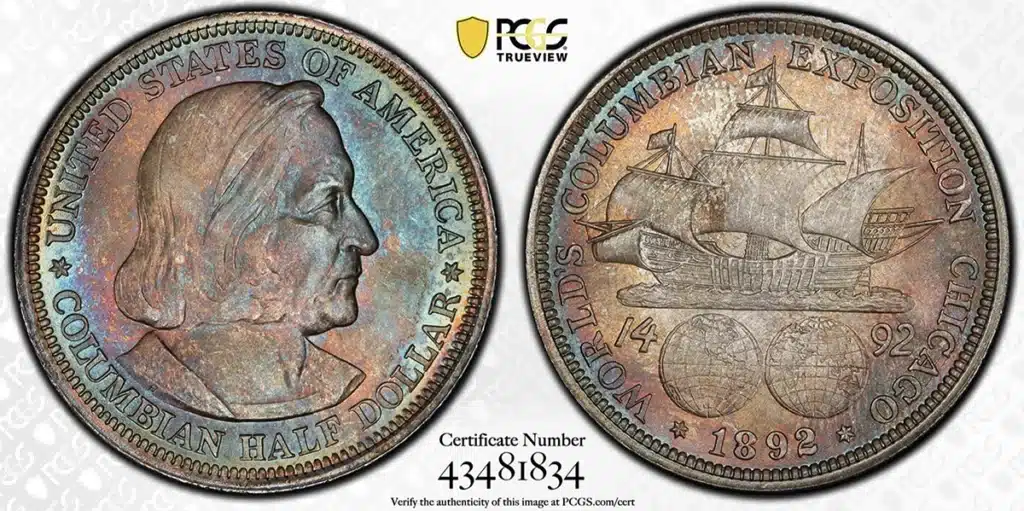
The U.S. Mint produced both the 1892 and 1893 Columbian Exposition Half Dollars as well as the 1893 Isabella Quarter for the Columbian Exposition. Perhaps the most well-known classic commemorative half dollar, issued in both the 1892 and 1893, the Columbian Expo Half Dollars were produced in such large numbers that some were returned to circulation after the fair. The issue prices of 75 cents for the Isabella Quarter and $1 for the Columbian Half Dollar were too steep for many fairgoers.
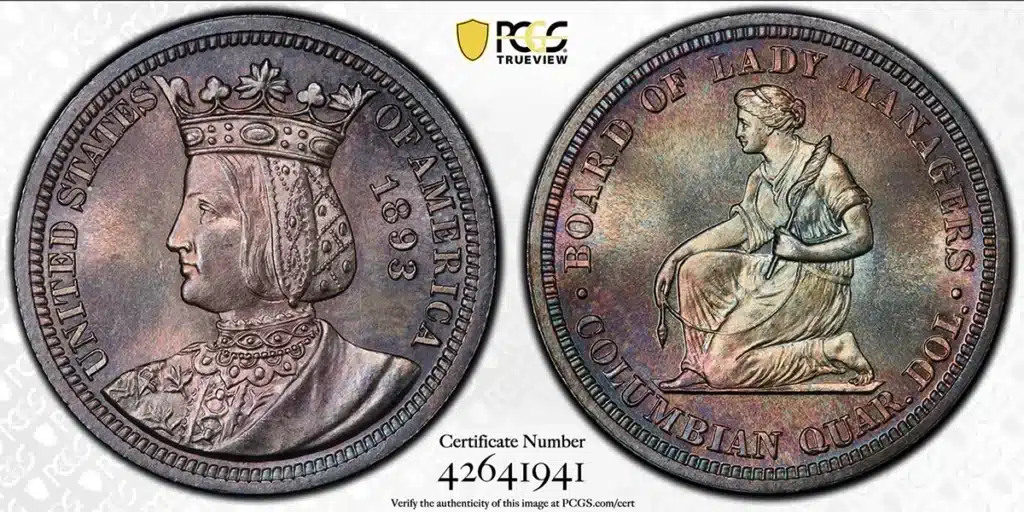
Even today, circulated examples of either half dollar are available for $25 to $30, but the Isabella Quarter wasn’t as copiously produced. Circulated examples in grades between XF40 and AU50 can bring more than $200. Examples of all three coins related to the Columbian Expo are much more valuable in uncirculated grades.
The Official Columbian Exposition Medal
The official medal for the Columbian Exposition was struck by the U.S. Mint. There was one major design type that today is defined by two varieties based on the size of lettering – large letters and small letters.

Both varieties were made in brass, but an estimated three or four Proof aluminum specimens of the large-letter variety strikes are known.
Large Letters
- PCGS #642418, HK-154 (Rarity-2)
- PCGS #642419, HK-154a (R-9)
Small Letters
- PCGS #642420, HK-155 (R-2)
The Saint-Gaudens Columbian Exposition Award Medal
There was a growing amount of dissatisfaction with America’s coinage during the late 19th century. In terms of coinage from other world powers, some considered the coins of the United States to be dull and old fashioned. American artist Augustus Saint-Gaudens, who was on the sculpture board of the Columbian Exposition, was awarded the contract to design the Columbian Awards Medal. The whole idea was to create a design that could compete favorably with European sculptors.
The Augustus Saint-Gaudens Dollar design was completed near the end of the Exposition in 1893, but due to administrative matters it wasn’t ready for its official presentation until 1896. The Saint-Gaudens Dollar, cataloged as PCGS #642541 and HK-223, is a 38-millimeter copper medal produced carrying award-winning designs from both Saint-Gaudens (obverse) and United States Mint Chief Engraver Charles Barber (reverse).
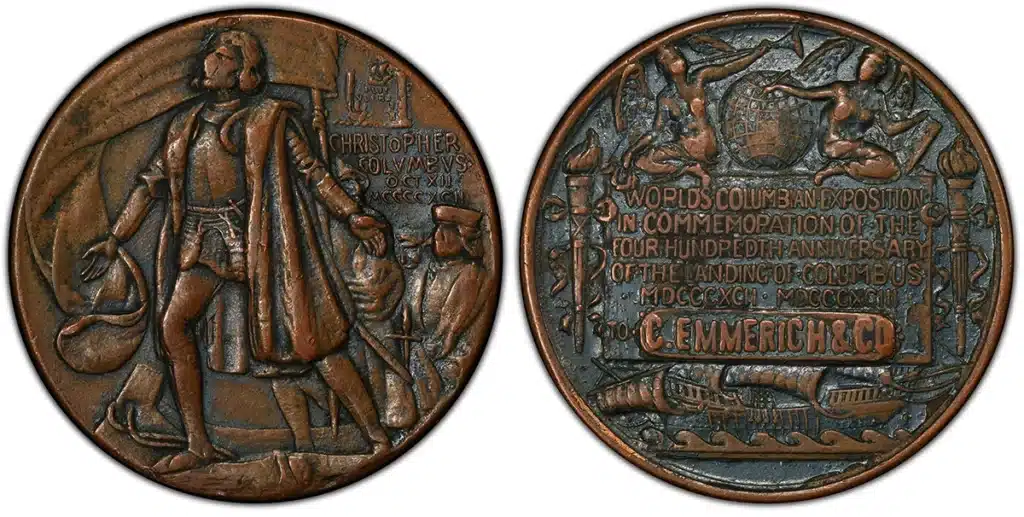
The hub and dies for the medal were produced at the Philadelphia Mint but the striking was done by the Scovill Manufacturing Company of Waterbury, Connecticut. These award medals were presented in velvet-lined aluminum presentation cases with elaborate filigree work.
Other Columbian Exposition Coins and Pieces
Commercially and promotionally, the Columbian Exposition also unleashed a tidal wave of tokens, medals, exonumia, and varied advertising items covering nearly every medium available at that time. Promotional and advertising items were distributed by the thousands. Souvenirs made of aluminum were quite popular because of their unusual light weight. The novelty of the metal, as being so much lighter than other metals, made aluminum-based medals and tokens good sellers.
While there were three coins and two medals produced by the U.S. Mint for the Columbian Exposition, the number of So-Called Dollars issued in relation to the fair were quite numerous. So-Called Dollars numbered HK-156 through HK-243c are all Columbian Exposition issues.
A breakdown of the different categories of Columbian Exposition-related So-Called Dollars is listed below. Take special note of the New Aluminum Dollars, Exhibition Palace Dollars, and Columbus Bust Dollars for the large number of issues just these three categories represent.
- Declaration of Independence Dollar: HK-156 & 157
- Discovery of America Dollar: HK-158
- New Metal Aluminum Dollars: HK-159-162a
- Bird’s Eye View Dollars: HK-164-167b
- Chicago Dollars: HK-168 & 169
- Ferris Wheel Dollars: HK-170-173
- World Globe Dollars: HK-174 & 175
- Exhibition Palace Dollars: HK-176-206a
- Statue of Liberty Dollars: HK-207 & 208
- Columbus Tower/Interstate Dollar: HK-209
- State Dollars: HK-210-219
- Liberty Head Dollars: HK-220-222a
- Saint Gaudens Dollar: HK-223 (Struck by the U.S. Mint)
- Columbus Bust Dollars: HK-224-236a
- Uniface Dollars: HK-237 (237a-237e)
- Columbus Statue Dollars: HK-238 & 239
- Female Figure Landing Dollar: HK-240
- Trinity of Heroes Dollar (Babe Ruth): HK-241
- McCormack Reaper Dollars: HK-242 & 243
- Board of Lady Managers Dollar: HK-243c
- Director-General Dollar: HK-243b
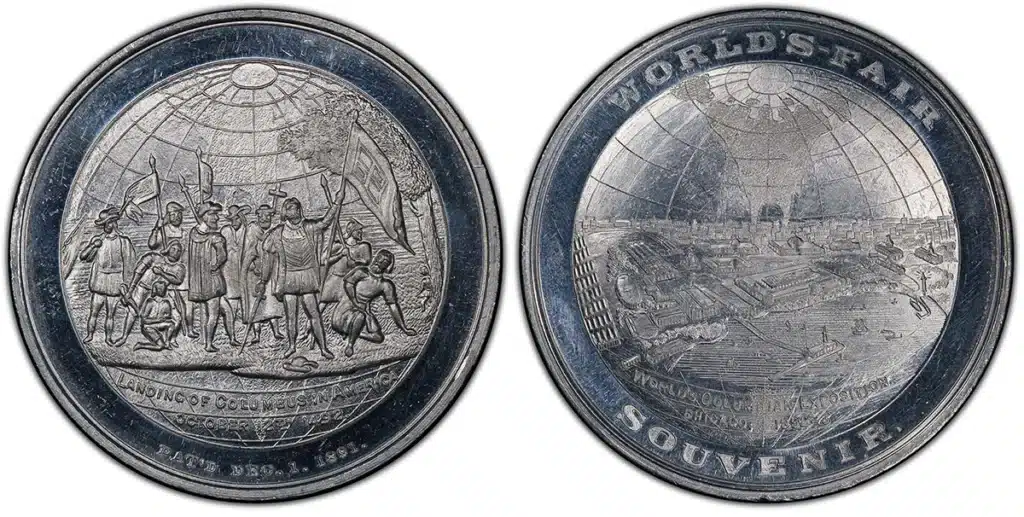

Promoting the Columbian Exposition Coins and Medals
Many reference books on the Columbian Exposition have been written, but the two most pertinent to numismatists are Nathan Eglit’s Columbiana as well as Columbian World’s Fair Collectibles by Howard M. Rossen and John M. Kaduck. Both books are decades out of print, but their information, as well as that in So-Called Dollars by Harold E. Hibler, Charles V. Kappen, and Tom Hoffman, et al., are all relevant and currently what is available.
Once the Columbian Exposition was proposed, there was a massive groundswell of interest from an amazing cross-section of our country and indeed the world. Whether it be technology, science, commercial, cultural, or just general interest, international expositions like the World’s Fairs generated publicity like no other venue at that time. Remember, other than the printed word, there was no radio or television at the time. There wasn’t even widespread use of film to promote or record events.
Unsurprisingly, the Ferris Wheel, first introduced to the world at the Columbian Exposition, was a big hit. The grounds themselves were lavishly manicured and attended. Attention to detail in every medium was important. After all, the U.S. was putting on a show, so to speak.
The artwork and decoration of the era and the exposition itself are fascinating. Take, for example, the tickets for the Columbian Exposition, or a couple of the original holders in which the Columbian Commemorative Half Dollars were sold.
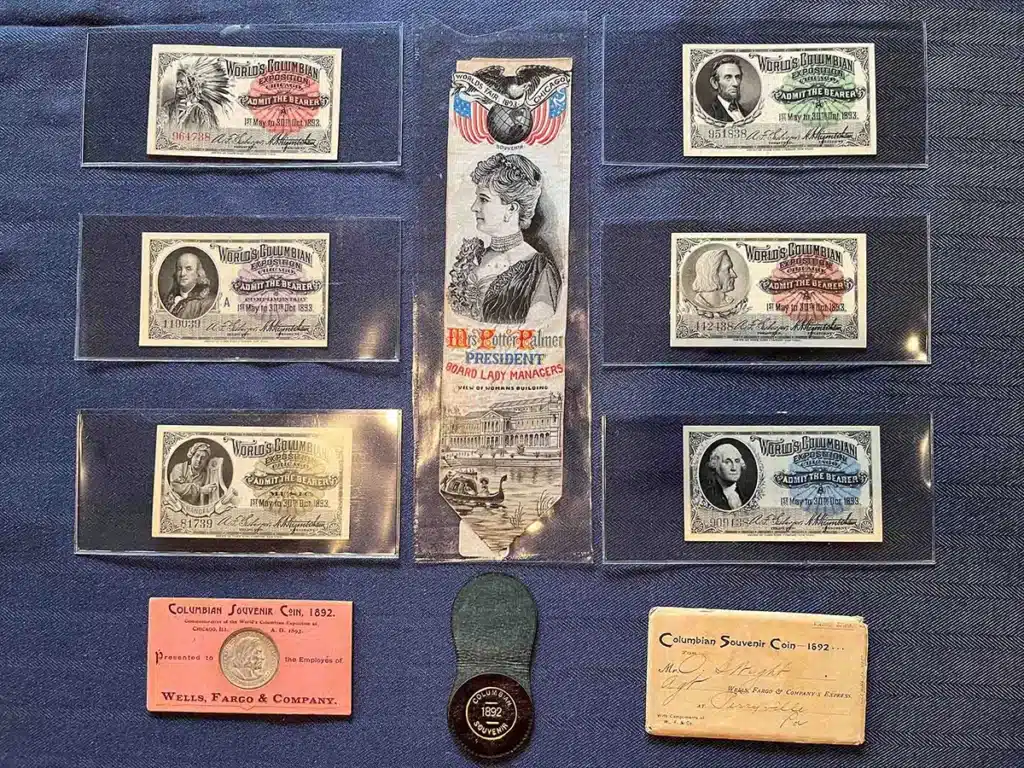
* * *
For more information from PCGS, click on the image below.
* * *
The post Columbian Exposition Coins and Medals Struck by the U.S. Mint appeared first on CoinWeek: Rare Coin, Currency, and Bullion News for Collectors.
Royal Canadian Mint Announces Third Quarter 2023 Results
The Royal Canadian Mint announced its financial results for the third quarter of 2023 that provide insight into its activities, the markets influencing its businesses and its expectations for the next 12 months
Gold and Silver Extend Winning Streaks and Significant Settlement Highs
Prices for precious metals divided on Wednesday, with gold and silver rising and platinum and palladium falling
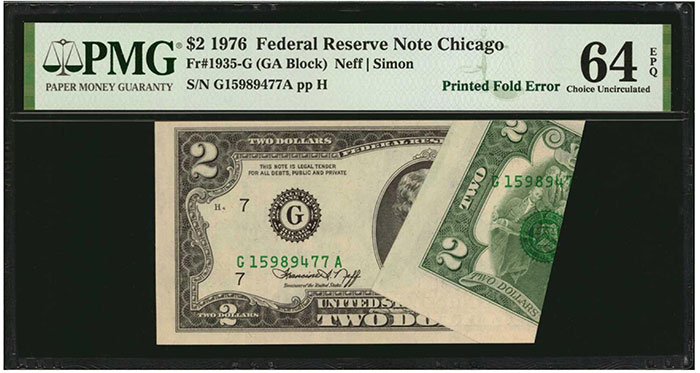
The Bicentennial $2 Bill – First of a Kind

In the mid-1970s, various patriotic and numismatic items were released as the United States marked the bicentennial of its independence from Great Britain, one of the most significant of which was a new $2 bill: the Series 1976 $2 Federal Reserve Note. Sporting a design on the back that appears on the denomination to the present day, the Series 1976 was the first to bear that design and is generally accessible and affordable to paper money collectors.
History of the Bicentennial $2 Bill
Numerous numismatic products were issued marking the Bicentennial. A series of medals struck by the United States Mint was released beginning in 1972. In 1973, President Richard M. Nixon signed a bill authorizing commemorative designs on the quarter, the half dollar, and the dollar coin, along with a double date on those denominations struck in 1975 and 1976. And while it is getting harder, Bicentennial coinage can still be found in circulation today.
Another numismatic item commemorating the Bicentennial,though not as frequently found in circulation, the Series 1976 $2 FRN was approved in late 1975.
On November 3, 1975, Treasury Secretary William E. Simon announced that, in recognition of the United States Bicentennial, the Bureau of Engraving and Printing (BEP) would produce $2 Federal Reserve Notes, the first of their kind.

Though the new design for the $2 denomination was inspired by the Bicentennial, the Series 1976 $2 FRN was not a commemorative issue. The New York Times made explicit the connection between the new $2 bills and the Bicentennial in its November 9, 1975 coverage:
“[T]he bill is not a ‘special’ Bicentennial‐year issue; it will continue on as a permanent part of the nation’s circulating paper currency.”
The new notes were the first FRNs of the denomination; the last $2 notes issued, in the 1960s, were Legal Tender Notes with a red Treasury Seal and serial numbers. $2 Legal Tender Notes, National Bank Notes, Silver Certificates, Treasury Notes, and Federal Reserve Bank Notes had all been issued since the 1860s.
The face design remained largely unchanged, except the Treasury Seal and serial numbers, which on the $2 FRN is green.
The back design changed completely, with Thomas Jefferson’s mansion Monticello replaced by a depiction of John Trumbull’s painting entitled Declaration of Independence (1817). It was executed for the notes by Peter Cocci, a BEP staffer. The Bicentennial issue was not the first outing of Trumbull’s painting on U.S. paper money, of course; it first appeared on the back of $100 National Bank Notes in 1863, the year after the first federal $2 notes were introduced. The denomination appears in numerals in each corner, with scrolls featuring the written denomination flanking the bottom two numbers; the written denomination also appears vertically on either side of the Trumbull vignette.
Trumbull’s painting also appeared on one of the series of commemorative stamps issued for the Bicentennial, split into four sections; each of the four stamps in the series bore a quarter of the painting.
A total of 590,720,000 Series 1976 Bicentennial $2 bills were printed and the production run ended in 1978. All of the notes produced bear the signatures of Treasury Secretary Simon and Treasurer Francine Irving Neff.
The scarcest Star note for the series is the Friedberg-1935-J*. The issue’s Minneapolis Star notes are comparably rare.
The notes were released on April 13, 1976, Thomas Jefferson’s birthday.
Collectability of the Series 1976 $2 Note

Some observers were hopeful that the $2 denomination would be accepted in commerce, possibly reducing demand for $1 FRNs. An April 11, 1976, New York Times article claimed that:
“The new $2 note is expected to replace about one‐half of the $1 bills in circulation over the next several years. This will result in an estimated saving of $4 million to $7 million per year in printing costs.”
Nevertheless, the notes did not circulate widely, whatever the hopes of their proponents. The denomination is so uncommon in some areas that people have been arrested for trying to spend $2 notes at retail establishments. Yet the vast majority of Series 1976 $2 bills are abundant and affordable.
An interesting notaphilic and philatelic product was created around the Series 1976 $2 Federal Reserve Note release. Many people took the bills to post offices on the release day, affixed stamps directly to the notes, and had the stamps canceled at their local post office. Numerous series of commemorative stamps were issued marking the bicentennial, which made for thematically fitting note-stamp pairings. The stamped notes are not worth much beyond their face value, but a collector might seek out a note from their hometown or another location of personal significance.
Art Friedberg, the co-author of Paper Money of the United States (21st Ed., 2017), shares that the stamped Series 1976 $2 FRN sold briskly around the time of the Bicentennial.
“It was different, it was collectible, people loved it. We made a lot of money,” Friedberg explained in a phone interview.

Robert Azpiazu, owner of First City Coins and Collectibles and author of Collector’s Guide to Modern Federal Reserve Notes Series 1963-2009 (2011), elaborates on the stamped notes’ appeal in an email interview:
“There are some cancellations that are very valuable but only to a small group of eclectic collectors.”
Series 1976 Bicentennial $2 bills appear in a number of U.S. Mint products, including the 1994 Thomas Jefferson 250th Anniversary Coinage and Currency set, notable for its Satin Finish Jefferson nickel.
At the time of writing, Paper Money Guaranty (PMG) reports 18,462 total grading events for Series 1976 Bicentennial $2 bills from all 12 Federal Reserve banks; 5,538 of those are Star notes.
Circulated examples of Series 1976 $2 FRNs can be bought for around face value or occasionally found in circulation. Uncirculated examples can bring a dollar or two over face.
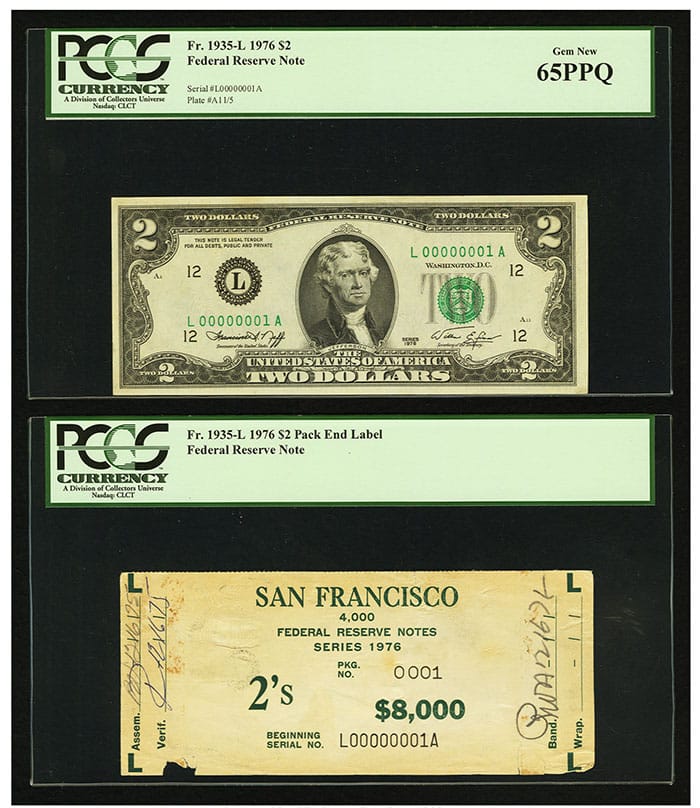
Rarer Star notes naturally command higher premiums, as do notes at the highest end of the condition scale or those with collectable serial numbers. F-1935-L with serial number 1 sold with its brick label in a Heritage auction on January 8, 2016, for $21,150 USD.
Issued in massive numbers with a design commemorating the U.S. Bicentennial, Series 1976 $2 Federal Reserve Notes are affordable and abundant, notable as the first $2 FRNs and for the numerous stamped specimens available for a little over their face value.
* * *
The post The Bicentennial $2 Bill – First of a Kind appeared first on CoinWeek: Rare Coin, Currency, and Bullion News for Collectors.
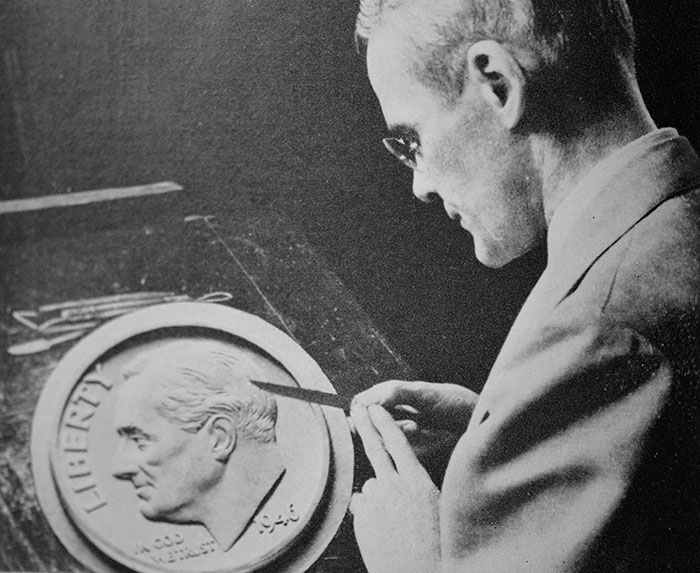
The Roosevelt Dime – Stolen Design or Communist Plot?
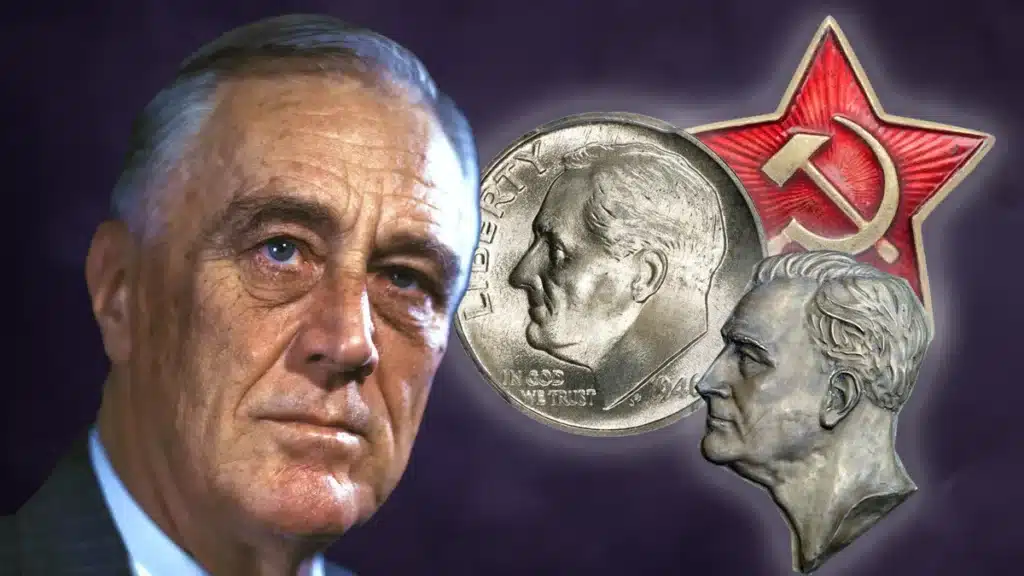
By David Thomason Alexander for CoinWeek …..
Most circulating United States coins have received their share of negative press when first issued. This includes the beloved Roosevelt dime.
The first 1793 cents were denounced for their Chain reverse, adapted from the earlier Fugio cent but held to be a poorly chosen symbol with which to back up the Liberty head obverse. John Reich’s buxom Liberty on the 1807 half dollar was sneered at as a likeness of the artist’s “fat German mistress.”
It is scarcely necessary to go back that far in history for other examples of such popular outcries, which in virtually every case have not been based on fact. The great strength of rumor, even before the internet, has always been the ease with which preposterous stories can be launched and the difficulty in silencing them. The stories are almost always so much more fun! The first 1916 Standing Liberty quarter allegedly received a storm of criticism because designer Hermon McNeil left Liberty’s breast bare.
And some of the loudest denunciations have been based on historical memory rather than fact, such as Southern objections to the placing of Abraham Lincoln’s bust on the cent in 1909 – the “final step in transforming America into a monarchy!” as some newspapers put it at the time.
So it was upon the death of President Franklin Delano Roosevelt at his “Little White House” in Warm Springs, Georgia, on April 12, 1945. The United States was finishing the most terrible world war in history and a slightly punch-drunk population was eager for the return of peace.
The president was exhausted from four terms as chief executive during the worldwide Great Depression and the ceaseless ordeal of war. He was still weakened from the 1921 assault of poliomyelitis, or “infantile paralysis”, from which he had emerged partially paralyzed and unable to walk freely. This condition was carefully concealed from the general public, which never saw him in a wheelchair.
A special and never-publicized railroad spur from the New York Central’s mainline under Park Avenue existed to get the president’s private car into the basement of the Waldorf-Astoria Hotel to avoid public scrutiny. At Warm Springs, he continued the hydrotherapy he had once believed would enable him to overcome the lingering damage of polio.
Today, medical researchers suggest that his dogged hyper-exercise may have had the opposite effect, making Roosevelt’s condition worse.
In 1945, FDR was no stranger to medallic art, of which coin design is one branch. His portrait graced Presidential Inaugural Medals in 1933 (by Paul Manship), 1937 (by Joseph Anthony Atchison), 1941, and 1945 (by Jo Davidson). Then, too, the United States Mint under long-serving director Nellie Tayloe Ross had produced large-diameter Presidential medals as part of its ongoing series, the FDR issues designed by Chief Engraver John Ray Sinnock.
John R. Sinnock at the Mint
Sinnock was born in 1888 in Raton, New Mexico, studied sculpture at the Philadelphia Museum School of Industrial Arts, and began building his professional career as a member of the prestigious Philadelphia Sketch Club and the Philadelphia Alliance for the Arts. He joined the Philadelphia Mint as an assistant to the elderly George T. Morgan in 1923, and in 1928 succeeded him as Chief Engraver.
Employment at the Mint assured regular income but offered only the most limited opportunities for coin design. Once approved, circulating coin designs could not be changed for 25 years, although commemorative coins in 1921-1939 offered some creative opportunities. The Mint had long ceased to be a moving force in the world of art and design, and at first, a large part of Sinnock’s duty was the propping up of the aged Morgan.

In 1945, silver coins in production included two altogether exceptional designs by Adolph Alexander Weinman, adopted in 1916: the Walking Liberty half dollar and the Winged Liberty or “Mercury” dime. In Roman mythology, Mercury was a male figure, the ancient messenger of the gods. The female Liberty in the winged Phrygian cap, according to Weinman, was supposed to symbolize freedom of thought, one of the Allied goals of World War II.
The muscular, striding figure of Liberty on the half dollar strongly resembled French sculptor Louis Oscar Roty’s Liberty the Sower, who may still be seen on French euro coins today. For sheer beauty, both half dollar and dime rank high among all American coin designs released since 1794.
The quarter dollar with its Washington bust after Jean-Baptiste Houdon was a comparative newcomer, approved amid controversy in 1932.
Design of the Roosevelt Dime
Upon learning of FDR’s death, Mint Director Ross, a fervently loyal Roosevelt appointee, set to work immediately to assure that his portrait would adorn the roster of coins in daily circulation as soon as possible. A commemorative coin would not do, and neither a silver dollar nor gold coins were being issued. That left the half dollar and the dime.
FDR had been closely identified with the nationwide effort to combat the scourge of polio, which was intensifying throughout the country, particularly in major cities during the summers. This author well remembers the annual hysteria in New York City that included sequestering youngsters indoors despite stifling summer heat.
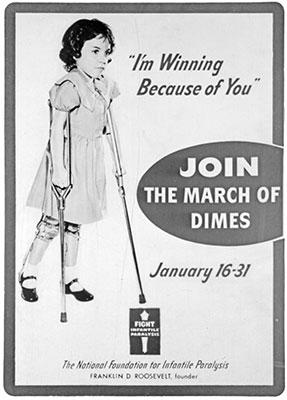 There was then no vaccine, and only a fuzzy understanding of the causes of the disease (though intensive research was underway). Every school had its complement of youngsters wearing cumbersome leg braces, making their way as best they could. Held fortunate were children (including the author) who survived mild attacks of polio that immunized them to future attack. The great “March of Dimes” fundraiser was providing large sums to pay for in-depth research and Director Ross drew a bead on that denomination.
There was then no vaccine, and only a fuzzy understanding of the causes of the disease (though intensive research was underway). Every school had its complement of youngsters wearing cumbersome leg braces, making their way as best they could. Held fortunate were children (including the author) who survived mild attacks of polio that immunized them to future attack. The great “March of Dimes” fundraiser was providing large sums to pay for in-depth research and Director Ross drew a bead on that denomination.
Then, too, the ancient Roman symbol of the fasces adorned the existing dime reverse. Composed of an axe and a bundle of sticks that could be easily broken individually but bound together were virtually indestructible, the fasces had been adopted by Italian dictator Benito Mussolini in 1922 as the emblem of his Fascist Party. Weinman’s fasces copied the bronze emblems on the wall of the House of Representatives flanking the Speaker’s rostrum where they remain today.
The forceful Ross realized that the Winged Liberty dime had passed its 25th anniversary in 1941 and could be changed without permission of Congress. She gave the go-ahead and the aging Sinnock went to work, propelled by a bill introduced on May 3 by Louisiana Congressman James Hobson Morrison authorizing a Roosevelt portrait. On May 17, Treasury Secretary Henry Morgenthau, Jr. announced that the new dimes would enter circulation close to year’s end.
The American Numismatic Association (ANA) journal The Numismatist claimed that 90 percent of its readers backed the Roosevelt honor, though Morgenthau personally believed that FDR was simply not in the same league as Washington, Jefferson, and Lincoln. Be that as it may, Sinnock was given the signal, though much of the actual work fell on his assistant Gilroy Roberts, with some input from artists on the Commission of Fine Arts (CFA).
The task was complicated by the tiny work area this denomination presented. The obverse was straightforward: the head of Roosevelt facing left, LIBERTY along the left rim, tiny IN GOD/ WE TRUST below the chin and the mintmark and date at the lower right. Not noticed, seemingly, were the tiny letters “J S” for engraver Sinnock.
 The first reverse design publicized showed a disembodied hand gripping a flaming torch of freedom and two sprigs of olive symbolizing the return of peace. UNITED STATES OF AMERICA was placed above, ONE/ DIME at left; E/ PLURIBUS/ UNUM (“Out of Many, One”), at right. At the base was the denomination, ONE DIME.
The first reverse design publicized showed a disembodied hand gripping a flaming torch of freedom and two sprigs of olive symbolizing the return of peace. UNITED STATES OF AMERICA was placed above, ONE/ DIME at left; E/ PLURIBUS/ UNUM (“Out of Many, One”), at right. At the base was the denomination, ONE DIME.
Objections to this make of the Roosevelt dime were received immediately to the hand and its tightly touched mass of leaves. Sinnock then quickly placed the torch at the center, with separate sprigs of olive at left, oak for wisdom at right, and a tiny E.PLU – RIB – US.U-NUM oddly broken up in a straight line across the reverse. All lettering was in bold sans-serif style. Newly appointed Treasury Secretary Fred Vinson, coming in late, at first rejected the models for the new dime but was won over by sculptor Lee Lawrie.
Sinnock now sank into the serious illness that was to kill him a year later. Moving swiftly, Director Ross telephoned the CFA to report these various approvals, but only after she had authorized the beginning of actual production of the new coins. The Commission was irritated, and this speed was to contribute to the controversy that soon broke out.
Some leading art critics applauded the new coin. Artist and archaeologist Cornelius Vermeule in his Numismatic Art in America (second enlarged edition with David T. Alexander, Whitman 2007) called it “a clean, satisfying and modestly stylish, no-nonsense coin that in total view come forth with notes of grandeur.”
Others have criticized the portrait itself: a round-headed likeness that critics allege does not closely resemble the long-headed FDR. Close study of the Roosevelt Presidential Mint medals will show that the facial features on the dime are accurate but the head shape simply is not. Nonetheless, the new dime was a “go”.
“Uncle Joe” Signs the Dime
No one knows with certainty when the major controversy broke out.
During 1946, the fracturing of the wartime alliances was nearly complete, as Soviet occupation of Eastern Europe emerged as a permanent reality and the first loud questionings were heard of who allowed this to happen and the search for culprits began. Decisions made at Tehran, Cairo, Yalta, and Potsdam were loudly cited and the search for alleged communist influence, sympathizers, and spies began.
FDR’s one-time Vice President Henry A. Wallace led his new Progressive Party into ruin in 1948. Long-time New Deal stalwart Senator Claude Pepper of Florida went down in flames after an especially ill-timed and poorly thought-out meeting with Marshal Josef Stalin of the USSR. “The American people like you, Marshal! They call you ‘Uncle Joe!’”
That kind of talk fitted the wartime mood of 1944; by 1946 it had become anathema. Now denounced by Senate contender George Smathers as “Red Pepper”, the veteran New Dealer went into political eclipse for decades.
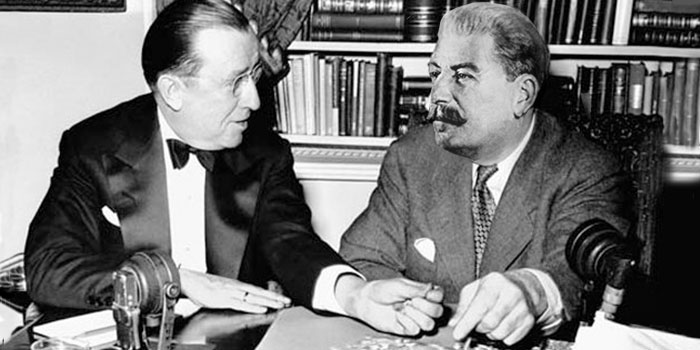
A public outcry now broke out, “That’s it! Just look at these new Dimes!!! Right there, J.S. for Joe Stalin! Find the culprit!! This senseless chorus became so strident that the Treasury Department felt obligated to issue official denials. Soon the long shadow of Wisconsin’s Junior Senator Joseph R. McCarthy fell across the land and the “Joe Stalin story” had lots of company.
But for all of that, the initials remain of the dime today, 75 years later.
Researchers trying to find the actual origin of this story are at a loss, as they are with the endlessly repeated story of Liberty’s breast on the 1916 quarter. In that case, serious researchers have never found any reliable evidence that the public outcry against MacNeil’s design ever took place, but the story itself is in “all the books”.
Selma Hortense Burke
All this hoopla, however, has distracted collectors from another and somewhat more solid question: was Sinnock really the designer of the Roosevelt dime? Was the Roosevelt head actually his work?
Lost in the storm over initials were the protests of those who assert that the Roosevelt head on the dime was actually the work of African-American sculptor Selma Hortense Burke (born December 31, 1900, died August 29, 1995).
North Carolina native Burke was an experienced health care nurse, educator, and major artist, active in New York City’s Harlem Renaissance and a friend of such figures as Langston Hughes, Ethel Waters, Eugene O’Neill, and Sinclair Lewis. In 1943 the Commission of Fine Arts announced a competition for the design of a sculptural plaque to honor President Roosevelt and his famous “Four Freedoms“, enunciated as major Allied goals in stressful early stages of the Second World War.

These were Freedom of Speech, Freedom of Religion, Freedom from Want, and Freedom from Fear, and were popularized on posters, postage stamps, and medals. Among the most widely hailed two-dimensional treatments was Norman Rockwell’s series of paintings, which remain popular today.
The CFA contest attracted 11 artists and Selma Burke was declared the winner. A perfectionist, she insisted on completing her plaque in a sitting with President Roosevelt, something deemed impossible in wartime! Yet FDR agreed to sit for her and the finished plaque was dedicated at the Recorder of Deeds Building in Washington, D.C., for decades a center for the exhibition of paintings, murals, and sculptural work of African-American artists.
The president’s wife Eleanor viewed Burke’s completed plaque but expressed the view that it made him look “too young”. The president’s son James later expressed his belief that Burke’s sculpture should be recognized as the model for the dime, a belief shared by the Franklin D. Roosevelt Presidential Library in Hyde Park, N.Y.
With the Josef Stalin story successfully relegated to the realm of historical fantasy of the troubled era of the Cold War, perhaps numismatists’ attention might be more productively focused on the more concrete question of the identity of the real designer of the Franklin Delano Roosevelt dime.
* * *
The post The Roosevelt Dime – Stolen Design or Communist Plot? appeared first on CoinWeek: Rare Coin, Currency, and Bullion News for Collectors.
Roman Republican Die Project Announces New Phase, Conference
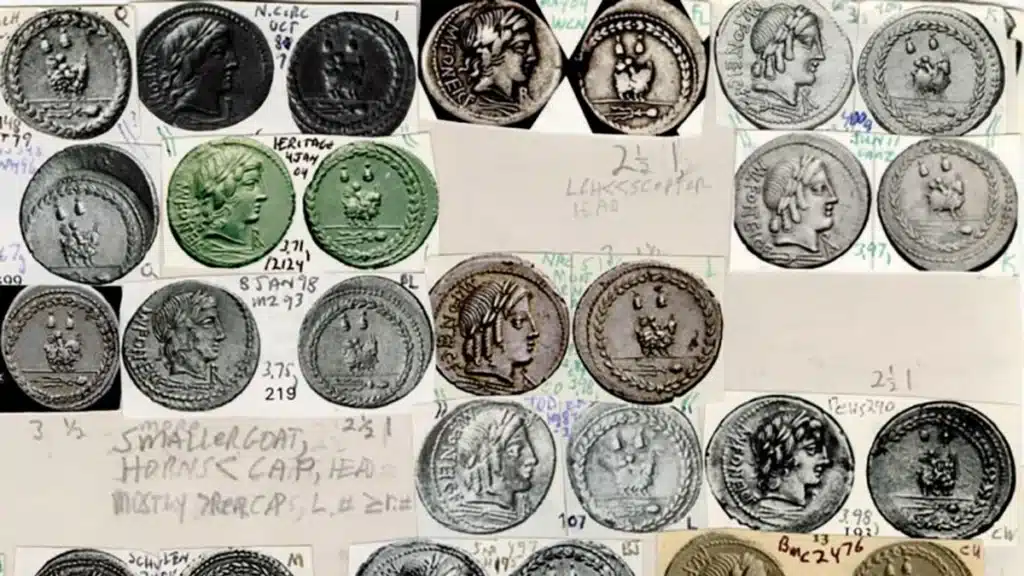
The Roman Republican Die Project (RRDP), a digital repository of Roman republican coin dies based on the archive of Dr. Richard Schaefer, has announced the beginning of the fourth phase of its work with help by a grant from the Arete Foundation. The main goal of this fourth and final phase is to show how the RRDP informs current scholarship and catalyzes research collaboration. The two-year grant will fund the full-time work of lead researcher Dr. Alice Sharpless, who is assigned to the project through the American Numismatic Society (ANS) until June 2025. The Arete Foundation has provided additional funding for a conference hosted by the American Academy in Rome (AAR) April 9-11, 2025. The conference will generate an open-access volume of the Supplements to the Memoirs of the American Academy in Rome (SMAAR).
RRDP relies on the foundational research of Dr. Schaefer, who has compiled a significant archive of over 300,000 images of Roman republican coins he identified by die. While Schaefer’s materials are publicly available through ARCHER, the ANS’s archival database, the RRDP seeks to make his work accessible to researchers through a searchable, linked open data die database (RRDP) and specimen database (SITNAM). These resources are then linked to Coins of the Roman Republic Online (CRRO). The integrated database provides a valuable tool for research, including understanding the connection between military and domestic projects and monetary production, and vetting the accuracy of ancient sources on these subjects. The project will also facilitate research on the scale of Roman coin production in comparison to other contemporary coinages (especially in the Greek East), and the reliability of Michael Crawford’s production estimates based on hoard counts in his well-known and standard catalog, Roman Republican Coinage (Cambridge, 1974).
The conference at the American Academy in Rome will expand the scope of the project, which in previous phases focused on control-marked coinage and issues from the period 95-75 BCE, and to showcase potential methods of using the RRDP for other scholarly research. The Roman Republican Die Project has invited conference participants to submit requests for specific Roman republican issues to be processed: over the next 16 months, selected issues will be transcribed and the data will be shared through the project’s databases. Conference participants will share their original research on these issues utilizing data provided by RRDP.
A final conference program will be published in late 2024: confirmed speakers include Richard Schaefer, Seth Bernard, Andrew Burnett, Kevin Butcher, Alberto Campana, Pierluigi Debernardi, Claudia Devoto, Elizabeth Heintges, Wilhelm Hollstein, Fleur Kemmers, Roberto Lippi, Kris Lockyear, Andrew McCabe, Guillaume Méritens de Villeneuve, Charles Parisot-Sillon, Annalisa Polosa, Matthew Ponting, Mariangela Puglisi, Clare Rowan, Marleen Termeer, Lucia F. Carbone, Liv Mariah Yarrow, and Alice Sharpless. Researchers interested in regular updates can contact Alice Sharpless at asharpless@numismatics.org to be added to the conference mailing list.
* * *
The post Roman Republican Die Project Announces New Phase, Conference appeared first on CoinWeek: Rare Coin, Currency, and Bullion News for Collectors.
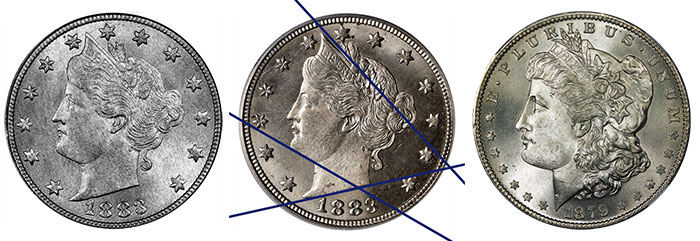
1883 Liberty Head Nickel – Without Cents : A Collector’s Guide
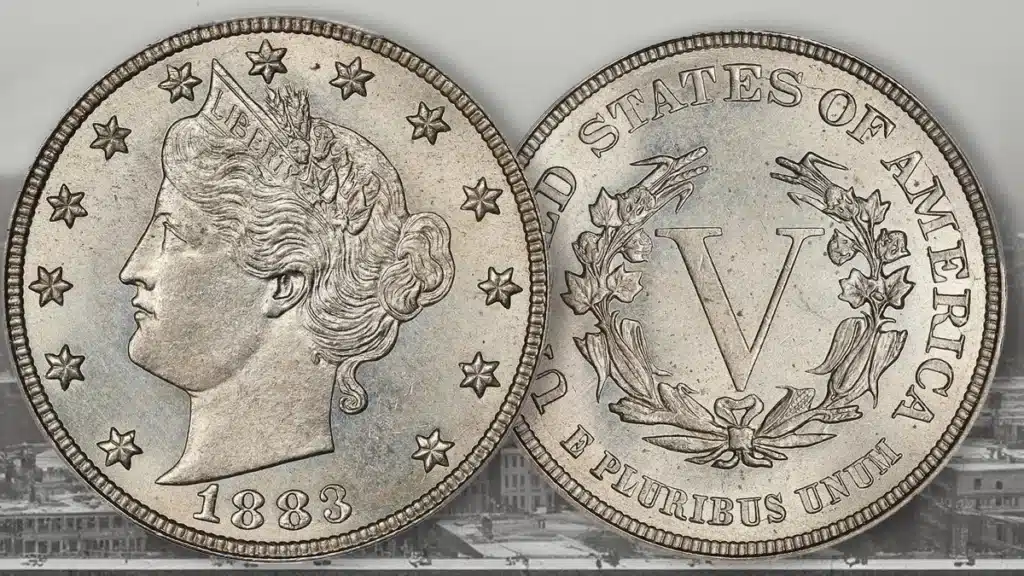
The Liberty Head nickel–or “V” nickel, as it’s more commonly known–was the second design style of the United States five-cent nickel coin. The design, the work of Chief Engraver Charles E. Barber, was a modest improvement over James B. Longacre’s Shield nickel, which had entered production in 1866 and served the nation for 17 years.
Snowden Sought to Remake More than Just the Nickel
In 1881, United States Mint Director James Ross Snowden decided to unify the designs of the cent, three-cent, and five cent coins. The cent and five-cent coins widely circulated, but the three-cent nickel, which debuted in 1865, was declining in popularity. After two Proof only issues in 1877 and 1878, more than a million pieces were struck in 1881. This would be the final year that the denomination experienced a mintage over 42,000 pieces.

Barber created Liberty Head designs for all three denominations, and patterns were struck later that year. However, Snowden was unable to implement his desired design alterations for the cent and three-cent nickel, so only the five-cent nickel design ever saw full production.
Barber’s Nickel Design Was Inspired by the Morgan Dollar
Barber’s design was heavily influenced by George T. Morgan’s silver dollar obverse, which entered into production in 1878. Comparing the two designs side by side is unflattering to the Barber nickel. Whereas Morgan’s Liberty is naturalistic and full-bodied, Barber’s Liberty is set at a slightly farther distance and is flat and lifeless.

Another element of the design that is interesting to note is Barber’s use of straight lines and how that differs from the Morgan design. The top of Liberty’s diadem cuts a straight 45-degree angle pointing downward. Liberty’s chin, a 30-degree angle pointing downward. And Liberty’s bust truncation cuts a straight 12-degree angle pointing up. This is likely an over-analysis on our part but compared to the curved bust truncation, curved diadem, and bulbous chin line of Morgan’s design, it’s no surprise that many feel Barber’s bust portrait comes across as lackluster.
Production History, Release, and Problems
Barber’s effort to redesign the nickel five-cent coin did not escape bureaucratic interference. In December 1882, after two years of refining his concept and believing that he had finished his work, Barber sent the designs to Mint Director Horatio Burchard for review, with the expectation that he and Treasury Secretary Charles Folger would quickly approve the designs.
The designs he sent featured the familiar left-facing bust portrait of Liberty with UNITED STATES OF AMERICA inscribed around the rim with the date below the bust truncation. The reverse featured a large Roman “V” surrounded by a vegetal wreath, with E PLURIBUS UNUM inscribed above.
Instead of accepting them, Folger, whom researcher R.W. Julian calls a stickler for the letter of the law, rejected the designs. Folger objected to the placement of the inscriptions and directed the Mint to adjust the design so that it would satisfy the language of the Coinage Act of 1873. Folger specifically stipulated that LIBERTY and the date appear on the obverse and that the legend UNITED STATES OF AMERICA, the motto E PLURIBUS UNUM, and the coin’s denomination appear on the reverse.
On December 20, Mint Superintendent Archibald Loudon Snowden wrote to appeal Burchard’s decision, arguing that the Treasury Secretary had misinterpreted the law and that the proposed design did not violate it. Folger made quick work of Snowden’s appeal and ordered the change. The Treasury did approve the design motif, however.
On January 4, the Philadelphia Mint sent revised designs for the Liberty Head “V” nickel to Washington, D.C. for review by Mint Director Burchard and Treasury Secretary Folger. Mint Director Burchard responded on January 8, informing the Mint that the revised designs had been approved and that production of the new design could begin.
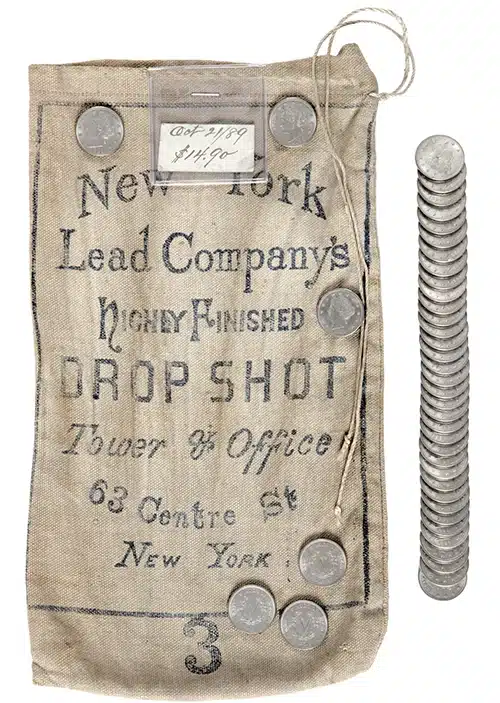
The nickel was initially released without the word CENTS inscribed on the reverse. This type has been referred to as “Type 1”, “Without Cents”, or, as in the 1908 Max Mehl publication Numismatic Monthly, “Centsless”. The Roman numeral “V”, coupled with the nickel planchet (similar in composition but slightly larger than the Shield nickel it replaced), was supposed to inform users of its value. It’s worth noting that the three-cent pieces struck in silver billon and nickel also did not include the denomination, and there was no apparent problem arising from their use. It is also debatable whether the initial design was in violation of Section 3517 of the Revised Statutes of the United States, which specify that the reverse of coins issued by the Mint must bear “designation of the value of the coin”.
A commencement ceremony was held on January 30 to mark the start of the new coinage. The first business strike was sent to President Chester Alan Arthur. Additional strikes were presented to various dignitaries. Regular coinage began on February 1.
No Cents Nickels Cause Headache for the Treasury, the Mint, and Everyone Else
Within a short time of the 1883 Liberty Head nickel’s release, stories began to circulate around the country of people gilding the new coins and passing them as five dollar gold pieces.
A name that is commonly thrown around in relation to this issue is Josh Tatum, a supposed deaf-mute con artist from Boston, Massachusetts. According to legend, Tatum had 1,000 nickels plated and passed them for gold coins as he made his way from Boston to New York. As far as we can tell, no solid information has ever been presented to corroborate this tale. There is no census information, criminal records, or contemporaneous newspaper accounts of the many supposed Tatum swindles. Yet, the story persists and is often cited in auction catalogs whenever an 1883 Liberty Head nickel is offered for sale.
The gold-plating issue was a real concern, however. As Lianna Spurrier writes in her CoinWeek article Fact of Myth: Racketeer Nickels, the Secret Service had immediate misgivings about the coin’s design and put out a press release nine days after the coin’s release calling the Mint’s new nickel “dangerous” and suggesting that criminals could apply “a thin plating [that] would enable persons to pass them off in some places as gold coins of a new issue.” Given that the Secret Service had primary jurisdiction over fighting financial crimes and threats to America’s money, this was a significant step.
Word of this concern, and possibly too, isolated cases of plated coins being passed as gold coins spread throughout the country. A. Loudon Snowden, the Superintendent of the Philadelphia Mint travelled to Washington to defend the design, pointing to the similarity of the new five cent coin to the circulating three-cent coin. Both denominations used roman numerals and neither design denoted the word CENTS. Snowden’s argument proved unconvincing and in early March, work began on a new reverse die that would include the word CENTS.
How Much is the 1883 Liberty Head Nickel Without Cents Nickel Worth?
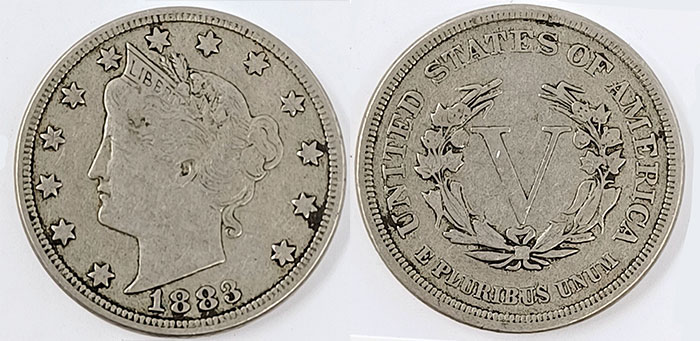
The 1883 Without Cents nickel is an affordable classic U.S. coin that should fit within the budget of every collector. In circulated condition, the coin will cost between $2.00 (for the Fine-12 example above) to about $25 for a Choice About Uncirculated example. About Uncirculated coins are coins that feature all of the design elements but exhibit traces of wear or cabinet friction.
A large number of “Without Cents” nickels were hoarded by collectors and speculators while the government endeavored to withdraw them from circulation, this is largely the reason why the coin is one of the most affordable issues in the series in Mint State.
In Uncirculated grades, the coin’s value quickly jumps to $100 for an example in MS63 and $250 for a coin in MS65.
PCGS and NGC have combined to grade a few thousand examples at the Gem level. CAC has approved a slightly more than 300 at MS65 and MS66. The coin becomes “investor” grade once you climb to the Superb Gem grade of MS67. Here, the availability of coins drops dramatically.
At the time of this publication (late November 2023), NGC reported only 76 grading events at this level (eight being plus grades) and none finer. PCGS, likewise, shows a low double-digit population at MS67, with 52 making the base grade and 15 earning a plus. There are outliers in the auction records, but the typical example in MS67 has sold for $1,200 to $1,400. In the plus grade, there is a disparity between auction records for coins in NGC and PCGS holders. The NGC examples typically bring about $2,400; the PCGS coins can bring $5,000 or more, depending on the coin and the venue.
Design
Obverse:
The Liberty Head nickel was designed by Charles E. Barber, who is the namesake behind the Barber (officially “Liberty Head”) dime, quarter and half dollar; some hobbyists have similarly dubbed the Liberty Head nickel as the “Barber” nickel, though this has not been common practice. The 1883 Liberty Head nickel features a leftward-facing bust of Miss Liberty, whose hair is tied into a bun behind her head. She is crowned with a tiara bearing the inscription “LIBERTY.” 13 stars, representing the 13 original states of the Union, mostly encircle the bust along the obverse rim. At the bottom center of the obverse is the coin’s date, 1883.
Reverse:
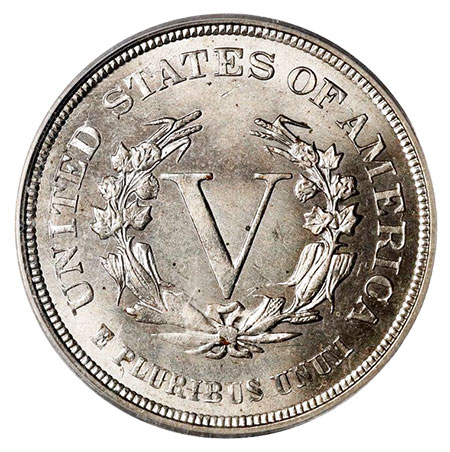 While the Liberty Head nickel may only infrequently be identified as the “Barber” nickel by hobbyists, the coins do have one widely popular nickname: the “V” nickel. The “V” refers to the large Roman numeral “V” that anchors the reverse design and indicates the coin’s denomination of five cents. The “V” sits within a wreath of cotton, corn, wheat and tobacco – all important crops representative of different parts of the country. Centered under the wreath is the inscription E PLURIBUS UNUM. No mention is made of the word “cent”. The absence of “cent” was not unusual, as the base metal three-cent nickel and the billon three-cent silver also told of their value using a Roman numeral and did not include the word.
While the Liberty Head nickel may only infrequently be identified as the “Barber” nickel by hobbyists, the coins do have one widely popular nickname: the “V” nickel. The “V” refers to the large Roman numeral “V” that anchors the reverse design and indicates the coin’s denomination of five cents. The “V” sits within a wreath of cotton, corn, wheat and tobacco – all important crops representative of different parts of the country. Centered under the wreath is the inscription E PLURIBUS UNUM. No mention is made of the word “cent”. The absence of “cent” was not unusual, as the base metal three-cent nickel and the billon three-cent silver also told of their value using a Roman numeral and did not include the word.
The legend UNITED STATES OF AMERICA wraps around the top three-quarters of the reverse along the rim.
Edge:
The edge of the 1883 Liberty nickel is smooth or plain, without inscription.
Designer
Charles Edward Barber was born in London in 1840. He was the son of William Barber, the fifth Chief Engraver of the United States Mint, under whom he worked as an assistant engraver. Upon his father’s death in 1879, Charles Barber became the Mint’s sixth Chief Engraver. The coins he designed during his tenure are collectively known as “Barber coinage” and include the dime, the quarter, and the half dollar. His Liberty “V” nickel is also well-known, as is his supposed feud with engraver George T. Morgan.
Coin Specifications
| Country: | United States |
| Year Of Issue: | 1883 |
| Denomination: | Five Cents |
| Mint Mark: | None (Philadelphia) |
| Mintage: | 5,474,000 |
| Alloy: | 75% Copper; 25% Nickel |
| Weight: | 5.00 g |
| Diameter: | 21.20 mm |
| Edge | Plain |
| OBV Designer | Charles E. Barber |
| REV Designer | Charles E. Barber |
| Quality: | Business Strike |
* * *
Sources
Q. David Bowers: https://www.pcgs.com/News/Pedigree-Of-Five-Known-1913-Liberty-Nickels
The post 1883 Liberty Head Nickel – Without Cents : A Collector’s Guide appeared first on CoinWeek: Rare Coin, Currency, and Bullion News for Collectors.
US Mint Sales: 105 Products Outshine with Robust Growth
The latest weekly sales data from the United States Mint showed a higher sales volume, with 105 products outperforming their prior weekly gains, compared to the 35 products from the previous week
1859 Indian Head Cent : A Collector’s Guide
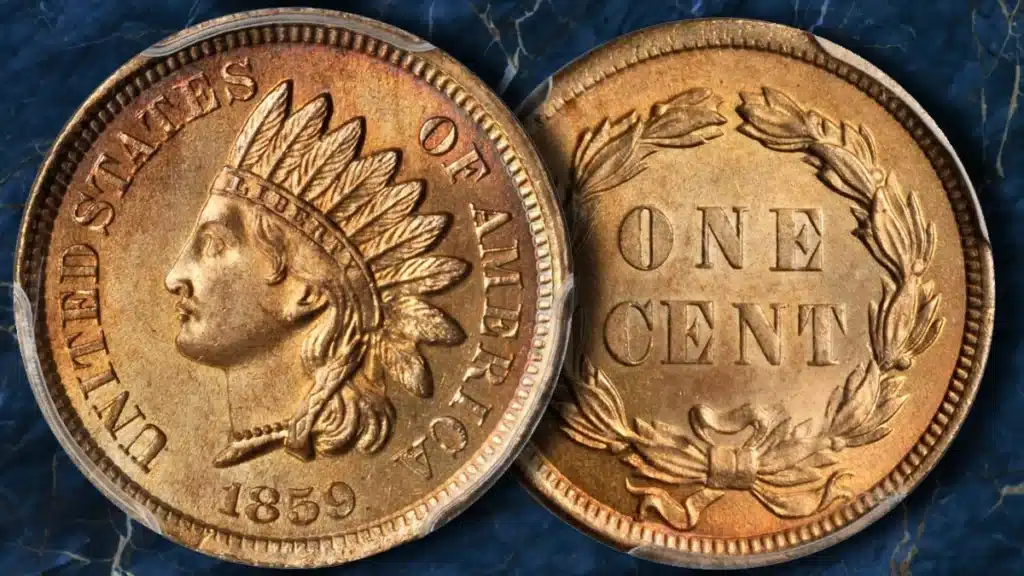
The Indian Head Cent Replaces the Flying Eagle
The story of the 1859 Indian Head cent should probably begin in 1856, when the United States Mint first struck small cents following a decade of concern about the rising cost of copper. At the time, the United States was producing two copper coins: a 10.89 gram “large cent” that measured 27.5 mm in diameter and a 5.44 gram half cent that measured 23 mm. The basis for these sizes and weights was the cost of the metal minus some small fee for the government to produce the coins.
As this relationship was no longer economincally sustainable, the United States Congress opted to eliminate the half cent and shrink the size of the cent down to the 19 mm standard we’re all familiar with today. In 1856, James Barton Longacre, the Mint’s fourth Chief Engraver, adapted an eagle motif from his predecessor, Christian Gobrecht, for the new one-cent coin. That coin design became known as the Flying Eagle cent.
These first small cents were struck of an alloy composed of 88 percent copper and 12 percent nickel, as required by law. This hard metal alloy proved difficult to strike and caused dies to fail prematurely. The Mint found fault with the Flying Eagle design and quickly sought an alternative.
Tests conducted in 1858 found that Longacre’s new design featuring Lady Liberty wearing an Indian headdress would lead to longer die life.
Mint Director James Ross Snowden liked the design, and wrote a letter on November 4, 1858 to Treasury Secretary Howell Cobb, suggesting that a change be made in the design of the Flying Eagle cent. He pointed out that its relief was too high, and that the design did not seem too acceptable to the public. Snowden submitted models for a new design, and Secretary Cobb gave his approval to what later became the Indian Head cent.
The Indian Head cent went into production in January 1859 and would be struck for 50 years, when the Mint marked the centennial of President Abraham Lincoln’s birth with the release of the Lincoln cent in 1909.
Early Changes to the Indian Head Cent
While the Indian Head cent was struck from 1859 to 1909, major changes to the design were made to the cent in 1860 and 1864.
The 1859 Indian Head cent features Longacre’s Liberty wearing an Indian headdress motif on the obverse and a simple laurel wreath on the reverse. This coin, like the “failed” Flying Eagle cent, was struck in a hard copper-nickel alloy.
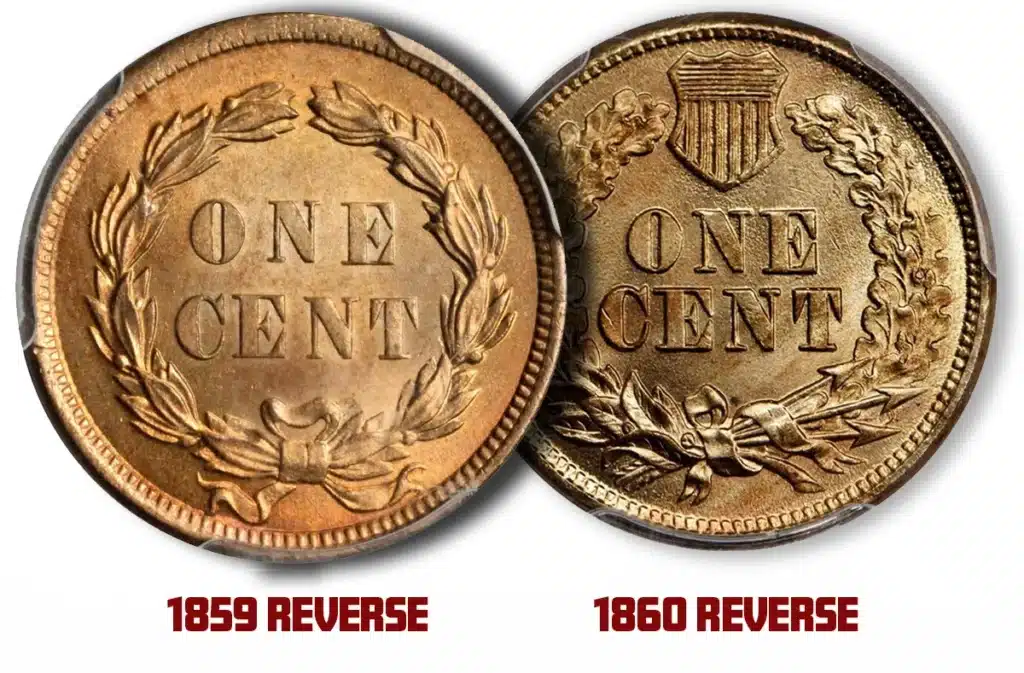
For Indian Head cents struck from 1860 onward, the reverse design featured an oak wreath surmounted by a federal shield. This new wreath left less space for the denomination, which meant that the letters had to be set closer together. In our opinion, the reverse of 1860 was a marked improvement over Longacre’s original design.
The use of copper-nickel continued until partway through 1864, at which time the composition of the cent was changed to bronze. Bronze would serve the nation well for much of the next century, when a tiny amount of tin was removed from the alloy in 1959.
The Indian Head Cent’s Impact on American Coin Design
James Barton Longacre scored the job of Chief Engraver through political influence and at first, he had very little practical experience designing coins. He was, however, a talented man who learned the trade through trial and error. In time, Longacre would go on to have a tremendous influence on America’s coins that spanned beyond his tenure at the Mint.
Many popular coin types of the latter half of the 19th century were Longacre designs, including the two-cent piece, the three-cent silver and three-cent nickel, the Shield nickel, the gold dollar, the three-dollar gold coin, and the Liberty Head double eagle.
But it is Longacre’s Indian Head cent design which we feel was his most impactful. In imbuing American idealism with the unique iconography of its indigenous peoples (albeit in pastiche), he set forward an artistic movement for United States coin and medal design. In time, Native American motifs would appear on the nickel five-cent coin; the quarter eagle, half eagle, and eagle gold coins; a number of classic commemorative coin issues; and even the Sacagawea dollar.
For Longacre, the cent was a continuation of his marriage of Indian-style headgear with Liberty that began on the much less successful gold dollar and three dollar gold designs of 1854.
What Is the 1859 Indian Head Cent Worth?
As with the case for all coins, the value of the 1859 Indian Head cent depends on its current state of preservation and eye appeal. A total of 36,400,000 Indian Head cents dated 1859 were struck for circulation and they were meant to be spent. The majority of the issue entered into circulation, practically choking the streams of commerce.
With the outbreak of the American Civil War in 1861, coins of all types were quickly removed from circulation and hoarded–mainly by institutions and speculators. In 1864, the Mint had replaced the metal composition of the Indian Head cent with a lighter bronze alloy. This change made the copper-nickel cents noticeably heavier and paler than their new tenor counterparts.
When such changes happen in coinage, the old type tends to be removed from circulation in favor of the new. Whether through redemption or the ravages of time, most of the 36 million 1859 Indian Head cents were lost or destroyed.
A sufficient number of coins survive, however, and this inventory provides coin collectors of all budgets the opportunity to own an 1859 Indian Head cent for as little as $15 to $20 for a specimen in Good condition up to a few hundred dollars for a slightly worn example in About Uncirculated.
Above the grade of AU, it is advisable that collectors buy only certified coins that have been graded by CAC, NGC, or PCGS – the three main third-party grading services operating in the United States.
1859 Indian Head Cents in Mint State – Top Population and Value
At the time of publication in late November 2023, NGC, PCGS, and CAC combined have graded over 7,200 1859 Indian Head cents. Due to the costs of certification, the majority of the coins submitted from this date will fall within the upper circulated grades through the Mint State grade of MS64.
NGC reports one coin at its top grade of MS67. PCGS reports 11 grading events at its top grade of MS66+. CAC has not encapsulated any coin above MS65, but has applied its approval sticker to 17 coins at the MS66 level (please note: CAC’s sticker service does not account for the plus grades assigned to a coin by NGC or PCGS).
In Mint State grades, the 1859 Indian Head cent is more affordable today than it has been at any point in the past 10 years. In Choice Mint State MS63, examples have realized prices ranging from $550 to $800 at auction in 2023. Gem Mint State coins at MS65 have sold for between $2,200 and $2,500. At the upper end, a non-CAC-approved example graded MS66+ sold at GreatCollections for $17,718.75. A decade ago, this coin would have likely sold for $25,000 or more.
As with anything related to rare coins, timing is important. When two or more knowledgable bidders vie for the same piece, the price realized will often be far more than the published “value” of the coin. Eye appeal, provenance, and advanced features like die marriage, die state, and die variety can also greatly impact a coin’s value.
1859 Indian Head Cent in Proof
In addition to the 36 million 1859 Indian Head cents struck for circulation, the Philadelphia Mint also produced approximately 800 Proof examples. Proof coins have mirrored surfaces and were struck with two blows from the dies. Coin expert Rick Snow has written that he believes half of this mintage was released into circulation after the coins went unsold. Determining whether a circulated or impaired coin is a Proof or a business strike can be tricky and is best left to the experts.
Proof coins are comparable in price to their business strike counterparts but considerably scarcer. The reasons for this parity is the prevailing belief that business strike coins and Proof strikes make up different collecting specialties and that the two coin styles are not interchangeable when it comes to set building. In the 19th century, attitudes were different, and collectors of the time were satisfied with owning a Proof example of each year’s coinage output. Attitudes shifted once collecting coins by mintmark took root in the early 20th century.
The Indian Head Cent Story Continues…
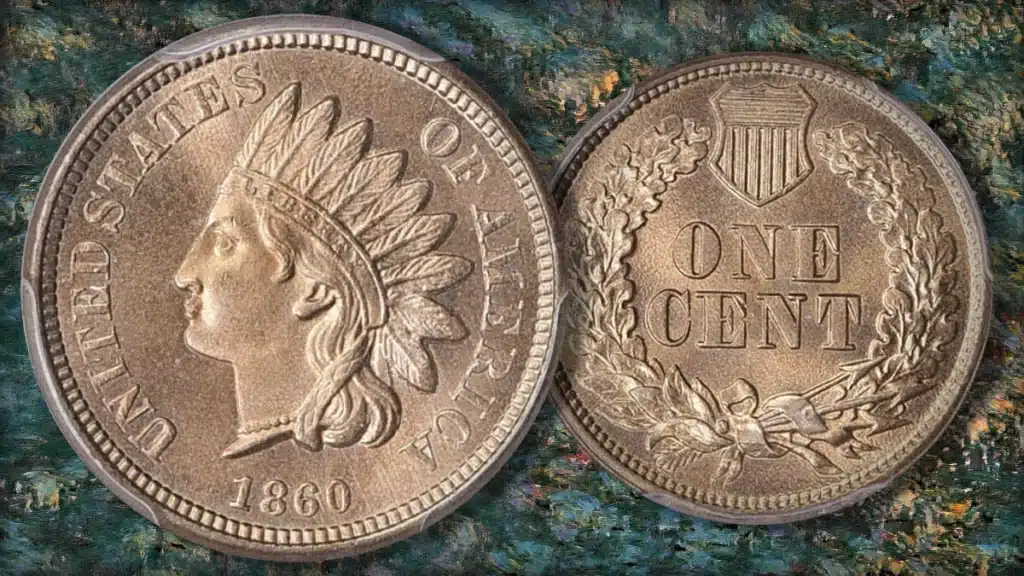
Learn more about the Indian Head cent by reading our collector’s guide on the copper-nickel issues of 1860-64.
Design
Obverse:
The obverse of the coin shows the legend UNITED STATES OF AMERICA and an Indian head facing to the left, wearing a feather bonnet. The word LIBERTY is shown on the band across the bonnet, and shows the production date below.
Reverse:
The coin’s reverse side shows the denomination, written out as ONE CENT, within a laurel wreath. In 1860, the reverse design was changed slightly, showing ONE CENT within an oak wreath, with three arrows inserted under the ribbon that binds the two branches of the wreath. Above and between the ends of the branches is the shield of the United States. As such, the 1859 Indian Head Cent is a one-year type coin which enjoys continuing popularity among Indian Head Cent collectors and type collector alike.
Edge:
The edge of the 1859 Indian Head cent is plain or smooth, without reeding or lettering.
Coin Specifications
| Indian Head Cent : Laurel Wreath Reverse | |
| Years Of Issue: | 1859 |
| Mintage (Circulation): | 36,400,000 |
| Mintage (Proof): | 800 |
| Alloy: | Copper .880, Nickel .120 |
| Weight: | 4.67 grams |
| Diameter: | 19.00 mm |
| Edge: | Plain |
| OBV Designer | James Barton Longacre |
| REV Designer | James Barton Longacre |
* * *
Additional Resources
Bowers, Q. David. The Experts Guide to Collecting & Investing in Rare Coins. Whitman Publishing.
Breen, Walter. Walter Breen’s Encyclopedia of U.S. Coins. Doubleday.
Guth, Ron and Jeff Garrett. United States Coinage: A Study by Type. Whitman Publishing.
Snow, Richard. A Guide Book of Flying Eagle and Indian Head Cents. Whitman Publishing.
—. The Flying Eagle & Indian Cent Attribution Guide, 3rd Edition. Self published.
Yeoman, R.S and Kenneth Bressett (editor). The Official Red Book: A Guide Book of United States Coins. Whitman Publishing.
* * *
The post 1859 Indian Head Cent : A Collector’s Guide appeared first on CoinWeek: Rare Coin, Currency, and Bullion News for Collectors.
1859 Indian Head Cent : A Collector’s Guide

The Indian Head Cent Replaces the Flying Eagle
The story of the 1859 Indian Head cent should probably begin in 1856, when the United States Mint first struck small cents following a decade of concern about the rising cost of copper. At the time, the United States was producing two copper coins: a 10.89 gram “large cent” that measured 27.5 mm in diameter and a 5.44 gram half cent that measured 23 mm. The basis for these sizes and weights was the cost of the metal minus some small fee for the government to produce the coins.
As this relationship was no longer economincally sustainable, the United States Congress opted to eliminate the half cent and shrink the size of the cent down to the 19 mm standard we’re all familiar with today. In 1856, James Barton Longacre, the Mint’s fourth Chief Engraver, adapted an eagle motif from his predecessor, Christian Gobrecht, for the new one-cent coin. That coin design became known as the Flying Eagle cent.
These first small cents were struck of an alloy composed of 88 percent copper and 12 percent nickel, as required by law. This hard metal alloy proved difficult to strike and caused dies to fail prematurely. The Mint found fault with the Flying Eagle design and quickly sought an alternative.
Tests conducted in 1858 found that Longacre’s new design featuring Lady Liberty wearing an Indian headdress would lead to longer die life.
Mint Director James Ross Snowden liked the design, and wrote a letter on November 4, 1858 to Treasury Secretary Howell Cobb, suggesting that a change be made in the design of the Flying Eagle cent. He pointed out that its relief was too high, and that the design did not seem too acceptable to the public. Snowden submitted models for a new design, and Secretary Cobb gave his approval to what later became the Indian Head cent.
The Indian Head cent went into production in January 1859 and would be struck for 50 years, when the Mint marked the centennial of President Abraham Lincoln’s birth with the release of the Lincoln cent in 1909.
Early Changes to the Indian Head Cent
While the Indian Head cent was struck from 1859 to 1909, major changes to the design were made to the cent in 1860 and 1864.
The 1859 Indian Head cent features Longacre’s Liberty wearing an Indian headdress motif on the obverse and a simple laurel wreath on the reverse. This coin, like the “failed” Flying Eagle cent, was struck in a hard copper-nickel alloy.

For Indian Head cents struck from 1860 onward, the reverse design featured an oak wreath surmounted by a federal shield. This new wreath left less space for the denomination, which meant that the letters had to be set closer together. In our opinion, the reverse of 1860 was a marked improvement over Longacre’s original design.
The use of copper-nickel continued until partway through 1864, at which time the composition of the cent was changed to bronze. Bronze would serve the nation well for much of the next century, when a tiny amount of tin was removed from the alloy in 1959.
The Indian Head Cent’s Impact on American Coin Design
James Barton Longacre scored the job of Chief Engraver through political influence and at first, he had very little practical experience designing coins. He was, however, a talented man who learned the trade through trial and error. In time, Longacre would go on to have a tremendous influence on America’s coins that spanned beyond his tenure at the Mint.
Many popular coin types of the latter half of the 19th century were Longacre designs, including the two-cent piece, the three-cent silver and three-cent nickel, the Shield nickel, the gold dollar, the three-dollar gold coin, and the Liberty Head double eagle.
But it is Longacre’s Indian Head cent design which we feel was his most impactful. In imbuing American idealism with the unique iconography of its indigenous peoples (albeit in pastiche), he set forward an artistic movement for United States coin and medal design. In time, Native American motifs would appear on the nickel five-cent coin; the quarter eagle, half eagle, and eagle gold coins; a number of classic commemorative coin issues; and even the Sacagawea dollar.
For Longacre, the cent was a continuation of his marriage of Indian-style headgear with Liberty that began on the much less successful gold dollar and three dollar gold designs of 1854.
What Is the 1859 Indian Head Cent Worth?
As with the case for all coins, the value of the 1859 Indian Head cent depends on its current state of preservation and eye appeal. A total of 36,400,000 Indian Head cents dated 1859 were struck for circulation and they were meant to be spent. The majority of the issue entered into circulation, practically choking the streams of commerce.
With the outbreak of the American Civil War in 1861, coins of all types were quickly removed from circulation and hoarded–mainly by institutions and speculators. At the termination of the “hot” phase of the war in 1865, the Mint had replaced the metal composition of the Indian Head cent with a lighter bronze alloy. This change made the copper-nickel cents noticeably heavier and paler than their new tenor counterparts.
When such changes happen in coinage, the old type tends to be removed from circulation in favor of the new. Whether through redemption or the ravages of time, most of the 36 million 1859 Indian Head cents were lost or destroyed.
A sufficient number of coins survive, however, and this inventory provides coin collectors of all budgets the opportunity to own an 1859 Indian Head cent for as little as $15 to $20 for a specimen in Good condition up to a few hundred dollars for a slightly worn example in About Uncirculated.
Above the grade of AU, it is advisable that collectors buy only certified coins that have been graded by CAC, NGC, or PCGS – the three main third-party grading services operating in the United States.
1859 Indian Head Cents in Mint State – Top Population and Value
At the time of publication in late November 2023, NGC, PCGS, and CAC combined have graded over 7,200 1859 Indian Head cents. Due to the costs of certification, the majority of the coins submitted from this date will fall within the upper circulated grades through the Mint State grade of MS64.
NGC reports one coin at its top grade of MS67. PCGS reports 11 grading events at its top grade of MS66+. CAC has not encapsulated any coin above MS65, but has applied its approval sticker to 17 coins at the MS66 level (please note: CAC’s sticker service does not account for the plus grades assigned to a coin by NGC or PCGS).
In Mint State grades, the 1859 Indian Head cent is more affordable today than it has been at any point in the past 10 years. In Choice Mint State MS63, examples have realized prices ranging from $550 to $800 at auction in 2023. Gem Mint State coins at MS65 have sold for between $2,200 and $2,500. At the upper end, a non-CAC-approved example graded MS66+ sold at GreatCollections for $17,718.75. A decade ago, this coin would have likely sold for $25,000 or more.
As with anything related to rare coins, timing is important. When two or more knowledgable bidders vie for the same piece, the price realized will often be far more than the published “value” of the coin. Eye appeal, provenance, and advanced features like die marriage, die state, and die variety can also greatly impact a coin’s value.
1859 Indian Head Cent in Proof
In addition to the 36 million 1859 Indian Head cents struck for circulation, the Philadelphia Mint also produced approximately 800 Proof examples. Proof coins have mirrored surfaces and were struck with two blows from the dies. Coin expert Rick Snow has written that he believes half of this mintage was released into circulation after the coins went unsold. Determining whether a circulated or impaired coin is a Proof or a business strike can be tricky and is best left to the experts.
Proof coins are comparable in price to their business strike counterparts but considerably scarcer. The reasons for this parity is the prevailing belief that business strike coins and Proof strikes make up different collecting specialties and that the two coin styles are not interchangeable when it comes to set building. In the 19th century, attitudes were different, and collectors of the time were satisfied with owning a Proof example of each year’s coinage output. Attitudes shifted once collecting coins by mintmark took root in the early 20th century.
The Indian Head Cent Story Continues…

Learn more about the Indian Head cent by reading our collector’s guide on the copper-nickel issues of 1860-64.
Design
Obverse:
The obverse of the coin shows the legend UNITED STATES OF AMERICA and an Indian head facing to the left, wearing a feather bonnet. The word LIBERTY is shown on the band across the bonnet, and shows the production date below.
Reverse:
The coin’s reverse side shows the denomination, written out as ONE CENT, within a laurel wreath. In 1860, the reverse design was changed slightly, showing ONE CENT within an oak wreath, with three arrows inserted under the ribbon that binds the two branches of the wreath. Above and between the ends of the branches is the shield of the United States. As such, the 1859 Indian Head Cent is a one-year type coin which enjoys continuing popularity among Indian Head Cent collectors and type collector alike.
Edge:
The edge of the 1859 Indian Head cent is plain or smooth, without reeding or lettering.
Coin Specifications
| Indian Head Cent : Laurel Wreath Reverse | |
| Years Of Issue: | 1859 |
| Mintage (Circulation): | 36,400,000 |
| Mintage (Proof): | 800 |
| Alloy: | Copper .880, Nickel .120 |
| Weight: | 4.67 grams |
| Diameter: | 19.00 mm |
| Edge: | Plain |
| OBV Designer | James Barton Longacre |
| REV Designer | James Barton Longacre |
* * *
Additional Resources
Bowers, Q. David. The Experts Guide to Collecting & Investing in Rare Coins. Whitman Publishing.
Breen, Walter. Walter Breen’s Encyclopedia of U.S. Coins. Doubleday.
Guth, Ron and Jeff Garrett. United States Coinage: A Study by Type. Whitman Publishing.
Snow, Richard. A Guide Book of Flying Eagle and Indian Head Cents. Whitman Publishing.
—. The Flying Eagle & Indian Cent Attribution Guide, 3rd Edition. Self published.
Yeoman, R.S and Kenneth Bressett (editor). The Official Red Book: A Guide Book of United States Coins. Whitman Publishing.
* * *
The post 1859 Indian Head Cent : A Collector’s Guide appeared first on CoinWeek: Rare Coin, Currency, and Bullion News for Collectors.
Stewart Blay Collections of Flying Eagle Cents, Indian Cents, Barber Dimes Realize Almost $5 Million
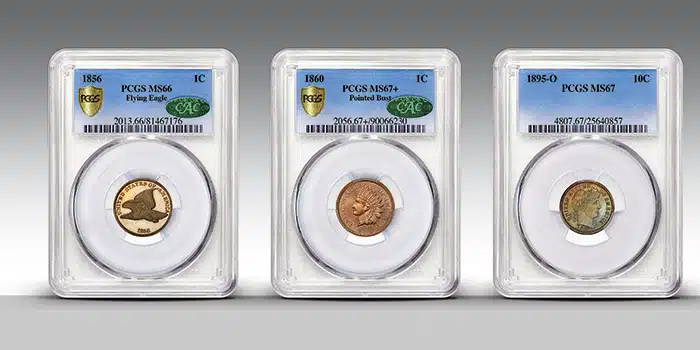
1856 & 1877 Pennies Sold for Over $300,000 Each; Countless Records Set
(Irvine, California) November 28, 2023 – The Stewart Blay Collection continued to set records at GreatCollections earlier this month, with almost $5 million in final bids for the finest sets of Flying Eagle Cents, Indian Cents and Barber Dimes ever assembled.
The coins were sold at GreatCollections on November 12th and 19th. Highlight realizations include the 1856 Flying Eagle Cent PCGS MS-66 CAC at $343,125, the 1877 Indian Cent PCGS MS-66+ RD CAC at $340,875 and the 1893-O Barber Dime PCGS MS-68 PL CAC at $140,625. A duplicate 1955 Doubled Die Lincoln Cent PCGS MS-65 RD CAC realized $123,750. These all realized all-time world records for the date and grade. The 1955 Doubled Die graded PCGS MS-65 RD more than doubled the previous record set in 2001.
A total of 16,645 bids were received for the 673 certified coins on offer that realized a total of $4,960,436.
Stewart Blay, a legendary numismatist and sculptor based in New York, assembled the award-winning collections over the past 50 years. Earlier this year, GreatCollections auctioned the Blay Lincoln Cent Collection for over $7.7 million, also setting many world records.
“Serious collectors came out of the woodwork to bid and own part of the Stewart Blay Collection – several had not acquired a coin in years, as nothing of this quality had been on the market. The realized prices confirm the numismatic community agreed with the superlative quality Stewart had assembled over his lifetime. The pedigree is one that will survive time – perhaps the most universally respected in the current generation of numismatists,” said Ian Russell, president of GreatCollections.
Ian continued, “Sadly, Stewart passed away unexpectedly last Thanksgiving. We are so thankful to Stewart and his estate for entrusting us with this once-in-a-generation collection.”
Prices realized highlights from the Stewart Blay Collection of Flying Eagle Cents
- 1856 Flying Eagle Cent PCGS MS-66 CAC – $343,125
- 1858 Flying Eagle Cent Small Letters PCGS MS-66 CAC – $59,062
Prices realized highlights from the Stewart Blay Collection of Indian Cents
- 1864 Indian Cent L on Ribbon PCGS MS-66+ RD CAC – $81,225
- 1868 Indian Cent PCGS MS-66+ RD CAC – $78,925
- 1877 Indian Cent PCGS MS-66+ RD CAC – $340,875
- 1884 Indian Cent PCGS MS-67 RD CAC – $81,562
Prices realized highlights from the Stewart Blay Collection of Barber Dimes
- 1893-O Barber Dime PCGS MS-68 PL CAC – $140,875
- 1907 Barber Dime PCGS Proof-68 CAC – $87,187
- 1911 Barber Dime PCGS MS-68+ CAC – $81,562A permanent record of the Stewart Blay Collection is available on the GreatCollections website at www.greatcollections.com/blay and GreatCollections has plans to publish a book featuring the Blay collections. For more information, please contact GreatCollections at 1-800-442-6467 or visit www.greatcollections.com.
About GreatCollections
GreatCollections, the official auction house of the American Numismatic Association, specializes in auctioning certified coins and banknotes, handling transactions from start to finish. Since its founding in 2010, GreatCollections has successfully auctioned over 1 million certified coins, making it one of the leading certified coin companies in the United States with annual sales in 2022 exceeding $270 million. Ian Russell, owner/president of GreatCollections, is a member of the prestigious Professional Numismatists Guild, member of the National Auctioneers Association and was recently named the ANA Harry J. Forman Dealer of the Year. For more information about GreatCollections, visit www.greatcollections.com or call 800-442-6467.
The post Stewart Blay Collections of Flying Eagle Cents, Indian Cents, Barber Dimes Realize Almost $5 Million appeared first on CoinWeek: Rare Coin, Currency, and Bullion News for Collectors.
Gold Prices Settle at 3.3-Year High on Tuesday, Nov. 28
Setting palladium aside, prices for precious metals advanced on Tuesday, with gold and silver scoring their third consecutive increase and both also reaching another round of settlement highs – approximately 3
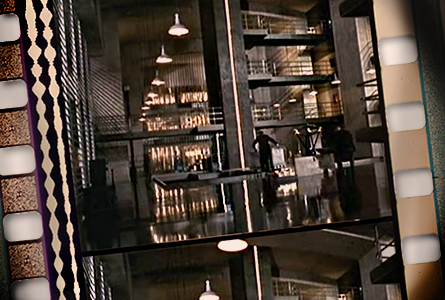
An Unclassified Peek Inside Fort Knox Gold Depository
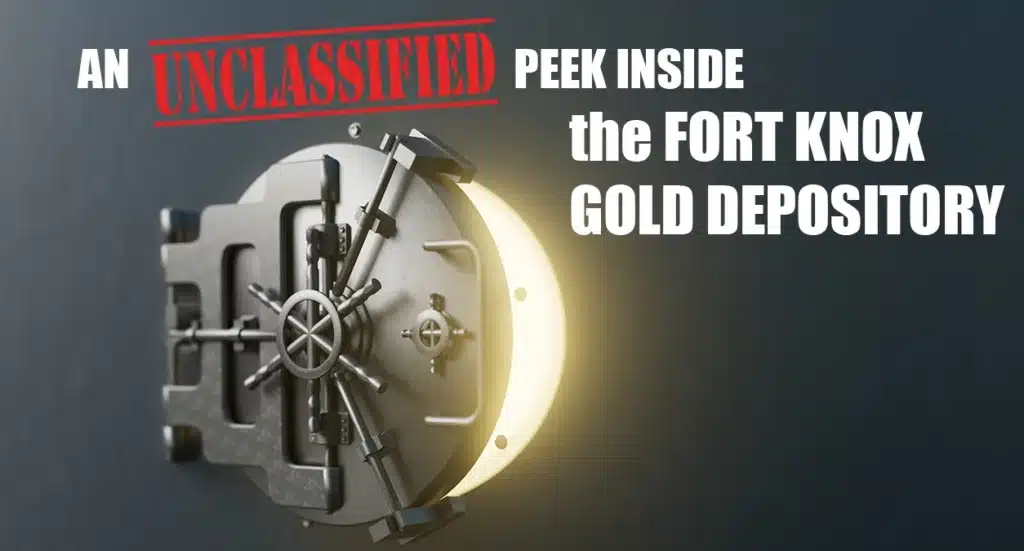
By Philip N. Diehl, exclusively for CoinWeek …..
The public image of the United States Bullion Depository at Fort Knox, Kentucky, was cemented in the 1964 movie Goldfinger. The four-story vaults of shining chrome bar-encased gold, suspended staircases, and vast interior are now classic Hollywood images of what our imaginations want Ft. Knox to look like.
The reality is very different.
I’ve been inside, one of the few people allowed inside over the past 40 years. The Mint’s stated policy is that the “Depository is a classified facility. No visitors are allowed, and no exceptions are made.” Even former Presidents have been turned away.  But in 1974, United States Mint Director Mary Brooks led 130 press Representatives and members of Congress into the Depository to debunk rumors that the vault was empty.
But in 1974, United States Mint Director Mary Brooks led 130 press Representatives and members of Congress into the Depository to debunk rumors that the vault was empty.
I remember hearing these rumors at home in Texas. Ed Busch, of WFAA radio in Dallas, fanned the flames of suspicion to great effect, finally forcing the Treasury Department to open the vault (by the way, I’m confident the gold is there, but the idea that anyone could look at a stack of gold bars and be reassured that, in fact, “the gold is all there” is amusing).
Emphasis on “Fort”
From the outside, the Depository appears to be a concrete, Depression-era structure. Nothing special, unlike the Fort Knox of Hollywood fame.
But, it IS well protected.
There are concentric rings of defenses, starting with the two-story vault itself. The vault is small, less than 4000 square feet, and two stories high. Its walls are two feet thick and constructed of concrete-encased steel plates, steel I-beams, and steel cylinders laced with hoop bands. The vault walls and roof are separated from the Depository’s outer walls and roof, which are made of granite-lined concrete.
The vault door is blast-, drill-, and torch-proof, 21 inches thick, and weighs in at more than 20 tons. It is set on a 100-hour time clock and is rarely opened. There’s no need; metal is not moved in and out of the vault. The gold used in producing the Mint’s gold coins is held at the West Point Mint.
No one person can open the vault door. As with all vaults, there is an escape door for anyone who might become trapped in the vault. But you might rather wait out the 100-hour clock. The approach to the door is through a narrow tunnel one must crawl through. It opens outside the vault but inside the depository. The escape door only opens from the inside. Four armored guard boxes stand at each corner of the building and armored sentry boxes flank the entrance gate. The facility has stand-alone emergency power, water, and other systems on site.
The next ring of protection is the heavily armed and highly profession members of the United States Mint Police Force, who can engage intruders from inside the fortress to beyond the outer steel fence. Between the walls of the Depository and the outer perimeter lie rings of razor wire and mine fields, monitored by high-resolution, night-vision video cameras, and microphones.  The Depository sits on the Fort Knox Army post at the corner of Bullion Boulevard and Gold Vault Road (no kidding).
The Depository sits on the Fort Knox Army post at the corner of Bullion Boulevard and Gold Vault Road (no kidding).
When I was Mint Director, the post offered additional protection in the form of the 194th Armored Brigade, helicopter gunships, artillery, and, as I recall, 25,000 soldiers. I know that Fort Knox has gone through significant downsizing over the past decade, so I’m uncertain how much of this firepower is available today.
During my visit, I asked if anyone had been crazy enough to try to penetrate these awesome defenses. I was told that, on one or two occasions, an inebriated soldier, looking for a shortcut back to base from a local bar and not knowing where he was, had attempted to climb the outer fence. You can imagine the sobering effect the floodlights, alarms, and booming speakers would have had on the unfortunate fellow.
Fort Knox Today
Today, Fort Knox holds about 4,600 metric tons of gold worth close to $200 billion dollars – 2.5% of all the gold ever refined over the course of human history. But dring World War II, the Depository held more than four times its current holdings.
But gold might not have been the most valuable asset held by the Depository. Over the years, Fort Knox has protected copies of the Gutenberg Bible, the Magna Carta, the Declaration of Independence, the United States Constitution, and the Gettysburg Address, among other priceless artifacts. On a grimmer note, during the Cold War, morphine and opium were stored at the Depository in case they were need in huge quantities after a nuclear exchange with the Soviet Union.
* * *
The post An Unclassified Peek Inside Fort Knox Gold Depository appeared first on CoinWeek: Rare Coin, Currency, and Bullion News for Collectors.
2023 Limited Edition Silver Proof Set Release
Eight coins struck from silver are included as part of the United States Mint’s newest release today: the 2023 Limited Edition Silver Proof Set
Phil Arnold Takes the Helm as Director of Photography at GreatCollections
Numismatic photography expert Phil Arnold has joined the GreatCollections Auctions team as Director of Photography
GreatCollections Hires Numismatic Photographer Phil Arnold

CoinWeek Staff Reports…
Numismatic photography expert Phil Arnold has recently joined the GreatCollections team as their new Director of Photography. With over 18 years of experience in numismatic imaging, Phil is poised to bring even higher-quality images to GreatCollections’ auctions.
A Leader in Numismatic Photography
Phil Arnold previously headed the imaging department at Professional Coin Grading Service (PCGS), where he developed their renowned TrueView imaging. During his time at PCGS, Phil photographed countless numismatic rarities, including the world’s most valuable coin – the 1933 Saint-Gaudens Double Eagle.
Arnold’s photography and photographic process made PCGS CoinFacts one of the most innovative and social numismatic websites in the industry. Collectors regarded the PCGS TrueView as a “Glamor Shot”, presenting the object in the best possible light. A strength of Arnold’s approach was PCGS’ ability to bring out toning, even on difficult to photograph Proof coins. In recent years, several major auction firms have used Arnold’s TrueView photography to supplement their own images.
Excitement for the Future
Ian Russell, president of GreatCollections, expressed his enthusiasm for Phil joining the team. He stated, “I welcome Phil to our team – and look forward to providing even higher-quality images for our auctions to the benefit of consignors and bidders. Phil’s work is second-to-none in numismatic photography, and his love of numismatics is showcased with every image he takes.”
A Passion for Numismatic Photography
After graduating from Western University in Ontario, Canada, Phil pursued his passion for numismatic photography by studying at the Pacific Design Academy. Soon after, he was hired by PCGS as their first full-time photographer to take digital images. His move to Southern California allowed him to photograph millions of coins over 18 years and continuously improve the quality of numismatic imaging.
The Next Level for GreatCollections
Phil shared his excitement about joining GreatCollections, stating, “I’ve known Ian for the past decade, and I’ve always admired his and Raeleen’s reputation for integrity within the industry. GreatCollections’ growth in this time has truly been remarkable, and I’m excited to now be a part of their small-company environment. We are going to the next level in making GreatCollections’ photographs the best in the business – not just for their record breaking coin auctions, but also for the new collectibles we’ll be auctioning in the very near future.”
The post GreatCollections Hires Numismatic Photographer Phil Arnold appeared first on CoinWeek: Rare Coin, Currency, and Bullion News for Collectors.
GreatCollections Hires Photographer Phil

CoinWeek Staff Reports…
Numismatic photography expert Phil Arnold has recently joined the GreatCollections team as their new Director of Photography. With over 18 years of experience in numismatic imaging, Phil is poised to bring even higher-quality images to GreatCollections’ auctions.
A Leader in Numismatic Photography
Phil Arnold previously headed the imaging department at Professional Coin Grading Service (PCGS), where he developed their renowned TrueView imaging. During his time at PCGS, Phil photographed countless numismatic rarities, including the world’s most valuable coin – the 1933 Saint-Gaudens Double Eagle.
Arnold’s photography and photographic process made PCGS CoinFacts one of the most innovative and social numismatic websites in the industry. Collectors regarded the PCGS TrueView as a “Glamor Shot”, presenting the object in the best possible light. A strength of Arnold’s approach was PCGS’ ability to bring out toning, even on difficult to photograph Proof coins. In recent years, several major auction firms have used Arnold’s TrueView photography to supplement their own images.
Excitement for the Future
Ian Russell, president of GreatCollections, expressed his enthusiasm for Phil joining the team. He stated, “I welcome Phil to our team – and look forward to providing even higher-quality images for our auctions to the benefit of consignors and bidders. Phil’s work is second-to-none in numismatic photography, and his love of numismatics is showcased with every image he takes.”
A Passion for Numismatic Photography
After graduating from Western University in Ontario, Canada, Phil pursued his passion for numismatic photography by studying at the Pacific Design Academy. Soon after, he was hired by PCGS as their first full-time photographer to take digital images. His move to Southern California allowed him to photograph millions of coins over 18 years and continuously improve the quality of numismatic imaging.
The Next Level for GreatCollections
Phil shared his excitement about joining GreatCollections, stating, “I’ve known Ian for the past decade, and I’ve always admired his and Raeleen’s reputation for integrity within the industry. GreatCollections’ growth in this time has truly been remarkable, and I’m excited to now be a part of their small-company environment. We are going to the next level in making GreatCollections’ photographs the best in the business – not just for their record breaking coin auctions, but also for the new collectibles we’ll be auctioning in the very near future.”
The post GreatCollections Hires Photographer Phil appeared first on CoinWeek: Rare Coin, Currency, and Bullion News for Collectors.
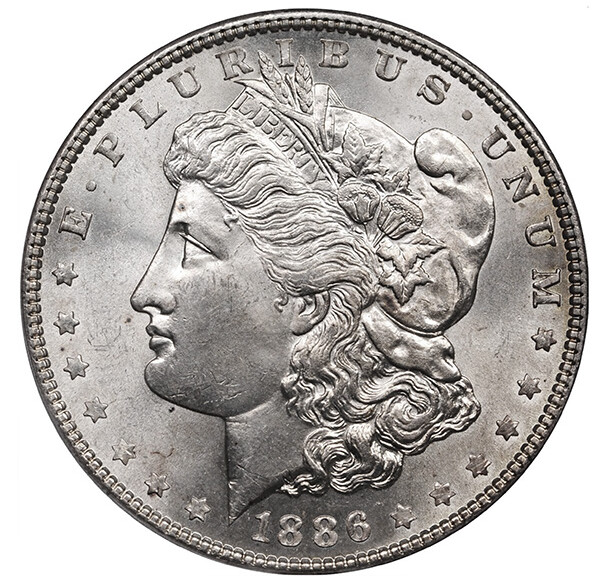
1886 Morgan Dollar : A Collector’s Guide
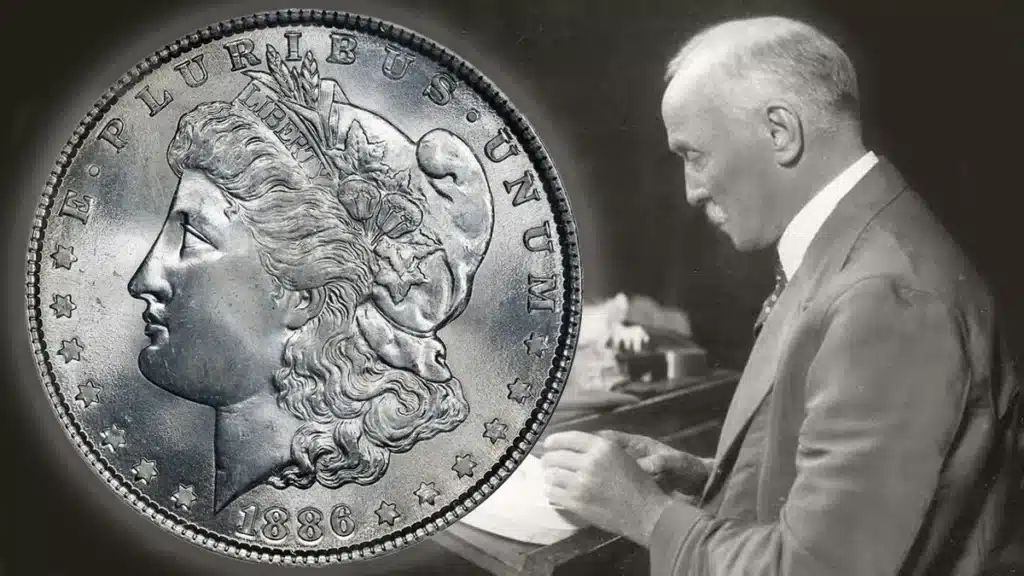
Millions of 1886 Morgan Dollars Were Struck and Stored
The Philadelphia Mint, being the main mint of the United States, was responsible for producing coins for the America’s mid-Atlantic, New England, and for the populated region of the midwest. The Mint’s branches in New Orleans, Carson City, and San Francisco produced coins in silver and gold for the South and West. All four of these mints were put to task striking millions of Morgan dollars in accordance with a federal law passed in 1878. Demand for these large silver coins in most regions of the country was modest at best, and the surplus of unwanted silver dollars sat in bags in Treasury vaults for decades.
By 1886, eight years into these silver dollar scheme, this lack of demand was acutely felt by the Mint and production levels at each branch was largely based on which location had the capacity to store the coins. While mintages at the branch mints fluctuated because of this, Philadelphia was offered no reprieve.
Coming into 1886, the Philadelphia had already produced 102,324,800 Morgan dollars. That year, Philadelphia would strike 19,963,000 more coins and still more the following year. It is because of these large mintages and the fact that so many coins were saved in large quantity in uncirculated condition that the Morgan dollar series saw a tremendous surge in collecting popularity in the 1960s and 1970s as silver coins disappeared from circulation.
What is the 1886 Morgan Dollar Worth?
The 1886 Morgan dollar is a coin that most hobbyists classify as common in all but the higher uncirculated grades. But this is only part of the story. Due to the fact that the coin has an actual silver weight of .77344 ounces of pure silver, every authentic 1886 Morgan dollar, regardless of condition is worth considerably more than the $1 face value stamped on the coin’s reverse. With silver prices approaching $25 an ounce, that puts a baseline value of a circulated 1886 Morgan dollar at about $19 in metal. Even this price is too low for the coin, as collectors will typically pay between $30 and $50 for circulated examples.
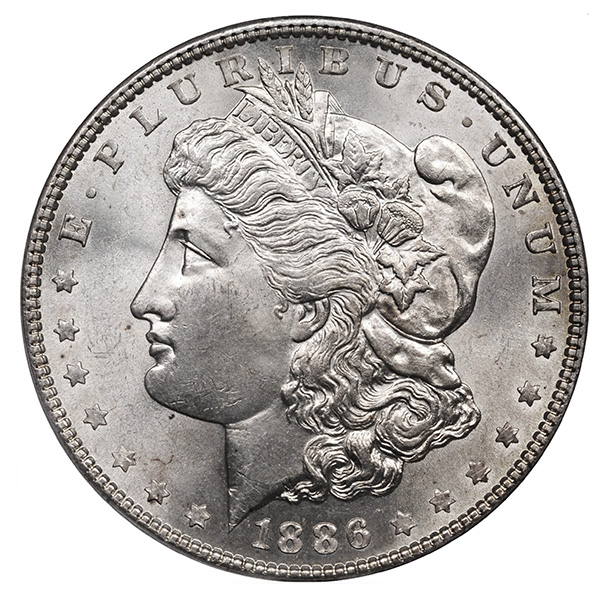
More often than not, collectors prefer uncirculated examples of common date Morgan dollars and the 1886 Morgan dollar is plentiful in brilliant uncirculated condition. The vallue of these coins depends on the assigned grade, the coin’s eye appeal, and to some extent, the service that encapsulated the coin. The three grading services that drive the certified Morgan dollar market are CAC, NGC, and PCGS.
Through November 2023, NGC counts 164,067 1886 Morgan dollars in its condition census, from that total 1,151 are noted as having Prooflike surfaces and 607 as having Deep Mirror Prooflike surfaces. The vast majority of these coins fall in the MS63 to MS64 grade band. In this grade range, the 1886 Morgan dollar sells for about $100 each.
PCGS counts 144,127 1886 Morgan dollars in its condition census. 1,251 of these are Prooflike, while 1,005 are Deep Mirror Prooflike. As was the case with NGC, PCGS considered most of the dollars submitted in the MS63 and MS64 grade range. At this level PCGS and NGC coins sell for about the same price: $100 each.
CAC has applied a CAC-approved sticker to NGC and PCGS-graded coins for the past sixteen years. In 2023, it launched a full service grading company with a location in Virginia Beach. To date, CAC has approved 3,512 1886 Morgan dollars with 62 approved with Prooflike and 69 Deep Mirror Prooflike. In addition, this year, the service has graded 81 1886 Morgan dollars, with a distribution of coins in the MS63 to MS66 range.
In Gem Uncirculated condition (MS65), the 1886 Morgan dollar sells for prices between $180 and $220. At this grade and higher, collectors pay large premiums for coins with exceptional eye appeal and toning. To date, PCGS reports one example at the grade MS68+ and estimates it’s value to be $20,000. Recent sales of MS68 coins have fallen in the $10,000 to $15,000 range. Less for coins graded by NGC. At this price point, the market value of an 1886 Morgan dollar is coin and time dependent.
Design
Obverse:
The obverse of the 1886 Morgan dollar exhibits the characteristic left-facing Liberty Head motif seen on all issues of this classic dollar series. The central Liberty bust wears a Phrygian cap encircled with a ribbon adorned with the inscription LIBERTY. Miss Liberty also wears a crown of wheat and cotton, which were two of the nation’s most lucrative natural agricultural assets in the 19th century.
The phrase E PLURIBUS UNUM is inscribed along the upper half of the obverse rim, and the date 1886 is centered at the bottom of the obverse adjacent to the rim. Seven stars appear between the left side of the date and the inscription E PLURIBUS UNUM, while six stars fill the gap between the date and motto on the lower right side of the coin. In total, the 13 stars symbolize the 13 colonies that combined to form the original Union of the United States. At the base of Liberty’s neck is the “M” monogram representing Morgan’s initial.
Morgan designed the Liberty head bust after the likeness of Anna Willess Williams, a Philadelphia schoolteacher who modeled for the coin. Williams received significant public recognition after her face appeared on the Morgan dollar, but she rejected the attention that was heaped upon her. She refused offers for acting roles and apparently had turned down an offer for marriage following her engagement to an unknown suitor. Before dying at the age of 68 in 1926, Williams, who sat for Morgan on the sworn condition of anonymity, rebuffed her single stint as a coin design model as little more than an “incident of my youth.”
Reverse:
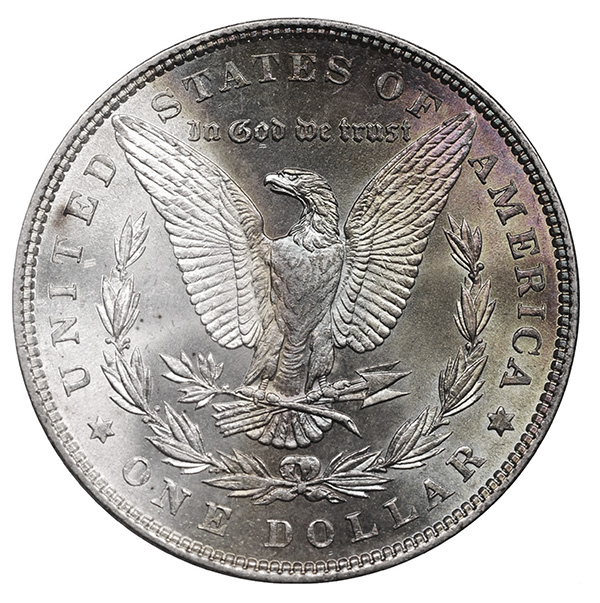 The reverse of the 1886 Morgan dollar is dominated by a heraldic eagle, its wings spread across the upper half of the coin. Between the upper tips of the eagle’s wings appears the motto IN GOD WE TRUST. The eagle clutches an olive branch in its right claw representing peace and in its left claw are three arrows symbolizing the nation’s ability to defend itself. The central eagle design is partly encircled by a laurel wreath.
The reverse of the 1886 Morgan dollar is dominated by a heraldic eagle, its wings spread across the upper half of the coin. Between the upper tips of the eagle’s wings appears the motto IN GOD WE TRUST. The eagle clutches an olive branch in its right claw representing peace and in its left claw are three arrows symbolizing the nation’s ability to defend itself. The central eagle design is partly encircled by a laurel wreath.
Along the rim of the upper two-thirds of the reverse is the legend UNITED STATES OF AMERICA, with the tip of the eagle’s left wings, which virtually touch the coin’s rim, interrupting the space between UNITED and STATES; the right wing visually divides the words OF and AMERICA. The words ONE DOLLAR, seen at the bottom center of the reverse, are flanked by a single, six-sided star on either side of the denomination inscription.
Edge:
The edge of the 1886 Morgan dollar is reeded.
Designer
Engraver George T. Morgan was born in Birmingham, England in 1845. He emigrated to the United States and began work as an assistant to Mint Chief Engraver William Barber and continued to produce patterns and commemoratives under the administration of Barber’s son, Charles. Morgan himself became Chief Engraver in 1917. He died in 1925.
Coin Specifications
| Country: | United States |
| Year Of Issue: | 1886 |
| Denomination: | 1 Dollar |
| Mint Mark: | None (Philadelphia) |
| Mintage: | 19,963,000 (Business Strike); 886 (Proof) |
| Alloy: | 90% Silver, 10% Copper |
| Weight: | 26.73 grams |
| Diameter: | 38.10 mm |
| Edge | Reeded |
| OBV Designer | George T. Morgan |
| REV Designer | George T. Morgan |
| Quality: | Business Strike, Proof |
The post 1886 Morgan Dollar : A Collector’s Guide appeared first on CoinWeek: Rare Coin, Currency, and Bullion News for Collectors.
CCAC to Review Flowing Hair Designs and Other Coins and Medals
The Citizens Coinage Advisory Committee (CCAC) will hold a public meeting on Tuesday, Nov
Gold Marks Near 6.5-Month High, Silver Ends Near 3-Month High
Precious metals diverged at the start of the new trading week on Monday, with gold and silver rising for a second session, while platinum and palladium declined
U.S. Mint Vault Sale For Cyber Monday
The United States Mint’s online shopping center is promoting a “Vault Sale” for Cyber Monday, featuring nearly five dozen products, some of which have not been seen for some time
1798 Small Eagle Draped Bust Dollar – Jack Young’s Fun With Fakes
By Jack D. Young, Early American Coppers (EAC), and the Dark Side Group ……
In a past CoinWeek article, I reviewed a “family” of counterfeits based on a 1799 variety of the Draped Bust silver dollar, Large Eagle reverse, with various dated obverses. I have also previously discussed the “mix and match” approach employed by counterfeiters of using various dies for their fakes. And along those lines, we now have the combination featured in this installment of “Fun with Fakes”!
As in my previous articles, this one will start with a recent “Bay” listing:
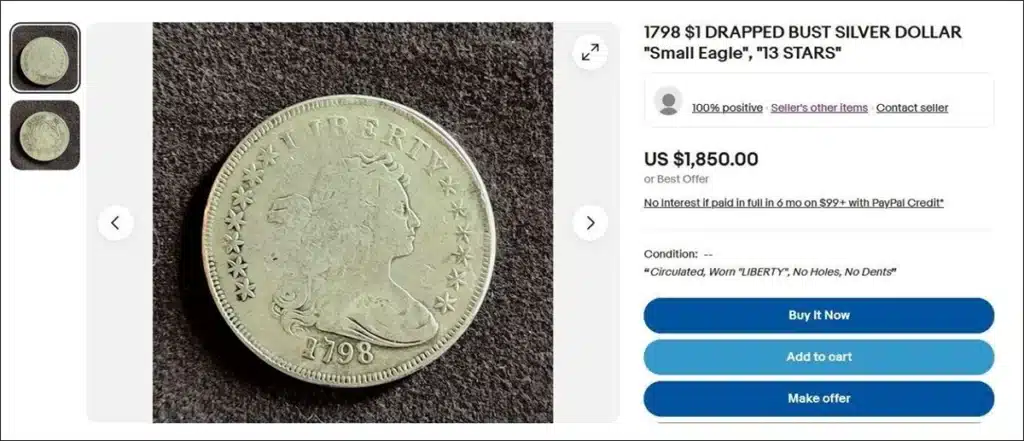
Running through the attribution of this coin resulted in NO matches; there are only two varieties of the 1798 Small Eagle reverse and this one isn’t either.

The obverse looked familiar when I saw it, but it didn’t match with this reverse. And the reverse looked familiar, but not with this obverse!
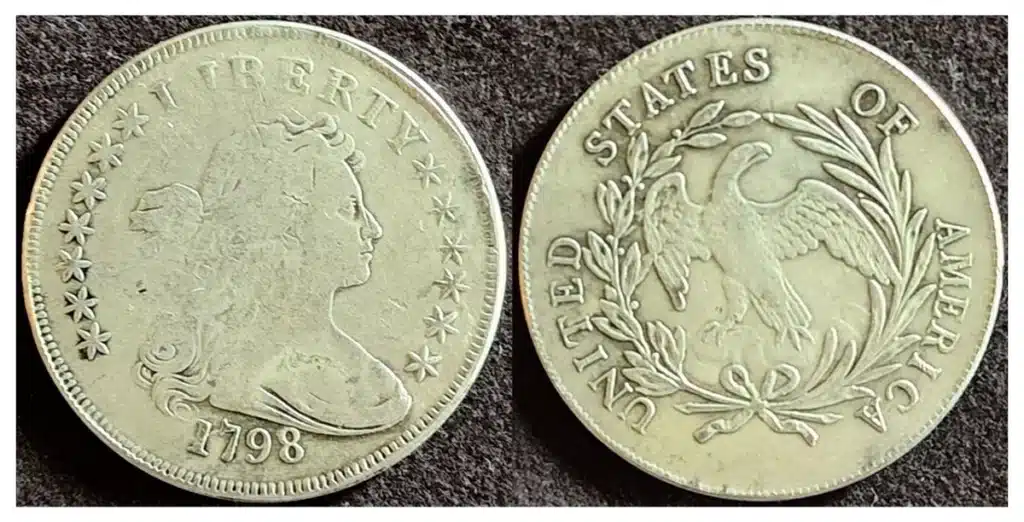
The obverse is the same as used in this “1798” example from the previously mentioned article, mated to the counterfeit 1799 Large Eagle reverse with common marks.
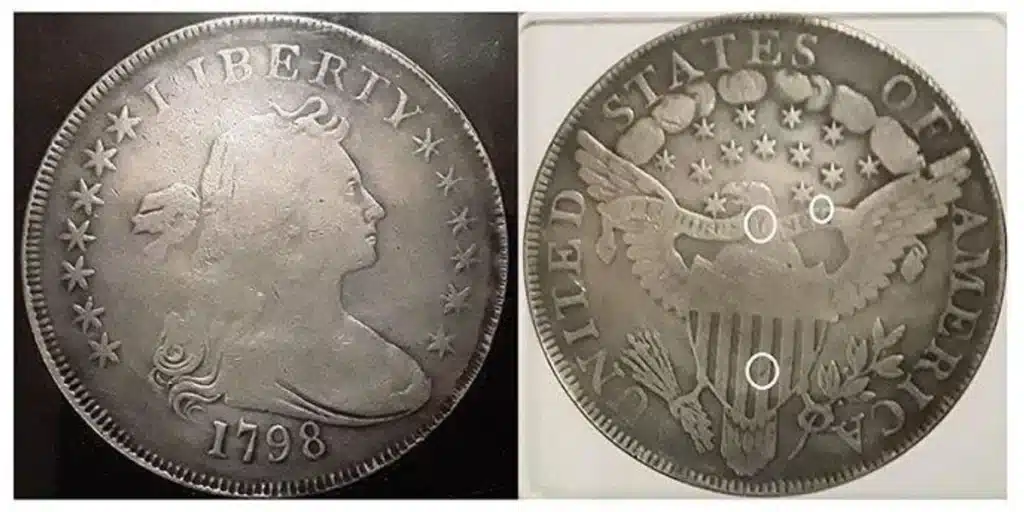
A little digging yielded the source of the Small Eagle reverse, also actually from another of my CoinWeek articles; this reverse is from the 1795 off-center bust dollar.

So, the first “twist” in this story is the swapping of dies from my two CoinWeek articles on counterfeit early dollars to create this new “variety”.
Searching the usual suspects on the internet yielded this same obverse, but the Large Eagle reverse example on eCRATER:

Continued searching resulted in finding this example on DHgate:

Looks like a direct match to the subject example for quite a bit less money than the eBay listing price! Fortunately, that listing was removed before a possible sale.
The next “twist” will be in finding differently dated examples with the same counterfeit combination as this 1798 Small Eagle Draped Bust dollar – I appreciate all the help I can get in finding and documenting them as the next fake “family”.
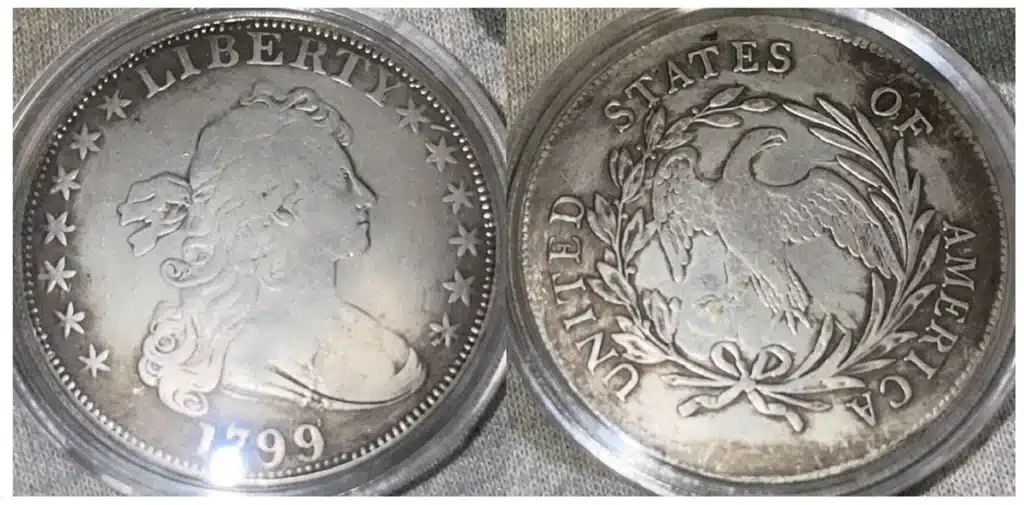
And then I found this “1799”: a different obverse but the same reverse.
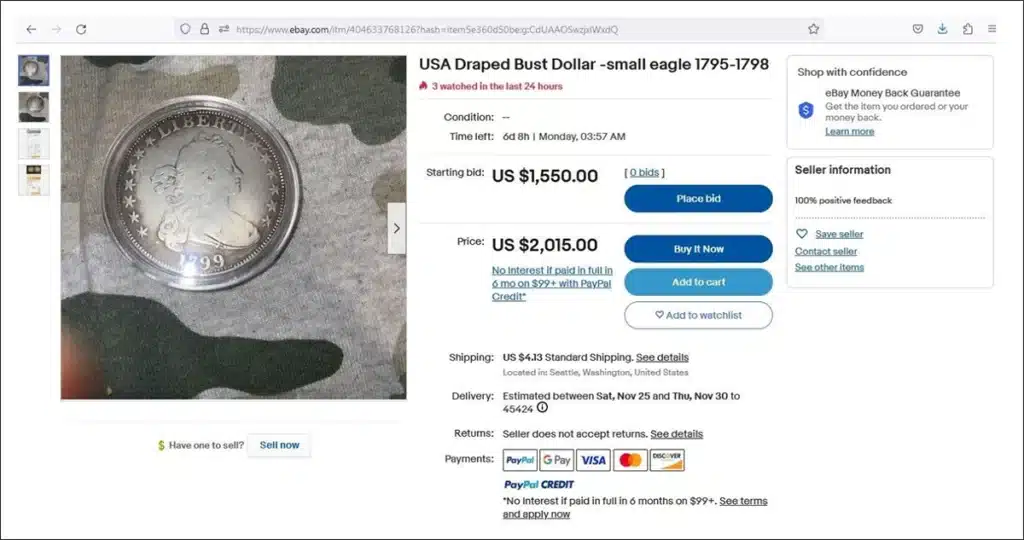
Most collectors with a little experience in early U.S. dollars and a Red Book should know that the Small Eagle design was used only from 1795 through 1798 with the Draped Bust obverse, not 1799. So, this “coin” is in reality another “numismatic anomaly” – my neologism for some of these finds! Wouldn’t you know it, the seller states “1795-1798″…
Best as always,
—Jack
MORE Articles on Counterfeit Coins by Jack D. Young
* * *
The post 1798 Small Eagle Draped Bust Dollar – Jack Young’s Fun With Fakes appeared first on CoinWeek: Rare Coin, Currency, and Bullion News for Collectors.

Only Known Proof Bicentennial Eisenhower Dollar Major Mint Error
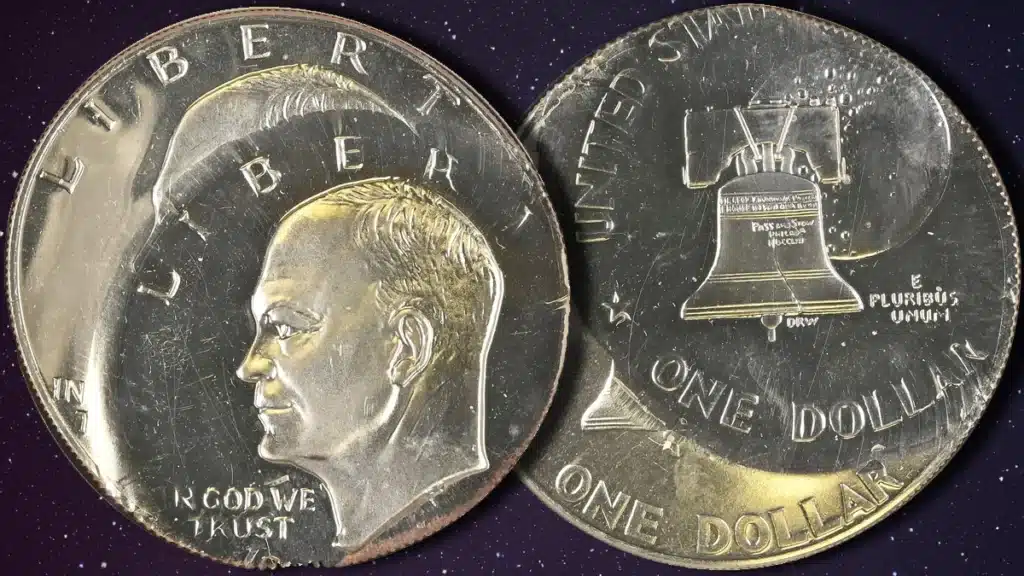
By Mike Byers for Mint Error News ……
This Proof Bicentennial Eisenhower dollar major Mint error is unique in many ways and has no equals. It is the only known Proof Bicentennial Ike Dollar major Mint error of any kind. It is the only known example to be double struck. There are no off-centers known, no off-metals known, no mated pairs known, and no double denominations known.
Even though non-Bicentennial Proof Ike Dollar major Mint errors are rare, there are examples known with several types of major striking errors.
A “Clover Leaf” set of Ike dollars struck on dimes sold in a Heritage auction for $105,000 USD; two mated pairs have sold for $40K and $75K; off-metals have sold for as high as $25K each; off-centers and double strikes at $25K as well; a unique Bronze Ike Dollar sold for $75K; and a unique Ike Dollar on a struck Bronze Medal sold for $40K in another Heritage auction.

This double struck Proof Bicentennial Ike Dollar is pedigreed to John Devine (“Lonesome John”), a famous pioneer in the field of Mint errors and was just certified by Numismatic Guaranty Company (NGC). It was previously unknown to the numismatic community and is just now being offered for sale.
It is in very choice Proof condition and has deep mirrored fields with a Cameo portrait and Liberty Bell. It has high eye appeal since the major devices on the second strike are fully struck. The Ike portrait, Liberty Bell, and moon are fully present – as well as the complete mottoes IN GOD WE TRUST and E PLURIBUS UNUM.
Being the only known Proof Bicentennial Eisenhower Dollar major Mint error of any kind propels it into the rank of unique, amazing, and spectacular numismatic rarities.
It was featured on the cover of Mint Error News Magazine issue 67.


* * *
The post Only Known Proof Bicentennial Eisenhower Dollar Major Mint Error appeared first on CoinWeek: Rare Coin, Currency, and Bullion News for Collectors.
Jewish-American Hall of Fame Issues Solomon Carvalho Medals

The Jewish-American Hall of Fame has announced that its newest medal (the 54th in its series) commemorates the life, legacy, and achievements of artist, photographer, explorer, author, and inventor Solomon Nunes Carvalho, born to a Sephardic family in Charleston, South Carolina in 1815. His ancestors were among those Jews expelled from Spain in 1492.
The Solomon Carvalho medals are trapezoidal, about two inches in diameter, and weigh two ounces. There is a unique serial number on the edge of each medal, and no more than 100 of the bronze medals, 75 of the silver-plated type, and 35 of the gold-plated medals will be produced. To receive these medals, please contribute $35, $100, or $145, respectively, to the Jewish-American Hall of Fame, plus $10 for shipping. Call (818) 225-1348 to order and mention that you read about it on CoinWeek to get a 20% discount. The money these medals raise will go towards the fight against antisemitism.
Solomon Nunes Carvalho was a member of the board of the Philadelphia Hebrew Education Society from 1849 to 1850, and in 1851 he became a member of the historic Congregation Shearith Israel of New York.
In 1853, Colonel John C. Frémont invited Carvalho to accompany him as his official photographer, as Frémont attempted to prove that a central route near the 38th parallel would be the best place for a planned transcontinental railroad. During the trip, despite the freezing weather that made chemical combinations difficult, Carvalho painted and made near daily daguerreotype portraits of expedition members, the Native Americans they met, and the landscape. Tragically, all but one of the nearly 300 daguerreotypes taken by Carvalho during the Frémont expedition were destroyed in a fire.
Solomon Carvalho would almost die on that trip of scurvy, starvation, and frostbite, but Mormons in Utah helped nurse him back to health. Carvalho eventually reached Los Angeles, California, where he helped its small Jewish community organize the Hebrew Benevolent Society.
After the American Civil War, Carvalho moved his family to New York City, but cataracts impaired his portrait work and would ultimately blind him. He became an inventor, and received two patents for steam superheating in 1877 and 1878.
When he was 25 years old, Carvalho painted Child with Rabbits, an image of a chubby little boy surrounded by a mother rabbit and her bunnies; this artwork was reproduced on paper money issued by numerous banks in Canada and the United States.
* * *
The post Jewish-American Hall of Fame Issues Solomon Carvalho Medals appeared first on CoinWeek: Rare Coin, Currency, and Bullion News for Collectors.
CMQ Coins Bring Record Prices in Stack’s Bowers Auction
Stack’s Bowers Galleries, in a November 2023 U.S. Coins Showcase Auction, has officially introduced rare U.S. coins that have been approved as strong for their grade by CMQ, a new grading service founded by David Hall and Greg Roberts. This gave CMQ-certified coins their first test in the market as far as premiums go.

The top auction result was for the “The King of Territorial Gold Coins” in lot 3298, a Proof 1855 Kellogg & Co $50 piece. Its pedigree is traceable to its striking and features sych American coin colelcting luminaries as Augustus Humbert and John Story Jenks before becoming a standout of both the Clapp and Eliasberg collections. The $780,000 USD it sold for beats that paid for the PCGS PR64 CAM example that was part of the Riverboat Collection sale.
Additional incredible prices realized include the following records:
Lot 3016: The finest certified 1869 Three Cent Silver (PCGS PR67+ CAM) with a CMQ-X sold for $48,000. This is more than two-and-a-half times the previous auction record.
Lot 3115: An 1854 Type II gold dollar (PCGS MS67 CMQ) from the Barbaro Acres Collection went for $96,000, a record for an example at that grade.
Lot 3131: A 1840-D Liberty Head $2.50 gold quarter eagle, Winter 1-A (PCGS EF45 CMQ) garnered $15,600, a record for the coin at that grade.
Lot 3221: A near-perfect 1908-S Indian eagle (NGC MS69 CMQ) went for $240,000, which beats the old record for the date established our July 2013 sale when it sold for $182,250.

Lot 3254: A Rarity-8 Proof 1907-D Liberty Head $20 gold double eagle (PCGS PR62 CMQ) went for $432,000. For context, an NGC PF65 example sold for $180,154 in June 2020.
Lot 3286: An 1877 Pattern eagle (Judd-1545, Pollock-1718. Rarity-7-. Copper. Reeded Edge), graded PCGS PR66 RB in an Old Green Holder and approved by CMQ, earned a record price of $50,400.
Lot 3301: The Eliasberg 1860 Clark, Gruber & Co. $20 (PCGS AU55 OGH CMQ-X) example of the Pikes Peak $20 private gold hammered for $552,000, a new record for this type certified by PCGS.
For a list of all prices realized at the November 2023 Rarities Night Session, please visit StacksBowers.com. Stack’s Bowers is currently taking consignments for the Spring 2024 Official Auction of the Whitman Coin and Collectibles Expo. For more information, please contact a consignment specialist at 1-800-458-4646 or at Consign@StacksBowers.com.
For more information about submitting your coins for CMQ approval, please visit cmq.stacksbowers.com.
* * *
The post CMQ Coins Bring Record Prices in Stack’s Bowers Auction appeared first on CoinWeek: Rare Coin, Currency, and Bullion News for Collectors.
Gold Hits 4-Week High, Silver Soars in Post-Holiday Trading
Prices of precious metals advanced during post-holiday trading on Friday, solidifying their second consecutive week of weekly gains
2023 Limited Edition Silver Proof Set Available November 28

The 2023 Limited Edition Silver Proof Set will be available for direct purchase from the United States Mint at noon Eastern Standard Time on onTuesday, November 28. There is a production limit of 50,000 sets, with an initial household order limit of one during the first 24 hours of availability.
The set, struck at the San Francisco Mint, features eight Proof coins in .999 fine silver:
- One American Silver Eagle 1oz Proof Coin
- Five American Women Quarters honoring Bessie Coleman, Edith Kanaka`ole, Eleanor Roosevelt, Jovita Idar, and Maria Tallchief
- One Kennedy half dollar
- One Roosevelt dime
Each set comes with a certificate of authenticity.
The initial retail price of the 2023 Limited Edition Silver Proof Set is $220 USD. To set up a “Remind Me” alert, please visit catalog.usmint.gov/limited-edition-2023-silver-proof-set-23RC.html (product code 23RC).
The 2023 Limited Edition Silver Proof Set is also part of the Authorized Bulk Purchase Program (ABPP) and is available to Authorized Bulk (AB) members. Products included in this bulk program are eligible for early release, carry an “AB” suffix to the product code, and carry a premium. Early release products are not eligible for discounts.
Next year in 2024, Limited Edition Silver Proof Sets will be part of the Mint’s Product Subscription Program. Much like a magazine subscription, this allows collectors to receive automatic shipments of products in a series. Shipments continue every year until the subscription is cancelled. For more information, click here.
* * *
The post 2023 Limited Edition Silver Proof Set Available November 28 appeared first on CoinWeek: Rare Coin, Currency, and Bullion News for Collectors.
U.S. Mint Striking Ceremony for 2024 Harriet Tubman Coins on Nov. 28
Director Ventris C
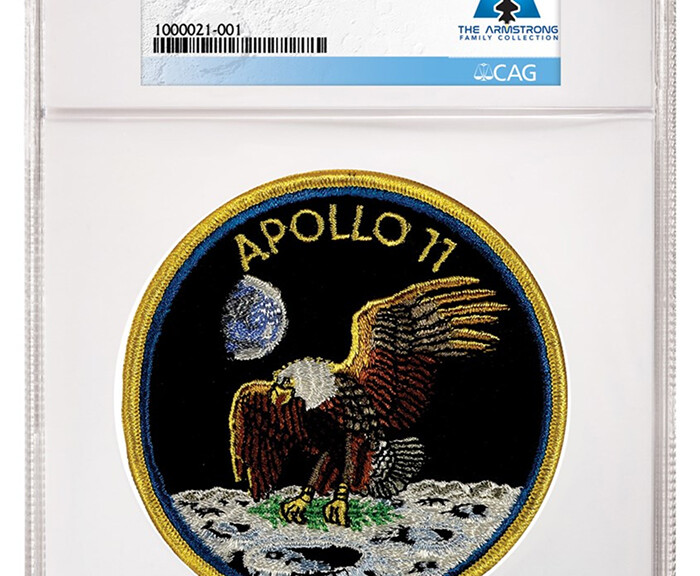
Eisenhower Dollar, 1971-1978 : A Collector’s Guide
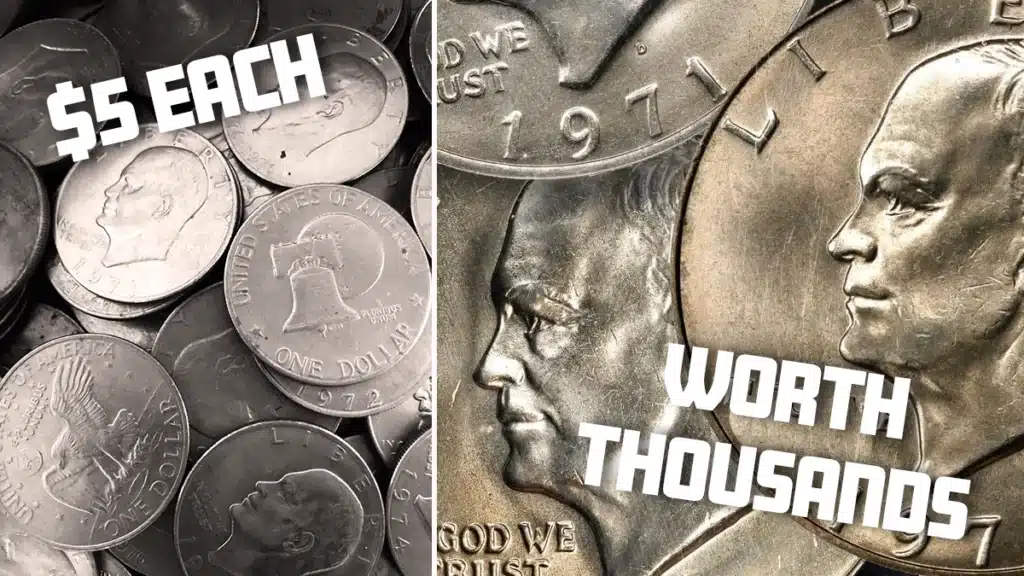
The American Silver Dollar Never Had Much Currency as a Circulating Coin
The American silver dollar was first authorized by the Mint Act of April 2, 1792, where the denomination was intended to be the standard unit of the American monetary system.
Similar in size and composition to Spanish and Mexican dollars, the denomination should have been the ideal unit of commerce. However, the reality was somewhat different, and though used in foreign trade, silver dollars generally did not actively circulate in the United States.
The reasons were basic: the coins were too large, too heavy, and, in time, paper money proved to be the public’s preferred means of exchange. In the late 1870s, Congress sought to reintroduce the silver dollar by ordering the United States Mint to strike millions of coins each year. Within three years, Treasury Department vaults were filled with unwanted coins.
During World War I, America came to the aid of Great Britain by converting more than 270 million silver dollars into bullion, which it sold for $1 per fine ounce. To replenish the Treasury’s silver dollar stockpile, that same quantity of silver was purchased from American mines and struck into new dollars starting in 1921. The Peace dollar was the last silver dollars minted, and regular production of the dollar coin ended after 1935.
From the nation’s immense silver dollar stockpile, $1,000 bags of the coin were paid out to banks, which then paid the dollars out to customers or held onto them as monetary reserves.
When a sealed bank vault was opened in 1962 at the Philadelphia Mint, hundreds of thousands of Morgan and Peace dollars were found, including some scarce issues. Word of this discovery circulated widely, and both banks and the Treasury Department freely paid out the coins until they were mostly gone in early 1964.
The government considered minting new coins to replenish its stockpile, but this idea was met with stiff resistance. The Coinage Act of July 23, 1965, specified that no new silver dollars could be coined for five years, at which time the need for the denomination would be reevaluated.
The Eisenhower Dollar Marked the Return of the Silver Dollar
The Coinage Act of 1965 was enacted to remove silver from United States coinage. It authorized the Mint to strike dimes and quarters in a new copper-nickel clad composition and reduced the silver content of half dollar coins to 40%. As the production of new dimes, quarters, and half dollars was underway, the Treasury implemented a plan to remove massive quantities of silver coins from its holdings. By the end of the 1960s, most of America’s pre-1964 silver coins had been withdrawn from circulation.
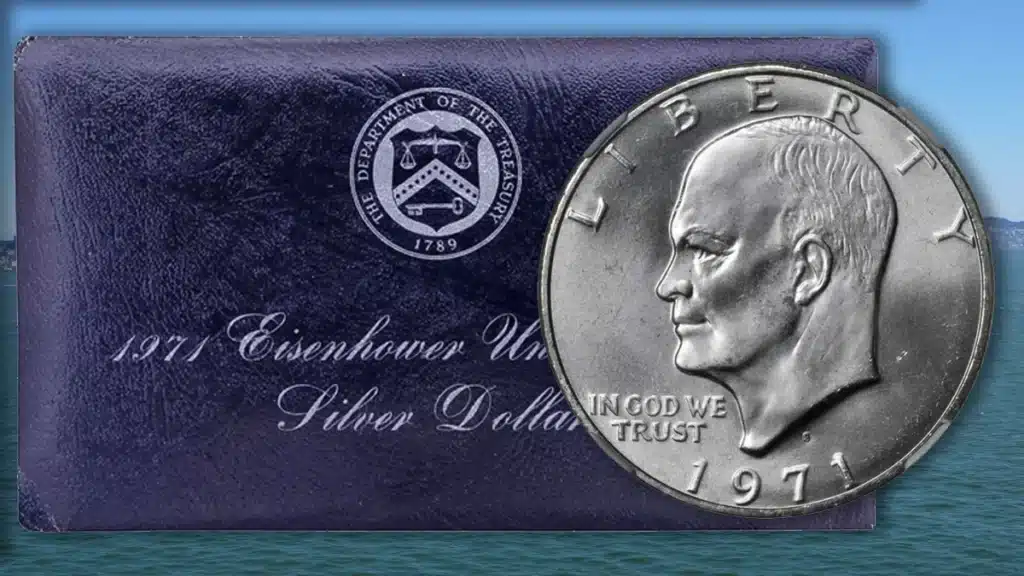
In Nevada’s casinos, the removal of silver coins caused an acute problem. Gamblers used silver dollars to play slot machines and preferred getting their payouts in the same medium.
Two events in 1969–the death in March of former President Dwight D. Eisenhower and the historic Apollo 11 moon landing in July–prompted a House bill that proposed a dollar coin commemorating both events. And following more than a year of debate, the new dollars were approved in December 1970.
Circulating Eisenhower, or “Ike”, dollars were to be minted in the same copper-nickel composition of the circulating dime, quarter, and half dollar. Silver-copper clad dollars for collectors, the same composition as that used for the 40% silver Kennedy half dollar produced from 1965 through 1970, were also approved.
The Story Behind the Eisenhower Dollar’s Design
The obverse of the Eisenhower dollar features a portrait of President Dwight D. Eisenhower, while the reverse presents a slightly modified version of the scene depicted on the Apollo 11 crew patch designed by astronaut and mission pilot Michael Collins, which shows an eagle landing on the moon.
A left-facing portrait of Eisenhower is centered on the obverse; U.S. Mint Chief Engraver Frank Gasparro’s initials FG are on the truncation of the neck. The word LIBERTY arcs above the head, concentric with the flat rim, and the date is similarly placed at the bottom. The national motto IN GOD WE TRUST, in two lines, is at the bottom left. Ike dollars were minted at Philadelphia, Denver, and San Francisco; D and S mintmarks are below the neck, above the date.
Bicentennial dollar coins have the dual date 1776-1976 at the bottom, the dates separated by a centered dot.
 The reverse depicts an eagle with outstretched wings landing on the cratered moon, shown in part on the bottom third of the coin. The eagle clutches an olive branch in its claws. The legend UNITED STATES OF AMERICA curves inside the rim at the top, over the blackness of space, while the denomination ONE DOLLAR is at the bottom along the rim, superimposed over the moon. Circling around the eagle against the space backdrop are 13 small five-point stars. Above the eagle, below the stars, is the motto E PLURIBUS UNUM in two lines with centered spacing dots; a small representation of earth is in space above and to the left of the eagle, below the stars. The designer’s initials FG are between the eagle’s tail and the tip of the olive branch.
The reverse depicts an eagle with outstretched wings landing on the cratered moon, shown in part on the bottom third of the coin. The eagle clutches an olive branch in its claws. The legend UNITED STATES OF AMERICA curves inside the rim at the top, over the blackness of space, while the denomination ONE DOLLAR is at the bottom along the rim, superimposed over the moon. Circling around the eagle against the space backdrop are 13 small five-point stars. Above the eagle, below the stars, is the motto E PLURIBUS UNUM in two lines with centered spacing dots; a small representation of earth is in space above and to the left of the eagle, below the stars. The designer’s initials FG are between the eagle’s tail and the tip of the olive branch.
The Bicentennial version replaces the center image on the reverse with the Liberty Bell in front of the whole disc of the cratered moon. E PLURIBUS UNUM, each word on a separate line, is located at the lower right of the bell/moon composite. UNITED STATES OF AMERICA and ONE DOLLAR along the rim are separated by centered five-point stars. The initials DRW, for Bicentennial reverse designer Dennis R. Williams, are below the bottom edge of the bell to the right of the clapper.
Though seemingly benign, the original depiction of the eagle on the coin was apparently interpreted by the U.S. State Department as bearing a somewhat hostile expression; this was, of course, not the first time in U.S. coinage history that a design had received unexpected criticism. To correct this issue–as well as a number of small technical matters–Chief Engraver Gasparro made several minor changes to the design in 1971 and 1972. The first Eisenhower dollar coins were not issued until November 1, 1971.
A Carve-Out for a Failing College Caused Controversy
More controversial was an amendment to the authorizing legislation that directed a portion of the profits (a surcharge) from the collector coins to the private Eisenhower College in Seneca Falls, New York. In spite of receiving approximately $9 million USD from this provision, the College closed its doors in 1983, after being in operation since only 1968.
This would not be the last time that special interests would lobby Congress to provide for the funding of pet projects through the United States Mint’s numismatic coin program. The entirety of the Mint’s Modern Commemorative coin series, starting in 1982 and continuing to this day, is centered on generating revenue for various causes through the sale of non-circulating collector coins.
The Eisenhower Dollar Can Be Collected Multiple Ways
A complete uncirculated Eisenhower dollar collection can be built inexpensively with the purchase of annual mint sets, loose Mint State singles, Proof coins, and Uncirculated Finish coins and Proof issues in silver-clad.
Or, one can spend years trying to buy coins that are the best of the best coins and all of the rare varieties. With this approach, one would have to devote hundreds of thousands towards the pursuit… if the right coins even become available.
The beauty of the series is that you don’t need to settle for either or. Building a top 10 Registry Set is still somewhat affordable and there are a number of high quality coins left to find in the wild.
For those simply interested in the silver-clad coins, the blue pack and brown pack issues of 1971 to 1974 are a good entry point. For the Bicentennial issue, collectors can cheaply acquire this coin along with the Bicentennial quarter and half dollar in the Mint’s three coin silver uncirculated and Proof set.
Thousands of business strike Eisenhower dollar coins have been certified, most at grades finer than MS63, and consisting of four main types: regular copper-nickel clad, Bicentennial copper-nickel clad, regular silver-copper clad, and Bicentennial silver-copper clad.
Additional varieties have been identified within these main types. Prices are modest for most issues up to Gem, and for some dates to MS66. More expensive coins at higher grades are 1971-1974 Type 1; 1972 Type 2; and 1976 Type 1.
In addition, most MS67 and finer copper-nickel clad, and MS69 silver-copper clad, dollars are very expensive.
Thousands of Proof Eisenhower dollars have been certified, most as PR69, and most as Cameo (CAM) or Deep Cameo (UCAM or DCAM). Prices are modest for all issues through PR69, but jump to very expensive as PR70.

Eisenhower Dollar Varieties Are Still Being Discovered
Although the Eisenhower dollar was a short-lived series, it provided the collectors with a number of varieties, some common and some quite rare. Among the most collectible of the varieties are 1972 copper-nickel clad Type 1, 2, and 3 (low relief and high relief and other die changes); 1776-1976 (Bicentennial) copper-nickel clad, Type 1 and 2; 1971-D Type 1 and 2; 1974-D, 1976-D, and 1977-D silver-copper clad (produced in error, these coins should have been copper-nickel clad).
Rarer are the prototype versions of the 1971-S Uncirculated coin (likely to be designated as Judd patterns at some future point), the 1971-S Nixon Presentation dollar, and the 1976 No S Bicentennial Proof, of which there is only one known.

In 2013, Eisenhower dollar collector Andy Oskam purchased an unusual Proof 1971-S Eisenhower dollar from an eBay seller and discovered that the coin was an unpublished variety that married a Proof obverse die with a low relief reverse die. CoinWeek editor Charles Morgan worked with PCGS to recognize the coin as the “Nixon Presentation Dollar”. Additional examples of this rare variety have since surfaced. The example imaged above sold for a record $30,550 at a February 2023 Legend Rare Coin Auctions sale.
In-Depth Eisenhower Dollar Date Analysis by CoinWeek IQ
- 1971 – An important first-year issue known for its strike quality problems
- 1971-D – The first Eisenhower dollar struck, made popular by an interesting variety
- 1971-S – The silver-clad “Blue Pack” circulation strike was sold to collectors at a premium; quality was lacking
- 1972 – Three reverse designs, led by the scarce “1972 Type 2”
- 1972-S – The United States Mint corrects the quality issues of the year before
- 1973 – Produced for Mint Sets–did some trickle out in bags?
- 1974-D – A large-mintage clad issue with some nice coins.
- 1977 – Apollo 11 reverse returns
- 1978 – The last Philadelphia Strikes
- 1978-D – The final Eisenhower dollar produced at the Denver Mint
Additional Eisenhower Dollar Market Information for the Advanced Collector
Coin dealer James Sego joins Charles Morgan to discuss the high-end Eisenhower dollar market.

Coin Specifications
| Eisenhower Dollar | |
| Years Of Issue: | 1971-1978 |
| Mintage (Circulation): | High – 113,318,000 (1976, Type 2); Low – 1,883,140 (1973-S Silver-Clad) |
| Mintage (Proof): | High – 4,265,234 (1971-S); Low – 1,013,646 (1973-S Silver-Copper Clad) |
| Alloy: | Copper-nickel: outer layers 75% copper, 25% nickel; inner core is pure copper. Silver-copper: outer layers 80% silver, 20% copper; inner core 20.9% silver, 79.1% copper |
| Weight: | Copper-nickel clad, 22.68 grams; silver-copper clad, 24.59 grams |
| Diameter: | ±38.10 mm |
| Edge: | Reeded |
| OBV Designer | Frank Gasparro |
| REV Designer | Frank Gasparro | Michael Collins; Frank Gasparro | Dennis R. Williams (Bicentennial) |
* * *
Additional Resources
Bowers, Q. David. The Experts Guide to Collecting & Investing in Rare Coins. Whitman Publishing.
–. A Guide Book of United States Type Coins. Whitman Publishing.
–. A Guide Book of Modern United States Dollar Coins. Whitman Publishing.
Breen, Walter. Walter Breen’s Encyclopedia of U.S. Coins. Doubleday.
Ezerman, Rob. Collectible Ike Varieties: Facts, Photos, and Theories. Ike Group.
Guth, Ron and Jeff Garrett. United States Coinage: A Study by Type. Whitman Publishing.
Yeoman, R.S and Kenneth Bressett (editor). The Official Red Book: A Guide Book of United States Coins. Whitman Publishing.
* * *
The post Eisenhower Dollar, 1971-1978 : A Collector’s Guide appeared first on CoinWeek: Rare Coin, Currency, and Bullion News for Collectors.
1794 Flowing Hair Dollar Leads Heritage $10.5 Million Coin Auction

One of just 140 to 150 known examples of a 1794 Flowing Hair Dollar B-1, BB-1, R.4, XF45 PCGS. CAC drew 58 bids before reaching its final result of $528,000 USD to lead Heritage’s November 16-19 U.S. Coins Signature Auction to over $10 million.
This is a new record for a 1794 dollar in XF condition; the previous highest price was $368,000. This specific coin last sold for $264,500 in the Heritage 2006 Long Beach Auction.

Another highlight was a 1796 No Stars Quarter Eagle, BD-2, MS62 that atrtacted more than 50 bids before going for $492,000. One of an estimated surviving population of about 100 to 125, this coin had been off the market for 16 years, and is one of just four graded in 62 (one in 62+), with only two higher.
An 1808 Capped Bust Left Quarter Eagle, MS63 tied for the second-finest graded example of the rarest United States coin type drew a winning bid of $360,000. John Dannreuther and PCGS estimate the surviving population at 125 to 150 specimens in all grades, and PCGS and NGC combined have certified only 113 specimens, which naturally includes a number of resubmissions and crossovers.
A first-year-of-issue 1795 13 Leaves Eagle, BD-2, High R.4, MS61 PCGS. CAC went for $204,000.
One of just 425 examples struck of an 1879 Flowing Hair Stella, Judd-1635, Pollock-1833, JD-1, R.3, PR63 PCGS sold for $144,000. Although it was once believed that as many as 700 examples of the 1879 Flowing Hair stella may have been struck, research by Roger Burdette published in the Journal of Numismatic Research suggests that production was limited to 425. The first 25 coins were struck in December 1879 and/or January 1880. Another 100 examples were struck in March 1880, followed by 300 more in May. The coins were sold to members of Congress as parts of sets, with the goloid metric dollars (Judd-1617 and Judd-1629) for $10. They were later offered to collectors for $15.
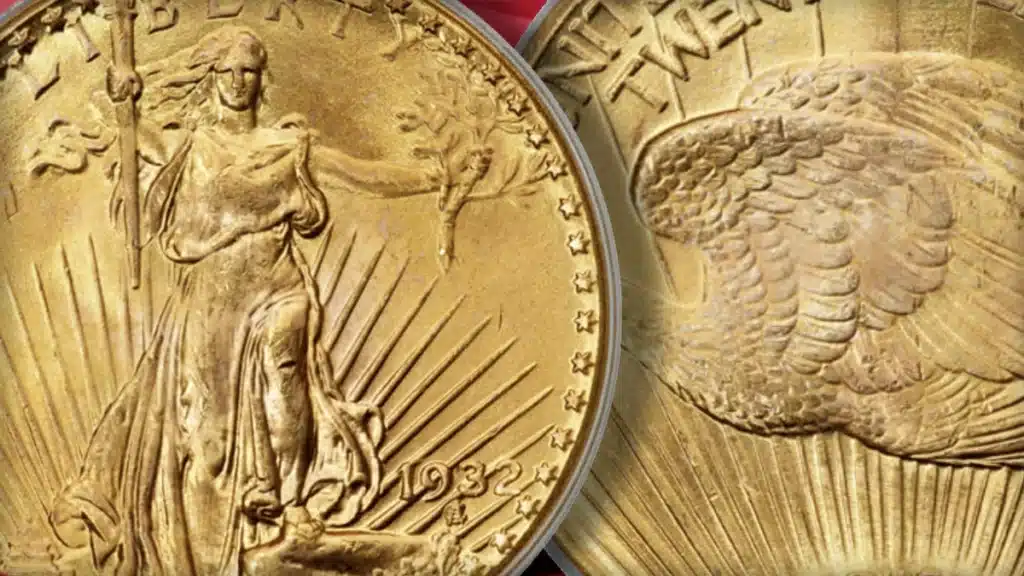
A 1932 Double Eagle MS65 PCGS — the second-rarest late-date (from 1929 through 1932) Saint-Gaudens $20 double eagle gold coin — saw 53 bids before selling for $168,000. A majority of the mintage was held in U.S. Mint and Treasury Department vaults to serve as currency reserves until FDR’s gold recall took effect the following year. In 1933, the coins in government custody were melted into gold bars and shipped to Fort Knox. None were released to Federal Reserve Banks for circulation and only 175 examples were ever available to the general public, either through sale to collectors by the Treasury or in exchange in normal transactions with the Philadelphia Mint Cashier. Numismatist Roger W. Burdette estimates the surviving population at about 95 examples in all grades today.
To browse the rest of the auction results, in addition to the 1794 Flowing Hair dollar, click here.
* * *
The post 1794 Flowing Hair Dollar Leads Heritage $10.5 Million Coin Auction appeared first on CoinWeek: Rare Coin, Currency, and Bullion News for Collectors.
ANA Summer Seminar Scholarships Available for 2024
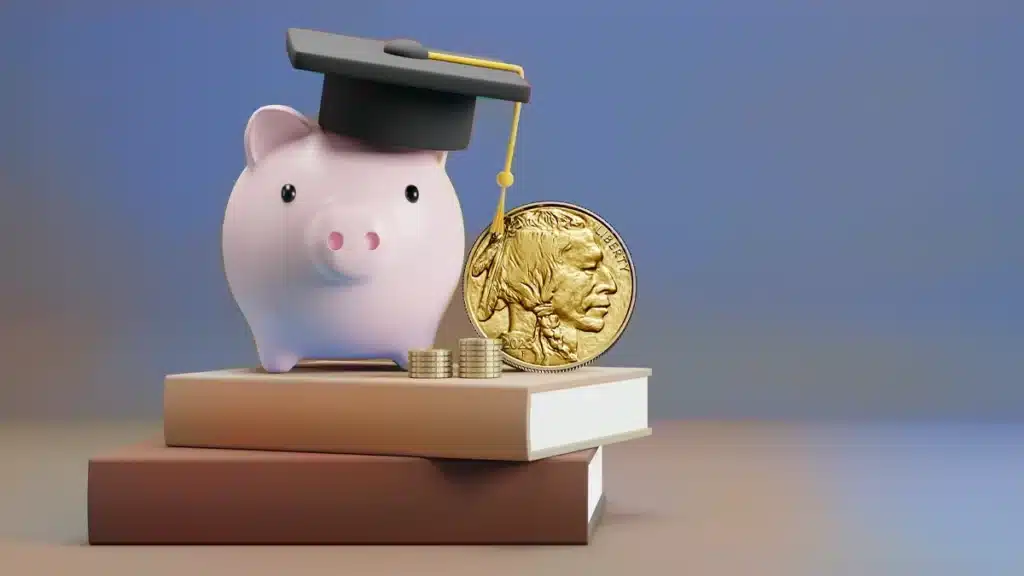
Summer Seminar scholarship applications are now available for the 2024 sessions organized by the American Numismatic Association (ANA). Winners of scholarships can attend one of two sessions held June 16-19 and June 23-26 on the campus of Colorado College campus near ANA headquarters in Colorado Springs, Colorado. All members regardless of age are eligible.
Yougn Numismatists (YNs) can apply for financial aid through either the ANA Young Numismatist Scholarship program, the Martin D. Weiss Memorial Scholarship, the David Lisot Memorial YN Scholarship, or the Greg Lyon Memorial YN Scholarship. Applicants for ANA YN scholarships must be full-time students between the ages of 13 and 17. People 18 and older can receive full or partial assistance through the Robert C. Lecce Advanced Scholarship. The Charles O. Browne Scholarship is available for those aged between 15 and 25 who wish to attend the “Advanced United States Coin Grading and Problem Coins” class in Session 2 (June 23-26).
Full scholarships for everyone regarless of age include tuition, room and board for one week, and airfare. Partial scholarships for all applicants only cover tuition. Winners will be chosen based on merit and need.
Summer Seminar scholarship applications are available here and must be postmarked no later than February 15, 2024. For more information, contact the ANA Seminars Department at (719) 482-9848 or seminars@money.org.
* * *
The post ANA Summer Seminar Scholarships Available for 2024 appeared first on CoinWeek: Rare Coin, Currency, and Bullion News for Collectors.
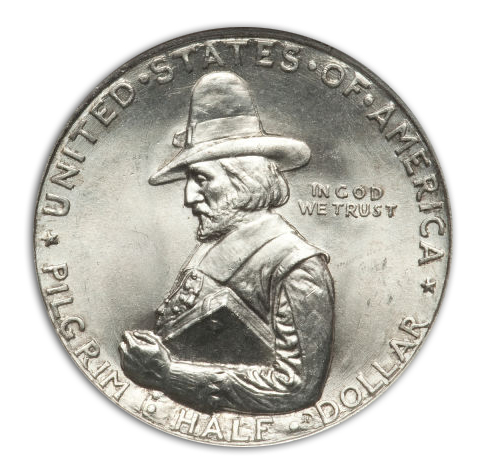
Thanksgiving Motifs on Classic Commemorative Coins
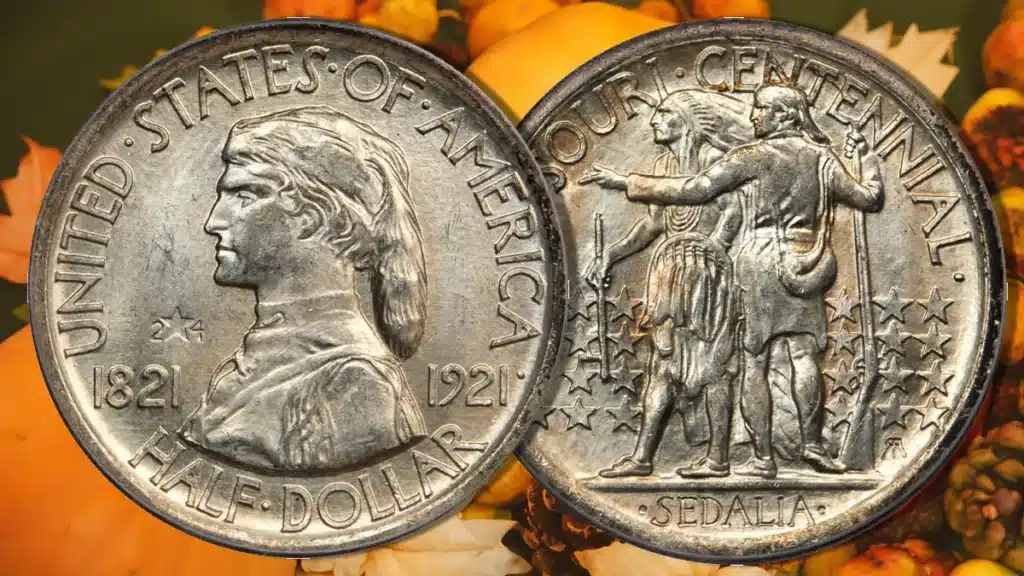
By Dan Duncan – Retired, Pinnacle Rarities ……
The Thanksgiving celebration cues up the holiday season and begins the winding down of another year. The concept of a Thanksgiving predates the English colonies in America, but the ideas and themes we attribute to the celebration are rooted in several of our early settlements. Our version of the holiday dates back to the 17th century and can be traced back to two celebrations: one from 1619 in Charles City, Virginia, and one from 1620 in Plymouth, Massachusetts. Three hundred years ago the celebration was a religious one that featured praise to God, some fasting, and an appreciation for the year’s harvest and the bounty produced.
As a society, we’ve moved away from being mainly agricultural, and our nation has moved along those lines. Modern festivities generally feature a feast with a gathering of family and friends.
Thanksgiving is not uniquely American, and similar holidays are observed in a number of other countries; Canada, for example, celebrates Thanksgiving on the second Monday in October. But our version became a national holiday with a fixed date declared by Congress in 1941. Today, the popularized story is one where the Pilgrims (or Puritans) came together with the local Native Americans. This exchange is a glamorized account of a real event, of which there are several accounts and records. One is that it stems from the Wampanoag making an offer to the settlers in exchange for defense from their rivals the Narragansett. The settlers pledged their aid and accepted food and supplies. The two groups then celebrated the collaboration with a feast. Another comes from the Narragansett’s aid given to Roger Williams after his forced departure from the Massachusetts Bay Colony and in defense from attack that their settlements came under during King Phillip’s War (1675-1678). The series of battles and the results of encounters speak in contrast to this peaceful exchange.
The true lines of historical events are extremely blurred here. And the story of the first Thanksgiving feast is an obviously romanticized version of certain factual events. The relationship between the European settlers and the Native Americans was not a pretty one, yet it wasn’t all oppression and disease.
So on a lighter note, as we settle in to give thanks for our blessings, here are a few classic commemoratives that portray the colorful relationships in a pleasing light. The following coins depict motifs that are “Thanksgiving-centric” and show early meetings of the settlers and frontiersmen with the Native Americans.
The 1920 and 1921 Pilgrim Tercentenary Half Dollar

The Pilgrim displayed on the obverse of this early classic commemorative half dollar is the quintessential Thanksgiving motif. This coin commemorates the landing of the Pilgrims at Plymouth Rock and coincides with one of the first Thanksgiving celebrations in 1620 in Plymouth, MA.
The 1936 Rhode Island Commemorative Half Dollar
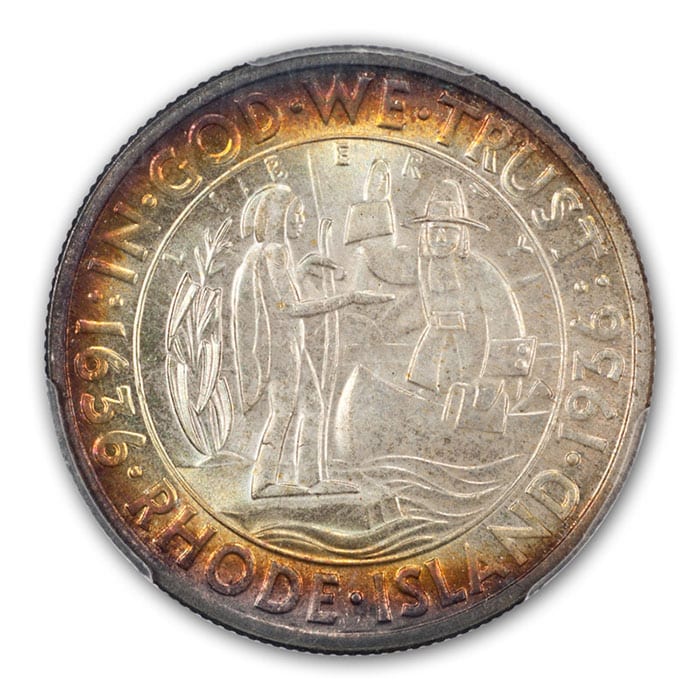
The obverse depicts an image of a Pilgrim (namely Roger Williams) arriving in the New England colonies being greeted by a native. The Williams Landing is portrayed in various artworks and accounts. The tribe that received Roger Williams was the Narragansett. This is the tribe from which verbal history says settlers swore to protect the Wampanoag. The Narragansett eventually helped Williams after his banishment from the colony. The images pictured on this coin are arguably the most “Thanksgiving-like”.
The 1921 Missouri Centennial Commemorative Half Dollar

The reverse features a frontiersman (presumably Daniel Boone) and native chief holding a peace pipe gazing westward. Designed by Robert Aitken and chosen from various sketches, the reverse portrays a fictitious event that was more than a century after the original Thanksgiving celebrations. It illustrates the ongoing relationship between the Indians and the early English settlers.
The 1935-1939 Arkansas Centennial Half Dollar
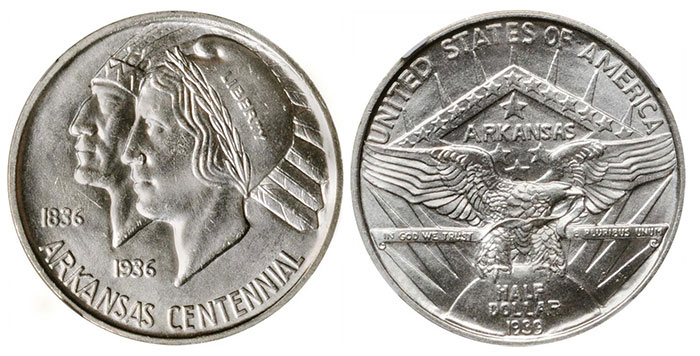
There are several examples of Native Americans on coinage from the mid-1930s. The Arkansas Centennial half dollar portrays both an Indian chief and Lady Liberty. The narrative behind this and other depictions of the relationship between the Native Americans and the settlers is a debate for another place. For our purposes here, the coin shows both a Quapaw chief and an allegorical Liberty side by side in unity.
The 1934-1939 Daniel Boone Bicentennial Half Dollar
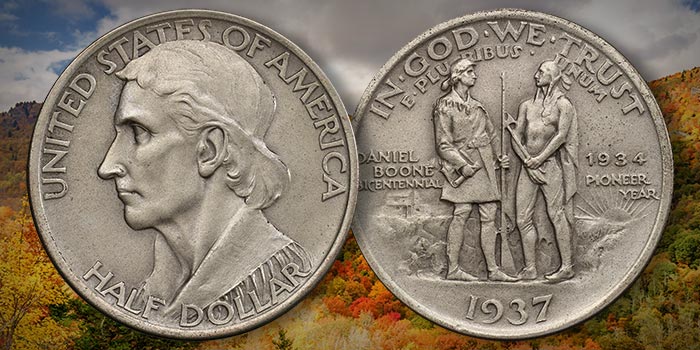
Daniel Boone is the epitome of a frontiersman. Captured a couple of times by the Indians, Boone was known as a fierce enemy to the warring tribes he faced. Most famously was the Battle of Blue Licks where Boone’s Kentucky militia fought both native and British forces in 1782. However, the coin shows Boone in peaceful conversation with Blackfish, the chief of the Chillicothe of the Shawnee tribes. While again not truly an early Thanksgiving scene, the coin portrays the relationship as friendly and peaceful.
Other classic commemoratives show frontiersmen or Native Americans in various forms, of course, but I’ll save those for a later date. Many of these coins don’t purposely tackle the Thanksgiving theme, but the concept of cooperative work between the Indians and the early settlers is documented, and the folklore that developed is portrayed in various works of 20th-century numismatics.
* * *
The post Thanksgiving Motifs on Classic Commemorative Coins appeared first on CoinWeek: Rare Coin, Currency, and Bullion News for Collectors.

Thanksgiving Motifs on Classic Commemoratives
By Dan Duncan – Pinnacle Rarities ……
The Thanksgiving celebration cues up the holiday season and begins the winding down of another year. The concept of a Thanksgiving predates the English colonies in America, but the ideas and themes we attribute to the celebration are rooted in several of our early settlements. Our version of the holiday dates back to the 17th century and can be traced back to two celebrations: one from 1619 in Charles City, Virginia, and one from 1620 in Plymouth, Massachusetts. Three hundred years ago the celebration was a religious one that featured praise to God, some fasting, and an appreciation for the year’s harvest and the bounty produced.
As a society, we’ve moved away from being mainly agricultural, and our nation has moved along those lines. Modern festivities generally feature a feast with a gathering of family and friends.
Thanksgiving is not uniquely American, and similar holidays are observed in a number of other countries; Canada, for example, celebrates Thanksgiving on the second Monday in October. But our version became a national holiday with a fixed date declared by Congress in 1941. Today, the popularized story is one where the Pilgrims (or Puritans) came together with the local Native Americans. This exchange is a glamorized account of a real event, of which there are several accounts and records. One is that it stems from the Wampanoag making an offer to the settlers in exchange for defense from their rivals the Narragansett. The settlers pledged their aid and accepted food and supplies. The two groups then celebrated the collaboration with a feast. Another comes from the Narragansett’s aid given to Roger Williams after his forced departure from the Massachusetts Bay Colony and in defense from attack that their settlements came under during King Phillip’s War (1675-1678). The series of battles and the results of encounters speak in contrast to this peaceful exchange.
The true lines of historical events are extremely blurred here. And the story of the first Thanksgiving feast is an obviously romanticized version of certain factual events. The relationship between the European settlers and the Native Americans was not a pretty one, yet it wasn’t all oppression and disease.
So on a lighter note, as we settle in to give thanks for our blessings, here are a few classic commemoratives that portray the colorful relationships in a pleasing light. The following coins depict motifs that are “Thanksgiving-centric” and show early meetings of the settlers and frontiersmen with the Native Americans.

1920 and 1921 Pilgrim Tercentenary – The Pilgrim displayed on the obverse of this early classic commem is the quintessential Thanksgiving motif. This coin commemorates the landing of the Pilgrims at Plymouth Rock and coincides with one of the first Thanksgiving celebrations in 1620 in Plymouth, MA.

1936 Rhode Island – The obverse depicts an image of a Pilgrim (namely Roger Williams) arriving in the New England colonies being greeted by a native. The Williams Landing is portrayed in various artworks and accounts. The tribe that received Roger Williams was the Narragansett. This is the tribe from which verbal history says settlers swore to protect the Wampanoag. The Narragansett eventually helped Williams after his banishment from the colony. The images pictured on this coin are arguably the most “Thanksgiving-like”.

1921 Missouri Centennial – The reverse features a frontiersman (presumably Daniel Boone) and native chief holding a peace pipe gazing westward. Designed by Robert Aitken and chosen from various sketches, the reverse portrays a fictitious event that was more than a century after the original Thanksgiving celebrations. It illustrates the ongoing relationship between the Indians and the early English settlers.

1935-1939 Arkansas Centennial –There are several examples of Native Americans on coinage from the mid-1930s. The Arkansas Centennial half dollar portrays both an Indian chief and Lady Liberty. The narrative behind this and other depictions of the relationship between the Native Americans and the settlers is a debate for another place. For our purposes here, the coin shows both a Quapaw chief and an allegorical Liberty side by side in unity.

1934-1939 Daniel Boone Bicentennial – Daniel Boone is the epitome of a frontiersman. Captured a couple of times by the Indians, Boone was known as a fierce enemy to the warring tribes he faced. Most famously was the Battle of Blue Licks where Boone’s Kentucky militia fought both native and British forces in 1782. However, the coin shows Boone in peaceful conversation with Blackfish, the chief of the Chillicothe of the Shawnee tribes. While again not truly an early Thanksgiving scene, the coin portrays the relationship as friendly and peaceful.
Other classic commemoratives show frontiersmen or Native Americans in various forms, of course, but I’ll save those for a later date. Many of these coins don’t purposely tackle the Thanksgiving theme, but the concept of cooperative work between the Indians and the early settlers is documented, and the folklore that developed is portrayed in various works of 20th-century numismatics.
The post Thanksgiving Motifs on Classic Commemoratives appeared first on CoinWeek: Rare Coin, Currency, and Bullion News for Collectors.
Gold, Silver and Other Metals Decline Ahead of Thanksgiving
Precious metals declined collectively on Wednesday, just before the U

1978 Eisenhower Dollar : A Collector’s Guide
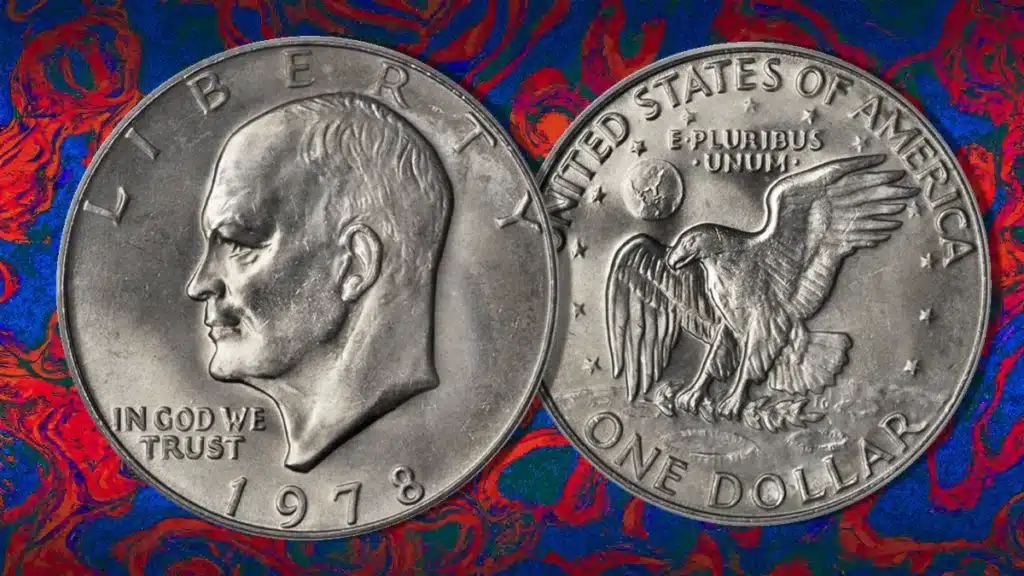
As the Philadelphia Mint Prepared to Strike Susan B. Anthony Dollars, the Final Eisenhower Dollars Were Struck
The United States Mint recognized that the large size of the one dollar coin was suboptimal if the coin was to see widespread circulation and acceptance in vending machines. The Eisenhower dollar measured 38.1mm in diameter and was the same size as the standard silver dollars struck by the Mint from 1840 to 1935. Then, the large dollar coins and many of America’s subsidiary coins were struck on planchets that were made of .900 fine silver.
The Coinage Act of 1965 marked a departure from silver coinage on the dime and quarter, and called for the production of a debased 40% silver half dollar. By 1970, the Mint had come to realize that producing half dollars in silver was a mistake. This was apparent in the wording of the legislation that authorized the production of the Eisenhower dollar, as the bill called for the production of copper and nickel-clad coins for circulation and 40% silver-clad coins to be struck solely for collectors. That same bill called for the half dollar to be struck in copper-nickel as well.
Without the intrinsic value of silver, the coin’s large size was owed more to tradition than practicality. True, casino interests found the coins an ideal replacement for the silver dollars that once poured into their slot machines, but for the rest of America, the Eisenhower dollar was a novelty coin at best, and a government boondoggle at worst.
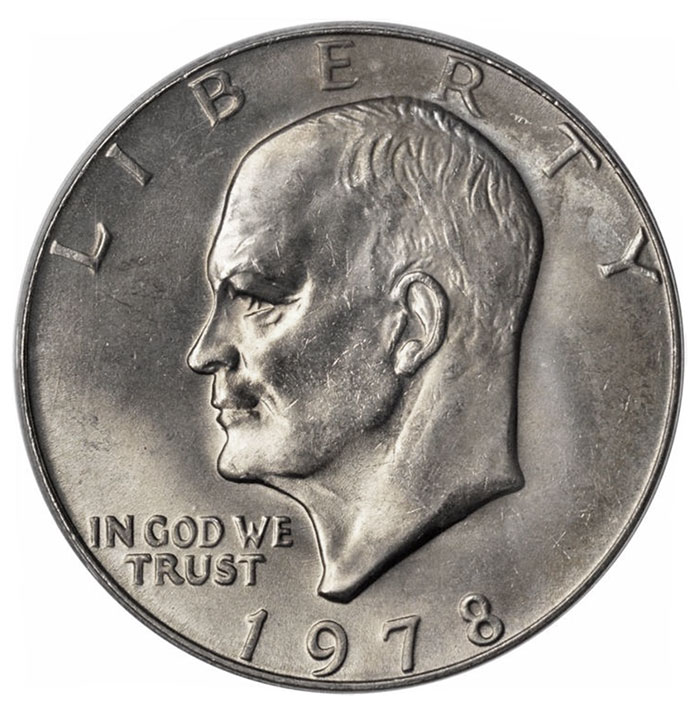
By the summer of 1976, work was well underway to rethink the future of American coinage. In its Comprehensive Review of U.S. Coinage, the Research Triangle Institute contemplated the elimination of the cent, the introduction of a two-cent coin, and the introduction of a “more convenient-sized” one dollar coin.
The “more conveniently sized” one-dollar coin went from a think tank idea to the subject of Congressional interest by the end of the decade. In 1978, Congress held numerous hearings regarding a change in the size and design of the dollar coin. In July, the Committee on Banking, Housing, and Urban Affairs of the United States Senate filed its report and proposed a bill to authorize the production of a small dollar coin bearing the likeness of Susan B. Anthony. Anthony beat out a number of other historical figures for the coin’s obverse, including Corps of Discovery member Sacagawea. Sacagawea would replace the stern-faced suffragette as the face of another dollar coin debacle.
This was the climate under which the last of the Eisenhower dollars of 1978 were made. The United States Mint struck 25.7 million Eisenhower dollars at the Philadelphia Mint. On December 13, 1978, the striking of the first Susan B. Anthony dollars marked the end of America’s last large circulating dollar series.
How Much Is the 1978 Eisenhower Dollar Worth?
Although it’s been 45 years since the final Eisenhower dollars were struck, these durable coins can still be acquired in circulation. Larger bank branches will occasionally have a few on hand – but these coins are typically worn. Bag and roll quantities of the coin still persist, but these are infrequently encountered.
Circulated 1978 Eisenhower dollars are worth a small premium over their $1 face value. Uncirculated examples are also plentiful. A common source for these coins is the 1978 United States Mint Uncirculated Coin Set. 2,006,869 of these sets were sold and each one contains a single example of every circulating coin struck at the Philadelphia and Denver Mints. These sets carried an issue price of $7 and today are worth about $15. A loose uncirculated 1978 Eisenhower dollar typically sells for $5 to $7 on eBay.
Collectors particular about the quality of their coins may prefer to buy examples that have been graded by one of the three major grading services: CAC, NGC, or PCGS.
In Mint State 65, the 1978 Eisenhower dollar is worth about $18, according to CoinWeek IQ’s current market analytics. This low price does not reflect the difficulty in cherrypicking gem-quality Eisenhower dollars of this issue in the wild. Mint set coins tend to have the best strikes, but this is a trend and not a rule. In MS66, the 1978 Eisenhower Dollar sells for about $80.
The coin is conditionally rare in the grade of MS67 and recent auction records indicate that at this level, this issue has a value of approximately $5,000. With the appearance of new coins in the condition census, expect this price to soften somewhat. CAC-approved coins, especially those of extraordinary quality for the grade, will bring substantial premiums over these guide values.
Design
 Obverse:
Obverse:
Gasparro’s portrait of Dwight D. Eisenhower (as president); Eisenhower facing to the left. Gasparro’s initials “FG” appear raised in the bust truncation. Beneath Eisenhower’s chin, to the left, is the motto “IN GOD WE TRUST” LIBERTY wraps around the top of the coin in the space between the rim and the top of Eisenhower’s head. The date wraps around the bottom of the design, between the rim and the bottom of Eisenhower’s bust truncation. While Philadelphia-struck pieces bear no mintmark, coins struck at Denver and San Francisco will bear small mintmarks of “D” or “S” above the space between the last two digits of the date. On Eisenhower dollars, mintmarks were hand-punched and may vary in exact location and orientation.
Reverse:
The reverse is based on Michael Collins’ Apollo 11 Mission Patch design.
In the center, a bald eagle in descent. In its talons, an olive branch. Its left wing is raised. The lunar surface lies below. Above the eagle’s head is a depiction of the Earth. North America is prominently visible. Wrapping around the top of the coin adjacent to the rim is the legend “UNITED STATES OF AMERICA.” Thirteen small five-point stars circle around the eagle. Below the ring of stars but above the eagle is the motto “E PLURIBUS UNUM”. Wrapping around the bottom of the design is the denomination “ONE DOLLAR”.
Edge:
The edge of the 1978 (P) Eisenhower Dollar is reeded.
Designer
Frank Gasparro was a friend to numismatists and served as Chief Engraver of the United States Mint from 1965 to 1981 (View Designer’s Profile).
Coin Specifications
| Country: | United States |
| Year Of Issue: | 1978 |
| Denomination: | One Dollar (USD) |
| Mint Mark: | None (Philadelphia) |
| Mintage: | 25,702,000 |
| Alloy: | Copper-Nickel (Cu-Ni) |
| Weight: | 22.68 g |
| Diameter: | 38.10 mm |
| OBV Designer | Frank Gasparro |
| REV Designer | Frank Gasparro | Michael Collins |
| Quality: | Uncirculated |
* * *
The post 1978 Eisenhower Dollar : A Collector’s Guide appeared first on CoinWeek: Rare Coin, Currency, and Bullion News for Collectors.

1978 Eisenhower Dollar : A Collector’s Guide | CoinWeek

As the Philadelphia Mint Prepared to Strike Susan B. Anthony Dollars, the Final Eisenhower Dollars were Struck
The United States Mint recognized that the large size of the one dollar coin was suboptimal if the coin was to see widespread circulation and acceptance in vending machines. The Eisenhower dollar measured 38.1mm in diameter and was the same size as the standard silver dollars struck by the United States Mint from 1840 to 1935. Then, the large dollar coins and many of America’s subsidiary coins were struck on planchets that were made of .900 fine silver.
The Coinage Act of 1965 marked a departure from silver coinage on the dime and quarter, and called for the production of a debased 40% silver half dollar. By 1970, the Mint had come to realize that producing half dollars in silver was a mistake. This was apparent in the wording of the legislation that authorized the production of the Eisenhower dollar, as the bill called for the production of copper and nickel-clad coins for circulation and 40% silver-clad coins to be struck solely for collectors. That same bill called for the half dollar to be struck in copper-nickel as well.
Without the intrinsic value of silver, the coin’s large size was owed more to tradition than practicality. True, casino interests found the coins an ideal replacement for the silver dollars that once poured into their slot machines, but for the rest of America, the Eisenhower dollar was a novelty coin, at best, and a government boondoggle at worst.

By the summer of 1976, work was well underway to rethink the future of American coinage. In its Comprehensive Review of U.S. Coinage, the Research Triangle Institute contemplated the elimination of the cent, the introduction of a two-cent coin, and the introduction of a “more convenient-sized” one dollar coin.
The “more conveniently sized” one-dollar coin went from a think tank idea to the subject of Congressional interest by the end of the decade. In 1978, Congress held numerous hearings regarding a change in the size and design of the dollar coin. In July, the Committee on Banking, Housing, and Urban Affairs of the United States Senate filed its report and proposed a bill to authorize the production of a small dollar coin bearing the likeness of Susan B. Anthony. Anthony beat out a number of other historical figures for the coin’s obverse, including Corps of Discovery member Sacagawea. Sacagawea would replace the stern-faced suffragette as the face of another dollar coin debacle.
This was the climate under which the last of the Eisenhower dollars of 1978 were made. The United States Mint struck 25.7 million Eisenhower dollars at the Philadelphia Mint. On December 13, 1978, the striking of the first Susan B. Anthony dollars marked the end of America’s last large circulating dollar series.
How Much is the 1978 Eisenhower Dollar Worth?
Although it has been 45 years since the final Eisenhower dollars were struck, these durable coins can still be acquired in circulation. Larger bank branches will occasionally have a few on hand – but these coins are typically worn. Bag and roll quantities of the coin still persist, but these are infrequently encountered.
Circulated 1978 Eisenhower dollars are worth a small premium over their $1 face value. Uncirculated examples are also plentiful. A common source for these coins is the 1978 United States Mint Uncirculated Coin Set. 2,006,869 of these sets were sold and each one contains a single example of every circulating coin struck at the Philadelphia and Denver Mints. These sets carried an issue price of $7 and today are worth about $15. A loose uncirculated 1978 Eisenhower dollar typically sells for $5 to $7 on eBay.
Collectors particular about the quality of their coins may prefer to buy examples that have been graded by one of the three major grading services: CAC, NGC, or PCGS.
In Mint State 65, the 1978 Eisenhower dollar is worth about $18, according to CoinWeek IQ’s current market analytics. This low price does not reflect the difficulty in cherrypicking gem-quality Eisenhower dollars of this issue in the wild. Mint set coins tend to have the best strikes, but this is a trend and not a rule. In MS66, the 1978 Eisenhower Dollar sells for about $80.
The coin is conditionally rare in the grade of MS67 and recent auction records indicate that at this level, this issue has a value of approximately $5,000. With the appearance of new coins in the condition census, expect this price to soften somewhat. CAC-approved coins, especially those of extraordinary quality for the grade, will bring substantial premiums over these guide values.
Design
Obverse:
Gasparro’s portrait of Dwight D. Eisenhower (as President); Eisenhower facing to the left. Gasparro’s initials “FG” appear raised in the bust truncation. Beneath Eisenhower’s chin, to the left, is the motto “IN GOD WE TRUST” LIBERTY wraps around the top of the coin in the space between the rim and the top of Eisenhower’s head. The date wraps around the bottom of the design, between the rim and the bottom of Eisenhower’s bust truncation. While Philadelphia-struck pieces bear no mintmark, coins struck at Denver and San Francisco will bear small mintmarks of “D” or “S” above the space between the last two digits of the date. On Eisenhower dollars, mintmarks were hand-punched and may vary in exact location and orientation.
Reverse:
The reverse is based on Michael Collins’ Apollo 11 Mission Patch design.
In the center, a bald eagle in descent. In its talons, an olive branch. Its left wing is raised. The lunar surface lies below. Above the eagle’s head is a depiction of the Earth. North America is prominently visible. Wrapping around the top of the coin adjacent to the rim is the legend “UNITED STATES OF AMERICA.” Thirteen small five-point stars circle around the eagle. Below the ring of stars but above the eagle is the motto “E PLURIBUS UNUM”. Wrapping around the bottom of the design is the denomination “ONE DOLLAR”.
Edge:
The edge of the 1978 (P) Eisenhower Dollar is reeded.
Designer
Frank Gasparro was a friend to numismatists and served as Chief Engraver of the United States Mint from 1965 to 1981 (View Designer’s Profile).
Design
Coin Specifications
| Country: | United States |
| Year Of Issue: | 1978 |
| Denomination: | One Dollar |
| Mint Mark: | None (Philadelphia) |
| Mintage: | 25,702,000 |
| Alloy: | Copper-Nickel (Cu-Ni) |
| Weight: | 22.68 g |
| Diameter: | 38.1 mm |
| OBV Designer | Frank Gasparro |
| REV Designer | Frank Gasparro | Michael Collins |
| Quality: | Uncirculated |
The post 1978 Eisenhower Dollar : A Collector’s Guide | CoinWeek appeared first on CoinWeek: Rare Coin, Currency, and Bullion News for Collectors.
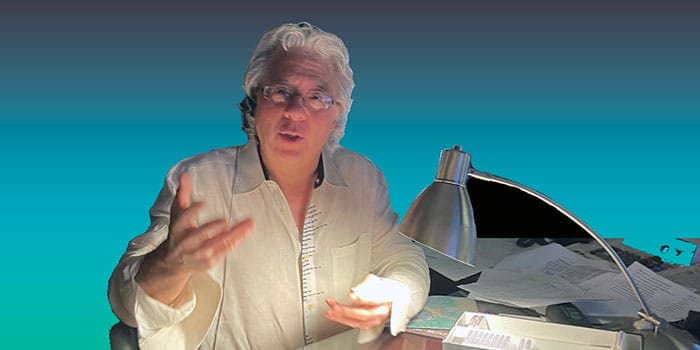
What Do Coin Auction Prices Mean?

By Greg Reynolds for CoinWeek …..
Though auction prices are often cited as market prices, not enough has been written about the nature and meaning of auction prices and how these relate to market prices. In this article, I’m not talking about bullion items or generic coins like the 1924 $20 double eagle or the 1881-S Morgan dollar. Instead, I’m referring to pre-1934 coins that are rare or at least very scarce. How do auction results for pre-1934 U.S. coins relate to market prices? Are auction prices market prices?
What Do Auction Prices Mean?
To help answer that question, I asked some experts.
Kris Oyster of Dallas Gold and Silver Exchange finds that “most auction prices are somewhere in the middle of wholesale prices and retail prices.”
Similarly, Mark Feld, a longtime coin business veteran and an expert grader, states that “auction prices are a blend of wholesale and retail prices,” depending upon the motivation and knowledge of the respective bidders.
For our purposes, “Wholesale” can be thought of as what dealers are willing to pay in dealer-to-dealer transactions, and “retail” is the price that dealers offer to collectors that they don’t have a previous working relationship with. Often, but not always, an auction price will be in the upper register of a wholesale price range or in the lower part of a retail price range for a respective coin. As to why “retail” is the higher of the two, keep in mind that a dealer likely has their own capital tied up in the purchase of the coin for their inventory and must cover those costs in any given sale (one dealer buying from another can even be seen as lowering the first dealer’s inventory costs).
So one factor influencing this pricing between wholesale and retail might be that while an auctioneer is paid a commission from the buyer and the seller of a coin, they otherwise have no financial interest in what the coin costs to either party.
But an exception to this middle-ground pricing is when extremely rare coins are sold at auction. On average (but not always), these realize stronger prices than coins that are not as distinctive. Consider, as examples, Capped Head $5 half eagles from the 1820s, U.S. Patterns, 1854-S $2.50 quarter eagles, and extremely rare die varieties of Bust dimes or early large cents. Are the markets for these defined by auction prices?
No, there are plenty of cases of extremely rare patterns, Capped Head half eagles, or early large cent die varieties being purchased by dealers who, not long afterwards, sell them to collectors for 5% to 40% over their respective auction prices. In some cases, the auction result for an extremely rare item will be a retail price and, in other cases, it will be a wholesale price (the markets for rare coins can be thinly capitalized). It doesn’t make sense to consider auction prices realized in both categories to be “market prices” or “true values”. Even for extremely rare items, auction prices may substantially differ from market prices.

In general, CAC President John Albanese strongly maintains that it is almost impossible to draw a conclusion about the meaning of most auction prices for scarce or rare coins. In 1987, Albanese was the sole founder of NGC, and in 2007, he founded CAC.
“Usually, you do not really know why a coin sells for a price at auction,” Albanese states. “It could have been in an old [PCGS or NGC] holder and be bought just to upgrade. A dealer who is getting his 5% commission may push a collector to buy a coin so the [dealer-agent] gets paid. A coin may also bring too low a price at auction if only wholesalers, not collectors or retailers, bid on it. I do not rely on auction prices – auction records are number four on my list of sources to price a coin.”
Similarly, Matt Kleinsteuber asserts that many auction prices are not reflective of market prices. He regards market prices for coins to be the prices that prevail in dealer-to-dealer transactions, which I (this writer) refer to as “wholesale”. Matt is the lead grader and trader for NFC Coins (Numismatic Financial Corporation).
At auctions, Kleinsteuber says that “some coins are beyond great bargains and some stuff brings ultimate dollar. [Indeed,] some coins bring way too much and others not nearly enough,” less than wholesale prices. “As an example,” Matt mentions that he buys “rainbow toned silver coins at auctions and then sells them two or three days later to other dealers for 50% more” than the auction prices realized. In other cases, “rainbow toned silver coins bring 100% more” than wholesale prices for such coins.
Like Albanese, Kleinsteuber does NOT rely on auction prices to value coins.
“It is necessary to take many factors into consideration,” he said. “I need to know what the coin looks like. Just knowing its [type, date, and] certification is not enough.”
When Collectors Buy for Their Collections
Often at auctions, collectors buy coins for their respective collections. When an auction lot sells directly to a collector, the price realized should be interpreted much differently than when a coin is acquired by a wholesaler who stays in the shadows and does not wish to sell directly to collectors.
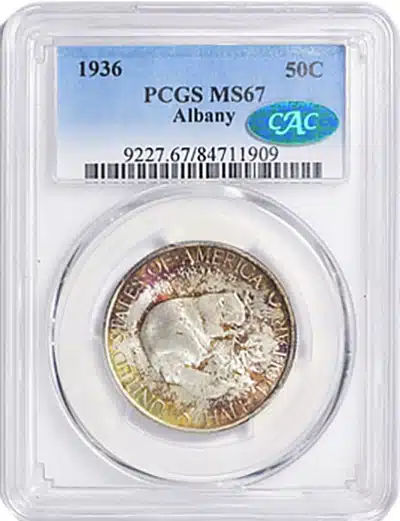
When a coin is acquired at auction by a wholesaler, the coin may eventually be sold by a telemarketer for a price that is 20% to 75% higher than the price the same coin realized at auction. Therefore, in the same auction, some coins will sell directly to collectors and others will eventually be sold to retail clients for 20% to 75% more than the auction results.
A substantial percentage of auctioned coins will eventually sell for prices in the range of 5% to 30% over their respective auction results. Even so, it does not make sense to refer to both the auction price for a coin that a collector buys directly and the auction price for a coin that will soon be sold for 20% to 30% more as a “market price”.
Mark Feld raises the issue of dealers losing money on auction purchases, which I know to be a common occurrence. If a dealer outbids a collector, and the dealer later loses money on the coin, Feld suggests that the “price paid might have been retail.”
Clearly, when more than one collector is seriously competing for a coin at auction, the result is likely to be a retail price for the coin. But then again, if not-so-serious collectors or even zero collectors bid on a coin, the auction result could still be a retail price.
When Collectors Are Represented by Dealers
To acquire coins at auction, a collector may be represented by a dealer. A fee is usually paid for this service, typically 5% of the hammer price. Such representation occurs often at major coin auctions. In my personal opinion, it would make sense for the collector and his representative to negotiate a different arrangement, one that is not based on a percentage of the price realized. Nevertheless, the standard fee for such a service has always been 5% of the hammer price of the coins that the collector actually buys.
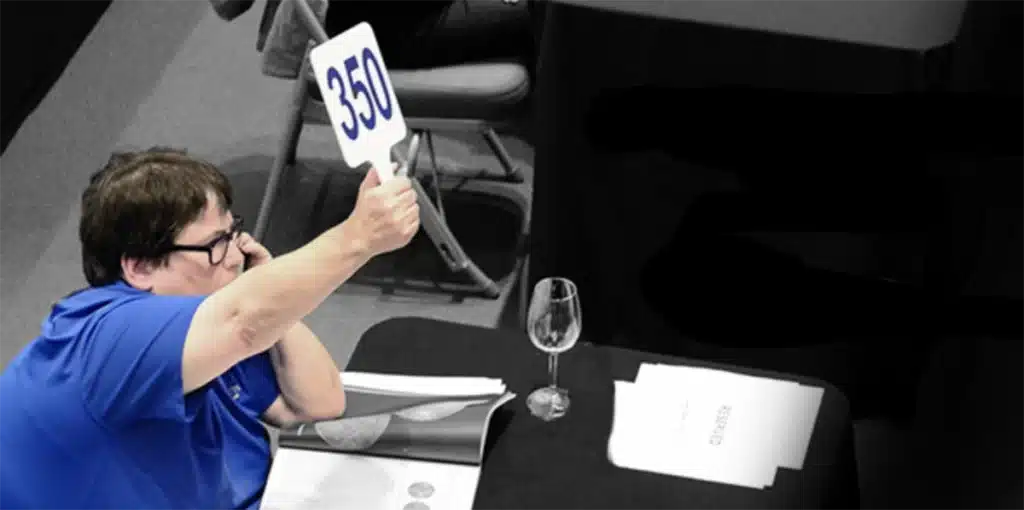
The dealer/agent may either use a separate bidder number for a collector/client or they may just place their own purchases and their clients’ on one bidder number. In many cases, it’s not apparent to other participants or even to the auction company that a dealer is representing a collector. Nonetheless, when dealers/agents are competing with collectors and/or other dealers, the coins purchased are likely to sell for prices in the retail range.
When Dealers Bid on Coins with a Customer in Mind
It is not unusual for a dealer to buy a coin at auction with a collector/customer already in mind. In such a situation, the dealer doesn’t know for certain that this collector will buy the coin, but it’s likely. The collector may wish to examine each coin before making a final decision. In this category of auction bidding, the dealer is thus assuming more risk than one would be if they were representing a collector for a 5% fee. So in this situation, the dealer will probably offer the coin to the collector they had in mind for 6% to 15% over the auction result.

In the event that the targeted collector fails to buy the coin, the dealer will likely offer it to other collectors for 6% to 30% over the auction result, depending on the nature of the coin and the relative strength of the particular auction result. If the dealer paid a retail or almost retail price for the coin at auction, then he may sell it at a loss to another dealer. Indeed, it would not be rare for a dealer to incur a loss in such a situation.
So far, three kinds of collector-oriented bidding have been covered: collectors bidding for themselves, collectors bidding through agents, and collectors indirectly (and sometimes unknowingly) influencing the bidding of dealers. Bidding in all three of these categories will often push auction prices into the retail price range.
When Dealers Buy to Upgrade
Though it pushes prices upward, the saddest and most harmful reason for a dealer to buy a coin at auction is to upgrade it.
Uncirculated and Proof coins are graded on a scale from 60 to 70, and one grade increment can equate to a substantial or even tremendous increase in value. For extremely rare coins, a jump in a circulated grade, perhaps from VF-35 to EF-40 may also result in a marked increase in value.
If a coin that is PCGS- or NGC-certified as grading 65 is ‘cracked out’ and re-submitted, it may be awarded a 66 grade. Crackouts have been occurring since the PCGS was founded in 1986. The era of severe grade-inflation, roughly from 1997 to 2006, led to many coins being upgraded by one, two or even three grade increments. For example, it is not unusual for a gold rarity that formerly graded EF-40 to be certified as grading AU-53 now.
While the problems caused by grade-inflation are significant, coin doctoring is even worse.
It is important to emphasize that most dealers who play the ‘crackout’ game lose money. Likewise, there are a fairly small number of coin doctors who can successfully deceive professional third party graders. The point in this context is that when bidders want to upgrade a coin that is being sold at auction, the price realized may not correspond to either a wholesale or a retail level relating to the PCGS- or NGC-certified grade of the coin in question. A coin that is certified as grading MS64 may be graded “MS66” by two bidders who seek to upgrade it.
When Dealers Buy to Sell to Collectors
Curiously, many mainstream dealers (in rare U.S. coins) attain most of their inventories at auction. By this, I mean a situation where the dealer/buyer is seriously planning to sell his auction purchase for a profit within one year of purchasing it. When a dealer keeps a coin purchased at auction for more than one year, especially if he figures he is likely to do so, he really becomes a speculator or a collector in regard to the purchase of that coin.
Generally, when a dealer buys at auction with the idea of selling to a collector in less than one year, he should be a collector-oriented dealer who has knowledge of the demands of his customers and potential customers. Auction results that fall into this category are often in the upper reach of the wholesale range or even in the retail range proper if the collector-oriented dealer thinks they can pay a retail price and then charge still more. Some dealers have an advanced understanding of the markets for particular kinds of coins and/or a strong clientele for such coins.
When Dealers Buy to Sell to Other Dealers
From the time that I started writing about coin auctions, this category of auction buyers has puzzled me. Although I maintain that the activities of coin doctors and even non-doctoring crackout artists are harmful to collectors and to the long-term health of coin markets, I have always understood their activities.
I am curious about the wholesalers who are not crackout artists and have no collectors as customers. Most of them don’t even want to meet collectors. There are wholesalers who trade exclusively with other dealers. When these dealers buy coins at auction, it is usually true that the prices realized are at wholesale levels, or even below wholesale.
Conclusions
Are most auction results in wholesale price ranges? Yes, undoubtedly so.
Many collectors do not participate in auctions, or at least not as often as they purchase coins privately. There are many collectors who wish to physically examine coins for themselves before making a decision. Furthermore, there are collectors who do not feel comfortable making the snap decisions required of an auction setting. Coin collectors frequently take a leisurely approach to acquisitions. Moreover, in many instances, collectors are persuaded by dealers to buy specific coins. The dynamics of an auction are different from the characteristics of a private sale, in which collectors are willing to pay more than pertinent auction results.
 Is it possible to know the meaning of a specific auction price for a rare coin? Many clues are available to anyone who devotes a lot of time to researching coins. After auctions, many auction purchases can be seen at dealers’ tables on the bourse floors of shows and conventions.
Is it possible to know the meaning of a specific auction price for a rare coin? Many clues are available to anyone who devotes a lot of time to researching coins. After auctions, many auction purchases can be seen at dealers’ tables on the bourse floors of shows and conventions.
How about the connection between auction prices and estimated values in price guides? I asked Laura Sperber of Legend Numismatics about the usefulness of price guides.
“There are NO accurate price guides,” she responded – with emphasis upon the word NO!
Regarding rare coins, I tend to agree. Some guides are more accurate than others for specific series and/or grade ranges.
Matching an auction price to a price guide value would not prove that both are accurate in such a case. It may be a consequence of two bidders employing incorrectly high price guide values to factor bids.
As for my own research and analysis, I find that some (not all) dealers and collectors are happy to discuss their auction purchases and unsuccessful bids with me after the auction, sometimes a week later. Furthermore, I frequently talk to dealers about private transactions, and I sometimes report on them. To understand market prices, and the correlation between market prices and auction prices, I learn about private transactions, dealer asking prices, and the availability of particular categories of coins.
There is no simple formula for analyzing auction prices. I hope that my discussion here contributes to an understanding of bidding behavior and auction phenomena.
* * *
The post What Do Coin Auction Prices Mean? appeared first on CoinWeek: Rare Coin, Currency, and Bullion News for Collectors.

Rare Coins Worth Money That You Can Find in Pocket Change

By Tyler Rossi for CoinWeek …..
Both coin roll hunting and searching through pocket change can be interesting and accessible entry points into the hobby of coin collecting. It’s also a good way to make a little extra money… if you know what to look for.

With no exaggeration at all, I have probably searched through $5,000 to $10,000 worth of coins over the years as part of my coin roll hunting hobby. Over time, I’ve learned a number of tricks to quickly spot coins that are worth more than face value. Using them, I’ve found a Henning nickel, an almost fully delaminated quarter, a number of blank Lincoln cent planchets, and a small amount of discontinued silver coinage.
As an added benefit, when you purchase rolls of coins from a bank or receive a handful of change from a store clerk you’re technically not losing any money–you can always deposit the coins you don’t want back in a bank or just spend them.
So, what should you look out for when coin roll hunting or in your pocket change? Some coins are worth much more than others, after all, so if you’re looking to maximize the returns on your investment of time and money, then I suggest specifically looking for the following categories of coins.

Look for Eye Appeal in Pocket Change and While Coin Roll Hunting
The first category includes any high-grade or Proof coins that have nice eye appeal.
It’s almost impossible to find a truly Mint State coin while coin roll hunting. But there will be a large number that are on the verge. If you’re lucky, either the coins will have come from a brand new original mint wrapper that was full of freshly minted coins or from someone who was dumping a collection into circulation. Both are distinct possibilities, and I have found examples of each.
The second portion of this category, Proof coinage, is rarely found in circulation. When Proof coins do pop up, they are often dumped from someone’s collection. This typically happens when a relative inherits coins from a deceased family member and doesn’t know or doesn’t care about the value. Take this as a cautionary tale: even if you don’t want to tell anyone what you spent, you should keep accurate, up-to-date records.
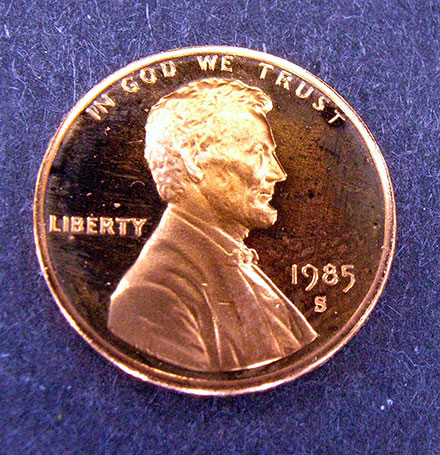
Also, Mint State and Proof coinage becomes damaged through circulation very quickly and will lose most (if not all) of its value in a short amount of time. Snap it up when you find it!
Discontinued Coin Designs
The second category is one that I’ve already mentioned, and it is any coin with a discontinued design that is still knocking about circulation.
Now at this point in time, most examples are quite worn and will only be worth between $1 and $5. But you can still get lucky and find a piece in a nicer grade that’s worth much more. While the average life span of a circulating coin is 30 years, that is only an average. I’ve found numerous 100-year-old coins while coin-roll hunting – and even in my change. Plus, if a coin sits in some form of storage and is out of circulation for years before returning to public hands, it can reappear in surprisingly good condition.
While it’s rather unlikely that you’ll find a rare type of mintage, it is still possible to find Buffalo and Shield nickels, Mercury dimes, Standing Liberty quarters, or Indian Head cents worth between $5-$25 or more apiece. I have found relatively nice examples of all these while coin roll hunting.
Next, I suggest you pull any older, pre-1930 Wheat cents that you find. As these are reaching their 100th year, there aren’t many in good condition to be found in circulation. However, most will sell for between 25 and 50 cents in local coin shops. Slightly higher grade yet still circulated examples can fetch between $1 and $5.
Also, hold on to any Lincoln cents dated 1955 (they could potentially be Doubled Die Obverse (DDO) errors) and steel cents from World War II.
Pre-1964 Silver Coinage
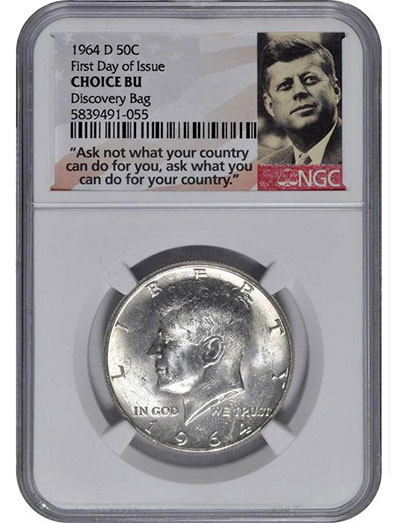
Fourth on my list is all 90% silver coinage. These are dimes, quarters, and half dollars struck prior to 1964, which is when the United States introduced clad coinage. In my personal experience, rolls of dimes produce dramatically more silver than rolls of quarters but slightly less than halves. However, it is much harder to locate half dollars because a lot of banks don’t carry them in much quantity.
But also, let me say from experience that there’s very little left in circulation. When I started nearly 15 years ago, there was already less than in previous decades (obviously).
Therefore, I suggest that, while finding a quarter or a half dollar is worth more individually and can provide a massive rush, if you’re looking for a higher gross volume of silver, then you should stick to dimes. These coins are generally not collected for their numismatic value but rather for their melt (the value of the metal they contain that could be retrieved by melting the coin). As such, these coins are often called “Junk Silver” and are bought and sold by weight. As of November 22, 2023, silver is worth $20.87 per ounce. That means a junk dime is worth about $1.79, a quarter $4.38, and a junk half dollar $8.70 (the later 40% silver halves are worth $3.56). Many dealers will purchase these for 3% to 5% below melt and sell for 3% to 5% above.
To save some time when checking your change or hunting through rolls, look at the edges; this is definitely easier than checking the date on each coin. On all modern circulating clad coinage, the copper core can be seen on the edges. Therefore, if the edge is entirely “silver” colored, then the coin is either silver or foreign.
As for Jefferson nickels, always look for the mint mark. If it’s on the reverse over Monticello, then it’s a 35% silver so-called “War nickel”.
Dramatic Errors in Pocket Change and Coin Rolls
The last category is error coinage. Through searching pocket change and full coin rolls, you can come across numerous types of errors–the vast majority of which are worth only face value. For example, coins that are very slightly off-center or with a small planchet defect.
However, if you find a coin that has a dramatic error, such as an off-metal strike or the 1955 DDO Lincoln cent mentioned above, it could be worth serious money. For example, the off-metal 1943 copper cent and silver 1965 dime are each worth thousands of dollars. These extreme errors are rare but do pop up every once in a while. Among the error coins that I’ve found are lamination errors (I sold the Washington quarter I found with a roughly 75% delaminated obverse for over $30!), off-center strikes, die clashes, blank planchets, and double-struck errors.
While I’ve made probably $500 coin-roll hunting and searching through pocket change over the years, it has provided me with countless hours of enjoyment. So, whether you simply peek a glance at the change you get at the store or you purchase a boatload of coin rolls from the bank, I would highly recommend taking the time to check. You never know what coin may be hiding in the roll.
* * *
Sources
Potter, Ken and Brian Allen. Strike It Rich with Pocket Change: Error Coins Bring Big Money. (2021)
* * *
The post Rare Coins Worth Money That You Can Find in Pocket Change appeared first on CoinWeek: Rare Coin, Currency, and Bullion News for Collectors.
US Mint Sales: 2023 Reverse Proof Sets Rise and Decline
Two figures from the U
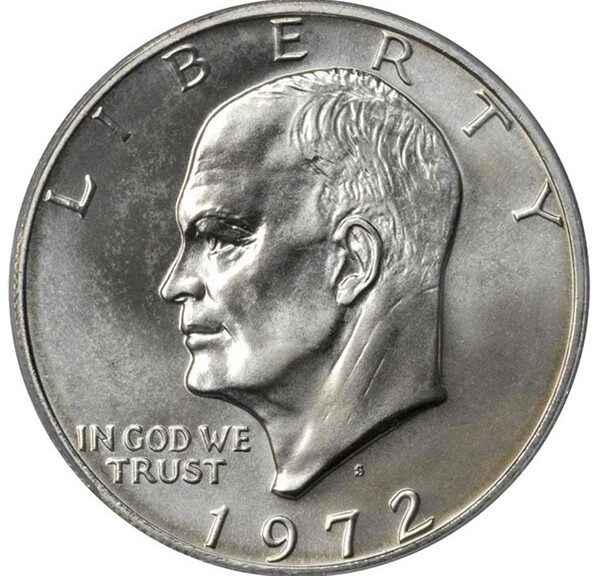
1972-S Eisenhower Dollar Uncirculated : A Collector’s Guide
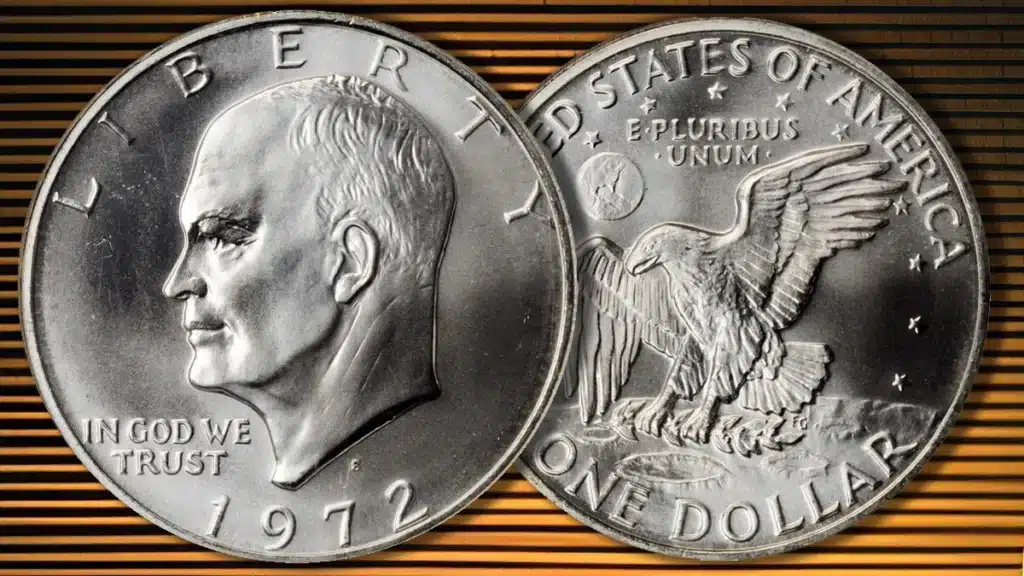
Changes were made to the 1972 Eisenhower Dollar in a Make or Break Year
A year after the initial buzz… and then thud… of the release of a new dollar coin, the United States Mint continued its work to refine and improve Frank Gasparro’s design. A number of subtle changes were undertaken by the Mint’s engraving department, including a mid-year change in the quality of die steel used to strike the hard copper-nickel clad circulating coins.
That there was little demand for the large-format dollar did not dissuade the government from striking almost 170 million coins at the Denver and Philadelphia Mints. At Denver, coin production more-or-less went smoothly, while at Philadelphia, minor tweaks (and possibly die mixups) led to the creation of three major varieties, known by Ike collectors as 1972 Type I, Type II, and Type III dollars.
A second variant of the Eisenhower dollar was produced not for circulation but for collectors and was struck in a 40% silver-clad composition. Before 1965, all United States dimes, quarters, and half dollars were struck in a .900 fine silver composition. Dollar coins, not produced since 1935, would have also followed suit had production been ongoing. This changed with the passage of the Coinage Act of 1965, which removed silver entirely from dimes and quarters and reduced its fineness in the half dollar to 40%. The Act did one other thing as well. It prohibited the production of dollar coins until 1970, at which time Congress would reevaluate the need for such a coin.
The Silver-Clad Eisenhower Dollars Were Issued as a Compromise
The death of former President Dwight D. Eisenhower on March 28, 1969, gave dollar coin advocates a reason to support the release of a new coin, but a question remained regarding the continued use of the 40% silver composition. The Mint, for its part, was satisfied with removing silver entirely and assisted the Treasury in separating pre-64 silver issues from Federal holdings and melting down the obsolete coins. By the end of 1969, a majority of the silver dimes, quarters, and half dollars in circulation had been withdrawn by speculators, collectors, and the government.
A large faction in Congress supporting the production of a new dollar coin pushed for the Cu-Ni clad composition, but there were others, like Representative H.R. Gross of Iowa, who found the idea of a “scrap metal” dollar coin to be an insult to the memory of the former president. Gross’ opinions were shared by many in the Senate but stood in opposition to the prevailing sentiment of the House, which had coalesced around the cause of seeing to the complete removal of silver from American circulating coinage.
The compromise spelled out in the bill, signed into law by President Richard M. Nixon just before midnight on December 31, 1970, approved the striking of up to 150 million silver-clad dollars, drawing from Treasury stockpiles of silver for the coin’s production. These silver-clad coins would form the basis of the collector issues struck in Proof and Uncirculated formats at the San Francisco Assay Office.
The 1972-S Eisenhower Dollar Uncirculated Issue Corrected the Quality Control Issues of the Year Before
The 1971-S Uncirculated issue, as an earlier CoinWeek profile points out, was a quality-control disaster. And given the high price above face value that the Mint was charging for the coin, both the collecting community and the general public were not happy. The Mint explained these flaws by stating that the coins were produced in the same way as a regular coin would be struck for circulation, but that wasn’t entirely true. Many of the 1971-S coins looked milky, with improperly prepared planchets. Author Rob Ezerman also points out that many suffered post-strike damage due to the careless way in which the coins were shipped from San Francisco to Denver for packaging.
Whatever happened in 1971 to cause that issue to stand out among the poorest-quality Post-War issues the Mint had produced had been addressed by the time the 1972-S Uncirculated dollars went into production. As it stands, the 1972-S Eisenhower dollar (“Blue Pack“) Uncirculated coin is the 1881-S Morgan of the series – which is to say that, by a very great degree, the quality of this issue is unparalleled. It is significantly better than the 1971-S, marginally better than the 1974-S, and clearly better than the 1973-S.
How much is the 1972-S Eisenhower Dollar Uncirculated Coin Worth?
The 1972-S Eisenhower Dollar Uncirculated coin sells for a range of prices from $14 to $3,500. There are a great number of claims online that this date is worth up to $10,000, but that simply isn’t true.
To understand why a coin that is readily available on sites like eBay for $14-$20 could sell for thousands of dollars, you have to understand the market for certified coins. A certified coin is a coin that has been authenticated, graded, and encapsulated by an industry-accepted third party grading service. The coin hobby in the United States recognizes three major companies: CAC, NGC, and PCGS. CAC is a newcomer to the encapsulation business, but their CAC-approved green oval stickers have created a major market for premium quality coins over the course of the past 15 years. NGC and PCGS have graded far more coins, however, and most of the certified 1972-S Eisenhower dollars that appear on the market has been graded by one of these two services.
From a quality standpoint, the 1972-S Eisenhower dollar uncirculated coin is a much higher quality release than the 1971-S. Certified populations at PCGS and NGC bear out the story of how the 1972-S is a far superior-quality coin. With nearly 25,000 submissions, the typical 1972-S certified by PCGS grades either MS-66 or MS-67, with 3,215 earning MS-68. Today, the PCGS MS-69 certified population stands at 34 pieces, an 19-coin increase from where this top-pop grade sat a little over a decade ago.
At NGC, certified populations follow a similar trajectory, although NGC pops are significantly lower due to lower submission volume. The overwhelming majority of all coins submitted to NGC (5,418) grade either MS-66 or MS-67. 645 earn NGC’s MS-68 grade, while just 15 have been put into MS-69 holders.
CAC has to date graded but three 1972-S Eisenhower Dollar uncirculated coins at their new Virginia Beach grading center, but have applied the CAC approval sticker on 191 coins at the MS68 level. These coins traditionally sell for a premium over coins without the sticker in the same grade.
The highest price paid for a 1972-S Eisenhower dollar at auction is $3,680 USD, paid for a superior quality example offered at an April 2011 Heritage sale. A few have sold for slightly higher figures in private sales carried out between 2014 and 2016. With the rising population, the price for a top pop 1972-S Eisenhower dollar has softened somewhat, but we feel that the coin is stable at $2,600.
At more affordable price points, collectors have a decision to make.
In grades MS-67 and below, a certified Eisenhower dollar is simply a typical Blue Pack example housed in a trackable certified holder. Given the unstable nature of the original government packaging, there is a clear benefit to paying a small premium for a specimen in an inert holder. But given the fact that the packaging is the only thing that separates a certified coin from a typical example at this grade, the upside long-term is limited. We advise this grade only for collectors with serious budgetary constraints, or for those simply looking to build a typeset on a budget. For Eisenhower dollar Set Registry collectors, a better alternative is MS-68 or MS-68+. MS-68 examples routinely sell for about $100. Don’t be afraid to pay a slight premium for one that is particularly nice – especially one with CAC approval.
Prices for MS-68+ examples have come down as the population in this grade has approached the total of all coins graded MS-69. Here, you can have a coin that is for all intents and purposes on par with MS69 examples but for a deep discount. $500 seems to be the going rate, but a serious specialist would pay $1,000 – $1,500 for a superior example that would likely (one day) upgrade to MS-69.
Design
Obverse
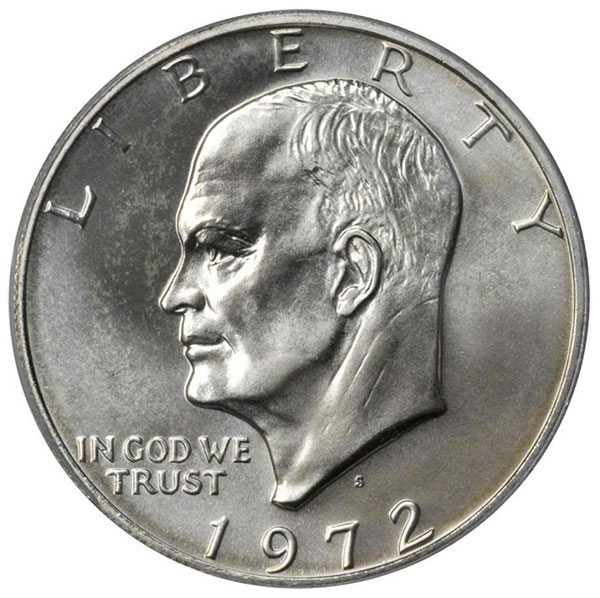 Gasparro’s portrait of Dwight D. Eisenhower (as President); Eisenhower facing to the left. Gasparro’s initials FG appear raised in the bust truncation. Beneath Eisenhower’s chin, to the left, is the motto IN GOD WE TRUST. LIBERTY wraps around the top of the coin in the space between the rim and the top of Eisenhower’s head. The date wraps around the bottom of the design, between the rim and the bottom of Eisenhower’s bust truncation. While Philadelphia-struck pieces bear no mintmark, coins struck at Denver and San Francisco will bear small mintmarks of “D” or “S” above the space between the last two digits of the date and below Eisenhower’s neck. On Eisenhower dollars, mintmarks were hand-punched and may vary in exact location and orientation.
Gasparro’s portrait of Dwight D. Eisenhower (as President); Eisenhower facing to the left. Gasparro’s initials FG appear raised in the bust truncation. Beneath Eisenhower’s chin, to the left, is the motto IN GOD WE TRUST. LIBERTY wraps around the top of the coin in the space between the rim and the top of Eisenhower’s head. The date wraps around the bottom of the design, between the rim and the bottom of Eisenhower’s bust truncation. While Philadelphia-struck pieces bear no mintmark, coins struck at Denver and San Francisco will bear small mintmarks of “D” or “S” above the space between the last two digits of the date and below Eisenhower’s neck. On Eisenhower dollars, mintmarks were hand-punched and may vary in exact location and orientation.
Reverse
The reverse is based on astronaut Michael Collins’ Apollo 11 Mission Patch design.
In the center, a bald eagle in descent. In its talons, an olive branch. Its left-wing is raised. The lunar surface lies below. Above the eagle’s head is a depiction of the Earth. North America is prominently visible. Wrapping around the top of the coin adjacent to the rim is the legend “UNITED STATES OF AMERICA.” Thirteen small five-point stars circle around the eagle. Below the ring of stars but above the eagle is the motto “E PLURIBUS UNUM”. Wrapping around the bottom of the design is the denomination “ONE DOLLAR”.
Edge
The edge of the 1972-S Eisenhower dollar is reeded.
Designer
Frank Gasparro was a friend to numismatists and served as Chief Engraver of the United States Mint from 1965 to 1981 (View Designer’s Profile).
Coin Specifications
| Country: | United States |
| Year Of Issue: | 1972 |
| Denomination: | One Dollar (USD) |
| Mint Mark: | S (San Francisco) |
| Mintage: | 2,1933,056 (incl. 22,000 struck in 1973) |
| Alloy: | Outer layer: .800 silver and .200 copper; Inner layer: .791 copper and .209 silver; ASW: .3161 oz. |
| Weight: | 24.59 g |
| Diameter: | 38.1 mm |
| Edge: | Reeded |
| OBV Designer | Frank Gasparro |
| REV Designer | Frank Gasparro | Michael Collins |
| Quality: | Uncirculated |
The post 1972-S Eisenhower Dollar Uncirculated : A Collector’s Guide appeared first on CoinWeek: Rare Coin, Currency, and Bullion News for Collectors.
1873 : The Year That Changed the United States Mint
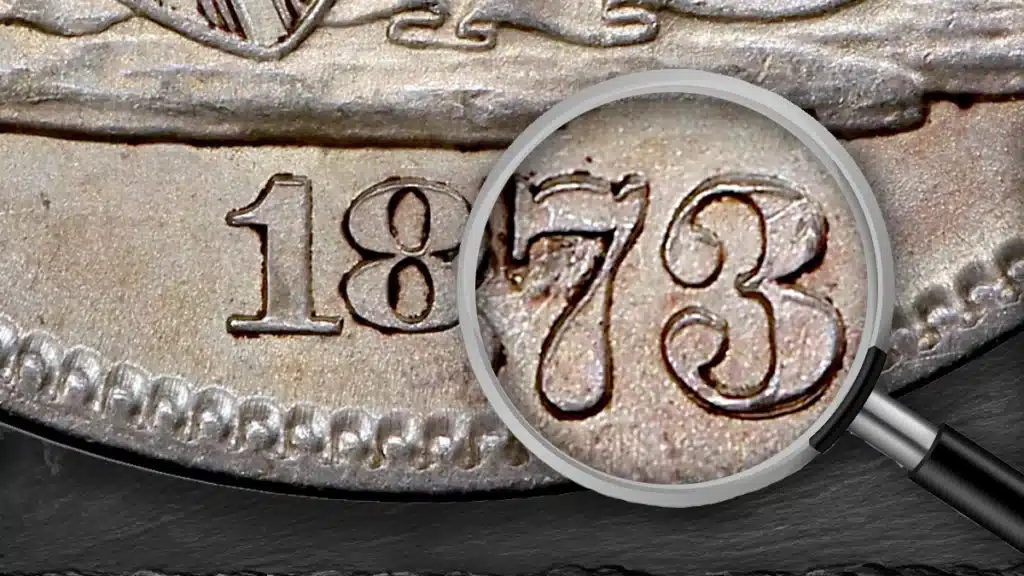
By Roger W. Burdette, special to CoinWeek …..
1873 was an interesting year for the United States Mint. The most important event was the passage and implementation of the Coinage Act of 1873. This new law revised the position of our coin manufacturing department, placing it directly under the control of the Treasury Department. It also changed the Mint Bureau’s internal organization, from one controlled by a director at the Philadelphia Mint managing several subsidiary branch mints to a director located in Washington, D.C. at Treasury headquarters. All mints became independent facilities managed by a superintendent reporting to the Secretary of the Treasury, thereby removing the Philadelphia facility’s unique authority. The concept of “branch mints” was eliminated – at least in law.
James Pollock, Mint Director at Philadelphia under the old law, remained there as Superintendent, and Henry R. Linderman, Pollock’s predecessor, was appointed Director of the Mint Bureau (the United States Mint). Both men had considerable experience in running the facilities, but Linderman also had an international reputation in economics and was the preferred person for the new job.
The same Mint Act also eliminated the position of Mint Treasurer, replacing it with a Cashier, and moved certain department heads, such as Melting and Refining, from presidential appointment to normal administrative positions.
Circulating coinage was simplified by the elimination of the standard silver dollar, the half dime, the three-cent silver piece, and the two-cent bronze piece. A new dollar denomination silver coin, intended only for export, called the “Trade Dollar”, was authorized as a means of competing with the Mexican eight reales in Asian markets and providing a market for domestic silver.
Another change brought about by the new law was a slight increase in subsidiary silver coin weights to align them with French silver coins.

This made two heavier half dollars exactly equal to one French five-franc coin weighing 25 grams. To identify heavier coins, the engraver at the Philadelphia branch of the United States Mint added arrowheads on either side of the date beginning with coins struck on and after April 1, 1873. Varieties are known with large and small arrowheads.

Although new coin weights were nominally within tolerance for the old coins, new weights for balances had to be prepared so that adjusters could separate planchets based on the new law. A telegram from Henry R. Linderman, Director Designate, to Pollock at Philadelphia said:
Please forward immediately via overland express dies for new silver coinage to San Francisco and Carson, and at your earliest convenience [the] necessary weights for adjustment of same[1].
But during the three months before the new law became active, the Mint had to produce coins for circulation and Proof sets for collectors. Annual coinage began with date punches from a slightly modified set as used in 1872 and for several previous years. We don’t have specific information about the person who prepared these, but it might have been former Mint Assistant Engraver Anthony Paquet or a digit and letter specialist in Philadelphia or New York.
Below is a comparison of the digits “187” from 1872 and the first issues of 1873.

Other than possibly being spaced a little too closely together, “187” seems satisfactory and consistent with the previous year’s dates. However, if we view the full 1873 date, a problem becomes evident. The numeral “3” has large ball serifs or knobs, which gave it an appearance easily confused with the numeral “8”.

This was particularly troublesome for those with poor eyesight concerning the legibility of small-size coins such as cents, three and five-cent nickels, dimes, gold dollars, quarter eagles, and three-dollar pieces. Chief Coiner A. Loudon Snowden of the Philadelphia Mint was concerned about date legibility and wrote to Pollock in January.
Dear Sir:
I desire in a formal manner to direct your attention to the “figures” used in dating the dies for the present year.
They are so heavy, and the space between each so very small that upon the smaller gold and silver, and upon the base coins, it is almost impossible to distinguish with the naked eye, whether the last figure is an eight or a three.
In our ordinary coinage many of the pieces are not brought fully up, and upon such it is impossible to distinguish what is the last figure of this year’s date.
I do not think it creditable to the institution that the coinage of the year should be issued bearing this defect in the date.
I would recommend that an entire new set of figures, avoiding the defects of those in use, be prepared at the earliest possible day[2].
We don’t have Pollock’s reply, but it seems that Engraver William Barber, or more likely assistant William Key, set to work preparing new punches only for the digit “3”[3].
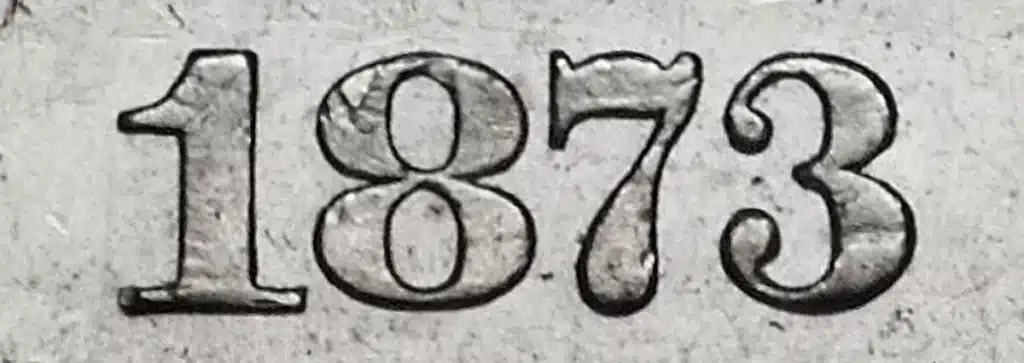
A comparison indicates the ball serifs were cut down in size without changing the digit’s body or general outline. For reasons that are unclear at present but possibly related to production quotas, dates with an open 3 were put into use on dimes, quarters, and half dollars before the introduction of arrowheads denoting the weight change on April 1. This resulted in all three subsidiary silver denominations existing in open 3 versions with and without arrowheads.
This table displays all denominations and mintage estimates produced at the Philadelphia Mint for 1873. At the beginning of 1873, all had a close 3 in the date, and those remaining in production after April 1. Gray boxes indicate no coins made.
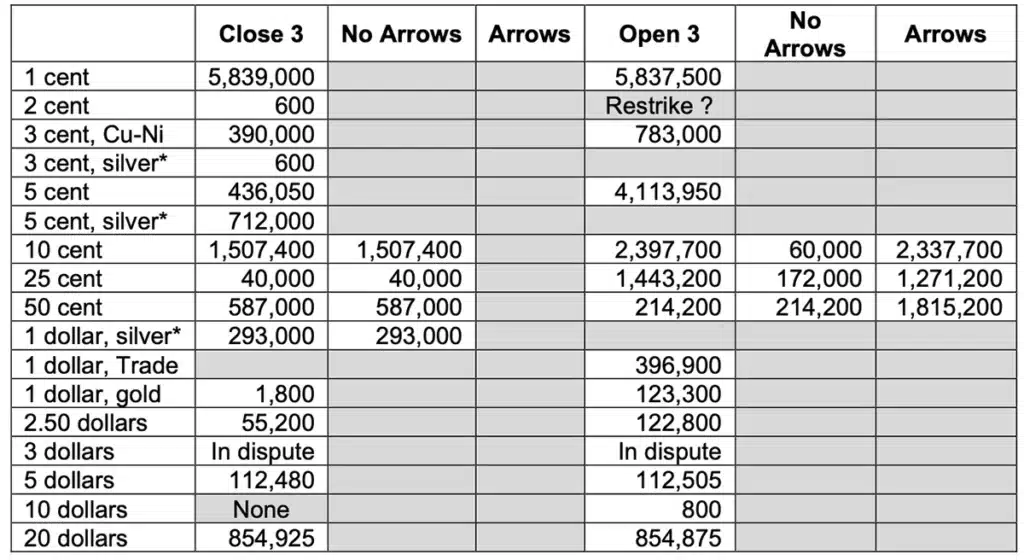
Three variations of the 1873 date (below) were produced through at least April 1, 1873. The San Francisco and Carson City, Nevada branches of the United States Mint also struck similar combinations but in much smaller quantities.
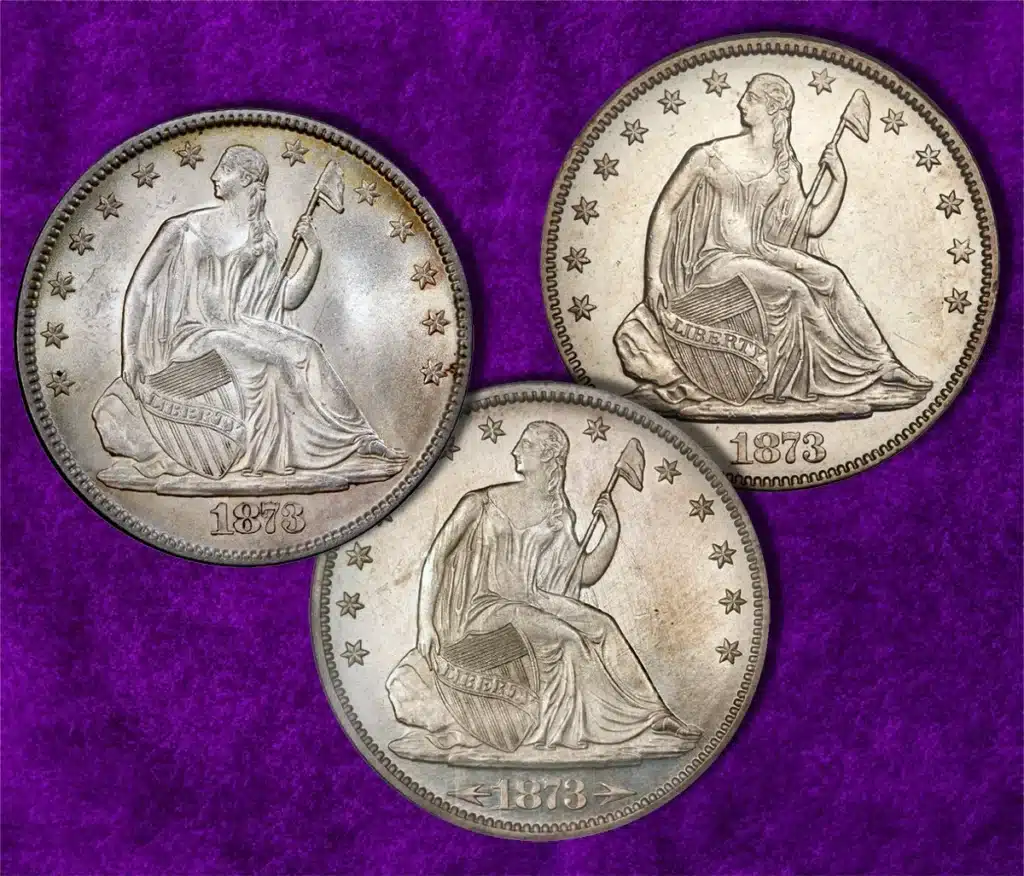
During research for this column, the author attempted to determine if open 3, no arrowhead silver coins followed the old weight standard. Unfortunately, most high-grade specimens seem to be locked in plastic slabs, making their weights inaccessible. Further, old records from ANACS when it was owned by the American Numismatic Association, which might have included these data, seem to be lost[4].
Except for adding arrowheads next to the date, close and open 3s are possibly the most distinctive features of 1873 coinage, and are responsible for more date versions than in any other series of coins produced by the United States Mint.
* * *
Notes
[1] RG104 E-1 Box 91. Telegram dated March 21, 1873 to Pollock from Linderman.
[2] RG104 E-1 Box 91. Letter dated January 18, 1873 to Pollock from Snowden.
[3] Assistant Key was relegated to preparing ornamental wreaths, lettering master dies, and preparing logo punches. He prepared single punches for the motto IN GOD WE TRUST used on George T. Morgan’s half dollar and dollar patterns, and similar work for William Barber’s patterns in 1877-78.
[4] Numismatist Tom DeLorey, writing in a message dated September 16, 2023, comments: “The early ANACS submission forms included very accurate weights partly for identification purposes, but those records are lost.” PCGS Coin Forum, thread titled “Does anybody have Precise Weights of 1873 No Arrows Silver Dimes, Quarters and Halves?” Mr. DeLorey and Dan Owens also examined the situation of 700 silver dollars reported delivered by the San Francisco Mint in 1783. Their conclusion was that the coins had been struck and dated in 1872 and merely delivered the next calendar year. Also, any 1873-S silver dollars would have used the same 1872-style numerals as seen in Philadelphia silver dollars. See: “Not a Ghost of a Chance,” The Numismatist. July 2019. Pages 30-41.
* * *
The post 1873 : The Year That Changed the United States Mint appeared first on CoinWeek: Rare Coin, Currency, and Bullion News for Collectors.
Gold Reaches 3-Week High, Surpasses $2,000/oz
Prices for precious metals increased on Tuesday, with platinum and palladium rising for the second time this week, while gold and silver rebounded from the losses of the prior session, achieving their first gains in three sessions
Heritage’s Nov. 16-19 US Coins Auction Tops $10.5 Million
A 1794 Flowing Hair Dollar B-1, BB-1, R
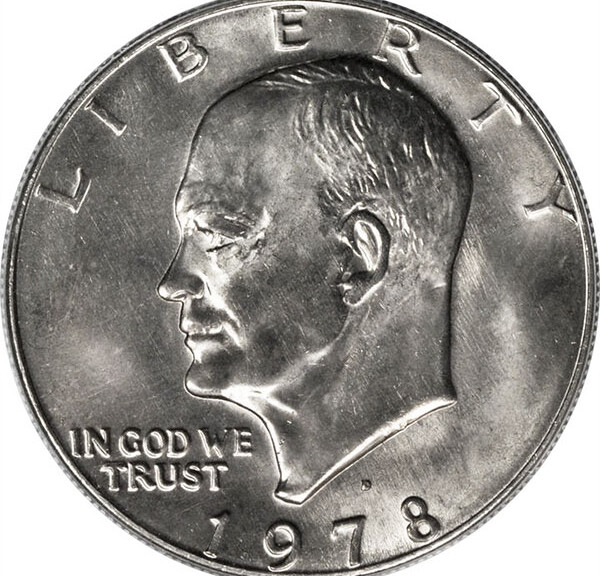
1978-D Eisenhower Dollar : A Collector’s Guide

The End of the Era of the Large Dollar Coin
The era of the big dollar coin was already coming to a close when the United States Mint struck the last 59,000,000 Eisenhower dollar coins for circulation at the Denver and Philadelphia Mints. Denver had the honor of striking slightly more, and as had been the case through the entire series, struck them better than the coin operators at the mother mint.
The copper-nickel clad large dollar came into existence in 1971 as a memorial to the recently passed and beloved war-hero-turned President Dwight D. Eisenhower. As Americans faced the daily horrors that played out on the nightly news reporting from Vietnam, the sentiment to honor one of America’s last great war heroes overrode all other concerns and another dollar coin was born.
Throughout the series’ eight-year run, production of the coin swung from as high as 113 million to as low as 1.76 million. The high came during the American Bicentennial year of 1976 at the Philadelphia Mint. The low came from the 1973 emission, where coins were struck for the annual Mint Set (although at least one bag of 1973 coins has been reported as having been released into the wild).
The 1978-D’s mintage of 33,102,890 coins puts the issue as the fourth-highest Denver mintage of the series. It is by all accounts a typical issue from this late-modern-era U.S. coin series.
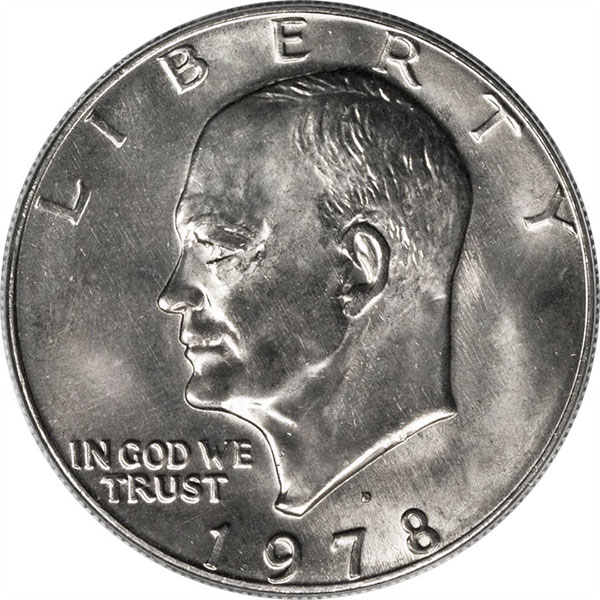
The 1978-D Eisenhower Dollar
The year 1978 saw the Eisenhower dollar, short-lived though it was, come to a close. On October 10, President Jimmy Carter signed into law legislation authorizing the production of a new smaller dollar coin measuring 26.5mm and weighing 8.1 grams made of the same Cu-Ni clad composition that had been put into use for dimes and quarters since 1965 and was used for the larger circulating Eisenhower dollar coins. Production of the new smaller dollar coin began on December 13, 1978.
Before this transition to a new smaller dollar coin got underway, however, the Philadelphia, Denver, and San Francisco Mints struck the Eisenhower dollar for one final year. The Philadelphia and Denver Mints struck Cu-Ni clad versions for circulation, while the San Francisco branch struck Cu-Ni clad Proofs. The Denver Mint’s output of 33,012,890 pieces was the highest mintage for the year and represents an end of an era for the Denver Mint’s production of the circulating large-format dollar coin.
How Much are 1978-D Eisenhower Dollars Worth?
The Eisenhower dollar is popularly collected two ways: as a raw coin and as a certified coin with an assigned grade from a major grading service such as PCGS or NGC. Raw coins come from circulation or from the Mint’s annual Uncirculated coin set. Given the ready availability of Uncirculated examples, coins that have shown wear from use or exhibit any atypical flaws or distracting features are not considered desirable and can be safely spent at face value.
Uncirculated examples, either from bags, rolls, or Mint Sets, carry a premium of about four to 10 times face value based on the typical price of completed transactions on eBay. A numismatist that is extremely knowledgeable about the market with professional-level grading skills may pay more for a premium raw coin because they intend to have the coin certified. Even a great coin with the potential to earn a high grade will sell for a discount if sold raw, except in extraordinary circumstances.
In Mint State 65, the 1978-D carries a price of about $18 according to CoinWeek IQ’s current market analytics. This low price does not reflect the difficulty in cherrypicking Gem-quality Eisenhower dollars of this issue in the wild. Mint Set coins tend to have the best strikes, but this is a trend and not a rule. A large quantity of 1978-D dollars were found among the 223,000 coin Eisenhower dollar hoard marketed by Littleton Coin Company in 2011 and dubbed “The Big Sky Hoard” because it was discovered in a Montana bank vault.
In MS66, the 1978-D sells for about $100, but can, from time to time, sell on eBay for $65-$75 if the seller does not employ professional listing or photography practices. Curiously, a batch of four CAC-approved 1978-D Eisenhower dollars sold in October 2020 at Heritage for $200-$400 each. We do not believe that the date is worth $200-$400, even with CAC approval.
Denver Mint coins were struck better than those struck at Philadelphia and finding Gem-quality 1978-D Ike dollars with nice eye appeal is not so difficult as to assert such a premium… at least not at MS66. Advancing to MS67 is another story. In MS67, PCGS boasts a certified population of just four examples, the last one selling in 2017 for $7,050. That example was not the finest of the then four known, based on our observation of coins in the finest Eisenhower dollar registry sets. Today, PCGS reports nine examples at this grade and in January 2022, a sale of a lightly toned example graded MS67 was reported on eBay at a record price of $8,750.
CAC has so far graded 58 coins, none finer than MS66, but it has stickered four coins at the MS67 level. NGC reports 21 coins at MS67.
Design
Obverse:
Frank Gasparro’s portrait of Dwight D. Eisenhower (as President); Eisenhower facing to the left. Gasparro’s initials “FG” appear raised in the bust truncation. Beneath Eisenhower’s chin, to the left, is the motto “IN GOD WE TRUST” LIBERTY wraps around the top of the coin in the space between the rim and the top of Eisenhower’s head. The date wraps around the bottom of the design, between the rim and the bottom of Eisenhower’s bust truncation. While Philadelphia-struck pieces bear no mintmark, coins struck at Denver and San Francisco will bear small mintmarks of “D” or “S” above the space between the last two digits of the date. On Eisenhower dollars, mintmarks were hand-punched and may vary in exact location and orientation.
Reverse:
 The reverse is based on Michael Collins’ Apollo 11 Mission Patch design.
The reverse is based on Michael Collins’ Apollo 11 Mission Patch design.
In the center, a bald eagle in descent. In its talons, an olive branch. Its left wing is raised. The lunar surface lies below. Above the eagle’s head is a depiction of the Earth. North America is prominently visible. Wrapping around the top of the coin adjacent to the rim is the legend “UNITED STATES OF AMERICA.” Thirteen small five-point stars circle around the eagle. Below the ring of stars but above the eagle is the motto “E PLURIBUS UNUM”. Wrapping around the bottom of the design is the denomination “ONE DOLLAR”.
Edge:
The edge of the 1978-D Eisenhower dollar is reeded.
Designer
Frank Gasparro was a friend to numismatists and served as Chief Engraver of the United States Mint from 1965 to 1981 (View Designer’s Profile).
Coin Specifications
| Country: | United States |
| Year Of Issue: | 1978 |
| Denomination: | One Dollar (USD) |
| Mint Mark: | None (Philadelphia) |
| Mintage: | 25,702,000 |
| Alloy: | Copper-Nickel (Cu-Ni) |
| Weight: | 22.68 g |
| Diameter: | 38.1 mm |
| OBV Designer | Frank Gasparro |
| REV Designer | Frank Gasparro | Michael Collins |
| Quality: | Uncirculated |
The post 1978-D Eisenhower Dollar : A Collector’s Guide appeared first on CoinWeek: Rare Coin, Currency, and Bullion News for Collectors.
Stack’s Bowers to Offer the Russian Coins of Historic Rothschild-Piatigorsky Collection
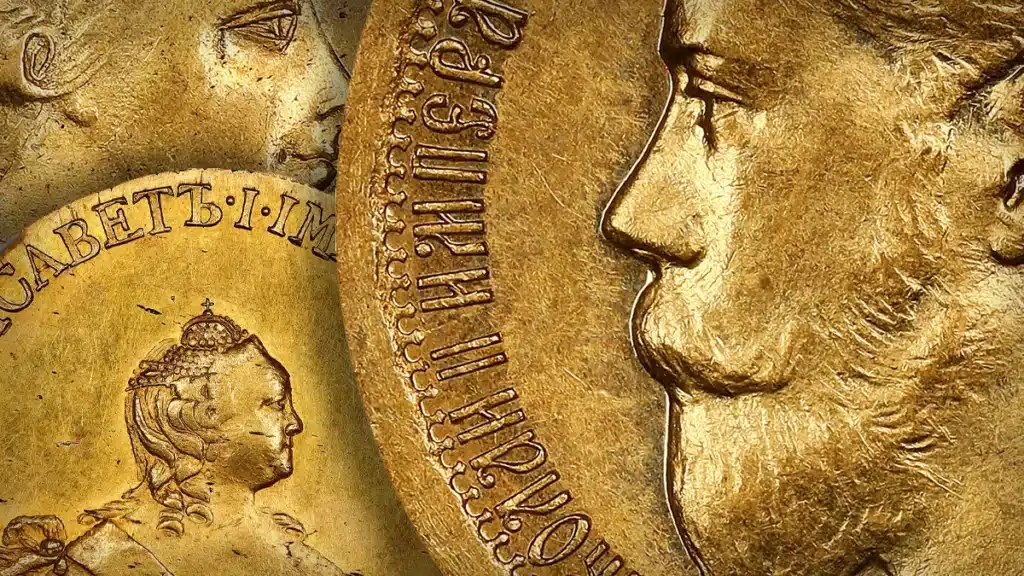
An important selection of russian coin rarities will be offered by Stack’s Bowers Galleries at their upcoming 2024 New York International Numismatic Convention (NYINC) auction. Assembled almost one hundred years ago, the private Rothschild-Piatigorsky Collection belonged to famed cellist Gregor Piatigorsky and his heiress wife, the Baroness Jacqueline de Rothschild. After escaping the Bolsheviks as a child (though he was already a top professional musician), Piatigorsky became first chair cellist with the Berlin Philharmonic by the age of 18, touring Europe with the orchestra throughout the 1920s. In his mid-twenties, Piatigorsky married de Rothschild in 1937 and started a family in Paris, but they soon had to flee the country because of the threat of the Nazis. Eventually, the family would move to California.
Alongside the couple’s vast collection is a checklist featuring the stamps of Art Trading Co.–one of the main sources of material in the collection–and several Russian rulers from Peter “the Great” to Nicholas II handwritten in Russian. Some of the exceptional highlights of the collection include a 10 Rubles Novodel of Elizabeth; both a 10 Rubles and a 5 Rubles from the short reign of Peter III; a 5 Rubles of Paul; a 25 Rubles of Alexander II (one of just 100 struck); and a 37-1/2 Rubles and an Imperial (a 10 Rubles Pattern) of Nicholas II.

The bill of sale for the 25 Rubles of Alexander II still exists. Made out to “Madame Piatigorski” on April 22, 1939, it points out the great rarity of the coin, as well as its obverse and reverse designs. Bought by Baroness de Rothschild for the sum of $306, this important piece of Russian numismatics has an auction estimate 500 times that amount—and even that may prove too low. In addition, family legend suggests that the gold used to strike this special emission of 25 Rubles was supplied to the Russian government by the Rothschild family itself. While Stack’s Bowers has been unable to verify that claim, there was a definite connection between the French banking sector (which the Rothschild family dominated) and the Imperial Russian court during the late 19th century. Even the 37-1/2 Rubles owes its fascinating denomination to the fact that this would allow it to be traded on par with the French 100 Francs.
The Russian coins of the Rothschild-Piatigorsky Collection will be a significant part of the Stack’s Bowers Galleries Official Auction at the New York International Numismatic Convention in January 2024. All lots in the auction will be available for viewing and pre-sale bidding in December at StacksBowers.com.
* * *
The post Stack’s Bowers to Offer the Russian Coins of Historic Rothschild-Piatigorsky Collection appeared first on CoinWeek: Rare Coin, Currency, and Bullion News for Collectors.
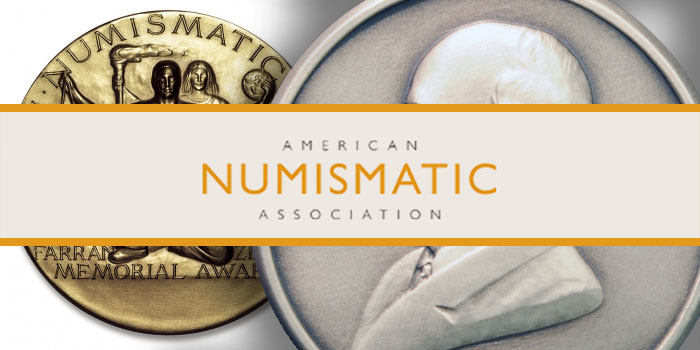
ANA Now Accepting Nominations for 2024 Awards

The American Numismatic Association (ANA) presents annual awards to individuals deserving of recognition for their dedication to the con collecting hobby and numismatics. In addition to the club’s 2024 awards, the ANA is also accepting nominations for “Historic Era” Numismatic Hall of Fame candidates.
Nominations can be submitted in writing or online. Please make your nominations at least 300 words long for the Numismatic Hall of Fame, and 50 to 100 words for the 2024 club awards. Please include the date of submission, the nominee’s name, any background information, and the nominee’s birth date (if known). The ANA will be accepting nominations through January 15, 2024.
The following are descriptions of the awards categories as given by the ANA:
- Numismatic Hall of Fame – “Historic Era” nominees (individuals deceased more than 25 years prior to induction) will be considered. Candidates are not required to be past ANA members.
- Chester L. Krause Memorial Distinguished Service Award – The ANA’s highest honor, this award recognizes years of outstanding, dedicated service to numismatics.
- Lifetime Achievement Award – Presented to an individual, family, firm or judicial entity for contributions to organized numismatics. Nominees need not be ANA members.
- Numismatist of the Year – Recognizes individuals within the numismatic community who have demonstrated long-term leadership in the field and to the ANA. Nominees need not be ANA members.
- Elvira Clain-Stefanelli Memorial Award for Achievement in Numismatics – This award honors women who have significantly influenced numismatics, particularly in the areas of scholarship, leadership and/or mentorship. Nominees must be living but need not be ANA members or currently active in numismatics.
- Harry J. Forman Dealer of the Year Award – Honors professional numismatists who exhibit uncommon dedication to strengthening the hobby and the ANA, and display exemplary ethical standards as a numismatic dealer.
- Numismatic Art Award for Excellence in Medallic Sculpture – The award honors an artist whose cumulative lifetime achievements in the field of medallic sculpture have been of the highest order.
- Medal of Merit – This award recognizes collectors and hobbyists at the regional and/or national level. Nominees dedicate their efforts to promoting numismatics among the general public, and directly support the ANA’s mission and programs.
- Adna G. Wilde Jr. Memorial Award for Exemplary Service – Recognizes collectors and hobbyists who are active at the regional and/or national level and work to advance numismatic knowledge among the general public.
- Glenn Smedley Memorial Award – Recognizes collectors and hobbyists active at the grassroots level.
- Lawrence J. Gentile, Sr. Memorial Award for Outstanding Adult Advisor – Recognizes individuals who have devoted their time and efforts to recruiting young numismatists new to the hobby, and aiding the development of intermediate to advanced YNs.
- Young Numismatist of the Year – Honors numismatists under the age of 18 for outstanding contributions to the hobby and who are active in volunteer service and numismatic research.
- Outstanding District Representative – Recognizes the District Representative who most fully promotes coin collecting, coin clubs and the ANA.
Online submission forms are available at money.org/service-award-categories.
For more informtion about the 2024 ANA awards, email awards@money.org, call (719) 482-9811, or visit their website at www.money.org.
* * *
The post ANA Now Accepting Nominations for 2024 Awards appeared first on CoinWeek: Rare Coin, Currency, and Bullion News for Collectors.
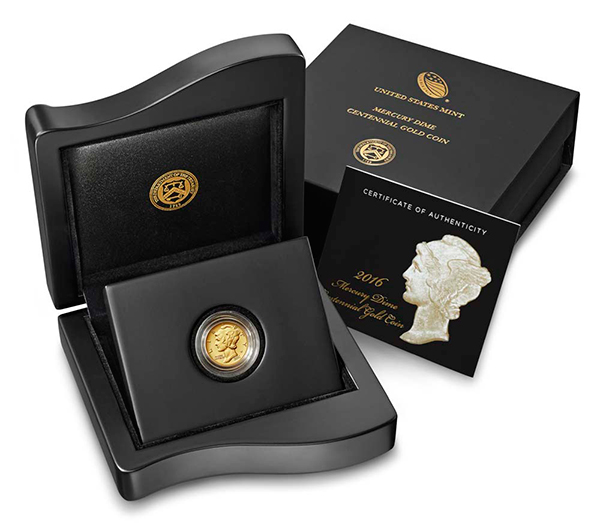
2016-W Mercury Dime Centennial Gold Coin : A Collector’s Guide
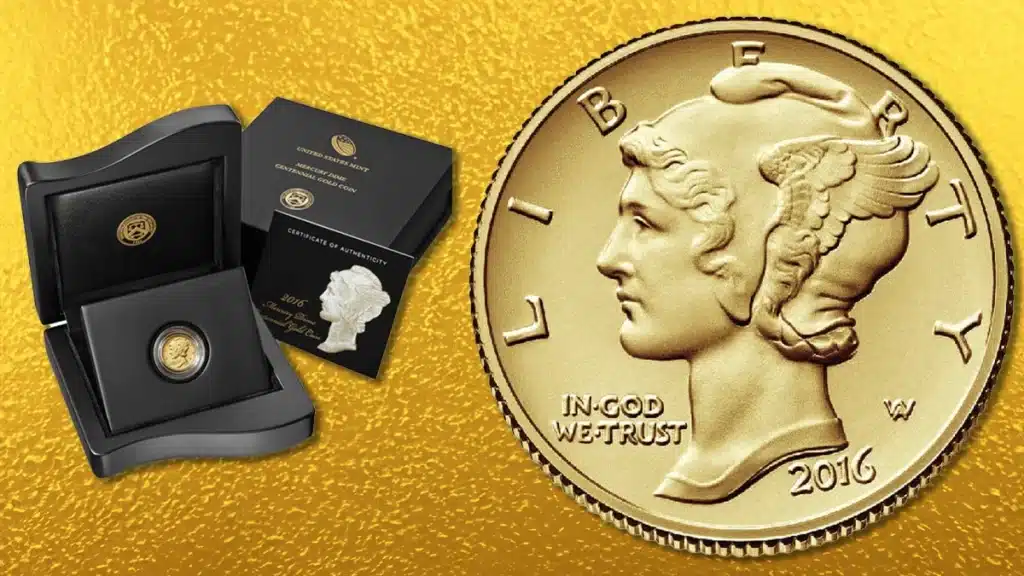
What Is the 2016-W Mercury Dime Centennial Gold Coin?
In 1916, Americans were introduced to three iconic U.S. coin designs: the Mercury or Winged Liberty dime, the Walking Liberty half dollar, and the Standing Liberty quarter. To mark the centennial of the release of these three coins, the United States Mint issued new versions of each in 24-karat (.9999 fine) gold struck at the West Point Mint. Each coin was reworked using state-of-the-art digital design tools and features the date “2016” on the obverse. The reverse of each centennial coin also denotes the coin’s weight and composition.
The 2016-W Mercury Dime Centennial gold coin was released on April 21, 2016. It was struck in an Uncirculated finish so as to resemble the 1916 dime. Its diameter (16.50 mm) is close to that of a regular Mercury dime (17.90 mm) despite containing one-tenth of an ounce of gold – a symbolic nod to the dime’s 10-cent denomination.
Besides describing some of the differences between the new coin and the original, the following video provides a 4K hands-on experience with a “perfect” example certified by NGC as SP70.
A Brief History of the Mercury (Winged Liberty) Dime
The original Winged Liberty dime entered circulation at the end of October 1916 and remained in production for nearly 30 years. Alongside the Walking Liberty half dollar and Standing Liberty quarter, it joined the Indian Head (Buffalo) nickel, the Lincoln cent, the Indian $2.50 quarter eagle and $5 half eagle gold coins, and the Saint-Gaudens $10 eagle and $20 double eagle gold coins in circulation.
It was truly a golden age of U.S. coin design.
Adolph Weinman’s elegant design for the Mercury dime drew heavily from the French Beaux Arts movement of the late 19th century. Its release immediately preceded the Roosevelt dime (1946-Present), and it was the last U.S. dime to be struck entirely in .900 silver.
Heralded for its beauty, the Winged Liberty dime–often referred to as the Mercury dime due to its classically inspired headgear–saw the country through both World Wars and the Great Depression. Its unmistakable design was attached to both the March of Dimes anti-polio campaign and countless Charles Atlas advertisements found in the back of comic books and magazines. When “Yip” Harburg wrote the song “Brother, Can You Spare a Dime?”, it was the Mercury dime he was talking about.
The dime’s use in circulation carried on without incident. The design didn’t have the striking problems of the Buffalo nickel or the Walking Liberty half. Although specialists might seek out perfectly struck examples with Full Split Bands on the reverse (scarce for some issues), the Mercury dime is remembered as an elegant and practical coin; a successful coin that served its purpose and elevated the image of American money.
The Mercury dime’s term of service came to an unexpected end when, on April 12, 1945, President Franklin Delano Roosevelt died. Frail and aged beyond his 63 years, Roosevelt suffered a massive cerebral hemorrhage while on vacation in Georgia. His death reverberated throughout America and the world.
Almost immediately, a movement began to honor Roosevelt on a circulating coin. The dime was the obvious choice as the denomination recalled both Franklin’s battle with polio and his work with the March of Dimes, and on May 17, Treasury Secretary Henry Morgenthau, Jr. announced that the Winged Liberty design would be replaced by a new design featuring the portrait of the late president.
So with that, the stellar 30-year run of the Winged Liberty or Mercury Head dime came to an end. Steadily, the coins in circulation wore down, Mint State examples were hoarded, rare dates and varieties were cherrypicked, and by the time silver coins exited the scene in the mid to late 1960s, only the most worn examples continued to circulate.

Release, Sellout, and Re-Release of the 2016-W Mercury Dime Centennial Gold Coin
As stated earlier, the 2016-W Mercury Dime gold coin was released on April 21, 2016. Priced at $205 USD according to the Mint’s pricing schedule for gold and platinum products at the time, it had a mintage limit of 125,000 pieces and an initial order limit of 10 coins per household. Each piece was sealed in a circular capsule and came with an elegant, custom-designed black-matte hardwood presentation case and a Certificate of Authenticity.
Within 15 minutes of the coin’s noon Eastern Time release on the Mint’s website, the order status had already been changed to “Backorder”. Less than an hour after its release, the 2016-W Mercury Dime gold coin was listed as “Unavailable” by 12:45 PM. This meant that all available inventory had been allotted to fill customer orders and was not quite the same as a complete lack of the entire authorized mintage.
But like any other product, some of these orders were soon canceled, either by the Mint (payment failed to process, bad account information, etc.) or by customers themselves. According to CoinWeek’s news coverage, the Mint reported sales of 122,510 coins out of the 125,000 total mintage by Sunday, April 24. And after customers had time to receive their coins in the mail, returns began to come back. Because of these factors, the Mint still had 8,889 pieces by the middle of the year.
Frustratingly for collectors, however, the Mint did not make these available for purchase and had no set plans to do so. Adding to collector anxiety was the fact that the Mint’s pricing schedule was subject to change, and every additional week of delay meant that the price could be much higher than it was upon initial release (it could also have been lower, but that is beside the point).
It wasn’t until the end of the year that the U.S. Mint announced the resumption of sales of the 2016-W Mercury Dime Centennial gold coin on December 15. After being criticised for the original order limit of 10 per “household”–an arrangement that many felt favored dealers and bulk buyers at the expense of regular collectors–the Mint sold these final coins at one per household.
A final total mintage of 124,885 was eventually reported – 115 less than the maximum.
Certified Populations of the 2016-W Mercury Dime Centennial Gold Coin in Today’s Market
Since it began grading and authenticating U.S. coins in June 2023, CAC has yet to certify any 2016-W Mercury Dime gold coins.
Categorized as an Anniversary Coin, NGC reports a total of 27,709 certified grading events at the time of publication. The top pop grade of Specimen 70 (SP70) accounts for most of them, with 24,839 examples. Two thousand, eight hundred and fifty-five coins are listed as SP69, 11 are graded SP68, and three are reported at SP67. This kind of top-heavy certified population pyramid is seen with modern collector coin issues that are bought in bulk with the express purpose of grading and immediately reselling them – i.e., “flipping”.
The auction record for any 2016-W Mercury Dime Centennial gold coin is $2,000 for a specimen certified NGC Genuine that was sold in November 2019 on eBay.
As far as NGC-certified SP70s go, Stack’s Bowers sold an example for $384 in June 2023, but prices from 2022 average to about $400.
Prices for the same grade in 2021 average to around $350. And looking at auction records from 2020, when more NGC examples were sold than PCGS specimens, the average price for an NGC SP70 2016-W Mercury Dime gold coin is almost $320. Appreciation in the secondary market appears steady, with premiums gaining on $200 over the initial retail price – a doubling of value over seven years.
Also at the time of publication, PCGS has graded a total of 31,984 2016-W Mercury Dime gold coins. The vast majority of those coins–28,958–achieved a perfect grade of SP70. The numbers drop exponentially as we go down to “merely” Gem quality, with 3,001 reported at SP69, 22 listed at SP68, and two given for SP67. PCGS categorizes the gold Mercury dime, the gold Standing Liberty quarter, and the gold Walking Liberty half dollar as the 2016 Centennial Series.
PCGS-certified SP70 examples have tended to fare slightly better than those graded by NGC in recent public sales. Most of the gold Mercury Dimes sold in 2023 so far have been in PCGS holders, and those prices average to over $420. The year 2022 saw auction lots more evenly split between PCGS and NGC, and PCGS prices averaged to a little over $400. PCGS SP70 specimens sold for an average of $370 in 2021, and almost $340 the year prior. The pricing trend is almost identical to that of NGC-certified SP70s, with just a slight bump (~$20) in premium.
Design
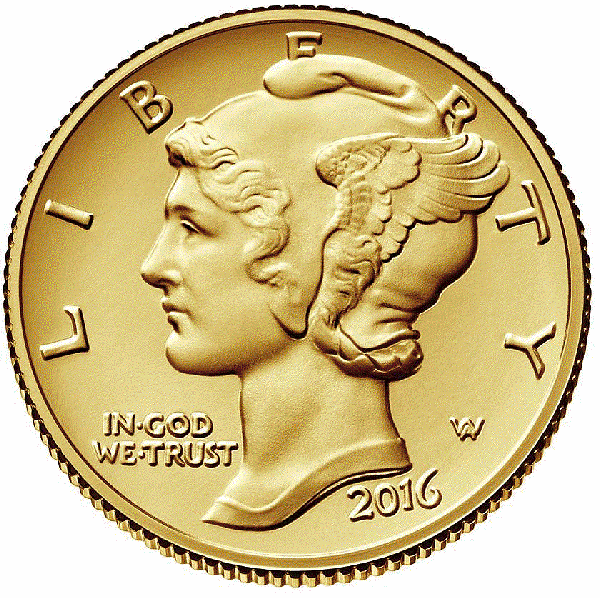
What Is the 2016-W Mercury Dime Centennial Gold Coin?
In 1916, Americans were introduced to three iconic U.S. coin designs: the Mercury or Winged Liberty dime, the Walking Liberty half dollar, and the Standing Liberty quarter. To mark the centennial of the release of these three coins, the United States Mint issued new versions of each in 24-karat (.9999 fine) gold struck at the West Point Mint. Each coin was reworked using state-of-the-art digital design tools and features the date “2016” on the obverse. The reverse of each centennial coin also denotes the coin’s weight and composition.
The 2016-W Mercury Dime Centennial gold coin was released on April 21, 2016. It was struck in an Uncirculated finish so as to resemble the 1916 dime. Its diameter (16.50 mm) is close to that of a regular Mercury dime (17.90 mm) despite containing one-tenth of an ounce of gold – a symbolic nod to the dime’s 10-cent denomination.
Besides describing some of the differences between the new coin and the original, the following video provides a 4K hands-on experience with a “perfect” example certified by NGC as SP70.
A Brief History of the Mercury (Winged Liberty) Dime
The original Winged Liberty dime entered circulation at the end of October 1916 and remained in production for nearly 30 years. Alongside the Walking Liberty half dollar and Standing Liberty quarter, it joined the Indian Head (Buffalo) nickel, the Lincoln cent, the Indian $2.50 quarter eagle and $5 half eagle gold coins, and the Saint-Gaudens $10 eagle and $20 double eagle gold coins in circulation.
It was truly a golden age of U.S. coin design.
Adolph Weinman’s elegant design for the Mercury dime drew heavily from the French Beaux Arts movement of the late 19th century. Its release immediately preceded the Roosevelt dime (1946-Present), and it was the last U.S. dime to be struck entirely in .900 silver.
Heralded for its beauty, the Winged Liberty dime–often referred to as the Mercury dime due to its classically inspired headgear–saw the country through both World Wars and the Great Depression. Its unmistakable design was attached to both the March of Dimes anti-polio campaign and countless Charles Atlas advertisements found in the back of comic books and magazines. When “Yip” Harburg wrote the song “Brother, Can You Spare a Dime?”, it was the Mercury dime he was talking about.
The dime’s use in circulation carried on without incident. The design didn’t have the striking problems of the Buffalo nickel or the Walking Liberty half. Although specialists might seek out perfectly struck examples with Full Split Bands on the reverse (scarce for some issues), the Mercury dime is remembered as an elegant and practical coin; a successful coin that served its purpose and elevated the image of American money.
The Mercury dime’s term of service came to an unexpected end when, on April 12, 1945, President Franklin Delano Roosevelt died. Frail and aged beyond his 63 years, Roosevelt suffered a massive cerebral hemorrhage while on vacation in Georgia. His death reverberated throughout America and the world.
Almost immediately, a movement began to honor Roosevelt on a circulating coin. The dime was the obvious choice as the denomination recalled both Franklin’s battle with polio and his work with the March of Dimes, and on May 17, Treasury Secretary Henry Morgenthau, Jr. announced that the Winged Liberty design would be replaced by a new design featuring the portrait of the late president.
So with that, the stellar 30-year run of the Winged Liberty or Mercury Head dime came to an end. Steadily, the coins in circulation wore down, Mint State examples were hoarded, rare dates and varieties were cherrypicked, and by the time silver coins exited the scene in the mid to late 1960s, only the most worn examples continued to circulate.

Release, Sellout, and Re-Release of the 2016-W Mercury Dime Centennial Gold Coin
As stated earlier, the 2016-W Mercury Dime gold coin was released on April 21, 2016. Priced at $205 USD according to the Mint’s pricing schedule for gold and platinum products at the time, it had a mintage limit of 125,000 pieces and an initial order limit of 10 coins per household. Each piece was sealed in a circular capsule and came with an elegant, custom-designed black-matte hardwood presentation case and a Certificate of Authenticity.
Within 15 minutes of the coin’s noon Eastern Time release on the Mint’s website, the order status had already been changed to “Backorder”. Less than an hour after its release, the 2016-W Mercury Dime gold coin was listed as “Unavailable” by 12:45 PM. This meant that all available inventory had been allotted to fill customer orders and was not quite the same as a complete lack of the entire authorized mintage.
But like any other product, some of these orders were soon canceled, either by the Mint (payment failed to process, bad account information, etc.) or by customers themselves. According to CoinWeek’s news coverage, the Mint reported sales of 122,510 coins out of the 125,000 total mintage by Sunday, April 24. And after customers had time to receive their coins in the mail, returns began to come back. Because of these factors, the Mint still had 8,889 pieces by the middle of the year.
Frustratingly for collectors, however, the Mint did not make these available for purchase and had no set plans to do so. Adding to collector anxiety was the fact that the Mint’s pricing schedule was subject to change, and every additional week of delay meant that the price could be much higher than it was upon initial release (it could also have been lower, but that is beside the point).
It wasn’t until the end of the year that the U.S. Mint announced the resumption of sales of the 2016-W Mercury Dime Centennial gold coin on December 15. After being criticised for the original order limit of 10 per “household”–an arrangement that many felt favored dealers and bulk buyers at the expense of regular collectors–the Mint sold these final coins at one per household.
A final total mintage of 124,885 was eventually reported – 115 less than the maximum.
Certified Populations of the 2016-W Mercury Dime Centennial Gold Coin in Today’s Market
Since it began grading and authenticating U.S. coins in June 2023, CAC has yet to certify any 2016-W Mercury Dime gold coins.
Categorized as an Anniversary Coin, NGC reports a total of 27,709 certified grading events at the time of publication. The top pop grade of Specimen 70 (SP70) accounts for most of them, with 24,839 examples. Two thousand, eight hundred and fifty-five coins are listed as SP69, 11 are graded SP68, and three are reported at SP67. This kind of top-heavy certified population pyramid is seen with modern collector coin issues that are bought in bulk with the express purpose of grading and immediately reselling them – i.e., “flipping”.
The auction record for any 2016-W Mercury Dime Centennial gold coin is $2,000 for a specimen certified NGC Genuine that was sold in November 2019 on eBay.
As far as NGC-certified SP70s go, Stack’s Bowers sold an example for $384 in June 2023, but prices from 2022 average to about $400.
Prices for the same grade in 2021 average to around $350. And looking at auction records from 2020, when more NGC examples were sold than PCGS specimens, the average price for an NGC SP70 2016-W Mercury Dime gold coin is almost $320. Appreciation in the secondary market appears steady, with premiums gaining on $200 over the initial retail price – a doubling of value over seven years.
Also at the time of publication, PCGS has graded a total of 31,984 2016-W Mercury Dime gold coins. The vast majority of those coins–28,958–achieved a perfect grade of SP70. The numbers drop exponentially as we go down to “merely” Gem quality, with 3,001 reported at SP69, 22 listed at SP68, and two given for SP67. PCGS categorizes the gold Mercury dime, the gold Standing Liberty quarter, and the gold Walking Liberty half dollar as the 2016 Centennial Series.
PCGS-certified SP70 examples have tended to fare slightly better than those graded by NGC in recent public sales. Most of the gold Mercury Dimes sold in 2023 so far have been in PCGS holders, and those prices average to over $420. The year 2022 saw auction lots more evenly split between PCGS and NGC, and PCGS prices averaged to a little over $400. PCGS SP70 specimens sold for an average of $370 in 2021, and almost $340 the year prior. The pricing trend is almost identical to that of NGC-certified SP70s, with just a slight bump (~$20) in premium.
Design
Obverse:
Drawn from Adolph A. Weinman’s original design, but not identical. The 2016 version features Liberty (of Thought) facing to the left. A winged cap adorns her head, tufts of hair curl around the base of the pileus cap on her forehead and behind her ear. A braid of hair wraps around the base of her neck. LIBERTY wraps around the top of the coin with letters spaced apart.
The letters E and R are partially obstructed by Liberty’s cap. The designer’s initials (W surmounting A) for “Adolph Weinman” appears behind Liberty’s neck below and to the left of the Y in LIBERTY. The date “2016” appears below the bust truncation, to the rear. A subtle basin creates a dish-like appearance in the field.
Reverse:
As is the case with the obverse, the reverse is adapted from Weinman. In the center, fasces. An axe blade faces to the left. A curvilinear branch of olive leaves wraps behind the fasces.  Wrapping around the top of the design is the legend: UNITED · STATES · OF · AMERICA. Wrapping around the bottom of the design is the denomination: ONE DIME. Two five-pointed stars separate the legend from the denomination. The W mint mark of the West Point Mint is located to the right of ONE. The motto “E PLURIBUS UNUM” (OUT OF MANY, ONE) appears to the right of the fasces, slightly below center. Below the motto, the coin’s composition and weight is described: AU 24K (.9999 Fine) 1/10 OZ. The field is slightly dish-like.
Wrapping around the top of the design is the legend: UNITED · STATES · OF · AMERICA. Wrapping around the bottom of the design is the denomination: ONE DIME. Two five-pointed stars separate the legend from the denomination. The W mint mark of the West Point Mint is located to the right of ONE. The motto “E PLURIBUS UNUM” (OUT OF MANY, ONE) appears to the right of the fasces, slightly below center. Below the motto, the coin’s composition and weight is described: AU 24K (.9999 Fine) 1/10 OZ. The field is slightly dish-like.
Edge:
The 2016-W Mercury Dime Centennial Gold Coin has reeded edges that resemble the edge reeding on the 1/10th-ounce American Gold Eagle bullion coin. This reeding is more pronounced and precise than the reeding on an original business strike Winged Liberty silver dime.
Coin Specifications
| Country: | United States |
| Year Of Issue: | 2016 |
| Denomination: | Gold 10c |
| Mint Mark: | W |
| Mintage: | 124,885 |
| Alloy: | .9999 Fine Gold |
| Weight: | 0.10 oz |
| Diameter: | 16.50 mm |
| Thickness: | 1.19 mm |
| Edge: | Reeded |
| OBV Designer | Adolph A. Weinman |
| REV Designer | Adolph A. Weinman |
| Quality: | Uncirculated |
* * *
Obverse:
Drawn from Adolph A. Weinman’s original design, but not identical. The 2016 version features Liberty (of Thought) facing to the left. A winged cap adorns her head, tufts of hair curl around the base of the pileus cap on her forehead and behind her ear. A braid of hair wraps around the base of her neck. LIBERTY wraps around the top of the coin with letters spaced apart.
The letters E and R are partially obstructed by Liberty’s cap. The designer’s initials (W surmounting A) for “Adolph Weinman” appears behind Liberty’s neck below and to the left of the Y in LIBERTY. The date “2016” appears below the bust truncation, to the rear. A subtle basin creates a dish-like appearance in the field.
Reverse:
As is the case with the obverse, the reverse is adapted from Weinman. In the center, fasces. An axe blade faces to the left. A curvilinear branch of olive leaves wraps behind the fasces.  Wrapping around the top of the design is the legend: UNITED · STATES · OF · AMERICA. Wrapping around the bottom of the design is the denomination: ONE DIME. Two five-pointed stars separate the legend from the denomination. The W mint mark of the West Point Mint is located to the right of ONE. The motto “E PLURIBUS UNUM” (OUT OF MANY, ONE) appears to the right of the fasces, slightly below center. Below the motto, the coin’s composition and weight is described: AU 24K (.9999 Fine) 1/10 OZ. The field is slightly dish-like.
Wrapping around the top of the design is the legend: UNITED · STATES · OF · AMERICA. Wrapping around the bottom of the design is the denomination: ONE DIME. Two five-pointed stars separate the legend from the denomination. The W mint mark of the West Point Mint is located to the right of ONE. The motto “E PLURIBUS UNUM” (OUT OF MANY, ONE) appears to the right of the fasces, slightly below center. Below the motto, the coin’s composition and weight is described: AU 24K (.9999 Fine) 1/10 OZ. The field is slightly dish-like.
Edge:
The 2016-W Mercury Dime Centennial Gold Coin has reeded edges that resemble the edge reeding on the 1/10th-ounce American Gold Eagle bullion coin. This reeding is more pronounced and precise than the reeding on an original business strike Winged Liberty silver dime.
Coin Specifications
| Country: | United States |
| Year Of Issue: | 2016 |
| Denomination: | Gold 10c |
| Mint Mark: | W |
| Mintage: | 124,885 |
| Alloy: | .9999 Fine Gold |
| Weight: | 0.10 oz |
| Diameter: | 16.50 mm |
| Thickness: | 1.19 mm |
| Edge: | Reeded |
| OBV Designer | Adolph A. Weinman |
| REV Designer | Adolph A. Weinman |
| Quality: | Uncirculated |
* * *
The post 2016-W Mercury Dime Centennial Gold Coin : A Collector’s Guide appeared first on CoinWeek: Rare Coin, Currency, and Bullion News for Collectors.
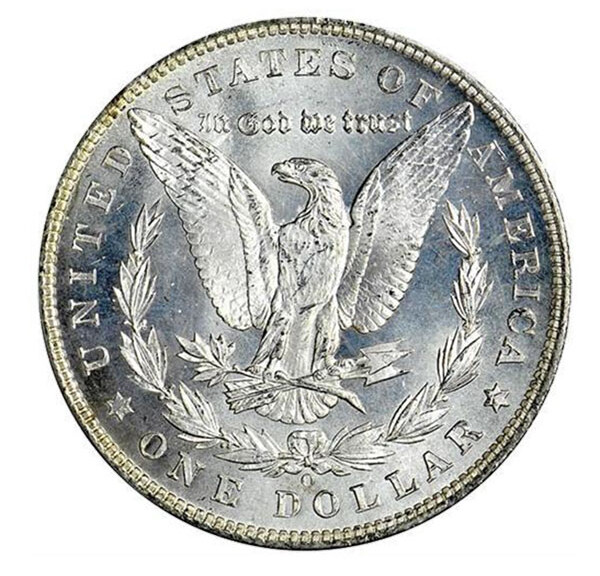
1904-O Morgan Dollar : A Collector’s Guide

1904 Was Supposed to Mark the End of the Morgan Dollar
In mid-to-late 1904, an article appeared in newspapers across the country with the blaring headline: “Passing of the Good Old American Silver Dollar.” Under the subtitle “It Is Probable That No More of Them Will Ever be Coined by the Government,” the author, Katherine Pope, reported “that ponderous and more or less troubling coin, the silver dollar, has had its day… the supply of silver bullion purchased under the Sherman act [sic] is exhausted… in all probability no more new silver dollars will be turned out by the government’s mint plants.
“Which, for old associations’ sake,” she wrote, “seems regrettable.”
… But for the New Orleans Mint, it Was
The New Orleans Mint’s last Morgan dollars were struck as the United States Mint prepared to shutter the facility. Economic turbulence in the 1890s spelled doom for these cartwheels prized by free silver advocates and the demise of the dollar prompted staff cutbacks at the southern branch mint.
The New Orleans Mint was a major part of the Morgan dollar’s life. Reactivated by the federal government in 1879 after its loss almost 20 years earlier during the Civil War, the facility struck Morgan dollars every year until the denomination’s end. Of all the Morgan dollars created by the Bland-Allison Act of 1878, those struck at New Orleans are known for a generally “weak” strike and saw perhaps the most actual circulation in commerce.
Ultimately, the New Orleans Mint struck 3,720,000 Morgan dollars in 1904.
The facility outlived the Morgan dollar by five years, its coining operations being suspended in 1909.
What Happened to Millions of Morgan Dollars?
Millions more Morgan dollars were struck than were needed for circulation, and the coins sat unused in bank vaults and Treasury facilities for years until 1918, when Congress passed the Pittman Act. Named for Senator Key Pittman of Nevada, the Act authorized the melting of up to 350,000,000 silver dollars and the sale of the resulting silver to Britain, whose monetary regime in India was stressed after a run on silver. The Pittman Act also called for the melted dollars to be recoined, precipitating the reintroduction of the Morgan dollar and the introduction of the Peace dollar in 1921.
270,232,722 Morgan dollars were melted under the terms of the Pittman Act. This was done without regard for date, making rarities of some previously common issues. For decades, collectors regarded the 1904-O Morgan dollar as this kind of rarity, as few Mint State 1904-O Morgan dollars entered the market, and prices reflected this belief. For instance, an ad published in The Numismatist in August 1951 by B.M. Douglas, a Washington, D.C.-based coin dealer, offered “Brilliant unc” 1904-O Morgan dollars (under the heading “RARE MORGAN DOLLARS”) for $50 USD.
This view held sway until the early 1960s.
Initially stored in the New Orleans Mint’s vault, the surviving coins were moved to Philadelphia in 1929. In October of 1962, large numbers of Mint State Morgan dollars were released – including many examples of the once-scarce 1904-O. The glut of supply drove prices down. In April 1963, a Philadelphia-based dealer offered 1904-O Morgan dollars in “BU” for just $2.00 in The Numismatist.
What are 1904-O Morgan Dollars Worth Now?
Today, examples grading MS-65 routinely sell at auction for between $100 and $200.
Large numbers of 1904-O Morgan dollars survive in grades up to MS-66 and the date becomes conditionally scarce in MS-67. It is one of the most abundant issues in Mint State. According to Q. David Bowers’ Silver Dollars and Trade Dollars of the United States: A Complete Encyclopedia, more Mint State 1904-O Morgan dollars exist that any other date from the New Orleans Mint after 1885.
PCGS CoinFacts gives an estimate of 372,000 surviving examples, 100,000 of which grade MS-60 or better, with 40,000 grading better than MS-65. PCGS has certified more than 133,000 1904-O Morgan dollars; NGC has certified more than 151,000.
CAC has applied its sticker of approval on 353 coins and has certified nine examples since the company began accepting regular submissions in the summer of 2023.
As for collectible varieties, VAMWorld, a website dedicated to VAM varieties, lists 66 individual VAM varieties for the 1904-O Morgan dollar. A book dedicated to the VAM varieties of 1904-O Morgan dollars was written by Alan Scott and published in 2010; a new edition was released in 2014.
Randy Campbell, Senior Grader and Numismatist at Independent Coin Graders (ICG) and an expert on Prooflike (PL) Morgan dollars, stated in a phone interview that 1904-O Morgans with Deep Mirrored Prooflike (DMPL) obverses and reverses are rare; many coins exhibit DMPL or PL qualities on one side, but rarely both.
CoinFacts claims 9,900 surviving dollar coins are PL, all of which are MS-60 or better; 1,880 are MS-65 or better. DMPL 1904-O Morgan dollars number 1,761 in grades MS-60 and better. Three hundred and ninety-six examples grade MS-65 and better. VAMWorld explains that “Prooflike coins are quite available in terms of absolute population, but they comprise just under 3% of the uncirculated population at PCGS and NGC. Contrast on these tends to be poor.”
In his Getting Started column published in the December 2018 issue of The Numismatist, Mitch Sanders discussed “micro” and “macro” numismatics. Micro numismatics, Sanders wrote, involves “a highly detail-oriented examination of differences among coins with the same date and mint mark, usually focused on die varieties.”
Macronumismatics “emphasizes depth over breadth” and is interested in “coins as representations of the larger economic, political, technological and artistic contexts in which they were produced and used.” 1904-O Morgan dollars have something to offer to both camps.
Collectors can hunt well-struck examples, VAM varieties, and PL and DMPL coins, making the date a worthy endeavor for those who want to delve into the series’ technical minutiae with one of its penultimate dates – and the last date struck at the New Orleans Mint. The 1904-O Morgan dollar marked the beginning of the denomination’s hiatus and the beginning of the end for the New Orleans Mint.
1904-O Morgan Dollar Price Records
The following record prices are still current as of the time of publication:
- Regular Strike auction record: $39,950 USD – Legend Rare Coin Auctions – 7/13/2017
- PL auction record: $19,200 – Heritage – 9/7/2017 MS67PL
- DMPL auction record: $12,338 – Legend – 7/26/2018 MS66+DMPL
Design
Obverse:
The obverse of the 1904-O Morgan dollar exhibits the characteristic left-facing Liberty Head motif seen on all issues of this classic dollar series. Lady Liberty bust wears a Phrygian cap encircled with a ribbon adorned with the inscription LIBERTY. Miss Liberty also wears a “vegetal” crown of wheat and cotton, which were two of the nation’s most lucrative natural agricultural assets in the 19th century.
The phrase E PLURIBUS UNUM is inscribed along the upper half of the obverse rim, and the date 1904 is centered at the bottom of the obverse adjacent to the rim. Seven stars appear between the left side of the date and the inscription E PLURIBUS UNUM, while six stars fill the gap between the date and motto on the lower right side of the coin. In total, the 13 stars represent the 13 colonies that combined to form the original Union of the United States. At the base of Liberty’s neck is the “M” monogram representing Morgan’s initial.
Morgan designed the Liberty head bust after the likeness of Anna Willess Williams, a Philadelphia schoolteacher who modeled for the coin. Williams received significant public recognition after her face appeared on the Morgan dollar, but she rejected the attention that was heaped upon her. She refused offers for acting roles and apparently had turned down an offer for marriage following her engagement to an unknown suitor. Before dying at the age of 68 in 1926, Williams, who sat for Morgan on the sworn condition of anonymity, rebuffed her single stint as a coin design model as little more than an “incident of [her] youth.”
 Reverse:
Reverse:
The reverse of the 1904-O Morgan dollar is dominated by a heraldic eagle, its wings spread across the upper half of the coin. Between the upper tips of the eagle’s wings appears the national motto IN GOD WE TRUST. The eagle clutches an olive branch in its right claw representing peace and in its left claw are three arrows symbolizing the nation’s ability to defend itself. The central eagle design is partly encircled by a laurel wreath.
Along the rim of the upper two-thirds of the reverse is the legend UNITED STATES OF AMERICA, with the tip of the eagle’s left wing (which virtually touches the coin’s rim) penetrating the space between UNITED and STATES; the right wing visually divides the words OF and AMERICA. The words ONE DOLLAR, seen at the bottom center of the reverse, are flanked by a single, six-sided star on either side of the denomination inscription.
The mint mark “O” for New Orleans is located below the wreath and above the word DOLLAR.
Edge:
The edge of the 1904-O Morgan dollar is reeded.
Designer
Engraver George T. Morgan was born in Birmingham, England in 1845. He emigrated to the United States and began work as an assistant to Mint Chief Engraver William Barber and continued to produce patterns and commemoratives under the administration of Barber’s son, Charles. Morgan himself became Chief Engraver in 1917. George Morgan died in 1925.
Coin Specifications
| Country: | United States |
| Year Of Issue: | 1904 |
| Denomination: | One Dollar (USD) |
| Mint Mark: | O (New Orleans) |
| Mintage: | 3,720,000 |
| Alloy: | 90% Silver, 10% Copper |
| Weight: | 26.73 grams |
| Diameter: | 38.10 mm |
| OBV Designer | George T. Morgan |
| REV Designer | George T. Morgan |
| Quality: | Business Strike |
The post 1904-O Morgan Dollar : A Collector’s Guide appeared first on CoinWeek: Rare Coin, Currency, and Bullion News for Collectors.
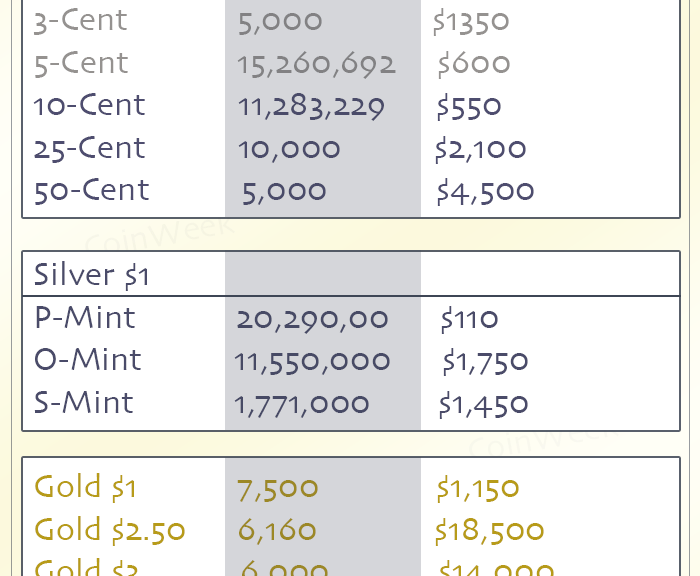
1887 Morgan Dollar : A Collector’s Guide
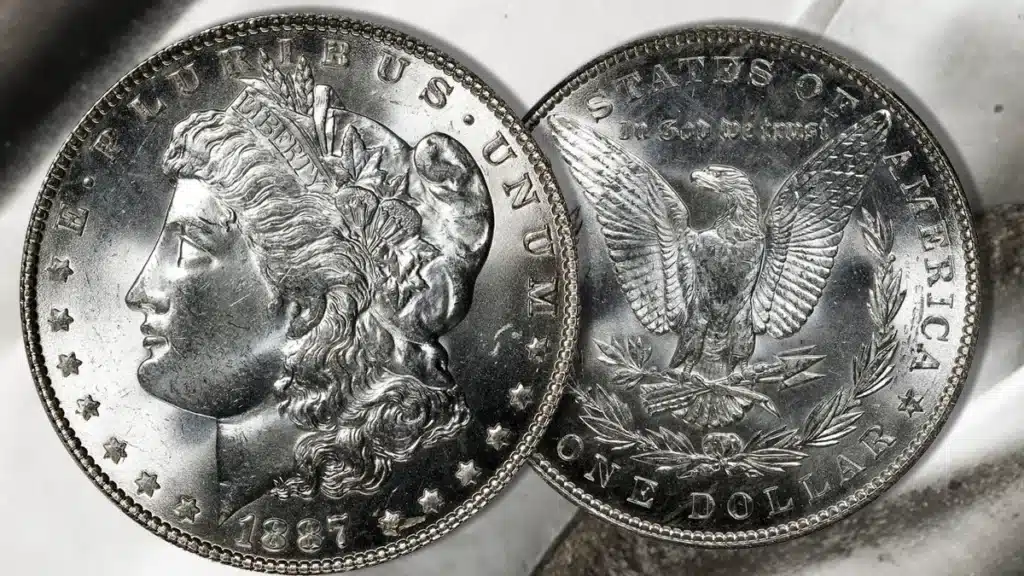
Morgan dollar production continued at its Congressionally mandated pace in 1887, despite the fact that even 10 years into the series’ run it had failed to gain a meaningful place as a circulating coin for most Americans.
The 1887 Morgan dollar, known more officially as the Liberty Head dollar, is a silver coin struck at the Philadelphia Mint. The Philadelphia Mint struck 20,290,000 Morgan dollars in 1887 and bore the responsibility of striking all of the nation’s subsidiary coinage and a small number of gold coins, mostly in the $10 denomination. The New Orleans Mint struck 11,550,000 Morgan dollars in 1887 and nothing else, while the San Francisco Mint struck a small by comparison mintage of 1,770,000 Morgan dollars and devoted the rest of its time producing the bulk of America’s gold coins for that year.
The Morgan dollar gets its name from United States Mint engraver George T. Morgan, who designed the dollar coin in competition with then-Chief Engraver William Barber. The two had a generally cordial relationship, though numismatists throughout the generations have supposed that Barber may have been envious of Morgan’s talent as an engraver and treated him with some degree of unprofessionalism. This is not true.
Morgan was born in England and began working for the Mint soon after his arrival in the U.S. in 1876. He was brought on as an assistant engraver in October 1876 and then worked under William Barber. In addition to the Liberty Head dollar, Morgan has several coin design credits to his name, including the Columbian half dollar of 1892 and 1893 and an array of pattern coins designed in the latter half of the 19th century – perhaps most notably the never-released $100 Gold Union coin.
U.S. Circulating Coin Production in 1887 – The Morgan Dollar in Context
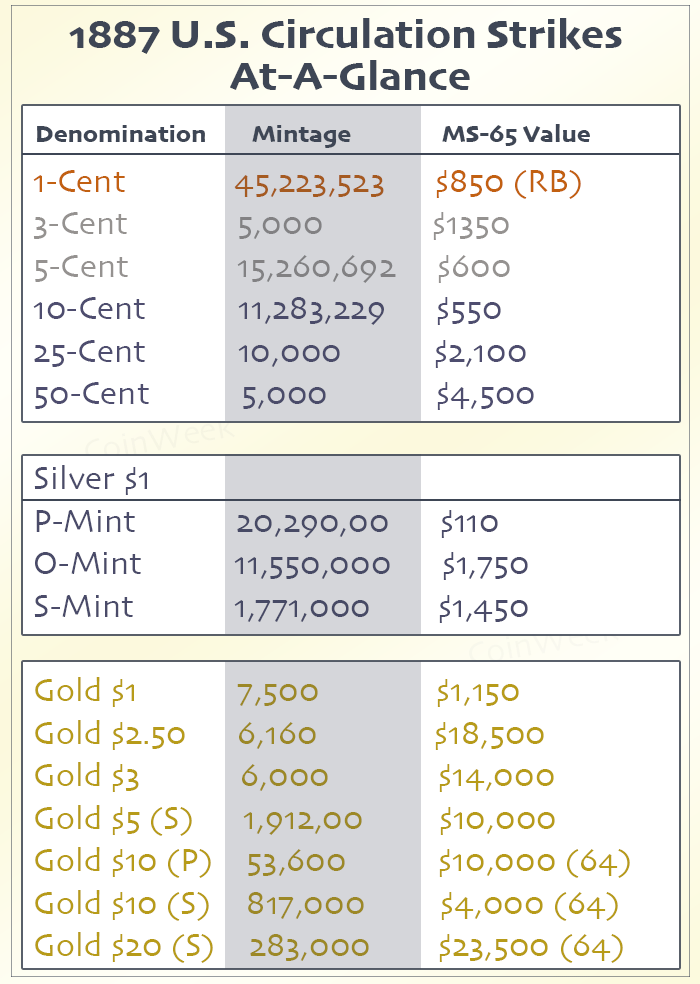
In 1887, the Philadelphia Mint handled U.S. coin production for all minor denominations, the silver dollar, and gold denominations up to $10 (with the exception of the half eagle, which was only struck for circulation at the San Francisco branch).
The table to the right illustrates current market levels relative to mintages in the grade of MS65. There are no “Gem” 65 coins known at present for the $10 and $20 denominations, so we substituted in the MS64 value.
Building a complete 1887 year set of circulation strikes in Gem or finest known 64s will set a collector back about $100,000 USD. However, this pursuit is well within the means of most interested adult collectors in the grade of MS62 or MS63. We estimate a choice set to cost about 1/4 to 1/3 of that price.
The 1887 Morgan dollar struck at the Philadelphia is, by a large margin, the most frequently encountered coin of the date to survive in Mint State. As such, the 1887 Morgan is the most affordable issue of the date by a large margin.
In Choice Uncirculated condition (MS63), the 1887 Morgan is slightly more common than the 1887-O and the 1887-S, but all three issues are affordable at this grade. For those interested in a superb Gem dollar for this date, the 1887 Philadelphia strike is likely the only viable option as the O-Mint and S-Mint 1887 dollars are both rare in grades over MS65.
In terms of strike quality, the 1887 is similar to the Philadelphia strikes of 1886. However, specialist collectors will note that 1887 issues often appear softer struck than their 1886 counterparts. This is not uniform throughout the issue but is a factor that collectors should pay attention to when seeking out a specimen for their collection.
How Much is the 1887 Morgan Dollar Worth
Tens of thousands of 1887 Morgan dollars survive in uncirculated condition, while many more likely survive in various states of wear. Given this coin’s low cost, most coin collectors prefer problem-free brilliant uncirculated or better examples.
Expect to pay between $40 and $50 for a lightly circulated 1887 Morgan dollar and between $90 and $120 for a coin professionally graded at the MS63 level by CAC, NGC, or PCGS.
From this level, the value of an 1887 Morgan dollar increases depending on the eye appeal and grade of the coin.
Previously, NGC reported two coins at the MS68 level, one of which was sold by Stack’s Bowers in 2008, for $32,200. That same coin brought $13,800 at a 2019 Heritage auction. Such is the risk that conditional rarities pose in the marketplace. If populations go up–as they have for this issue–prices usually go down as the top end of the market gains its equilibrium. For what it’s worth, that particular coin is no longer certified by NGC, as the service reports no examples higher than MS67 at the present time.
CAC has applied its sticker to 3,113 1887 Morgan dollars and has encapsulated 168 coins. CAC is a newcomer to the coin encapsulation business and we expect these numbers to increase in short order. At the present time, CAC has applied its sticker of approval on 107 coins graded by NGC or PCGS at the MS67 level with one additional coin graded MS67PL. The highest current grade for an 1887 Morgan dollar in a CAC holder is MS66, with five reported.
PCGS reports over 300 coins at MS67 to MS67+ levels with two examples at MS68. There is no recent auction data in regards to the two MS68 coins, but they are imaged on PCGS CoinFacts. A characteristic these coins share is that they both have flashy brilliance in the centers with a hint of toning along the periphery. In our opinion, one is clearly better than the other and we estimate that either one might sell for $30,000 to $35,000 at auction if market conditions are right.
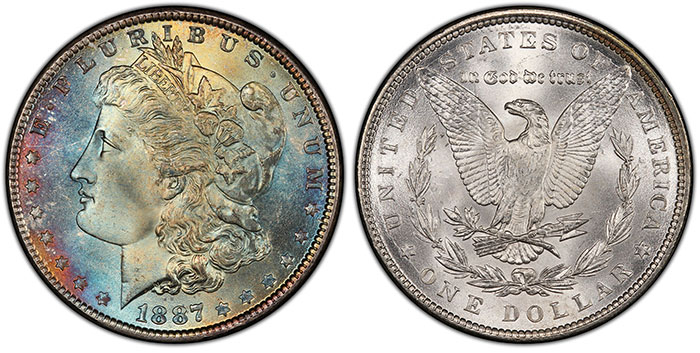
This is only part of the story of the 1887 Morgan dollar at the very top of the market.
As beauty is often “in the eye of the beholder”, the degree to which the 1887 Morgan dollar allows for collector specificity makes these grades attractive to a wide range of collectors. As such, price levels at the MS67 level vary from $3,800 on the lower end to $6,500 or more for the “right” coin.
Gem-quality coins at the MS65 and MS66 level open the issue up to a broad swath of type set and Morgan dollar set builders. As is the case with the Superb Gem 1887 Morgans, at MS65 and MS66, a wide range of options exist. With 50,000 coins graded at the MS65 level at PCGS and NGC combined, there are enough coins to satisfy current levels of demand. MS66 coins are more exclusive, but with a combined pop of over 7,000 coins, a collector with a budget of $300 to $400 can land on an attractive example within a month or two of entering the market.
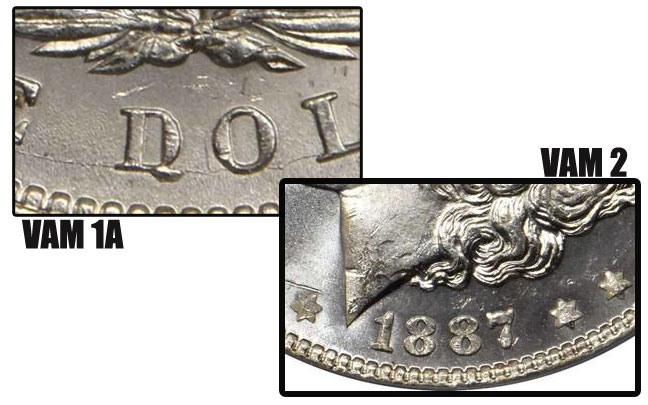
Of course, variety collectors may find grade a secondary concern. For VAM hunters, the 1887 issue yields more than a dozen collectible varieties, some of which are quite striking. VAM 1A features a distinct die break at the bottom curve of the D that forms a “Donkey Tail“. VAM 2 is a naked-eye-visible overdate where the remnants of the digit “6” are visible under the final digit of the date. And so on.
Design
Obverse:
The obverse of the 1887 Morgan dollar exhibits the characteristic left-facing Liberty Head motif seen on all issues of this classic dollar series. The central Liberty bust wears a Phrygian cap encircled with a ribbon adorned with the inscription LIBERTY. Miss Liberty also wears a “vegetal” crown of wheat and cotton, which were two of the nation’s most lucrative natural agricultural assets in the 19th century.
The phrase E PLURIBUS UNUM is inscribed along the upper half of the obverse rim, and the date 1887 is centered at the bottom of the obverse adjacent to the rim. Seven stars appear between the left side of the date and the inscription E PLURIBUS UNUM, while six stars fill the gap between the date and motto on the lower right side of the coin. In total, the 13 stars represent the 13 colonies that combined to form the original Union of the United States. At the base of Liberty’s neck is the “M” monogram representing Morgan’s initial.
Morgan designed the Liberty head bust after the likeness of Anna Willess Williams, a Philadelphia schoolteacher who modeled for the coin. Williams received significant public recognition after her face appeared on the Morgan dollar, but she rejected the attention that was heaped upon her. She refused offers for acting roles and apparently had turned down an offer for marriage following her engagement to an unknown suitor. Before dying at the age of 68 in 1926, Williams, who sat for Morgan on the sworn condition of anonymity, rebuffed her single stint as a coin design model as little more than an “incident of [her] youth.”
Reverse:
 The reverse of the 1887 Morgan dollar is dominated by a heraldic eagle, its wings spread across the upper half of the coin. Between the upper tips of the eagle’s wings appears the national motto IN GOD WE TRUST. The eagle clutches an olive branch in its right claw representing peace and in its left claw are three arrows symbolizing the nation’s ability to defend itself. The central eagle design is partly encircled by a laurel wreath.
The reverse of the 1887 Morgan dollar is dominated by a heraldic eagle, its wings spread across the upper half of the coin. Between the upper tips of the eagle’s wings appears the national motto IN GOD WE TRUST. The eagle clutches an olive branch in its right claw representing peace and in its left claw are three arrows symbolizing the nation’s ability to defend itself. The central eagle design is partly encircled by a laurel wreath.
Along the rim of the upper two-thirds of the reverse is the legend UNITED STATES OF AMERICA, with the tip of the eagle’s left wing (which virtually touches the coin’s rim) penetrating the space between UNITED and STATES; the right wing visually divides the words OF and AMERICA. The words ONE DOLLAR, seen at the bottom center of the reverse, are flanked by a single, six-sided star on either side of the denomination inscription.
Edge:
The edge of the 1887 Morgan dollar is reeded.
Designer
Engraver George T. Morgan was born in Birmingham, England in 1845. He emigrated to the United States and began work as an assistant to Mint Chief Engraver William Barber and continued to produce patterns and commemoratives under the administration of Barber’s son, Charles. Morgan himself became Chief Engraver in 1917. George Morgan died in 1925.
Coin Specifications
| Country: | United States |
| Year Of Issue: | 1887 |
| Denomination: | 1 Dollar |
| Mint Mark: | None (Philadelphia) |
| Mintage: | 20,290,000 |
| Alloy: | 90% Silver, 10% Copper |
| Weight: | 26.73 grams |
| Diameter: | 38.10 mm |
| Edge | Reeded |
| OBV Designer | George T. Morgan |
| REV Designer | George T. Morgan |
| Quality: | Business Strike |
The post 1887 Morgan Dollar : A Collector’s Guide appeared first on CoinWeek: Rare Coin, Currency, and Bullion News for Collectors.
Gold and Silver Prices Retreat on Monday, Nov. 20
Prices for precious metals diverged on Monday, with platinum and palladium logging solid gains, while silver and gold declined for a second session in a row
PNG to Host 2024 FUN Symposium on Dealer Security
The Professional Numismatists Guild (www
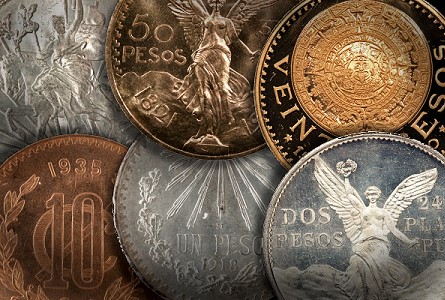
Collecting 20th-Century Mexican Coins
By Cory Frampton – Mexican Coin Company/World Numismatics LLC ……
While collecting 20th-century Mexican coins has stagnated somewhat since its peak in the 1960s (at least in the United States), this intriguing field of numismatics still has a lot of promise. There were probably 10 times as many American collectors in the ’60s and ’70s as there are today, mostly due to the demise of Whitman and Dansco coin albums. It was popular in the mid to late 20th century to collect Mexican coins by type or date in an effort to fill up those albums. At that time, not many people were grade conscious and simply attempted to fill the albums with decent-looking coins.
Unfortunately, those VF to AU coins are worth about the same today as they were all those years ago. However, the few collectors who were grade-conscious were richly rewarded. Coins that grade MS65 today sold for slight premiums over their average uncirculated counterparts at that time. It was not until the late 1990s that high-grade, relatively common coins started to bring big premiums.
 Today, grading is everything. Slabbing coins became more common in the late ’90s and is now standard practice. The phenomenon of registry sets furthered a market condition whereby a lot of 20th-century Mexican coins that grade below MS63 are deeply discounted and difficult to sell today.
Today, grading is everything. Slabbing coins became more common in the late ’90s and is now standard practice. The phenomenon of registry sets furthered a market condition whereby a lot of 20th-century Mexican coins that grade below MS63 are deeply discounted and difficult to sell today.
All of these events contributed to changing the 20th-century coinage of Mexico from one of the most collected to one of the weakest market segments. There are definitely exceptions, however, and with the bad news comes a great deal of potential. Approached with some thought, we believe this segment of the Mexican market holds great potential for individuals who are patient and collect with a view toward the long term.
The following are some of our thoughts on several individual areas of 20th-century coinage.
Late Republic Centavos (1899-1905)
This area is still slow in AU and below except for the rare dates. However, in recent years we have seen record prices for the highest graded coins and there is a lot of interest. Better date coins graded MS63 and up are bringing significant premiums over catalog.
Bronze Issues of 1, 2, 5, 10 and 20 Centavos (1905-1935)
Aside from rarities like the 1922 2 centavo and the 1931 5 centavo, this part of the Mexican coin market is pretty much dead below MS63. Examples in MS63 are selling for around two-thirds of catalog uncirculated prices and sell slowly. Coins in MS65 with good eye appeal are saleable at catalog values or higher. We think high-grade, nicely toned coins with good eye appeal are scarcer than people believe and are good value long term. We especially like coins that are a pretty gunmetal color or are full red. With some patience, a set of these in MS65 can be put together at reasonable prices, with the exception of the few really rare dates.
Silver Cap and Ray Issues – 10, 20, 50 Centavos and 1 Peso (1905 Onward)
This segment is much more active, like it should be. Again, with the exception of the rare dates, you can put together a set of these graded MS64 or better at reasonable prices and they are very attractive coins. Catalog prices are both too high and too low. For instance, the 1919 peso catalogs at $950 in uncirculated. We have sold a couple of MS62 pieces in recent years in the $350 range. On the other hand, the 1918 priced in the catalog at $2,500 BU is about right with Gems bringing more. The 1908 50 centavo catalogs at $650 in BU but is bringing closer to $2,000 in Gem.
Caballito Pesos
This segment of the market is very strong in high grade. There are a number of collectors looking for all dates in Gem and prices are rising. Coins in MS65 are bringing well above catalog BU.
Gold Coins – 2, 2.5, 5, 10, 20 and 50 Pesos (1905-1959)
The market for the lower end of this series (2-10 pesos) is active but not nearly as strong as the 20 and 50 peso segments. The 20 peso series is a lot harder to put together in MS65 than most people think. I know of a number of sets of 50 pesos in MS65 or better; I do not know of a complete set of 20 pesos in MS65. The 50 peso market is fixated on grades from MS65 and up. These Mexican coins sell quickly in the early dates. Coins dated from 1943 to 1947 in MS65 are common. You can put together a set of MS64 coins pretty reasonably.
Visit Mexican Coin Company/World Numismatics LLC at worldnumismatics.com.
* * *
The post Collecting 20th-Century Mexican Coins appeared first on CoinWeek: Rare Coin, Currency, and Bullion News for Collectors.
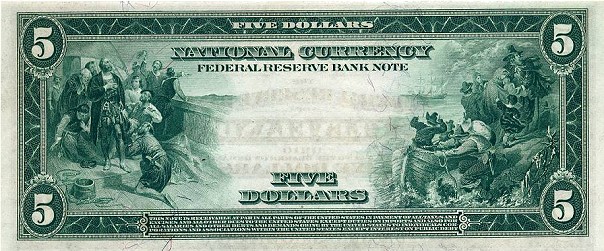
Patriotic U.S. Coins and Banknotes
By Al Doyle for CoinWeek …..
Here’s a short but focused area of numismatics: patriotic U.S. coins and notes with a strong message of freedom and independence. These pieces go well beyond the ubiquitous portraits of an allegorical Miss Liberty, and they can be found at every price point on the spectrum.
U.S. Banknotes
A pair of large-sized $5 notes drive home the message of religious liberty with compelling artistry. Check the back of the 1902 and 1908 $5 National Bank Notes to see a fine example of old-school engraving. A scene of the Pilgrims landing at Plymouth Rock is an eye grabber. President Benjamin Harrison and the issuing bank can be found on the other side.
The Pilgrims wanted to worship in a manner that was banned by England’s state church, and their quest for religious freedom included many severe hardships. Something in the $150 to $175 range should be sufficient to acquire a common example (as in bank and state) in Very Fine, and the cost is around $300 in Extra Fine. The same vignette shares the back with Christopher Columbus landing in the western hemisphere on the Series 1914, 1915 and 1918 $5 Federal Reserve note. It will cost around $100 for a VF type note.
What if you need to take the low-budget path to collecting symbols of freedom? Go to the bank and get some $2 bills at face value. All deuces since 1976 (this includes Series 1995, 2003, and 2009) carry the signing of the Declaration of Independence on the back. Get some extra $2s and spend them if you want to see startled looks and hear the comments from surprised cashiers.
Patriotic U.S. Commemorative Coins
A trio of older commemorative coins focus on independence. The 1925 Lexington-Concord half dollar is known for its depiction of the famed statue of the musket-armed citizen answering the urgent call to duty. This is a very affordable item in grades as high as MS-64, as 162,013 pieces were sold. The small wooden cases that housed Lexington halves were usually discarded and nowadays are prized by collectors.
Sesquicentennial half dollars and $2.50 gold pieces were issued in 1926. The 50-cent piece (mintage 141,120) is affordable in grades up to MS-63, but the typically weak strike means higher-grade specimens are anything but cheap. Plan on spending $300 in MS-64 and $2,000 or more for the relatively small population of MS-65 “Sesquis”. The quarter eagle was the last of the 11 old gold commemoratives, and the original mintage was 46,019, Don’t expect to add this attractive design to your collection for less than $450 even in lower grades.
Modern U.S. Coins
Move ahead 50 years for the clad and .400 fine silver quaters, half dollars, and Eisenhower dollars struck to honor America’s bicentennial. The drummer boy reverse on the 1776-1976 quarter is the one artistically inspired theme on the series, which is both common and cheap in BU and proof versions.
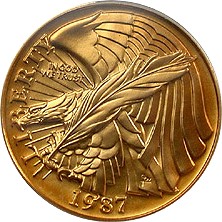 The 1987 Constitution silver $1 and gold $5 rank among the biggest sellers of the modern U.S. commemorative coin era. More than 3.07 million silver pieces and 873,884 gold half eagles were purchased. The issue honors the bicentennial of the United States Constitution, and either coin can be had for bullion-related prices.
The 1987 Constitution silver $1 and gold $5 rank among the biggest sellers of the modern U.S. commemorative coin era. More than 3.07 million silver pieces and 873,884 gold half eagles were purchased. The issue honors the bicentennial of the United States Constitution, and either coin can be had for bullion-related prices.
It took the creation of the Bill of Rights before a number of delegates were willing to vote for the Constitution, and a 1993 half dollar and silver dollar honors this vital affirmation of individual liberty. James Madison is depicted on both commems. The 50-cent piece is the only modern commemorative half dollar besides the 1982 George Washington commemorative to be struck on a silver planchet.
In addition to reflecting on America’s history, the patriotic U.S. coin collector can acquire items that provide a constant reminder of what it means to live in this nation.
* * *
The post Patriotic U.S. Coins and Banknotes appeared first on CoinWeek: Rare Coin, Currency, and Bullion News for Collectors.
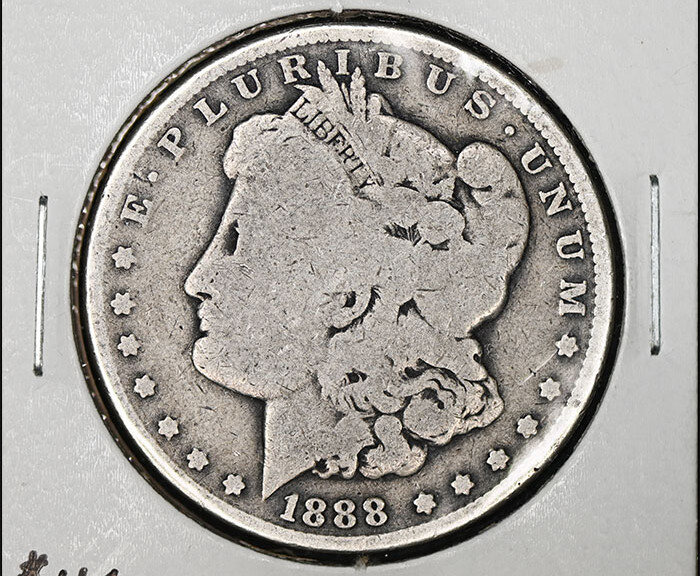
The Underground Success Story: Collecting Circulated Morgan Dollars
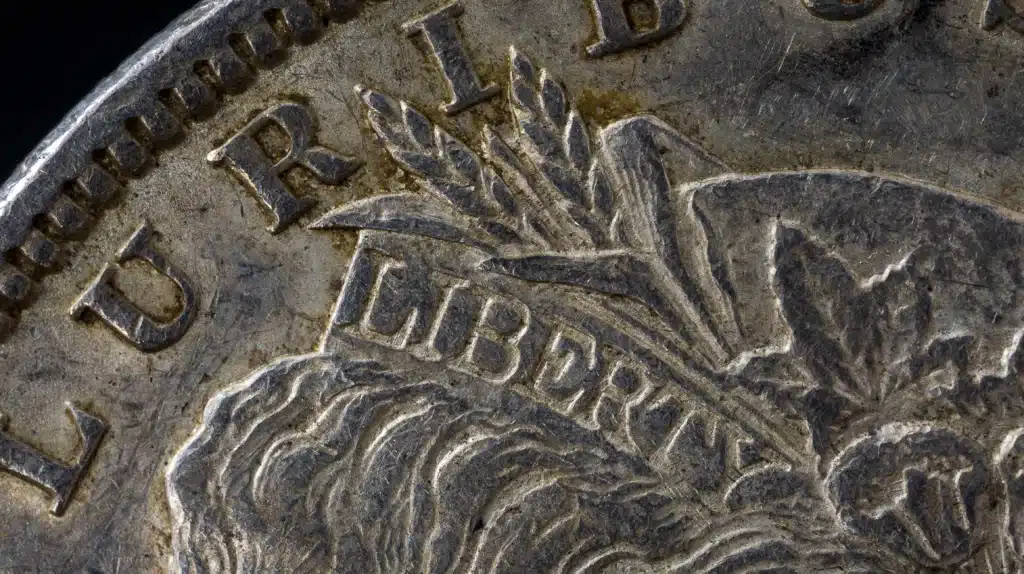
By Al Doyle for CoinWeek….
Six- and seven-figure “trophy” coins and top-tier Registry Sets are the stuff of headlines and splashy stories, but such high-end items are in a completely different universe than where the average collector resides. Since the market for coins in the $1 to $250 range is much broader than the elite level, what is one of the biggest sellers in the working-class neighborhood of numismatics?
Collectors of All Levels Enjoy Morgan Dollars
One series – more specifically, the least expensive pieces in that group – have had a significant positive impact on the bottom line of thousands of coin dealers. In some cases, this overlooked series has made the difference between profitability and closing the doors. It may be a totally off the radar subject, but circulated Morgan dollars are a mainstay and even a passion for numerous collectors.
Think basic when entering the world of “circ” Morgans. Raw coins make up the vast majority of purchases, and collections are usually housed in Whitman folders or similar products. Some hobbyists step up to a sturdy Capital Plastics display case.

Slabbed pieces may not remain in their sonically sealed holders, as they are sometimes cracked out and placed with the rest of the collection. Going for broke in this segment of numismatics might mean adding a few Extra Fine cartwheels to a lower-grade set or even going all the way to a smattering of MS-60s mixed with “used” coins.
There’s no lack of enthusiasm just because the circulated Morgan specialist often operates with limited funds. These are the people who hang out at the local coin shop picking up a precious silver dollar or two on a regular basis.
What Coin Dealers Say About Circulated Morgan Dollars
“Circulated Morgans allow you to be a collector while investing in silver,” said Louis Fogleman of The Coin Shop in Farmington, N.M. “It sometimes takes a little education to learn about prices and mintages, but people understand that quality costs more for higher grades. You take time to explain rarity in dates, and customers understand about prices.”
Even though he is known for a large inventory of type coins, Gary Rosencrans of Gary’s Coins & Stamps in Wisconsin Rapids, Wis. also does a steady business in circ Morgans.
“I have a lot of guys who collect circulated Morgans,” Rosencrans said. “When it comes to the number of coins sold, Morgans are up there with Lincoln cents for the most popular series. I buy two to four circ Morgan sets a month over the counter.”
The market for dated Morgans has expanded with the rise of the internet.
“I sell 200 VF and EF Morgans a month to a guy who puts them on eBay,” Rosencrans said. “He doesn’t sell them in bulk as an investment. They go one at a time to collectors.”
It may not be easy to pigeonhole those who pursue circulated Morgan dollars, according to Vic Turner of The Coin & Collectables Shop in Kenner, La.
“Even though people do tend to like New Orleans Mint Morgan dollars around here, we get a little bit of everything,” Turner said. “Price has a lot to do with what an individual will collect. Fine and Very Fine Morgans are very popular.”
Complete date sets become costly with keys such as the 1889-CC, 1893-S and 1894, but there are other ways to collect circulated Morgans.
“Rather than buying every date, people collect year sets with one Morgan from each year,” Fogleman observed. With 27 coins (1878 to 1904 and 1921) in a year set, a few scarcer dates can be added to the collection without undue financial hardship.
There is another way to build a short set of Morgans, and those who take this route are very focused on 13 dates.
Sets composed entirely of the Carson City Mint issues and their distinctive “CC” mintmark are a popular option. While the made in Nevada Morgans are less common than those struck at Philadelphia, San Francisco and New Orleans, meeting this goal isn’t an impossible task.
“I do a lot of CC sets,” Fogleman reports. “Even though the CCs are scarcer, circs are pretty available at shows. A lot of people have more than one Carson City set because the love the mystique of the old wild west, or they’re building sets for their grandchildren. For some collectors, CC Morgans are a never-ending process. When they build a set, the coins have to match in appearance.”
“Circ CCs are really hot,” Rosencrans said. “I can’t come close to buying enough of them.” Capitol’s Nevada-shaped display case is a popular option for Carson City enthusiasts.
If the funds are available, this might be a good time to go after the key circulated Morgan dollars.
“Some of the tough dates have gotten cheaper over the past three years,” Rosencrans said. “I sell a lot of 1893-S Morgans in the Good to VG range.”
Even with the occasional key, circulated Morgan dollars are primarily an area for the person whose budget is closer to Ralph Kramden than Ralph Lauren.
“Not everyone collects gold or MS-65s,” Fogleman said. “With circulated Morgans, you can start small and build from there.”
The post The Underground Success Story: Collecting Circulated Morgan Dollars appeared first on CoinWeek: Rare Coin, Currency, and Bullion News for Collectors.
Bullish Week for Gold, Silver, and Other Metals
Setting palladium aside, precious metals edged lower on Friday, as both gold and silver retreated from their multi-week highs
Rare Qing Dynasty Coins in Heritage Hong Kong Auction
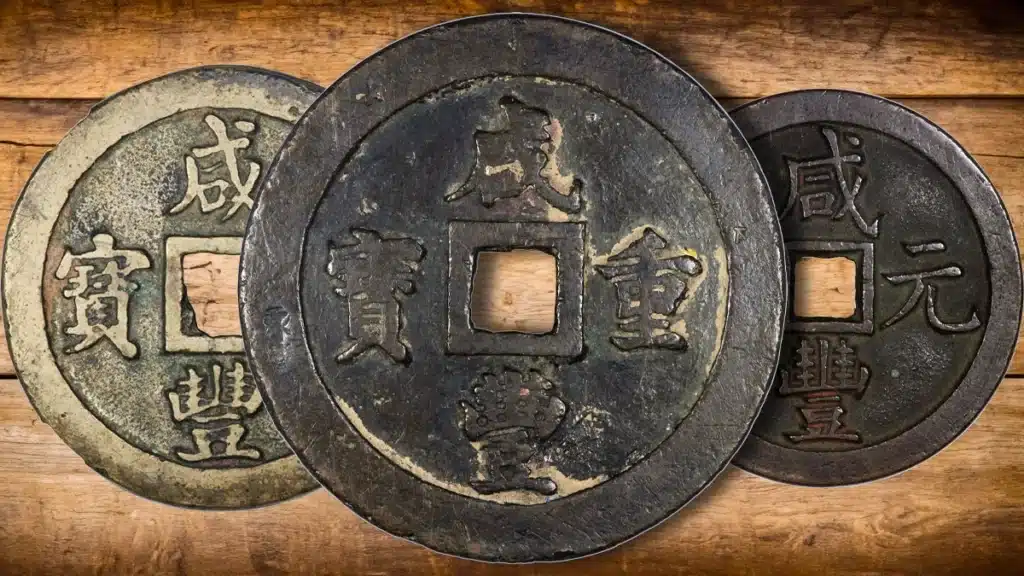
A strong selection of Asian and related coins will be offered in Heritage Auctions’ Hong Kong International Numismatic Fair (HKINF) World Coins Platinum Session and Signature Auction on December 9 through 11, 2023.
Among the highlights are the Treasures from the W&L Collection, which includes various Wen Zong denominations and mints, including Mother, Trial and Pattern Types. Some of the top Wen Zong lots are:
- A Qing Dynasty coin. Wen Zong (Xian Feng) Trial Piece 20 Cash ND (1853-1855) Certified 80 by Gong Bo Grading. Exceedingly rare as a Trial and distinct from Patterns and Mother types. Few have come to market over recent decades.
- A high-grade Qing Dynasty coin. Wen Zong (Xian Feng) 1000 Cash ND (March-August 1854) Certified 88 by Gong Bo Grading. Among the finest to come to auction.
- A Qing Dynasty coin. Wen Zong (Xian Feng) 100 Cash ND (1853-1855) Certified 80 by Gong Bo Grading. Largest of this scarce series.
Sycee specialists will be drawn to a number of intriguing lots, including:
- A rare unidentified Fangbao (“Square”) Sycee of 10 Taels ND Certified MS62 by Gong Bo Grading. Largest of these handled at Heritage Auctions; they are typically encountered in 1 and 5 Tael sizes.
- A Jin Dynasty 49-1/4 Tael Sycee that can be a prize in any collection, especially those assembled by dynasty. This magnificent offering includes four stamps, reading “Wang De Bin Liu Zi Yan” (Officers’ names: Wang De Bin and Liu Ziyan) upper right, “Si Shi Jin Liang You Er Fen Ban” (Forty Nine Tael and Quarter) lower right, “Song You Qian Ren Mao Shi Xing Ren” (Offers’ names: Song You Qian and Ren Mao Shi) upper left and “Ku Cheng” (Weighing Scales) lower left.
- An Anhui Erqibao Sycee of 50 Taels that is an absolute rarity, as any issue of Anhui origin is considered a highlight and/or trophy of numismatic and historical collections.
THere is also a selection of seven Kiangnan dollars:
- A Kuang-hsü Dollar CD 1900 MS65 PCGS, an example of a type rarely encountered in “straight” grades, let alone in Mint State. The condition censuses reveals only two specimens out of more than 750 at the Gem level: the specimen offered here and a staggering MS66+. An MS63 was the finest to come to market in the last 20 years.
- A Choice Mint State 1897 Kiangnan Dollar, from the J.R.S. Affra Collection, features a dragon design that is a symbol of power, luck and prosperity. The example offered here has the second-highest grade in the PCGS census.
Besides the Qing dynasty coins above, there is also a Hsüan-t’ung silver Specimen Pattern “Long-Whiskered Dragon” Dollar Year 3 (1911) SP64+ NGC that is among the finest Pattern Long-Whiskered Dragon Dollars existing. This coin is the finest ever offered by Heritage. Only one other of this variety has certified finer than the offered example, which is already the finest to come to market in more than two decades.
A Republic Yuan Shih-kai silver Pattern Dollar Year 3 (1914) MS64 NGC, Tientsin mint, KM-Pn32, L&M-72, Kann-643, WS-0166, Wenchao-858 (rarity 3 stars), from the Rulin Wei Collection, is the second-highest graded specimen submitted to either NGC or PCGS. NGC designates all examples as Mint State, while PCGS calls them Specimens.
A “Dragon & Phoenix” 10 Dollars is a good example of the very rare Pattern by the colorful warlord Zhang Zongchang, and likely required a series of unlikely events to allow this piece to remain in Gem state. The previous Gem Mint State coin offered at Heritage Auctions was an MS65 NGC that sold in 2014 for $94,000 USD. The example offered in this auction is an MS65+ NGC — the highest grade across PCGS and NGC.
A Republic Chu Yu-pu Pattern Medallic Dollar ND (1927) MS63 NGC, L&M-962, Kann-690, WS-0125 is one of 22 specimens that have been submitted to the major grading services and only make it to auction every few years. This example is the first offered through Heritage.
Highlights from other countries include:
A Rama V (Chulalongkorn) 6-Piece Uncertified “Bullet” Presentation Set CS 1242 (1880) UNC, struck in commemoration of Chulalongkorn reaching the same age as his mother, Deb Sirindhra, when she died at 28, is arguably the most famous and coveted sets in all of Thai numismatics. As the first dated silver “coins” of Thailand, the historical significance of the set can not be overstated: the offered set is one of just three intact sets, out of an estimated population of eight sets, to reach the auction market. The set includes two of some of Thailand’s largest pieces of bullet money: the Chang (80 Baht) and 1/2 Chang (40 Baht). This is the first time Heritage has offered anything larger than a 1/4 Chang (20 Baht) from this series.
A Victoria gold Proof “Una and the Lion” 5 Pounds 1839 PR62 Ultra Cameo NGC is a popular icon of British numismatics, struck in the early years of Queen Victoria’s reign. This prized design is an unrivaled 19th-century example of mastery by Royal Mint Chief Engraver William Wyon.
Another design by William Wyon is the George III silver Proof Pattern “Three Graces” Crown 1817 PR63+ NGC, one of the most popular and illustrious types in the British series. Of an estimated 50 produced “Three Graces” Patterns this example ranks among the most finest specimens extant. The “Three Graces” is is considered the pinnacle of numistmatic artistry under George III, and marked the arrival of William Wyon as a tour-de-force at the Royal Mint.
* * *
The post Rare Qing Dynasty Coins in Heritage Hong Kong Auction appeared first on CoinWeek: Rare Coin, Currency, and Bullion News for Collectors.
Key Date 1856 Flying Eagle Proof Cent in David Lawrence Auction
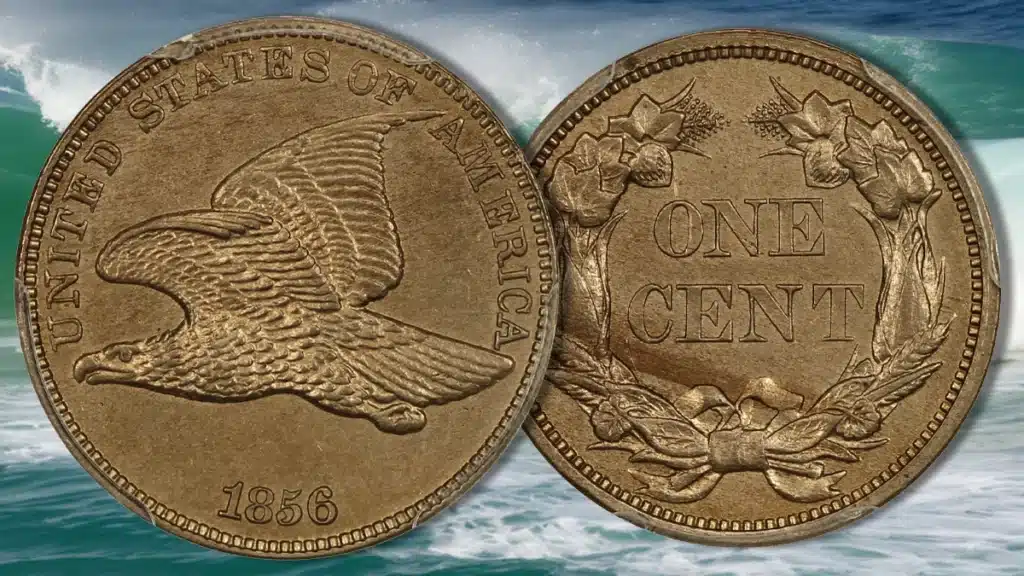
The Sunday, November 26 Online Auction is now live and includes over 525 lots. Of those lots, the auction also features 200 No Reserve and 200 Recently Reduced for the budget coin collector.
Among the PCGS-, NGC-, and CAC-certified highlights of the U.S. coins in this auction are a key date rarity 1856 Flying Eagle Proof cent PCGS/CAC PR64; a registry-quality 1914 Lincoln cent PCGS MS67RD; a scarce (and original) 1919 Walking Liberty half dollar PCGS/CAC MS66; a low-mintage 1839-D $5 half eagle gold coin NGC AU55; a near-finest 1844-O $5 half eagle PCGS/CAC MS63+; and a rare 1915-S Panama-Pacific Octagonal $50 PCGS MS64.
Please feel free to check out these and many other lots before the auction closes on Sunday, November 26.
READY TO SELL YOUR RARE COIN OR COLLECTION? SELL IT TO DAVID LAWRENCE
Like the key date 1856 Flying Eagle Proof cent and other rare classic and modern U.S. coins offered above, David Lawrence Rare Coins always needs coins. When you are ready to sell, we’re here for you. David Lawrence offers three options that provide maximum flexibility to meet your needs while providing the highest quality personal service in the industry:
- You can sell your coins to us outright.
- You can consign your coins.
- You can participate in our Guaranteed Auction Program.
DLRC Consignment Special
Check out our Collector Consignment Special! We are offering the following options that can be combined, or adjusted for your specific needs:
Maximum Returns – For coins over $10,000, consign with a reserve and receive 90% or consign with no reserve and receive 92%.
Immediate Cash Advance – For collections over $10,000, receive an immediate cash advance of up to 75% on unreserved consignments.
Fastest Turnaround – We will get your coins to auction within 3-5 business days of receipt, ending in approximately two weeks.
Standard terms still apply:
- Coins from $1,000 to $10,000 – consign with a reserve and receive 85%; consign with no reserve and receive 90%
- No fee guarantee – no listing fees, no imaging fees, and no buyback fees
- Fast payment – payment within 30 days of sale; for this promotion, we can accelerate payment to two weeks in most cases
* * *
The post Key Date 1856 Flying Eagle Proof Cent in David Lawrence Auction appeared first on CoinWeek: Rare Coin, Currency, and Bullion News for Collectors.

The Red Book Changes Hands: Jeff Garrett

By Jeff Garrett for Numismatic Guaranty Corporation (NGC) ……
 About two weeks ago, the numismatic world was stunned to hear the announcement of the sale of Whitman Publishing to CDN (Coin Dealer Newsletter, publisher of the Greysheet). Whitman has been serving the numismatic community since 1947, and its history closely mirrors the evolution of the hobby through the decades. A huge number of serious collectors started out by filling a Whitman album in their youth. My own numismatic journey started in 1969, with a Whitman Lincoln Cent folder for coins 1941 to date.
About two weeks ago, the numismatic world was stunned to hear the announcement of the sale of Whitman Publishing to CDN (Coin Dealer Newsletter, publisher of the Greysheet). Whitman has been serving the numismatic community since 1947, and its history closely mirrors the evolution of the hobby through the decades. A huge number of serious collectors started out by filling a Whitman album in their youth. My own numismatic journey started in 1969, with a Whitman Lincoln Cent folder for coins 1941 to date.
Since 2003, when the Anderson family purchased Whitman Publishing, they have greatly expanded the number of specialty numismatic books for United States and World coins. They have published hundreds of titles, of which many have been widely acclaimed and award-winning. Their prodigious output has meant a boon of information for modern collectors and has undoubtedly stimulated the rare coin market over the last two decades.
Several years ago, after being sold to its current owners, the long-running Coin Dealer Newsletter (the Greysheet) went through a radical restructure and update. They decided to eliminate the weekly sheets of years past and publish magazines: one for retail pricing and another with the standard wholesale prices they have published for decades. The new formats have been well received and the current form of the Greysheet is greatly improved, with vastly more pricing information. The Greysheet has transformed from a simple weekly flyer to a suite of numismatic publications. CDN has also invested considerably to develop an internet strategy.
The Guide Book of United States Coins (the Red Book) is the crown jewel of Whitman Publishing. It is by far the most widely distributed numismatic book and is available in bookstores around the country. Nearly everyone starts collecting coins starts with a Red Book in hand. Its basic information about numismatics is vital to anyone new to the hobby.
I have been the Senior Editor of the Red Book since 2019; however, my involvement with the Red Book dates back another decade before that, when I started helping Ken Bressett with the annual pricing. His mentorship has prepared me for the role as caretaker of one of the most important brands in the hobby.
Although surprised by the announcement, I am excited to see what the next chapter brings for Whitman Publishing. In an ever-changing world, even the most iconic brands need to adapt to remain relevant. It will be thrilling to see what new tools and ideas CDN can bring to the table for the Red Book and its dozens of other products and brands. Information is one of the most impactful elements in the hobby today and, together, Whitman and CDN have become the new powerhouse for numismatic information.
There is a long history of information impacting the hobby. Some of the oldest rare coin price guides for U.S. coins began in the mid to late 1800s. There was a boom of collector interest in U.S. coinage when the United States Mint stopped making Large Cents. A few of the greatest collections ever assembled were started at this time. Over the generations, rare coin price guides changed very little. Slowly, conditions became more of a factor in pricing, but with only one or two grades listed for most coins.
In late 1946, the first edition of A Guide Book of United States Coins was published. This became the bible of numismatic pricing for the next 75 years or so. I remember times in the 1970s when dealers would not price coins in inventory until the latest edition of the Red Book was distributed. Most of my early knowledge of rare coins came from memorizing as much as possible of the Red Book.
We now live in the information age, and coin collectors have been a huge beneficiary of this new trend. Because of the many price guides, auction records, and population information, the hobby is now more transparent than ever before. In my opinion, this has been one of the biggest drivers for increased collector demand in the last 20 years.
Regardless of their budget, collectors want accurate pricing information before making a purchase. This may sound simple, but I can assure you it is not. For one thing, rare coins are not commodities. Nearly every rare coin is different in appearance – even in the exact same grade. We have discussed this many times over the years. Eye appeal and general appearance can greatly impact the value of a coin. This is very hard to convey in price guides.
Most price guides list prices for the imaginary “average” coin for the grade. Therefore, actual coins can trade over a wide price range based on appearance. This can be easily observed by attending any major rare coin auction.
There is also much discussion about what constitutes wholesale and retail prices for rare coins. Many have a hard time defining the term “retail”. Because of the abundance of pricing information available to most retail collectors, the standard markups of times past are hard to sustain for many retail companies. I can safely state that there has been a huge blurring of the line between what is wholesale and what is retail in today’s marketplace.
Many consider price guides to be a problem for the hobby, and I have heard dealers complain about too much information being available to collectors. In my opinion, it is not much different than the pricing pressures nearly every retail company in the United States faces. Consumers can price-shop with a few clicks of their phone for everything from socks to automobiles. In the long run, this transparency will greatly increase volume for many players, but profit margins will continue to be squeezed. Rare coin consumers are the winner.
There are now more tools than ever for the average or advanced collector. With the purchase of Whitman Publishing (and therefore the Red Book) by CDN, there will be new and improved pricing information available to collectors at all levels. Because of the resources being devoted to numismatic information, now is the best time in the history of the hobby for collectors to buy coins at the lowest possible markup. Be sure to use the information you now have available to your fullest advantage.
* * *
* * *
The post The Red Book Changes Hands: Jeff Garrett appeared first on CoinWeek: Rare Coin, Currency, and Bullion News for Collectors.
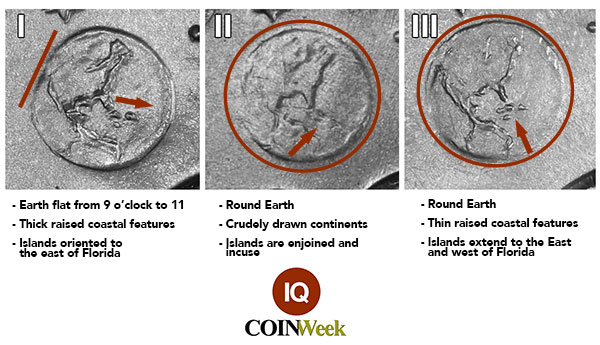
1972 Eisenhower Dollar : A Collector’s Guide
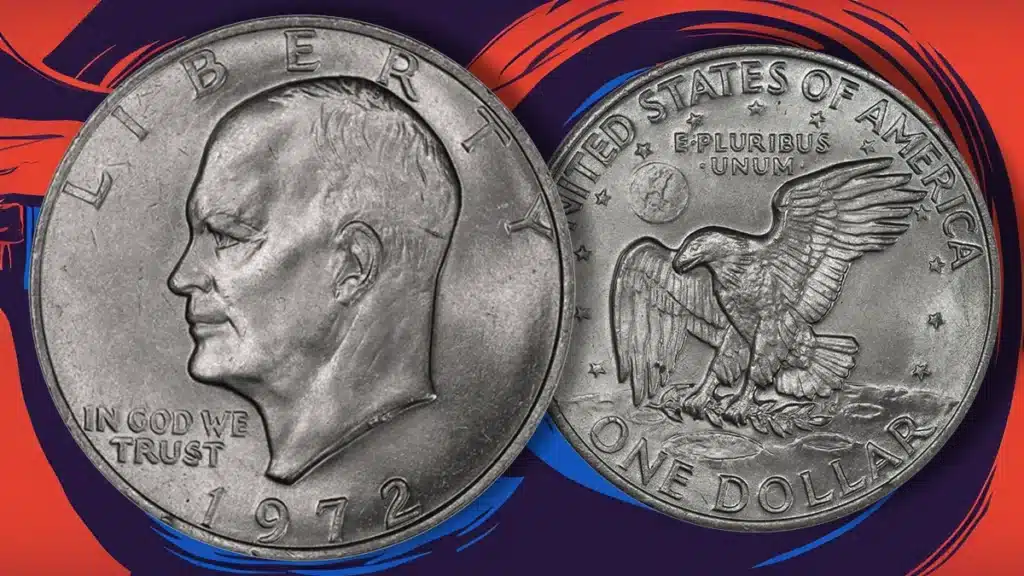
The Mint Was Still Refining the Eisenhower Dollar Design in 1972
After one year of development, the Eisenhower dollar was released in 1971. The large dollar coin was struck to honor President Dwight D. Eisenhower, who had died in March 1969, at the age of 78.
The coin was authorized by Congress through the Bank Holding Company Act Amendments of 1970, which was signed into law by President Richard M. Nixon. Nixon was a fitting signer of the memorial legislation as he had served for two terms as Eisenhower’s Vice President.
Eisenhower dollars produced for circulation were struck in the copper-nickel (Cu-Ni) sandwich metal that was used to strike all dimes and quarters dated 1965 onward, while special silver-clad versions were struck for the collector market.
The technical challenges of striking large coins in the harder Cu-Ni composition were considerable and throughout the first two years of the coin’s production, it is clear that United States Mint Chief Engraver Frank Gasparro was forced to make a series of seemingly small revisions to the coin in order to correct the deficiencies in his design.
In 1972, these design changes led to the release of three different reverse varieties.
How to Identify the Three 1972 Eisenhower Dollar Varieties

Whitman’s Guide Book of United States Coins (more commonly referred to as the “Red Book”) lists three varieties of the 1972 Eisenhower dollar. Collectors know these varieties as Types 1-3. Of the three, only the Type 2 is scarce – it was struck with a reverse die that was intended for use on the Proof version of the coin.
In order to distinguish between the three 1972 Eisenhower dollar varieties, you must take note of the shape of the earth and the configuration of the Caribbean islands. The graphic above illustrates the major pick-up points for each variety.
The number of Type 2 coin emissions is not understood with certitude, but contemporary reports of its discovery indicate that small numbers of Type 2 1972 Eisenhower dollars were released in March and then in August 1972. A number of minute die markers have allowed series specialists to differentiate between the two releases and research conducted by the Ike Group revealed that the Mint deployed harder die steel to strike Eisenhower dollars later in the year.
As the 1972 Type 2 commands a significant premium over the more common Type 1 and 3 1972 (P) Eisenhower dollars, many dealers and collectors look primarily for the Type 2 coin’s incuse islands and ignore the fact that all three types in grades above MS65 are scarce to rare.
Savvy collectors should take note that due to the Eisenhower dollar’s absence in the 1971 and 1972 Mint Sets, the millions of coins that would have been preserved in Mint State for the issue are simply not available.
Short of a hoard of high-quality 1972 (P) dollars surfacing at some future date, there are no obvious sources for premium business strike Eisenhower dollars from 1971 or ’72, as Mint Sets from each of these years did not include dollar coins.
The CoinWeek video above provides an easy to follow guide to identifying the three 1972 Eisenhower dollar varieties.
How Much is the 1972 Eisenhower Dollar Worth?
Despite their high mintages, Eisenhower dollars from 1971 and 1972 are less common in Mint State than issues from 1973 onwards. This can be explained by the absence of dollar coins in the United States Mint’s annual Mint Sets. The first Eisenhower dollars to appear in Mint Sets were the 1973 (P) and the 1973-D, which despite that issue’s low mintage (and supposed “key date” status) are actually quite plentiful.
The typical brick and mortar coin shop will have Mint Sets, brown packs (silver-clad Proofs), blue packs (silver-clad uncirculated versions), bicentennial sets (in BU and Proof), and clad Proof Sets, but will not likely have many (if any) uncirculated 1971 or 1972-dated clad business strikes in original rolls. For the 1971 and 1972 issues, barely circulated sliders are plentiful.
In terms of strike and quality, muted luster, average-to-weak strikes, and heavily marked planchets are the norm. The typical 1972 Eisenhower dollar in uncirculated grades will rise to the level of choice but go no further. The typical choice BU example does not possess much eye appeal.
The series specialist is likely to be persnickety when it comes to paying premiums for the 1972 Eisenhower dollar. While raw coins will generally trade for $5 to $10 for Type 1 and Type 3, eBay listings of uncertified Type 2 coins typically fall in the $80 to $100 range. Be advised that many sellers purporting to offer 1972 Type 2 Eisenhower dollars do not know how to properly identify them.
Professionally Graded 1972 Eisenhower Dollars Are More Valuable
As is the case with most modern coins, the 1972 Eisenhower dollar is at its most valuable when it has great eye appeal, is in a high state of preservation, and has been authenticated and graded by one of the three major grading services. Typically, the highest prices realized are for coins that have been graded by PCGS and approved by CAC. In 2023, CAC launched a new grading service at its Virginia Beach location. In time, the market will indicate whether the premium that exists for PCGS + CAC coins takes precedence over the CAC graded coins.
CAC had encapsulated only 25 1972 Eisenhower dollars at the time of publication (November 2023), but has applied their green oval sticker to 173 coins. The 173 coins were predominately graded by PCGS.
NGC’s census data shows 1,802 Type 1, 1,028 Type 2, and 1,767 Type 3 grading events. For Type 1, NGC reports 23 grading events at MS66 and one at MS66+. For Type 2, NGC reports 62 at MS65 and only 2 at MS66. Type 3 has a similar grading dispersal as Type 1, with 685 at MS65, 48 at MS66, and 2 at MS66+.
PCGS has graded more 1972 Eisenhower dollars than the other two services. For Type 1, PCGS reports 3,426 grading events with 623 at MS65, 19 at MS66, and 2 at MS66+. For Type 2, PCGS reports 2,924 grading events, with 153 at MS65, 12 at MS66, and 1 at MS66+. We have personally handled the MS66+ piece and it is remarkable. For Type 3, PCGS reports 3,373 grading events, with 694 at MS65, 51 at MS66, and 4 at MS66+.
Of course, these numbers do not represent the majority of all surviving 1972 Eisenhower dollars. In time, these populations will increase at all levels- but do not expect a sudden explosion in high end coins.
Design
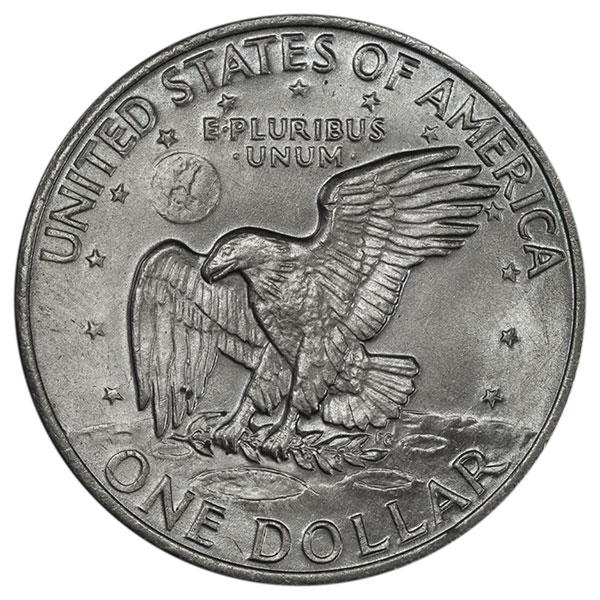
Obverse:
Gasparro’s portrait of Dwight D. Eisenhower (as President); Eisenhower facing to the left. Gasparro’s initials “FG” appear raised in the bust truncation. Beneath Eisenhower’s chin, to the left, is the motto “IN GOD WE TRUST” LIBERTY wraps around the top of the coin in the space between the rim and the top of Eisenhower’s head. The date wraps around the bottom of the design, between the rim and the bottom of Eisenhower’s bust truncation. While Philadelphia-struck pieces bear no mintmark, coins struck at Denver and San Francisco will bear small mintmarks of “D” or “S” above the space between the last two digits of the date. On Eisenhower dollars, mintmarks were hand-punched and may vary in exact location and orientation.
Reverse:
The reverse is based on Michael Collins’ Apollo 11 Mission Patch design.
In the center, a bald eagle in descent. In its talons, an olive branch. Its left wing is raised. The lunar surface lies below. Above the eagle’s head is a depiction of the Earth. North America is prominently visible. Wrapping around the top of the coin adjacent to the rim is the legend “UNITED STATES OF AMERICA.” Thirteen small five-point stars circle around the eagle. Below the ring of stars but above the eagle is the motto “E PLURIBUS UNUM”. Wrapping around the bottom of the design is the denomination “ONE DOLLAR”.
Edge:
The edge of the Eisenhower dollar is reeded.
Designer
Frank Gasparro was a friend to numismatists and served as Chief Engraver of the United States Mint from 1965 to 1981. View Designer’s Profile.
Coin Specifications
| Country: | United States |
| Year Of Issue: | 1972 |
| Denomination: | One Dollar |
| Mint Mark: | None |
| Mintage: | 75,890,000 |
| Alloy: | Copper-Nickel |
| Weight: | 22.68 grams |
| Diameter: | 38.1 mm |
| OBV Designer | Frank Gasparro |
| REV Designer | Frank Gasparro |
| Quality: | Uncirculated |
The post 1972 Eisenhower Dollar : A Collector’s Guide appeared first on CoinWeek: Rare Coin, Currency, and Bullion News for Collectors.
King Charles Portrait on New Canadian Coins
Earlier this week, on Nov
Lamar’s Centennial Coin Flip to Use Historic Gold Coin from 2023
A century-old, rare gold coin will be used for the coin flip at the Lamar University (www
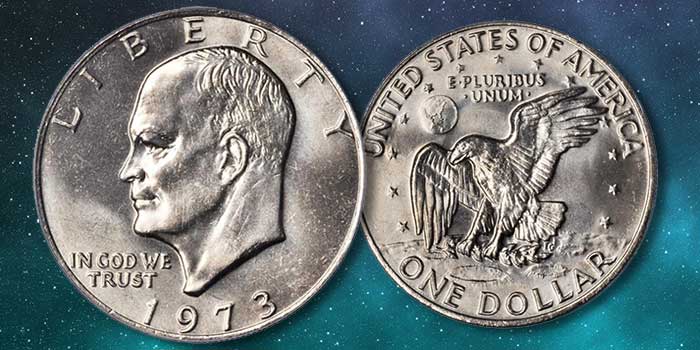
1973 Eisenhower Dollar : A Collector’s Guide

The 1973 Eisenhower Dollar was a Non-Circulating Legal Tender Coin
Production totals of Eisenhower dollars for the first two years of the series were enormous: a combined 116.38 million circulation strike coins in 1971 and a combined 168.44 million circulation strikes in 1972. While there was a good deal of collector enthusiasm for the Ike dollar, there was no practical need to circulate the large clad dollar coin. By 1973, it was apparent that the Eisenhower dollar would not fare any better than the Morgan and Peace dollars that preceded it.
For the 1973 issue, the Mint decided to forego striking additional dollar coins for circulation and instead produced two million from each mint for the purpose of inclusion in the annual Mint Set.
The United States Mint reported a total production run of two million 1973 Mint Sets. Ultimately, 1,769,258 sets were sold and the remaining 230,742 1973 (P) and D-mintmark Eisenhower dollars were destroyed. This has long been the published accounting for what happened to the remainder. However, an unconfirmed sighting of an open mint bag of 1973 Eisenhower dollars at a Florida coin shop was reported several years ago by Ike Group member Brian Vaile several years ago. If true, that would mean at least some small portion of the unpackaged mintage was released into circulation. Given that the issue is rarely encountered in circulated grades, CoinWeek assumes that any such emission would have been in very small numbers and quite probably, accidental.
Without the benefit of this explanation, it is easy to look at the mintages for each issue in the series and consider the 1973 and the 1973-D as “key dates”. They are not. Much scarcer in Mint State are the Philadelphia issues of 1971 and 1972, with the 1972 Type 2 reverse being the scarcest of all business strike coins in the series.
1973 Eisenhower dollars differ from 1971 and most 1972 circulation strike dollars in that they were struck from dies using hardened 52100 die steel, as opposed to the W-1 die steel used at the beginning of the coin’s production term. As a result, coins struck with the harder dies were more sharply struck, especially in early and middle die states. The die sinking issue that was also common on the left side of the obverse was also greatly reduced.
The limited production run and method of distribution of 1973 Eisenhower dollars has yielded few significant die varieties or mint errors. Collectors of so-called “Peg Leg” varieties may want to keep an eye on “OK” Peg Legs for the date. OK stands for “Off at the Knees”. The R on LIBERTY on this Peg Leg is so polished that half of the base of the R is absent.

What is the 1973 Eisenhower Dollar Worth?
The 1973 Eisenhower dollar carries a face value of one dollar, but the coin was never intended to circulate as such. While the 1971-S and 1972-S silver-clad coins were sold at high premiums to collectors, the Cu-Ni clad Eisenhower dollars were intended to be used in commerce as one dollar coins. The 1973 issue was different. It was the first Cu-Ni clad Eisenhower dollar released only in collector sets.
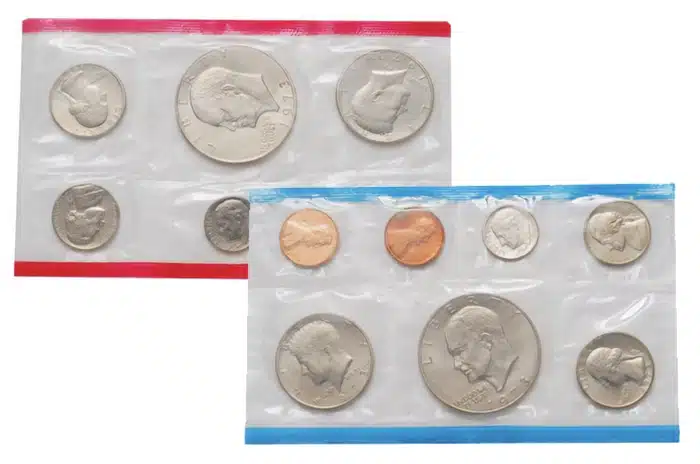
Interestingly, the 1973 Eisenhower dollar was also the first dollar coin to be issued in the Mint’s annual Uncirculated Coin Set. With the inclusion of two dollars face value of new coins, the price for the sets increased from $3.50 in 1972 to $6.00 in 1973. Today, a 1973 United States Mint Uncirculated Coin Set sells for about $18. Individually, ungraded 1973 Eisenhower dollars sell for about $8 a piece.
In Mint State 65, the 1973 Eisenhower dollar carries a retail price of about $25 according to CoinWeek IQ’s current market analytics. This low price does not reflect the difficulty in cherrypicking Gem-quality Eisenhower dollars of this issue in the wild. The quality of coins in mint sets varies dramatically and Choice Uncirculated examples (MS63) are not uncommon. In MS66, the 1973 Eisenhower Dollar sells in three strata. For non-CAC certified examples, MS66 coins sell for a range of $400-$450 at auction. This is a higher price level than we reported two years ago. High-quality specimens in MS66 with CAC approval can bring prices in excess of $600. Superlative examples with CAC approval and PQ toning will bring prices of $1,000 or more, and are highly coveted.
Up until the mid-2010s, MS66 was the top pop grade for Eisenhower dollars. Since 2016, a slow-but-steady trickle of coins have been certified by PCGS at MS66+. The record price paid for one at public auction was $7,637.50 from the Sonoran Monsoon Collection, which was built by former Navajo President Joe Shirley, Jr. Shirley built an impressive collection of U.S. dollar coins, but the quality of his top pop Ike dollars was surpassed by coins assembled by at least three rival collectors: Wang, Weaver, and Oskam.
The finest example that exists, according to our census, is the Sego-Weaver specimen, a CAC-approved MS66+ coin with plus eye appeal and fantastic toning. That coin was sold as part of a collection in 2017 in a Private Treaty sale.
Design
Obverse: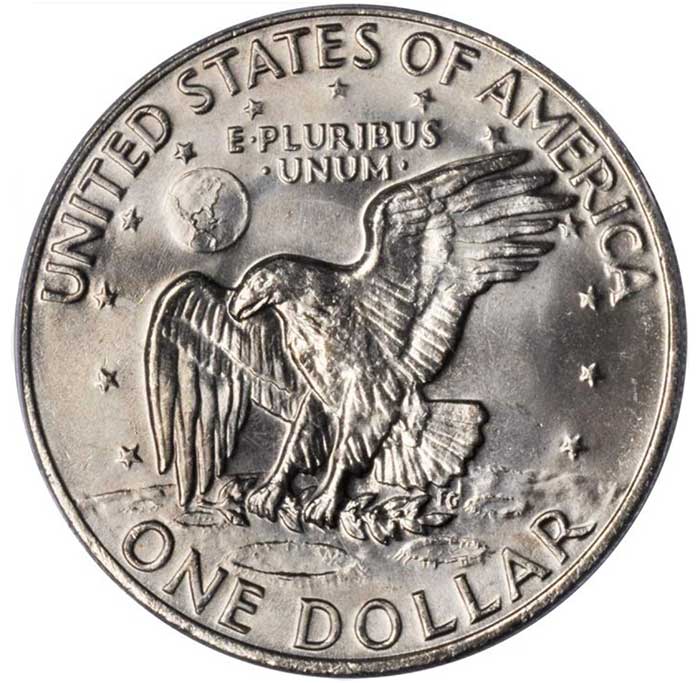
Gasparro’s portrait of Dwight D. Eisenhower (as President); Eisenhower facing to the left. Designer Frank Gasparro’s initials “FG” appear raised in the bust truncation. Beneath Eisenhower’s chin, to the left, is the motto “IN GOD WE TRUST” LIBERTY wraps around the top of the coin in the space between the rim and the top of Eisenhower’s head. The date wraps around the bottom of the design, between the rim and the bottom of Eisenhower’s bust truncation. While Philadelphia-struck pieces bear no mintmark, coins struck at Denver and San Francisco will bear small mintmarks of “D” or “S” above the space between the last two digits of the date. On Eisenhower dollars, mintmarks were hand-punched and may vary in exact location and orientation.
Reverse:
The reverse is based on Michael Collins’ Apollo 11 Mission Patch design.
In the center, a bald eagle in descent. In its talons, an olive branch. Its left-wing is raised. The lunar surface lies below. Above the eagle’s head is a depiction of the Earth. North America is prominently visible. Wrapping around the top of the coin adjacent to the rim is the legend “UNITED STATES OF AMERICA”. Thirteen small five-point stars circle around the eagle. Below the ring of stars but above the eagle is the motto “E PLURIBUS UNUM”. Wrapping around the bottom of the design is the denomination “ONE DOLLAR”.
Edge:
The edge of the 1973 Eisenhower dollar is reeded.
Designer
Frank Gasparro was a friend to numismatists and served as Chief Engraver of the United States Mint from 1965 to 1981 (View Designer’s Profile).
Coin Specifications
| Country: | United States |
| Year Of Issue: | 1973 |
| Denomination: | One Dollar |
| Mint Mark: | None (Philadelphia) |
| Mintage: | 2,000,000 |
| Alloy: | Copper-Nickel (Cu-Ni) |
| Weight: | 22.68 g |
| Diameter: | 38.1 mm |
| OBV Designer | Frank Gasparro |
| REV Designer | Frank Gasparro | Michael Collins |
| Quality: | Uncirculated |
The post 1973 Eisenhower Dollar : A Collector’s Guide appeared first on CoinWeek: Rare Coin, Currency, and Bullion News for Collectors.
Heritage’s Nov. 16-19 US Coins Auction Features a Trio of Exceptional Coins
If, as often has been said, it is true that “good things come in threes,” a trio of exceptional coins from an important collection could fare exceedingly well when they are sold in Heritage’s US Coins Signature® Auction November 16-19
Silver Scores 2.5-Month High, Gold Prices Rise 1.2%
Thursday saw gains in prices across all precious metals, with the strongest increases seen in silver, followed by gold, and weaker advances in palladium and platinum
Finest 15 Stars 1796 Half Dollar Offered by GreatCollections
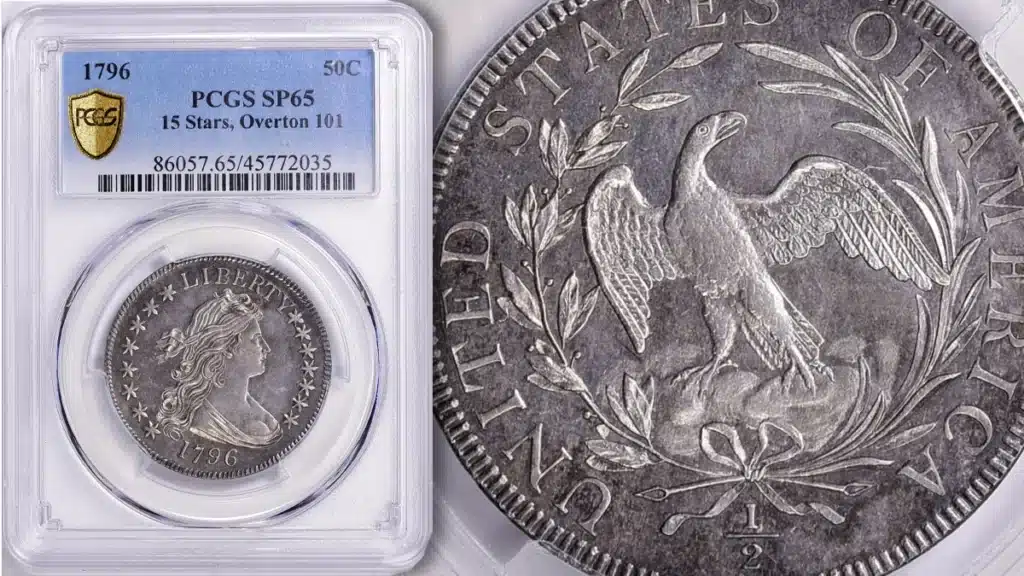
Graded Specimen 65 by PCGS, the finest known 15 Stars 1796 Draped Bust Half Dollar (Overton 101) is being offered by GreatCollections on Sunday, November 19 – the first time this coin has been on the market in almost 20 years. The only other example of this major U.S. coin rarity certified by either PCGS or NGC is graded SP63 and sold for $587,500 USD as part of the D. Brent Pogue Collection in 2015.
The coin offered in this week’s online auction is pedigreed to the Knoxville Collection, though this is not listed on the PCGS Gold Shield insert.
Why Is the 15 Stars 1796 Half Dollar so Rare and Valuable?
PCGS states that the total mintage for the business strike 15 Stars Overton 101 variety of the 1796 Draped Bust design half dollar is 934, but only two “Specimen” strikes–this coin and the other one previously mentioned–are known to have been produced by the United States Mint in Philadelphia. When one considers that the regular 15 Stars is already one of the rarest and hardest to acquire pieces in all of U.S. silver coinage, one can see how unique the current opportunity is – nevermind the impressive condition this specimen is in.
Overton numbers refer to die varieties originally catalogued by numismatist Al Overton in the book Early Half Dollar Die Varieties: 1794-1836. Some Overton numbers include a die state suffix (“a”, “b”, etc.), but numbers without a suffix designate master varieties. All 15 Stars 1796 Draped Bust half dollars are of the Small Eagle reverse type, as well.
As for the “15 Stars”, early federal coinage represented the individual states of the Union at the time of a coin die’s manufacture with a corresponding number of stars. When Tennessee became the 16th state on June 1, 1796, dies had to be made that included an additional star, 16 in total. The Mint, however, wasn’t about to throw away a perfectly good coin die so it continued to use a die with only 15 stars to strike half dollars even after a 16th state had become part of the country.
At the time of writing, the highest of 63 bids on this coin is $535,000.
* * *
To search through GreatCollection’s archive of over 600,000 certified coins the company has sold over the past eight years, please visit the GreatCollections Auction Archives.
* * *
The post Finest 15 Stars 1796 Half Dollar Offered by GreatCollections appeared first on CoinWeek: Rare Coin, Currency, and Bullion News for Collectors.
1971 Eisenhower Dollar : A Collector’s Guide

Why was the 1971 Eisenhower Dollar Made?
Even though the United States had no real need for a large dollar coin at the start of the 1970s, the gaming industry developed an acute need to find a replacement for the silver dollars it used to feed tens of thousands of slot machines. This “need”, and the recent passing of beloved war-hero-turned-President Dwight D. Eisenhower, presented Congress with an opportunity to cater to the needs of the industry. While United States Mint Director Mary Brooks lobbied for the coin to be struck in silver, Congress instead chose to strike the coin for circulation in the same copper-nickel (Cu-Ni) clad composition in use for the dime and quarter dollar. In a compromise, silver-clad versions were authorized to be struck and sold to collectors.
Signed into law by President Richard M. Nixon (formerly Eisenhower’s Vice President) on December 31, 1970, the Bank Holding Company Act Amendments of 1970 authorized the production of the coin.
(Incidentally, the amendments also authorized the General Services Administration (GSA) to sell 2.8 million Carson City Morgan dollars from the vaults of the United States Treasury.)
First-year production totals were large (47,799,000 for the 1971 Eisenhower Dollars struck at the Philadelphia Mint and 68,587,424 for the Denver-Mint-produced 1971-D Eisenhower Dollars) but paled when compared to the mintage of the 1971 Kennedy half dollar, which was struck in Cu-Ni clad for the first time this same year. While hundreds of millions of Eisenhower dollars were struck, with many millions entering circulation, the coin was more of a novelty item than a useful coin for the purposes of commerce.
How much is the 1971 Eisenhower Dollar Worth?
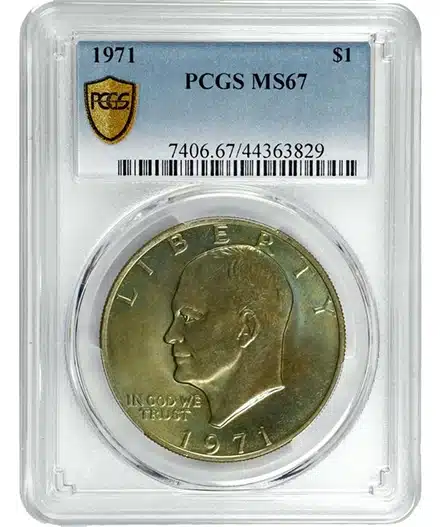
The 1971 Eisenhower dollar is worth a wide range of prices, from $1 for a beat-up circulated example, to potentially $10,000 or more dollars for virtually flawless examples in the Superb Gem grade of MS67. Finer examples have yet to be certified.
Why would a modern coin have such a range of values? The answer lies in the coin’s production history.
Creating a Cu-Ni Eisenhower dollar–a large silver-dollar format coin–proved to be quite a technical challenge. The Denver Mint, which began production of the coin a few weeks before Philadelphia, fared better. Coins struck at Denver have a sharper, cleaner look. Some even appear to have been struck on highly polished planchets. Most Philadelphia issues appear dull, lacking in luster, and have residual annealing chatter marks on the high points of the relief (typically on Eisenhower’s chin and hair).
As the business strike Eisenhower dollar was not issued in U.S. Mint annual sets until 1973, examples that survive in Mint State were originally saved from circulation. Because of this, uncirculated examples of the 1971 (P) issue are worth slightly more than issues struck in 1974 forward. The 1973 is a Mint Set-only issue and carries a slight premium, but truthfully, the 1971 (P) and 1972 (P) issues are more difficult to source in Mint State and should be worth more because of that.
In Mint State 65, the 1971 (P) carries a price of about $80 according to CoinWeek IQ’s current market analytics. This is significantly down from the pricing levels the coin has traded at in recent years. Rising TPG populations and a malaise in the modern coin market bears some responsibility. True gems with great eye appeal can sell for many times more. Our MS66 market price for the issue, as of November 2023, is about $600. CAC coins with very high eye appeal can bring premiums over this number.
Eisenhower Dollar Design
Obverse:
Gasparro’s portrait of Dwight D. Eisenhower (as President); Eisenhower facing to the left. Gasparro’s initials “FG” appear raised in the bust truncation. Beneath Eisenhower’s chin, to the left, is the motto “IN GOD WE TRUST” LIBERTY wraps around the top of the coin in the space between the rim and the top of Eisenhower’s head. The date wraps around the bottom of the design, between the rim and the bottom of Eisenhower’s bust truncation. While Philadelphia-struck pieces bear no mintmark, coins struck at Denver and San Francisco will bear small mintmarks of “D” or “S” above the space between the last two digits of the date. On Eisenhower dollars, mintmarks were hand-punched and may very in exact location and orientation.
Reverse:
The reverse is based on Michael Collins’ Apollo 11 Mission Patch design.
In the center, a bald eagle is in descent. In its talons, an olive branch. Its left wing is raised. The lunar surface lies below. Above the eagle’s head is a depiction of the Earth. North America is prominently visible. Wrapping around the top of the coin adjacent to the rim is the legend “UNITED STATES OF AMERICA.” Thirteen small five-point stars circle around the eagle. Below the ring of stars but above the eagle is the motto “E PLURIBUS UNUM”. Wrapping around the bottom of the design is the denomination “ONE DOLLAR”.
Edge:
The edge of the 1971 Philadephia Eisenhower dollar is reeded.
Designer
Frank Gasparro was a friend to numismatists and served as Chief Engraver of the United States Mint from 1965 to 1981 (View Designer’s Profile).
Coin Specifications
| Country: | United States |
| Year Of Issue: | 1971 |
| Denomination: | One Dollar |
| Mint Mark: | None (Philadelphia) |
| Mintage: | 47,799,000 |
| Alloy: | Copper-Nickel (Cu-Ni) |
| Weight: | 22.68 g |
| Diameter: | 38.1 mm |
| OBV Designer | Frank Gasparro |
| REV Designer | Frank Gasparro | Michael Collins |
| Quality: | Uncirculated |
The post 1971 Eisenhower Dollar : A Collector’s Guide appeared first on CoinWeek: Rare Coin, Currency, and Bullion News for Collectors.
US Mint Sales: 2023 Morgan & Peace Dollar Set Lasts 24 Hours
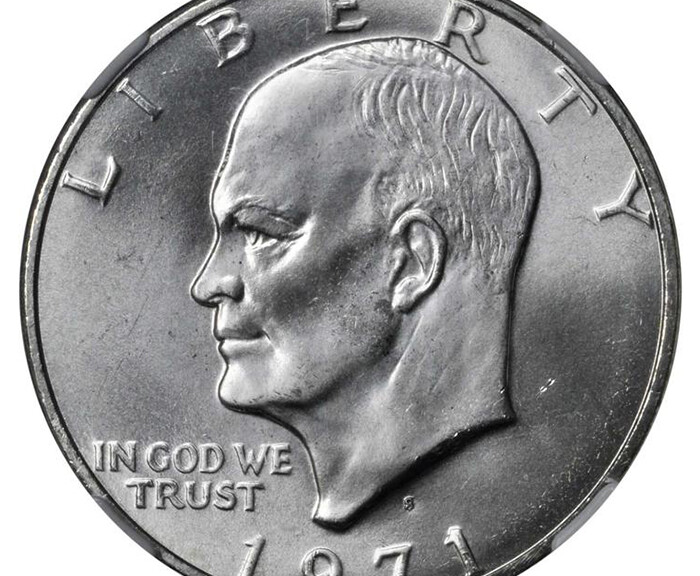
1971-S Eisenhower Dollar Uncirculated : A Collector’s Guide

While the country at large’s desire for a large dollar coin at the start of the 1970s was hardly demonstrable, the gaming industry developed an acute need to find a replacement for the silver dollars it used to feed tens of thousands of slot machines. This “need”, and the recent passing of beloved war-hero-turned-President Dwight D. Eisenhower, presented Congress with an opportunity to cater to the needs of the industry. While United States Mint Director Mary Brooks lobbied for the coin to be struck in silver, Congress instead chose to strike the coin for circulation in the same copper-nickel (Cu-Ni) clad composition in use for the dime and quarter dollar. In a compromise, silver-clad versions were authorized to be struck and sold to collectors.
Signed into law by President Richard M. Nixon (formerly Eisenhower’s Vice President) on December 31, 1970, the Bank Holding Company Act Amendments of 1970 authorized the production the coin. Incidentally, they also authorized the General Services Administration (GSA) to sell 2.8 million Carson City Morgan dollars from the vaults of the United States Treasury.
The striking of silver-clad Eisenhower dollars for collectors was controversial. Not only was the cost charged by the United States Mint for the coins excessive, but a portion of the proceeds from the sale of the collector versions was earmarked for the recently-established Eisenhower College in Seneca Falls, New York, which, thanks to Public Law 93-441, was set to receive a dispersal of “one-tenth of all the moneys derived from the sale of $1 [Eisenhower] proof coins”, with 10% of the total moneys received by the college being transferred to the campus’s Samuel Rayburn Library, with a maximum allocation of $9 million. In 1975, Congress raised that number by authorizing an additional appropriation of $1 million (Public Law 94-41).

The first 1971-S Eisenhower dollar was struck at the United States Assay Office in San Francisco (formerly the San Francisco Mint) on March 29, 1971. Eugene T. Rossides, the Assistant Secretary of the Treasury for Enforcement and Operations, and Mint Director Mary T. Brooks started production. The coins were fed into coinage presses and struck once. The four coin presses at San Francisco had the capability of producing 240,000 Eisenhower dollar coins per 8-hour shift.
1971-S Eisenhower Dollar (Blue Pack)
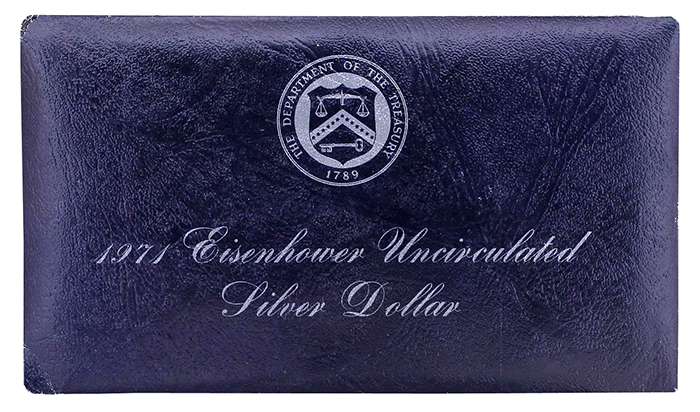
In terms of strike and quality, the 1971-S is the poorest of the Blue Pack Ike dollars. The substandard quality of the typical coin must have come to the attention of the United States Mint before the coins were offered for sale because packaged along with each silver-clad business strike coin was a special insert that clearly specified that no special care was taken during the production process.
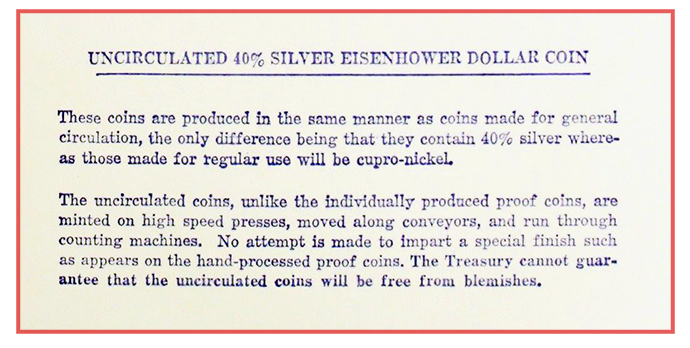
This fact is born out on each and every 1971-S Ike dollar that you will ever find, certified or uncertified. While the typical 1972-1974 Blue Pack Ike should grade in the MS66 to MS67 range, with excellent specimens earning MS68 and in rare instances MS69, the typical 1971-S Eisenhower dollar in the raw falls in the MS63 to MS65 range. The NGC and PCGS populations, which are comprised of pre-screened coins, typically in the higher register, bear this out.
NGC reports 2,859 examples in MS65; 2,358 examples in MS66; and 209 in MS67. Two examples earned NGC’s top population grade of MS68. PCGS has graded many more coins, but its grades bear out the same opinion. PCGS reports 2,194 examples in MS64; 9,633 in MS65; 8,135 in MS66; and 1,254 examples in MS67. To date, PCGS has certified seven examples in MS68 and one example in MS69. The PCGS population has exploded in recent years and further study into the quality of these coins is warranted.
Having personally seen three of the seven, we can report that the PCGS 68s are not of the same quality as 67s for the 1972-1974 issues. The MS69 issue would qualify as a strong MS68. It is our belief that none of these pieces would CAC. Furthermore, some MS67+ certified by PCGS could, in our opinion, upgrade to MS68 and be on par with, if not be superior to, three of the seven coins in PCGS MS68 holders. To date, CAC has not encapsulated a single 1971-S Eisenhower dollar. We expect this to change within a few months.

The market price for a 1971-S Eisenhower dollar in original government packaging is approximately $15 USD. Although the coin features less silver than a traditional silver dollar, the value of a 1971-S Eisenhower dollar in its original packaging will rise and fall depending on the price of silver. In certified grades, the coin can trade for considerably more. At MS65 and MS66, the 1971-S sells on online markets, such as eBay, for $18 to $25. The jump grade is MS67, where coins bring $250 and up, depending on eye appeal, CAC approval, and other factors. The record price paid at auction for a 1971-S Eisenhower dollar (non-variety) was $6,900, which was hammered in March 2012 at a Heritage auction. The market price for PCGS MS68 coins has trended downward in recent years as the population doubled from two to four pieces.
1971-S Eisenhower Dollar Varieties – The FS-401 “Peg Leg”

The FS-401 variety is known by generalists as the “Peg Leg” variety. Researcher Rob Ezerman dedicates four chapters of Collectible Ike Varieties to a discussion of the Peg Legs, which also appear (with great frequency) on the Proof issues of 1971. Ezerman calls the FS-401 the Fading Peg Leg and differentiates it from the non-FS-401 “Straight Peg Leg” variety.
If Ezerman is correct, then approximately 100,000 to 150,000 examples of this variety were struck. This estimate might be an overstatement by degree, as to date, only 467 have been certified by PCGS and five by NGC. Certified populations on modern coins can be misleading, however, as it’s highly doubtful that much of a market would exist today for even 5,000 examples of this variety in certified holders.
Diagnosing an FS-401 Fading Peg Leg is fairly straightforward. The lack of serifs is most apparent on the base of the E, the back leg of the R, and the left arms of the T and Y. One of two known FS-401 dies features obverse die doubling. The DDO is notched at the tips of the U of “TRUST” and the base of the O and D of “GOD”. The non-DDO FS-401 will sometimes appear coupled with a Doubled Die Reverse.
The 1971-S Eisenhower FS-401 trades for about $40 in original government packaging. Certified examples in the top population grade of MS67, certified by PCGS or NGC, trade for about $300.
1971-S Eisenhower Dollar Varieties – The FS-501 “S/S RPM”
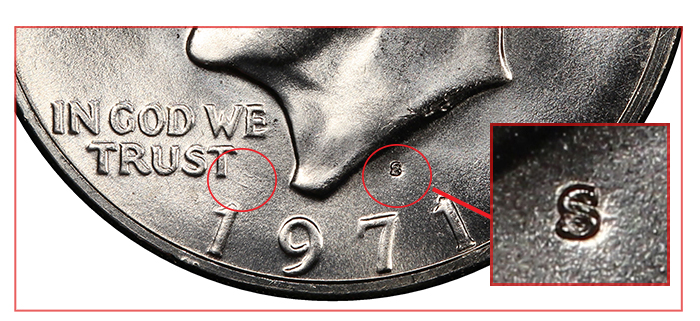
The FS-501 “S/S RPM” is a Cherrypicker’s Guide variety and one of the best-known RPMs of the short series. The repunched mintmark is clearly visible under a loupe on coins struck with fresh dies but can be difficult to differentiate as the dies wear down.
Fortunately, a major marker exists to the left of the T in TRUST and above 1 in the date in the form of a pair of diagonal line segments. This marker can be seen through the pliofilm packaging of a blue pack Ike dollar and is a very easy naked-eye pick for specialists.
The 1971-S Eisenhower FS-501 trades for about $40 in original government packaging. Certified examples in MS66, certified by PCGS or NGC, trade for about $200. A single MS67 is reported in the PCGS population census. This coin sold at Heritage for $8,813 in January 2016. The presence of a second (or third!) example in this grade would likely halve the market value of that specimen.
Design
Obverse:
Frank Gasparro’s portrait of Dwight D. Eisenhower (as President); Eisenhower facing to the left. Gasparro’s initials “FG” appear raised in the bust truncation. Beneath Eisenhower’s chin, to the left, is the motto “IN GOD WE TRUST” LIBERTY wraps around the top of the coin in the space between the rim and the top of Eisenhower’s head. The date wraps around the bottom of the design, between the rim and the bottom of Eisenhower’s bust truncation. While Philadelphia-struck pieces bear no mintmark, coins struck at Denver and San Francisco will bear small mintmarks of “D” or “S” above the space between the last two digits of the date. On Eisenhower dollars, mintmarks were hand-punched and may vary in exact location and orientation.
Reverse:
The reverse is based on astronaut Michael Collins’ Apollo 11 Mission Patch design.
In the center, a bald eagle in descent. In its talons, an olive branch. Its left wing is raised. The lunar surface lies below. Above the eagle’s head is a depiction of the Earth. North America is prominently visible. Wrapping around the top of the coin adjacent to the rim is the legend “UNITED STATES OF AMERICA.” Thirteen small five-point stars circle around the eagle. Below the ring of stars but above the eagle is the motto “E PLURIBUS UNUM”. Wrapping around the bottom of the design is the denomination “ONE DOLLAR”.
Edge:
The edge of the 1971-S Eisenhower dollar is reeded.
Designer
Frank Gasparro was a friend to numismatists and served as Chief Engraver of the United States Mint from 1965 to 1981 (View Designer’s Profile).
Coin Specifications
| Country: | United States |
| Year Of Issue: | 1971 |
| Denomination: | One Dollar |
| Mint Mark: | S (San Francisco) |
| Mintage: | 6,868,530 |
| Alloy: | Outer layer: 80% silver, 20% copper; Inner Core: 20.9% silver; 79.1% copper |
| Weight: | 24.59 grams |
| Diameter: | 38.1 mm |
| OBV Designer | Frank Gasparro |
| REV Designer | Frank Gasparro | Michael Collins |
| Quality: | Uncirculated |
The post 1971-S Eisenhower Dollar Uncirculated : A Collector’s Guide appeared first on CoinWeek: Rare Coin, Currency, and Bullion News for Collectors.
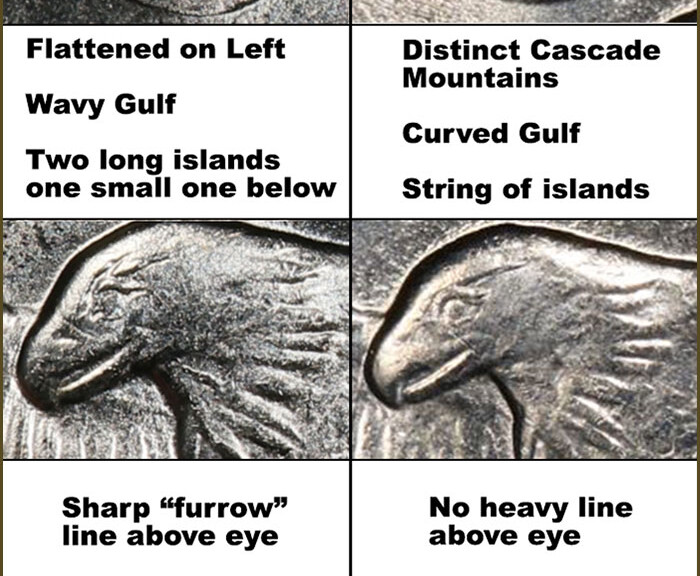
1971-D Eisenhower Dollar : A Collector’s Guide

While large silver dollar coins saw little practical circulation in America’s more populated regions, the coins did see use in the American West, where the durability of metal over paper gave coins a clear advantage. Nowhere did American silver dollars flow more freely than at the gambling cities of Reno and Las Vegas, where silver dollars were the currency of choice for casino slot machines.
However, as demand for these silver dollars increased, the supply began to dwindle. Treasury stockpiles of the coins dwindled in the 1960s, which left the gaming industry with a bit of a dilemma. With the March 1969 death of Dwight D. Eisenhower, Congressional openness to reintroducing a circulating dollar coin to honor the former president took root.
Mint Director Mary Brooks initially lobbied for the coin to be struck in silver, continuing with tradition. However, Congress had no interest in continuing to produce circulating coins in silver. The Coinage Act of 1965 called for the removal of silver from America’s dimes and quarters and reduced the silver content of half dollars from .900 fine to a 40% silver-clad composition. In the five years since the composition change, silver coins all but disappeared from circulation and the silver-clad Kennedy half dollars saw very limited use.
Signed into law by President Richard M. Nixon on December 31, 1970, the Bank Holding Company Act Amendments of 1970 authorized the production of the Cu-Ni clad Eisenhower dollar for circulation. The Act also allowed for the production of numismatic versions struck from a 40% silver composition to be sold at a significant premium over face value to collectors. These coins would be produced at the San Francisco Mint and sold directly by the United States Mint. The Act also carried an important provision that authorized the General Services Administration (GSA) to sell 2.8 million Carson City Morgan dollars from the vaults of the United States Treasury.)
1971-D Eisenhower Dollars Were Struck First
The Denver Mint was the first mint to strike Eisenhower dollars in 1971, beating the Philadelphia Mint by a few weeks. In total, the Denver Mint produced 68,587,424 1971-D Eisenhower dollars, while the Philadelphia Mint struck 47,799,000 coins. These were significant numbers compared to the mintages of the later mintages of America’s Morgan and Peace silver dollars.
Creating a Cu-Ni Eisenhower dollar–a large, silver-dollar format coin–proved to be quite a technical challenge. Despite the fact that the Denver Mint’s presses were older than the presses at the newly finished Philadelphia facility, the Denver Mint typically produced better dollar coins.
Coins struck at Denver typically have a sharper, cleaner look. Many are fully lustrous, and some were struck on highly polished planchets. By contrast, most Philadelphia issues appear dull, lacking in luster, and have residual annealing chatter marks on the high points of the relief (typically on Eisenhower’s chin and hair).
Despite this overall cleaner look, the 1971-D Eisenhower dollar does have a tendency to show significant amounts of die sink along the bottom periphery. On the coin illustrated above, you can see evidence of this along the bottom of the design through the date and flattening the first few letters of the motto: IN GOD WE TRUST.
How Much are 1971-D Eisenhower Dollars Worth?
For coins struck after World War II, Mint Sets have serves as the primary source for high quality uncirculated coins for any given date. The tradition of producing mint sets dates back to the late 1940s, when they first debuted. Initially, these sets included two examples of each coin – one mounted face up and one face down in cardboard holders. This allowed collectors to admire both sides of the coin without removing them from the packaging.
In 1959, the Mint replaced the cardboard-mounted double mint set with a single coin mint set that housed one coin of each denomination from each mint in a cellophane holder. Curiously, the Mint did not redesign this packaging to include Eisenhower dollars until 1973. The implications of this is that the 2,193,396 uncirculated sets sold of the Mint’s 1971 coins do not include uncirculated examples of the Eisenhower dollar, which means that there are far fewer uncirculated 1971 and 1971-D Eisenhower dollars in the market than there are for coins issued from 1973 to 1978.
Americans did save quantities of the 1971-D Eisenhower Dollar, however. It is common that the American public demonstrates added enthusiasm for saving the first or last coin in a series. The first coin is saved out of enthusiasm for a new design and the desire to save one, or more, as souvenirs. The last coin is saved as a way to preserve a moment in time. By our estimation more 1971 Eisenhower dollars were saved in Mint State than 1972 dollars.
So what are 1971-D Eisenhower dollars worth? The answer is surprising. At a minimum, a 1971-D Eisenhower dollar has a face value of $1, which means that it can be used to buy $1 worth of goods, even today. Coin collectors are willing to pay between $3 and $10 for 1971-D Eisenhower dollars in About Uncirculated / Uncirculated condition.
The value of the coin increases dramatically in high uncirculated grades starting at MS65 and above. One caveat though, generally speaking, when modern coins are attributed as being graded MS65 or MS66, collectors expect that coins have been professionally graded and encapsulated in CAC, NGC, or PCGS holders.
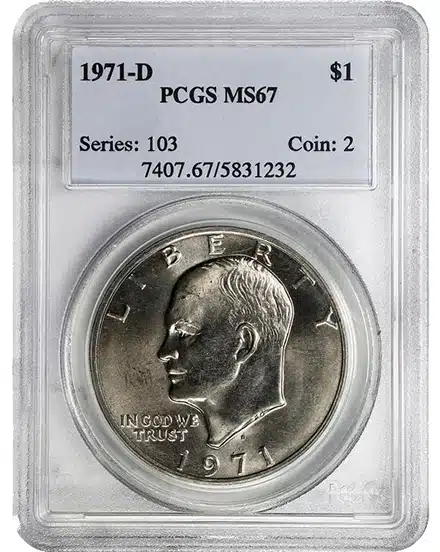
In Mint State 65, the 1971-D carries a price of about $30 according to CoinWeek IQ’s current market analytics. It is a first-year-of-issue and type coin that carries a significant numismatic premium in ultra-high grades (or if it is a gem-quality “Friendly Eagle Variety” – more on that in a moment).
In Mint State 67, auction records indicate that the value of this issue at this level has fallen dramatically from where it was four or five years ago when a typical example might bring $1,500. These prices dropped to about $600 in 2020 and has since come back to about $900 today. Stack’s Bowers sold a mid-range example graded PCGS MS67 for $840 in April 2023.
The three finest examples that we’ve ever seen are the two MS67s from the Richland Ikes Collection, assembled by Ike Group founder Andy Oskam, and another MS67 that was part of Troy Weaver’s amazing registry set (now owned by Del Loy Hansen). Weaver’s example was a Peg Leg (die polished R) variety with a Talon clash mark on Ike’s forehead.
But perhaps the best of all was the modestly-toned NGC MS68 that brought an eye-popping $8,225 at a March 2020 Legend Rare Coin Auction. This has to be the highest price ever paid for a 1971-D clad Ike dollar and to date, PCGS has certified no coins at this level.
The 1971-D (RDV-006) “Friendly Eagle Variety”
Discovered in 1999 by variety specialist Dr. James Wiles and popularized in the subsequent decade by the Ike Group, the 1971-D “Friendly Eagle Variety” is a naked-eye-visible variety that is not as easy to cherrypick as it once was (you can blame CoinWeek Editor Charles Morgan for lobbying for the coin to get into the Cherrypicker’s Guide’s 5th edition and the Red Book).
The Friendly Eagle features a rounded Earth (the regular issue is not as perfectly round at the upper left area of the globe). On that rounded Earth, you will see a rounded and distinctly carved out Gulf of Mexico and a distinct chain of islands in the Caribean. The eagle’s brow is softer (one might say “friendlier”) than the standard issue. There is no heavy separation apparent in the relief between the top two of the eagle’s tailfeathers on this variety. Also, the lines leading up to the impact ejecta “lines” of the crater are longer, more distinct, and bracket the second L in DOLLAR. In Very Early Die State, some FEVs show a contrail-shaped die scratch bordering the upper left portion of the globe. This feature was discovered by Ike Group member Brian Vaile.
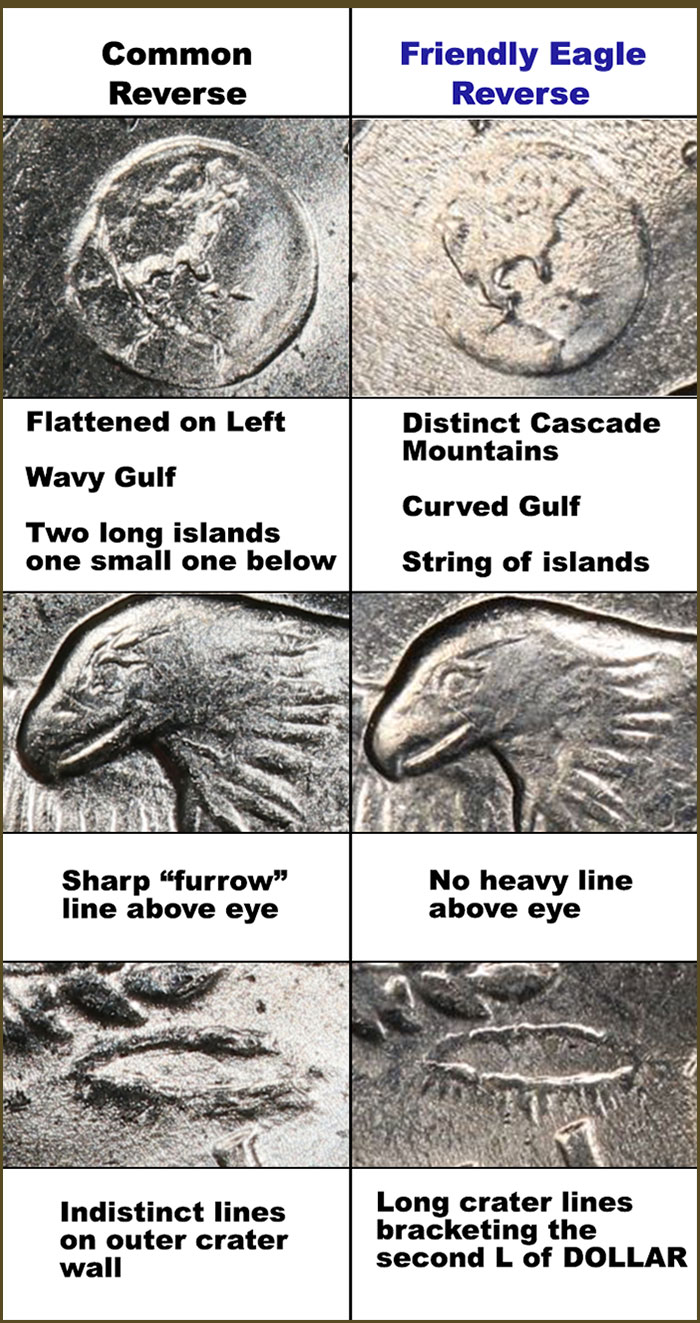
As for scarcity, the Friendly Eagle is not rare but probably represents no more than one million to 1.5 million of the issue’s 68,587,424 struck. Ike dollar specialists consider this a major variety and a semi-key to the series, the key being the 1972 “Type 2” variety.
In MS65, the FEV sells for $100-$125. To date, PCGS reports 66 examples in MS66 with 3 in MS66+. No MS66+ has sold at public auction. MS66 examples have sold for $500 or more. One example, sold in July 21, 2022 by Heritage Auctions slipped through the cracks after the firm misrepresented its population data and offered collectors no information about the variety in the lot description. In that instance, the lucky buyer was able to acquire a $400-$500 coin for $204.
To our knowledge, no finer coins have been certified by NGC. Both services charge a fee to attribute this variety.
Description
Obverse:
Frank Gasparro’s portrait of Dwight D. Eisenhower (as president); Eisenhower facing to the left. Gasparro’s initials “FG” appear raised in the bust truncation. Beneath Eisenhower’s chin, to the left, is the motto “IN GOD WE TRUST” LIBERTY wraps around the top of the coin in the space between the rim and the top of Eisenhower’s head. The date wraps around the bottom of the design, between the rim and the bottom of Eisenhower’s bust truncation. While Philadelphia-struck pieces bear no mintmark, coins struck at Denver and San Francisco will bear small mintmarks of “D” or “S” above the space between the last two digits of the date. On Eisenhower dollars, mintmarks were hand-punched and may vary in exact location and orientation.
Reverse:
The reverse is based on Michael Collins’ Apollo 11 Mission Patch design.
In the center, a bald eagle in descent. In its talons, an olive branch. Its left wing is raised. The lunar surface lies below. Above the eagle’s head is a depiction of the Earth. North America is prominently visible. Wrapping around the top of the coin adjacent to the rim is the legend “UNITED STATES OF AMERICA.” Thirteen small five-point stars circle around the eagle. Below the ring of stars but above the eagle is the motto “E PLURIBUS UNUM”. Wrapping around the bottom of the design is the denomination “ONE DOLLAR”.
Edge:
The edge of the 1971-D Eisenhower dollar is reeded.
Designer
Frank Gasparro was a friend to numismatists and served as Chief Engraver of the United States Mint from 1965 to 1981 (View Designer’s Profile).
Coin Specifications
| Country: | United States |
| Year Of Issue: | 1971 |
| Denomination: | One Dollar |
| Mint Mark: | D (Denver) |
| Mintage: | 68,587,424 |
| Alloy: | Copper-Nickel (Cu-Ni) |
| Weight: | 22.68 g |
| Diameter: | 38.10 mm |
| OBV Designer | Frank Gasparro |
| REV Designer | Frank Gasparro | Michael Collins |
| Quality: | Uncirculated |
The post 1971-D Eisenhower Dollar : A Collector’s Guide appeared first on CoinWeek: Rare Coin, Currency, and Bullion News for Collectors.
Century-Old Gold Coin to Be Used in College Football Coin Flip

Football is known for its share of collectibles, but it’s not often associated with century-old United States gold coins worth $2,100.
Michael Fuljenz, President of Universal Coin & Bullion in Beaumont, Texas, has donated a 1923 Saint-Gaudens $20 double eagle to be used for the coin flip at the upcoming Lamar University Cardinals home game on November 18, 2023, versus the McNeese State University Cowboys. With its gold content (.9765 ounces) worth slightly more than $1,900 at the time of publication–plus a numismatic premium that brings about $200–the historic gold coin is valued at around $2,100.
It is also the last game of the season for the Lamar Cardinals.
“The coin was struck at the Philadelphia Mint and like Lamar University, it is 100 years old this year. I was honored to be asked to do the coin flip for the teams and decided to use the 1923 gold coin, then donate it to Lamar as a symbolic representation of the school’s centennial,” said Fuljenz.
Michael Fuljenz has supported the academic and athletic programs at Lamar and McNeese universities, both local to the East Texas/West Louisiana region, over the years. Lamar University in Texas recognized Fuljenz with a 3T (Time Talent and Treasure) Award in 2007 and McNeese State University in Louisiana presented him with an honorary Doctorate of Humane Letters in 2015. Professionaly, he was named Dealer of the Year by the American Numismatic Association (ANA) in 2021 and earlier this year received the organization’s highest honor, the Chester L. Krause Memorial Distinguished Service Award.
As stated in this CoinWeek IQ coin profile, the 1923 coin was designed by renowned American sculptor Augusts Saint-Gaudens, whose design was used on the $20 double eagle denomination gold coins from 1907 to 1933. In 1923, three of those gold coins with a combined face value of only $60 would have paid tuition and books for a semester at either school. Today, 100 years later, the gold value of those same three coins would also pay for tuition and books for a semester.
The post Century-Old Gold Coin to Be Used in College Football Coin Flip appeared first on CoinWeek: Rare Coin, Currency, and Bullion News for Collectors.
Gold Dips as Other Precious Metals Rise on Wednesday, Nov. 15
Wednesday saw good gains in most precious metals, with the exception of gold, which experienced its first loss in three sessions, albeit a relatively small one
Coinfully Announces Doug Winter as Chief Numismatic Advisor
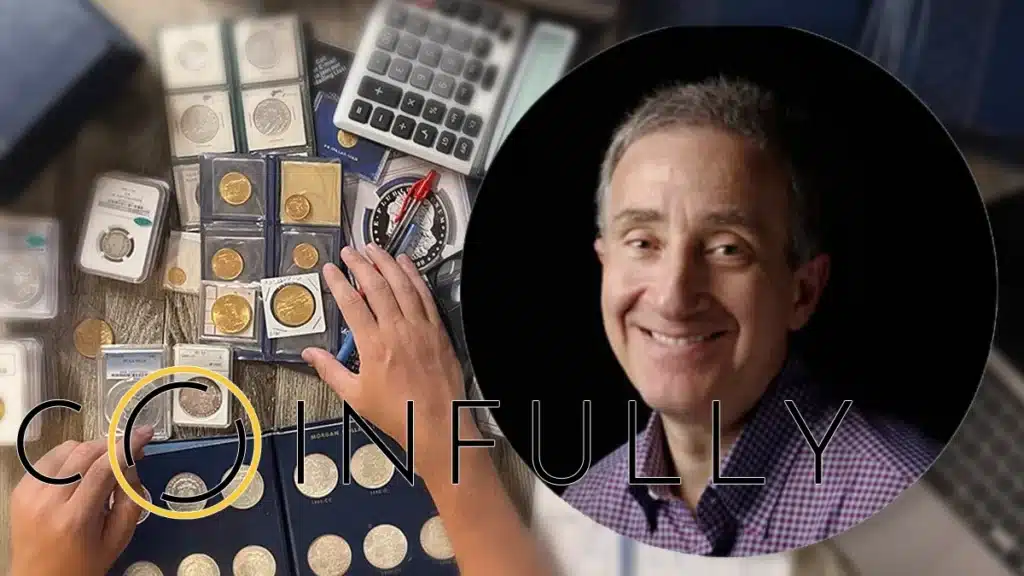
U.S. gold expert and veteran coin dealer Doug Winter, owner of Douglas Winter Numismatics (DWN), is now the Chief Numismatic Advisor for the firm Coinfully, which is based in Charlotte, North Carolina and run by brothers Travis and Wyatt McDonald. The company buys and appraises coins through an easy-to-use online process.
With fewer expenses than a brick-and-mortar coin dealership, Coinfully can pay more for coins and reach more collectors from all over the United States.
Doug started collecting coins before the age of 10 years, setting up his first bourse floor table at the age of 13. He began his professional career in the coin industry in 1982 at Heritage Auctions but soon founded his own company in 1985. For almost four decades, Doug has specialized in the buying and selling of Choice United States gold coins, with a particular emphasis on Charlotte, Dahlonega, and New Orleans gold and pre-1834 federal gold.
Travis and Wyatt McDonald are the sons of numismatist Debbie McDonald, whom Doug has known for a long time. Debbie herself was involved in the sale of some of the most historic and important collections of rare U.S. coins ever sold, such as the Louis Eliasberg Collection, the Harry W. Bass, Jr. Collection, and the Norweb Collection.
In a recent interview, Doug said:
“It’s been really fun for me to watch Travis and Wyatt grow from the early days … It’s been very gratifying to see them build their successful business around coin collecting. My role will be to provide specialist numismatic expertise as and when needed. Coinfully gives a seller an opportunity to get a fair offer that wouldn’t be available to 90-plus per cent of the prospective sellers in the coin market. They’re levelling the playing field for people and doing a very effective job of that.”
Coinfully CEO Travis McDonald said:
“Doug’s involvement with Coinfully is validation that what Wyatt and I have made to be our life’s work is on the right track. We have looked to Doug for many years for support and guidance on topics as diverse as ethics, numismatic attributions and pricing. His wealth of knowledge is the best resource we could possibly have.”
* * *
The post Coinfully Announces Doug Winter as Chief Numismatic Advisor appeared first on CoinWeek: Rare Coin, Currency, and Bullion News for Collectors.
Flashback: Collector’s $100,000 Gold Coin Sells for $5,000 After He Ruins It!
The results are in…
By CoinWeek News Staff….
In an Uncool Coins! 4K video segment, CoinWeek brought you the heartrending story of an 1850 Liberty $20 Double Eagle gold coin–graded MS-64 Proof-like by NGC (the only one of its kind)–that a buyer (who shall forever remain anonymous) cracked out of its holder and “made better” – despite the efforts and admonitions of Maryland-based coin dealer Julian Leidman of Bonanza Coins.
Mr. Leidman is a deft storyteller, and the yarn he weaves in the video is fascinating and tragic. No synopsis can do his delivery justice, so we highly recommend you watch the segment if you haven’t already. Suffice it to say that what was once a conditionally-rare six-figure coin was ruined by an enthusiastic yet stubborn and ill-informed collector.
A cautionary tale for the ages.
At any rate, as stated in the video, Mr. Leidman did in fact post the coin on eBay for 99 cents on January 13, 2016 in a true “no reserve” auction. But by the end of the first day, bidding had taken the price up to US $1,959.00.
Bidding then stalled but picked back up a week later, when it went as high as $2,968.50 on the 20th.
A day later, the coin was going for $5,018.50.
The final day of bidding (Saturday, Jan. 23) started at $5,250, and by auction’s close the winner of the melancholy 1850 Liberty double eagle was in for a grand total of $6,111.99. This represents an almost 617,273% increase in price from the starting bid for the raw and cleaned coin.
Additionally, at the time of writing the spot price of one troy ounce of pure gold was $1,107.70, making the .900 gold 1850 double eagle worth about $1,071.69 in melt.
Market analysts, take note.
But remember… to err is human and forgiveness–no matter how coarse manners and culture have gotten in this day and age–is still divine, so have a little sympathy for the original buyer, who purchased the coin for $102,000 ($127,900 adjusted for inflation) at a Blanchard’s sale in 2004.
The post Flashback: Collector’s $100,000 Gold Coin Sells for $5,000 After He Ruins It! appeared first on CoinWeek: Rare Coin, Currency, and Bullion News for Collectors.
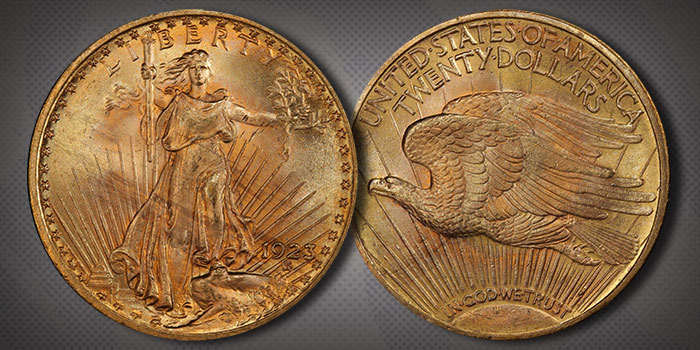
1923 Saint-Gaudens $20 Double Eagle Gold Coin : A Collector’s Guide

The Saint-Gaudens $20 gold double eagle is one of the most famous of all American coin types, acclaimed as one of the most beautiful and artistic numismatic designs ever realized in the United States. Its existence came only at the insistence of President Theodore Roosevelt (in office 1909-09), who sought for years to beautify America’s humdrum coin designs.
American sculptor Augustus Saint-Gaudens’ involvement in the process was meant to be more far-reaching than it turned out to be. The artist set out to redesign every denomination of America’s circulating coinage but fell seriously ill before this plan could come to fruition. In fact, what we have in the form of the Saint-Gaudens-designed $10 and $20 gold coins were made possible only due to the work of Saint Gaudens’ assistant Henry Hering.
The Mint’s first strikings of this $20 design came in the form of two dozen Proofs struck in March of 1907, each coin requiring nine impressions to realize the full detail of Saint-Gaudens’ high-relief design.
The Mint’s engraving department, led by Chief Engraver Charles Barber, was adamant that the high-relief models were completely impractical for use in striking circulating coins. Barber is often slandered in numismatic circles as being entitled, hard to deal with, and unprofessional to his peers in the United States Mint engraving department and to outside artists.
This could not be farther from the truth. And in the case of the double eagle design, he was absolutely correct! After a few versions of the double eagle proved too difficult to strike, Barber modified Saint-Gaudens’s design, lowering the relief so the coin could be struck with only one blow.
When the coins were finally released in 1907, they proved controversial as they lacked the national motto “In God We Trust“, which President Roosevelt objected to on religious grounds. Even though the Coinage Act of 1890 did not include that motto among the mandatory legends and inscriptions to be placed on U.S. coins (perhaps an unintended omission), both Congress and the public nevertheless wanted it there. The motto was restored (it was on the previous Liberty Head type) later in 1908 by Congressional action, which brought the double eagle into compliance with the Act of March 3, 1865, the original mandate for the text.
There was one more significant modification of the double eagle before President Franklin Delano Roosevelt ended circulating gold coinage in 1933. In 1912, the number of stars encircling Liberty on the obverse was increased from 46 to 48, marking the addition of New Mexico and Arizona to the Union.
The 1923 Saint-Gaudens $20 Double Eagle in Today’s Market
The 1923 Saint-Gaudens $20 double eagle had a mintage of 566,000 pieces. In a series where so many key issues have been lost to government seizure and the melting pot, mintage totals are inefficient predictors of overall rarity. As it stands, the 1923 sits amongst a run of Philadelphia Mint issues starting in 1920 and continuing through 1928 that comprises the core of the generic Saint-Gaudens market.
The term “generic” may be offputting to some, but in the rare coin industry, it describes a coin that has only a basic value over the coin’s intrinsic worth. In the raw, an About Uncirculated or Brilliant Uncirculated example would routinely trade at the prevailing spot price. In certified grades of MS63 and MS64, these generic Saint-Gaudens issues carry a premium of approximately 15% over spot price.
The market values for 1923 Saint-Gaudens $20 double eagles radically depart from this percentage at the grade MS65 and above. In MS65, the 1923 Saint sells for around $5,000. A strong premium is offered for CAC-approved examples at MS65. In lower grades, this is not necessarily the case.
The top certified grade for the 1923 is MS66 and as of the date of publication of this article, PCGS reports six pieces with three discrete examples illustrated on Coinfacts and NGC reports one specimen at this grade. The record price paid for one at this level is $72,000 USD at a May 2022 Heritage sale.
The Dr. Steven Duckor specimen (which we used to illustrate this article) was a previous record holder, having sold for $48,875 in November 2005. At the time of that sale, the Duckor piece was one of only two graded at MS66. The Duckor example has since sold two more times: for $36,800 in February 2008 and for $40,250 in January 2012. A different MS66 specimen brought $33,600 in a June 2019 Heritage auction.
One major factor driving up the cost of the 1923 Saint Gaudens double eagle in MS66 is not necessarily its rarity but the comparative ease of acquisition for the most affluent registry set participants. Whereas each grading point helps these collectors acquire positions in the set leaderboards, generic issues tend to provide a more affordable and more frequent opportunity to better the set. Contrast the ease of acquisition of the finest 1923 to any Mint State example of the 1927-D and you will see this factor at play.
Doubling back to an earlier part of this analysis where we mentioned the term “generic”. It’s true that no two coins are alike and that coins with exceptional eye appeal excite collectors regardless of rarity. The 1923 is a good example of a coin that is traded in a variety of ways and is to be considered differently depending on a number of factors that may seem obtuse to beginner collectors. It is a common date for telemarketers and late-night coin shows, but at the highest levels of the grading spectrum, where examples are few, it is also an issue that draws significant interest in national auctions.
Saint-Gaudens $20 Double Eagle Design
Obverse:
The obverse features a full-length image of Liberty, facing forward with an olive branch in her extended left hand and a raised torch in her extended right. Draped in a long, flowing classical gown, her hair is swept to the left. Some describe her as striding forward, but she appears instead to be in a pose; the foot of her left leg resting on a large rock (in front of which are oak leaves). Henrietta “Hettie” Anderson served as Saint-Gauden’s primary model. To Liberty’s right, at the bottom of the coin, the sun is visible behind a depiction of the U.S. Capitol building. Rays from the sun extend upward from behind the Capitol and Liberty to about the level of Liberty’s waist. At the top of the coin is the word LIBERTY, the torch separating I and B. Forty-eight tiny six-pointed stars are arrayed just inside the flat rim, forming a circle broken only at the bottom.
The date in ‘Arabic’ numerals is near the bottom on the right; a monogram of the designer’s initials ASG is below the date.
Reverse:
The crest of the sun appears again on the reverse, at the bottom with rays extending upward nearly to the top of the coin behind a majestic left-facing eagle, wings uplifted in flight. In an arc above the sun is IN GOD WE TRUST, the words separated by centered triangular dots. At the top is UNITED STATES OF AMERICA in a concentric arc next to the flat rim, with TWENTY DOLLARS just below in another arc. The words of both phrases are separated by centered triangular dots, and the text is also in front of the sun’s rays.
Edge:
The motto E PLURIBUS UNUM, in raised letters that alternate with 13 raised stars, is on the edge of the coin.
Designer
Augustus Saint-Gaudens (1848-1907) was a European-educated American sculptor, notable for numerous public monuments and other works in the Beaux Arts style. Working with President Theodore “Teddy” Roosevelt, he is responsible for some of the most beautiful numismatic designs in American history, such as the gold $10 eagle and the gold $20 double eagle.
Coin Specifications
| Country: | USA |
| Year Of Issue: | 1923 |
| Denomination: | 20 Dollars (USD) |
| Mint Mark: | None (Philadelphia) |
| Mintage: | 566,000 |
| Alloy: | .900 Gold |
| Weight: | 33.44 g |
| Diameter: | 34.00 mm |
| Edge: | Lettered |
| OBV Designer | Augustus Saint-Gaudens |
| REV Designer | Augustus Saint-Gaudens |
| Quality: | Business Strike |
* * *
The post 1923 Saint-Gaudens $20 Double Eagle Gold Coin : A Collector’s Guide appeared first on CoinWeek: Rare Coin, Currency, and Bullion News for Collectors.
Highlights From Künker eLive Premium Auctions 398 and 399
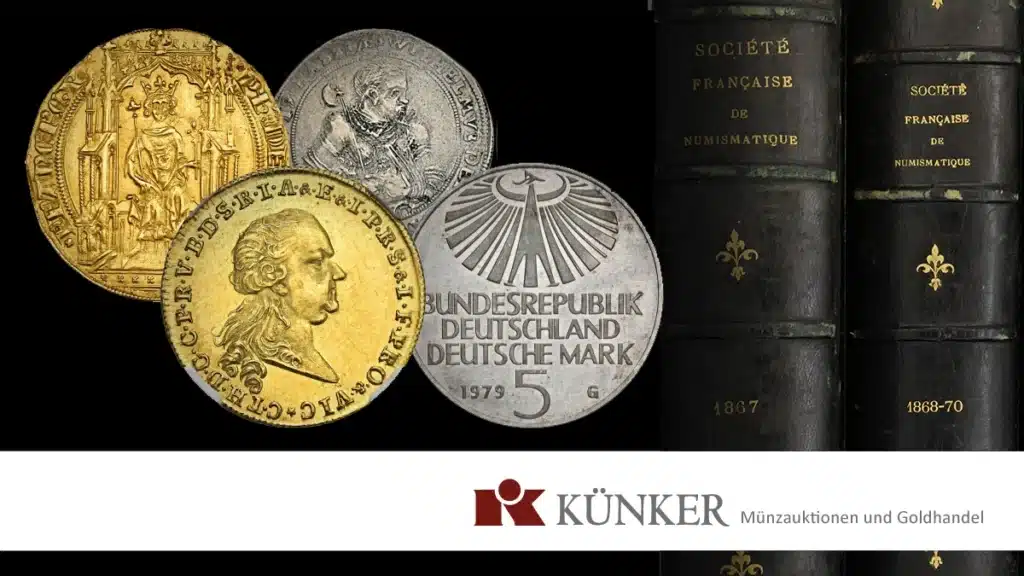
Dear bidders and coin enthusiasts,
One more time this year, Künker is offering an opportunity to acquire rare coins and medals from around the world. On 17 and 18 November, the KünkereLive Premium Auction Sales 398 and 399 will take place, immediately following our Floor Auction Sales.
Auction 398 offers world coins and medals with a large series of issues from the Habsburg hereditary lands. Moreover, the offer includes a broad selection of coins from the German States as well as Germany after 1871, the traditional focal point of Künker sales. In addition, collectors will once again have the chance of acquiring multiple portraits from a Westphalian private collection, part of which was already sold in our Fall Auction Sales.
Künker eLive Premium Auction 399 is dedicated to the Alois Wenninger Library. The exceptional coin dealer from Munich assembled an outstanding work library. It mainly contains all major works on ancient numismatics, but those interested in modern times and or medals will also discover useful and interesting literature. Particularly attractive are the series of festschriften and magazines.
* * *
Select Highlights of Künker eLive Premium Auctions 398 and 399
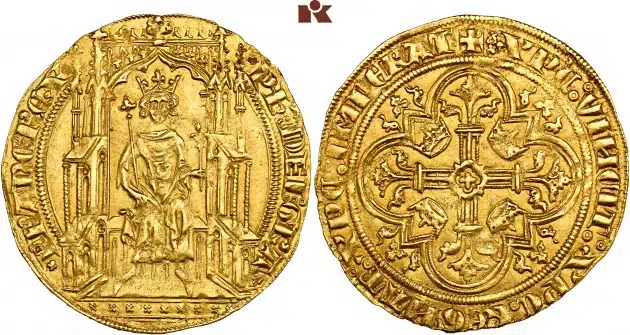
Double royal d’or n.d. (1340), 1. Emission.
Lot number 4030
France.
Philippe VI, 1328-1350.
Double royal d’or n.d. (1340), 1. Emission.
Rare. Extremely fine.
Estimate: 7.500 euros
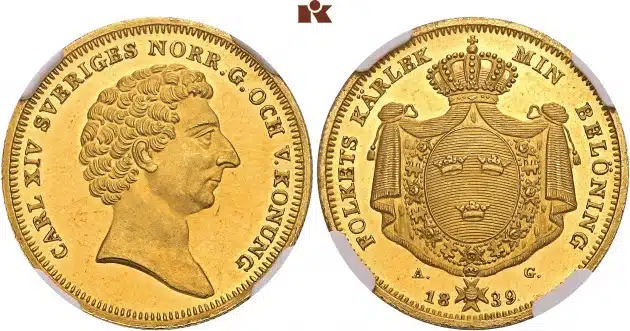
Lot number 4222
Sweden.
Charles XIV John.
4 ducats 1839, Stockholm.
Only 2,000 specimens minted. About FDC.
Estimate: 20.000 euros

Lot number 4429
Bavaria.
Charles Theodore.
3 ducats 1792, Munich.
NGC MS63. Very rare. Extremely fine to FDC.
Estimate: 25.000 euros

Lot number 4612
Hesse-Kassel.
William IV the Wise.
Reichstaler 1592, Kassel.
Extremely rare. Very fine.
Estimate: 20.000 euros
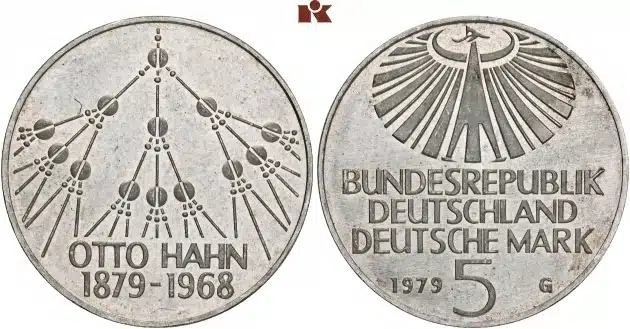
Lot number 5185
Federal Republic of Germany.
5 DM 1979, G.
Extremely rare. About FDC.
Estimate: 10.000 euros
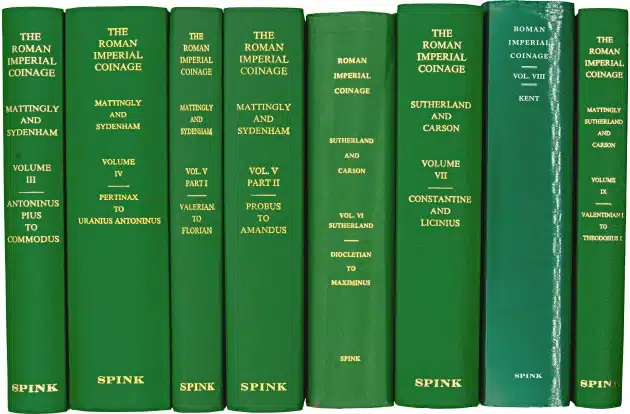
Lot number 6364
Monographien, Sammelwerke und Aufsätze.
Mattingly, H./Sydenham, E.A. U.A. (Hrsg.).
Set aus 11 Einzeltiteln des 1923 gegründeten Dokumentationsprojekts.
Estimate: 600 euros

Lot number 6706
Annuaire De La Societe Francaise De Numismatique Et D’Archeologie.
Years 1867-1870, 1873-1874, 1877-1884 in uniform bonds, plus the years 1889.
Estimate: 500 euros

Lot number 6730
Jahrgänge 1867-1870, 1873-1874, 1877-1884 in einheitlichen Bindungen, dazu die J
Complete set, 1st-22nd part,, Nürnberg 1729-1750.
Estimate: 2.000 euros
* * *
Sending Bids by Fax, Phone, and Email
While online bidding is always available we also gladly accept your bids by:
Fax: +49 541 96202 22
Email: service@kuenker.de
Telephone: +49 541 96202 0
Please note: The likelihood of errors increases, if we do receive your bid shortly before the online auction. We thus recommend sending your bids as early as possible.
* * *
The post Highlights From Künker eLive Premium Auctions 398 and 399 appeared first on CoinWeek: Rare Coin, Currency, and Bullion News for Collectors.
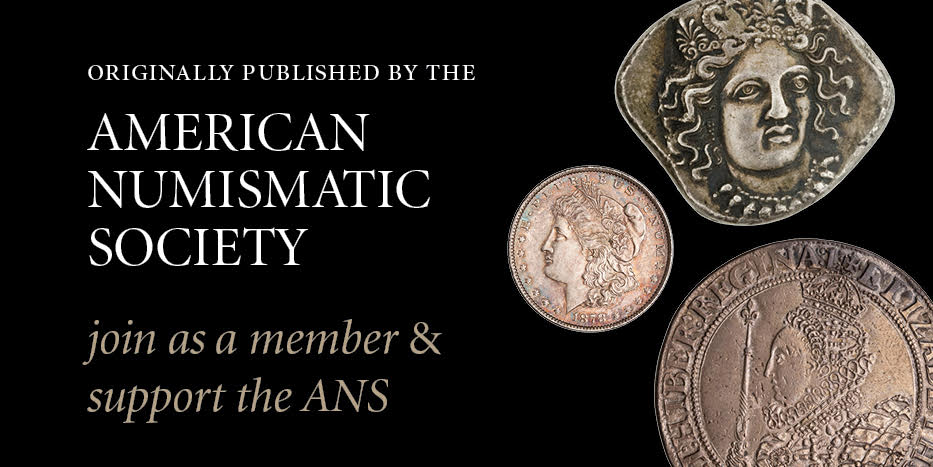
Medieval Money at the Morgan Library
By David Yoon for the American Numismatic Society (ANS) ……
As previous posts have mentioned, some of the best opportunities to see objects from our collections occur when other institutions borrow from us for an exhibition on a particular theme.
A new exhibition at the Morgan Library and Museum on the theme of Medieval Money, Merchants and Morality, which will be on view from November 10, 2023, to March 10, 2024. American Numismatic Society items on display include two 17th-century German coin balances; gold florins and billon groots; part of a hoard of Venetian torneselli; a Danish bracteate penny; and an Austrian double guldenthaler, among others.

Curated by the art historians Diane Wolfthal and Deirdre Jackson, this exhibition shows the items borrowed from the ANS alongside manuscripts and paintings that depict some of the concerns and anxieties that people had about money in late medieval and Renaissance Europe. It raises a number of questions about the culture of money that are worth exploring. Money was deeply problematical in the context of medieval European culture, in which religious beliefs were widely taken for granted. Money, as a dynamic and versatile form of wealth, was greatly desired and eagerly sought, but it was also regarded with more than a touch of suspicion and disdain. It is possible, of course, to explain this attitude internally to the culture, with reference to the importance placed on renunciation of possessions and earthly pleasures in early Christianity as well as to the agrarian values of rural landholders. To have or to desire money beyond basic needs was, in short, sinful and a pathway to eternal damnation.

Religious distrust of money and monetary wealth is not unique to the culture of medieval Christianity, though. It might be worth thinking about whether there are also explanations internal to the concept of money that might contribute to these attitudes.
Money is, at its core, a technology for turning value, whatever that is, into interchangeable quantized units that are unburdened by any element of moral judgment. Anthropologists like the late Nancy Munn and David Graeber pointed to the verbal slippage from values in the sense of moral principles to value in the sense of an interchangeable measure as a clue to how acts of exchange could be essentially social and moral in attitude or could become something very different. It is hard to imagine any technology that is more alien to the concerns of many religions than money: the social disembeddedness and the moral neutrality–or often both–are directly opposed to the moral philosophies that underlie many religions.
The moral ambiguity of money makes it an ambivalent technology in many cultures. As the Morgan Library exhibition shows for medieval Europe, money could be sinful but could also be turned to purposes regarded positively. This exhibit is a reminder to us—and a reminder filled with beautiful works—that coins are not just useful or desirable objects; they are also a way that people relate to each other, and to their own consciences.
* * *

The post Medieval Money at the Morgan Library appeared first on CoinWeek: Rare Coin, Currency, and Bullion News for Collectors.

1876 Centennial Exposition Medals Struck by the U.S. Mint
By Vic Bozarth for PCGS ……
Regardless of what you like to collect, knowing the particulars about your collectibles is often beneficial in terms of understanding both its historical interest and why your item is valuable to others too. If you don’t understand the “whys” of your coin, how can you place or value that item in terms of relevance to other collectibles? How do you connect the dots?

In this seven-part series, I will explain the genesis of the coins and medals issued by the United States Mint for the World’s Fairs and Expositions that took place in the United States, from the 1876 Centennial Exposition through and including the 1926 Sesquicentennial Exposition – both of which were held in Philadelphia, the site of our nation’s first mint.
Beginning with the Centennial Exposition in 1876, and continuing with each successive Exposition, I plan on detailing the U.S. Mint-made coins and medals produced in conjunction with the seven largest world’s fairs and expositions held during that 50 year period.
Reference material dealing with only U.S. Mint-made medals is pretty thorough for the first century the Mint was in operation, thanks to R.W. Julian’s amazing book Medals of the U.S. Mint: The First Century 1792-1892. When possible, the PCGS spec number will be used in these articles to identify these U.S. Mint exposition medals. However, other industry-standard catalog numbers, such as Julian and or HK (So-Called Dollars), will be referenced as necessary to further differentiate these issues. While inclusion is always the goal, omissions are not intentional.
Connecting the Dots
Two relatively common food items were introduced at the 1876 Exposition. Heinz ketchup and Hires root beer, both popular commercial brands for decades, were a big hit at the fair. While most of us seldom ride the rails these days, the Pennsylvania Railroad and the Philadelphia & Reading Railroad ran dedicated trains from nearby areas. The Centennial National Bank was chartered in January 1876 as a financial agent for the Centennial Board, with charter number 2317.
These products, services, and especially the Centennial Bank National Bank Notes serve to connect the dots in terms of giving us a glimpse into the multitude of numismatically related and crossover collectibles world’s fairs and expositions provide us. Many of our world’s fairs and expositions had U.S. Mint-struck coins and medals issued to commemorate the event. Some were even made on the grounds of the exposition themselves. The first U.S. coins produced to commemorate a world’s fair were the 1892 and 1893 Columbian Exposition Half Dollars and the 1893 Isabella Quarter Dollar.
Although no coins were produced to commemorate the 1876 Centennial of the United States, the nation did make medals. This production of medals for the Centennial Exposition was a success and very possibly laid the foundation for later (exposition-related) U.S. Mint coin and medal issues. Interestingly, several of the Mint’s medal designs used for the Centennial Exposition were created by William Barber, Charles Barber’s father.
The 1876 Exposition: A Gala Event

The 1876 Centennial Expo honored the 100th anniversary of the signing of the Declaration of Independence in Philadelphia in 1776. The Philadelphia Centennial Expo, which was officially named the International Exhibition of Arts, Manufactures, and Products of the Soil and Mine, was the first international exhibition and world’s fair to be held in the United States.
The event was held May 10 to November 10, 1876, in Fairmount Park along the Schuylkill River. The fairgrounds were designed by Herman J. Schwarzmann and the attendance reached nearly 10 million people–equivalent to nearly a quarter of the total U.S. population at that time. An event of that scale was the perfect venue for the Philadelphia Mint to showcase its wares to the world.
The 1876 Centennial Exposition U.S. Mint medals include an Assay Commission Medal, three award medals, and four different commemorative medals. The eight Centennial Exposition medals are classified as follows with Julian cataloging numbers:
Commemorative Medals:
- CM-10
- CM-11
- CM-29
- CM-36
Award Medals:
- AM-10
- AM-11
- AM-12
Assay Commission Medals:
- AC-15
The three So-Called Dollar medals for the Centennial Exposition were all engraved by William Barber. The three designs, the Nevada Dollar and both Official Centennial Medals, were struck in silver, but there are other metal strikings of the three designs. Let’s look closer at these cool U.S. mint produced medals.
The So-Called Dollars of the 1876 Expo
The Nevada Dollar is an intriguing medal.
The obverse design shows the Liberty Bell flanked by a Minuteman and soldier, inscribed with the prayer “Let God be with us as He was with our fathers.” The reverse carries an intricate Nevada mining scene with the text “Made from Nevada ore at International Exposition” circling the top and “All for our country” below.
[[fig1]]
These pieces were sold for $1.25 each at the Nevada Building on the fairgrounds with a card including the following message: “Was commissioned for the Centennial Exposition to be struck at the Philadelphia Mint with Nevada silver ore crushed at the quartz mill located on the Centennial Expo grounds,” while they were refined and struck at the Philadelphia Mint.
- PCGS #642050: HK-19, Julian-CM-36; Silver* – Mintage: 2,526 (Rarity-5)
- PCGS #642051: HK-19a; Copper BN – Mintage: N/A (R-9)
- PCGS #642052: HK-19a; Copper RB – Mintage: N/A (R-9)
- PCGS #642053: HK-19a; Copper RD – Mintage: N/A (R-9)
*Planchet weights and fineness vary. According to Julian, the planchet weights and fineness varied possibly because the mint ran short of the “genuine Nevada silver” and continued production with silver obtained through conventional channels.
The copper issue of the Nevada Dollar is designated as HK-19a in So-Called Dollars by Harold E. Hibler, Charles V. Kappen, Tom Hoffman, et al. PCGS has graded none of the copper Nevada Dollars, and the coin is listed as R-9 in So-Called Dollars. No mintage figures were found for the copper issue and it was quite possibly a trial.
There are two Official Centennial Medal designs which, like the Nevada Dollar, were both designed by William Barber. I’ll describe each separately.
The obverse of the CM-10 Centennial Medal example features the Genius of American Independence portrayed by Lady Liberty, sword in hand, rising to enforce her demands with 13 stars blazing above. The obverse has the inscription “These United Colonies are and of right ought to be, free and independent states” and 1776 below Miss Liberty. Within the wreath on the reverse is stated, “In commemoration of the HUNDREDTH anniversary of AMERICAN INDEPENDENCE.” Surrounding the wreath circling the coin are the date 1876 at six o’clock and “By authority of the Congress of the United States.”
Commemorative Medals
The Official Centennial Medal was minted in two sizes and in several metals. The smaller CM-10 38-millimeter medal is pictured about in silver while the larger CM-11 57-millimeter medal is pictured below.
[[fig2]]
PCGS classifies the different issues of the Centennial Medal as follows with their mintages and rarity ratings as listed in So-Called Dollars or in Julian’s mint medals book:
CM-10 Medals:
- PCGS #642054: HK-20; Silver – Mintage: 10,133 (Total PCGS Pop. 31, R-4)
- PCGS #642055: HK-21; Bronze BN – Mintage: 13,000 (Total PCGS Pop. 11, R-3)
- PCGS #642056: Bronze RB – Mintage: N/A (R-3)
- PCGS #642057: Bronze RD – Mintage: N/A (R-3)
- PCGS #642058: HK-22; Gilt – Mintage: 10,500 (Total PCGS Pop. 8, R-4)
- PCGS #642059: HK-22a; White Metal – Mintage: 3 (R-9)
The CM-11 larger-sized medal of 57-millimeter diameter is pictured below.
[[fig3]]
CM-11 Medals:
- PCGS #568830: CM-11; Copper
- CM-11b; Silver
- PCGS #705511: CM-11c; Bronze
- PCGS #660320: CM-11d; White Metal
- PCGS #515568: CM-11e; Gilt
Another Centennial Medal of U.S. Mint production is classified as Julian CM-29. This large 58-millimeter medal depicts Memorial Hall on the obverse and Independence Hall on the reverse. This commemorative medal sold at the fair was commissioned by Nichols, Pickering, and Company in 1875. The engraver is unknown, but the United States Mint struck 20 silver and 500 bronze examples between July 1875 and the middle of 1876. These 520 examples were delivered, but an additional 400 bronze specimens (neither sold nor paid for) were later melted in 1891.
CM-29 Medal:
- PCGS #N/A; Silver
- PCGS #N/A; Bronze
Nevada and Centennial Medals are available in silver, and both bronze and gilt examples of the Centennial Medal can be located, too. Curiously, the white metal example of our Centennial Medal, with a mintage of only three pieces, has a neat story. Evidently all three examples can be traced back to the Barber family.
Auction prices realized for the Silver Nevada Centennial Exposition Dollar in MS63 have ranged from $1,320 in March of 2019 and most recently $3,705 in October of 2020. The Centennial Dollar price ranges are more modest in silver, bronze, and gilt. If you can locate them, all three metal examples, all graded MS63, have recently taken prices ranging from $168 to $408.
These U.S. Mint Commemorative Medals are historically significant and beautiful, and both the copper Nevada Dollar and Centennial Dollar (except for WM) are both available and affordable.
Julian lists four other Centennial-related U.S. Mint medal issues. Of the four additional Centennial Medals, one is an Assay Commission Medal and the other three are Award Medals.
Assay Commission Medals
Assay Commission Medal AC-15 is an interesting piece that sports a bust of George Washington on the obverse and the inscription “Year 100 of American Independence” within a wreath on the reverse. Originally U.S. Mint Director Henry Linderman wanted to celebrate our nation’s centennial with a one-year reverse design change to the Trade Dollar, but Superintendent James Pollock objected.
[[fig4]]
The medal was engraved by William Barber, but the reverse of the AC-15 Assay Medal is much as Linderman suggested for the Trade Dollar.
AC-15 Medals:
- PCGS #518444: 33 mm; Silver
- PCGS #785016: Bronze
- PCGS #972472: Aluminum
Award Medals produced by the U.S. Mint were often completed and delivered near the end of the exposition itself or sometimes even years later. Nevertheless, these Award Medals are of great importance because most were produced in small quantities, the recipients are noteworthy in their own right, and, in many cases, the designs and engraving are exceptional.
AM-10 Medals:
- PCGS #616302: Bronze BN; 76 mm (3”) – 12,000 distributed total
- PCGS #616303: Bronze RB; 76 mm (3”) – Included above
- PCGS #616304: Bronze RD; 76 mm (3”) – Included above
- Silver; 102 mm (4”) – 27 ordered
- Bronze; 102 mm (4”) – 123 ordered
AM-11 Medals:
- Silver; 102 mm (4”) – 27 struck
- Bronze – 123 struck
AM-12 Medals:
- Bronze; 102 mm (4”); same as AM-11, but inscription on reverse same as the smaller medal. Few made, probably a pattern.
Both of these larger Award Medals were similar in design to the smaller AM-10 issue, but for the inscription on the reverse. Much like the large-size (4”) AM-10 medal, only 150 total of the AM-11 4” Award Medals were made, but the AM-12 was probably a pattern and few were made. There are no PCGS spec numbers assigned for either issue yet.
The eight different U.S. Mint-produced Centennial Exposition medals are quite amazing in their diversity and scope of production. After all, this was our first centennial and first international exposition. In addition to the U.S. Mint medals, dozens of other souvenir medals were privately minted for the centennial.
Other Centennial Expo Collectibles
Let’s discuss some of the other cool items from the Centennial Exposition. While there are thousands of items out there relating to the Centennial Exposition, I found this souvenir picture album quite illustrative of the connections between different Fair related items. Several decades ago the gold medallic embossing decorating this item convinced me to buy it because it was clearly coin related.
Interestingly, this picture album portrays the CM-11 medal in a gilt finish!
[[fig5]]
Many of the Centennial Exposition related So-Called Dollars produced privately were sold or given away as souvenirs. These, too, while not produced by the U.S. Mint, are certainly tied to the Centennial Exposition as crossover collectibles.
The So-Called Dollars from the Centennial Exposition include these patriotic themes: Liberty Bell and Independence Hall Dollars, Liberty Dollars, Independence Hall Dollars, Liberty Seated Dollars, Centennial Fountain Dollars, George Washington Dollars (especially Lovett’s Eight Battles Dollars), Declaration of Independence Dollars, and Exposition Building Dollars.
Just for the Centennial Exposition, the So-Called Dollars represent HK-19 through HK-118. There are numerous strikes for many in different metals, too. Regardless of what you desire, numismatically related Centennial Exposition items are numerous and historic.
The challenge and difficulty in these desirable medals is apparent to any collector attuned to this niche of obscure and rare pieces. My hope is that the interest this article series may generate will serve to pique interest among numismatists to pursue these highly historic crossover collectibles. The next installment of “Connecting the Dots” will detail the U.S. Mint medals of the 1892 and 1893 Columbian Exposition.
* * *
About the Author
 Vic Bozarth is a member of the Professional Numismatics Guild (PNG), FUN, the ANA, the CSNS, and many other regional and state coin clubs and organizations. Vic has extensive experience buying and selling coins into the mid-six-figure range. Vic and his wife Sherri attend all major U.S. coin shows as well as most of the larger regional shows.
Vic Bozarth is a member of the Professional Numismatics Guild (PNG), FUN, the ANA, the CSNS, and many other regional and state coin clubs and organizations. Vic has extensive experience buying and selling coins into the mid-six-figure range. Vic and his wife Sherri attend all major U.S. coin shows as well as most of the larger regional shows.
For more information from PCGS, click on the image below.
* * *
The post 1876 Centennial Exposition Medals Struck by the U.S. Mint appeared first on CoinWeek: Rare Coin, Currency, and Bullion News for Collectors.
Tuesday Surge in Precious Metals Amid U.S. Inflation Data
Prices of precious metals advanced Tuesday, with gains ranging from 0
Book Hotels Now for ANA 2024 National Money Show in Colorado

Collectors and dealers are encouraged to make hotel reservations now to take advantage of special discount room rates at the historic Broadmoor resort for the March 14-16, 2024 National Money Show in Colorado Springs, Colorado and two pre-convention seminars, sponsored by the American Numismatic Association (ANA).
Hotel booking information is available at NationalMoneyShow.com. Members of the Association are encouraged to register for the show in advance (non-members can register on-site).
“The Broadmoor is the host hotel for the 2024 National Money Show. It offers gracious hospitality and unmatched amenities in magnificent surroundings at the foot of the Rocky Mountains,” said ANA Executive Director Kim Kiick. “If you are planning to attend the show, you should make arrangement now to take advantage of special discount room rates to stay at one of the most celebrated hotels in the world.”
Room reservations can also be made for those who want to attend either of the ANA’s two pre-convention seminars on March 12 and 13. The seminars are “Fundamentals of Grading U.S. Coins” taught by Sam Gelberd, ANA Numismatic Education Manager, and “Counterfeit Detection of U.S. Coins with Emphasis on Recent Chinese Made Fakes” with instructors Brian Silliman and Keith Moon.
For additional information about the seminars, visit money.org/technical-series-seminars.
The ANA has negotiated extremely favorable room rates for attendees starting at $209 per night. In addition, the usual daily resort fee of $32 per room will be waived, and overnight guests will get complimentary self-parking and free in-room internet service.
“Reservations must be made by February 3, 2024 to get the special room rates, but we encourage attendees to book now while rooms are available,” advised Kiick.
In addition to the convention and pre-convention seminars, the ANA will host a Money Museum reception and Philanthropy Award celebration on Thursday, March 14, from 6-7:30 p.m. at the Association’s Colorado Springs headquarters, 818 N. Cascade Ave., Colorado Springs, Colo. Complimentary roundtrip shuttle service will be provided from The Broadmoor. Advance registration is required for the event and shuttles.
The National Money Show will provide collectors access to hundreds of dealers offering, extensive numismatic inventory at all price levels, a live auction, exhibits of rare and historical treasures, and educational programming for both beginning and seasoned hobbyists.
Additional information about the National Money Show is available at NationalMoneyShow.com, by calling (800) 482-9828 or emailing convention@money.org.
* * *
The post Book Hotels Now for ANA 2024 National Money Show in Colorado appeared first on CoinWeek: Rare Coin, Currency, and Bullion News for Collectors.
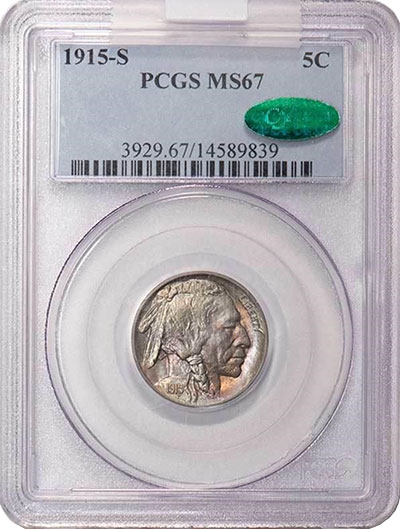
1915-S Buffalo Nickel : A Collector’s Guide
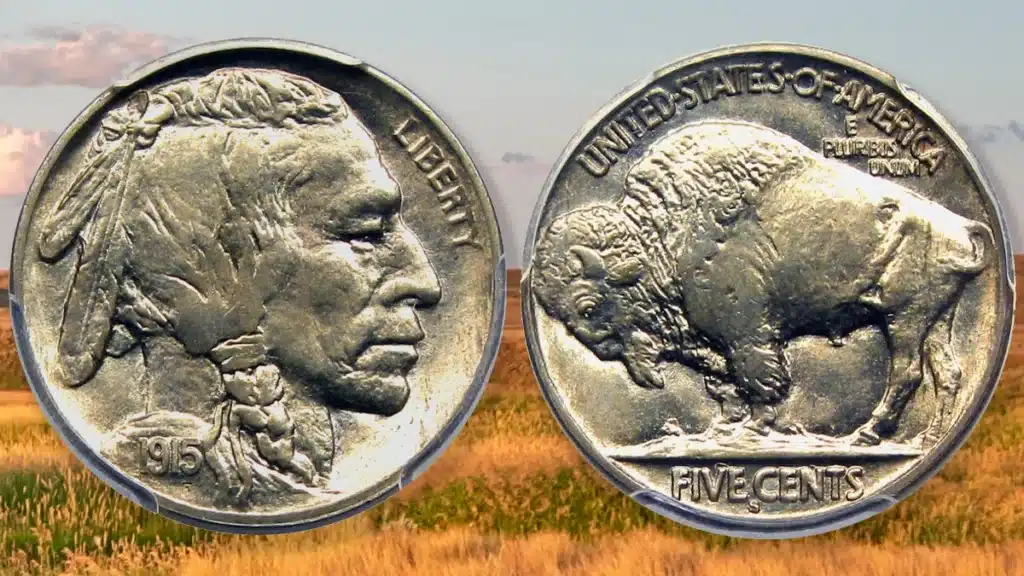
1915 was the third year of Buffalo nickel production. It was also the year in which Black Diamond, the North American bison allegedly used by sculptor James Earle Fraser as a model for the nickel’s reverse, died.
This year also saw a dramatic decrease in the San Francisco mintage. While the Philadelphia Mint essentially produced the same quantity as in 1914, and the Denver Mint nearly doubled production, the San Francisco Mint actually reduced production by 57%! This reduced issuance, the fifth smallest of the entire series, is compounded by the fact that coin collecting hadn’t become a widespread hobby by 1915. In fact, it wasn’t until the first coin folders and holders came onto the market in the early 1930s that the number of coin collectors began increasing dramatically. This delay between the 1915-S’s production and the expansion of coin collecting in the U.S. meant that the majority of the already small issuance was subjected to over a decade of wear. Due to the coin’s design, this means that a large number of pieces had lost their dates.
Despite being a relatively well-struck issuance, a number of examples suffer from either weak strikes or extremely worn dies, or both.
What is the 1915-S Buffalo Nickel Worth?
As the fifth smallest mintage of the series, the 1915-S Nickel’s rarity is reflected in the type’s price, especially in high grades.

For example, one of the seven known MS 67s that have been graded by either PCGS or NGC sold for $37,200 in 2021 by Heritage Auctions and $55,812.50 in 2019 by Legend Rare Coin Auctions. This piece boasts spectacular iridescent toning and is practically flawless. While there is some slight weakness along the obverse legend “LIBERTY”, this is a particularly fine example of the type. As examples in this grade rarely come onto the open market, this coin holds the auction record for the type.
At one grade lower, the price drops dramatically, even though the population does not grow too dramatically. In fact, only 76 MS 66 and MS 66+ examples are known, which is nowhere near enough to meet the present demand. When they come to auction a couple of times a year, this grade commands a price fluctuating between $5,000 and $9,500. However, eBay sales can sink as low as $3,000. Collectors should note that the eBay sales records for $1,100 and $1,099 on May 2019 and July 2020 listed in the PCGS Coinfacts auction records database are actually for 1915-S Pan Pacific gold dollars.
For the roughly 30% of the population that ranges in grade from Fine to Extra-Fine, the prices are much more reasonable for the everyday collector. This is despite the fact that the 1915-S is one of the most expensive types of the series in low grade. On the low end of this range sit examples that sell for as little as $130, and examples on the high end sell for as much as $450. The lowest condition datable examples sell for between $30 and $40.
As always, undated buffalo nickels are worth roughly $1.
Design
Obverse:
The obverse of the 1915-S Buffalo or Indian Head nickel features an oversized bust of a Native American warrior. Unlike the later Sacagawea dollar, this design was not based on a single model or historical figure. Instead, sculptor James Earle Fraser created a composite image of three well-known men: Chief Iron Tail of the Sioux, Big Tree of the Kiowa, and Two Moons of the Cheyenne. This composite man wears two feathers woven into his hair and a braid running down the side of his head. The date (1915) is superimposed over the truncation of the bust, and the legend LIBERTY is off to the side at 2 o’clock on the rim.
Reverse:
The central motif on the reverse was supposedly based on the buffalo named Black Diamond that lived at the New York Central Park Zoological Garden. Standard types display all of the animal’s four legs. The buffalo is standing on a small strip of land, below which is the denomination (FIVE CENTS). Arcing above the animal’s back around the rim is the legend UNITED STATES OF AMERICA. The motto E PLURIBUS UNUM is squeezed between “AMERICA” and the animal’s back. As this type was struck at the San Francisco Mint, the “S” mintmark at the bottom of the design under the denomination.
Intriguingly, this design does not include the national motto IN GOD WE TRUST. This was due to United States Mint Director George Roberts informing Fraser that “the motto, ‘In God We Trust’, is not required upon this coin” (Burdette).
Edge:
The edge of the 1915-S Indian Head (Buffalo) nickel is plain or smooth, without reeding or edge lettering.
Designer
An American sculptor, James Earle Fraser was active during the first half of the 20th century. Born in Minnesota, Fraser attended the Art Institute of Chicago and displayed some of his earliest artwork at the 1893 World’s Columbian and 1915 Panama Pacific Expositions, including his piece entitled End of the Trail. A large portion of his work centered around Native American themes and is embodied in his 1913 Indian Head nickel design.
Coin Specifications
| Country: | USA |
| Year Of Issue: | 1915 |
| Denomination: | Five Cents (USD) |
| Mint Mark: | S (San Francisco) |
| Mintage: | 1,505,000 |
| Alloy: | 75% Copper, 25% Nickel |
| Weight: | 5.00 g |
| Diameter: | 21.10 mm |
| Edge: | Plain |
| OBV Designer | James Earle Fraser |
| REV Designer | James Earle Fraser |
| Quality: | Business Strike |
* * *
Sources
Burdette, Roger W. Renaissance of American Coinage: 1909–1915. (2007)
The post 1915-S Buffalo Nickel : A Collector’s Guide appeared first on CoinWeek: Rare Coin, Currency, and Bullion News for Collectors.

Cancelled Martha Washington Five-Cent Test Pieces Are Quite Valuable
By Mike Byers for Mint Error News ……
Unique Pair of Martha Washington Five-Cent Test Pieces
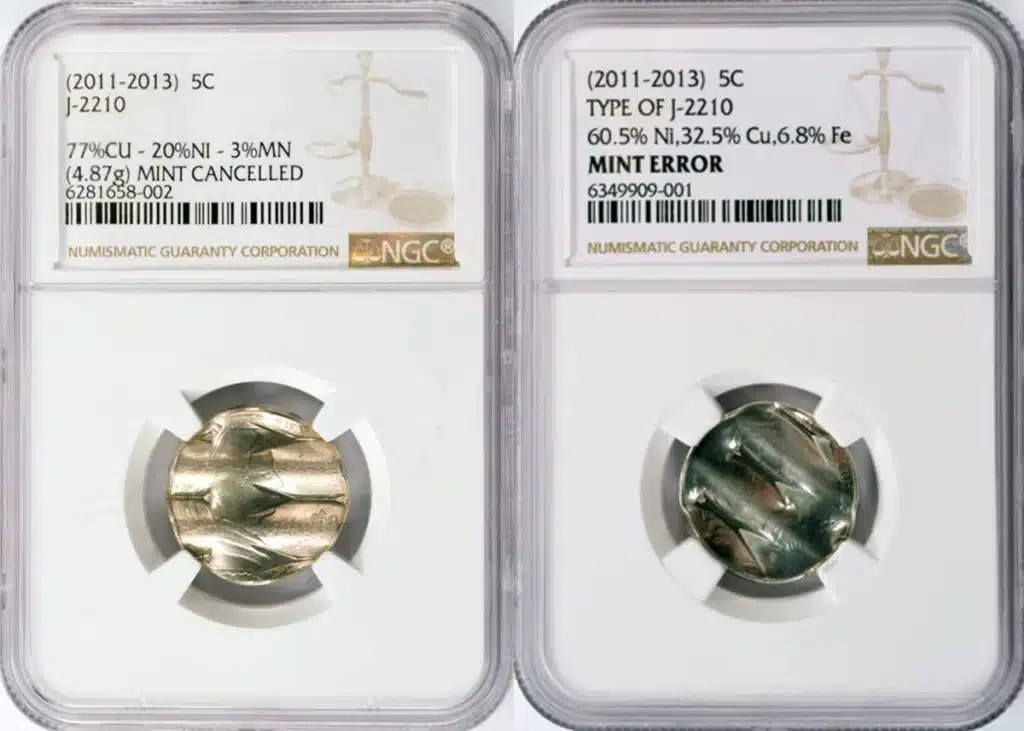

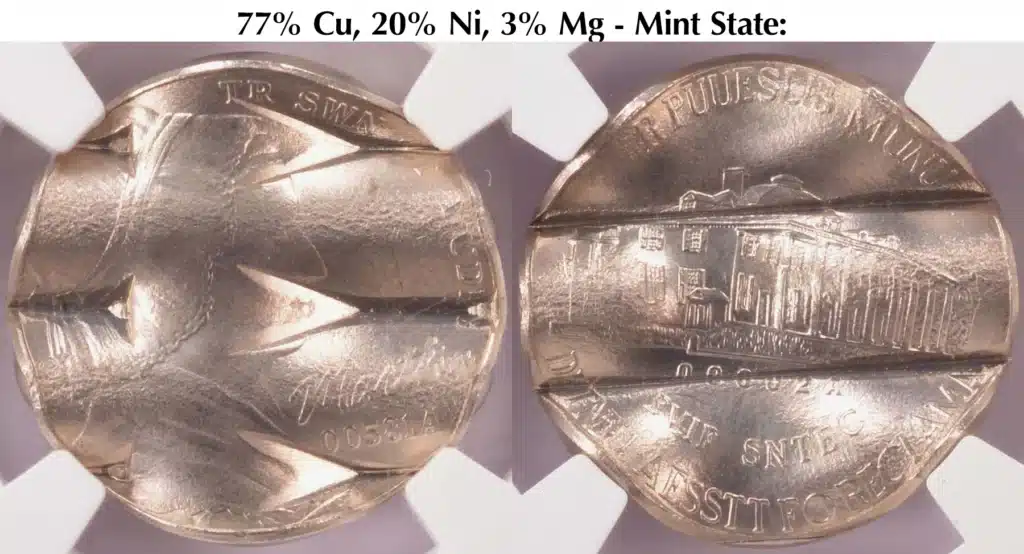
Judd #2210 – Mint Cancelled
77% Cu, 20% Ni, 3% Mg – NGC (Mint State)
60.5% Ni, 32.5% Cu, 6.8% Fe – NGC (Proof)
* * *
The U.S. Patterns section on Mint Cancelled (waffled) Martha Washington trial pieces includes a total of six known with the new design. Two are the five-cent test pieces featured in this listing, one of which is the only one known in Proof. Two are five-cent test pieces that were struck in copper, one was featured in a 2018 Coin World article. And finally, two 25¢ test pieces, which includes my original discovery.
Newly redesigned Martha Washington dies were used to strike test pieces at the Philadelphia Mint in 2011 and 2013. These pattern coins were struck to test new metal compositions for the five-cent coin, in the event that Congress authorized a composition change. The rising cost of producing the nickel caused the Treasury some concern, but Congress acts very conservatively when it comes to change to the nation’s coinage.

These two five-cent test pieces with the Martha Washington “nonsense” designs were produced and have been assigned Judd #2210 and are listed on the U.S. Patterns website (uspatterns.com). Editor’s Note: The set is currently listed for sale for $25,000 on Byers’ website.


* * *
The post Cancelled Martha Washington Five-Cent Test Pieces Are Quite Valuable appeared first on CoinWeek: Rare Coin, Currency, and Bullion News for Collectors.

Destroyed Martha Washington Five-Cent Test Pieces Are Quite Valuable
By Mike Byers for Mint Error News ……
Unique Pair of Martha Washington Five-Cent Test Pieces



Judd #2210 – Mint Cancelled
77% Cu, 20% Ni, 3% Mg – NGC (Mint State)
60.5% Ni, 32.5% Cu, 6.8% Fe – NGC (Proof)
* * *
The U.S. Patterns section on Mint Cancelled (waffled) Martha Washington trial pieces includes a total of six known with the new design. Two are the five-cent test pieces featured in this listing, one of which is the only one known in Proof. Two are five-cent test pieces that were struck in copper, one was featured in a 2018 Coin World article. And finally, two 25¢ test pieces, which includes my original discovery.
Newly redesigned Martha Washington dies were used to strike test pieces at the Philadelphia Mint in 2011 and 2013. These pattern coins were struck to test new metal compositions for the five-cent coin, in the event that Congress authorized a composition change. The rising cost of producing the nickel caused the Treasury some concern, but Congress acts very conservatively when it comes to change to the nation’s coinage.

These two five-cent test pieces with the Martha Washington “nonsense” designs were produced and have been assigned Judd #2210 and are listed on the U.S. Patterns website (uspatterns.com). Editor’s Note: The set is currently listed for sale for $25,000 on Byers’ website.


* * *
The post Destroyed Martha Washington Five-Cent Test Pieces Are Quite Valuable appeared first on CoinWeek: Rare Coin, Currency, and Bullion News for Collectors.
Reverse Proof Set of 2023 American Innovation Dollars Available
At Noon ET today, the United States Mint begins sales of their 2023 American Innovation Dollar Reverse Proof Set that showcases four unique designs hailing from Ohio, Louisiana, Indiana, and Mississippi
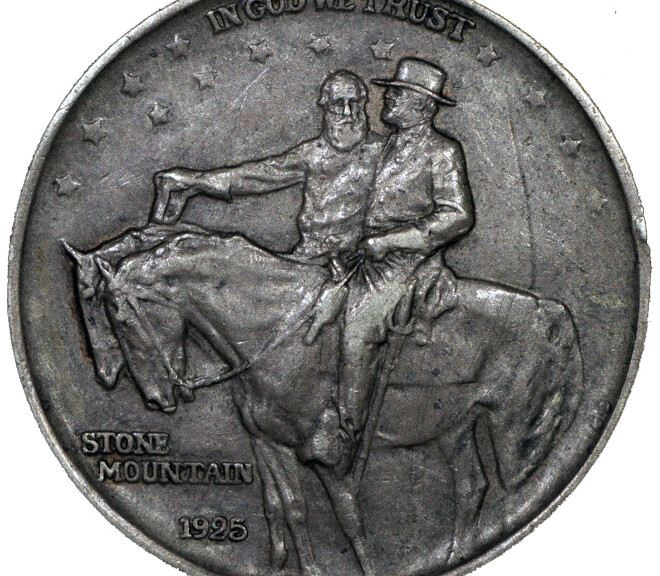
Beware of Defects on Coins

By Peter Mosiondz, Jr. for CoinWeek …..
A defect is a defect no matter how slight the seller proclaims it. And that same “slight’ defect will become much more severe in the eyes of a buyer when it comes time to sell or trade that same coin. Try to remember this fact of life in your coin collecting journey.
This sage advice was drummed into me by my late philatelic friend Herman “Pat” Herst, Jr.
No matter how the seller describes the coin, if it has a defect other than the normal bag marks one encounters, then it’s a defective coin. This in spite of the protestations that said defect is “tiny” or “insignificant”, as some are wont to say. That “microscopic” scratch will turn out to be a gouge when it is time to part with the coin. Take my word for it as a dealer and a collector for half a century. It always pays to buy a nice defect-free coin. The value of any coin possessing other than mint-made blemishes is reduced significantly.
Scratches are one thing; bag marks are another.
The former are caused by improper handling or cleaning. They are commonly caused by abrasive material coming in contact with the coin’s surface. Perhaps they originated with a brush or some other tool that was used in an attempt to improve the appearance of the coin. Possibly there was a failed attempt to remove some dirt or corrosion. Or maybe the coin was dropped on a hard surface. There are other ways in which scratches may result. These examples are the ones ordinarily seen. Whatever the reason, the coin is damaged.
Bag marks, on the other hand, are mint-made and therefore very natural. They are the result of a coin falling from the coining press into a bin with other coins of the same denomination. Then the coins in the bins are bagged, creating another situation where they are clashing one against the other. Finally, as the bags are moved from one location to the next, additional contact is made.
An experienced and trained eye will be able to easily distinguish between a man-made scratch and a bag mark. If you are in doubt, visit your friendly neighborhood coin dealer and ask to be shown the difference. Anything mint-made will not be a factor in the price unless the bag marks are very severe. I have seen some Morgan silver dollars that were so heavily bag marked that Miss Liberty seemed to have a bad case of chicken pox. An MS60 silver dollar may show numerous and possibly unattractive bag marks, but then again, if it’s properly graded, then the asking price should be commensurate with the coin’s appearance or “eye appeal”.
You may encounter the term “dig” as a descriptor of a bag mark. This is not necessarily so. A dig is most usually the result of one coin’s edge banging into another coin’s surface and producing what at first glance may resemble a pronounced bag mark. It is, as the name implies, a “dig”. Nevertheless, it is still mint-made and the price should reflect this fact.
 “Rim dings”, or dents on the coin’s rim, could be either mint-made or man-made. For example, in the early days of coining, the large cent planchets were not perfect and these “dings” were not uncommon.
“Rim dings”, or dents on the coin’s rim, could be either mint-made or man-made. For example, in the early days of coining, the large cent planchets were not perfect and these “dings” were not uncommon.
A “dent”, on the other hand, is the result of someone dropping the coin onto a hard surface. No matter how slight the dent looks to you, it is still a defect and worthy of a significant price reduction if you choose to purchase the coin. Beware also of someone describing a dent as a rim ding.
Speaking of large cents, it is important to note that the metal composition of copper coins is prone to attract carbon spots or verdigris. For the most part, the carbon spots are attributed to moisture coming into contact with the coin’s surface. This is considered a defect. You may be told that carbon spots are natural in copper coins. In that case, seek the unnatural copper coin. Verdigris, or corrosion, is a serious defect and usually observed in copper coins.
A commonly seen situation, especially with uncirculated coins, is that of artificial toning. This is an attempt, usually very transparent, to make some sort of attractive “rainbow” colouration or other colour effect. This method is sometimes used to cover a defect such as a dig or scratch. “Dipping” is another prevalent method of trying to enhance a coin’s appearance by making it brilliant.
A quick way to determine if the coin has natural or artificial brilliance or lustre is to perform the “cartwheel” test.
Grasp the coin firmly between your thumb and forefinger and then slowly rotate it as you slowly tilt it to and fro. You should be able to see radiant lines of lustre as if they were spokes of light rays emanating from a wheel. If you observe this effect, then the coin most likely possesses original mint lustre. It should be full lustre, and not merely one or two rays of light. A dipped or otherwise doctored coin will not show this cartwheel effect.
Another defect to be aware of is a fingerprint on the surface. Try to steer clear of this unless you simply must have the coin and the price is reduced significantly.
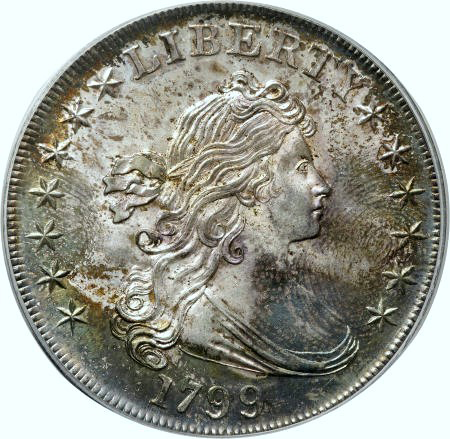 A point to remember is that no coin is perfect unless we consider the non-circulating coins produced by the various mints for sale to collectors. These are typically struck one at a time and taken from the dies by someone wearing clean cotton gloves and immediately placed into a protective holder. Here we have the ideal MS70 (or “perfect”) coin.
A point to remember is that no coin is perfect unless we consider the non-circulating coins produced by the various mints for sale to collectors. These are typically struck one at a time and taken from the dies by someone wearing clean cotton gloves and immediately placed into a protective holder. Here we have the ideal MS70 (or “perfect”) coin.
Coins struck for circulation can not be absolutely perfect. Due to the nature of their manufacture, circulating coins must contain one or more mint-made marks or scratches even if noticeable only with high powered magnification. These are not the defects we are speaking about. What we are saying is to avoid, at all cost, the coins containing man-made defects–this includes artificially toned and dipped coins. By selecting only those coins with outstanding eye appeal, your collection will be one to be proud of.
The best advice is to know your dealer. Build a numismatic relationship with one or more dealers whom you can trust implicitly. Make known your collecting and condition requirements. Then savour those relationships as you continue to add worthwhile coins to your collection.
Until next time, stay well, and enjoy your hobby.
* * *
The post Beware of Defects on Coins appeared first on CoinWeek: Rare Coin, Currency, and Bullion News for Collectors.
Precious Metals Prices Rise on Monday, Nov. 13
Precious metals moved higher on Monday, following heavy losses from last week
2023 U.S. Mint Gold Sales Outpace 2022 by October; Silver Sales Leap
In October, sales of bullion coins from the United States Mint surged significantly, with triple-digit percentage gains for the Mint’s flagship American Gold Eagles and robust double-digit increases for the bureau’s core American Silver Eagles
Olds Collection Early US Coins in Stack’s Bowers Whitman Auction
As part of the November 2023 Official Auction of the Whitman Coin and Collectibles Winter Expo, Stack’s Bowers Galleries is offering the Olds Collection of United States Coinage, which focuses on Civil War-era gold and colonial and early federal coins. Many of the coins feature CAC and CMQ approval.

Among the highlights in the early federal section of the Olds Collection are two key date 1799 Draped Bust cents. Offered in lot 3002 is an overdate 1799/8 (Sheldon-188) graded Good-6 (PCGS) and approved as strong for the grade by CMQ. Lot 3003 presents the normal date 1799 (Sheldon-189) graded VF-30 (PCGS) and CMQ-approved. This normal date specimen is considerably finer than most S-189 cents, which are typically worn and impaired.
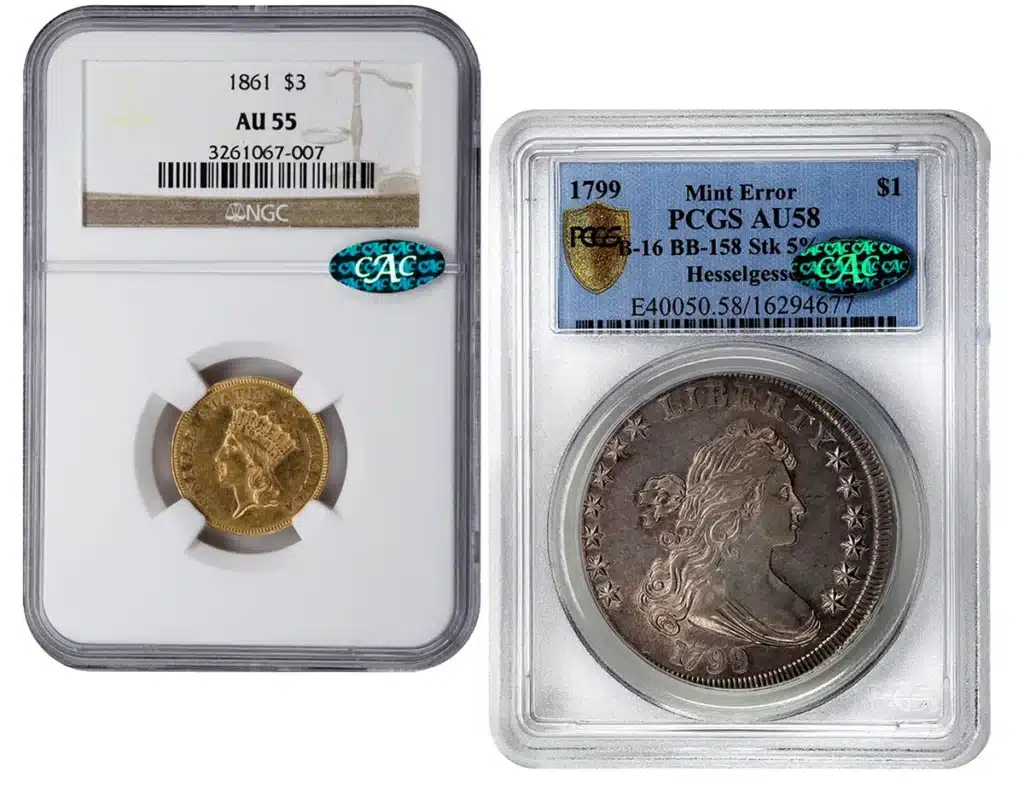
Lot 3077 features a Draped Bust dollar, struck 5% off center and graded AU-58 (PCGS) CAC CMQ, from the Hesselgesser Collection.
The Olds Collection also offers four exceptional 1799 Capped Bust gold coins. Lot 3152 is an AU-55 (NGC) 1799 BD-7 half eagle, a rare variety with only 14 to 18 examples known (according to numismatist John Dannreuther). Featured in lot 3153 is an AU-55 (PCGS) 1799 half eagle of the BD-8 variety, of which Dannreuther suggests only 22 to 30 pieces survive. Among the eagles is a noteworthy AU-53 (PCGS) 1799 BD-2 $10 in lot 3191, representing a scarce variety of the Small Stars Obverse type. Lot 3195 is an AU-53 (NGC) 1799 BD-10 eagle that has been approved by CMQ.
Representing the Civil War coinage is a pair of exceptional CAC-approved coins: an AU-55 (NGC) CAC 1861 three-dollar gold piece in lot 6480 and a MS-61 (NGC) CAC 1861 Liberty Head $20 double eagle gold coin in lot 6585.
The entire Stack’s Bowers Galleries November 2023 Showcase Auction, including the Olds Collection, is available for viewing and pre-sale bidding at their website, www.StacksBowers.com. For questions about the November auction or to consign your collection to an upcoming sale, contact Stack’s Bowers Galleries at (800) 458-4646 or by email at info@stacksbowers.com.
The post Olds Collection Early US Coins in Stack’s Bowers Whitman Auction appeared first on CoinWeek: Rare Coin, Currency, and Bullion News for Collectors.
George Kolbe Retires From Numismatic Bookselling Partnership
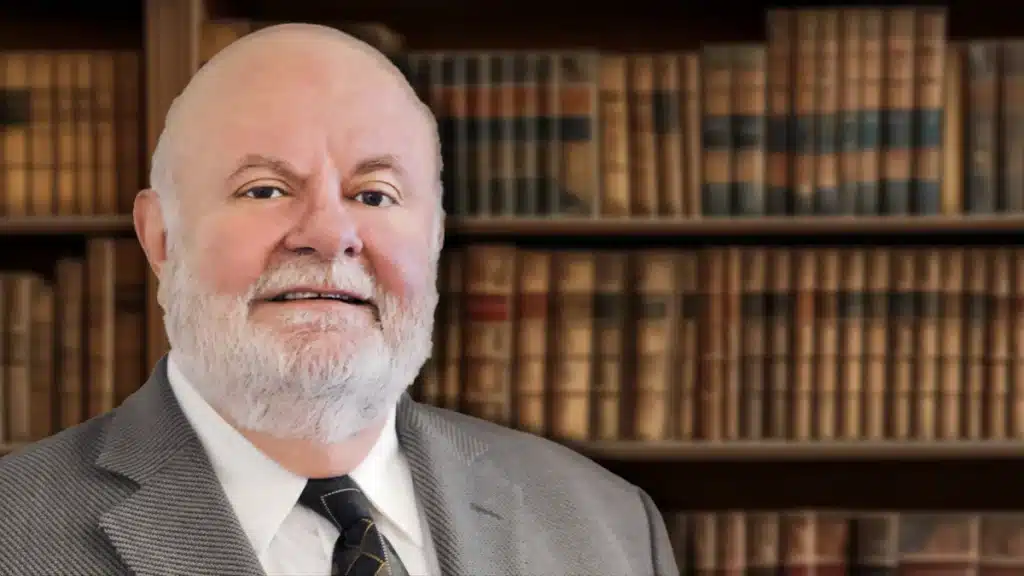
On November 13, 2023, George Frederick Kolbe announced his retirement from the partnership of Kolbe & Fanning Numismatic Booksellers. For over four decades, Kolbe has been a prominent figure in the numismatic community as both a bookseller and an author. His expertise in rare and collectible numismatic literature has made him a trusted name among collectors and scholars alike.
Kolbe’s love for numismatic bookselling began in 1967 when he published his first fixed price list of three pages. At that time, Kolbe was located in Redondo Beach, California, and sent the list to only a handful of potential customers.
As Kolbe’s career progressed, his lists became more sophisticated in terms of content and format. In 1976, he held his first auction through mail-bid sale, featuring 763 lots. The success of this auction led to three more mail-bid sales.
Finally, in 1979, Kolbe held his first public auction in conjunction with the Convention of International Numismatics in Los Angeles. This marked a significant milestone for Kolbe and solidified his position as a prominent figure in the numismatic book trade.
Over his lengthy career, George Kolbe has been associated with some 168 auctions conducting under his name or in partnership with David Fanning.
George Kolbe has sold numerous notable libraries through his auctions. These include the libraries of Harry W. Bass, John J. Ford, and the Stack Family. In addition to these, there have been 15 New York auctions co-conducted with Douglas Saville of Spink.
The inclusion of these prestigious collections in George Kolbe’s auctions further solidified his reputation as a leading authority in numismatic literature. Kolbe’s expert handling of this material also served the purpose of preserving and maintaining the knowledge and personality of the hobby as information was passed from one generation of collectors to the next.
Kolbe auctions, and later Kolbe & Fanning auctions, were highly anticipated events within the numismatic community.
David Fanning writes:
“When Kolbe & Fanning was established in 2010, it was a great honor for me to join forces with the preeminent numismatic bookseller of our day. As our partnership is ending and our firm prepares to move forward on our own, it is our honor to do so with the Kolbe name firmly attached. We are enormously grateful to George for providing us with the opportunity to go into business with him, and we send our very best wishes with him into his well-earned retirement.”
Kolbe & Fanning Numismatic Booksellers will be holding their next auction on February 17, 2024, when they will be offering highlights from the extraordinary BCD Library on ancient numismatics. The firm’s website will remain at numislit.com.
* * *
The post George Kolbe Retires From Numismatic Bookselling Partnership appeared first on CoinWeek: Rare Coin, Currency, and Bullion News for Collectors.
Coin World and Shepherd Expos Launch Tampa Coin Show
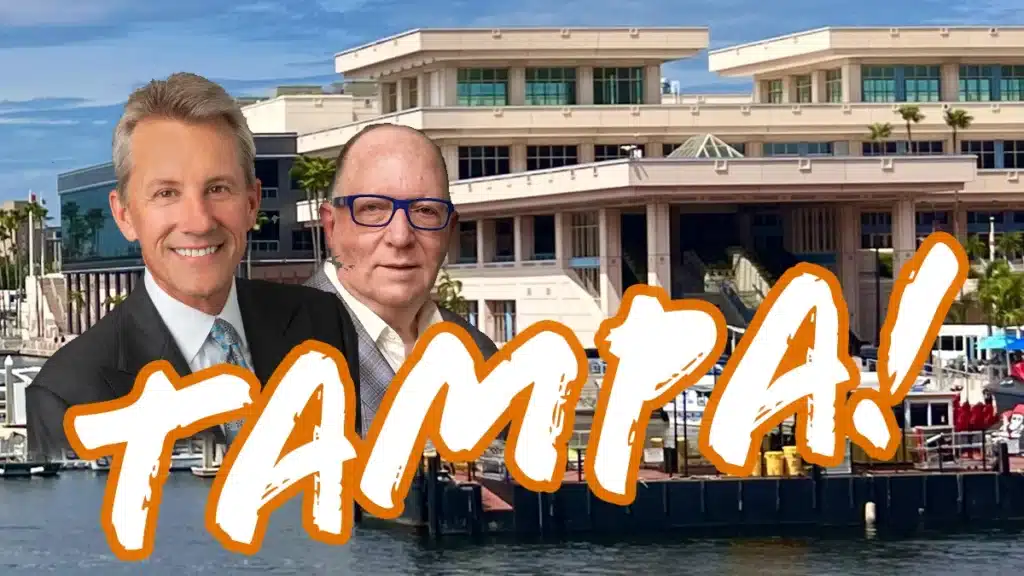
The 63-year-old Coin World magazine has partnered with Shepherd Expos Management to create another coin show. The Great American Coin and Collectibles Show (www.GACC.show) will take place September 11-14, 2024, in Tampa, Florida at the Tampa Convention Center.
Expert show planner Larry Shepherd and his company will manage the show for Amos Media, the publisher of Coin World.
“Coin shows have not changed much in 50 years, and we need to bring the concept into the 21st century. The ability to sell and buy coins online is a significant part of today’s marketplace, but we believe it is still vitally important to be able to see coins and bank notes in person and to conduct transactions face-to-face, as well as offer in-person educational opportunities,” explained Amos Media Chairman Rick Amos. “When Larry became available, we were excited to partner with a proven professional who knows how to plan and deliver a successful show. He developed ways to make coin shows more relevant with new innovations for a new generation of collectors and dealers. Larry has a proven track record of professional show management success from his years with Central States and the American Numismatic Association (ANA).”
Plans include a bourse space just large enough to accommodate almost 600 tables, plus a separate section for collectors that will hold another 60 to 70 tables. A dealer-to-dealer trading day for all table holders will be held on September 10, the day before the public is allowed access.
And even though the show ends on Saturday, September 14, the security room will be open through Monday, September 16.
Larry Shepherd said an experienced team of nine members is already in place for managing the show and announcements about discount rates at eight nearby hotels will be made soon.
“There is a large concentration of collectors who live within a few hours driving time of Tampa. Northstar Meetings Group, a national organization of event planners, recently named the Tampa Convention Center the best in the entire Southeast,” said Shepherd.
“We are looking at making this a semi-annual event with the first two in September of 2024 and a second event in March of 2025. This is the new age of coin shows,” he emphasized.
For additional information about the Great American Coin and Collectibles Show, visit www.GACC.show.
For additional information about Shepherd Expos Management, contact Larry Shepherd at (719) 464-8801 or email at ShepherdExpos@gmail.com.
* * *
The post Coin World and Shepherd Expos Launch Tampa Coin Show appeared first on CoinWeek: Rare Coin, Currency, and Bullion News for Collectors.
ANA Launches Reading Room Online Magazine

American Numismatic Association (ANA) members and nonmembers can now read industry news, access exclusive articles, peruse favorite columns from The Numismatist, and listen to audio recordings of articles on the go. The team behind the ANA’s official publication, The Numismatist, has now launched the Reading Room – a new ANA member benefit. This virtual portal, accessible from mobile devices, tablets, and desktop computers, offers:
- News articles delivered weekly, including stories not appearing in the magazine.
- A weekly “Notable News” article covering numismatic headlines.
- Two monthly “Reading Room Exclusive” articles covering various topics.
- Access to “U.S. Coins,” “Paper Money,” “Tokens & Medals,” and “Counterfeit Detection” two weeks before the digital edition of The Numismatist is published.
- Exclusive feature articles published throughout the year.
The ANA will also send a monthly eBlast – the “Reading Room Rundown” – that will include links to the editor’s top five stories, an article from the archive (with audio), and notable news from the world of numismatics. These emails can be easily shared with friends and family to promote interesting stories related to the hobby.
“[C]ollectors of all interests and experience levels will enjoy its content,” says Editor-in-Chief Caleb Noel. “The site is easy to navigate, articles link directly to social media and email, and most importantly, it’s tailor-made for the tech generation. Most articles are under 1,000 words, and we’ve provided audio versions of all Reading Room Exclusives narrated by yours truly so you can listen on the go. And this is just the beginning; next year, my team and I will debut tons of new content and digital exclusives that I know you will enjoy.”
Through December 15, ANA members and non-members alike will have access to the Reading Room. However, following December 15, the Reading Room will become an ANA member benefit only. Start exploring the new publication at readingroom.money.org today.
* * *
The post ANA Launches Reading Room Online Magazine appeared first on CoinWeek: Rare Coin, Currency, and Bullion News for Collectors.

Morgan Dollar (1878-1921) : A Collector’s Guide
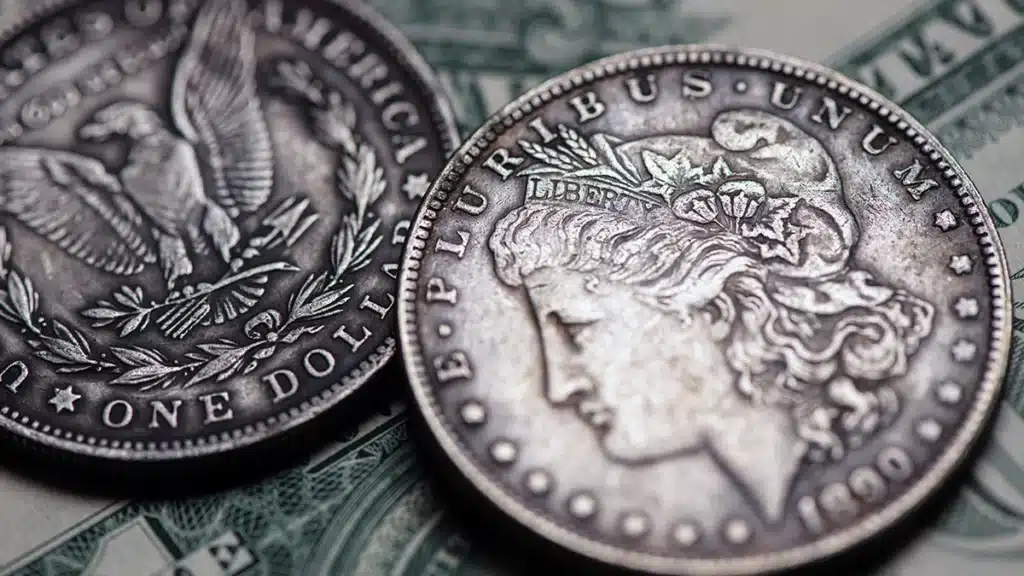
The Morgan Dollar – A Federal Boondoggle of Vast Proportions
Though it might seem to be a modern phenomenon, the problem of dollar coins that don’t circulate has a long history. For the large silver dollars of America’s past, the metal value of these coins often lead to them being melted as bullion rather than being spent as money in everyday commerce.
In 1873, the United States Congress responded to this reality by suspending the production of silver dollars for domestic use while at the same time creating a new silver Trade dollar for export. This change in America’s coinage laws reduced the government’s need for silver but unfortunately coincided with the release of vast numbers of European silver coins into the international market and a massive increase in raw silver production from domestic mines due to the discovery of the Comstock Lode.
With high production levels of raw ore and reduced demand, American mining interests lobbied Congress to create a market for their product by reintroducing the American silver dollar coin. The Bland-Allison Act of 1878 provided this.
The Blan-Allison Act required the U.S. Treasury Department to purchase millions of ounces of silver bullion each month so that new silver dollars could be made. For the new coin, Mint Director Henry P. Linderman selected a design by English-born assistant engraver George T. Morgan. Morgan had iterated on a portrait of Liberty based on the likeness of Philadelphia school teacher Anna Willess Williams on a number of pattern coins–most notably a half dollar pattern that closely resembles the Morgan dollar.
The first Morgans were produced in 1878. As per the law, millions of silver dollars were minted each year, even though the coin did not circulate widely due to the fact that paper dollars were more convenient. This wasn’t the case everywhere, however; in the American West, silver dollars proved more versatile. Still, the mandated quantities produced each year far outpaced demand and most Morgan dollars were struck, dumped into bags, and put into longterm storage in Treasury vaults.
The Bland-Allison Act and subsequent legislation that required bullion purchases eventually exhausted silver stockpiles by 1904. Morgan dollar production went on hiatus, and unneeded silver dollars ended up in storage. But because of a subsequent increase in silver prices, nearly three hundred million of the stored dollars were melted in 1918 under the provisions of the Pittman Act.
In 1921, even though millions of the coins could still be found in government vaults, nearly 87 million new Morgan dollars were minted as a stopgap before the legally mandated Peace dollar design could be produced. But the storage of silver dollars was about to end.
Beginning in the 1930s and continuing through the early ’60s, rising collector coin and bullion prices resulted in a steady outflow of dollar coins from the Treasury until this was halted in 1964 by the Federal Government. The remaining silver dollars were dispersed in the early ’70s through 1980 by the General Services Administration (GSA) via mail-bid sales. The GSA sales, combined with the discovery and distribution of other privately-held Morgan dollar hoards, heightened collector interest in the series – an interest that continues unabated today.
America’s Most Collected Classic Coin
Throughout much of its circulating history, the Morgan dollar has been collected. The size of the American numismatic market was much, much smaller, however, and many of these collectors were interested in older coins such as large cents, which disappeared from circulation starting in 1857.
Collectors of the period were not largely aware of coin mintages at the time, and certainly paid little mind to collecting coins by mintmark. The United States Mint produced Proof versions of its circulating coins for collectors – who often were satisfied with owning a Proof example instead of its corresponding circulation strike.
Collecting interest in Morgan dollars grew throughout the 20th century, but for the first half of that century, the silver one dollar coins could be purchased from the local bank at face value. As the need arose, banks would replenish their stock by ordering $1,000 bags from the Treasury Department.
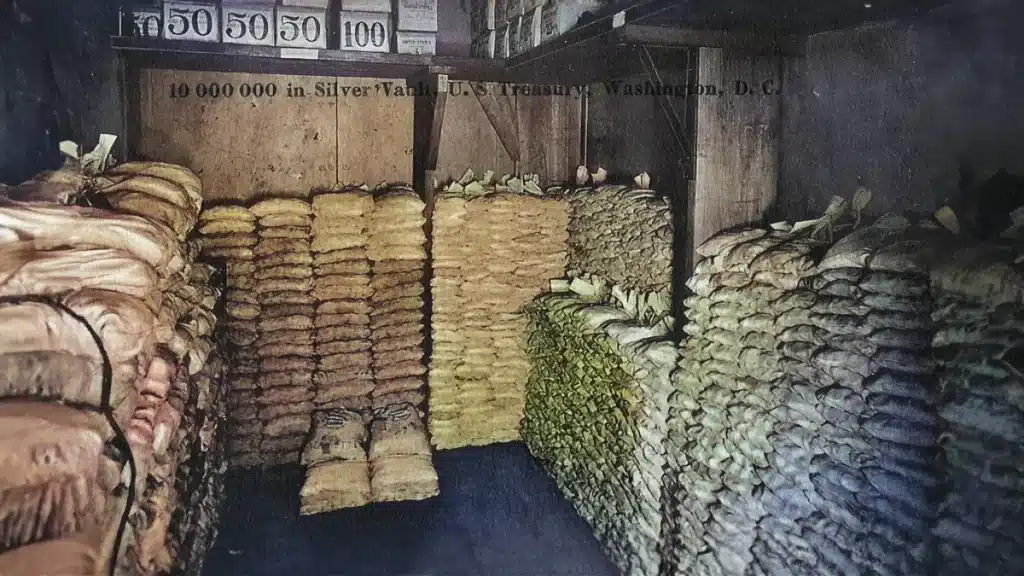
Over the years, these bags yielded coins from nearly all dates and mints–save for the 12,000 coins supposedly struck for circulation by the Philadelphia Mint in 1895. For some issues, quantities of uncirculated coins did not materialize as the Treasury’s stockpile depleted.
A massive run on silver in the 1960s saw the era of face value silver dollars come to a close. The Treasury held back a few million dollar coins that were marked as having been struck at the defunct Carson City Mint and developed a plan to auction them off to the general public through the General Services Administration.
 It was this dwindling of the government’s stockpile followed with the public sale of “the coins that Jesse James never got” that ignited a modern collector market for Morgan dollars.
It was this dwindling of the government’s stockpile followed with the public sale of “the coins that Jesse James never got” that ignited a modern collector market for Morgan dollars.
Other than for scarce or rare issues and varieties, business strike Morgan silver dollars are represented by the thousands in census and population reports, and prices are moderate even in Gem for some plentiful dates.
Prooflike (PL) and Deep Mirror Prooflike (DMPL) examples are common, some of which are expensive in higher Mint State grades. Issues with higher prices include the 1879-CC, the 1883-S, the 1884-S, the 1886-O, the 1889-CC, the 1892-S, the 1893-S, the 1895-O, and the 1895-S, often very expensive as Gem or finer. Deep Mirror Prooflike examples and several die varieties are much more expensive than standard issues for a given date.
Proof coins were minted at Philadelphia every year that Morgans were produced, and for two (possibly three) years at New Orleans, and one year each at Carson City and San Francisco. Prices are moderate to Select Uncirculated, increasing above that to expensive and very expensive in Gem or finer. Issues with higher prices are the 1878 7TF (Seven Tail Feathers), Reverse of 1879; the 1883-O and 1893-CC; the 1895 Proof-only pieces; and the 1921 Chapman examples. Cameo and Deep Cameo/Ultra Cameo versions generally have modest premiums over regular Proofs.
Morgan Dollar Varieties–VAMs–Are Fascinating and Plentiful
As millions of Morgan dollars were dispersed from Treasury vaults in the 1950s and ’60s, a fascinating new collecting focus developed. The ready availability of uncirculated coins allowed for close inspection of the coins and revealed all manner of variations between dies, some of them quite dramatic. Careful study also allowed collectors to track the steady deterioration of certain dies that are known to have produced coins with pronounced die cracks. Other subtle yet noteworthy characteristics were also present on a number of coins, including repunched mintmarks, repaired design elements, and various doubled and tripled dies.
Over the years, hundreds of varieties became known from this extensively studied series of U.S. coinage. A reference on Morgan varieties was published in 1964 (at the end of the earlier period of Treasury Department silver dollar distribution), but interest expanded greatly following the 1971 publication of a comprehensive variety book by numismatists Leroy Van Allen and A. George Mallis.
The most sought-after VAM (Van Allen Mallis) varieties are divided into various groups. Two of the most popular groups are known as the “Top 100” and the “Hot 50”.
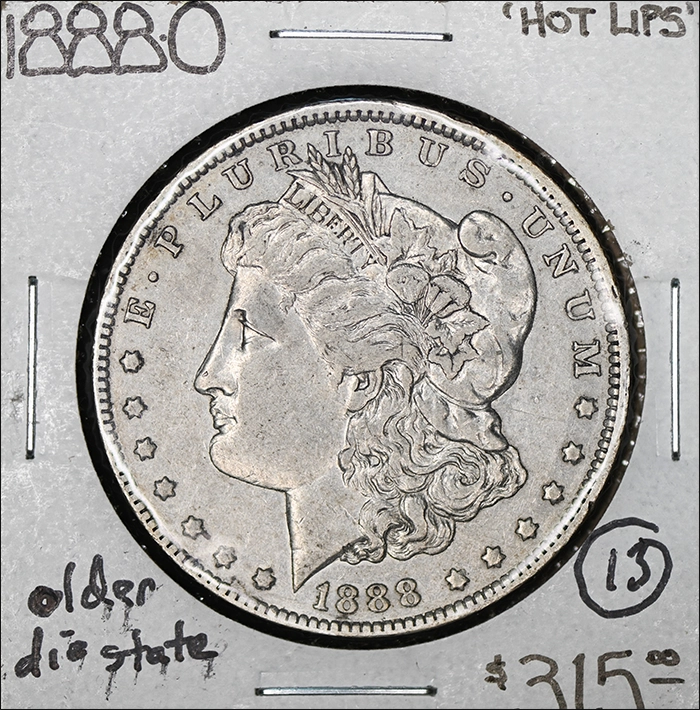
Of more general interest to the non-specialist are the 1878 Seven/Eight Tail Feathers versions; the 1878/1879/1880 reverse varieties; the 1879-CC/CC; the 1880/79-O and 1880/79-S overdates; the 1882-O/S; the 1887/6-O and 1887/6 Philadelphia overdates; the 1888-O “Hot Lips” Doubled Die Obverse; the 1899-O Micro O mintmark; the 1900-O/CC; the 1901 Doubled Die Reverse; and the 1903-S Micro S mintmark.
The Morgan 50: A Way for Everybody to Complete a Morgan Dollar Registry Set
CoinWeek editor Charles Morgan teamed up with Russ Augustin of AU Capital Management and RARCOA to assemble a list of 50 uncirculated Morgan dollars that are affordable enough so that every collector can complete the set. Called “The Morgan 50”, this set construction features coins from all five Morgan-dollar-producing mints and serves as a great entry point for collectors as they learn about the series in all its intricacies. CoinWeek has produced the first two of three planned videos that describe each of The Morgan 50 coins. Collectors can register their sets in the NGC Set Registry or at mycollect.com.
Exclusive CoinWeek Coverage of the Morgan Dollar Market
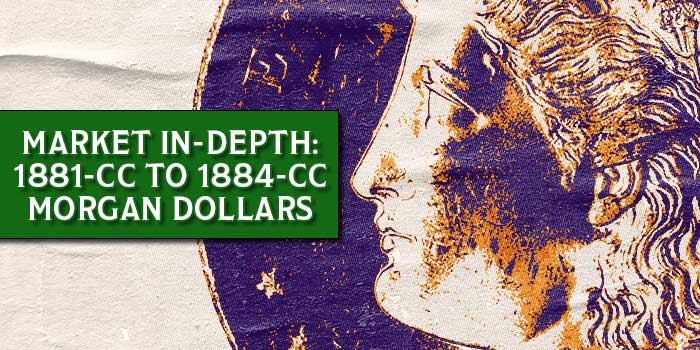
In early 2023, CoinWeek contributing writer Tyler Rossi produced this in-depth study of the market for certified 1881-CC to 1884-CC Morgan dollars. This band of dates were heavily represented in the GSA sales of the 1970s and ’80s and are the most affordable Morgan dollars from the famous Carson City Mint.
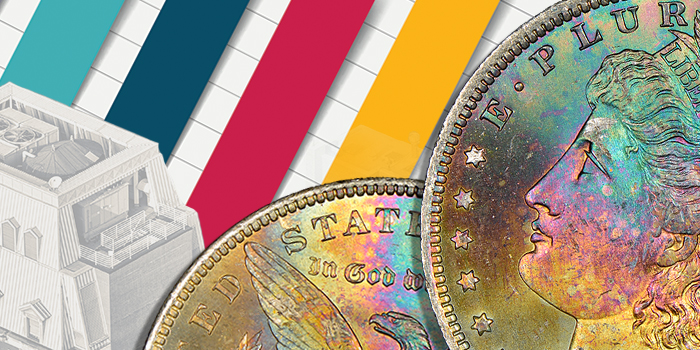
In 2018, coin dealer Jeff Garrett handled thousands of uncirculated Morgan dollars that turned up in unopened Mint bags. CoinWeek analyzes the grades of the coins found in what might be one of the last great Morgan dollar bag hoards.
Learn More About DMPL and PL Morgan Dollars
In-Depth Morgan Dollar Date Analysis by CoinWeek IQ
Morgan Dollars on the CoinWeek Podcast
- Episode #39: Q. David Bowers Discusses the 1964 Morgan Dollar
Hubs for 1964-dated Morgan dollars turned up during a 2016 tour of the Philadelphia Mint’s vault. Q. David Bowers joined Charles Morgan to discuss the discovery and how this development changes our understanding of the Treasury Department’s attempt to replenish its silver dollar supply in the mid-1960s.
- Episode #50: Talking Morgan Dollars with Leroy Van Allen
Leroy Van Allen wrote the book on collecting Morgan dollar varieties. In this episode of the CoinWeek Podcast, Van Allen joined Charles Morgan to talk about his research into the popular silver dollar series and what insights he gleaned from the published images of the 1964 Morgan dollar hubs.
Morgan Dollar Design
George Morgan’s somewhat austere Liberty faces left, dominating the obverse. Liberty’s curled hair, over the forehead and down the back, is topped by a liberty cap with a LIBERTY banner at the front, above which are small branches of wheat, cotton, and maple. Forming a concentric circle inside the denticled rim are E PLURIBUS UNUM at the top, each word separated by a centered dot, and the date at the bottom. Separating the two legends are 13 small six-point starts, seven on the left and six on the right. Morgan’s initial M is along the truncation of the neck.
The reverse shows an eagle with outstretched wings, tips reaching nearly to the dentils encircling the rim. The eagle’s left claw clutches three arrows, the right a solitary olive branch. Inside the rim is UNITED STATES OF AMERICA around the top two-thirds, and ONE DOLLAR at the bottom. A six-pointed star separates ONE and UNITED to the left, and DOLLAR and AMERICA to the right. Above the eagle, in a more stylized font than used elsewhere on the coin, is the motto IN GOD WE TRUST (upper and lower case as reproduced here). Surrounding the eagle, inside the legends, is a nearly concentric partial wreath of grain sheaves, tied at the bottom with a double-looped ribbon. The letter M is on the left loop, the first time a designer’s initial was displayed on both sides of a coin.
New Orleans (O, 1879-1904), Carson City (CC, 1878-1885, 1889-1893), San Francisco (S, 1878-1904, 1921), and Denver (D, 1921) mintmarks are located below the ribbon loops, above the DO in DOLLAR. The Philadelphia Mint produced Morgans every year of the issue, but no circulation strikes are known for 1895, all presumed melted.
The edge of the Morgan silver dollar is reeded.
Coin Specifications
| Morgan Silver Dollar | |
| Years Of Issue: | 1878-1904, 1921 |
| Mintage (Circulation): | High – 44,690,000 (1921); Low – 12,000 (1895 – but none are known, possibly all having been melted. Next lowest at 77,000 is the 1893-S.) |
| Mintage (Proof): | High – 1,355 (1880); Low – 590 (1890; A small number of Proofs have been listed from New Orleans, Carson City, and San Francisco, though this is unconfirmed by official records and considered by some to be exceptional business strikes. The San Francisco pieces were apparently made at the request of Farran Zerbe, President of the American Numismatic Association (ANA) from 1908 to 1910, and Henry Chapman, a Philadelphia coin dealer in the early 1900s.) |
| Alloy: | 90% silver, 10% copper |
| Weight: | ±26.73 grams |
| Diameter: | ±38.10 mm |
| Edge: | Reeded |
| OBV Designer | George T. Morgan |
| REV Designer | George T. Morgan |
* * *
Additional Resources
Bowers, Q. David. The Experts Guide to Collecting & Investing in Rare Coins. Whitman Publishing.
–. A Buyer’s Guide to Silver Dollars & Trade Dollars of the United States. Zyrus Press.
–. A Guide Book of Morgan Silver Dollars. Whitman Publishing.
–. A Guide Book of United States Type Coins. Whitman Publishing.
Breen, Walter. Walter Breen’s Encyclopedia of U.S. Coins. Doubleday.
Fey, Michael S. and Jeff Oxman. The Top 100 Morgan Dollar Varieties. RCI Publishing.
Fivaz, Bill and J.T. Stanton. CherryPickers’ Guide to Rare Die Varieties of United States Coins. Whitman Publishing.
Standish, Michael “Miles”. The Morgan Dollar: America’s Love Affair with a Legendary Coin, Featuring the Coins of the Coronet Collection. Whitman Publishing.
Taxay, Don. The U.S. Mint and Coinage. Arco Publishing.
Van Allen, Leroy and A. George Mallis. Comprehensive Catalog and Encyclopedia of Morgan & Peace Dollars. Worldwide Ventures, Inc.
Yeoman, R.S and Kenneth Bressett (editor). The Official Red Book: A Guide Book of United States Coins. Whitman Publishing.
* * *
The post Morgan Dollar (1878-1921) : A Collector’s Guide appeared first on CoinWeek: Rare Coin, Currency, and Bullion News for Collectors.
Heritage’s Nov. 3-4 World Coins Auction Tops $3.93 Million, Sees More Than 2,100 Bidders
A Republic gold 100 Francs 1894-A MS64 Prooflike NGC and a João V gold 400 Reis 1730-R MS62 NGC each sold for $84,000 to lead Heritage’s World Coins Platinum Session and Signature® Auction to $3,903,124 November 3-4
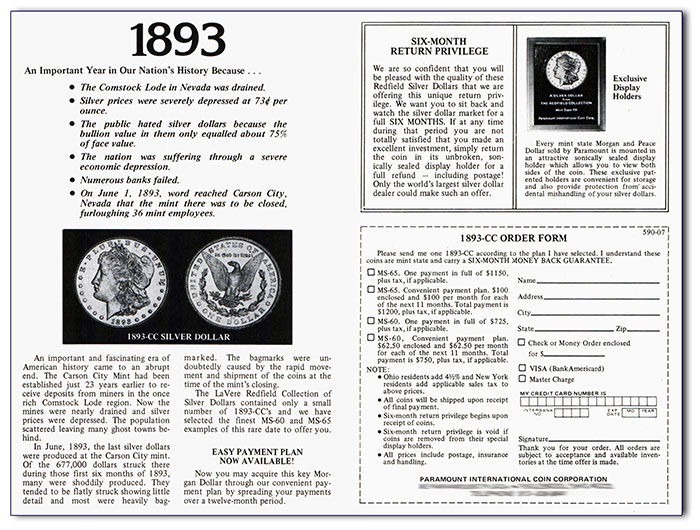
1893-CC Morgan Dollar : A Collector’s Guide

How Did the Morgan Dollar Get its Name?
The Morgan dollar gets its name from United States Mint engraver George T. Morgan, who designed the dollar coin in competition with then-Chief Engraver William Barber. The two had a generally cordial relationship, though numismatists throughout the generations have supposed that Barber may have been envious of Morgan’s talent as an engraver and treated him with some degree of unprofessionalism. This is not true.
Morgan was born in England and began working for the Mint soon after his arrival in the United States in 1876. Morgan was brought on as an assistant engraver in October 1876 and then worked under William Barber. In addition to the Liberty Head dollar, Morgan has several coin design credits to his name, including the Columbian half dollar of 1892 and 1893, and an array of pattern coins designed during the late 19th century, most notable of these being the never-released $100 Gold Union coin.
The 1893-CC Morgan Dollar Was Struck In the Final Years of the Carson City Mint
The 1893-CC Morgan dollar is the last silver coin that was struck at the Carson City branch of the United States Mint. The Mint, running out of bullion deposits from the great Comstock Lode, struck 677,000 Morgan dollars in its final year of coining operations, along with 60,000 half eagles, 14,000 eagles, and 18,402 double eagles.
The United States Mint would officially decommission the Carson City branch in 1899, leaving it open as a U.S. Assay Office until 1933. During its tenure as a coin striking facility, Carson City produced some of the most storied coins in American numismatic history. Coins struck at the Carson City Mint carry with them the allure of the Old West, of stagecoaches, cowboys, gamblers, and gunslingers. It was with this evocative imagery that the Government Services Administration (GSA) sought to market the government’s stash of Carson City dollars in the 1970s and ’80s. In that pool of coins, just one 1893-CC was found.
As far as the striking of Silver Dollars is concerned, the Carson City Mint produced coins in three distinct spurts: 1870-1873 (Seated Liberty Type), 1878-1875 (Morgan Type), and 1889-1893 (Morgan Type). As far as the Morgan dollar type is concerned, the 1893-CC is the third scarcest of the Carson City issues.
Most 1893-CC Morgan dollars wound up in the Treasury vaults with the majority of those being melted down in 1918. The sealed bags of 1893-CC dollar coins that survived the melt were paid out at the San Francisco Mint and the Washington, D.C. Cash Room.
1893-CC Morgan Dollars in the Redfield Hoard

What is likely the final dispersal of 1893-CC Morgan dollars in quantity came in 1978, When Paramount International Coin Corporation counted a small number of uncirculated examples among the 400,000 coins of the massive Redfield hoard. Accumulated in secret over the course of three decades, the hoard contained mostly uncirculated silver dollars in $1,000 mint bags. The hoard contained a number of common dates, but also counted among its number several better date Morgans, including the 1889-CC, the 1895-S, and, of course, the 1893-CC.
Unfortunately, Paramount’s handling of the Redfield Hoard left much to be desired. Many of the 1893-CC dollars were mutilated after being put through a counting machine. As a result, many coins display curvilinear scratches on the cheek and the eagle’s breast. In all likelihood, this is the quality of coin you would likely receive by purchasing an “MS60” quality coin from the April 1978 Paramount ad published in The Numismatist. Paramount also offered “MS65” coins for $1,150 (approximately $4,800 adjusted for inflation).
Assuming the quality of that coin exceeded PCGS or NGC’s standards for MS63, a buyer would have made a handsome profit off of that purchase. Recent public sales of MS63 1893-CC Morgan dollars have yielded prices in the $5,750 to $6,000 range. In MS64, the price jumps to $9,000. In MS65, the price jumps by many multiples. The record price paid for an 1893-CC is $161,000 paid for a PCGS MS66 at a Legend Morphy auction in 2013. That coin, from the Jack Lee Collection, is the PCGS plate coin for the issue.
What are 1893-CC Morgan Dollars Worth Today?
While the Carson Mint struck 677,000 1893-CC Morgan dollars, only a fraction of that mintage survive. CoinWeek estimates no more than 35,000 to 40,000 coins of this issue likely survive. NGC and PCGS combine to have graded 15,410 coins. CAC, a new grading service, reports only 17 coins in their holder as November 11, 2023. These coins were likely, once in PCGS or NGC holders. Given that it is profitable to certify even circulated 1893-CC Morgan dollars, the likelihood that there are significant numbers of coins that have yet to cycle through the grading services is low.
The value of an 1893-CC Morgan dollar depends on condition and eye appeal.
Condition relates to the amount of a wear that is imparted on a coin through circulation or mishandling. Eye appeal is a visual quality that imparts excitement on an enthusiast. When all coins are struck, they are considered to be uncirculated or in Mint State. But not all uncirculated or Mint State coins are imbued with eye appeal.
At the low end, in the most heavily circulated grades, and 1893-CC Morgan dollar is worth between $300 and $500. A circulated coin in Extra Fine condition will retain most of its design elements. At this level, 1893-CC Morgan dollars will typically sell for prices between $2,000 and $3,000. This jump in price is caused by the increased scarcity of the coin as grades approach uncirculated condition.
Coins that have never circulated will exhibit a range of features that fall in the eye appeal category. Here, the number of visible marks, the strength of the strike, the prominence of the coin’s luster, and sometimes even the color of the coin will dramatically influence the coin’s value. Uncirculated coins trade for prices approaching $10,000 for a lower-end uncirculated coin up to $200,000 or more for extraordinary examples with high eye appeal. Most uncirculated 1893-CC Morgan dollars trade between reputable coin dealers or at major auctions.
Collectors are advised to avoid purchasing any 1893-CC Morgan dollar unless it is first authenticated and certified by CAC, NGC, or PCGS. Also, purchase coins from knowledgable dealers who are authorized dealers of these three services.
Obverse:
The obverse of the 1893-CC Morgan dollar exhibits the characteristic left-facing Liberty Head motif seen on all issues of this classic dollar series. The central Liberty bust wears a Phrygian cap encircled with a ribbon adorned with the inscription LIBERTY. Miss Liberty also wears a crown of wheat and cotton, which were two of the nation’s most lucrative natural agricultural assets in the 19th century.
The phrase E PLURIBUS UNUM is inscribed along the upper half of the obverse rim, and the date 1893 is centered at the bottom of the obverse adjacent to the rim. Seven stars appear between the left side of the date and the inscription E PLURIBUS UNUM, while six stars fill the gap between the date and motto on the lower right side of the coin. In total, the 13 stars represent the 13 colonies that combined to form the original Union of the United States. At the base of Liberty’s neck is the “M” monogram representing Morgan’s initial.
Morgan designed the Liberty head bust after the likeness of Anna Willess Williams, a Philadelphia schoolteacher who modeled for the coin. Williams received significant public recognition after her face appeared on the Morgan dollar, but she rejected the attention that was heaped upon her. She refused offers for acting roles and apparently had turned down an offer for marriage following her engagement to an unknown suitor. Before dying at the age of 68 in 1926, Williams, who sat for Morgan on the sworn condition of anonymity, rebuffed her single stint as a coin design model as little more than an “incident of my youth”.
Reverse:
The reverse of the 1893-CC Morgan dollar is dominated by a heraldic eagle, its wings spread across the upper half of the coin. Between the upper tips of the eagle’s wings appears the motto IN GOD WE TRUST. The eagle clutches an olive branch in its right claw representing peace and in its left claw are three arrows symbolizing the nation’s ability to defend itself. The central eagle design is partly encircled by a laurel wreath.
Along the rim of the upper two-thirds of the reverse is the legend UNITED STATES OF AMERICA, with the tip of the eagle’s left wings, which virtually touch the coin’s rim, penetrating the space between UNITED and STATES; the right wing visually divides the words OF and AMERICA. The words ONE DOLLAR, seen at the bottom center of the reverse, are flanked by a single, six-sided star on either side of the denomination inscription. The “CC” mintmark, denoting that the coin was struck at the Carson City Mint, is located above the DO of DOLLAR.
Edge:
The edge of the 1893-CC Morgan dollar is reeded.
Designer(s):
Engraver George T. Morgan was born in Birmingham, England in 1845. He emigrated to the United States and began work as an assistant to Mint Chief Engraver William Barber and continued to produce patterns and commemoratives under the administration of Barber’s son, Charles. Morgan himself became Chief Engraver in 1917. He died in 1925.
Coin Specifications
| Country: | United States |
| Year Of Issue: | 1893 |
| Denomination: | 1 Dollar |
| Mint Mark: | CC (Carson City) |
| Mintage: | 667,000 |
| Alloy: | 90% Silver, 10% Copper |
| Weight: | 26.73 grams |
| Diameter: | 38.10 mm |
| Edge | Reeded |
| OBV Designer | George T. Morgan |
| REV Designer | George T. Morgan |
| Quality: | Business Strike |
The post 1893-CC Morgan Dollar : A Collector’s Guide appeared first on CoinWeek: Rare Coin, Currency, and Bullion News for Collectors.
Gold Marks First Weekly Loss in Five Weeks as Precious Metals Tumble
Prices for precious metals dropped on Friday, contributing to their weekly losses, which reached double digits in percentage terms for platinum and palladium, and both also extended their daily losing streaks to five in a row
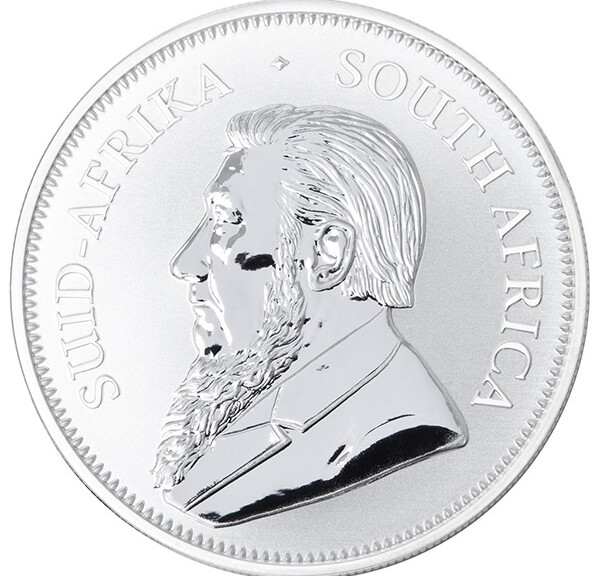
South Africa 2017 Silver Krugerrand – A Collector’s Guide
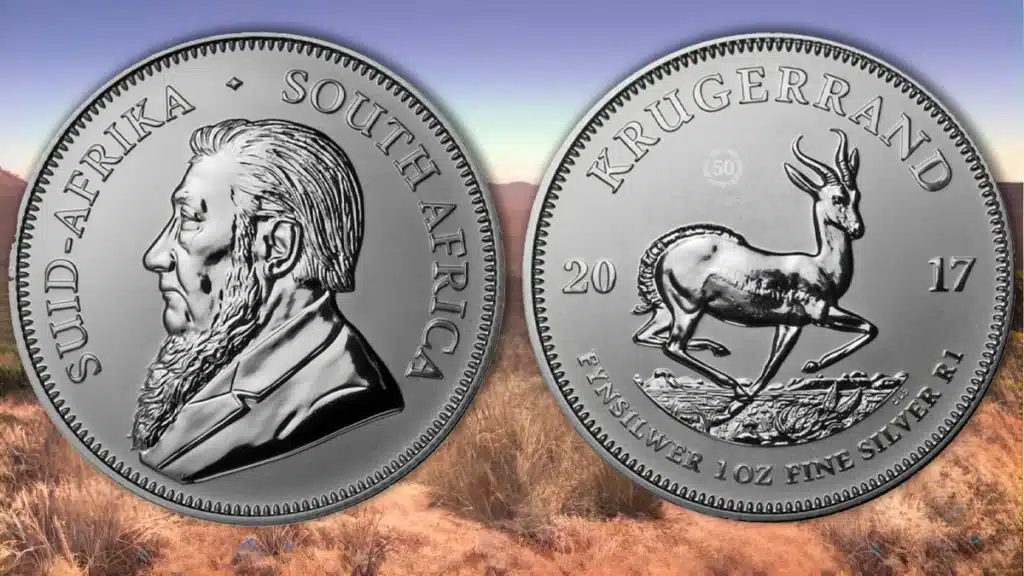
To celebrate the 50th anniversary of the introduction of the gold Krugerrand, the South African Mint produced its first-ever 1oz silver Krugerrand. Additionally, a 1oz platinum 10-rand Krugerrand was also released, as well as new sizes of the flagship gold coin.
History of The South African Krugerand Bullion Coin
The South African Krugerrand is one of the most famous coins in the world. Available as a gold coin since 1967, it is considered the first of today’s generation of modern bullion coins.
By the late 1960s, South Africa was the dominant force in world gold production. The global economy had almost completely weened itself off of the gold standard as a result of the Bretton Woods Conference at the end of World War II. The international monetary system would be delineated in US dollars while the United States would continue to back the dollar with gold. Anticipating both the ultimate end of this system and the gold standard in general (which indeed came in 1971 with the so-called “Nixon Shock“) and the presumption of private gold ownership in the united States–not to mention facing a surplus of gold as a result of its own success–the South African Mint and the Rand Refinery (established in 1920) decided to create a gold bullion coin.
On the front would be a portrait of Paul Kruger, an early 20th-century president of the South African Republic and an important political figure in that nation’s history. The back would feature a springbok, a type of antelope and a national symbol of South Africa. Taking its name from this portrait, as well as the primary monetary unit of South Africa (the rand), the Krugerrand was born.
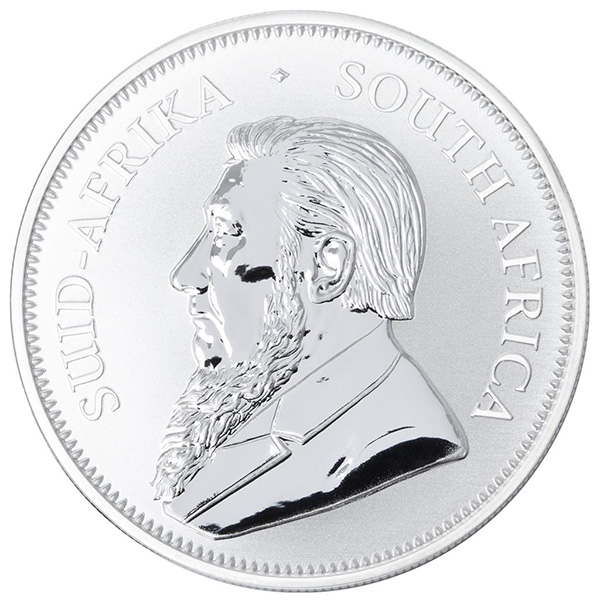 Interestingly, the coin bore no face value; the value of the coin was allowed to float according to the price of gold on the open market.
Interestingly, the coin bore no face value; the value of the coin was allowed to float according to the price of gold on the open market.
The gold Krugerrand consisted of one troy ounce of 22-karat (.9167 fine) gold, the same fineness used for the British Gold Sovereign, which was the dominant trade coin around the world until the introduction and ready acceptance of the Krugerrand. The remaining metal in the alloy was copper, which gave the coin its durability and distinctive orange-gold coloration.
The Krugerrand’s tremendous success with investors over the next decade inspired other nations to mint their own bullion coins, with the first “imitators”–the Canadian Gold Maple Leaf and the Mexican Gold Libertad–debuting in 1979 and 1981, respectively. In 1980, South Africa produced 1/2 oz, 1/4 oz and 1/10 oz versions of the coin.
The 2017 Silver Krugerrand – More Than Just a Bullion Coin
Because the 2017 Silver Krugerrand’s release marked a new chapter in the story of the South African Mint’s bullion coin program, it is no mere one-ounce silver bullion coin. It is also a special commemorative coin that marks the 50th anniversary of a new category of investment coin.
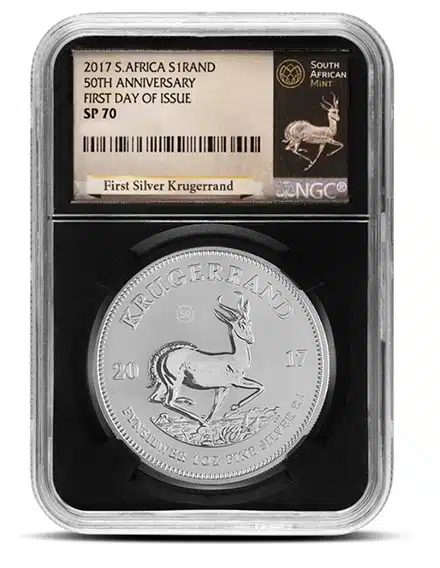
Its release was met with great enthusiasm from collectors worldwide and it was the centerpiece of the South African Mint’s World Money Fair exhibition.
Distribution in the United States did not go without a hitch, however. American retailers purchased large quantities of the coin with the intent of selling them in NGC-certified holders. Early shipments returned lower-than-expected numbers in the “perfect” 70 grade. At issue was the way the coins were packaged for delivery. The South African Mint was not experienced in the packing methods necessary to eliminate all coin-on-coin contact during the shipping process.
NGC reports that only 65% of the First Day of Issue coins qualified as 70s – despite the extra care that was taken during the coin striking process. In total, NGC certified 88,067 coins, while PCGS has certified just 2,724 pieces (with only 10% grading 70).
Later deliveries faired much better.
What is the 2017 Silver Krugerrand Worth?
A November 2023 survey of eBay prices realized indicates a realistic value for the 2017 Silver Krugerrand at between $70 and $80 for NGC SP70 coins and about $100 for PCGS 70s.
These prices indicate a significant collector premium over the coin’s one-ounce silver spot value. It also remains the key date for the series, which has seen successive releases year after year.
Design
The 2017 Silver Krugerrand features an improved version of the original Krugerrand design. Computer-assisted technology and laser etching have been utilized to enhance the dies themselves, bringing out impressively sharp details. It comes in both Proof and Premium Uncirculated finishes, the process to strike Premium Uncirculated coins being similar to the meticulous handled with care, multiple strike approach the Royal Canadian Mint uses to produce its Specimen finish. The resulting Premium Uncirculated Krugerrand is almost Reverse Proof in appearance.
Obverse:
The design of the Krugerrand’s obverse was borrowed from the 1892 South African gold pond coin, which was created under contract by Otto Schultz at the Berlin Mint in Imperial Germany because the mint in Pretoria was not ready for production. The central motif is a left-facing portrait of President Paul Kruger. He has a lengthy beard and connected sideburns but no mustache. The inscriptions SUID AFRICA and SOUTH AFRICA, separated by a small diamond shape longer than it is tall, wrap clockwise around the rim of the coin, starting in the lower left quadrant of the obverse. Pointed dentils surround the entire design
Reverse:
 The springbok takes center stage on the reverse, portrayed mid-stride with all feet in the air as it galavants over the savannah. The word KRUGERRAND arcs overhead. The motif was designed by South African sculptor Coert Steynberg. A special 50th-anniversary privy mark can be found in the field between the “G” in KRUGERRAND and the hind quarters of the springbok. Beneath the design is the inscription FYNSILWER 1 OZ FINE SILVER R1, which designates its weight, precious metal content and – in a first for Krugerrands of any kind – the face value.
The springbok takes center stage on the reverse, portrayed mid-stride with all feet in the air as it galavants over the savannah. The word KRUGERRAND arcs overhead. The motif was designed by South African sculptor Coert Steynberg. A special 50th-anniversary privy mark can be found in the field between the “G” in KRUGERRAND and the hind quarters of the springbok. Beneath the design is the inscription FYNSILWER 1 OZ FINE SILVER R1, which designates its weight, precious metal content and – in a first for Krugerrands of any kind – the face value.
The year 2017 is divided in half by the central motif, with “20” on the left and “17” on the right. As on the obverse, denticles are pointed inward as they encircle the entire side of the coin.
Edge:
The edge of the 2017 Silver Krugerrand is reeded.
Designers
Otto Schultz was an engraver with the Berlin Mint in the 19th century.
South African sculptor Coert Steynberg designs graced many South African coins in the early and middle parts of the 20th century.
Coin Specifications
| Country: | South Africa |
| Year Of Issue: | 2017 |
| Denomination(s): | 1 Rand |
| Mint Mark: | |
| Mintage: | 1,000,000 (Premium Unc.); 15,000 (Proof) |
| Alloy: | .999 Silver |
| Weight: | 31.1 g |
| Diameter: | 38.7 mm |
| Edge: | Reeded |
| OBV Designer | Otto Schultz |
| REV Designer | Coert Steynberg |
| Quality: | Premium Uncirculated, Proof |
* * *
The post South Africa 2017 Silver Krugerrand – A Collector’s Guide appeared first on CoinWeek: Rare Coin, Currency, and Bullion News for Collectors.
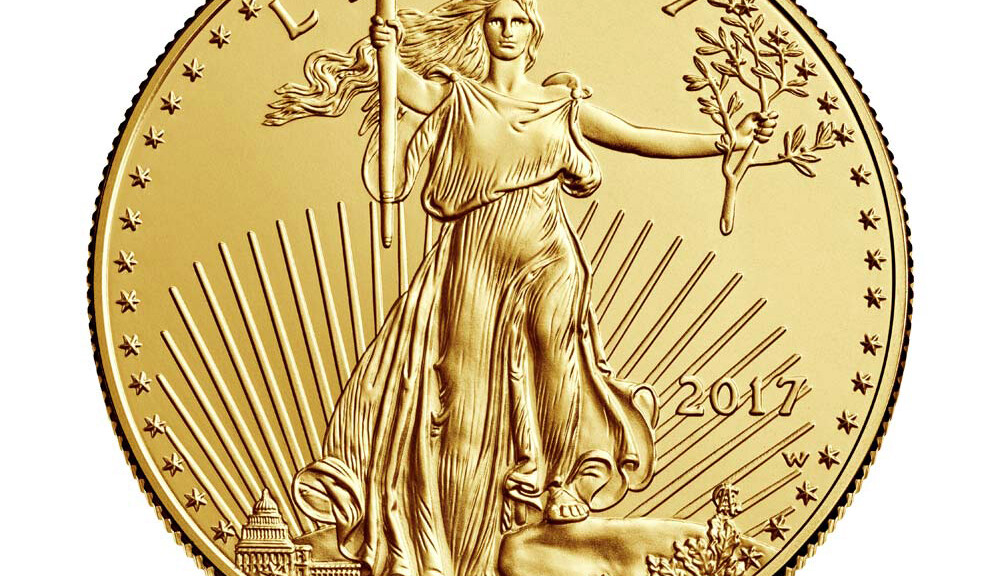
Collect Gold Coins the Financially Painless Way
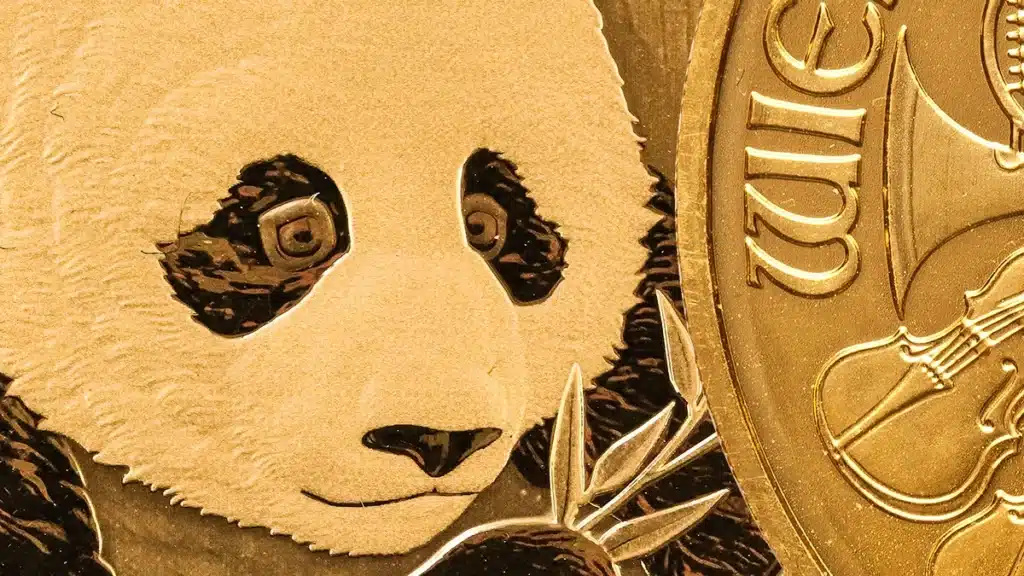
By Al Doyle for CoinWeek …..
The appeal of gold is universal, and it has nothing to do with the state of one’s finances. A desire to own the metal coupled with a small budget can be especially frustrating, but there are ways to play the gold game without large sums of cash.
Even though it hasn’t been used as daily spending money for close to 100 years, a wide selection of smaller gold pieces have been struck in recent years. How does a person build a collection? Consider these options.
One-ounce rounds are for the investor market, and the second most popular size in modern gold coinage is the 1/10-ounce version. Although premiums above melt value are higher on smaller coins, they provide the average working person with a way to accumulate gold one or two pieces at a time.

The American Gold Eagle will be the choice of many small gold shoppers, and it offers several collecting options.
First struck in 1986, the series has been issued on a continuous basis, making it ideal for a date set. Annual proofs are a second path for the diehard Eagle enthusiast. Roman numerals marked the date until 1991. There are no high-priced keys, but the 1991 will cost a little more than later issues. While many dealers stock silver Eagles by date, few professional numismatists do the same with the complete run of 1/10-ounce gold Eagles.
Canadian Maple Leafs have a worldwide following, and this series of 24-karat gold pieces stretches back to 1982. How does a person fill dates in a series that tends to be sold randomly by bullion dealers? You might have to attend a large show and sort through batches of “Maples”. Only three 1/10-business strike Eagles (1988, 1991, and 2007) sport mintages of less than 200,000, but it’s a totally different story north of the border.
Collectors who like rarity and a challenge will find it in the 1/10 ounce Leafs. Annual production ranged from 21,300 to 63,470 from 2000 to 2008, with the low points coming in 2007 and 2003 (26,940). It’s clear that the Royal Canadian Mint was more focused on one-ounce units for the investment market. Mintage numbers were under 100,000 in 2010 and 2012.
The original mass-market gold coin – the Krugerrand – is sometimes overlooked or taken for granted in a 21st-century bullion market full of newer choices. The smallest K-rand debuted in 1980, and the 21st century includes a run of low-mintage dates

Chinese Pandas and Austrian Philharmonics are other well-respected options with a track record of regular issues. Because of their popularity in the jewelry trade as well as with the general public, 1/10 Pandas tend to command higher prices than the competition. The 2006 Philharmonic features a mintage of 39,892. The musical instruments on the reverse are one of many examples of the tasteful and talented artistry that is a trademark of the Austrian Mint.
The choices don’t end with the big five. Check out the various 1/10-ounce gold coins produced by Mexico, Australia and the Isle of Man. Recent 1/10-ounce (0.1005 ounce, to be exact) Britannias are made exclusively for the collector market, as annual mintage numbers in the low four figures will attest.
A person doesn’t have to be confined to one series of modern gold. Go ahead and play the type set game by obtaining as many different designs as possible. There’s another way to derive satisfaction from small gold even if your holdings lack some of the scarcer dates. As one friend vividly described it, having a handful of 1/10-ounce gold coins “makes you feel like a low-budget King Midas.” At today’s spot prices, working up to becoming a minor league Midas is also much less expensive than it would have been a year or two ago.
The post Collect Gold Coins the Financially Painless Way appeared first on CoinWeek: Rare Coin, Currency, and Bullion News for Collectors.
U.S. Mint Produces 501.9 Million Coins in October; Kennedy 50c Mintages Now the Highest Since 1996
October saw the United States Mint’s coin production pace decrease for the fifth month in a row
LRCA Regency Auction 61 Results
Friday, Nov
Coin World and Shepherd Expos Management Announce GACC Show in Tampa
For the first time in the 63-year history of Coin World magazine (www
Gold Bounces from 3-Week Low on Thursday, Nov. 9
In prices of precious metals on Thursday, platinum and palladium extended their losing streaks to four in a row, silver climbed for a second day, and gold bounced after reaching a three-week low
2023 Reverse Proof Morgan & Peace Silver Dollars Launch
One of the most exciting products from the United States Mint this year will go on sale today at Noon ET when the 2023-S Morgan & Peace Dollar Reverse Proof Two-Coin Set launches
1794 Half Dollar and Relatives – Jack Young’s Fun With Fakes
By Jack D. Young, Early American Coppers (EAC), and the Dark Side Group ……
My latest installment of this CoinWeek exclusive series will initially focus on a bad 1794 half dollar, starting with this popular listing:
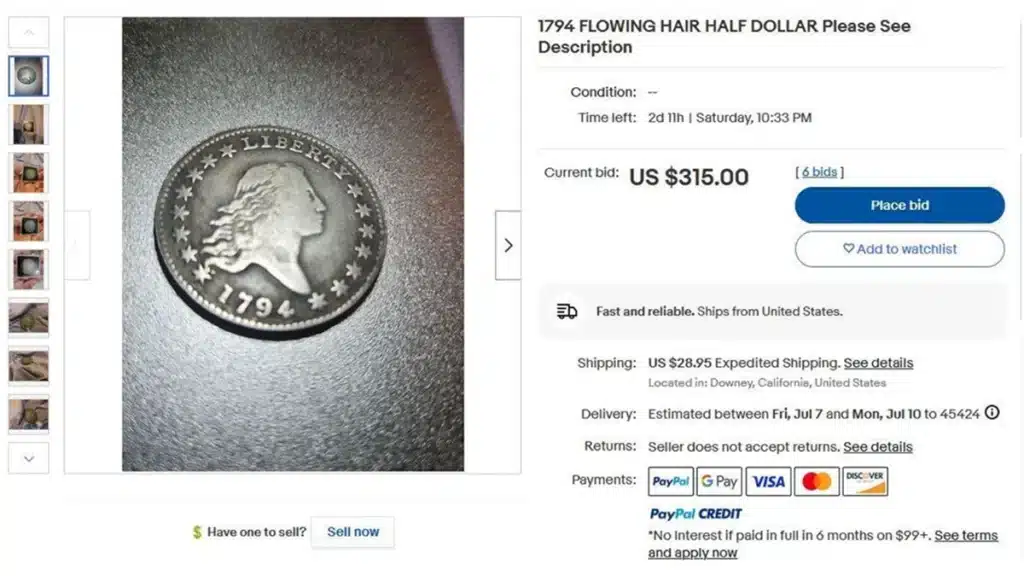
Attribution is always my starting point for any subject example, and I looked to compare this suspect coin with a known genuine one. The subject doesn’t match any known genuine example, so I picked the closest match (O-105) for a comparison image. A couple of differences initially stood out as circled:
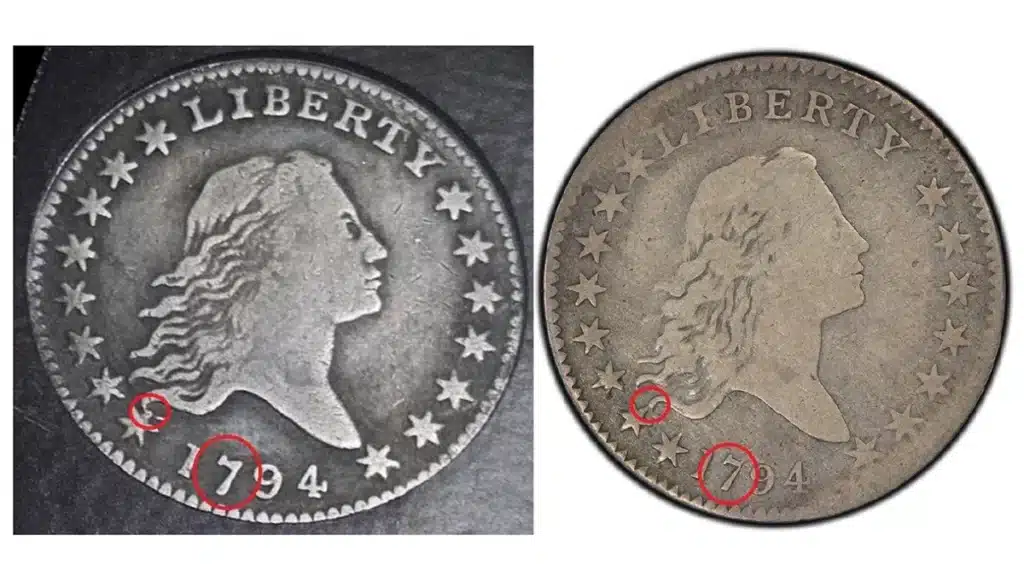
I also took notice of two possible attribution marks on the reverse:

These highlighted marks may be used to identify various dated fakes in this series. As luck would have it, someone in another forum had posted a similar example, claiming it was a “dug find”.
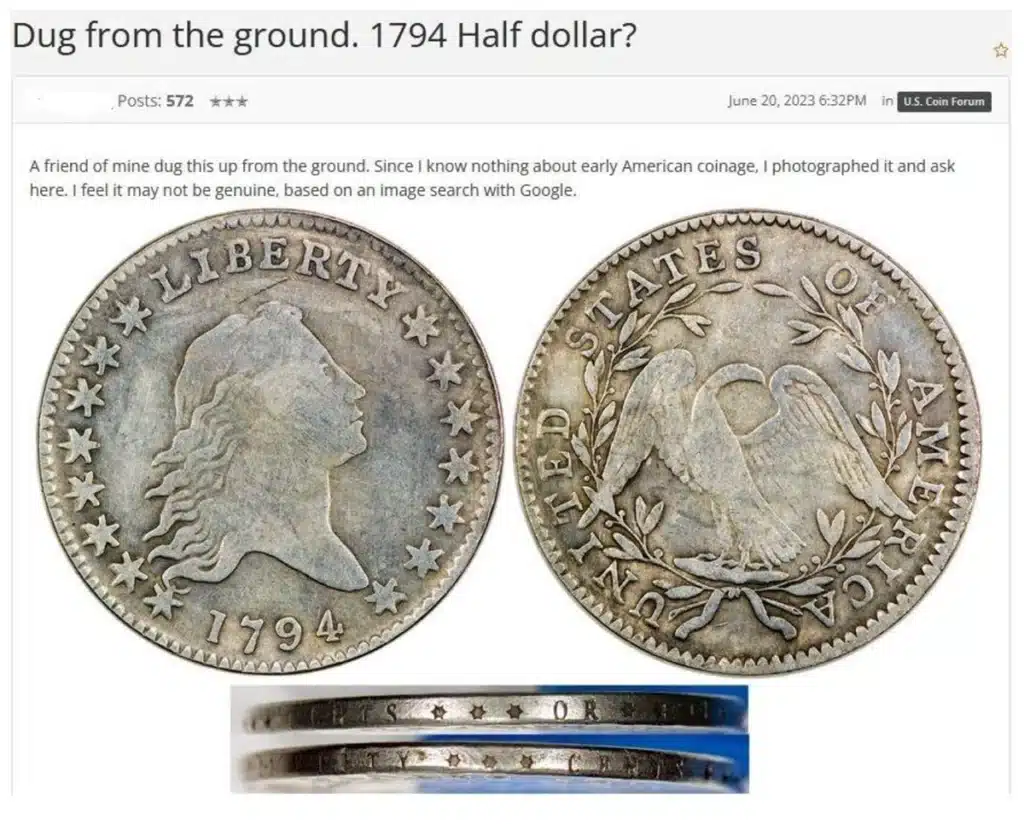
The images were well done, showing that the details match up – including the two reverse marks. Not bad for a rare 1794 non-variety!

With two matching examples, the effort turned to attributing the possible source example used to make the dies to strike these fakes. That went pretty quickly, as there are only two dates of Flowing Hair half dollars; focusing on the 1795 O-119 variety resulted in an unexpected match. The green-circled attributes of this die variety both match the subject 1794, which cannot be…
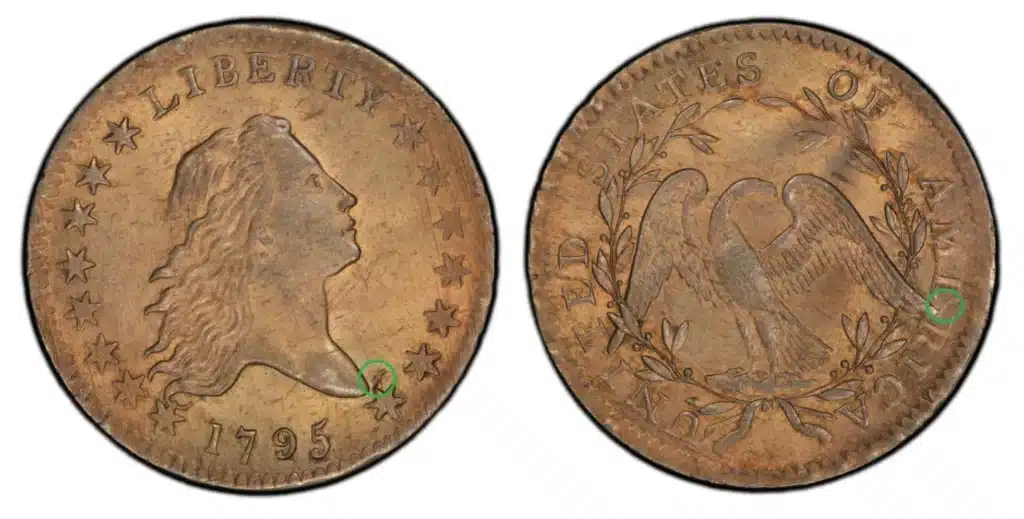
The second highlighted reverse mark, the “scratch” by the left ribbon, is not common to this variety.
And, of course, there are “replica” 1795s with matching marks to the subject 1794 half dollar:
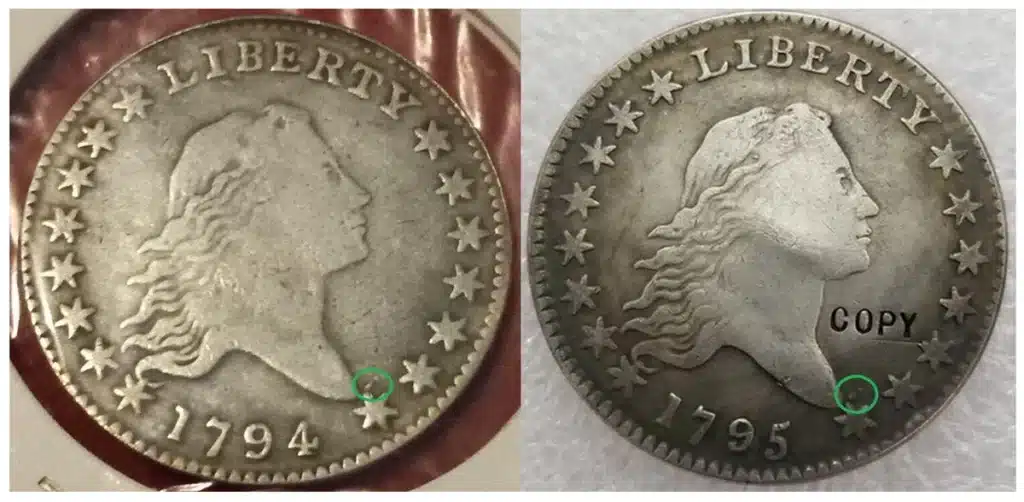
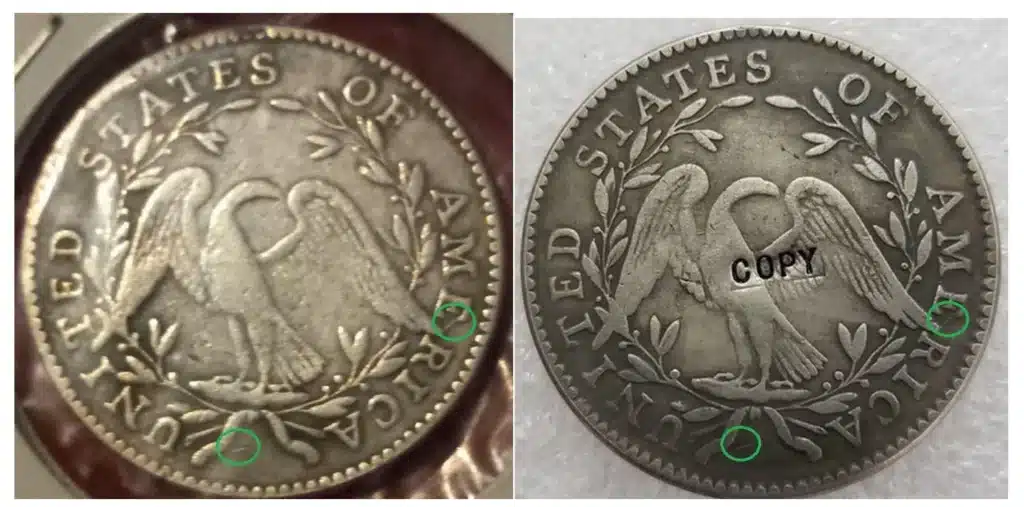
Here’s a listing on AliExpress, where the “coin” is a little cheaper and can be had without that pesky “COPY”!

And a twist, if you thought it couldn’t get worse: counterfeit 1795s in fake holders!
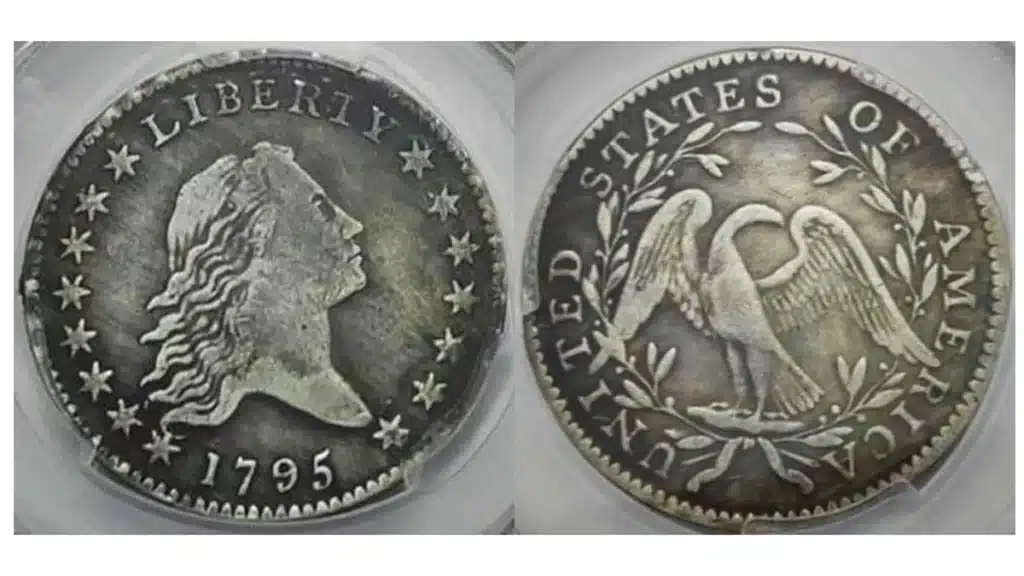
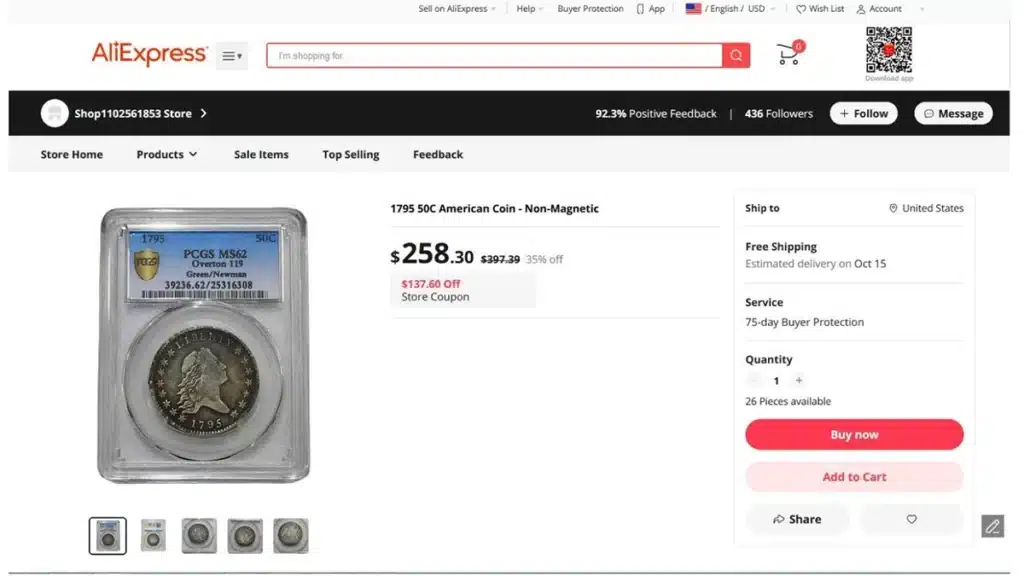
But for a final twist, I ran into this:
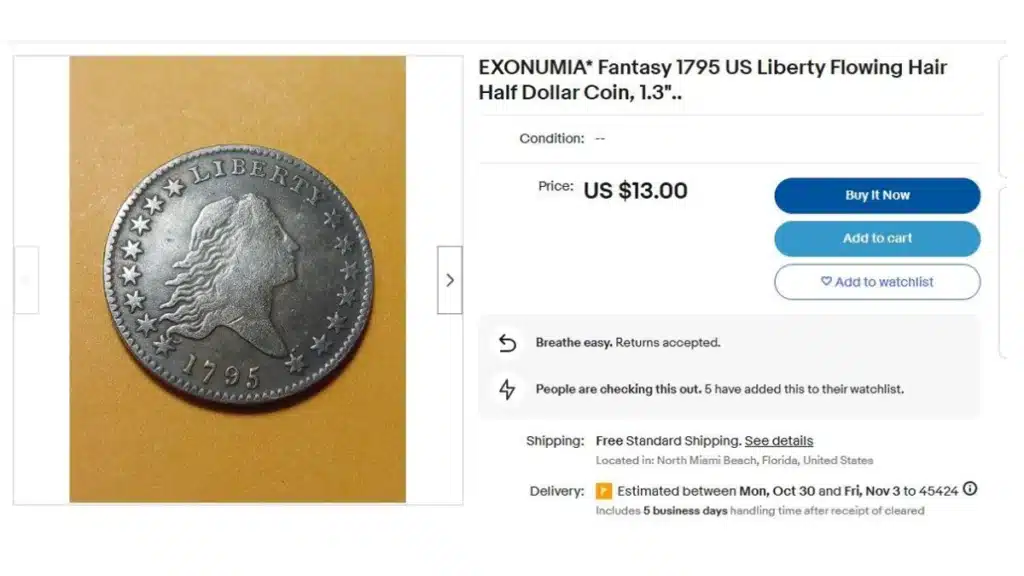
And the common reverse:
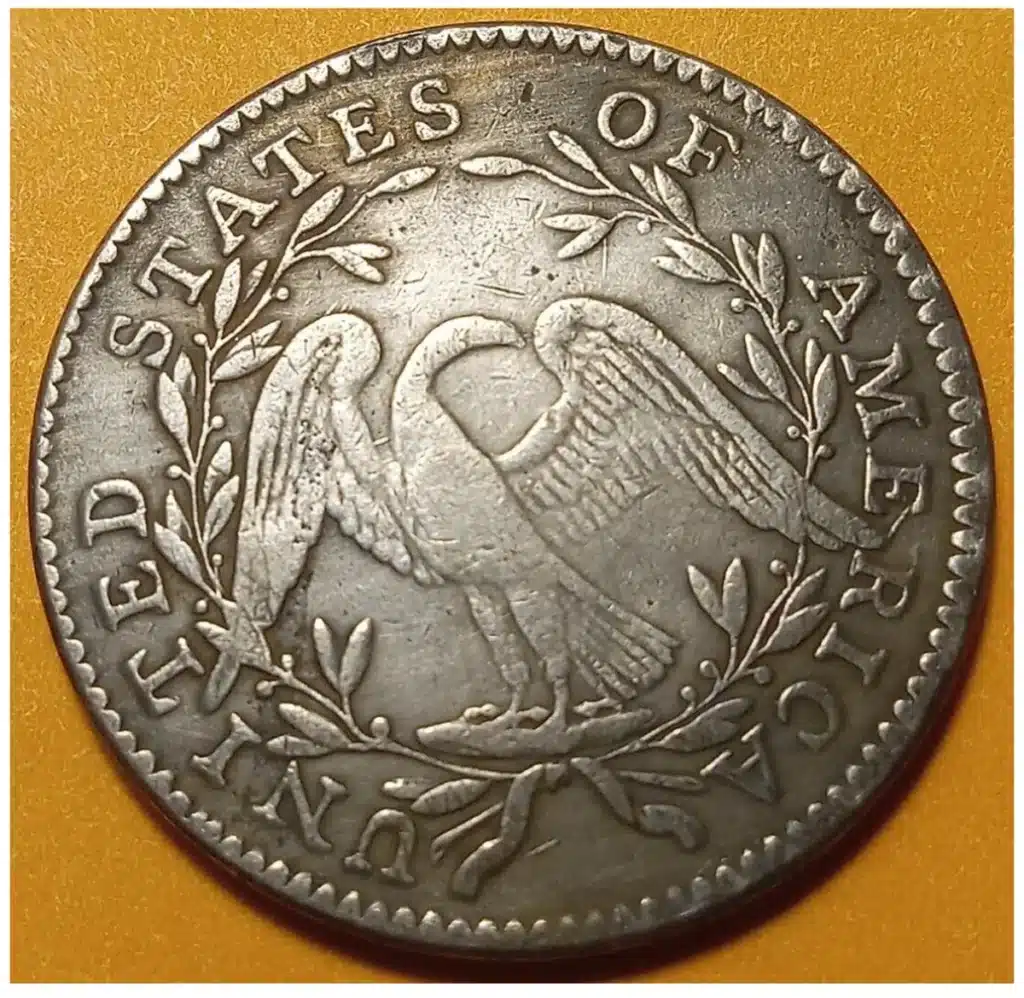
Stay thirsty, my friends!
Best,
—Jack
MORE Articles on Counterfeit Coins by Jack D. Young
* * *
The post 1794 Half Dollar and Relatives – Jack Young’s Fun With Fakes appeared first on CoinWeek: Rare Coin, Currency, and Bullion News for Collectors.
American Innovation 2023 Reverse Proof Set Available Nov. 14

The American Innovation 2023 $1 Coin Reverse Proof Set wil be available for purchase directly from the United States Mint on November 14 at noon EST. The initial retail price for the set (product code 23GC) is $28.00 USD. A household limit of five sets is currently in effect.
The American Innovation $1 Coin Program is a multi-year series featuring unique reverse designs that celebrate American ingenuity and commemorate the individuals and groups from each state, territory, and the District of Columbia. This year’s coins feature the sates of Mississippi, Indiana, Louisiana, and Ohio. All are included in the American Innovation $1 Coin 2023 Reverse Proof Set.
These Reverse Proof coins are struck in 6.0% zinc, 3.5% manganese, 2.0% nickel, and the remainder copper. Artistic Infusion Program (AIP) designers created the four reverses for 2023, which were sculpted by U.S. Mint Medallic Artists.
Ohio – This design depicts two strong hands grasped together, the upper arm pulling the lower arm upward, representing the support and strength required by both parties on the Underground Railroad. A chain fastened to a rustic shackle around the lower arm’s wrist snaps and fragments, alluding to the hope of freedom. The inscriptions are “UNITED STATES OF AMERICA,” “UNDERGROUND RAILROAD,” and “OHIO.” AIP Designer Beth Zaiken created the design, which was sculpted by Medallic Artist Stephen Layne.
Louisiana – This design depicts a Higgins Boat as it would have been deployed during World War II with its innovative landing ramp open against a beach. Included inscriptions are “UNITED STATES of AMERICA,” “THE HIGGINS BOAT,” and “LOUISIANA.” AIP Designer Dennis Friel created the design, which was sculpted by Medallic Artist John P. McGraw.
Indiana – This design depicts a series of vehicles that showcase Indiana innovations from yesterday and today. From top to bottom, the design includes an early style gas automobile, a representation of classic car production, and a recent model of an Indy style race car. Inscriptions are “UNITED STATES OF AMERICA” and “INDIANA.” AIP Designer Ron Sanders created the design, which was sculpted by Medallic Artist Phebe Hemphill.
Mississippi – This design depicts a pair of human lungs in the background, while a surgical assistant passes forceps to the surgeon during the first lung transplant surgery. Inscriptions are “UNITED STATES OF AMERICA,” “FIRST HUMAN LUNG TRANSPLANT,” and “MISSISSIPPI.” AIP Designer Katelyn Arquette created the design, which was sculpted by Medallic Artist Craig A. Campbell.
The obverse of all American Innovation dollar coins depicts the Statue of Liberty in profile, as well as the motto “IN GOD WE TRUST” and denomination “$1.” The design also includes a privy mark of a stylized gear, representing industry and innovation which changes with every year of the program. The inscriptions “2023,” the mint mark, and “E PLURIBUS UNUM” are incused on the edge of the coin. AIP Designer Justin Kunz created the design, which was sculpted by Medallic Artist Phebe Hemphill. All coins in the Reverse Proof Set were struck at the San Francisco Mint. A certificate of authenticity is included in every set.
To sign up for a REMIND ME alert for this product, please visit catalog.usmint.gov/american-innovation-1-coin-2023-reverse-proof-set-23GC.html (product code 23GC).
The American Innovation $1 Coin Reverse Proof Sets are also part of the Mint’s Product Subscription Program. Structured like a magazine subscription, this program affords customers the convenience of signing up to receive automatic shipments of products in a series. The shipments continue until the subscription is cancelled. For more information, visit catalog.usmint.gov/shop/subscriptions. Additional products in the American Innovation $1 Coin Program are availablehere.
* * *
The post American Innovation 2023 Reverse Proof Set Available Nov. 14 appeared first on CoinWeek: Rare Coin, Currency, and Bullion News for Collectors.
Indian Head Cent, Copper-Nickel (1860-1864) : A Collector’s Guide

The Indian Head cent created by United States Mint Chief Engraver James B. Longacre debuted in 1859.
The previous Flying Eagle cent had been minted for only three years (including the 1856 pattern, which is usually considered a regular issue by collectors). The apparent reason for the change from the Flying Eagle to the Indian Head cent was the weakness of the Flying Eagle design’s strike, brought about because high relief areas on both sides of the coin were opposite each other. Longacre himself, perhaps with assistance from engraver Anthony C. Paquet, started producing patterns in 1858 for a replacement cent that used both the Flying Eagle and the Indian Head motifs. Much has been written about the incongruity of depicting a woman with an Indian chief war bonnet, even when abstracted as a representation of Liberty. Longacre, however, in a letter to Mint Director James R. Snowden, expressed the belief that the headdress was a fitting representation of the “primitive” nature of America’s nationality, and that such a depiction of Liberty was not at all contrary to the sensibilities of the “intelligent American.”
The Indian Head Cent During the Civil War
The reverse laurel wreath design was modified in 1860 from a laurel wreath to an oak wreath and narrow Union shield. Reasons for the change are not known today, though some have speculated that with the Civil War looming the shield was meant to portray a sense of unity.
Millions of Indian Head cents were produced, and by the end of 1860 there was an apparent overabundance of one-cent coins, both Flying Eagle and Indian Head. Debts of multiple dollars were being paid with the cents, provoking a negative reaction from business owners (much as could be expected if the same were done by a consumer today). By 1862, however, the United States was deeply entrenched in the Civil War. With the outcome of that conflict uncertain, not only were silver and gold coins hoarded but so were copper coins. The production of cents nearly tripled from 1861 to 1862, and then almost doubled again in 1863, but still the coins were hoarded. Demand for cents was such that those who wanted them often paid a premium over face value (up to 4% in New York and Massachusetts). Privately issued notes, encased postage stamps, fractional currency, and a multitude of tokens were seen in commerce along with the U.S. cent, but the cent was preferred by the public. Not until 1864 did the situation ease – the same year that marked the transition from a copper-nickel cent composition to bronze.
Thousands of business strike copper-nickel Indian Head cents have been certified, including a few prooflike specimens. Examples are moderately priced until Premium Gem for most issues. Prices for the 1860 Pointed Bust variety are higher than other issues in Mint State and finer, much more so as near-Gem and finer.
Fewer Proof coins have been certified (naturally), including some designated Cameo and Deep Cameo. Proof coin prices are moderate, but increase at Select Uncirculated grades to expensive as Gem or finer. Prices for 1861 Proofs are moderately higher priced than other issues, significantly so in Gem and finer.
Varieties

Very few varieties of the Type 2 (copper-nickel) Indian Head cent are known, but those that are known are primarily date- and die-doubling examples. The best known variety is the 1860 Pointed Bust, so-called because the tip of the bust is more pointed than the rounded end typically seen.
In-Depth Copper-Nickel Indian Head Cent Date Analysis by CoinWeek IQ
Indian Head Cent Design
Liberty’s face on the cent is similar to Longacre’s 1854 Three Dollar Gold piece and also bears resemblance to his 1849 gold dollar and $20 double eagle Liberty portraits. Wearing a beaded necklace, Liberty faces left. On her head is a nine-feathered Indian war bonnet with a band displaying LIBERTY. Locks of hair drape down the back, and one end of the diamond-patterned head band curls slightly to the front, with the other end somewhat hidden between the hair and the bottom feather. UNITED STATES follows along a dentilled border to the left, OF AMERICA along the right. The date is at the bottom.
The reverse has a concentric two-part wreath inside a denticled rim, tied together at the bottom by a ribbon that also binds three arrows. The wreath is mostly composed of oak leaves with acorns, though another type of leaf is shown at the bottom on the left side. The top ends of the wreath separate to allow for the placement of a small Union shield, and ONE CENT is prominently displayed in the center of the flan. All copper-nickel Indian Head cents were produced in Philadelphia so no mintmark is displayed.
The edge is plain or smooth, without reeding or edge lettering.
Coin Specifications
| Indian Head Cent | |
| Years Of Issue: | 1860-64 |
| Mintage (Circulation): | High – 49,840,000 (1863); Low – 13,740,000 (1864 copper-nickel composition; additional 1864 business strike coins minted in bronze) |
| Mintage (Proof): | High – 1,000 (1860 and 1861, estimated); Low – 370 (1864 copper-nickel composition, estimated; additional 1864 Proofs minted in bronze) |
| Alloy: | 88% copper, 12% nickel |
| Weight: | 4.67 g |
| Diameter: | 19.00 mm |
| Edge: | Plain |
| OBV Designer | James B. Longacre |
| REV Designer | James B. Longacre |
* * *
References
Bowers, Q. David. The Experts Guide to Collecting & Investing in Rare Coins. Whitman Publishing.
–. A Guide Book of United States Type Coins. Whitman Publishing.
Breen, Walter. Walter Breen’s Encyclopedia of U.S. Coins. Doubleday.
Feigenbaum, David Lawrence and John Feigenbaum. The Complete Guide to Certified Barber Coinage. DLRC Press.
Guth, Ron and Jeff Garrett. United States Coinage: A Study by Type. Whitman Publishing.
Lange, David W. The Complete Guide to Lincoln Cents. Zyrus Press.
–. Coin Collecting Boards of the 1930s and 1940s. Pennyboard Press.
Snow, Richard. A Guide Book of Flying Eagle and Indian Head Cents. Whitman Publishing.
Taxay, Don. The U.S. Mint and Coinage. Arco Publishing.
Yeoman, R.S and Kenneth Bressett (editor). The Official Red Book: A Guide Book of United States Coins. Whitman Publishing.
* * *
The post Indian Head Cent, Copper-Nickel (1860-1864) : A Collector’s Guide appeared first on CoinWeek: Rare Coin, Currency, and Bullion News for Collectors.
US Mint Sales: 2023-S Proof Silver Eagle Declines for Second Week
Gold Marks New 3-Week Low; Silver Bounces Higher
Setting aside silver, which rebounded from an almost four-week low, the prices of precious metals declined for a third straight session on Wednesday, with gold registering a new three-week low
CAC-Approved Coins Bring Premiums in October 2023
CAC-approved coins fared well in many public sales during the month of October. Here are 10 examples, which were selected from a large number of results that could have been listed.
1. 1905 Lewis & Clark Commemorative Gold Dollar in MS-66
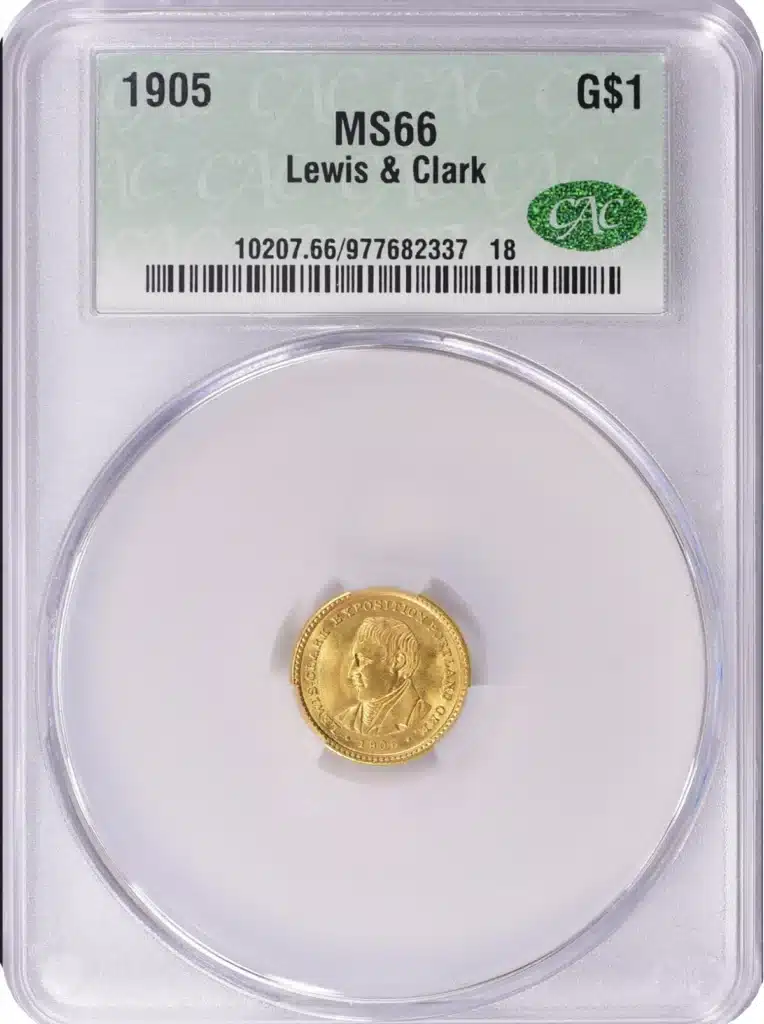
On October 1, at 07:08:09 PM Pacific Time, GreatCollections sold a CACG-graded MS-66 1905 Lewis & Clark Commemorative Gold Dollar coin for $18,356.80 USD. Three seconds earlier, at 07:08:06 PM Pacific Time, GreatCollections had sold a PCGS-graded 1905 Lewis & Clark One Dollar Gold coin, without a CAC sticker, for $7,052.62.
2. 1923 Peace Dollar in MS-67

On Oct. 22, GreatCollections sold a CACG-graded MS-67 1923 Peace silver dollar for $5,775. On July 21, Heritage Auctions sold a PCGS-graded MS-67 1923 dollar, without a CAC sticker, for $3,360. On May 5, Heritage auctioned a different PCGS-graded MS-67 1923 dollar, without a CAC sticker, for $4,080.
Although CAC has been affixing stickers to acceptable PCGS- or NGC-graded coins since 2007, the CACG grading service, with its own CACG holders, is new in 2023.
3. 1942-D Walking Liberty Half Dollar in MS-67
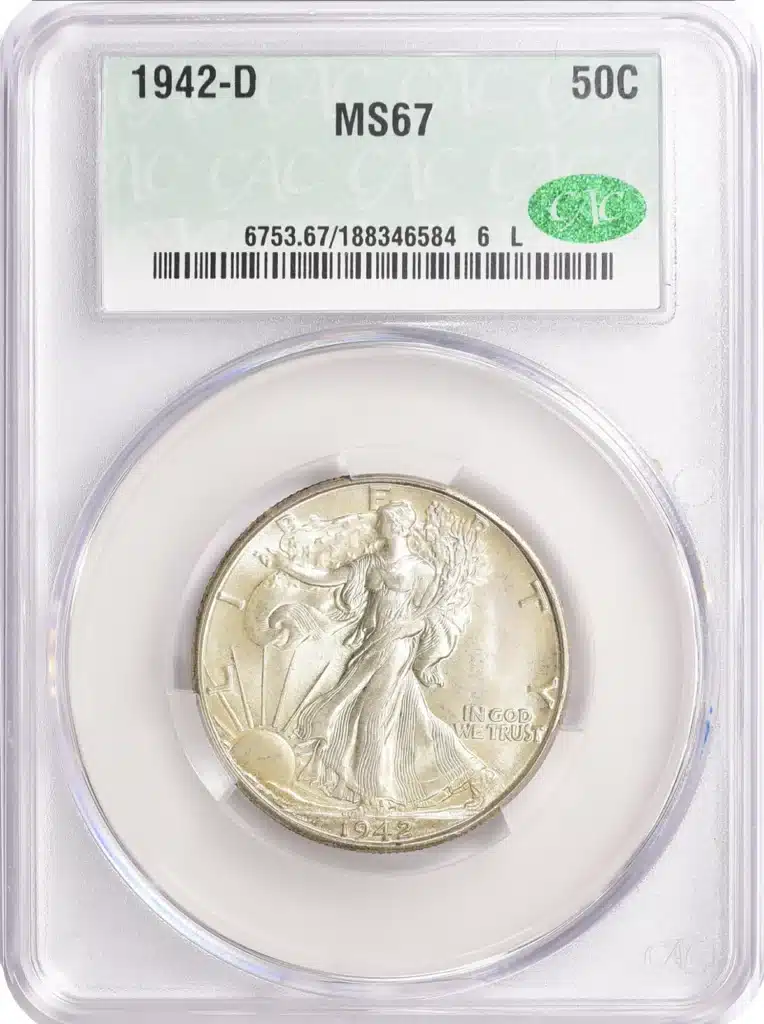
On Oct. 22, GreatCollections sold a CACG-graded MS-67 1942-D Walking Liberty half dollar for $2,093.30. On May 30, Heritage sold a PCGS-graded MS-67 1942-D half, without a CAC sticker, for $576. On May 9, Heritage sold another PCGS-graded MS-67 1942-D half dollar, without a CAC sticker, for $720.
4. 1937 Walking Liberty Half Dollar in MS-67

On Oct. 22, GreatCollections sold a CACG-graded MS-67 1937 half dollar for $1,760. On May 9, Heritage sold a PCGS-graded MS-67 1937 half, without a CAC sticker, for $900. On April 27, Legend Rare Coin Auctions auctioned a different PCGS-graded MS-67 1937 half, without a CAC sticker, for $1,175.
5. 1936 Gettysburg Commemorative Half Dollar in MS-67

On Oct. 22, GreatCollections sold a CACG-graded MS-67 Gettysburg Commemorative Silver Half Dollar for $1,925. On August 7, Heritage sold a PCGS-graded MS-67 Gettysburg commemorative half dollar, without a CAC sticker, for $1,500.
6. 1911-D Saint-Gaudens $20 Double Eagle in MS-65

On Oct. 22, GreatCollections sold a CACG-graded MS-65 1911-D $20 Double Eagle gold coin for $4,400. On July 21, Heritage sold a PCGS-graded MS-65 1911-D, without a CAC sticker, for $2,880. On February 9, Heritage sold a different PCGS-graded MS-65 1911-D, without a CAC sticker, for $3,360.
7. 1934 Maryland Tercentenary Commemorative Half Dollar in MS-66
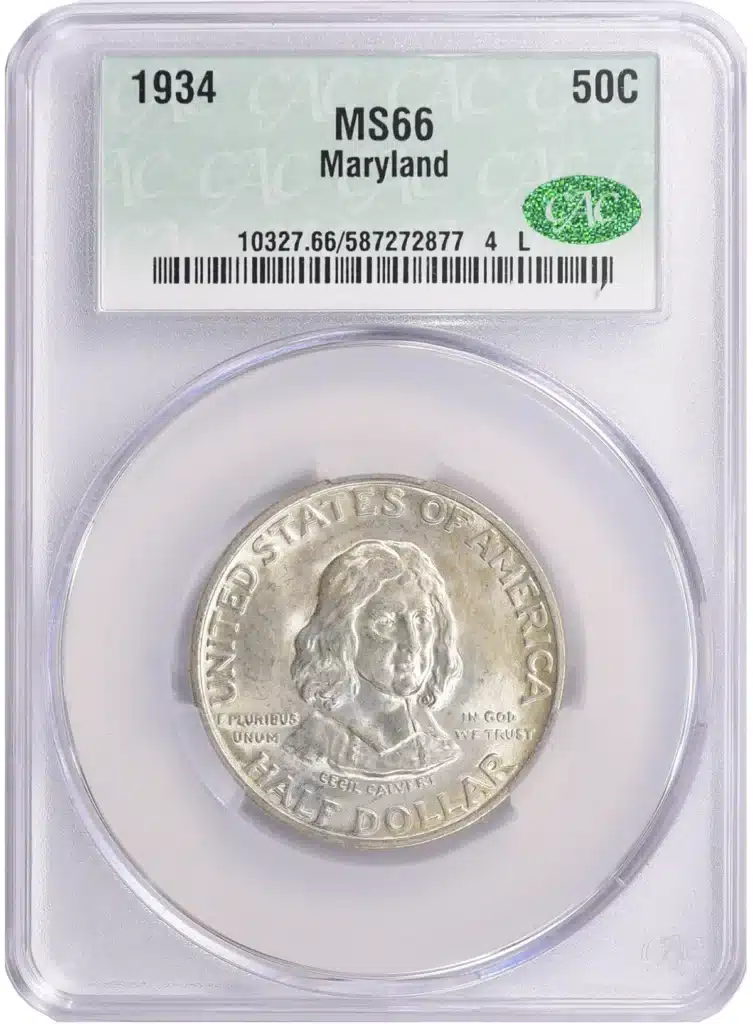
On Oct. 22, GreatCollections sold a CACG-graded MS-66 Maryland Tercentenary Commemorative Half Dollar for $429.
CAC-graded coins were encapsulated in the new CAC office in Virginia and are in new CACG holders. CAC-approved coins are in PCGS or NGC holders with CAC stickers. From now on, CAC-graded coins will be referred to as CACG. On July 24, Heritage sold four PCGS-graded MS-66 Maryland half dollars, not one of which had a CAC sticker, for $252, $228, $228, and $222, respectively.
A CACG-certified MS-66 coin thus brought twice as much as each of four different PCGS graded MS-66 Maryland commemorative halves.
8. 1908-S $5 Half Eagle in AU-58
On Oct. 18, Heritage auctioned a CAC-approved, NGC-graded AU-58 1908-S $5 Half Eagle gold coin for $4,440. On May 10, Stack’s Bowers sold a PCGS-graded AU-58 1908-S, without a CAC sticker, for $3,120. On Nov. 23, 2022, Heritage sold a different PCGS graded AU-58 1908-S, without a CAC sticker, for this same price, $3,120.
9. 1893 Isabella Commemorative Quarter in MS-65
On Oct. 9, Heritage sold a CAC-approved MS-65 grade 1893 Isabella quarter for $2,100. On Oct. 18, Heritage sold a PCGS-graded MS-65 1893 Isabella quarter, without a CAC sticker, for $810.
10. 1900 Lafayette Commemorative Dollar in MS-63
On Oct. 9, Heritage sold a CAC-approved MS-63 grade 1900 Lafayette Commemorative silver dollar for $2,520. On Sept. 17, Heritage sold a PCGS-graded MS-63 1900 Lafayette dollar, without a CAC sticker, for $1,740.
* * *
The post CAC-Approved Coins Bring Premiums in October 2023 appeared first on CoinWeek: Rare Coin, Currency, and Bullion News for Collectors.
French Gold 100 Francs Tops $3.93 Million Heritage Auction

A French Republic gold 100 Francs 1894-A NGC MS64 Prooflike and a João V gold 400 Reis 1730-R MS62 NGC each went for $84,000 USD to lead the recent World Coins Platinum Session and Signature Auction from Heritage to $3,903,124, held on November 3-4, 2023.
From the KJR Collection, the French gold 100 Francs is from an original mintage of just 143 pieces, only five of which (including this example) have earned the Prooflike designation from a major third party grading services.
Other auction highlights from the collection included a Republic gold 100 Francs 1894-A MS63 NGC, Paris mint, KM832, Fr-590, Gad-1137 that realized $50,400 and a Republic gold 100 Francs 1887-A MS63 PCGS, Paris mint, KM832, Gad-1137, F-552 that garnered $39,600.
The Brazilian João V gold 400 Reis is designated by NGC and PCGS as the highest-graded and only certified Mint State piece known. The type is so elusive that it has not been offered by Heritage Auctions since January of 2015, when it sold for over $14,100.

Among other South American lots in the auction was one of eight Republic of Peru gold 100 Soles 1958 MS65 NGC, Lima mint, KM231, Fr-78. Mintage: 101, which sold for $63,000. This piece, from the VMF Collection, shares the top spot in the census.
An Anne gold Guinea 1714 MS65 NGC, KM534, S-3574, Farey-570 closed at $60,000. This coin from the Jessica & Amanda Collection is from the final year of Queen Anne’s historic reign. Mint State examples are rare, and this is the finest-graded specimen.
An extremely rare Silver 2 Para of Moldavia & Wallachia, which is among the most difficult of Catherine II’s coinages to locate, with just seven auction appearances over the last 20 years or so, reached $55,200. This is one of two certified examples. Only a few off-metal Patterns were made in silver.
Another Russian coin nearly doubled its auction estimate when a Nicholas I gold 5 Roubles 1827 CПБ-ПД AU58 NGC, St. Petersburg mint, KM-C174, Fr-154, Bit-2 (R3) sold for $38,400. Among the hardest to locate 5 Roubles from teh reign of Nicholas I, this example carries the second-highest grade among three examples ever submitted to a major grading service.
Among ancient coins in the auction was a Lydian Croesus (561-546 BC). AV stater (16mm, 8.07 gm). NGC Choice AU 5/5 – 5/5 that realized $32,400.
* * *
The post French Gold 100 Francs Tops $3.93 Million Heritage Auction appeared first on CoinWeek: Rare Coin, Currency, and Bullion News for Collectors.
Money Museum at the ANA Wins Technology Award

The American Numismatic Association (ANA) Edward C. Rochette Money Museum, physically located in Colorado Springs, Colorado, received the Mountain Plains Museum Association’s (MPMA) 2023 Award for Museum Technology. The MPMA Technology Competition recognizes museums for innovative and effective use of technology to serve the needs of their audience. This is a juried competition with a minimum of three judges selected from among museum and other professionals with expertise in media and technology programming, production, and content development.
The Money Museum was selected to receive the award for the History of Money exhibit 360 Virtual Tour created by the team of ANA Museum Curator Douglas Mudd, ANA Creative Services Manager Ben Scott, ANA Photography Director Rob Kelley, and ANA Digital Content Director Pete Gentzler. The award was presented on September 29 at the MPMA’s annual conference, held this year in Corpus Christi, Texas.
The History of Money exhibit 360 Virtual Tour shows how money has evolved over the last 10,000 years – from its earliest forms to those of the present day. People can view this exhibit onlne by visiting money.org/hom-vrtour.
The Edward C. Rochette Money Museum is operated by the nonprofit American Numismatic Association (ANA), which is dedicated to encouraging the study and collection of coins and related items. The ANA helps its members and the public discover and explore the world of money through its vast array of educational programs including its museum, library, publications, conventions and webinars. For more information, visit money.org.
* * *
The post Money Museum at the ANA Wins Technology Award appeared first on CoinWeek: Rare Coin, Currency, and Bullion News for Collectors.
Gold Bullion Sales at The Perth Mint Continued to Climb in October
Demand for Australian gold bullion reached a three-month high in October, while demand for Australian silver bullion dipped slightly, according to figures from The Perth Mint of Australia
Gold and Silver End Near 3- and 4-Week Lows
Precious metals posted a second consecutive day of declines, with losses ranging from 0
Amazing Barber Dimes from the Stewart Blay Collection
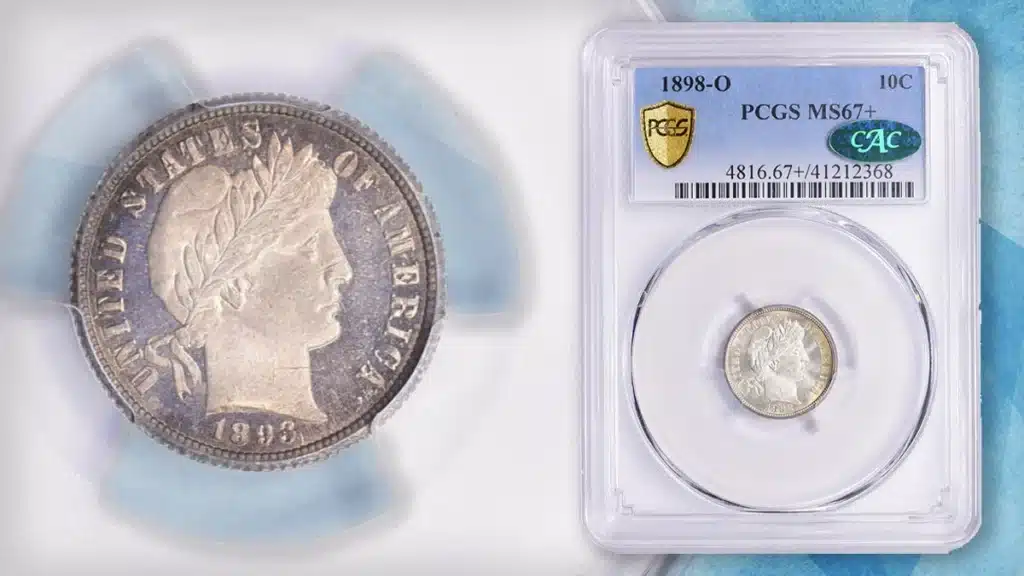
As part of its continuing series of offerings from the exceptional Stewart Blay Collection, GreatCollections will be presenting Blay’s selection of Barber dimes over two separate online auction sessions: the first on Sunday, November 12, and the second on Sunday, Nov. 19, 2023.
A New York sculptor and coin collector, Stewart Blay was one of the most significant “quality” collectors of his era. His coins represent an unquinchable thirst for the “best-of-the-best” that took Blay all around the country throughout five decades of collecting.
The Blay Collection of Lincoln cents, considered one of the finest ever assembled, was sold by GreatCollections in January 2023. It set several new price records on its way to garnering over $7.7 million USD and immediately became an important landmark in the history of the Lincoln cent market.
The sale of the Stewart Blay Collection of Barber dimes will certainly achieve impressive results, as well. Below are CoinWeek’s top five highlights from the upcoming auctions.
1893-O Barber Dime (PCGS MS-68 PL CAC; Toned)
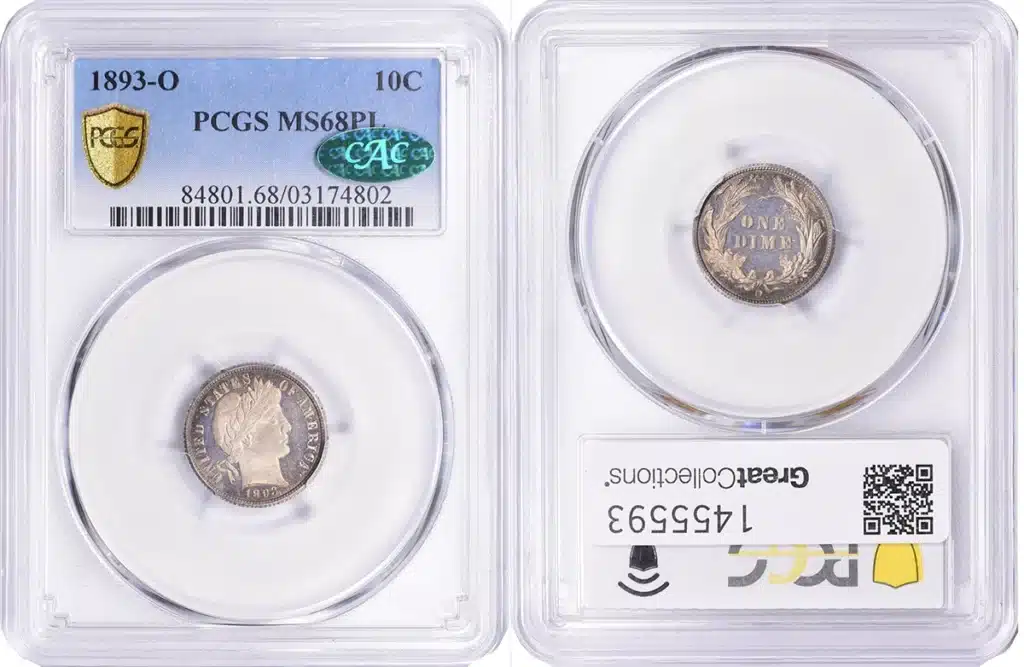
From a mintage of 1,760,000, PCGS has certified only three examples as Prooflike. The designation “Prooflike” refers to the presence of reflective mirror-like surfaces sometimes found on a circulation strike coin. Of the three, this example is the finest. Both Blay and GreatCollections’ Ian Russell were taken by the clarity of the strike and its perfectly preserved surfaces, with the latter remarking that the coin had the look of a Proof or a Specimen strike. This date offers sophisticated collectors a smattering of ultra-high-end coins – no more than five or six in the Superb Gem grand range. This example bests the impressive Prooflike Eliasberg/Simpson coin by one full point.
1899 Barber Dime (PCGS Proof-68 CAC; Toned)
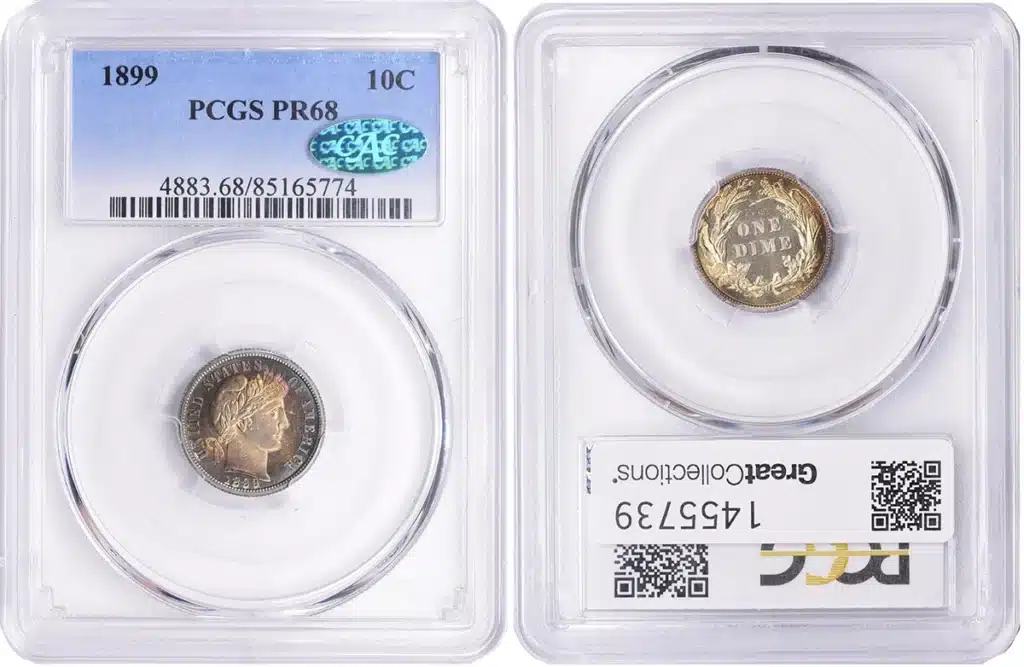
The United States Mint sold 846 Proof Sets in 1899. By modern standards, the total number of coins produced for collectors at the close of the 19th century would be nothing more than a rounding error. And while most of the 1899 Proof Barber dimes have survived, more than a century of mishandling has resulted in most available examples having some degree of impairment.
This coin, certified PR68 by PCGS and approved by CAC as strong for the grade, ranks as one of the five finest known for the issue – taking into account similarly graded coins with Cameo and Deep Cameo attributions.
Under light, this example boasts a vividly toned obverse with Cerulean blue wrapping bordering the rims and the center field bathed in orange, red, and purple. The coloration on the coin’s reverse shows a gradient of gold and orange. We expect this specimen to exceed the $14,100 price it realized in a May 2018 auction appearance.
1907 Barber Dime (PCGS Proof-68 CAC; Toned, OGH)
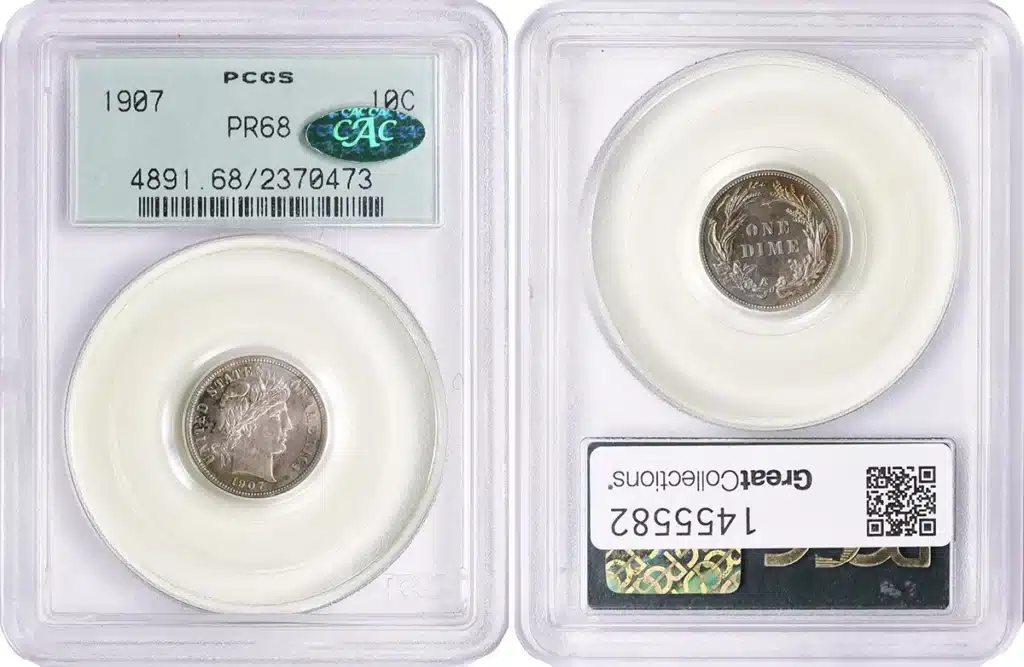
After peaking in the 1880s, collector interest in Proof coinage began to decline. By the end of the first decade of the 20th century, this interest had sunk to a level where a typical year’s Proof mintage would fall in the 550 to 700 coin range. The 1907 Proof dime was the first issue in the series to have a mintage of under 600 pieces. In terms of the series, it’s one of the scarcer dates, but is by no means rare. As is the case with all early 20th-century Proofs, unimpaired examples with high eye appeal are the exception to the rule. PCGS has certified no more than 20 examples in Superb Gem Proof and this is the only one certified at the PR68 level.
This is the same coin sold in July 1997 for $5,290. At the time, it was the only PR68 recorded in the PCGS Census. Nearly 30 years later, this distinction remains true. Current bid is $10,500.
1898-O Barber Dime (PCGS MS-67+ CAC; Toned)

Blay’s 1898-O Barber Dime is the current lead plate coin on PCGS CoinFacts. It is a shimmering champagne-colored dime with peach-colored toning around the coin’s periphery. A smattering of peach rings above and below the denomination serve as key pickup points for pedigree tracing. We’ve tracked this example to the Larry H. Miller Collection, where it sold for $31,200 in December 2020. Miller, a prominent Utah businessman, was an accomplished collector in his own right. In that collection, the coin was housed in an early generation NGC MS68 holder. Now it is offered as a freshly-graded PCGS MS67+ with CAC approval.
1905-O Barber Dime Micro O (PCGS MS-66+ CAC)

In our opinion, early 20th-century New Orleans issues are underrated and will certainly prove formidable to collect as the market for 20th-century American silver and gold coins continues to mature in the coming years. The 1905-O Barber dime was struck in numbers typical for the branch mint at the time. What makes this issue stand out, however, is the existence of the scarce “Micro O” mintmark variety. In a side-by-side comparison, the O mintmark is considerably shorter than the one found on the majority of the dimes struck that year. Strangely, the Micro O mintmark punch was intended to be used on a larger coin – the quarter dollar.
1905-O Barber dimes with the Micro O mintmark are scarce in Mint State and rare in Gem. This example is the finest known.
* * *
GreatCollections will also be offering duplicates from the Blay Collection in November. For more information, call 1-800-442-6467 or visit their website at www.greatcollections.com.
To search through GreatCollection’s archive of over 600,000 certified coins the company has sold over the past eight years, please visit the GreatCollections Auction Archives.
The post Amazing Barber Dimes from the Stewart Blay Collection appeared first on CoinWeek: Rare Coin, Currency, and Bullion News for Collectors.
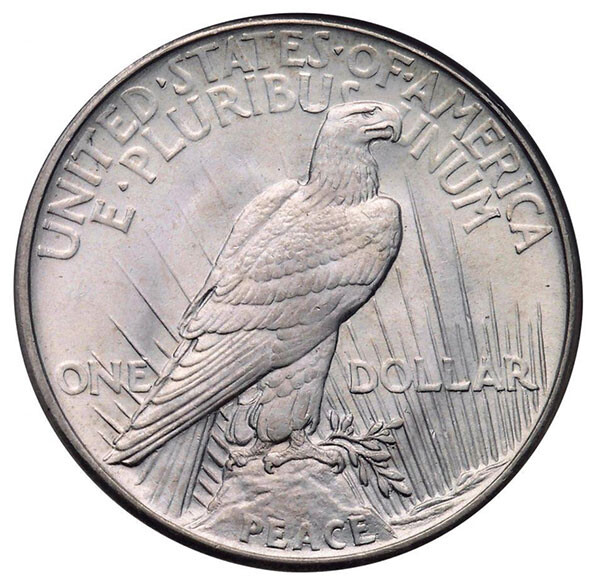
1921 Peace Dollar : A Collector’s Guide
The 1921 Peace dollar is the debut issue of Anthony de Francisci’s Art Deco design, produced from 1921-1928 and then again for two years in 1934 and 1935.
The Peace dollar replaced the Morgan dollar design, which was minted continuously from 1878 to 1904, before the denomination took a prolonged hiatus due to a lack of demand. The Morgan design was revived in 1921 after Congress passed legislation that called on the Treasury to replenish its silver dollar stockpile. During World War I, the United States melted more than 270 million silver dollars from its stockpile, in order to convert it to bullion, which it sold to England.
While the majority of the silver dollar coins struck by the Mint in 1921 were Morgan dollars, a comparatively small number, 1,006,473 were struck in the new design.
Why is Di Francisci’s Design Called “The Peace Dollar?”
Following the end of World War I, a movement grew to issue a coin that simultaneously celebrated the Allies’ victory and to commemorate a, hopefully, long-lasting peace.
Originally proposed as a half dollar, the Peace commemorative coin was instead struck as a silver dollar. The Mint sought input from the nation’s leading sculptors and after competition, Anthony de Francisci’s design was selected.
The designer’s wife, Teresa Cafarelli de Francisci, served as the model for the coin that numismatist Farran Zerbe and others famously dubbed a “peace coin” to honor the end of what was then called “The Great War”[1]. Born in Italy in 1898, Teresa de Francisci was in her early 20s when her medalist husband, also an Italian-born immigrant, enlisted her as his muse for the new silver dollar. The image of Liberty on the coin is not an exact likeness but rather a “composite” of facial features that “typified something of America”[2].
Anthony de Francisci, in choosing Teresa as a model, lovingly fulfilled a dream long held by his young wife. She recalled seeing the Statue of Liberty tower over the ship she and her family were on as they approached the shores of the United States from Italy; a young Cafarelli was heartbroken when she was passed over for the role of the American goddess during a patriotic school play. Her likeness as the basis for Miss Liberty on the beloved Peace dollar lives on decades after Teresa de Francisci passed away at the age of 92 on October 20, 1990 – 26 years to the day after her artist-engraver husband passed away at the age of 77[3].
The original design showed the eagle on the reverse breaking a sword. That image was meant to be a symbol of disarmament (as in the Biblical ‘swords into plowshares’ reference), but some thought the symbology instead showed defeat. Mint Engraver George Morgan modified the design to remove the sword, making this change without de Francisci’s approval.
The 1921 Peace Dollar is Popularly Collected a “Type Coin”
The 1921 Peace dollar is particularly important due to the fact that it is a first-year issue and because the coin was struck in higher relief than issues struck in 1922 onward. The 1921 Peace dollar, therefore, qualifies as a one-year Type coin and is popularly collected as such.
Accounting for the low mintage of the issue, it is important to note that the design for the new dollar design was not finalized until President Warren G. Harding selected de Francisci’s design on December 19, 1921. That same week, the Mint’s engraving department was hard at work preparing dies to strike the initial coinage and on the final week of the year struck 1,006,473 coins bearing the 1921 date.
These coins were released into circulation in January 1922 to mixed reviews by the mainstream and numismatic press. The Wall Street Journal called the coin “our Flapper Silver Dollar”, while tongues also wagged at the ANA, with ANA President Moritz Wormser arguing that there was “nothing emblematic of peace on [the coin] except the inscription “Peace” itself.”
Time has been more forgiving and the Peace dollar, along with the Morgan dollar that preceded it remain two of the most popularly collected U.S. coins.
How Much is a 1921 Peace Dollar Worth?
The 1921 Peace dollar has a value of $150 in average circulated grade all the way up $100,000 for an example that would be considered by numismatists to be among the finest known of the date. A typical uncirculated example, grading MS63, routinely sells for about $1,000. This is a significant premium over what Peace dollars in the same grade sell for if struck in more common dates.
The 1921 Peace dollar is not the rarest Peace dollar in the series, but it is typically considered a key or semi-key issue. When purchasing a 1921 Peace dollar it is important to buy a coin certified by CAC, NGC, or PCGS. Reputable dealers will have no issue sourcing a quality coin that has been authenticated and graded by one of these services. Avoid coins that have been cleaned or damaged.
Obverse:
The obverse is dominated by a left-facing bust of a young Miss Liberty wearing a tiara of rays that unmistakably resembles the radiant crown upon the head of the Statue of Liberty. Most of Miss Liberty’s hair is contained within a bun at the back of her head, though several locks are seen hanging alongside her neck.
Arcing along the rim on the upper half of the obverse field is the inscription LIBERTY, and centered below the bust of Liberty near the bottom rim is the date 1921. The motto IN GOD WE TRUST appears in a single line of text across the lower quarter of the obverse and spreads across that section of the field, with the words IN GOD WE appearing to the left of Miss Liberty and the word TRUST located behind her neck. Incidentally, the letter “U” in “TRUST” appears as a “V,” which de Francisci employed to represent a “V” for “Victory”[4]. Dots appear between the words IN GOD WE and are also seen on the rim side of the words IN and TRUST. The designer’s monogram, AF, appears below Liberty’s neck in the lower obverse field.
Reverse:
 The depiction of an American bald eagle perched on a mountaintop anchors the reverse. Clutched in its claws is an olive branch symbolizing peace; notably not included in this particular depiction of the eagle is a band of arrows representing military strength, a symbol commonly seen in similar visages of the patriotic avian emblem. The rightward-facing eagle is seen at an angle partly turned away from the viewer and towards a sunrise, which symbolizes the promise of dawning peace in the world.
The depiction of an American bald eagle perched on a mountaintop anchors the reverse. Clutched in its claws is an olive branch symbolizing peace; notably not included in this particular depiction of the eagle is a band of arrows representing military strength, a symbol commonly seen in similar visages of the patriotic avian emblem. The rightward-facing eagle is seen at an angle partly turned away from the viewer and towards a sunrise, which symbolizes the promise of dawning peace in the world.
The bold rays in the image of the rising sun harmonize with the rays seen in Miss Liberty’s tiara on the coin’s obverse. The legend UNITED STATES oF AMERICA appears along the rim in top half of the reverse. The motto E PLURIBUS UNUM is located directly below in lettering identical in size to the legend. The eagle’s beak breaks the bottom of the “S” in PLURIBUS and visually divides that word from UNUM; meanwhile, a dot punctuates the space between E and PLURIBUS.
The denomination ONE DOLLAR appears across the bottom third of the reverse in a single line of text, with the word ONE inscribed to the left of the eagle by its tail feathers and DOLLAR superimposed over the sun’s rays to the right of the eagle. PEACE is inscribed along the rim below the eagle, atop the rock on which the patriotic bird stands.
Edge:
The edge of the 1921 Peace dollar is reeded.
Designer(s):
Anthony de Francisci was born in Palermo, Sicily in 1887 and emigrated to the United States in 1905. He began his career as a sculptor studying under such notable numismatic artists as James Earle Fraser, Hermon Atkins MacNeil and Adolph Weinman. The Peace dollar (1921-35) is his most famous creation but he also produced several medals. He died in 1964.
Coin Specifications:
| Country: | United States |
| Year Of Issue: | 1921 |
| Denomination: | 1 Dollar |
| Mint Mark: | None (Philadelphia Mint) |
| Mintage: | 1,006,473 |
| Alloy: | 90% Silver, 10% Copper |
| Weight: | 26.73 grams |
| Diameter: | 38.10 mm |
| Edge | Reeded |
| OBV Designer | Anthony de Francisci |
| REV Designer | Anthony de Francisci |
| Quality: | Business Strike |
* * *
Sources
Zerbe, Farran. “Commemorate peace with a coin for circulation”, The Numismatist Oct. 1920: 443-44. Print.
LaMarre, Tom. “The Dollar Daze of 1921”, Coins Oct. 1999: 56–57. Print.
Taxay, Don. The U.S. Mint and Coinage (Reprint Ed.) Arco Publishing, 1983. Print.
https://www.pcgs.com/News/Why-Does-The-Peace-Dollar-Have-A-Ivi-In-The
The post 1921 Peace Dollar : A Collector’s Guide appeared first on CoinWeek: Rare Coin, Currency, and Bullion News for Collectors.
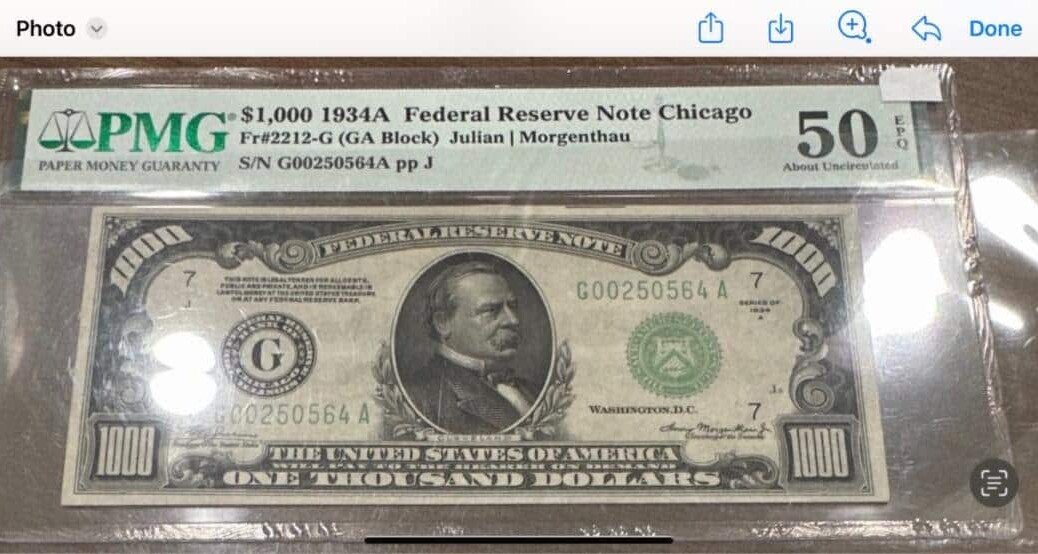
Numismatic Crime – Bullion Stolen With Bad Check
Recent Alerts from Doug Davis – Founder & President, Numismatic Crime Information Center (NCIC) ……
Numismatic Crime Information Center Annouces Recovery of $1,000 Note
The Palm Beach County Sheriff’s Office in Florida had been investigating a theft from a dealer who attended the Palm Beach Coin Show on September 25, 2023. The dealer had reported the theft of a PMG-graded 1934A $1,000 Federal Reserve Note (Serial No. G00250564A) from his table. The victim has reported that the note has been recovered. No further details are available at this time.
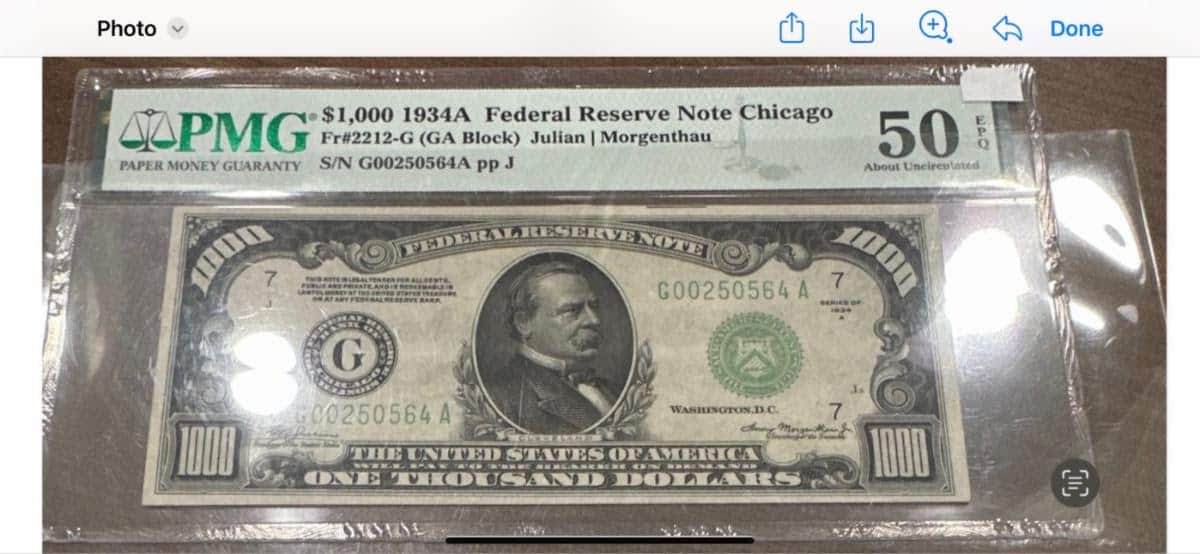
Lost/Stolen Canadian Banknotes Recovered
Due to the assistance of FedEx and a Florida dealer, the notes listed in the PDF links below have been recovered. A FedEx package had been shipped from Canada to California and was received without the contents. The package contained a group of Canadian notes.
North Carolina Numismatic Association Coin Show Theft
A dealer at the recent North Carolina Numismatic Association coin show in Concord, NC, has reported the theft of two Morgan silver dollar coins. The dealer believes the crime occurred when a group of people were at his table. One suspect engaged him in a long conversation while showing him multiple coins and it is believed that the other suspects removed the coins.
A police report has been filed with the Concord, NC police department: Case #02711.
Below are the stolen coins:
- 1885-CC PCGS MS65 – Cert#15383412
- 1892 PCGS PF63 – Cert#38557340
Stolen from Mail: USPS – Massachusetts to California
A package shipped Priority Mail from Massachusetts to California on October 17, 2023, via the United States Postal Service (USPS) was returned to the sender empty. Upon examination by the victim, it was apparent that the package had been opened and re-taped.
The following coin was stolen:
- 1851-O Gold one dollar PCGS MS65 Cert# 46849885
Arizona Fraudster Makes Large Bullion Purchase with Bad Check
The suspect pictured below entered the Sun West Credit Union and used a fake driver’s license to obtain a cashier’s check for $135,000. The suspect then took the check and purchased 50 Rand Refinery gold bars and 19 Krugerrands from a local dealer.
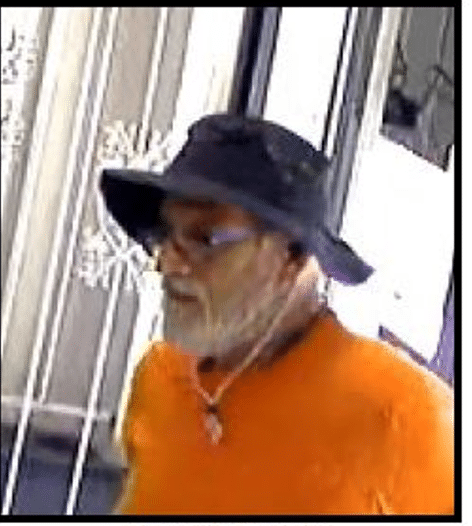
The check was deposited and cleared the same day but was voided three business days later. Phoenix, Arizona police are currently investigating: Case #2023-1590670.
Investigators are seeking any additional information on this incident.
* * *
Please contact the Numismatic Crime Information Center’s Doug Davis if you have questions or information about any of the cases above. You can reach him at (817) 723-7231, or email him at doug@numismaticcrimes.org.
The Numismatic Crime Information Center (NCIC) is a 501(c)(3) non-profit corporation whose mission is to serve as a national and international resource for collectors, dealers and law enforcement in the education, prevention and investigation of crimes involving coins, paper money, tokens, medals and related numismatic items.
NCIC disseminates current crime related issues to the numismatic industry and provides local, state and federal law enforcement agencies with the fundamental investigative techniques, knowledge and understanding to respond effectively to the complex challenges encountered during a crime.
* * *
The post Numismatic Crime – Bullion Stolen With Bad Check appeared first on CoinWeek: Rare Coin, Currency, and Bullion News for Collectors.
Gold and Other Metals Decline on Monday, Nov. 6
On Monday, prices for precious metals declined
Rank Historic Coins for the U.S. Mint’s Semiquincentennial Collection of Gold Coins for 2026
In 2026, the United States will celebrate its Semiquincentennial, commemorating the 250th anniversary of the Nation’s founding
Near-Finest 1921-D Morgan Dollar Offered by David Lawrence
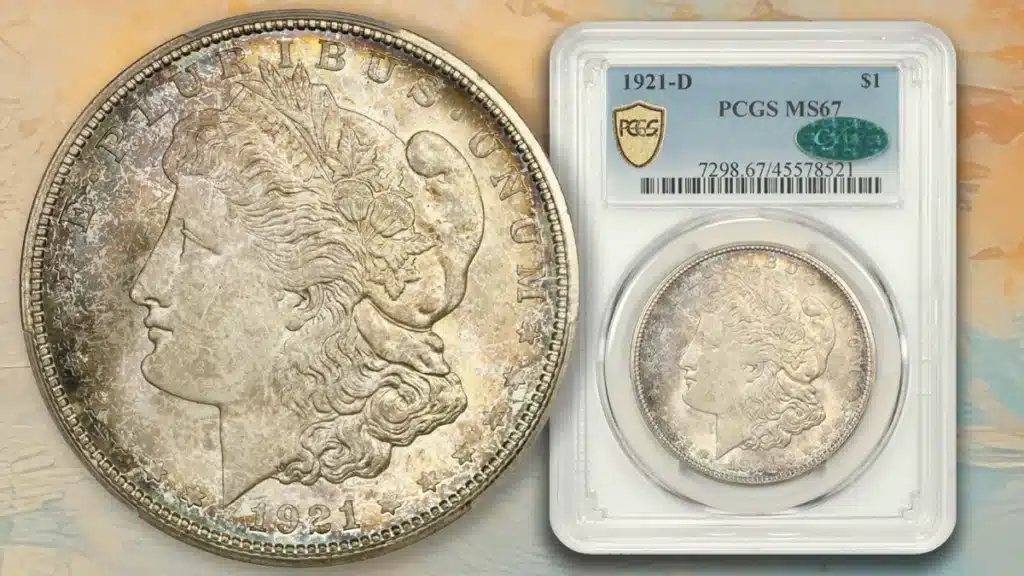
The Sunday, November 12 Online Auction from David Lawrence Rare Coins (DLRC) is now live and features over 475 lots. This includes 140 No Reserve and 125 Vault Values.
The various PCGS-, NGC-, and CAC-approved highlights in the sale include a near-finest 1921-D Morgan dollar PCGS/CAC MS67; an original 1903 $2.50 PCGS/CAC PR62; a rare San Francisco Mint 1876-S $5 PCGS AU53; a popular slider SS Republic 1862-S Shipwreck $20 NGC AU58; a tough 1876-S $20 PCGS/CAC MS63; and a rare Ancient Roman: Otho (AD 69) AR Denarius NGC Choice AU.
Check out all of the highlights before the auction closes on Sunday, November 12.
READY TO SELL YOUR RARE COIN OR COLLECTION? SELL IT TO DAVID LAWRENCE
Like the near-finest 1921-D Morgan dollar and other rare classic and modern U.S. coins offered above, David Lawrence Rare Coins always needs coins. When you are ready to sell, we’re here for you. David Lawrence offers three options that provide maximum flexibility to meet your needs while providing the highest quality personal service in the industry:
- You can sell your coins to us outright.
- You can consign your coins.
- You can participate in our Guaranteed Auction Program.
DLRC Consignment Special
Check out our Collector Consignment Special! We are offering the following options that can be combined, or adjusted for your specific needs:
Maximum Returns – For coins over $10,000, consign with a reserve and receive 90% or consign with no reserve and receive 92%.
Immediate Cash Advance – For collections over $10,000, receive an immediate cash advance of up to 75% on unreserved consignments.
Fastest Turnaround – We will get your coins to auction within 3-5 business days of receipt, ending in approximately two weeks.
Standard terms still apply:
- Coins from $1,000 to $10,000 – consign with a reserve and receive 85%; consign with no reserve and receive 90%
- No fee guarantee – no listing fees, no imaging fees, and no buyback fees
- Fast payment – payment within 30 days of sale; for this promotion, we can accelerate payment to two weeks in most cases
* * *
The post Near-Finest 1921-D Morgan Dollar Offered by David Lawrence appeared first on CoinWeek: Rare Coin, Currency, and Bullion News for Collectors.
Stack’s Bowers Oct. 2023 Hong Kong Sale Realizes $21 Million+
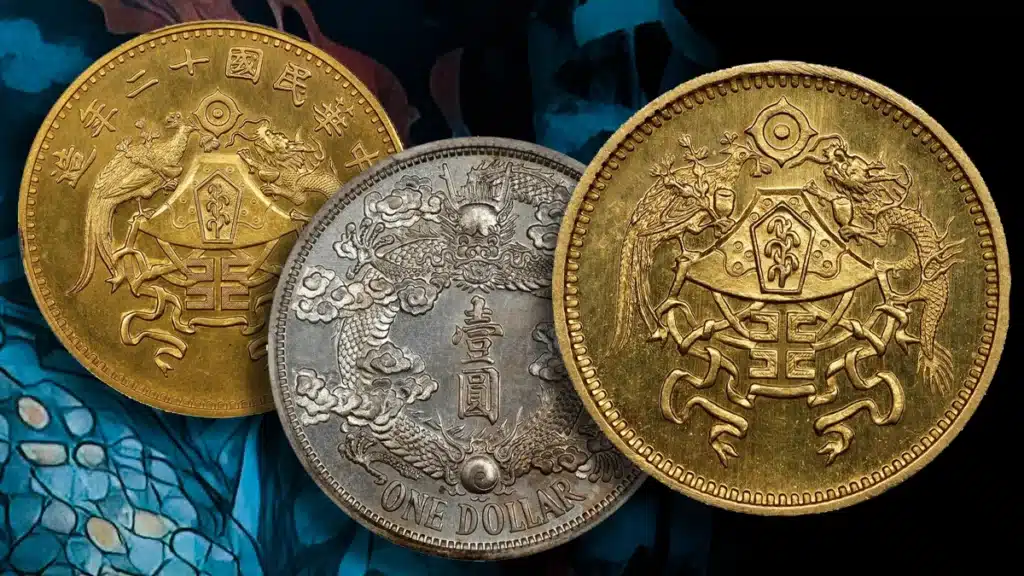
Stack’s Bowers and Ponterio announce the results of their October 2023 Hong Kong coin, currency, and stamp auction. The sale featured more than 7,500 lots of coins and medals and 2,800 lots of paper money, which altogether realized $21.34 million USD. It is the sixth consecutive Stack’s Bowers Ponterio Hong Kong auction to surpass $20 million (all prices include buyer’s premium).
Chinese Pattern coins led Rarities Night, with a rare pedigreed “Dragon and Phoenix” Gold Dollar Pattern taking the lead at $600,000, a record for the type. A Shantung Gold 10 Dollars Pattern and “Reversed Dragon” Pattern Dollar followed closely, achieving $444,000 and $432,000 respectively.
Other areas of Asia saw strength as well, with a Hong Kong 1941-H 5 Cents and a Choice Mint State Korean 5 Yang each realizing $55,200.
From Europe, an 1847 “Gothic” Crown in Deep Cameo, saw a final price of $45,600, while an Unc Details Platinum 12 Rubles brought $33,600.
Other World Coin Highlights:
- Lot 30162: CHINA. Duo of Dollars (2 Pieces), Years 34 & 3 (1908 & 1911). Tientsin Mint. Kuang-hsu (Guangxu) & Hsuan-t’ung (Xuantong [Puyi]). Both PCGS Certified. Sold for $528,000.
- Lot 30112: CHINA. Kweichow. “Bamboo” Dollar, Year 38 (1949). NGC EF-45. Sold for $318,000.
- Lot 30114: CHINA. Manchurian Provinces. Silver Dollar Pattern, Year 18 (1929). PCGS AU-53. Sold for $240,000.
- Lot 30223: CHINA. Silver Dollar Pattern, Year 12 (1923). Tientsin Mint. PCGS MS-65+. Sold for $228,000.
- Lot 30147: CHINA. Gold K’uping Tael Pattern, CD (1906). Tientsin Mint. Kuang-hsu (Guangxu). NGC MS-61. Sold for $192,000.
- Lot 30110: CHINA. Kweichow. Auto Dollar (7 Mace 2 Candareens), Year 17 (1928). PCGS EF-45. Sold for $132,000.
- Lot 30238: CHINA. Copper-Zinc 20 Cash Pattern, Year 13 (1924). Kalgan Mint. PCGS SPECIMEN-64. Sold for $78,000.
- Lot 30256: CHINA. Chekiang. Fantasy Silver 7 Mace 2 Candareens (Dollar), ND (ca. early 20th Century). Imitating Birmingham (Heaton) Mint. Kuang-hsu (Guangxu). NGC MS-62. Sold for $38,400.
- Lot 30016: CHINA. Chihli (Pei Yang). 7.2 Candareens (10 Cents), Year 22 (1896). Tientsin (East Arsenal) Mint. Kuang-hsu (Guangxu). NGC MS-63. Sold for $19,200.
- Lot 32025: CHINA. Taiwan. 7.2 Candareens (10 Cents), ND (1893-94). Uncertain Mint, likely near Foochow. Kuang-hsu (Guangxu). PCGS VF-35. Sold for $15,600.
Currency saw consistently strong prices, with a total realization of $3.29 million. To read about the highlights of that sale, click here.
Complete prices realized for the Stack’s Bowers and Ponterio’s October 2023 Spring Hong Kong Auction are available at StacksBowers.com. The company is now accepting consignments for their January 2024 NYINC Auction and the Spring 2024 Hong Kong Auction, as well as their ongoing series of Collectors Choice Online (CCO) events.
To inquire about consigning your coins and currency to a future sale, call at 800-458-4646 or write to
Consign@StacksBowers.com.
* * *
The post Stack’s Bowers Oct. 2023 Hong Kong Sale Realizes $21 Million+ appeared first on CoinWeek: Rare Coin, Currency, and Bullion News for Collectors.
Franklin Half Dollar (1948-1963) : A Collector’s Guide
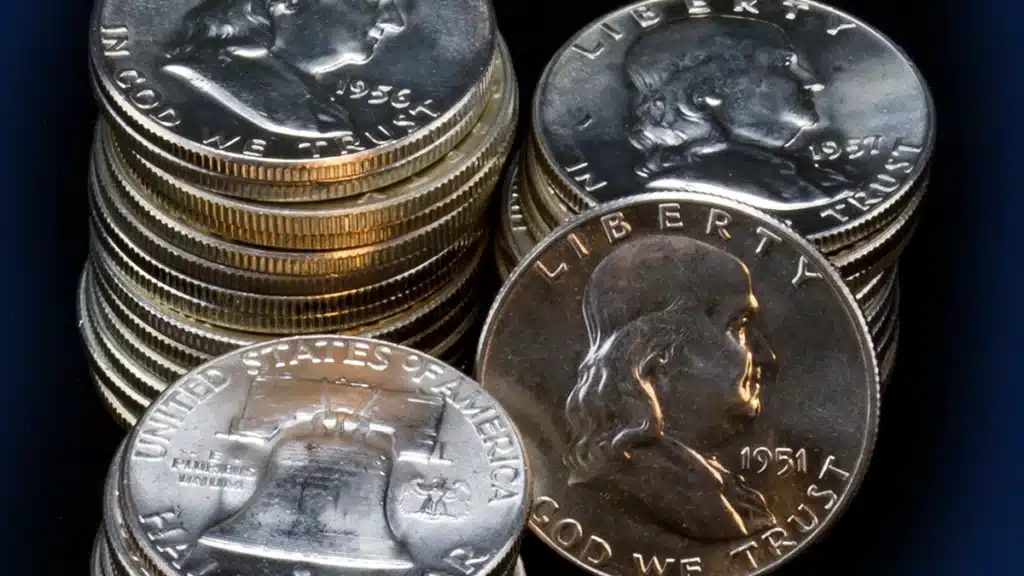
The Franklin Half Dollar Ends a 156-Year Era of Liberty on American Coins
The Franklin half dollar was a silver half dollar coin produced by the United States Mint from 1948 to 1963. The coin featured the likeness of founding father Benjamin Franklin on the obverse and the Liberty Bell on the reverse. It was the first circulating half dollar to feature a historical portrait instead of an allegorical portrait of Liberty.
The Act of September 26, 1890 specified that the Treasury Department could modify coin designs without explict Congressional authorization only after a minimum of 25 years of use. Based on this law, the Walking Liberty half dollar design, which had proven difficult to strike, was eligible for replacement in 1941.
Mint Director Nellie Tayloe Ross was interested in using Benjamin Franklin’s image on a coin. After seeing Chief Engraver John R. Sinnock’s portrait of the Founding Father on a medal he created in 1933, Ross had Sinnock prepare a Franklin coin design. Implementation was delayed because of World War II, but Sinnock completed the obverse and reverse models a few weeks before his death in May 1947.
In her speech to the public when the Franklin half dollar was presented, Director Ross noted that some had urged her to place Franklin’s portrait on the penny because of his maxim “A penny saved is two pence clear” (usually misquoted as “A penny saved is a penny earned”). Her justification for using the half dollar was that the size and the silver composition of the half dollar were better suited to the “impressive effect” that was Franklin’s life.
An Overview of the Franklin Half Dollar Series
Franklin half dollars were produced in significant quantities and there are no date rarities in the series, though a fully-struck 1953-S is considered the series’ key date.
Nearly 900,000 Franklin halves have been certified by NGC and PCGS combined. Almost all of these coins are in uncirculated condition and CoinWeek estimates that at least another million uncertified uncirculated Franklin half dollars are held in coin collections throughout the country.
What Are They Worth?
Franklin half dollars are made of .900 silver and contain .036169 troy ounces of silver. With a spot price of $23.20 USD at the time of this writing (November 2023), the base value of a Franklin half dollar is approximately $8.40. Uncirculated examples are worth at least $20, and some examples in high grade with a complete strike can be worth as much as $70,000. Ultra-high-end Proof examples have brought prices as high as $80,000 at auction.
Specialist Collectors Look for Franklin Half Dollars with Full Bell Lines
Circulation strike Franklin halves have a tendency to be softly struck with some of the detail in the design not clearly brought up. Enthusiast collectors seeking the best quality coins look to see if the lines at the bottom of the Liberty Bell are extend uninterrupted from one side of the bell to the other.
When this occurs, the coin is said to have Full Bell Lines (FBL). Full Bell Line coins will always carry a higher premium than non-Full Bell Line coins, but in order for a Franklin half dollar to trade with the designation, it must be certified as such by a reputable third party grading service, such as CAC, NGC, or PCGS.
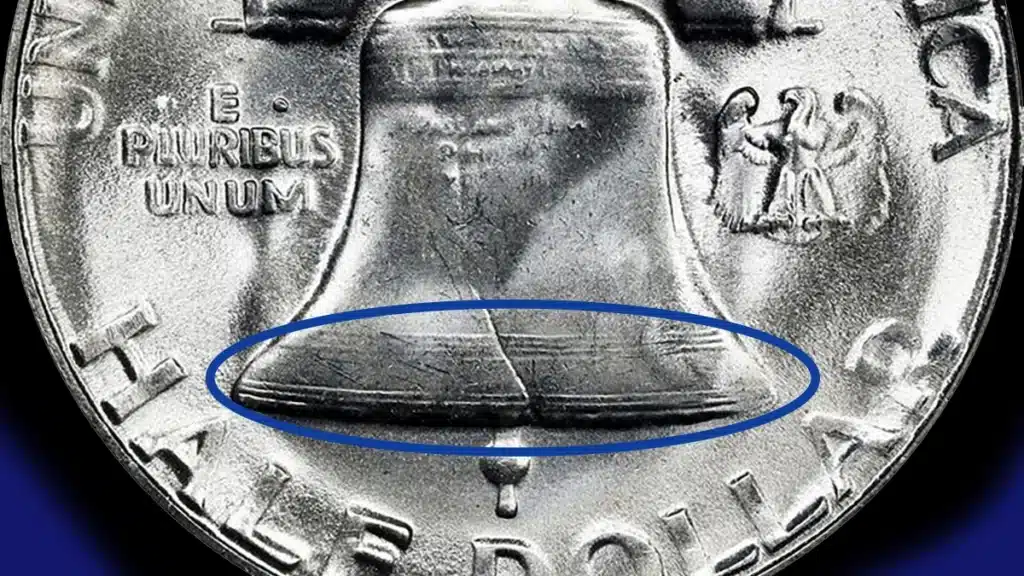
Generally speaking, coins struck at the Denver Mint were more likely to be struck with Full Bell Lines than coins struck at the Philadelphia or San Francisco mints. Coins struck at the San Francisco Mint tend to be the softly struck and for some dates, like the 1953-S, Full Bell Line examples are rare. CAC, NGC, and PCGS report a combined population of 2,769 Philadelphia Franklin half dollars from 1953 and 10,440 1953-D Franklin half dollars with Full Bell Lines. The 1953-S, on the other hand, is so rare with Full Bell Lines, that all three services report a combined population of just 69 examples.
Auction prices for Full Bell Lines 1953-S Franklin half dollars reflects the coin’s rarity. On May 31, 2020, GreatCollections sold a beautiful NGC MS66+ FBL example for $52,875. Amazingly, this is not the record price paid for an uncirculated Franklin half! Another example graded PCGS MS66FBL once sold for nearly $70,000.
Not all Full Bell Lines Franklin half dollars are prohibitively rare. Gem uncirculated examples from some of the more common dates are affordable and can trade for as little as $60-$70. The 1954-D is a popular date for collectors interested in finding an attractive, fully struck Franklin half at an affordable price.
Franklin Half Dollar Proof Coins are in a League of Their Own

Proof Franklin half dollars were produced from 1950 to 1963 and were sold as part of each year’s annual U.S. Mint Proof Set. Proof Set mintages increased dramatically as the series progressed, in large part due to the exploding popularity of coin collecting in the mid-1950s onward.
Proof Mintages by Year
- 1950 – 51,386
- 1951 – 57,500
- 1952 – 81,980
- 1953 – 128,800
- 1954 – 233,300
- 1955 – 378,200
- 1956 – 669,384
- 1957 – 1,247,952
- 1958 – 875,652
- 1959 – 1,149,291
- 1960 – 1,691,602
- 1961 – 3,028,244
- 1962 – 3,218,019
- 1963 – 3,075,645
Proof Franklin halves are scarce in surviving populations in relationship to demand only for the first two years of the series. Within the series, there are notable varieties, which can be quite rare, including the dramatic 1961 Doubled Die Reverse.
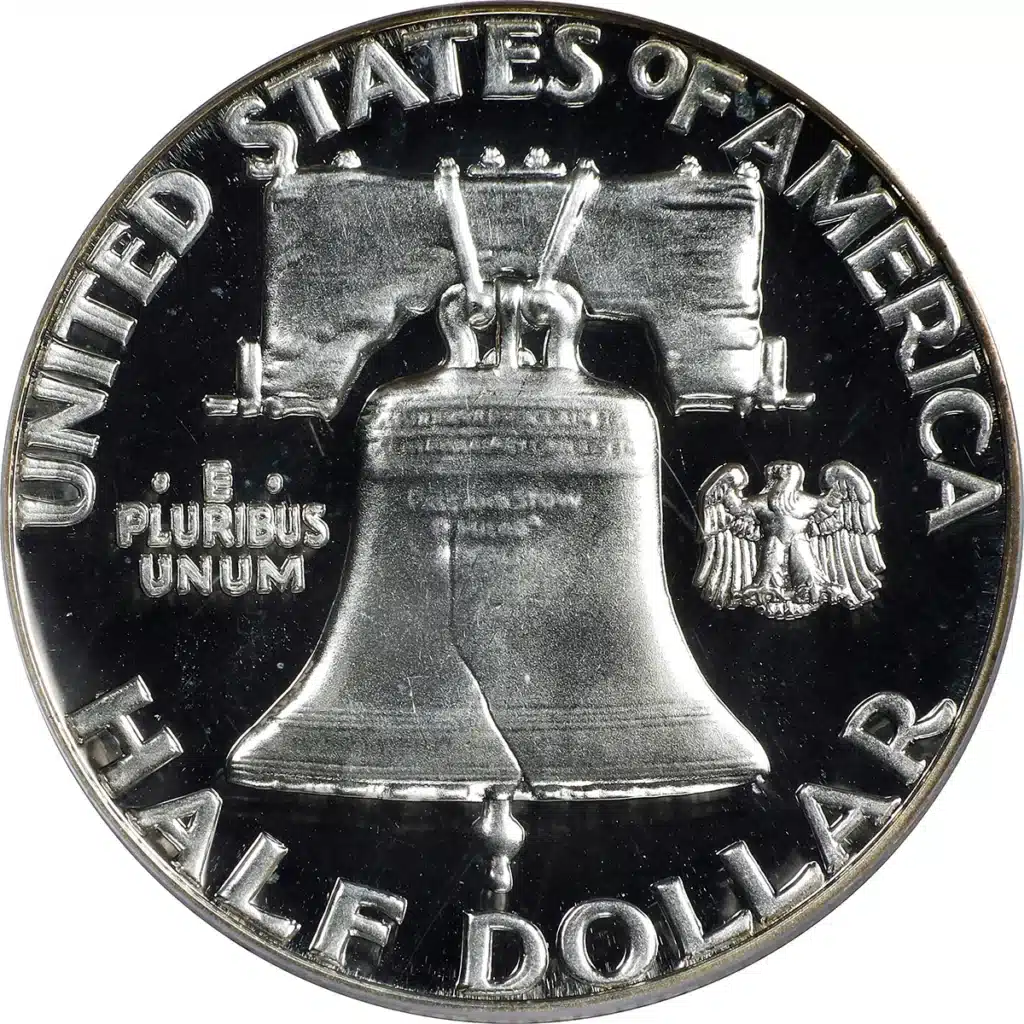
Beyond simply collecting one Proof example of every Franklin half dollar date, some collector enthusiasts seek out examples struck with fresh dies that exhibit frosted cameo contrast. Examples with thick cameo contrast are certified as Deep Cameo or Ultra Cameo by the grading services.
These examples sell at significant premiums and can be worth as much as $90,000 depending on a variety of factors.
Noteworthy Franklin Half Dollar Varieties
A few varieties are known, most consisting of die doubling and differences in the details of the small reverse eagle. Those identified in census/population reports are the 1951-S DDR (doubled die reverse) circulation strike; the 1956 Type 1 and Type 2 Proofs, which differ by the number of separated feathers shown on the eagle’s right wing; the 1960 DDO (doubled die obverse) Proof varieties; and the 1961 DDR varieties.
In-Depth Franklin Half Dollar Date Analysis by CoinWeek IQ
Below is a listing of more in-depth coin profiles of specific dates in the Franklin half dollar series.
Circulation Strikes:
- 1948 Franklin Half Dollar
- 1949 Franklin Half Dollar
- 1954-S Franklin Half Dollar
- 1960 Franklin Half Dollar
Proofs
Franklin Half Dollar Design
Sinnock’s portrait is modeled after a bust by 18th-century French sculptor Jean-Antoine Houdon. The design, arguably a cleaner and bolder effort than Adolph Weinman’s acclaimed Liberty Walking motif, was not without controversy. The Fine Arts Commission objected to the small reverse eagle (added to the design because an eagle on coins was required by statute) and, oddly, to the obvious presentation of the crack in the Liberty Bell. As it turned out, public controversy was instead generated by Sinnock’s JRS initials, which during the fears of the Cold War were mistakenly thought by some to be a reference to Joseph Stalin. The reverse Liberty Bell was adapted from John Frederick Lewis’ original sketch for the 1926 Sesquicentennial half dollar, information not revealed by Sinnock at the time but discovered and reported in the 1960s by Don Taxay. Another rumor was that the small “O” in oF, part of UNITED STATES oF AMERICA, was a mistake and would soon be corrected, making the original issues more valuable; the text remained the same for the entire series.
Franklin’s right-facing portrait occupies much of the obverse. LIBERTY forms an arc inside the top rim and IN GOD WE TRUST a second arc inside the bottom rim. The date is placed to the right of the portrait, below the chin, extending nearly to the T in TRUST.
The Liberty Bell dominates the center of the reverse, with UNITED STATES oF AMERICA encircling around the top and HALF DOLLAR, in slightly larger text, around the bottom. The phrase E PLURIBUS UNUM, in three lines and with a dot on both sides of E, is to the left of the bell, and a small eagle is to right. The eagle rests on a perch, with wings partially outstretched. San Francisco (S) and Denver (D) mintmarks are located above the wood beam holding the bell.
The edge of the coin is reeded.
Coin Specifications
| Franklin Half Dollar | |
| Years Of Issue: | 1948-63 |
| Mintage (Circulation): | High – 67,069,292 (1963-D); Low – 2,498,181 (1955) |
| Mintage (Proof): | High – 3,218,019 (1962); Low – 51,386 (1950) |
| Alloy: | 90% silver, 10% copper |
| Weight: | 12.50 g |
| Diameter: | 30.60 mm |
| Edge: | Reeded |
| OBV Designer | John R. Sinnock |
| REV Designer | John R. Sinnock | Gilroy Roberts |
* * *
References
Bowers, Q. David. The Experts Guide to Collecting & Investing in Rare Coins. Whitman Publishing.
–. A Guide Book of United States Type Coins. Whitman Publishing.
Breen, Walter. Walter Breen’s Encyclopedia of U.S. Coins. Doubleday.
Feigenbaum, David Lawrence and John Feigenbaum. The Complete Guide to Certified Barber Coinage. DLRC Press.
Guth, Ron and Jeff Garrett. United States Coinage: A Study by Type. Whitman Publishing.
Lange, David W. The Complete Guide to Lincoln Cents. Zyrus Press.
–. Coin Collecting Boards of the 1930s and 1940s. Pennyboard Press.
Taxay, Don. The U.S. Mint and Coinage. Arco Publishing.
Yeoman, R.S and Kenneth Bressett (editor). The Official Red Book: A Guide Book of United States Coins. Whitman Publishing.
* * *
The post Franklin Half Dollar (1948-1963) : A Collector’s Guide appeared first on CoinWeek: Rare Coin, Currency, and Bullion News for Collectors.
1793 Wreath Cent : A Collector’s Guide

by Charles Morgan and Hubert Walker for CoinWeek…
What is the 1793 Wreath Cent and Why is it So Rare?
The 1793 Wreath cent is the second of three one cent coin designs issued by the United States Mint in 1793, the inaugural year of its newly purchased Philadelphia money factory.
The change in design to the Wreath cent came about after public complaints regarding the symbolism of the chain link reverse, which some equated to bondage. Mint Director David Rittenhouse responded to these criticisms by ordering the creation of a new design. Henry Voigt was charged with creating the dies and may have been the coin’s designer.
The obverse is adapted from that of the Chain cent, with subtle modifications. The new reverse design featured an ornamental wreath, which itself was adapted from the 1792 silver center cent patterns.
Wreath cent production commenced on April 4, 1793 and continued through April 19, when the Mint ran out of copper planchets. A similar situation presented itself earlier in the year when the Chain design was being used.
On June 27, the U.S. Mint secured sufficient stock of copper to resume coinage and produced 20,000 Wreath cents through July 1. Another spurt of 176 coins was delivered on July 17.
The final cents with the Wreath reverse were struck on September 17, 1793, as mint workers struck coins with the last of the planchets they had on hand before shutting down the presses to evacuate the city, which was experiencing a yellow fever outbreak. Also factoring into the decision to close shop was the tragic loss of Chief Engraver Joseph Wright and his wife, both of whom had succumbed to the disease the week before.
Wright’s death likely forced the Mint to introduce its third cent design in late 1793.
| Deliveries of 1793 Wreath Cents | |||
| April 9, 1793 | 12,000 delivered | April 13, 1793 | 6,112 delivered |
| April 16, 1793 | 8,000 delivered | April 17, 1793 | 7,000 delivered |
| April 18, 1793 | 6,000 delivered | April 19, 1793 | 4,240 delivered |
| June 28, 1793 | 8,000 delivered | July 6, 1793 | 11,825 delivered |
| July 17, 1793 | 176 delivered | Total: 63,353 coins | |
How Many 1793 Wreath Cents Survive?
The 1793 Wreath Cent is scarce in all grades and typically sell in damaged or well-worn conditions. It is estimated that fewer than 5,000 coins of this design survive, with most high grade examples being stowed away as keepsakes by local citizens or British merchants and collectors, who were interested in the early coinage of the former British colony.
When the large cent was discontinued in 1857, interest in collecting America’s early copper coins exploded and it was at this time that many of the lower grade examples likely were pulled out of circulation and put into coin collections.
Many of the finest surviving examples trace their provenance back to important 19th century collections. This chain-of-custody, or pedigree, is significant as collectors use this information to identify and rank known examples.
A 1793 Wreath Cent Traveled to Outer Space
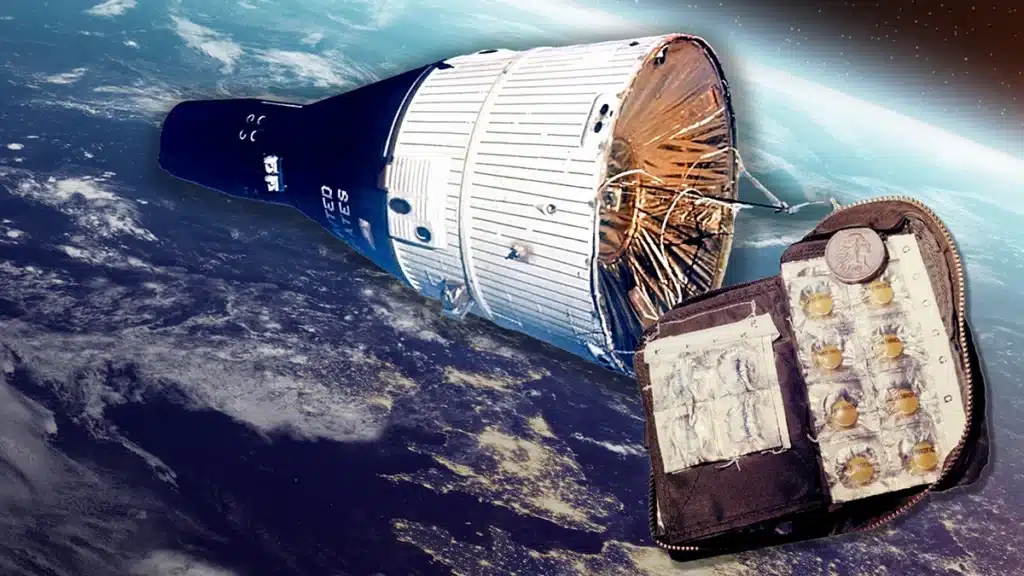
Trivia: Minnesota coin dealer William J. Ulrich, Sr. (who has a strange story of his own) and flight surgeon Howard A. Miners placed a 1793 Wreath cent in the in-flight medical kit on the Gemini VII spacecraft.
* * *
How Much is the 1793 Wreath Cent Worth?
The Wreath Cent is considered scarce to rare in all conditions. Low end examples, which are mostly worn are worth a minimum of $2,000. In circulated grades, problem free examples typically trade at auction for prices ranging from $5,000 to $50,000, depending on grade.
Uncirculated examples exist, but these are quite rare. The very finest examples would sell for a $1,000,000 or more dollars if sold at auction.
CoinWeek advises readers to only purchase 1793 Wreath Cents after they have been professionally authenticated and graded by one of the following third party grading services: CAC, NGC, and PCGS.
A List of Some of the Most Important 1793 Wreath Cents and Their Price History
1793 Wreath Cent, Sheldon-5
- PCGS MS64+BN #26401320: S.K. Hartzfeld, 1879; S.H. and H. Chapman; Ed. Frossard – $100; George M. Parsons; Ed. Frossard, October 1884, Lot 984 – $200; Richard B. Winsor; S.H. and H. Chapman, December 1895, Lot 825 – $160; S.H. and H. Chapman; George H. Earle, Jr.; Henry Chapman, June 1912, Lot 3357 – $220; Clarence S. Bement; Henry Chapman, May 1916, Lot 287 – $520; Henry Chapman; Col. James W. Ellsworth, March 1923; Wayte Raymond; William Cutler Atwater; B. Max Mehl, June 1946, Lot 11 – $1,050; R.E. “Ted” Naftzger, Jr., February 23, 1992; Eric Streiner; Jay Parrino; from here, unknown to us… Imaged on PCGS CoinFacts. The finest known of this variety.
1793 Wreath Cent Sheldon-6, Vine and Bars Edge
Breen 7. Vine and Bars Edge. Rarity 3. Sprung die causes central part of hair detail to appear worn, even in Mint State.
- Mint State: Clarence S. Bement; Henry Chapman, May 1915, Lot 288 – $360; Dr. George P. French, March 21, 1929. As a “Red and Olive Proof” B. Max Mehl, Fixed Price List, 1929 – $1,200; Henry A. Sternberg; J.C. Morgenthau & Co., April 1933, Lot 4 – $350; B. Max Mehl Collection, 1944; T. James Clarke, 1950; Dr. William H. Sheldon, April 19, 1972; R. E. Naftzger, Jr., February 23, 1992; Eric Streiner; Jay Parrino…
- NGC MS65: Seavey 1873; Lorin G. Parmelee, February 6, 1892; H. P. Smith; Dr. Thomas Hall; Virgil Brand, September 7, 1909; New Netherlands Coin Company; Harold Bareford July 1951; Herman Halpern, 1985; “The Herman Halpern Collection”, Stack’s, March 1988, Lot 6 – $46,750. Superior Galleries, August 1992, Lot 10 – Passed.
- Mint State: Richard B. Winsor; S.H. and H. Chapman, December 1895, Lot 825 – $110; S.H. and H. Chapman; George H. Earle, Jr.; Henry Chapman, June 1912, Lot 3359 – $160; Henry Chapman; Col. James W. Ellsworth, March 1923; Wayte Raymond, April 1923; George H. Clapp; American Numismatic Society.
1793 Wreath Cent, Sheldon-8
B-13, Rarity-3-. Curved sprig atop the date. Triangular “bow” of the ribbon on the reverse. Obverse die also used on Sheldon 9. Numismatist Walter Breen speculated that this die marriage produced 6,112 coins that were delivered on April 13, 1793. Diagonal die crack forms on reverse to the left of O through EN in cent down to the left leg of A to the rim.
- PCGS AU55 #10798714: “The Leo Beranek Collection of Early Federal Coinage”, Heritage Auctions, January 10, 2008, Lot 2665 – $40,250.
1793 Wreath Cent, Sheldon-9
Breen 12. Vine and Bars Edge. Curved sprig on the three leaf device between truncation and date. Large bow. Obverse also used on Sheldon 8. In Noyes Die State B, a die crack develops at the top of C in AMERICA and extending to final A. High relief dies. The most common wreath cent variety.
- PCGS MS69 #2368140: Virgil M. Brand; Burdette G. Johnson, 1941; Ernest Henderson, 1958; Dorothy Paschal, 1959; Dr. William H. Sheldon, April 19, 1972; R.E. “Ted” Naftzger, Jr., February 23, 1992; Eric Streiner; Jay Parrino; Superior, March 2000, Lot 67; Superior, March 2001, Lot 12; private collector; Steve Contursi; Cardinal Collection Educational Foundation; “The Cardinal Collection”, Stack’s Bowers, January 2013, Lot 13002 – $558,125; Stack’s Bowers, August 14, 2013, Lot 4019 – $481,750. Pedigree research assisted by Stack’s Bowers.
- PCGS MS66+BN CAC #25338683: Sylvester S. Crosby, Brand, February 7, 1941, B.G. Johnson; “The Oscar Pearl Collection”, Numismatic Gallery, 1944 Fixed Price List, Lot 7 – $1,150; “The Charles M. Williams Collection”, Numismatic Gallery, November 1950, Lot 10 – $1,175; “The R.E. ‘Ted’ Naftzger, Jr. Collection”, New Netherlands Coin Company, November 1973, Lot 330 – $14,000; Dr. Fred Yee; World Wide Coin Co., August 1975; Steve Ivy Rare Coin Co., August 1975; Bowers and Ruddy, August 1975; Dr. Herbert I Letterman; Auction ’82 – RARCOA, July 1982, Lot 510 – $38,000; Jimmy Hayes; RARCOA; Anthony Terranova; Alex Acevedo; R.E. “Ted” Naftzger, Jr., February 23, 1992; Eric Streiner; Jay Parrino; Heritage Auctions, August 1998, Lot 5852 – $138,000; “The Haig A. Koshkarian Collection”, American Numismatic Rarities, March 2004, Lot 8; “The Oliver Jung Collection”, Heritage Auctions, August 7, 2014, Lot 5520 – $528,750. Pedigree research assisted by Heritage Auctions.
- PCGS MS64+BN #25303657: Stack’s Bowers, January 2013, Lot 13109; Stack’s Bowers, August 15, 2018, Lot 1017 – $99,000. Breen die state VII.
- NGC XF45BN #3909406-001: William Ulrich; while owned by Ulrich, the coin was flown 206 times around the earth aboard Gemini VII, William Fox Steinberg, privately, 1972 – $15,000; unknown intermediaries; privately to Thomas V. Tallarico, acting as purchasing agent for an anonymous collector, 1977; Tallarico Rare Coins to Paul Sims, Inc., February 17, 1987 – $20,000; unknown intermediaries. As NGC XF45 #3909406-001. Stack’s Bowers / Sotheby’s, May 20, 2015, Lot 42 – $82,250.
1793 Wreath Cent, Sheldon-10
Rarity-4. Injured rim variety. Period after legend on reverse.
1793 Wreath Cent, Sheldon-11A
Rarity-4+. Vine and Bars Edge.
- PCGS AU53+ #13666792: Tom Reynolds, December 2002; Walter J. Husak. “The Walter Husak J. Collection”, Heritage Auctions, February 2008, Lot 2010; “The Daniel W. Holmes Collection, Part I”, Goldberg Auctioneers, September 2009, Lot 18, Stack’s Bowers, August 14, 2013, Lot 4021 – $25,000 Reserve Not Met. Planchet flaw at ribbon.
1793 Wreath Cent, Sheldon-11B
Rarity-4. Lettered Edge.
- PCGS EF45: Federal Coin Exchange, October 1953; Mrs. R. Henry Norweb; “The Norweb Collection, Part III”, Bowers and Merena, November 1988, Lot 2694 – $5,060; Stack’s Bowers, August 7, 2012, Lot 11182 – $30,550.
1793: Sheldon-11C
Rarity-3-. Lettered edge. Copper of inferior quality for this variety, supplied to the Mint by Greenleaf & Watson.Many have laminated planchets.
- PCGS MS64BN #10739381: Dr. Charles Clay; “The Dr. Charles Clay Collection”, W.H. Strobridge, December 1871, Lot 701 – $67.50; purchased by James E. Root; “The James E. Root Collection”, Edward Cogan, December 1878, Lot 231 – $42; purchased by Lorin G. Parmelee; “The Lorin G. Parmelee Collection”, New York Coin and Stamp Company, June 1890, Lot 673 – $80; purchased by S.H. and H. Chapman, possibly for John G. Mills; “The John G. Mills Collection”, S.H. and H. Chapman, April 1904, Lot 1232 – $130; purchased by Carl Wurtzbach; Wurtzbach to Virgil Brand, privately; Brand estate; New Netherlands Coin Company to Harold Bareford; “The Bareford Collection”, Stack’s, September 1978, Lot 502 – $16,000; purchased by W.M. “Jack” Stone; Stone to Leo Baranek through Joseph Landry; “The Leo Beranek Collection of Early Federal Coinage”, Heritage Auctions, January 10, 2008, Lot 2666 – $276,000. Pedigree research assisted by Heritage Auctions.
- PCGS AU53 CAC #20120286: Bowers and Ruddy’s Rare Coin Review #24, Autumn 1975 – $5,500; Bowers and Ruddy, December 1975, Lot 270 – $3,850; Bowers and Ruddy’s Rare Coin Review #26, Summer 1976 – $3900; Andrew P. Lustig; Bowers and Merena, September 1985, Lot 14 – $7,700; Kagin’s, January 1986, Lot 4100 – $2,860; Andrew P. Lustig; Midwest collector; Jay Woodside; Harold “Red” Seiler; Jay Woodside, September 1993; Thomas D. Reynolds, February 1997; John B. MacDonald; Denis W. Loring; “The Denis W. Loring Collection of 1793 Large Cents”, Heritage Auctions, January 2012, Lot 3030; “The Collection of Thaddeus A. Tatum III”, Stack’s Bowers, August 15, 2018, Lot 1019 – $36,000
- “AU55”: Robert Coulson; New York Coin & Stamp Co., January 1890, Lot 2511 – $26.50; S.H. & H. Chapman, privately; unknown intermediaries; Dr. William H. Sheldon; T. James Clarke, October 1954; R.E. “Ted” Naftzger; New Netherlands Coin Company, November 1973, Lot 334 – $6,000; Jack Beymer offered for $7,600 in his March 1978 ad in The Numismatist; Michael Elliot; Bruce Stowe, October 1995; Thomas D. Reynolds, February 1997; Denis W. Loring…
1793 Wreath Cent, Sheldon-13
Breen 20. Re-engraved hair.
- PCGS F12, offered by Stack’s Bowers, 8/7/2012, #11183, $30,550.
1793 Wreath Cent, Sheldon-14
Rarity-5. Develops long die rack from Rim above E through portrait to the right of 3 to the rim.
- PCGS AU53 CAC #25673204: “The Henry C. Miller Collection”, Thomas L. Elder, April 1917, Lot 644 – $102.50; Henry C. Hines; Dr. William H. Sheldon; Sheraton Coin Co.; Dr. William H. Sheldon, April 1972; “R.E. ‘Ted’ Naftzger, Jr. Collection”, New Netherlands Coin Company, November 1973, Lot 336 – $3,250; First Coinvestors; Pine Tree Auctions, February 1975, Lot 599 – $3,500; William R.T. Smith; Jack H. Beymer; Albert Ault; Alfred K. Nippert, Jr.; Heritage Auctions, September 2015, Lot 3688; “The Collection of Thaddeus A. Tatum III”, Stack’s Bowers, August 15, 2018, Lot 1020 – $57,600. CC#8. Pedigree research assisted by Stack’s Bowers.
1793 Wreath Cent, Strawberry Leaf Cent
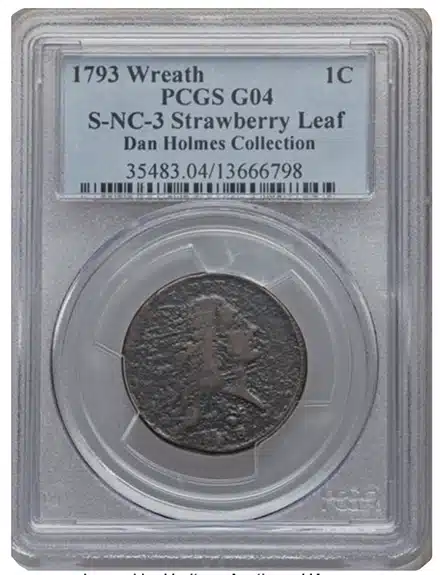
This variety features a trefoil leaf, which does not in any way resemble a strawberry plant, on the obverse above the date. Four examples known. Carry vine and bars edge device. PCGS VG10 is the finest. This coin was formerly graded F12 by NGC, and was represented as such in its 2004 and 2009 auction appearances.
- PCGS VG10 #12952855: David Proskey; Scott & Co., October 1877, Lot 201 – $77.50; purchased by H.G. Sampson acting on behalf of Lorin G. Parmelee; “The Lorin G. Parmelee Collection”, New York Stamp and Coin Co., June 1890; Lot 671 – $79; purchased by Charles Steigerwalt, Charles Steigerwalt to Dr. Thomas Hall, privately, October 1890 – $90; The Dr. Thomas Hall Collection, en bloc, to Virgil Brand, September 7, 1909; Brand estate; consigned by Armin Brand to B.G. Johnson on February 7, 1941; purchased by James Kelly, May 1941 – $2,500; Purchased by Roscoe E. Staples – $2,750; Staples estate; “The Frog Run Farm Collection”. As NGC F12, #1827897-001. American Numismatic Rarities , November 30, 2004, Lot 130 – $414,000; Stack’s Bowers, August 5, 2009, Lot 51 – $862,500. As PCGS VG10. Stack’s Bowers, August 6, 2020; Lot 1006 – $660,000. Pedigree research assisted by Stack’s Bowers.
- PCGS G4: Discovered in Philadelphia by William Rabin, Rabin marketed the coin in the September 1941 issue of The Numismatist, page 736 – $2,500; James Kelly, May 1949, Lot 1044 – $1,250; Floyd Tallmadge Starr; “The Floyd T. Starr Collection of United States Large Cents and Half Cents”, Stack’s, June 1984, Lot 7 – $51,700; Isaac Tatnall Starr, June 12, 1989; R.E. “Ted” Naftzger, Jr., February 23, 1992; Eric Streiner; Jay Parrino, October 7, 1995; Anthony Terranova, October 16, 1994; Daniel W. Holmes; “The Daniel W. Holmes Collection, Part I”, Goldberg Auctioneers, September 2009, Lot 8; Adam Mervis; “The Adam Mervis Large Cent Collection”, Heritage Auctions, January 2014, Lot 2420 – $381.875.
- About Good: George W. Merritt; Ed Frossard, January 1879, Lot 90 – $45.50; Ferguson Haines; W. Elliott Woodward, October 1880, Lot 189 – $60; H.G. Sampson; Ferguson Haines; S.H. and H. Chapman’s sale of October 1888, Lot 846, withdrawn; Ferguson Haines; Ed Frossard, December 1894, Lot 700 – $120; J. Sanford Saltus, May 16, 1906; American Numismatic Society Collection.
- PCGS F02: Purportedly discovered in circulation in 1845; John Meader, December 1868; Richard B. Winsor; “The Richard B. Winsor Collection”, S.H. & H. Chapman, December 1895, Lot 823; Sylvester S. Crosby, April 1896; Dr. Thomas Hall, September 7, 1909; Virgil Brand; Brand estate, February 7, 1941; Burdette G. Johnson, September 12, 1941; James Kelly, 1941; “The Charles M. Williams Collection”, Numismatic Gallery, November 1950, Lot 6; Floyd Tallmadge Starr; “Floyd T. Starr Collection of United States Large Cents and Half Cents”, Stack’s, June 1984, Lot 6; R.E. “Ted” Naftzger, Jr., February 23, 1992; Eric Streiner; Jay Parrino, October 7, 1995; Anthony Terranova, October 16, 1995; Daniel W. Holmes; “The Daniel W. Holmes Collection, Part I”, Goldberg Auctioneers, October 2009, Lot 7; Adam Mervis; “The Adam Mervis Large Cent Collection”, Heritage Auctions; January 2014, Lot 2419 – $352,500.
* * *
Coin Specifications
| Country: | USA |
| Year Of Issue: | 1793 |
| Denomination: | One Cent |
| Mint Mark: | None (Philadelphia) |
| Mintage: | 63,353 |
| Alloy: | Copper |
| Weight: | 13.48 g |
| Diameter: | 26.00 to 28.00 mm |
| Edge: | Lettered: ONE HUNDRED FOR A DOLLAR + leaf (or two leaves) |
| OBV Designer | Henry Voigt |
| REV Designer | Henry Voigt |
| Quality: | Business Strike |
Additional Resouces
Bowers, Q. David. The Experts Guide to Collecting & Investing in Rare Coins. Whitman Publishing.
–. A Guide Book of United States Type Coins. Whitman Publishing.
Breen, Walter. Walter Breen’s Encyclopedia of U.S. Coins. Doubleday.
-. Encyclopedia of Early United States Cents 1793-1814. Bowers and Merena Galleries.
Early American Coppers: www.eacs.org
Guth, Ron and Jeff Garrett. United States Coinage: A Study by Type. Whitman Publishing.
Noyes, William C. United States Large Cents 1793-1814. William C. Noyes.
Taxay, Don. The U.S. Mint and Coinage. Arco Publishing.
Yeoman, R.S and Jeff Garrett (editor). The Official Red Book: A Guide Book of United States Coins. Whitman Publishing.
© Charles Morgan and Hubert Walker. Published by CoinWeek under license.
The post 1793 Wreath Cent : A Collector’s Guide appeared first on CoinWeek: Rare Coin, Currency, and Bullion News for Collectors.
Gold Logs Fourth Consecutive Weekly Increase; Silver Notches 1.7% Weekly Gain
Prices of precious metals increased on Friday, resulting in weekly gains for all of them except palladium
Susan B. Anthony Dollar (1979-1999) : A Collector’s Guide
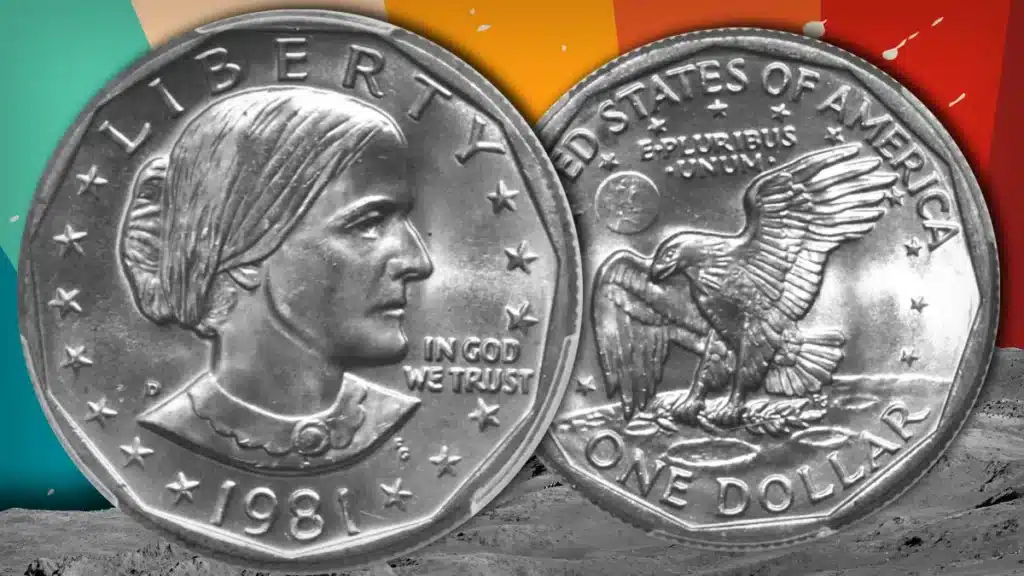
The Susan B. Anthony Dollar – America’s First Clad Small Dollar Coin
The Susan B. Anthony dollar, also known as the “Susie B” by some collectors, was the first clad small dollar coin produced for circulation in the United States. It was also the first circulating non-commemorative coin to feature the portrayal of a real, historical woman. Born in 1820 and raised in New York state as a Quaker, Susan B. Anthony was involved in the 19th-century abolitionist and temperance movements. These causes brought her into contact with women’s rights advocate Elizabeth Cady Stanton, with whom she partnered in lifelong efforts at political organization until Anthony’s death in 1906.
The new coin featuring her portrait was intended to be a more portable and useful replacement for the Eisenhower dollar, which had entered production in 1971 to honor the late president. The Eisenhower (or “Ike”) dollar’s cumbersome size was owed to the fact that the coin was based on the dimensions of a standard silver dollar. As a circulating coin, the Ike dollar did not contain any silver; collector versions were struck in a 40% silver-clad composition and sold at high premiums. But this large size meant that the Eisenhower dollar had limited utility outside of slot machines and remote areas of the American West, where silver dollars circulated to some degree.
The Susan B. Anthony dollar was meant to correct this issue. With the backing of America’s vending machine industry, the United States Congress authorized production of the coin in 1978 and the Mint tasked Chief Engraver Frank Gasparro with developing a design that would honor American suffragette Susan B. Anthony.
The Government had also hoped that a new dollar coin would displace the paper one dollar bill in commerce, but Anthony dollars generally were ignored by the public. In light of this, the vending industry quickly suspended efforts to modify its machines. With no mechanism to accept the coins at pay phones, tolls, or food and beverage vending machines–and no public desire to spend the coins elsewhere–the banking industry and the Federal Reserve quickly abandoned the coin.
Within a few short months of the coin’s failed release, Congress held hearings and blamed everyone but themselves.
The Susan B. Anthony Dollar’s Design – Polygons and Pastiche
The obverse of the dollar displays a right-facing portrait of Susan B. Anthony in a high-necked garment typical of the late 18th and early 19th centuries, her hair pulled back into a bun. The designer’s initials FG appear just below Anthony’s left shoulder. The rim is free of denticles and consists of angular segments that frame an 11-sided polygon (a hendecagon). The word LIBERTY is at the top, the date at the bottom, and the national motto IN GOD WE TRUST in small letters to the right of Anthony’s chin. Thirteen five-point stars circle the inside of the rim: seven to the left and six to the right; those on the right are split into two three-star groups by the motto. Small P, D, and S mintmarks are located just above the right shoulder.
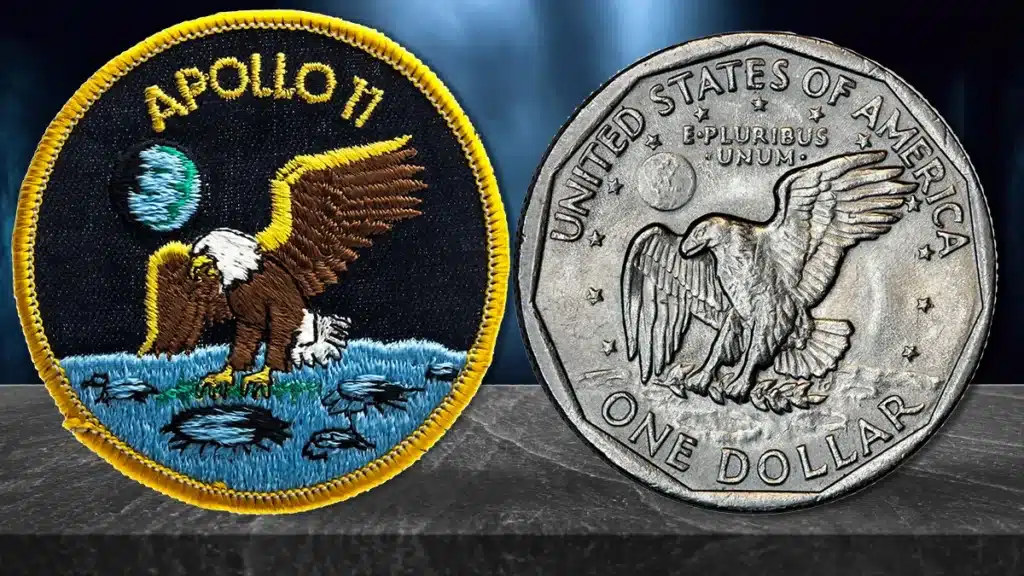
The reverse is a representation of the logo of Apollo 11, a mission that included man’s first walk on the moon. The eleven-sided rim is repeated, framing a left-facing eagle with wings spread as if landing on the surface of the moon pictured on the bottom third of the coin. The eagle is clutching an olive branch. The Earth appears above and to the left of the eagle’s head, with the motto E PLURIBUS UNUM just to the right at top center. UNITED STATES OF AMERICA encircles nearly the top half of the rim against the darkness of space, and the denomination ONE DOLLAR is located at the bottom over the lunar landscape. Thirteen five-point stars form an arc around the eagle, below the top legend but above the earth and motto, split nine to the left of the eagle’s sinister wing and four to the right/below. Gasparro’s initials are also on the reverse, below the eagle’s tail feathers.
The 1999 Susan B. Anthony Dollar – An Unexpected Return
On December 1, 1997, legislation authorizing the production of the Sacagawea golden dollar was passed by Congress and signed into law as part of the 50 States Commemorative Coin Program Act (PDF Link). The Act called for the production a a dollar coin, “golden in color” with a “distinctive edge” that has “tactile and visual features that make the denomination of the coin readily discernible.”
The U.S. Mint, under Director Philip N. Diehl, was determined to raise public awareness about this new dollar coin and generate excitement for it in the hopes that it would not share the fate of the Susan B. Anthony dollar coin.
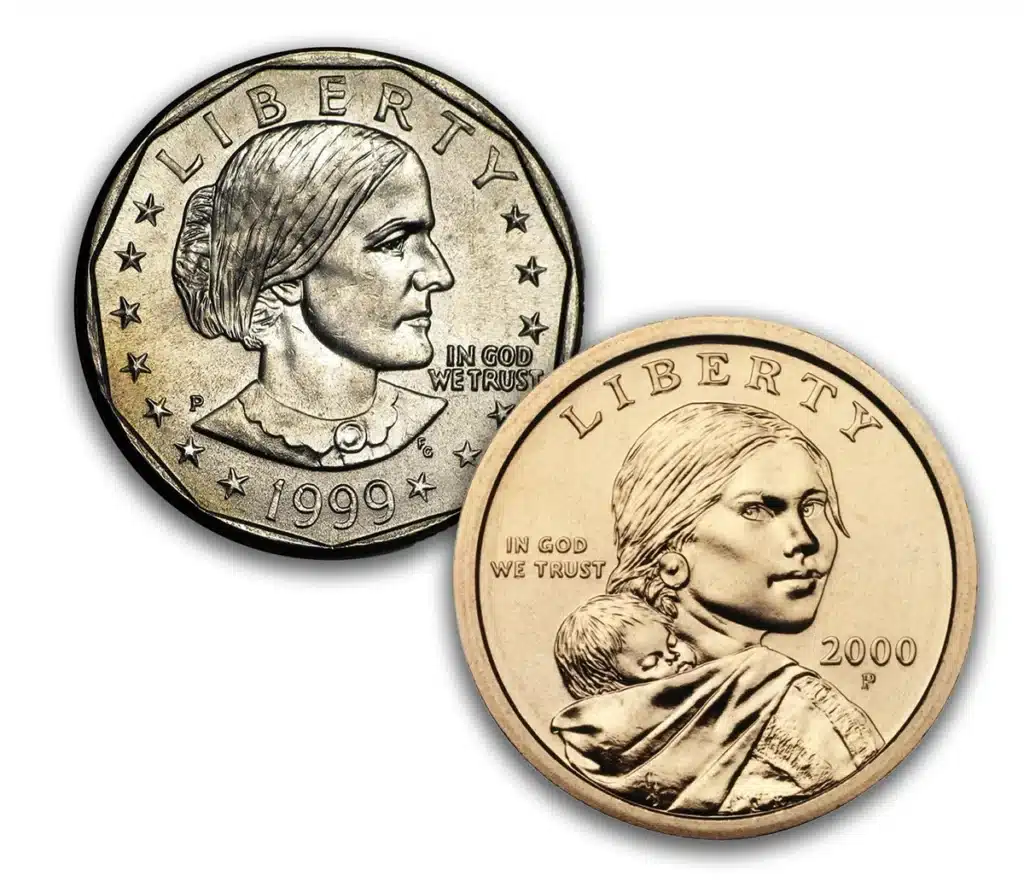
With the wildly successful launch of the 50 State Quarters program, the public was enthusiasm for coins was at an all-time high. The Mint’s marketing efforts also informed the public that a new dollar coin would be released in 2000 to inaugurate the new millennium. Imagine the surprise when, in 1999, the Mint announced that it had resumed production of the Susan B. Anthony dollar to replenish the Federal Reserve’s diminishing stockpile of the original small dollar coin.
A likely reason for these lowered stock levels was the proliferation of vending machines at post offices, metropolitan transit stations, and parking meters that accepted dollar coins and paid them out in change. The 1999 mintages were considerably lower than either of the previous two years of production, and they were absolutely dwarfed by the 1.5 billion golden dollar coins that the Mint would produce the following year.
Still, the 1999 Susan B. Anthony dollar did circulate, providing an upbeat coda for a much maligned U.S. coin type.
In 2015, CoinWeek Editor Charles Morgan spoke with Philip Diehl about this and other topics in episode six of the CoinWeek Podcast.
Some Susan B. Anthony Dollars Are Valuable
Certified Anthony dollars are considered common through MS67 and at most Proof grades, including the top Proof 70 classification. Prices are affordable at nearly all grades, bumping slightly for the 1979-P Wide Rim and 1981-S circulation strikes but jumping dramatically for MS66 and finer for those same issues and also the 1981-P.
Proofs for nearly all dates are reasonably priced up to and including Proof 70 – except for 1979-S Type 2 and 1981-S Type 2 coins, which are considerably higher at Proof 70.
Prooflike circulation strikes are known, as are Cameo and Deep Cameo Proofs; in fact, census/population reports are heavily represented by those classifications. Coins were produced at Philadelphia, Denver, and San Francisco from 1979 through 1981, and only at Philadelphia and Denver in 1999.
Interesting Susan B. Anthony Varieties, Patterns, and Errors
Susan B. Anthony dollars struck at the Philadelphia Mint in 1979 come in Narrow Rim and Wide Rim versions.

The Narrow Rim version is the common variety for the date. On this version, the rim has a good degree of separation between it and the bottom of the digits of the date. Of the two, the Wide Rim variety is considerably scarcer but it is not rare.
On the Wide Rim 1979-P Susan B. Anthony dollar, the bottom of the digits will nearly touch the rim, and the rim itself is rounded and less defined. The sharp corners of the polygonal rim are absent. Once you see the two varieties side by side, the differences become easy to distinguish.
Condition plays a major factor when discussing the value of coins and varieties. In Choice Mint State condition, the 1979-P Wide Rim Susan B. Anthony dollar typically commands a price of about $36, whereas in the same grade, the 1979-P Narrow Rim Susan B. Anthony can be acquired for about $6.
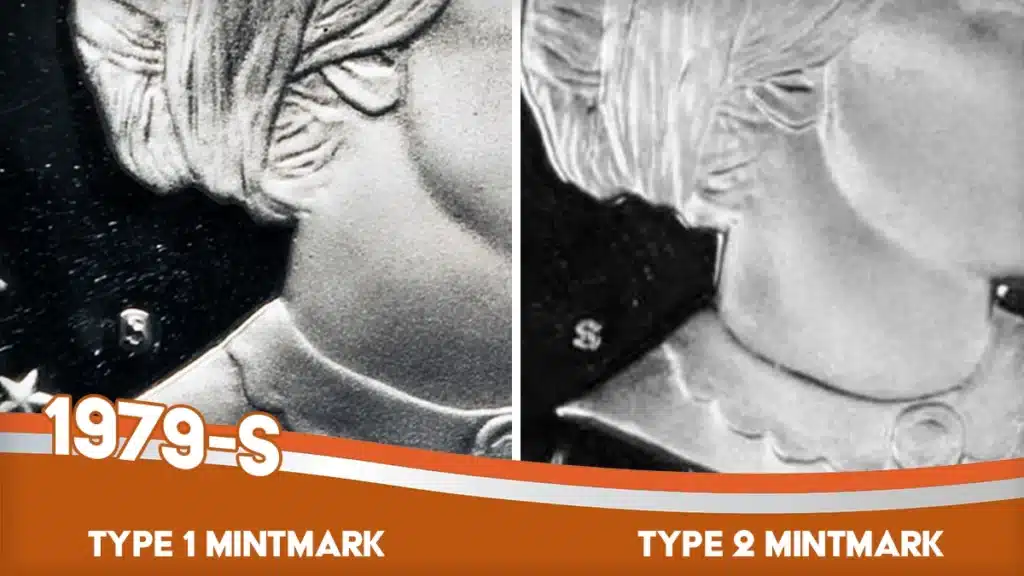
San Francisco Proof coins for 1979 and 1981 are cataloged as Type 1 and Type 2. Type 1 coins for 1979 have a filled S mintmark; Type 2 coins have a open, rounded mintmark. The Type 2 Proof 1979-S Susan B. Anthony dollar is worth approximately six times more than the Type 1.
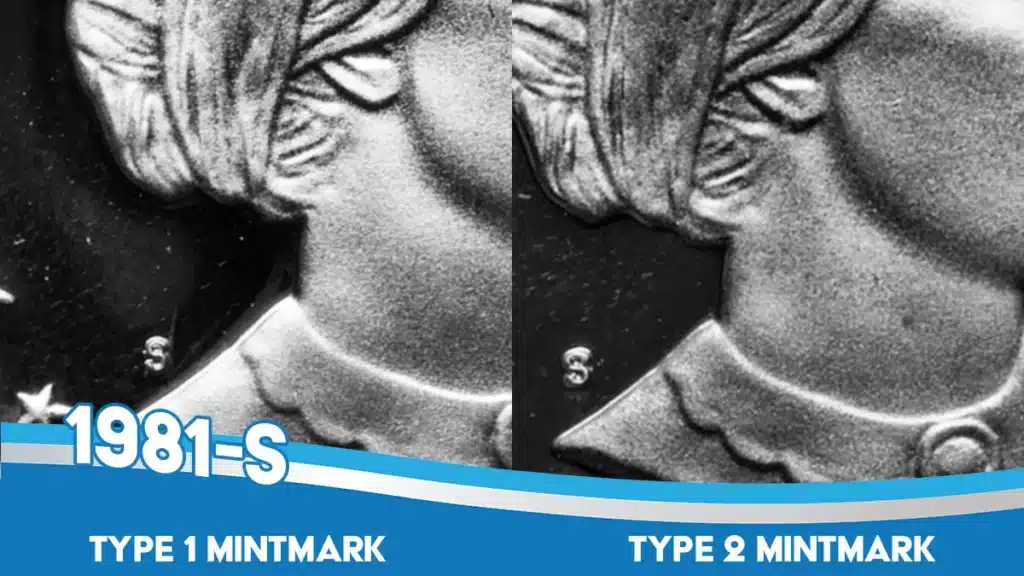
Lucky collectors might stumble upon one of the reported 1999 Susan B. Anthony dollars struck on a Sacagawea dollar planchet. These mint errors are extremely rare and are known to have been produced by both the Philadelphia and Denver mints. These coins were likely struck late in the year as both mints were preparing to produce the 2000-dated Sacagawea dollar coins. The example illustrated below was sold by Stack’s Bowers in September 2011 for $7,762.50 USD.

An interesting Susan B. Anthony dollar pattern that is available for collectors in limited quantities is cataloged in the Judd reference as J-2175 and is an undated pattern with raised mounds in the center and the raised 11-sided rim. The illustrated example is one of the only few known to exhibit Mint-applied arrow markings. This pattern has an estimated value of $1,500.
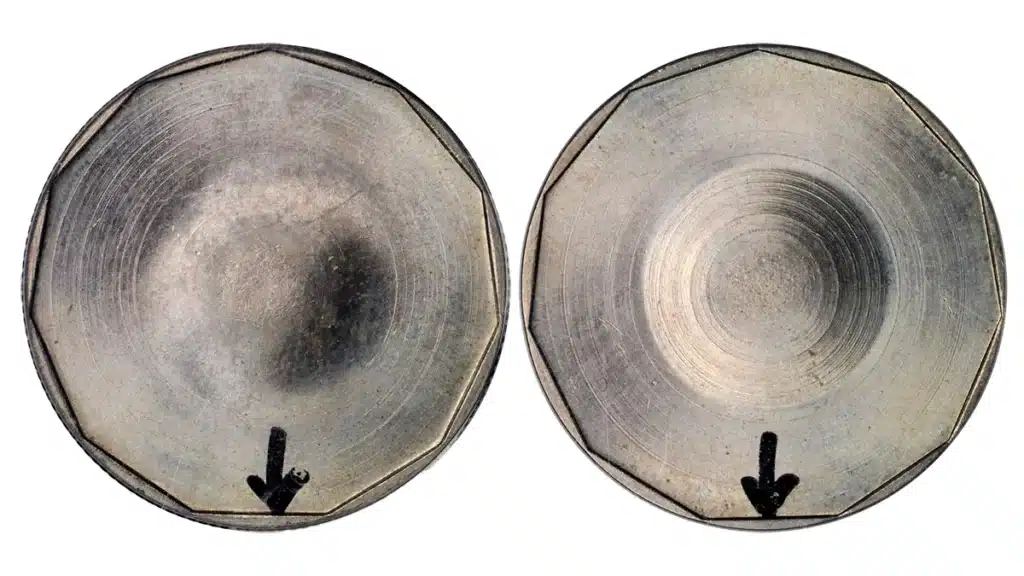
Susan B. Anthony Dollar Mintage Figures
The Susan B. Anthony dollar was struck for three consecutive years before being placed on hiatus by the Treasury Department during the first year of the Reagan Administration. The coin was produced at the Philadelphia Mint and the Denver Mint in 1999 after it was announced that the golden Sacagawea dollar would be struck for circulation in 2000.
The San Francisco Mint struck coins for circulation and for collector Proof Sets from 1979 to 1981. For the 1999 release, Susan B. Anthony dollar Proofs were struck at Philadelphia and sold individually.
- 1979-P – 360,222,000
- 1979-D – 288,015,744
- 1979-S – 109,576,000 (plus 3,677,175 Proofs)
- 1980-P – 27,610,000
- 1980-D – 41,628.708
- 1980-S – 20,422,000 (plus 3,554,806 Proofs)
- 1981-P – 3,000,000
- 1981-D – 3,250,000
- 1981-S – 3,492,000 (plus 4,063,083 Proofs)
- 1999-P – 29,592,000 (plus an estimated 750,000 Proofs)
- 1999-D – 11,776,000
In-Depth Susan B. Anthony Dollar Date Analysis by CoinWeek IQ
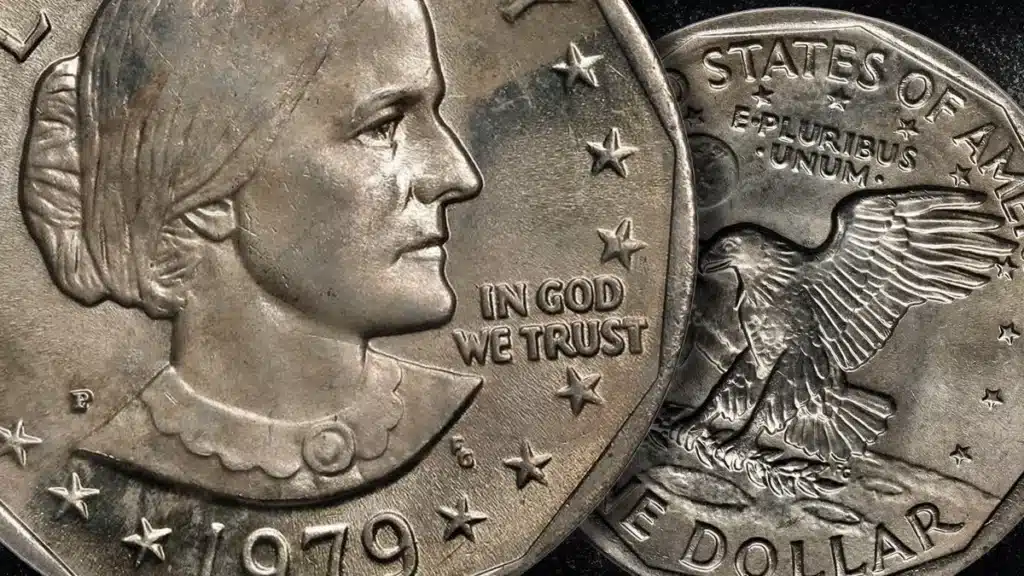
While the 1979-P Susan B. Anthony dollar boasts the highest mintage for the short-lived small dollar coin series, it also features an important variety that is worth at least six times more than the typical dollar coin. This article discusses that variety and how public hostility to the new coin doomed it from the start.
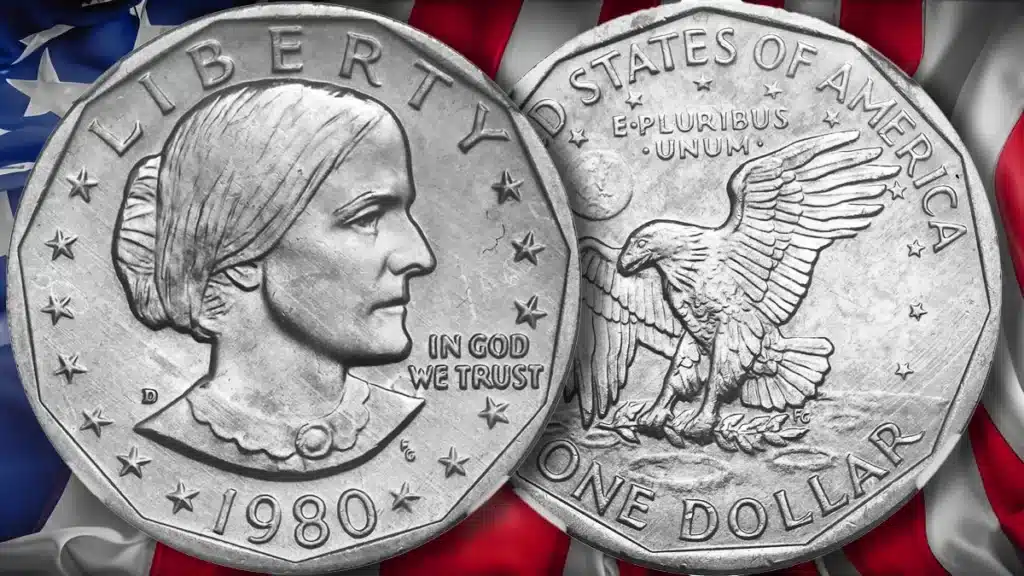
The 1980-D Susan B. Anthony was the last small dollar coin struck in Denver for circulation until the surprise reappearance of the Susan B. Anthony dollar in 1999 after the public announcement that the Mint would produce the Sacagawea dollar for circulation the next year. While struck in fewer numbers than the 1979-D, the 1980-D is common in all grades and can still be found in circulation.
Specifications
| Susan B. Anthony Dollar | |
| Years Of Issue: | 1979-81, 1999 |
| Mintage (Circulation): | High – 360,222,000 (1979-P); Low – 3,000,000 (1981-P) |
| Mintage (Proof): | High – 4,063,083 (1981-S); Low – 750,000 (1999-P) |
| Alloy: | 75% copper, 25% nickel; inner core is pure copper |
| Weight: | 8.10 g |
| Diameter: | 26.50 mm |
| Edge: | Reeded |
| OBV Designer | Frank Gasparro |
| REV Designer | Frank Gasparro | Michael Collins |
* * *
References
Bowers, Bowers, Q. David. A Guide Book of Modern Dollars. Whitman Publishing.
Breen, Walter. Walter Breen’s Encyclopedia of U.S. Coins. Doubleday.
Yeoman, R.S and Kenneth Bressett (editor). The Official Red Book: A Guide Book of United States Coins. Whitman Publishing.
* * *
The post Susan B. Anthony Dollar (1979-1999) : A Collector’s Guide appeared first on CoinWeek: Rare Coin, Currency, and Bullion News for Collectors.
Susan B. Anthony Dollar (1979-1999) : A Collector’s Guide

The Susan B. Anthony Dollar – America’s First Clad Small Dollar Coin
The Susan B. Anthony dollar, also known as the “Susie B” by some collectors, was the first clad small dollar coin produced for circulation in the United States. It was also the first circulating non-commemorative coin to feature the portrayal of a real, historical woman. Born in 1820 and raised in New York state as a Quaker, Susan B. Anthony was involved in the 19th-century abolitionist and temperance movements. These causes brought her into contact with women’s rights advocate Elizabeth Cady Stanton, with whom she partnered in lifelong efforts at political organization until Anthony’s death in 1906.
The new coin featuring her portrait was intended to be a more portable and useful replacement for the Eisenhower dollar, which had entered production in 1971 to honor the late president. The Eisenhower (or “Ike”) dollar’s cumbersome size was owed to the fact that the coin was based on the dimensions of a standard silver dollar. As a circulating coin, the Ike dollar did not contain any silver; collector versions were struck in a 40% silver-clad composition and sold at high premiums. But this large size meant that the Eisenhower dollar had limited utility outside of slot machines and remote areas of the American West, where silver dollars circulated to some degree.
The Susan B. Anthony dollar was meant to correct this issue. With the backing of America’s vending machine industry, the United States Congress authorized production of the coin in 1978 and the Mint tasked Chief Engraver Frank Gasparro with developing a design that would honor American suffragette Susan B. Anthony.
The Government had also hoped that a new dollar coin would displace the paper one dollar bill in commerce, but Anthony dollars generally were ignored by the public. In light of this, the vending industry quickly suspended efforts to modify its machines. With no mechanism to accept the coins at pay phones, tolls, or food and beverage vending machines–and no public desire to spend the coins elsewhere–the banking industry and the Federal Reserve quickly abandoned the coin.
Within a few short months of the coin’s failed release, Congress held hearings and blamed everyone but themselves.
The Susan B. Anthony Dollar’s Design – Polygons and Pastiche
The obverse of the dollar displays a right-facing portrait of Susan B. Anthony in a high-necked garment typical of the late 18th and early 19th centuries, her hair pulled back into a bun. The designer’s initials FG appear just below Anthony’s left shoulder. The rim is free of denticles and consists of angular segments that frame an 11-sided polygon (a hendecagon). The word LIBERTY is at the top, the date at the bottom, and the national motto IN GOD WE TRUST in small letters to the right of Anthony’s chin. Thirteen five-point stars circle the inside of the rim: seven to the left and six to the right; those on the right are split into two three-star groups by the motto. Small P, D, and S mintmarks are located just above the right shoulder.

The reverse is a representation of the logo of Apollo 11, a mission that included man’s first walk on the moon. The eleven-sided rim is repeated, framing a left-facing eagle with wings spread as if landing on the surface of the moon pictured on the bottom third of the coin. The eagle is clutching an olive branch. The Earth appears above and to the left of the eagle’s head, with the motto E PLURIBUS UNUM just to the right at top center. UNITED STATES OF AMERICA encircles nearly the top half of the rim against the darkness of space, and the denomination ONE DOLLAR is located at the bottom over the lunar landscape. Thirteen five-point stars form an arc around the eagle, below the top legend but above the earth and motto, split nine to the left of the eagle’s sinister wing and four to the right/below. Gasparro’s initials are also on the reverse, below the eagle’s tail feathers.
The 1999 Susan B. Anthony Dollar – An Unexpected Return
On December 1, 1997, legislation authorizing the production of the Sacagawea golden dollar was passed by Congress and signed into law as part of the 50 States Commemorative Coin Program Act (PDF Link). The Act called for the production a a dollar coin, “golden in color” with a “distinctive edge” that has “tactile and visual features that make the denomination of the coin readily discernible.”
The U.S. Mint, under Director Philip N. Diehl, was determined to raise public awareness about this new dollar coin and generate excitement for it in the hopes that it would not share the fate of the Susan B. Anthony dollar coin.

With the wildly successful launch of the 50 State Quarters program, the public was enthusiasm for coins was at an all-time high. The Mint’s marketing efforts also informed the public that a new dollar coin would be released in 2000 to inaugurate the new millennium. Imagine the surprise when, in 1999, the Mint announced that it had resumed production of the Susan B. Anthony dollar to replenish the Federal Reserve’s diminishing stockpile of the original small dollar coin.
A likely reason for these lowered stock levels was the proliferation of vending machines at post offices, metropolitan transit stations, and parking meters that accepted dollar coins and paid them out in change. The 1999 mintages were considerably lower than either of the previous two years of production, and they were absolutely dwarfed by the 1.5 billion golden dollar coins that the Mint would produce the following year.
Still, the 1999 Susan B. Anthony dollar did circulate, providing an upbeat coda for a much maligned U.S. coin type.
In 2015, CoinWeek Editor Charles Morgan spoke with Philip Diehl about this and other topics in episode six of the CoinWeek Podcast.
Some Susan B. Anthony Dollars Are Valuable
Certified Anthony dollars are considered common through MS67 and at most Proof grades, including the top Proof 70 classification. Prices are affordable at nearly all grades, bumping slightly for the 1979-P Wide Rim and 1981-S circulation strikes but jumping dramatically for MS66 and finer for those same issues and also the 1981-P.
Proofs for nearly all dates are reasonably priced up to and including Proof 70 – except for 1979-S Type 2 and 1981-S Type 2 coins, which are considerably higher at Proof 70.
Prooflike circulation strikes are known, as are Cameo and Deep Cameo Proofs; in fact, census/population reports are heavily represented by those classifications. Coins were produced at Philadelphia, Denver, and San Francisco from 1979 through 1981, and only at Philadelphia and Denver in 1999.
Interesting Susan B. Anthony Varieties, Patterns, and Errors
Susan B. Anthony dollars struck at the Philadelphia Mint in 1979 come in Narrow Rim and Wide Rim versions.

The Narrow Rim version is the common variety for the date. On this version, the rim has a good degree of separation between it and the bottom of the digits of the date. Of the two, the Wide Rim variety is considerably scarcer but it is not rare.
On the Wide Rim 1979-P Susan B. Anthony dollar, the bottom of the digits will nearly touch the rim, and the rim itself is rounded and less defined. The sharp corners of the polygonal rim are absent. Once you see the two varieties side by side, the differences become easy to distinguish.
Condition plays a major factor when discussing the value of coins and varieties. In Choice Mint State condition, the 1979-P Wide Rim Susan B. Anthony dollar typically commands a price of about $36, whereas in the same grade, the 1979-P Narrow Rim Susan B. Anthony can be acquired for about $6.

San Francisco Proof coins for 1979 and 1981 are cataloged as Type 1 and Type 2. Type 1 coins for 1979 have a filled S mintmark; Type 2 coins have a open, rounded mintmark. The Type 2 Proof 1979-S Susan B. Anthony dollar is worth approximately six times more than the Type 1.

Lucky collectors might stumble upon one of the reported 1999 Susan B. Anthony dollars struck on a Sacagawea dollar planchet. These mint errors are extremely rare and are known to have been produced by both the Philadelphia and Denver mints. These coins were likely struck late in the year as both mints were preparing to produce the 2000-dated Sacagawea dollar coins. The example illustrated below was sold by Stack’s Bowers in September 2011 for $7,762.50 USD.

An interesting Susan B. Anthony dollar pattern that is available for collectors in limited quantities is cataloged in the Judd reference as J-2175 and is an undated pattern with raised mounds in the center and the raised 11-sided rim. The illustrated example is one of the only few known to exhibit Mint-applied arrow markings. This pattern has an estimated value of $1,500.

Susan B. Anthony Dollar Mintage Figures
The Susan B. Anthony dollar was struck for three consecutive years before being placed on hiatus by the Treasury Department during the first year of the Reagan Administration. The coin was produced at the Philadelphia Mint and the Denver Mint in 1999 after it was announced that the golden Sacagawea dollar would be struck for circulation in 2000.
The San Francisco Mint struck coins for circulation and for collector Proof Sets from 1979 to 1981. For the 1999 release, Susan B. Anthony dollar Proofs were struck at Philadelphia and sold individually.
- 1979-P – 360,222,000
- 1979-D – 288,015,744
- 1979-S – 109,576,000 (plus 3,677,175 Proofs)
- 1980-P – 27,610,000
- 1980-D – 41,628.708
- 1980-S – 20,422,000 (plus 3,554,806 Proofs)
- 1981-P – 3,000,000
- 1981-D – 3,250,000
- 1981-S – 3,492,000 (plus 4,063,083 Proofs)
- 1999-P – 29,592,000 (plus an estimated 750,000 Proofs)
- 1999-D – 11,776,000
In-Depth Susan B. Anthony Dollar Date Analysis by CoinWeek IQ

While the 1979-P Susan B. Anthony dollar boasts the highest mintage for the short-lived small dollar coin series, it also features an important variety that is worth at least six times more than the typical dollar coin. This article discusses that variety and how public hostility to the new coin doomed it from the start.

The 1980-D Susan B. Anthony was the last small dollar coin struck in Denver for circulation until the surprise reappearance of the Susan B. Anthony dollar in 1999 after the public announcement that the Mint would produce the Sacagawea dollar for circulation the next year. While struck in fewer numbers than the 1979-D, the 1980-D is common in all grades and can still be found in circulation.
Specifications
| Susan B. Anthony Dollar | |
| Years Of Issue: | 1979-81, 1999 |
| Mintage (Circulation): | High – 360,222,000 (1979-P); Low – 3,000,000 (1981-P) |
| Mintage (Proof): | High – 4,063,083 (1981-S); Low – 750,000 (1999-P) |
| Alloy: | 75% copper, 25% nickel; inner core is pure copper |
| Weight: | 8.10 g |
| Diameter: | 26.50 mm |
| Edge: | Reeded |
| OBV Designer | Frank Gasparro |
| REV Designer | Frank Gasparro | Michael Collins |
* * *
References
Bowers, Bowers, Q. David. A Guide Book of Modern Dollars. Whitman Publishing.
Breen, Walter. Walter Breen’s Encyclopedia of U.S. Coins. Doubleday.
Yeoman, R.S and Kenneth Bressett (editor). The Official Red Book: A Guide Book of United States Coins. Whitman Publishing.
* * *
The post Susan B. Anthony Dollar (1979-1999) : A Collector’s Guide appeared first on CoinWeek: Rare Coin, Currency, and Bullion News for Collectors.

A Golden Opportunity for U.S. Gold Coins: Jeff Garrett

By Jeff Garrett for Numismatic Guaranty Corporation (NGC) ……
 In the last few weeks, gold has finally started to move in a positive direction as it briefly topped $2,000 USD for the first time in months. Tensions over global conflicts have once again made gold look attractive as a safety play. Almost daily we have clients calling and asking about how to buy gold to protect their assets. It will only take one headline crisis for gold to move to the next level.
In the last few weeks, gold has finally started to move in a positive direction as it briefly topped $2,000 USD for the first time in months. Tensions over global conflicts have once again made gold look attractive as a safety play. Almost daily we have clients calling and asking about how to buy gold to protect their assets. It will only take one headline crisis for gold to move to the next level.
The most immediate effect of the recent gold rise has been an upsurge in coin shipments. I would also guess that companies with a strong web presence that are devoted to bullion have also seen an increase in business. Many dealers whom I have contacted have bought much more than they have been selling. That is one of the reasons that the premiums for bullion-related objects are near recent lows.
This oversupply is also playing out in the rare and nearly rare coin market. Generic date, common issues of United States gold coins are selling for very low premiums once again. Much of this surplus is fueled by an avalanche of pre-1933 gold coins flowing back to the U.S. from Europe. During the Great Depression (1929-39) and before, large quantities of American gold coins were shipped to Europe as a standard course of international trade. No one really knew how much U.S. gold remained lurking in the vaults of European banks and other financial institutions.
Starting in the 1950s, some coin dealers began to repatriate these coins at a slow but steady pace. In the ’60s and ’70s, some previously rare-dated $20 double eagles appeared in these European shipments. Mega-rarities like the 1924-D, the 1925-D, and the 1926-S were found in quantity. A great narrative of this time period can be found in the seminal books on United States gold coins by David W. Akers that were first published in the 1970s. Akers knew much of this information firsthand, as he had handled many of these mini-hoards.
Many of the largest dealers of the day participated in this release of gold coins back into the domestic market. For years, that market has been orderly, with premiums changing based on the supply-and-demand issues of the day. In 1999, the premium for U.S. gold coins surged as citizens around the world prepared for the Y2K crisis that never materialized. There have been other ups and downs over the years, but gold coins have been a steady favorite of investors and those serving that clientele.
Today, the rare coin market is being faced with an unprecedented quantity of gold coins. These coins have been quietly entering the market for some time, but in the last few years some retailers have been loudly touting this newfound supply of U.S. gold coinage. At least one cable TV show has invested in a high-quality presentation featuring the story of these gold coins, and how they found their way to Europe for the last 100 years or more. Other retail operations have been running newspaper ads and selling by direct mail.
By now you are probably thinking that this part of the market should be avoided due to oversupply. I urge you to consider otherwise. There has never been a better time to start a collection of United States gold coins. Premiums for most double eagles, other than scarce or rare issues, have been crushed in the last year or so.
There is also a lot of market uncertainty due to the fact that no one really knows what is in the recent flows coming from Europe. A few of the major players have an idea, but I doubt any one person or group knows the full extent of what exists in these foreign holdings. Markets hate uncertainty, and that is one of the reasons prices have fallen so much. In time, this will be resolved as the coins are absorbed and more information becomes clear to researchers and collectors.
The knee-jerk reaction of most collectors and dealers is to fear large quantities of coins when they enter the market. Several years ago, when I handled the 16,000 coins in the New York Bank Hoard of Treasury-released silver dollars, I was asked by several dealers if this would kill the market for Morgan dollars. These individuals far underestimate the size of the market for rare coins. Those coins were sold to one company that sold every coin for retail, and the market was unaffected.
Going back decades, the same fears were felt when the Redfield Hoard of silver dollars entered the market. That hoard contained over 400,000 silver dollars, many of which were rare dates. The coins were expertly marketed, and prices actually rose based on the number of new collectors that were attracted to the hobby by the fascinating story of LaVere Redfield and his silver dollars. It should also be remembered that the GSA Hoard of Carson City Morgan dollars contained over 2.5 million coins, and these have now been fully dispersed and are widely collected.
The same opportunity awaits those interested in American gold coins, particularly double eagles. Savvy collectors and investors should take advantage of this market uncertainty and amazingly low prices. Many collectors are probably unaware of how many date and mintmark combinations of double dagles can be purchased for very little over the melt value.
The following is a list of 125 double eagles that can be purchased for less than $2,500 in About Uncirculated or Mint State:
1851, 1852, 1853, 1855, 1855-S, 1856, 1856-S, 1857, 1857-S, 1858-S, 1859-S, 1860, 1860-S, 1861, 1861-S, 1864-S, 1865-S, 1866 With Motto, 1866-S With Motto, 1867, 1867-S, 1868-S, 1869, 1869-S, 1870, 1870-S, 1871, 1871-S, 1872, 1872-S, 1873 Close 3, 1873 Open 3, 1873-S Close 3, 1873-S Open 3, 1874, 1874-S, 1875, 1875-S, 1876, 1876-S, 1877, 1877-S, 1878, 1878-S, 1879, 1879-S, 1880, 1880-S, 1881-S, 1882-S, 1883-S, 1884-S, 1885-S, 1887-S, 1888, 1888-S, 1889, 1889-S, 1890, 1890-S, 1891-S, 1892-S, 1893, 1893-S, 1894, 1894-S, 1895, 1895-S, 1896, 1896-S, 1897, 1897-S, 1898, 1898-S, 1899, 1899-S, 1900, 1900-S, 1901, 1901-S, 1902, 1902-S, 1903, 1903-S, 1904, 1904-S, 1905, 1905-S, 1906, 1906-D, 1906-S, 1907, 1907 Arabic Numerals, 1907-D, 1907-S, 1908 No Motto, 1908 With Motto, 1908-D No Motto, 1908-D With Motto, 1909, 1909-S, 1910, 1910-D, 1910-S, 1911, 1911-D, 1911-S, 1912, 1913, 1913-D, 1914, 1914-D, 1914-S, 1915, 1915-S, 1916-S, 1920, 1922, 1923, 1923-D, 1924, 1925, 1926, 1927, 1928
For those who find the starting price a bit high for double eagles, you might consider $5 half eagle and $10 eagle gold coins. Most groups of European gold have never contained the smaller denominations (Gold Dollars and $2.50 quarter eagles). The above mentioned, however, are often seen in quantity. There are dozens of dates for beginner collectors to choose from, and starting a set of these has never been more affordable in relation to gold.
The most recent groups of gold have also contained some interesting coins starting in the 1840s. Nearly every United States Mint (with the exception of Dahlonega and Charlotte) that produced gold coins is represented as well, including Carson City and New Orleans. The majority of the coins I have seen have also been fresh and original. The collector-driven market for originality makes these particularly appealing.
Someday soon the dispersal of European gold will be over, and this golden opportunity will have passed. As value investor Warren Buffett has been quoted as saying, “Attempt to be fearful when others are greedy, and to be greedy only when others are fearful.” In my opinion, this wisdom holds just as true in numismatics as it does in the stock market.
* * *
* * *
The post A Golden Opportunity for U.S. Gold Coins: Jeff Garrett appeared first on CoinWeek: Rare Coin, Currency, and Bullion News for Collectors.

Mint Error News Issues 2023 Special Edition Magazine
Celebrating 20 years of Mint Error News! Volume One and Volume Two are now online. Visit minterrornews.com to read both issues.
* * *
Mint Error News (minterrornews.com) brings the latest mint error news and information to the collector. There are over 1,300 articles, features, discoveries, news stories, and mint-error-related info from the United States and around the world. The magazine’s website has become one of the most popular and informative online resources for mint errors and is read by thousands of dealers and collectors.
The two volumes are available for free download and touch on topics at the core of error collecting. Included are articles on the Top Mint Errors for 2022, a census of Lincoln Dime mule errors, an article on collecting Carson City Morgan dollar errors, informative research on a number of unique error coins from the 19th and 20th centuries, and much, much more.
Mike Byers is the Publisher and Editor of Mint Error News. Consultants are numismatic experts recognized worldwide, including Heritage Auctions, Dave Camire, Ron Guth, Marc Crane, Andy Lustig, Saul Teichman, Michael Faraone, Steven Contursi, Jeff Ylitalo, John Wang, and Fred Weinberg (retired).

* * *
The post Mint Error News Issues 2023 Special Edition Magazine appeared first on CoinWeek: Rare Coin, Currency, and Bullion News for Collectors.
2023 Morgan, Peace Dollar Reverse Proof Set Available Nov. 9
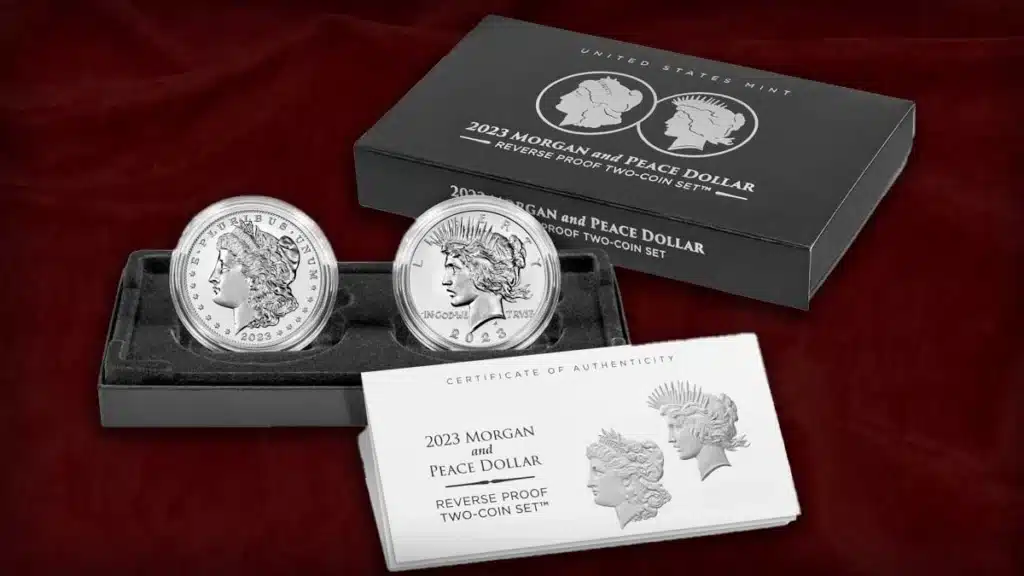
The 2023 Morgan and Peace Dollar Reverse Proof Two-Coin Set (S) will be available for direct purchase from the United States Mint has at noon Eastern Standard Time on Thursday, November 9, 2023.
The Two-Coin Set of Reverse Proof 2023 Morgan and Peace Dollars contains one Morgan Dollar coin and one Peace Dollar coin struck at the San Francisco Mint in 99.9% pure silver. At an initial retail price of $185 USD, the set’s mintage is limited to 250,000 units, with a household order limit of five during the first 24 hours.
Each two-coin set is encapsulated and packaged in an elegant black box with a sleeve and accompanied by a Certificate of Authenticity.
The set falls under the Mint’s Authorized Bulk Purchase Program, but a maximum of 10% of the limited mintage will be sold to authorized bulk purchasers. The remaining 90% of the mintage will be available to purchase by the general public.
The 2023 versions of the Morgan and Peace Silver Dollars feature two of the most revered designs of Lady Liberty in the history of United States coinage. The Morgan Dollar was designed by Mint engraver George T. Morgan and features a classic profile of Liberty on the obverse, while a heraldic eagle is featured on the reverse. The Peace Dollar, designed by artist Anthony de Francisci, features the Goddess of Liberty on the obverse and a bald eagle holding an olive branch on the reverse.
To set up REMIND ME alerts for the 2023 Morgan and Peace Dollar Reverse Proof Two-Coin Set from San francisco, be sure to visit catalog.usmint.gov/morgan-peace-dollar-2023-two-coin-reverse-proof-set-23XS.html (product code 23XS).
* * *
The post 2023 Morgan, Peace Dollar Reverse Proof Set Available Nov. 9 appeared first on CoinWeek: Rare Coin, Currency, and Bullion News for Collectors.
Federal Reserve Order for Banknotes in 2024 Peaks at 6.9 Billion
Reverse Proof Set of Morgan and Peace Dollars Headlines November U.S. Mint Products
The year is winding down for U
Minimal Shifts in Precious Metal Prices on Thursday, Nov. 2
On Thursday, the prices of precious metals showed minimal changes, with gold, silver, and platinum edging slightly higher, while palladium experienced a slight dip
The Morgan 50 Now a Competitive Set on the NGC Registry
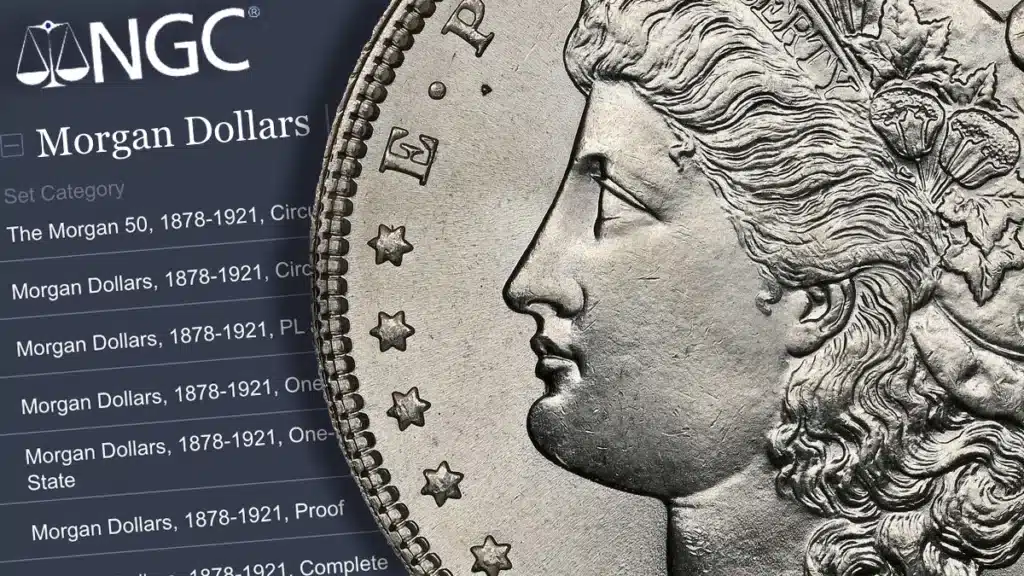
The Morgan 50 – A Morgan Dollar Collection Every Collector Can Complete
Designed to fit the budget of every collector but still offer a longterm challenge and collecting goal, The Morgan 50 Registry Set by NGC is comprised of fifty uncirculated Morgan dollars struck from 1878 to 1921. In certified MS63 grades, each coin has a retail value of between $75 and $400 USD, with most averaging under $125. These coins are affordable enough that any collector of Modern U.S. Mint material will have the ability to complete the set.
The Morgan Dollar series is a large and complex series of coins to collect, with several rare issues, many interesting varieties, and Proof versions. As coin prices continue to rise, however, the ability for beginner and intermediate collectors to complete a matching set gets harder and harder.
Nevertheless, there are ways to approach the set where completion is possible. CoinWeek’s Charles Morgan teamed up with coin dealer Russ Augustin (AU Capital Management, RARCOA) to help develop this innovative new set collecting idea for the Morgan Dollar series. In selecting 50 coins, Russ and Charles focused on issues from all five Morgan dollar-producing mints, including Philadelphia, New Orleans, and the western San Francisco, Carson City, and Denver mints.
They discuss the coins of The Morgan 50 in the set in the videos below.
Part I: The Philly Strikes
Part II: New Orleans Strikes
To learn more, visit www.ngc.com.
To view Russ’ current inventory of Morgan dollars, gold coins, and more, visit www.aucm.com.
* * *
The post The Morgan 50 Now a Competitive Set on the NGC Registry appeared first on CoinWeek: Rare Coin, Currency, and Bullion News for Collectors.
The Morgan 50 Set is Now a Competitive Set on the NGC Registry

A Morgan Dollar Collection Every Collector Can Complete
Designed to fit the budget of every collector but still offer a longterm challenge and collecting goal, The Morgan 50 Registry Set by NGC is comprised of fifty uncirculated Morgan dollars struck from 1878 to 1921. In certified MS63 grades, each coin has a retail value of between $75 and $400 USD, with most averaging under $125. These coins are affordable enough that any collector of Modern U.S. Mint material will have the ability to complete the set.
The Morgan Dollar series is a large and complex series of coins to collect, with several rare issues, many interesting varieties, and Proof versions. As coin prices continue to rise, however, the ability for beginner and intermediate collectors to complete a matching set gets harder and harder.
Nevertheless, there are ways to approach the set where completion is possible. CoinWeek’s Charles Morgan teamed up with coin dealer Russ Augustin (AU Capital Management, RARCOA) to help develop this innovative new set collecting idea for the Morgan Dollar series. In selecting 50 coins, Russ and Charles focused on issues from all five Morgan dollar-producing mints, including Philadelphia, New Orleans, and the western San Francisco, Carson City, and Denver mints.
They discuss the coins of The Morgan 50 in the set in the videos below.
Part I: The Philly Strikes
Part II: New Orleans Strikes
To learn more, visit www.ngc.com.
To view Russ’ current inventory of Morgan dollars, gold coins, and more, visit www.aucm.com.
* * *
The post The Morgan 50 Set is Now a Competitive Set on the NGC Registry appeared first on CoinWeek: Rare Coin, Currency, and Bullion News for Collectors.

Coin Design Blunders at the United States Mint
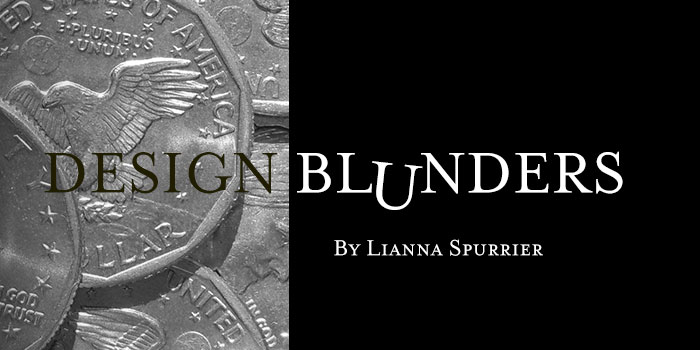
By Lianna Spurrier for CoinWeek …..
We all make mistakes – the United States Mint included. Over the years the Mint has released multiple coins with design flaws that caused outrage, confusion, and flat-out rejection.
We’ve all heard how public upset led to the removal of “VDB” from the back of the wheat penny and the covering of Lady Liberty’s breast on the Standing Liberty quarters. Did the masses really care that much about their coinage? Was there really enough pushback that popular opinion necessitated these changes?
Shield Nickel Rays Coin Design
The shield nickel was released in 1866 with a circle of 13 stars on the reverse that had rays between them. In early 1867, these rays were removed.
It’s widely known that the shield nickel series as a whole proved to be very difficult to strike. The Mint hadn’t worked with nickel very much and it is a harder material than copper or silver, making the dies liable to crack and have a short lifespan.
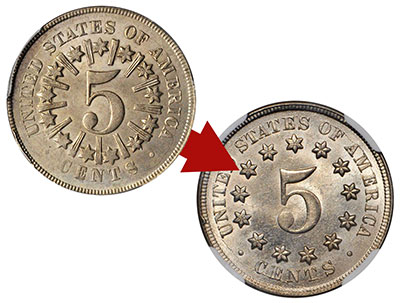 The rays on the reverse were part of the problem. There was little space between each ray and its neighboring stars, making it a particularly problematic part of the coin. They were removed in part to help the dies last longer.
The rays on the reverse were part of the problem. There was little space between each ray and its neighboring stars, making it a particularly problematic part of the coin. They were removed in part to help the dies last longer.
But there were other reasons. The design as a whole was widely criticized; Joseph Wharton famously likened it to a tombstone, and an 1866 Letter to the Editor published in the American Journal of Numismatics asserted that “[t]he motto ‘In God We Trust,’ is very opportune, for the inventor [sic] of this coin may rest assured that the devil will never forgive him for such an abortion.”
The most controversial offense, however, was on the reverse. The rays reminded some of the Confederate flags from the Civil War, indicating Southern sympathies. While seemingly not an extremely widespread complaint, this may have had something to do with the removal of the rays as well.
VDB Wheat Pennies
The release of the Lincoln cent in 1909, designed by Victor David Brenner, was highly anticipated. It was the first circulating US coin to feature a portrait of a historical figure, and there was such high demand that the Mint had to limit how many an individual could purchase. They were released on August 2, and the complaints started rolling in only a couple days later.
On August 4, the Middletown Daily Argus of Middletown, New York, published a brief article entitled “Lincoln Coins Faulty”:
The new Lincoln cent has been only one day in circulation and already it is declared that a serious blunder was made by the Mint authorities and that a new die may have to be made to eliminate the objectionable feature.
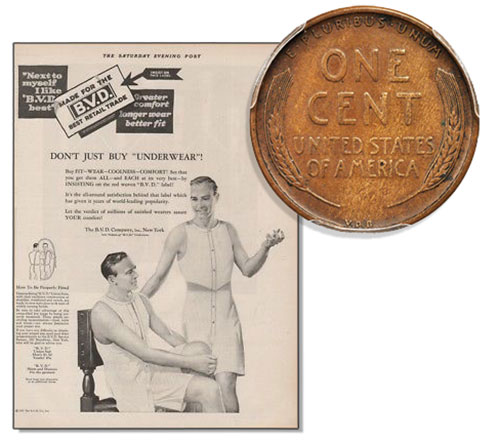 The initials “VDB”, on the bottom reverse of the coin, were seen as too bold and made many think of Brenner as conceited. In addition, according to the Des Moines News, some people mistook the initials for the trademark of an underwear brand – BVD.
The initials “VDB”, on the bottom reverse of the coin, were seen as too bold and made many think of Brenner as conceited. In addition, according to the Des Moines News, some people mistook the initials for the trademark of an underwear brand – BVD.
Franklin MacVeagh, Secretary of the Treasury, responded promptly. Over the next few days, multiple options were considered: removing the initials altogether, leaving them be, or replacing them with only a “B”. Ultimately, they were removed entirely, until finding a new home beneath Lincoln’s shoulder in 1918.
Numismatists of the day expected that the VDB varieties would become scarce and began saving them as soon as the change was announced, resulting in many high-grade specimens available today.
Brenner was none too happy about the removal of his initials. He originally included his full last name on the design, but it was reduced before minting began. In a letter to The Numismatist on August 23, Brenner said:
It is mighty hard for me to express my sentiments with reference to the initials on the cent. The name of the artist on a coin is essential for the student of history as it enables him to trace environments and conditions of the time said coin was produced.
There was already precedent to place his initials on the coin. In fact, the only other circulating coins at the time without a designer’s initials were the nickel and the $10 gold piece. Regardless, the controversy regarding his initials may very well have made him one of the more well-known designers of a US coin, especially considering that the wheat penny is the only circulating coin he created.
Type 1 & 2 Standing Liberty Quarters
Another widely known design change was the covering of Lady Liberty’s breast on the Type 2 Standing Liberty quarter in 1917. The common belief is that a public outcry of conservatives drove this change, but there were no such complaints.
The change was actually a result of people inside the Mint. Hermon A. MacNeil designed the Standing Liberty quarter in 1916. Between the approval of his designs and the beginning of production in December, multiple modifications were made without MacNeil’s approval; the eagle on the reverse was lowered, a pair of dolphins originally on the obverse was removed, and other small changes were made. His design was altered in part because the original design was in high relief, which the Mint was not capable of producing. Already having trouble with the new Mercury dimes and Walking Liberty half dollars, they hoped to avoid similar issues with the quarter and address them before production began.
At first, the new coins were available only to officials and prominent numismatists (out of a fear of hoarding), and MacNeil had to request a sample. Previously unaware of the design changes, he was outraged by the modifications and insisted that the new coins not be released to the public. They were held until January 17, 1917, when the already minted pieces were put into circulation.

However, MacNeil got his wish. He was allowed to change the design so that he found it acceptable, and this was where the Type 2 design came in. The original intention was to leave Liberty’s breast bare and combine two previously produced obverses, but minting technology at the time was incapable of doing so. As a result, MacNeil had to entirely reengrave the obverse. He completed this in mid-February and chose to give Lady Liberty a chain mail shirt, thus covering the exposed breast.
So why the change? There are multiple theories, but no definitive records. It may have simply been a personal choice of MacNeil’s, like other works he produced during that time, such as the statue Intellectual Development, also feature more covered females. However, Ron Guth and Jeff Garrett assert in United States Coinage: A Study by Type that MacNeil didn’t have a say in this design change.
David Lange suggests the Treasury Department may have played a part in the addition of chain mail, and Ray Young, in an article for Coins, believes it may have been a symbolic change.
As tensions with Germany grew and the lead-up to World War I began, the chain mail may have been added to show Lady Liberty as more prepared to defend herself in war. Whatever the reason truly was, there’s no evidence of any public outrage at the exposed breast.
Susan B. Anthony Dollars
In one of the more recent design flops, the Mint avidly marketed the Susan B. Anthony dollar prior to its release. They even distributed folders of promotional materials to banks and businesses, including sample ads and comics, suggestions for events, and diagrams of how to rearrange cash register drawers to allow space for the new coins.
These materials touted the coin’s benefits, claiming it would be “easy to see it is a woman”; “easy to see the unique 11-sided inner border on both sides”; and “easy to distinguish by size”.
 The verdict? Not so much. In 1988, the Colorado Springs Gazette quoted Michael Brown, Spokesman for the United States Mint, as saying, “I suppose there may have been other disasters like this in the history of our nation’s currency, but never anything this bad. Never rejection by the public that is this complete.”
The verdict? Not so much. In 1988, the Colorado Springs Gazette quoted Michael Brown, Spokesman for the United States Mint, as saying, “I suppose there may have been other disasters like this in the history of our nation’s currency, but never anything this bad. Never rejection by the public that is this complete.”
The Susan B. Anthony dollar only circulated for two years before production was halted due to public rejection. The most common reason for such dislike was that it was so easily confused with a quarter. Contrary to what the Mint’s marketing materials suggested, there was not a large enough difference in size between it and the quarter to make it easily distinguishable.
There were also critiques of the coin design.
Most coins have some correlation between the obverse and reverse designs, but the Susan B. Anthony made no such attempt. Very few connections can be found between Anthony, a women’s rights activist, and the symbolic moon landing depicted on the reverse. Disconnection aside, there has also been speculation that some viewed it as feminist propaganda.
It certainly can’t have helped anything that the designer, Frank Gasparro, had no idea what Anthony looked like and could only locate two photographs on which to base his design. Still, according to an article from the Chicago Tribune in 1988, the widespread rejection of the coin hurt his feelings.
There were ideas to try to revive the coin. Stella Sims, Director of the Mint, allegedly considered making changes, such as putting a hole in the coin or changing the color to a brassy yellow to make it easier to distinguish. But nothing came of these ideas until the release of the gold-colored Sacagawea dollar in 2000.
While all of these designs are chronicled in any type book, the stories behind them are not. In modern society, it’s hard to imagine that there was truly an outcry about initials on a penny, but not an exposed breast.
It should also be noted that this is by no means an exhaustive list. For example, between the Type 1 and Type 2 buffalo nickels, the ground on the reverse had to be filed down so that the denomination wouldn’t wear off of the coin so quickly. Of course, coinage of the early 1800s features many mistakes, such as anywhere from 12 to 15 stars on assorted coins. The 1801 3 errors large cent is another gem of a mistake, but those early slip-ups are more commonly due to mistakes when making the dies, not explicitly poor decisions.
These four, however, seem to have been the worst mistakes. The coin designs were approved as they were, no issues noticed until the public responded. They were conscious choices made by the Mint, choices they probably wished they could have taken back.
* * *
The post Coin Design Blunders at the United States Mint appeared first on CoinWeek: Rare Coin, Currency, and Bullion News for Collectors.
Coinage of the Dorian Cities of Halikarnassos and Knidos

By Dr. Steve Benner for CoinWeek …..
This is the second article (Part I here) in a two-part series on the six cities of the Hexapolis located in Doris, a small region on the southwest coast of Asia Minor (see Figure 1) that later became part of Caria. The region was settled by the Dorians at the end of the Bronze Age (3300-1200 BCE) and was probably part of the Sea Peoples’ invasions of Greece and the Middle East. Ancient Greeks, such as the Spartans, believed this area was the home of the original Dorian invaders of the Peloponnese that proliferated the Doric dialect.
Established after 1100 BCE (all dates are BCE unless otherwise noted), the Dorian Hexapolis was a federation of six cites: Kos on the island of the same name; Knidos on the Triopian promontory (Datca peninsula); Halikarnassos on the mainland; and Lindos, Ialysos, and Kamiros on the island of Rhodes. This article covers Knidos and Halikarnassos since the first part covered those of Rhodes and Kos, a large and wealthy city with a rich history, would require an article unto itself.
The Hexapolis became prosperous around 700, and the cities were known for their seamanship. They would celebrate a festival with games near Knidos in honor of the Triopian Apollo. The prize of the games was a brass tripod that was to be dedicated to the Temple of Apollo. Halikarnassos was later expelled from the federation after a certain Agasicles improperly handled the tripod after winning it, thus turning the hexapolis into a pentapolis. The federation was dissolved around 560.

Coins of Halikarnassos
Halikarnassos was established on the site of a Mycenean (1700-1100) settlement and over 40 Mycenean beehive tombs (tholoi) are located near the city. It was founded by Dorians (probably from Troezen and Argos) around 900 on the Gulf of Kerme (see Figure 1). Anthes, a son of Poseidon, was considered its founder. When Cyrus the Great conquered Caria in 545, the city did not resist, and Cyrus placed a satrap in charge of the city. Unlike its Ionian neighbors, Halikarnassos did not rise against Persia during the Ionian Revolt (499-493) and thus did not suffer the consequences. In 520, the city’s satrap was Lygdamis, who established the Lygdamid dynasty. Lygdamis’ daughter was Artemisia I, who was put in charge of some of Xerxes’ forces during his losing effort to conquer Greece in 480.
After Lygdamis II, Artemisia’s grandson, died in 450, Halikarnassos joined the Delian League and remained a member until the end of the Peloponnesian War (404), when the League was disbanded. In 395, the city returned to Persian rule, and a new satrap named Hecatomnos was appointed to rule. When Hecatomnus died, he was succeeded by Mausolus (reigned 377-353) with his sister/wife Artemisia II. Upon his death, Artemisia commissioned the building of the Mausoleum (her husband’s name was the origin of the word) as a tomb for her husband. Completed only by 350, after both Mausolus’ and Artemisia’s deaths, this beautiful building became one of the “Seven Wonders of the Ancient World”.
On his way to conquer Persia, Alexander the Great arrived at the city in 334 and laid siege. It was taken with some difficulty and was extensively burned, never regaining its former glory. Halikarnassos was fought over by Alexander’s successors, except for a short period when it came under Rhodian rule in the second century BCE. After the death of the Egyptian queen Cleopatra VII in 30, the city was incorporated into the Roman Republic. The “Father of History”, Herodotus, was born in Halikarnassos (484) during Lygdamid rule but had to flee the city in 454, due to his connection with an uprising. The city had a theater (that is being restored), an agora, temples to Hermes and Ares, and city walls. Also nearby was a sanctuary of Apollo.
One of my sources says that Halikarnassos began to mint electrum staters and fractions around 600, but I could not find any corroboration in other sources. Therefore, ignoring the electrum coins, Halikarnassos began minting silver coins around the end of the fifth century. It appears that the first coins had either the head of Ketos (a sea monster) or its entire body with scales, forked tail, and sail on the obverse with both having a geometric pattern on the reverse. The former are hektes (2.09 grams) struck to the Milesian standard, and the latter are half staters struck to the Aeginetic standard (Figure 2). These coins are crudely done and don’t seem up to the standard of a major Greek city. Their minting was discontinued around 480.
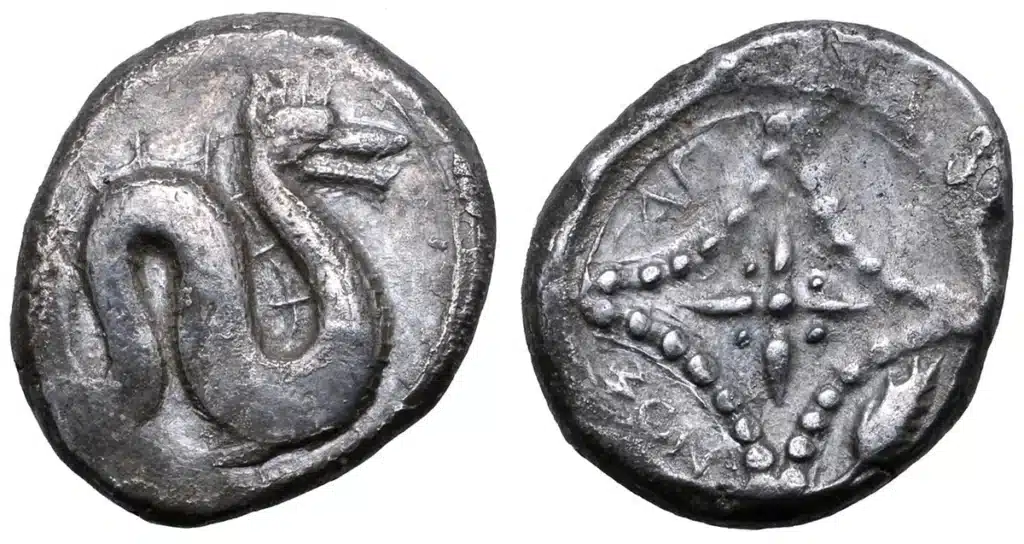
At about the same time, small silver fractions were struck, some with the forepart of the winged horse Pegasos on the obverse and the forepart of a goat on the reverse (Figure 3). The city ethnic of ALI is on the reverse. The early versions of this coin type were as crude as the Ketos type, though they quickly improved in quality and artistry. Other small fractions had a ram’s head obverse and either Apollo’s head, a young female’s head, or a lion’s head reverse. These continued to be minted well into the fourth century.

There was no change to the coinage until the beginning of the fourth century when Halikarnassos began minting very attractive tetradrachms, drachms, and hemidrachms with Apollo facing slightly right on the obverse and an eagle spreading its wings in an incuse square on the reverse (Figure 4). The city’s/people’s name of AΛIKAPNAΣΣEΩN is shown around the eagle. This coin is probably based on civic and Rhodian coinage and is in marked contrast to earlier coins, which were not artistically appealing. The city must have hired gifted celators (artisans who engraved coin dies) or had them minted elsewhere. The city’s first bronze coins started to be minted at this time.
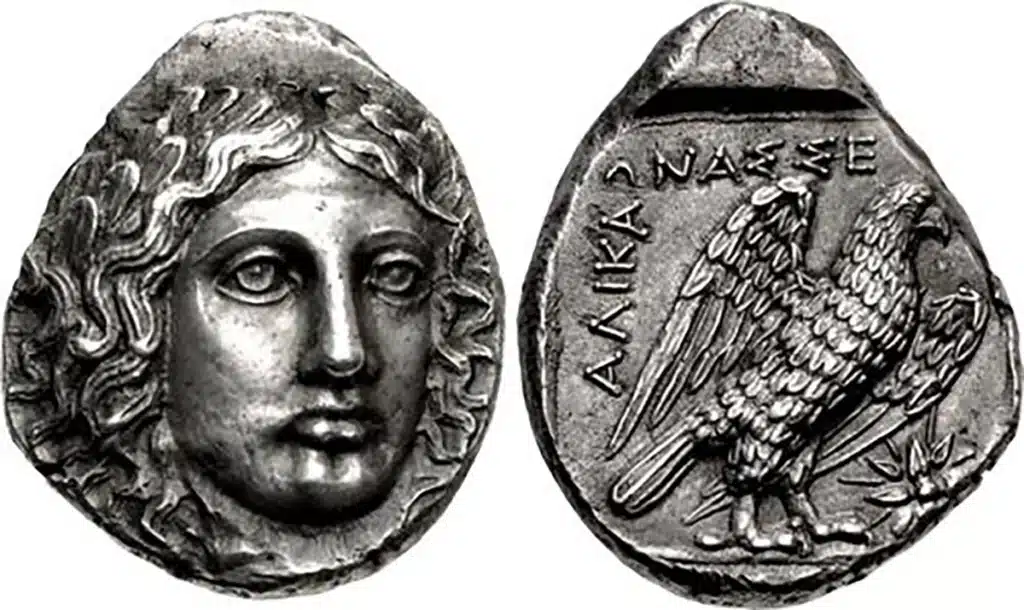
In the fourth century, the satraps of Caria, including Mausolos, Hidrieus, Pixodaros, and Orontobates, began minting tetradrachms and didrachms similar to the type shown in Figure 4. The difference is that these coins had Zeus Labraundos standing right holding a staff on the reverse instead of the eagle (Figure 5). The name of the satrap is also on the reverse. They are of the same high quality as the previous coin. The didrachms are fairly common, but the tetradrachms are rare, with only a handful known. In addition to the silver coins, the satraps also minted gold staters. Two of the known examples are a hemistater (4.25 grams) with Apollo’s head facing right and the same reverse as Figure 5 and a 1/24 stater (0.34 grams) with Apollo facing left obverse and a labrys (double-bladed axe) reverse.

Alexander’s siege ended the dynasts of Caria, and the city retained the right to mint bronze coins. There was a large variety of types, some of which were based on the silver coin types. Very few coins were struck until the second century when Halikarnassos came under Rhodian control (c. 188-166). Then the city produced silver drachms of 4.21 grams, as well as some fractions like the hemidrachm and trihemiobol. Examples of the types were Helios facing forward/bust of Athena; the head of Apollo/lyre; and the bust of Athena/owl. Figure 6 shows an example of the hemidrachm.
The silver coins and bronze coins continued to be produced until the middle of the first century.
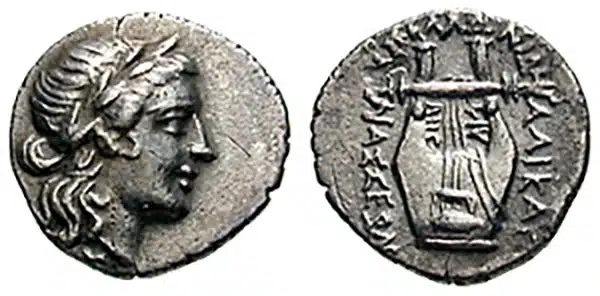
Coins of Knidos
Knidos was located on the coast of Caria opposite the islands of Nisyros and Telos. It was built partially on the island of Triopion and connected to the mainland by a causeway, which formed two harbors, one military and one commercial. The island was settled by Spartans in the first millennium and later by Argives (people from Argos), and the city was built on a series of terraces rising to an acropolis. The Temple of Apollo near Knidos was the site of the Dorian Games. Also, temples to Poseidon, Artemis Hyakinthotropos (the patron goddess), and Aphrodite Euploia were located there. The later deity was likely inherited from the Phoenicians and was much older than the others, with the goddess appearing on most of the city’s coinage.
Knidos also had a council chamber, a stadium, a theater, and a portico. It produced wine, onions, medicinal oils, and reeds for pens, and accumulated enough wealth to colonize the island of Lipara (north of Sicily) and the city of Kokyra Nigra (in the Adriatic Sea). It submitted to Persia after 546, joined the Delian League after 479, and revolted against the League in 412. The city’s oligarchy was replaced by a democracy in the fourth century, but after Alexander the Great’s death Knidos came under Ptolemaic control. It was under Ptolemaic rule that the architect Sostratus of Knidos designed and completed the Lighthouse at Alexandria. The city came under Rhodian control in the early second century, and then under Roman control around 129.
Most of the coinage of Knidos has the head of a roaring lion on the obverse and the head of Aphrodite on the reverse (see Figure 7). The minting of drachms of about six grams (Aeginetic standard) began about 520 BCE, with the head of Aphrodite appearing archaic. Later into the fifth century, the head became more classical, and the city ethnic K-N-I was added to the reverse. The silver fractions, such as diobols, obols, etc., were first minted in the fourth century and used the same classical style.

Around 400, Knidos adopted the Rhodian standard of 3.9 grams per drachm. Between 394 and 390, Knidos was a member of a Federation with the cities of Iasos, Rhodes, Samos, Ephesos, and Byzantion and minted tridrachms of 10.9 grams to match the group. Figure 8 shows Knidos’ federal coinage, which has an obverse of baby Herakles killing two snakes and a reverse of Aphrodite facing right. The obverse has the legend SUN (“Federation”) and the reverse has the city ethnic KNIDIWN.

In about 390, the city began minting very beautiful tetradrachms (15 grams), didrachms, drachms, and hemidrachms with Aphrodite on the obverse and the head of a lion on the reverse (see Figure 9). A magistrate’s name could appear on the reverse along with the ethnic KNI. This type was continued into the third century. A hemidrachm was also produced that had Aphrodite on the obverse and a bull’s head facing on the reverse. In the mid-third century, the tetrobols and hemidrachms were changed to have Artemis on the obverse and a tripod on the reverse (see Figure 10).


In the latter part of the third century, Knidos produced a series of tetradrachms that reproduced the Alexander the Great type, with the head of Herakles on the obverse and Zeus seated on the reverse. The coins had a prow and EY on the reverse. Under Rhodian rule (210-185), the city minted didrachms with the head of Rhodian Helios facing three-quarters on the obverse and a reverse with the forepart of a lion with either a rose, an ear of grain, a star, a cap, a club, or a bug, etc. The city name, KNIΔION, is above and a magistrate’s name is below the lion.
The silver coinage ended about the time the city came under Roman control in the latter third of the second century. Knidos also minted bronze coins starting in the third century, and these include many types, regrettably too many to cover here.
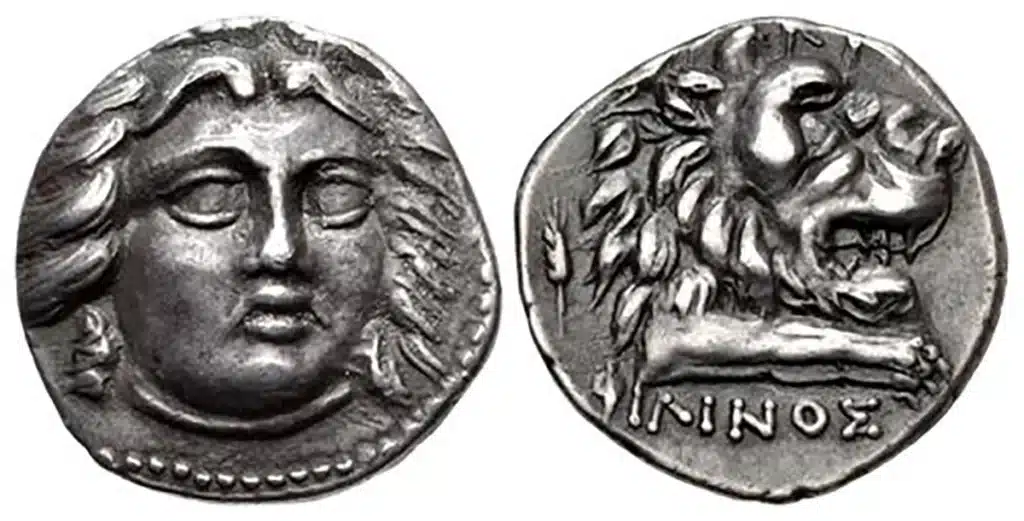
Comments
There are many coins in this article that are very rare, beautiful, and expensive, especially the multi-drachm coins (Figures 4, 5, 9, and 11) and some drachms (Figure 8). But for collectors of more modest means, most of the smaller silver fraction can be obtained at reasonable prices. The early Ketos silver coins of Halikarnassos are crude but intriguing because there aren’t many sea monsters on Greek coins (or any coins). I believe they warrant more careful study. Even though I did not cover them, there is a wide variety of inexpensive bronze coins from both these cities.
* * *
Reference
Classical Numismatic Group (CNG)
Grant, Michael. A Guide to the Ancient World: A Dictionary of Classical Place Names. Barnes and Noble (1986)
Head, Barclay V. Historia Numorum: A Manual of Greek Numismatics. Oxford (1887)
Hoover, Oliver. Handbook of Coins of the Islands, Vol 6. Lancaster/London: Classical Numismatic Group, Inc. (2010)
Hornblower, Simon, and Antony Spawforth, ed. The Oxford Classical Dictionary, 3rd edition. Oxford (1996)
Sear, David. Greek Coins and Their Values, Vol 2: Asia. B.A. Seaby Ltd. (1979)
* * *
The post Coinage of the Dorian Cities of Halikarnassos and Knidos appeared first on CoinWeek: Rare Coin, Currency, and Bullion News for Collectors.
Choice Leopold I 5 Ducats Gold Coin Among Highlights at Atlas Numismatics
Out of 409 new coins and medals for your consideration this month, Atlas Numismatics presents five spectacular examples below. We hope that you may find something of interest for your collection and look forward to hearing from you if have any questions.
Atlas Numismatics remains actively interested in purchasing individual items and whole collections if you are considering selling your coins or medals. We would be happy to assist with shipping and insurance should your items merit further inspection. Please contact us if you have rare or exceptional ancient, world, or United States coins for sale; click the following links for more information on Appraisals and Selling to Atlas.
Please contact us with any offers or other inquiries by sending an email to info@atlasnumismatics.com.
Click on the headers below to learn more about these exceptional coins.
Choice Leopold I 5 Ducats

1076561 | AUSTRIA. Leopold I. (Holy Roman emperor, 1657-1705). 1661 ca AV 5 Ducats. NGC MS63. Vienna. 17.4gm. LEOPOLDVS DG R…. Laureate bust right / ARCHD · AVS · D · BVR · COM · TIRO. Crowned imperial eagle. KM A1203; Fr.-262.; Herinek 85.
Ex Millennia Collection – Lot 486; Ex Goldberg’s Auction 59 (30 May 2010) Lot 2614. This coin was also illustrated in the book Money of the World (Coin #96).
Exceptional Valens Solidus
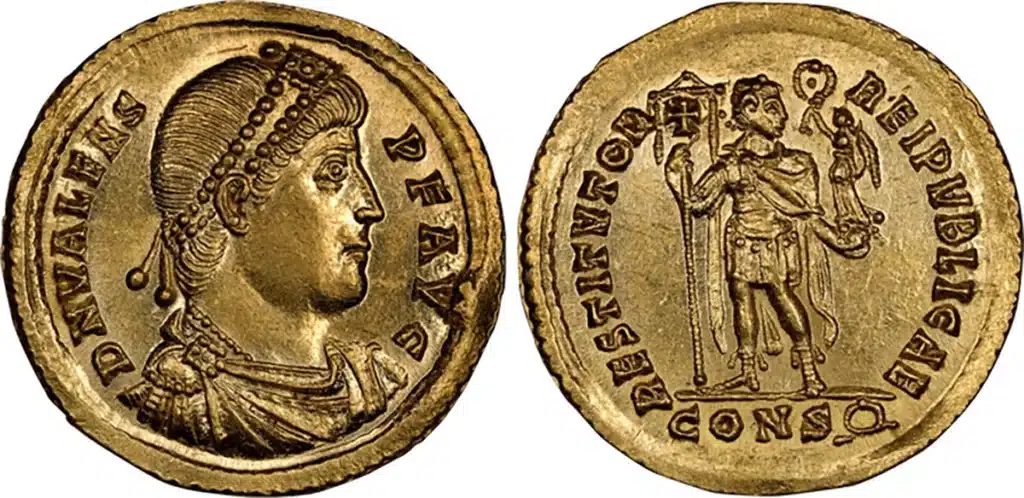
1076406 | BYZANTINE. Valens. (Emperor, 364-378 CE). Struck 367 CE. AV Solidus. NGC MS✭ (Mint State ✭) Strike 5/5 Surface 4/5. Constantinople Mint. 4.37gm. D NVALENS – DFAVC. Pearl-diademed, draped, and cuirassed bust, right / RESTITVTOR – REIPVBLICAE. Valens standing left, head ro right, holding labarum with cross and crowning victoriola; CONS (wreath) in exergue. RIC-3D.2; Depeyrot-20/2.
Ex North American Collection, CNG – Triton XI (January 2008) Lot 1009. Includes old auction ticket.
Proof 2 Rigsdaler

1076337 | DENMARK. Christian IX. 1863 HC-RH//FK AR 2 Rigsdaler. PCGS PR65. Copenhagen. Head right / Head right. KM 770; Dav.-78; Hede.-3; Sieg.-4.
Frederik VII Death and Accession of Christian IX.
Ex Mark and Lottie Salton Collection. Includes original collector’s envelope.
Lovely Pisa Grosso

1076342 | ITALIAN STATES. Pisa. Federico I. (Repubblica di Pisa, 1155-1312). (1155-1312) ND AR Grosso. NGC MS63. 1.67gm. +IMPERATOR•. Two flowers to either side of “F” monogram / +S MAR• D’ PISIS. Madonna and child; star to left; all within inner circle. Biaggi 1933; MIR 394/4.
Struck in the name of Frederick I. Currently one finest known at NGC as of October 2023
Ex Mark and Lottie Salton Collection. Includes original collector’s envelope.
Mint State 1895 Manila Medal
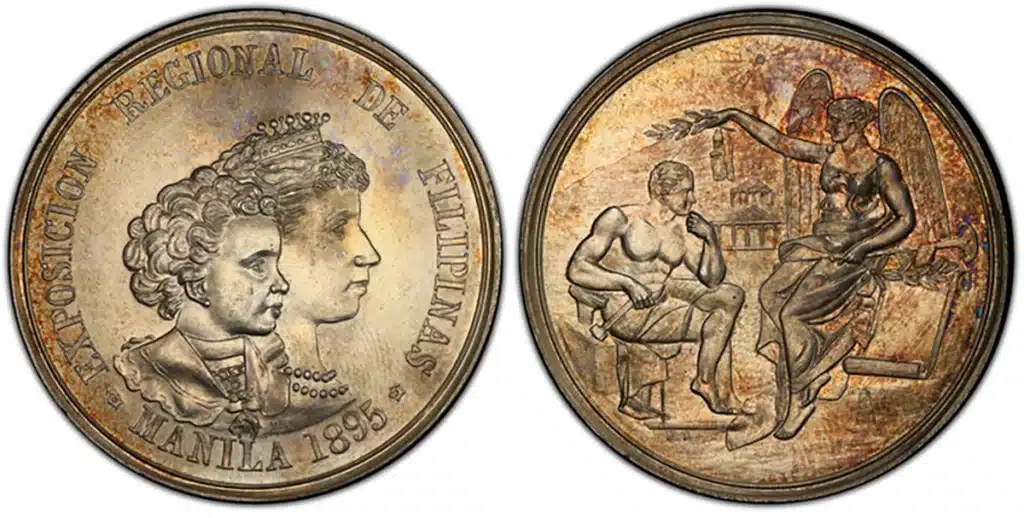
1076357 | SPAIN. Philippines. Isabella II & Alfonso XII. 1895 AR Medal. PCGS MS61. By Melecio Figueroa. Edge: Plain. 40mm. 37.55gm. EXPOSICION REGIONAL DE FILIPINAS// *MANILA 1895*. Conjoined busts of the Queen and the young King, right; signed M.F. below / Allegorical figure of Progress crowning a seated man with a laurel; exhibition center in background. Honeycutt 37; Basso.-714.
For the 1895 regional Expo at Manilla.
* * *
Atlas Numismatics – Appraisal and Buying
Atlas Numismatics is actively buying individual items like the Leopold I 5 Ducats gold coin and other world coin highlights seen above, as well as whole collections. Please contact us if you have rare or exceptional ancient, United States, or world coins for sale; click here for more information.
The post Choice Leopold I 5 Ducats Gold Coin Among Highlights at Atlas Numismatics appeared first on CoinWeek: Rare Coin, Currency, and Bullion News for Collectors.
Feds, States Get Order Against Safeguard Metals for Elderly Fraud
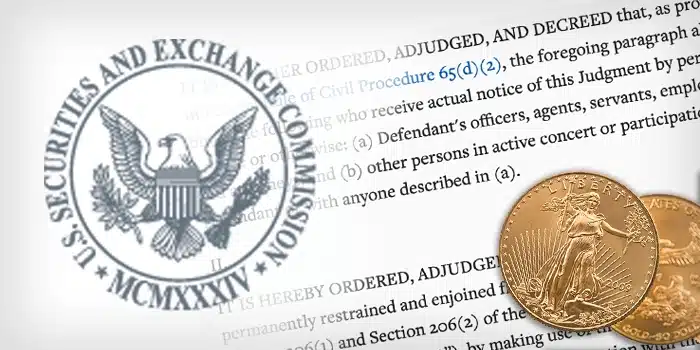
On Wednesday, October 25, 2023, the Commodity Futures Trading Commission (CFTC) and 30 state securities regulatory agencies that are members of the North American Securities Administrators Association (NASAA) announced the entry of a consent order in the U.S. District Court for the Central District of California against Safeguard Metals LLC and Jeffrey Ikahn (formerly Jeffrey Santulan a/k/a Jeffrey Hill), finding them liable for operating a nationwide $68 million USD fraudulent scheme involving the sale of overpriced silver coins that targeted the elderly and retirement-aged people.
In addition to finding the defendants liable for fraud, the order enjoins them from future violations of the Commodity Exchange Act (CEA) and CFTC regulations, as charged; future violations of state laws and regulations, as charged; and from trading or registering with the CFTC and the states in this action. The order further reserves determination of the amounts of restitution, disgorgement, and civil monetary penalty for future decision by the court or by consent.
“The defendants targeted elderly victims to liquidate their retirement savings to invest in a precious metals scam,” said Director of Enforcement Ian McGinley. “Working closely with the 30 state co-plaintiffs, this resolution as to liability is a critical step in addressing the defendants’ fraud.”
Precious Metals Fraud Case Background
The order finds Safeguard Metals and Ikahn executed a nationwide fraud, from approximately October 2017 through at least July 2021, in which the defendants solicited and received approximately $68 million in investor funds. The majority of the funds were retirement savings solicited from approximately 450 people to purchase precious metals, primarily silver coins.
The order finds the defendants’ fraudulent scheme involved deceiving customers into purchasing precious metals through false and misleading statements, including about the risk and safety of their investments in traditional retirement accounts. The defendants also deceived customers into purchasing silver coins at prices that included grossly inflated price markups that vastly exceeded the price markups disclosed to customers. For example, customers paid an average markup of 71% when the customer agreement stated the defendants would charge a maximum markup of 23% on silver coins. These excessive markups caused customers an immediate and substantial loss on their investment. Also, to disguise their fraudulent scheme, the defendants misled their customers about the true value of the silver coins they purchased.
Parallel Civil Action
In a parallel, separate action, on February 1, 2022, the Securities Exchange Commission (SEC) filed a civil action against Safeguard Metals and Ikahn for violations arising from the fraudulent precious metals scheme and fraudulently overpriced silver coins, and for rendering unlawful investment advice. SEC v. Safeguard Metals, Case No. 2:22-cv-00693 JFW (C.D. Cal. Feb. 1, 2022). On June 14, the SEC entered a similar consent order with the defendants where they admitted liability. The consent order enjoined them from further violations, and allowed the amount of disgorgement and civil monetary penalty to be determined at a later date.
The CFTC and NASAA thank and acknowledge the assistance of the SEC.
* * * * * *
CFTC’s Precious Metals Customer Fraud Advisory
The CFTC has issued several customer protection Fraud Advisories that provide the warning signs of fraud, including the Precious Metals Fraud Advisory, which alerts customers to precious metals fraud and lists simple ways to spot precious metals scams.
The CFTC also strongly urges the public to verify a company’s registration with the CFTC before committing funds. If unregistered, a customer should be wary of providing funds to that entity. A company’s registration status can be found at NFA BASIC.
Customers and other individuals can report suspicious activities or information, such as possible violations of commodity trading laws, to the Division of Enforcement via a toll-free hotline 866-FON-CFTC (866-366-2382), file a tip or complaint online, or contact the Whistleblower Office. Whistleblowers are eligible to receive between 10% and 30% of the monetary sanctions collected paid from the Customer Protection Fund financed through monetary sanctions paid to the CFTC by violators of the CEA.
NASAA’s Precious Metals Investor Advisory
NASAA and its members have issued a series of investor advisories, including an advisory on matters to consider before making gold-related investments.
Investors should also contact their state or provincial securities regulator with questions about any investment opportunity or the person offering it for sale before investing in the product. For contact information, visit the NASAA website here.
The post Feds, States Get Order Against Safeguard Metals for Elderly Fraud appeared first on CoinWeek: Rare Coin, Currency, and Bullion News for Collectors.
Gold, Silver and Other Precious Metals Decline in Start to November
At the start of the new trading month of November, prices for precious metals declined, with losses ranging from 0
Ten Worst 50 State Quarter Designs
By Tyler Rossi for CoinWeek …..
The 50 State Quarter Program, which ran from 1999 through 2008, was a wildly popular circulating commemorative program that was responsible for introducing a whole generation of new collectors to the hobby we love. Each year of the program saw the release of five new reverse designs, issued in the order that each state entered the Union. Replacing the beloved Heraldic Eagle found on the reverse of the Washington quarter since its debut in 1932 (with the exception of the Bicentennial quarter, an inspiration for this program), the 50 State Quarter reverse designs were supposed to be emblematic of the states they represented and convey something of its cultural, natural, and historic legacy.
But out of 50 coins over 10 years, some were more successful at this than others.
Of course, no list of the 10 worst of anything is going to be truly objective. And “worst” doesn’t necessarily mean “bad”, either, since in the case of the 50 State Quarters, the modern United States Mint wasn’t going to allow truly bad artwork onto the coinage. Perhaps a state-mandated concept was less than thrilling ot throttled by bureacracy. Or maybe the idea was good but the execution left something to be desired.
However it happened, here are our picks for the top 10 worst State quarter designs.
Michigan (2004)

- 26th quarter in the series
- Designer: Unknown. Mint Engraver/Sculptor: Donna Weaver
Coming in at number one on our list is the 2004 Michigan quarter. The coin’s reverse design depicts a simple outline of all the great lakes surrounding a topographical representation of the state. This was chosen from a group of five similar designs, all of which were based on an outline of the state. All other proposed designs submitted to the Mint included elements that showcased the state’s cultural and natural contributions to our nation. While arguably a well laid out design that uses the available space to good effect, the overall look is quite boring. Also, by doing only an outline of the state and lakes, Michigan is implying that they have not given or produced anything of value to the United States.
Wyoming (2007)
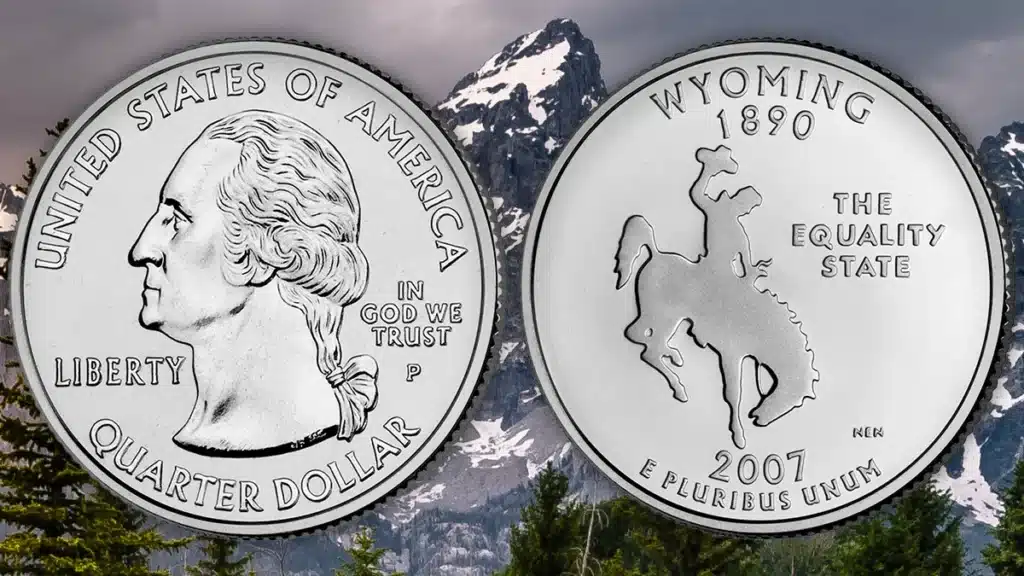
- 44th quarter in the series
- Designer: Donna Weaver. Mint Engraver/Sculptor: Norman E. Nemeth
As one of the most debated 50 State Quarter designs, the 2007 Wyoming quarter has been called ugly and unimaginative. The design consists of a simple cut-out shape of a cowboy riding a bucking bronco. While not certain, this design is believed to be based off of a 1903 photo of cowboy Guy Holt riding a horse named Steamboat. To the right is the state motto “The Equality State”, which it adopted because it was the first state to give women the right to vote. At the time, the federal Commission of Fine Arts (CFA) approved of the design as “powerful,” and the federal Citizens Coinage Advisory Committee (CCAC) stated the design was “authentic.” Nevertheless, once it was released, the general public didn’t like it.
Texas (2004)
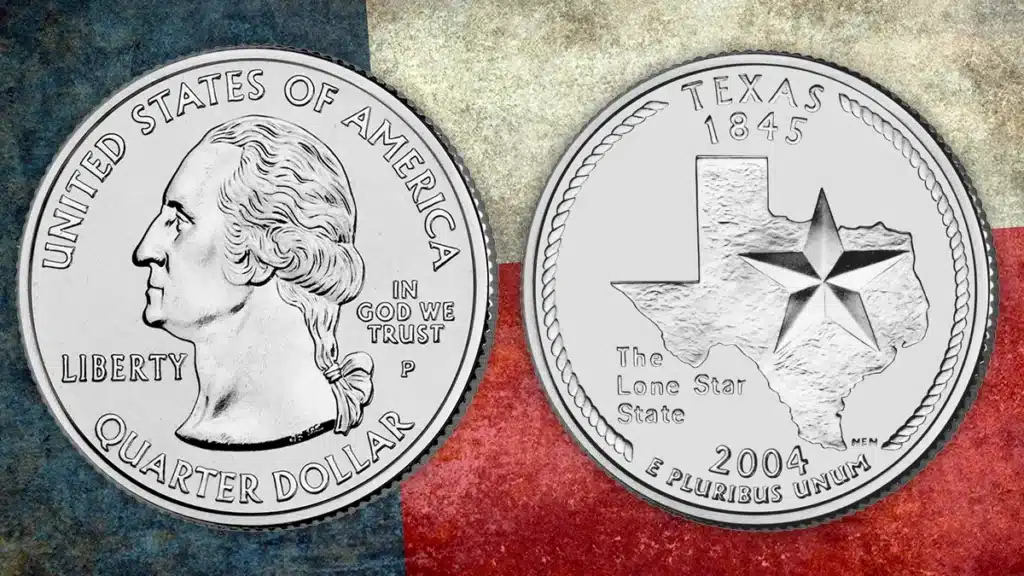
- 28th quarter in the series
- Designer: Daniel Miller. Mint Engraver/Sculptor: Norman E. Nemeth
Next is Texas. For such a large and important state, it’s a shame that they chose such an uninspired design. A simple depiction of the state with a five-pointed star superimposed over it does nothing to promote Texas on a national level. Only the stylized rope lariat border alludes to the “cowboy spirit” of the state.
Most of the early designs were much better; one even included a depiction of the Alamo within the state outline. One would expect that, out of the nearly 2,600 design concepts submitted, the Texas Numismatic Association could have selected a bolder, punchier, design.
Florida (2004)

- 27th quarter in the series
- Designer: Ralph Butler (design considerably and adversely edited by the Mint). Mint Engraver/Sculptor: T. James Ferrell
Also released in 2004, the Florida state quarter is a jumbled mishmash of design elements. While each of the three (a Spanish galleon, two Sabal palmetto trees, and a space shuttle) are well rendered individually, they do not unite in a cohesive design. Also, the significant amount of empty field, especially in the center of the coin, is slightly disconcerting.
Earlier design candidates were objectively more beautiful and did a better job promoting the state’s natural and cultural history. Unfortunatly, this was the design chosen in a three-week public vote from between a total of five options: “The Everglades”; “Fishing Capital of the World”; “St. Augustine”; “America’s Spaceport”; and the winning design “Gateway to Discovery”.
Massachusetts (2000)
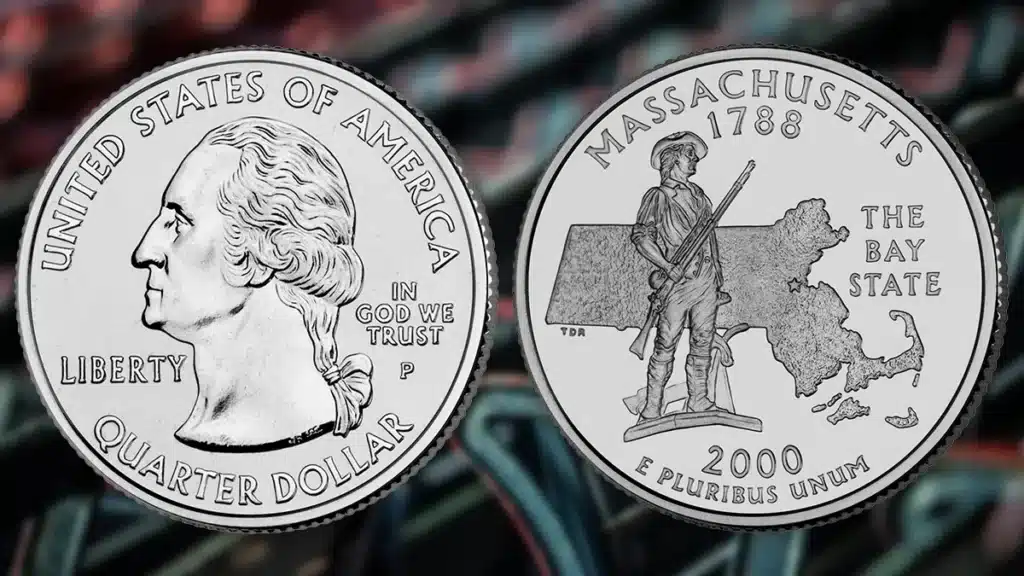
- Sixth quarter in the series
- Designer: Two schoolchildren. Mint Engraver/Sculptor: Thomas D. Rogers
Massachusetts is yet another 50 State quarter that uses an outline as one of the main design elements. Superimposed over this map is a depiction of The Minuteman, a statue that stands in front of The Minuteman National Historical Park in Concord. While this statue does accurately represent Massachusetts’s Revolutionary War history, I have to admit, there were many more appealing ways to convey the message. For example, one of the early design proposals featured a handsome representation of Old Ironsides (USS Constitution) under full sail. Launched in 1797, she is the oldest ship still afloat.
Maryland (2000)
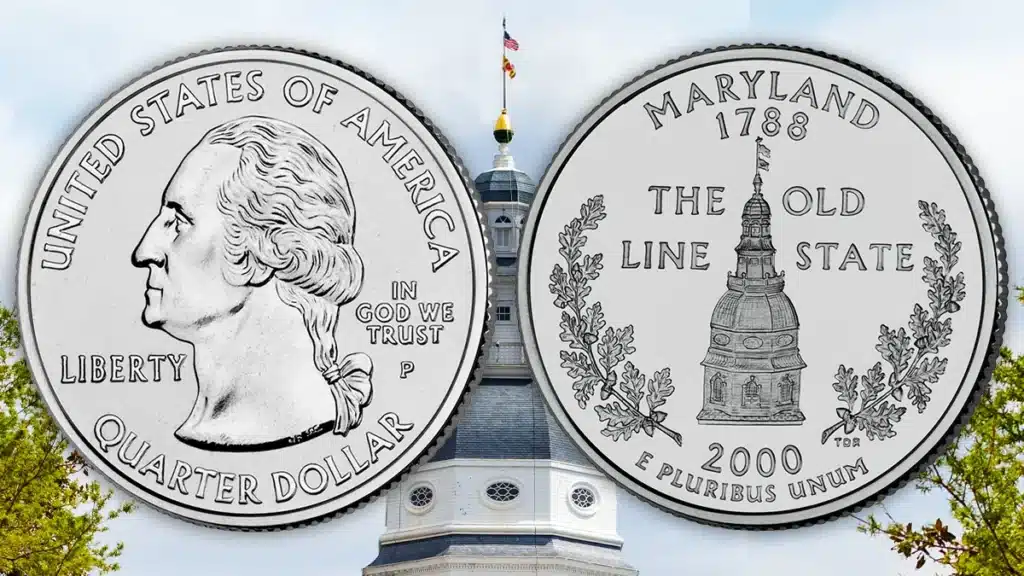
- Seventh quarter in the series
- Designer: Bill Krawczewicz. Mint Engraver/Sculptor:Thomas D. Rogers
Issued in 2000, Maryland chose to depict the statehouse tower on the reverse of its quarter. Not only is this a rather lazy representation of the state but it is also not even a very skillfully rendered depiction of the building in question. The official design is, if anything, too detailed. Interestingly, the draft version of this design, submitted as a proposal, was much more appealing. Additionally, while the oak is the state tree, why use oak branches as the second main design element? There are so many better, more interesting things to include. Overall, not the worst design, but it is one of the weakest when it comes to representing the state.
Wisconsin (2004)
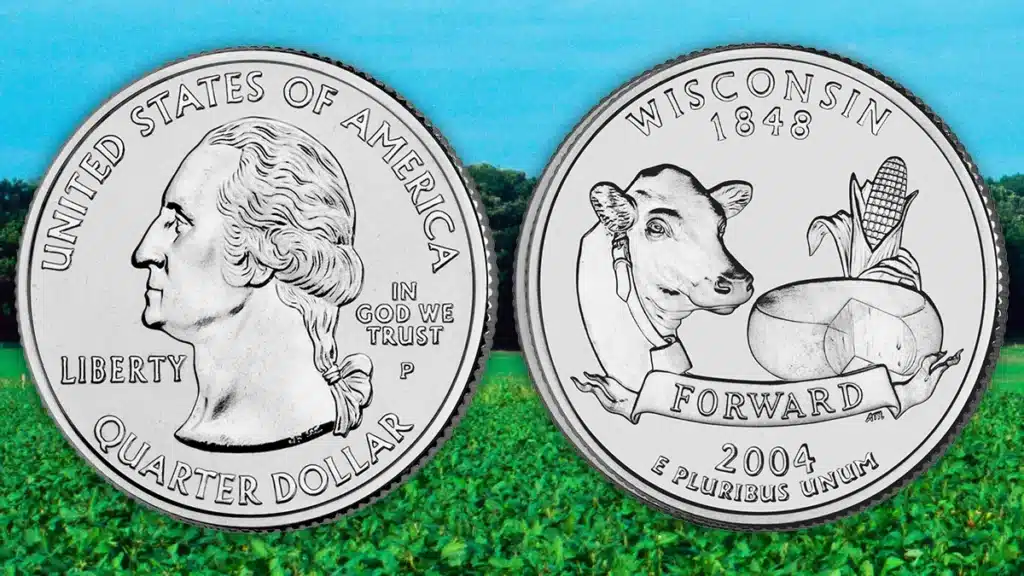
- 30th quarter in the series
- Designer: Rose Marty. Mint Engraver/Sculptor: Alfred Maletsky
While Wisconsin is called the “Dairy State” for good reason, does the state quarter really need to be all about cows and cheese? In a rather slapdash design, the coin depicts the head of a cow, a wheel of cheese, and an ear of corn.
This design was not actually supposed to be used. Instead, then-Governor Jim Doyle (D) scrapped the state panel’s choice: a handsome image of a Native American scout shaking hands with a fur trapper. Panel member Dean Amhaus, president of a Milwaukee-based tourism organization, lamented that this would only spur “more cheese head jokes.”
Idaho (2007)

- 43rd quarter in the series
- Designer: Don Everhart
Numismatic designs are all about proportions, and a skillful coin designer can fit almost any image onto the face of the planchet. The 2007 Idaho quarter, however, is not well proportioned. The design is dominated by a massive peregrine falcon ominously standing over a medium-sized outline of the state (again!), disrupting any balance in the composition. If either the state outline or the bird were smaller, it may have worked. As it stands, the outline is overshadowed by the bird, and almost looks to be an afterthought. To make matters worse, the level of detail employed in the falcon’s feathers stands at odds with the state’s outline and the rest of the empty fields. Also, if you squint, the position of the state makes it resemble an outstretched arm holding a gun to the bird’s head.
Earlier design proposals also did not have the best track record. Of the proposals, one even had the lyric “And here we have Idaho, winning her way to fame” taken from the state song.
New Mexico (2008)
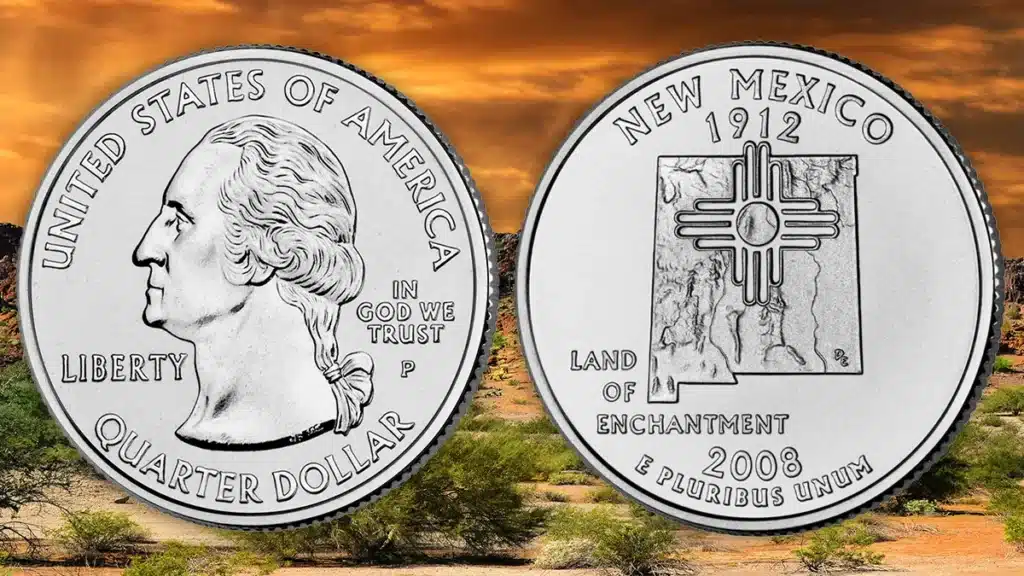
- 47th quarter in the series
- Designer: Don Everhart
Another uninspired design, the 2008 New Mexico 50 State quarter depicts the sacred sun symbol of the Zia people superimposed over a topographical map of the state. It may have been slightly better if instead of being placed off-center right below the state’s founding year (1912), the symbol were centered over the state map. Additionally, the state motto feels rather shoe-horned in at the bottom left of the design. While not outright ugly, the design is definitely uninspired.
Interestingly, unlike the other state quarters on this list, all four New Mexico quarter design finalists were quite similar, playing with a state outline and the Zia sun symbol.
Ohio (2002)
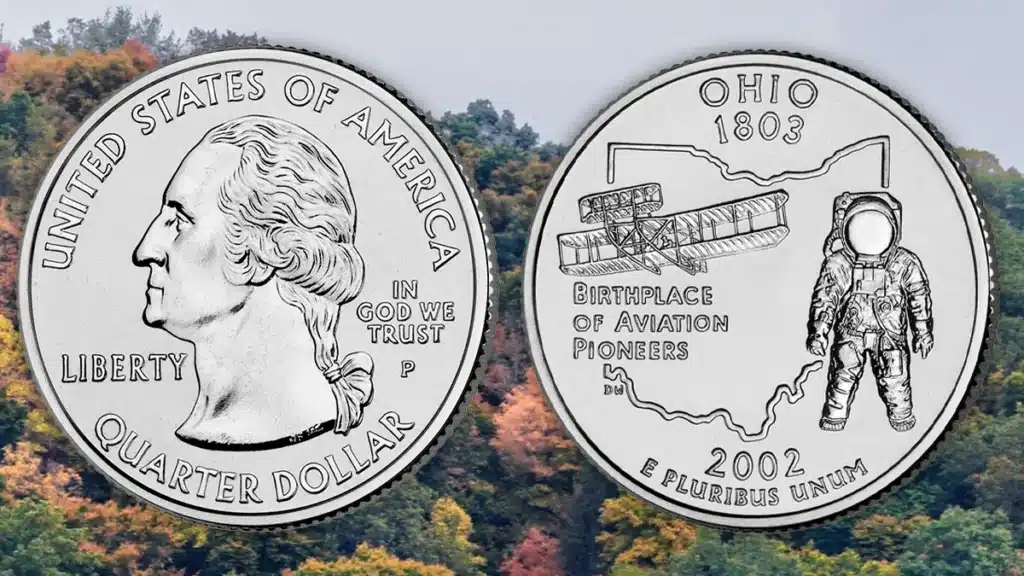
- 17th quarter in the series
- Designer: Unknown. Mint Engraver/Sculptor: Donna Weaver
Lastly, we have the 2002 Ohio state quarter. This design makes much of Ohio’s aviation history. The four major design elements are: the state outline (sigh), an astronaut, the Wright brothers’ plane, and the motto “Birthplace of Aviation Pioneers”. While this claim is true (Neil Armstrong, John Glenn, and Orville Wright were all born in Ohio), it doesn’t make for a good design theme. The reverse feels a bit disjointed, and while there is an overarching theme (aviation), it is not put together well. Like the Florida state quarter above, it’s just a jumble of mismatched elements.
Though it’s kind of cool that the astronaut looks like the old MTV logo.
* * *
The post Ten Worst 50 State Quarter Designs appeared first on CoinWeek: Rare Coin, Currency, and Bullion News for Collectors.
US Mint Sales: Tallchief Quarters and Innovation $1 Proof Set Debut
Last week, the U

Martha Washington and Experimental Coin Trials
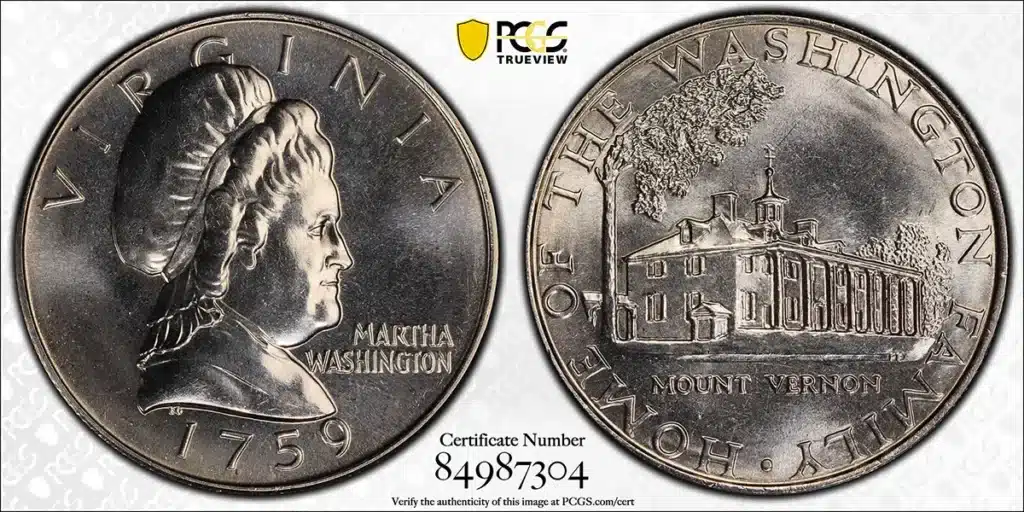
By Joshua McMorrow-Hernandez for PCGS ……
It’s not just the nation’s Founding Fathers who have appeared on our nation’s money. Some of our Founding Mothers have, too! And one of the most revered of these figures is none other than Martha Washington, whose husband George was the first president of the United States. Martha Washington was the first First Lady of the United States and pioneered this ambassadorial role as there was generally no precedent for the role, she being the first in a long line to come.
Martha Washington first appeared on the 1886 $1 Silver Certificate and was later memorialized on the 2007 $10 First Spouse Gold Coin. But her likeness is also seen on many pattern coins the United States Mint has produced since the mid-1960s.
These experimental coins utilize a bust of Martha Washington on the obverse. This helps the coins from being confused as legal tender circulating coinage (none of which she appears on) while closely approximating the design parameters of other circulating coins that showcase the heads of other famous Americans.
In the book United States Pattern Coins by J. Hewitt Judd, editor Q. David Bowers expounds on the point that the Martha Washington “fantasy designs were prepared with no relation to current coinage motifs, in the present instance to avoid creating ‘rarities’ by using regular dies.” While Martha Washington appears on the bust of these experimental pieces, Mount Vernon, the Virginia home of the Washingtons, is showcased on the reverse. The date “1759”, seen on the obverse of these patterns, refers to the year she married George Washington.
The Martha Washington patterns emerged around 1965, when the U.S. Mint began experimenting with copper-nickel clad compositions in the historic transition from striking 90% silver dimes, quarters, and half dollars with debased planchets. The Martha Washington patterns were also made in preparation for many other U.S. coins, including the creation of new dollar coinage in the late 1990s with the retirement of the denomination’s Susan B. Anthony design.
When available to collectors, many of these Martha Washington pattern coins are worth thousands of dollars. One of the most recent prices realized for one of these patterns is $15,600 USD, hammered for a 1965-vintage copper-nickel half dollar pattern minted graded PCGS MS67.
* * *
For more information from PCGS, click on the image below.
The post Martha Washington and Experimental Coin Trials appeared first on CoinWeek: Rare Coin, Currency, and Bullion News for Collectors.
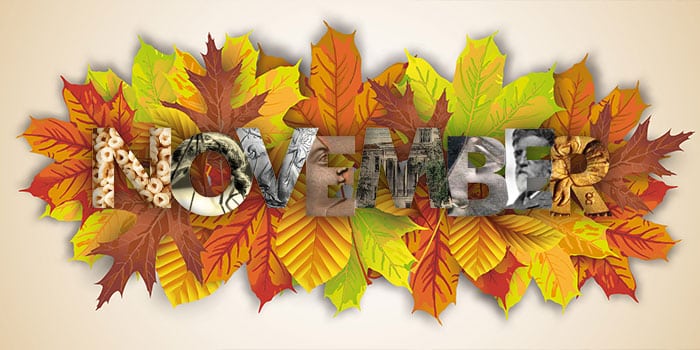
Big Things Happened at the United States Mint in November

By CoinWeek …..
November is a big month in United States Mint history. Yellow fever was a recurrent problem in the early years, costing the lives of the Mint’s first Chief Engraver and his wife. Massive shipments of copper planchets arrived at port, leading to the striking of some of the hobby’s biggest coins. Larger-than-life President Theodore Roosevelt worked feverishly to put into motion a plan to redesign America’s coinage to strike images more fitting of a newly minted world power. Purchasers of modern Proof sets saw the changing of the calendar as an opportunity to get their orders in… and much more.
November 1, 1797: After a two-month closure due to a yellow fever outbreak in the city, the United States Mint reopens.
November 1, 1799: After a two-month closure due to a yellow fever outbreak in the city, the Mint reopens.
November 1, 1799: Neil & Smith deposits $299.71 USD in cut dollars for coining into silver dollars. Paid out January 21, 1800.
November 1, 1803: After a two-month closure due to a yellow fever outbreak in the city, the Mint reopens. Do you see a recurring theme?
November 1, 1823: Chief Engraver Robert Scot dies.
 November 1, 1957: U.S. Mint begins to accept orders for 1958 Proof Sets. The first of November was the traditional date for the annual sets to go on sale during the modern period.
November 1, 1957: U.S. Mint begins to accept orders for 1958 Proof Sets. The first of November was the traditional date for the annual sets to go on sale during the modern period.
November 3, 1975: Mint begins to accept orders of 1976-dated Proof Sets. Issue price set at $7. Proof coins were produced at the San Francisco Assay Office.
November 5, 1891: Mint Director Leech selects his choice among William Barber’s submissions for the new half dollar design.
November 5, 2020: End of World War II 75th Anniversary gold and silver eagle goes on sale; sells out in under seven minutes.
November 6, 1906: Roosevelt writes to Saint-Gaudens and ponders if it would be possible to produce coins in high relief like the ancient Greeks.
November 7, 2019: United States Mint releases Reverse Proof version of the American Innovation coin honoring Delaware.

November 8, 1878: 50 Morgan dollar Proofs delivered. These possibly account for all of the seven-tail feathers Proofs of 1878.
November 10, 1860: South Carolina General Assembly calls for a Convention of the People to consider secession from the Union.
November 10, 1978: Congress passes legislation authorizing the production of the American Arts Gold Medallion program.
November 11, 1834: Secretary of State John Forsyth writes Mint Director Moore asking for two complete U.S. coin sets for Roberts’ diplomatic mission.
November 11, 1905: In a letter to President Theodore Roosevelt, Augustus Saint-Gaudens confirms his interest in participating in the artistic overhaul of American coinage. #petcrime.
November 11, 1918: Armistice signed, bringing about the end of World War I.
 November 12, 1794: 21,000 one-cent coins are delivered, after which copper coinage production was put on hold.
November 12, 1794: 21,000 one-cent coins are delivered, after which copper coinage production was put on hold.
November 13, 1793: After being shut down by a deadly Yellow Fever outbreak that cost the lives of engraver Joseph Wright, his wife Sarah, and 5,000 Philadelphia residents, the Mint reopens.
November 13, 1798: After a three-month closure due to a yellow fever outbreak in the city, the Mint reopens.

November 13, 1815: All 635 half eagles struck in 1815 are delivered.
November 13, 1861: Pennsylvania minister M.R. Watkinson writes a letter to Treasury Secretary Salmon P. Chase suggesting that the Mint apply a motto to god on tits coins.
November 14, 1905: Roosevelt writes to Saint-Gaudens informing the artist that he was going to try to persuade the Mint to strike gold pieces with new designs and asked whether the artist could create attractive designs in medium relief.
November 15, 1938: Treasury orders new Jefferson nickels to be paid out to the general public.
November 17, 2016: United States Mint releases gold Walking Liberty half dollar commemorative bullion coin. Issue price $865.
November 18, 1799: Mint delivers 3,754 gold eagles, warrant 183 (Walter Breen believed that these were dated 1800). The Mint would deliver another 2,245 gold eagles on November 25.
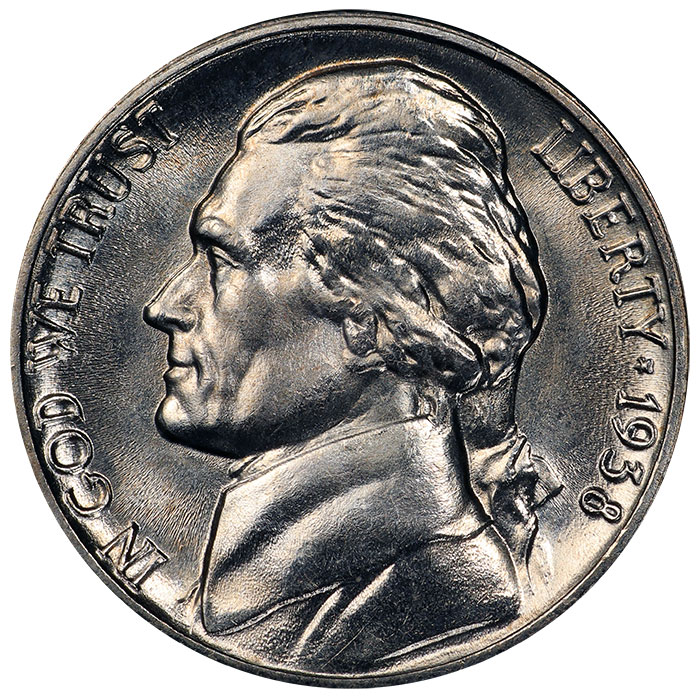 November 18, 1958: Frank Gasparro’s initial sketches for the new Lincoln cent reverse sent to the Commission of Fine Arts.
November 18, 1958: Frank Gasparro’s initial sketches for the new Lincoln cent reverse sent to the Commission of Fine Arts.
November 18, 1999: First Strike ceremony for the Sacagawea dollar held at the Philadelphia Mint. ANA President Robert Campbell, Anthony and Gloria Swiatek, David L. and Kathy Ganz, Harry Forman, Ruth Bauer, Treasurer Mary Ellen Withrow, Mint Director Philip Diehl, Designer Glenna Goodacre, Engraver Thomas D. Rogers, Sr., and coin model Randy’L Hedow Teton were in attendance.
November 19, 1830: Templeton Reid delivers five of his private issue gold coins for assay.
November 19, 1864: Ulysses S. Grant Medal design finished by Anthony Paquet and approved by designer John Antrobus.
November 21, 1871: Carson City Mint Superintendent Henry Rice orders 1872 dies from Philadelphia Mint. These dies, shipped in December, did not arrive until February 24, 1872, due to a blizzard.
November 22, 1837: Appointed Chief coiner of the New Orleans Mint, Rufus Tyler leaves Philadelphia for his new post in New Orleans.
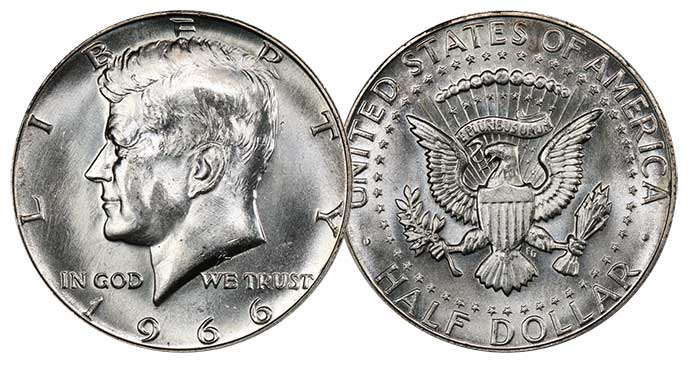
November 22, 1963: President John F. Kennedy is assassinated in Dallas, Texas.
November 23, 1868: Construction of the Carson City Mint is completed.
November 23, 1921: Commission of Fine Arts opens a three-week competition to determine the design of the Peace dollar.
November 26, 1792: The Mint purchases 4,140 pounds of copper from Gustavus and Hugh Colhoun at a cost of $1,057.24.
November 27, 1795: U.S. Mint Assayer Albion Cox dies after suffering a massive stroke.
November 27, 1797: Dr. Benjamin Rush assumes the position of Mint Treasurer.

November 27, 1908: San Francisco Mint strikes first minor coinage in the branch mint’s history with the production of the 1908-S Indian Head Cent
November 28, 1792: President Washington’s personal secretary Tobias Lear informs Mint Director David Rittenhouse that the President had allocated the $5,000 for expenses and authorized Ambassador Thomas Pinckney to purchase $10,000 in copper in England. This copper was received in 1793, 1794.
Also in November
Early November 1792: President George Washington addresses Congress, saying, “There has also been a small beginning in the coinage of half dismes, the want of small coins in circulation calling the first attention to them.”
November 1793: Robert Scot named Chief Engraver.
November 1796: Mint purchases 1,900 pounds of Talbot, Allum & Lee tokens to serve as half cent planchets.
November 1879: Charles Barber finishes preparing dies for the Flowing Hair Stella $4 gold coin pattern.

November 1880: Mint Director Snowden writes to Philadelphia Mint Superintendent H.C. Burchard requesting that the remaining Stella coins held in reserve be sold to collectors for $15 each. Coins sent to legislators instead.
November 1916: The Denver Mint strikes the year’s entire mintage of 264,000 1916-D Mercury dimes.
November 1935: Mint produces 18,168,000 cents; 6,444,000 nickels; 8,613,000 dimes; 2,828,000 quarters; 1,948,000 Walking Liberty half dollars; 4,007 Boone half dollars; 11,001 Arkansas half dollars (5,501 and 5,500 at the branch mints); and 30,023 Texas Centennial half dollars.
November 1946: Iowa commemorative half dollars struck.

November 1985: The United States bans importation of Soviet gold and South African Krugerrands. This sets the stage for the government’s entrance into the bullion coin market in 1986.
November 1990: Congress authorizes the production of silver Proof Sets.
November 1999: The Mint ships one-cent coins and Sacagawea dollar coins (including patterns) to General Mills as part of their Cheerios promotion.
The post Big Things Happened at the United States Mint in November appeared first on CoinWeek: Rare Coin, Currency, and Bullion News for Collectors.
October Shines for Gold with 6.9% Gain, Silver Rises 2.2%
Most precious metals declined on Tuesday, but prices for most of them also registered significant gains in October
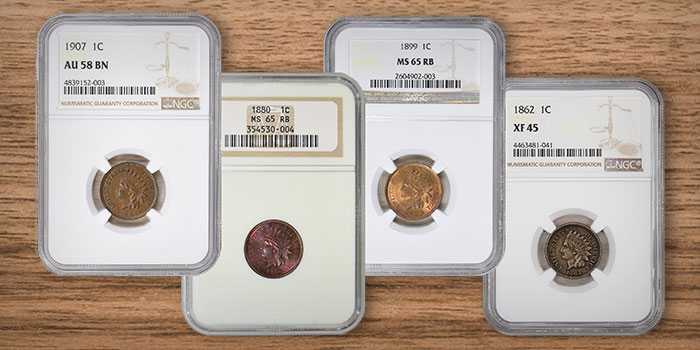
Indian Head Cent, Bronze (1864-1909) | CoinWeek

Why Was the Indian Head Cent Made in Bronze?
The Indian Head Cent saw its composition change from copper-nickel to bronze in 1864 due to the Mint’s efforts to produce a cheaper coin and get the coin to circulate in the northeastern states.
The small copper-nickel Indian Head “white” cent, so-called because of its lighter color in contrast to that of the older large cents, had at first escaped the hoarding of coins that came with the Civil War. But by 1862, in spite of the production of millions of pieces, the cent had also disappeared from circulation, joining the silver and gold coins already in hiding. In the absence of this federal coinage, entrepreneurs issued cent-sized bronze tokens, which were redeemable from their respective businesses. In 1864, the year of President Abraham Lincoln’s reelection and Union victories at Cold Harbor, Atlanta, and the Shenandoah Valley that changed the momentum of the war in favor of the North, the United States Mint revised the Indian Head cent, copying the look and feel of the popular and readily accepted private tokens.

This proved effective, as the public accepted the new cent, allowing the denomination to circulate much more freely.
The design of the 1864 Indian Head cent was basically the same as previous issues in the series, but the composition was changed from copper-nickel to a bronze alloy of copper, tin, and zinc. Though the copper content was seven per cent higher, the cent no longer contained expensive nickel, which had likely contributed to the hoarding of the early 1860s. Besides being less expensive to make, the bronze cent sans nickel was about a gram-and-a-half lighter, easier to strike, and darker in color due to the higher concentration of copper. Cents with both copper-nickel and bronze were produced in 1864, but nearly three times more of the new bronze cents were made. Only two issues of the series, the 1877 and the 1909-S, did production drop below one million coins, and in 1907 over 100 million pieces were produced.
The Bronze Indian Head Cent in the Modern Market
Thousands of business strike bronze Indian Head cents have been certified, usually with Red (RD), Red-Brown (RB), and Brown (BN) color designations, though very few are classified as prooflike. Prices are moderate for most dates up to near-Gem, but even Premium Gem and finer coins are relatively affordable for many dates. Most expensive are the 1873 Double LIBERTY, the 1877 (long considered a key date), and the 1888/7 overdate. The 1864 L On Ribbon, the 1869, the 1872, and the low-mintage 1908-S pieces are slightly more expensive than other issues.
 For Proof coins, prices are modest for lower-grade issues up to near-Gem grades, but as with circulation strikes, for some dates even Premium Gem and finer coins are relatively affordable. The “L On Ribbon” 1864 pieces are expensive in all grades, and very expensive as Gem or finer. A few 1860s issues are more expensive than other dates, and the key date 1877 Proof issue is considerably more expensive than all but the L On Ribbon examples in all grades. Cameo Proof coins have a modest price premium at lower grades that increases at higher grades.
For Proof coins, prices are modest for lower-grade issues up to near-Gem grades, but as with circulation strikes, for some dates even Premium Gem and finer coins are relatively affordable. The “L On Ribbon” 1864 pieces are expensive in all grades, and very expensive as Gem or finer. A few 1860s issues are more expensive than other dates, and the key date 1877 Proof issue is considerably more expensive than all but the L On Ribbon examples in all grades. Cameo Proof coins have a modest price premium at lower grades that increases at higher grades.
For both circulation and Proof coins, Red coins are more expensive than either Red-Brown or Brown, and Red-Brown coins more expensive than Brown examples.
In-Depth Bronze Indian Head Cent Date Analysis by CoinWeek IQ
There are also a few articles on counterfeit coin detection specific to the bronze Indian Head cent series, courtesy of NGC:
- NGC Counterfeit Coin Detection: 1867 Indian Head Cent
- 1875 Indian Head Cent
- 1877 Indian Head Cent
- 1908-S Counterfeit Indian Head Cent
Design
Lady Liberty’s face on the Indian Head cent is similar to the 1854 three dollar gold piece designed by U.S. Mint Chief Engraver James Barton Longacre, and also bears resemblance to both his 1849 gold dollar and 1849 double eagle Liberty portraits. Wearing a beaded necklace, Liberty faces left. On her head is a nine-feathered Indian war bonnet with a band displaying LIBERTY. Locks of hair drape down the back and one end of the diamond-patterned headband curls slightly to the front, with the other end somewhat hidden between the hair and the bottom feather. Early 1864 bronze cents had the rounded tip of the bust as on the copper-nickel issues, but later coins for 1864 and all subsequent years have a pointed bust tip and a small L (for Longacre, sometimes hard to see because of wear) in the lower part of the smaller ribbon to the back. The legend UNITED STATES follows along a denticled border to the left, and the legend OF AMERICA follows along the right. The date is at the bottom.
The reverse has a concentric two-part wreath inside a denticled rim, tied together at the bottom by a ribbon that also binds three arrows. The wreath is mostly composed of oak leaves with acorns, though another type of leaf is shown at the bottom on the left side. The top ends of the wreath separate to allow for the placement of a small Union shield, and the denomination ONE CENT is prominently displayed in the center of the flan. Bronze Indian Head cents, both circulation and Proof issues, were produced every year in Philadelphia and at San Francisco in 1908 and 1909; the S mintmark is located on the reverse, below the tie of the ribbon, and slightly off-center to the right.
The edge of the coin is plain or smooth, without reeding or edge lettering.
Varieties
Many Indian Head bronze cent varieties are known, including several date doublings or repunchings. Other important varieties include the 1864 No L On Ribbon; the 1865 Plain and Fancy 5; the 1873 Closed and Open 3, referring to the amount of space between the top and bottom extensions of the digit (the Closed 3 appearing at first glance to be an 8); the 1873 Doubled LIBERTY; the 1886 Type 1 and Type 2, distinguished by the placement of the lowest feather on the Indian’s headdress relative to letters C and A in AMERICA; and other variations of device style and placement.
Coin Specifications
| Indian Head Cent | |
| Years Of Issue: | 1864-1909 |
| Mintage (Circulation): | High – 108,137,143 (1907); Low – 309,000 (1909-S) |
| Mintage (Proof): | High – 6,609 (1883); Low – About 20 (1864 With L – approx. 150 Proofs were minted without the “L”; the combined 1864 mintage is the lowest for the type) |
| Alloy: | 95% copper, 5% tin and zinc |
| Weight: | 3.11 g |
| Diameter: | 19.00 mm |
| Edge: | Plain |
| OBV Designer | James Barton Longacre |
| REV Designer | James Barton Longacre |
* * *
References
Bowers, Q. David. The Experts Guide to Collecting & Investing in Rare Coins. Whitman Publishing.
–. A Guide Book of United States Type Coins. Whitman Publishing.
Breen, Walter. Walter Breen’s Encyclopedia of U.S. Coins. Doubleday.
Guth, Ron and Jeff Garrett. United States Coinage: A Study by Type. Whitman Publishing.
Snow, Richard. A Guide Book of Flying Eagle and Indian Head Cents. Whitman Publishing.
Taxay, Don. The U.S. Mint and Coinage. Arco Publishing.
Yeoman, R.S and Kenneth Bressett (editor). The Official Red Book: A Guide Book of United States Coins. Whitman Publishing.
The post Indian Head Cent, Bronze (1864-1909) | CoinWeek appeared first on CoinWeek: Rare Coin, Currency, and Bullion News for Collectors.
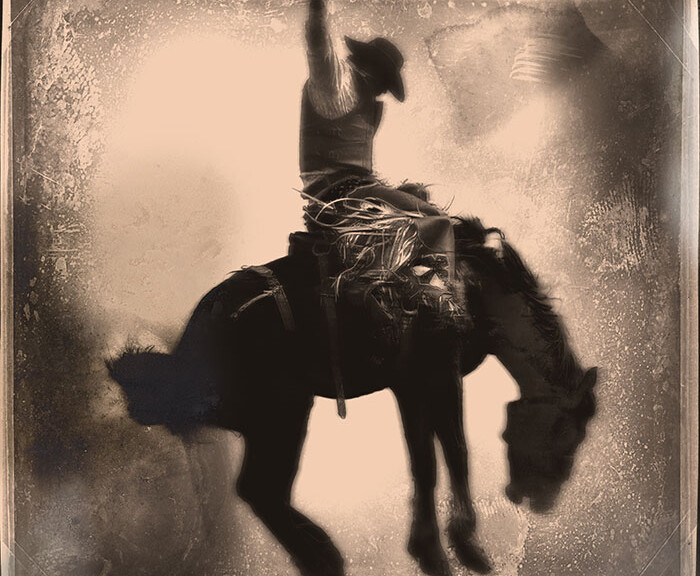
2007-P Wyoming State Quarter : A Collector’s Guide
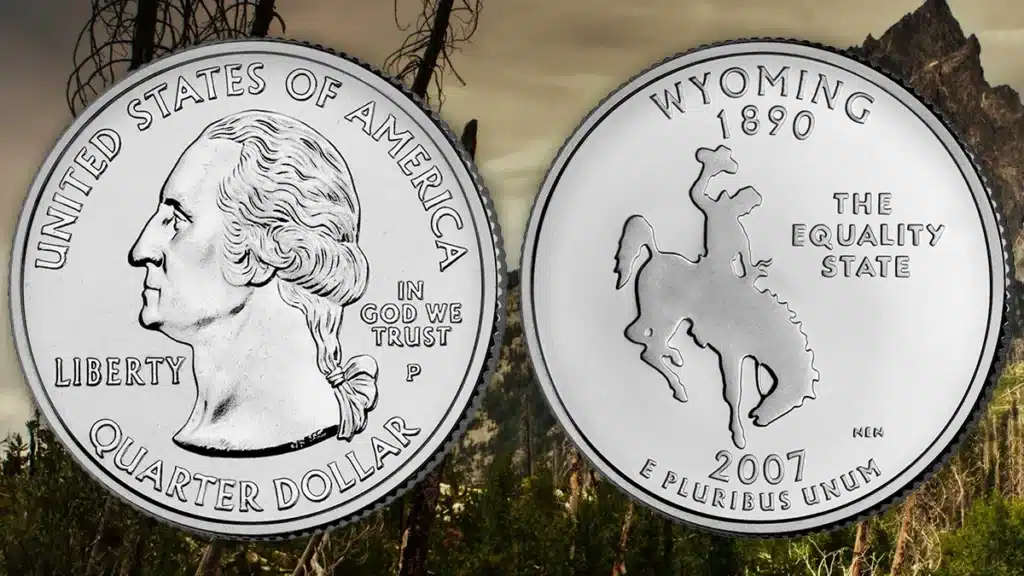
The 2007-P Wyoming State quarter was a circulating commemorative coin released to the public on September 4, 2007. The coin was the penultimate quarter issued in the program’s penultimate year and the 44th State Quarter issued overall. Although the Wyoming quarter was released late in the series, when public interest in the program had waned, the coin was one of the most representative of its state. Its simple, albeit polarizing, design was handled in-house by the United States Mint and features a silhouette design of a cowboy riding a bucking bronco.
An Iconic Image of the Equality State
Wyoming became a state on July 10, 1890. Elements of its state quarter’s design date to the 19th and early 20th centuries.
Wyoming’s nickname, “The Equality State”, refers to its having been the first territory or state to grant women the right to vote and hold public office in 1869. This nickname is prominently inscribed on the reverse.

The bucking horse and rider insignia can be traced back to World War I, when members of the Wyoming National Guard applied the logo to their equipment when stationed out of state or overseas. The University of Wyoming adopted the logo in 1921. It is thought to depict a horse named Steamboat being ridden by a cowboy named Guy Holt. The scene is the subject of a photo taken in 1903 that was used as the basis for the University of Wyoming’s logo. The State of Wyoming adopted the design for its license plates in 1936.
The 2007-P Wyoming Quarter’s Design Process
In 2004, Wyoming Governor Dave Freudenthal (D) appointed 13 historians and other experts to the Wyoming Coinage Advisory Committee, which solicited more than 3,200 submissions from the public. The committee first met in January 2005 and culled the thousands of submissions down to five design narratives submitted to the United States Mint.

Four of the five proposed designs for Wyoming’s state quarter featured the horse-and-rider motif. The fifth depicted Old Faithful, the geyser in Yellowstone National Park, which would eventually feature alongside a bison on Wyoming’s America the Beautiful quarter in 2010. An outline of the state and depictions of the Grand Tetons accompanied the rider on the other designs.
Designated WY-1 to WY-5, both the federal Commission of Fine Arts (CFA) and the federal Citizens Coinage Advisory Committee (CCAC) reviewed the proposals in early 2006, recommending different designs.
The CFA recommended WY-1, which depicted the horse and rider motif in silhouette, at its January 19, 2006 meeting. The CFA’s meeting minutes described the horse and rider motif as “powerful” and as appropriate an image as Old Faithful. The CFA’s letter did offer mild criticism: “[T]he state motto, ‘The Equality State,’ does not seem to have any relationship with the cowboy image and could be eliminated.”
At its January 24, 2006 meeting, the CCAC recommended the reverse design designated WY-4, explaining that “this theme –though conventional – was seen as authentic and successful.” The CCAC did express interest in the design recommended by the CFA with the cowboy and rider in silhouette, writing: “Members agreed that this could be an innovative quarter if such a difference in texture could be created.”
Ultimately, the design favored by the CCAC was selected. U.S. Mint Artistic Infusion Program artist Donna Weaver created the design and Norman E. Nemeth sculpted it.
The Wyoming Quarter Released to Great Fanfare
The coins were released on September 4, 2007, with a launch ceremony at the Cheyenne Civic Center featuring Mint Director Edmund C. Moy and Governor Freudenthal taking place on September 14. Native Americans attended the event, as did the University of Wyoming’s women’s basketball team, who helped hand the quarters out to schoolchildren in attendance. In his remarks at the event, Moy mentioned that Wyoming’s first female governor, Nellie Tayloe Ross, was also the first woman to serve as Director of the United States Mint. Ross’s grandson attended a striking ceremony at the Denver Mint in August 2007.

Examples of the quarters were sold at the event with commemorative cards, produced by Wyoming-based company UniCover Corp., for $2. The cards’ designs reflected some of the other themes considered for the quarters, including the Grand Tetons and Devil’s Tower.
Many applauded the design when it was announced and released.
Jack Rosenthal, chairman of the committee that selected the design, is quoted in a Billings Gazette article saying “contrary to what some people believe, there are times when the people of Wyoming agree with the folks back in Washington.” The same Billings Gazette article reported that the bucking horse had been suggested by “the Mint’s own guidelines for the state quarter series,” and that “nearly half of those who submitted ideas for the state quarter said they liked the bucking horse.”
Freudenthal apparently was pleased with the design, saying that it “Represented… both our proud Western heritage and our historical role in establishing equal voting rights for women… We will be very pleased to see this coin in circulation around the country.” He also said that he was “…amazed how many people collect them, and in fact, I’ve gotten to the point that I want to make sure that I collect them so that (First Lady Nancy Freudenthal) and I will have them available for our kids and hopefully at some point…”
In a September 2007 feature article published in The Numismatist, RyAnne Scott detailed the horse and rider image’s history, describing it as “a hallmark of the Cowboy State.”
The day after the quarter’s launch, Coin World received a report of the first circulation find from a collector in Virginia.
A 93-year-old collector in Powell, Wyoming, wanted to live long enough to see the quarter released, according to a piece by the Associated Press published in the Billings Gazette.
Design Controversy
Nevertheless, many numismatists don’t remember Wyoming’s state quarter quite as fondly.
An article published in the Jackson Hole Star-Tribune published a couple of weeks after the quarters were released directly contrasted Wyoming’s entry with the rest of the series, pointing out that its silhouetted, featureless design was a first among 50 State quarters. The piece quotes Dwight Brockman, who owned The Coin Shop in Cheyenne until his murder in 2015: “I think that was the biggest disappointment with the real numismatists, is there’s no detail in this thing… But the average person is probably pretty excited about it.”
Brockman shared his thoughts with the Billings Gazette around the same time: “The cowboy on this coin, it looks like a cookie. There’s not any detail on it.”
Since 2007, comments on discussion threads on a number of numismatic forums have trended negatively. Some collectors defend the design’s simplicity and historicity, while many criticize its flatness and a perceived lack of creativity. Its simplicity drew comparisons to the designs of the state quarters honoring Texas, Michigan, Idaho, and a few others.

A 2013 article published in the E-Sylum compared a Spanish coin commemorating Miguel de Cervantes to Wyoming’s state quarter, describing the latter’s design as a “horrible flat cowboy.”
In August 2016, Coin World included the 2007 Wyoming quarter in a feature article on “America’s Ugly Duckling Coins” describing the issue as “particularly ugly.” The piece compared its the simplicity of the design unfavorably with Michigan’s and quoted a number of prominent collectors, whose sentiments could be summarized by Nebraska collector Mitch Ernst, who said “I find the stark, plain, severe simplicity ugly and in my opinion, the design does not represent the grandeur of the state nor the strength of its people.”
How Many Wyoming State Quarters Were Struck by the Philadelphia Mint?
State Quarters were struck as circulating commemorative coins and distributed through the Federal Reserve banking system. From there, these coins were distributed to banks and then released to the public. Bank customers were able to purchase fresh rolls of coins from their local bank branches at face value.
In total, 243,600,000 Wyoming state quarters were struck at the Philadelphia Mint. This mintage is typical for State Quarters struck in the later part of the series. Economic conditions and the the projection for the level of the public’s collecting enthusiasm determined production levels. After the window of producing each design ran its course, the Mint would retire the design and begin production on the next quarter design.
A comparatively small number of coins were set aside to be sold at a premium through the United States Mint’s catalog and website in rolls and bags. There was no discernible difference between the quality of coins released to the public and the coins sold directly to collectors. Collectors may pay a slight premium for original rolls and bags in U.S. Mint packaging.
What is the 2007-P Wyoming State Quarter Worth?
2007-P Wyoming quarters found in change today will be heavily circulated and worth only 25 cents. Because large quantities of the coin were saved by collectors in uncirculated condition, these coins are of little interest to most coin collectors.
Coins that have not been circulated do command a premium over face value, however.
A review of October sales on eBay show an average price of $1.25 for uncirculated examples, while unopened original $10 rolls of 2007-P Wyoming State Quarters have sold for $20 or more.
Collecting professionally graded State Quarters was popular around the time of the coin’s release. In these instances, coins certified by either PCGS or NGC command a premium over and above what an uncertified coin might sell for in the open market. Most of the Wyoming quarters graded by one of the services would not be the circulation strike 2007-P Wyoming State Quarter, but instead the Proof-Only Silver or Proof-only Clad versions struck at the San Francisco Mint and sold in Proof Sets.
Graded uncirculated coins were sold as well, but the Mint’s decision to apply a Satin Finish to coins sold in its annual Uncirculated Sets complicates matters. Satin Finish coins were not struck using the same process as coins struck for circulation and will have a much more uniform and high-end appearance. They are also worth considerably less in high grade.
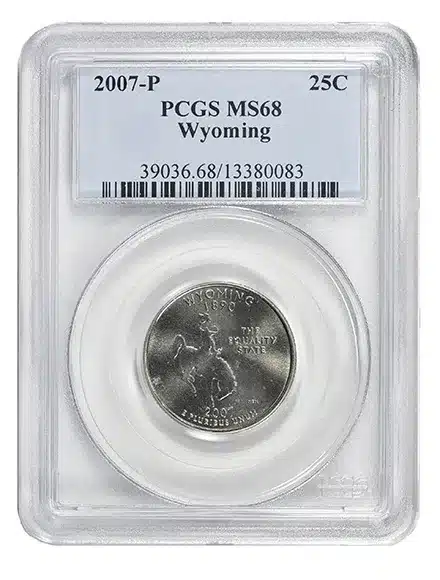
On January 4, 2017, a 2007-P Wyoming 50 State quarter certified MS-68 by PCGS from the Mile High Collection sold in a Heritage auction for $2,115 USD, the record price for the issue. A little more than a year later, on March 25, 2018, that same example sold on GreatCollections for $1,068.75.
The record price for a coin with the Satin Finish, $79, was realized on December 27, 2016.
At the time of current publication (October 2023), PCGS reports 298 grading events for 2007-P Wyoming state quarters (up 26 from September 2021) and 752 with the Satin Finish (up 6) and NGC reports 408 (up 10), 299 of which have the Mint Set’s satin finish.
Notable Varieties
The fifth edition of the Cherrypickers’ Guide to Rare Die Varieties of United States Coins (2012) lists three major doubled die reverse varieties: FS-25-2007P-WY801 through 803, all three of which display doubling on the saddle horn and 802 has the Satin Finish. PCGS has certified examples of all three. No varieties are recorded for the 2007-D.
Variety Vista lists 57 doubled die reverse varieties of the 2007-P Wyoming state quarter. One DDR variety is listed for 2007-D.
Non-numismatic news sources have taken some interest in varieties of the 2007-P Wyoming 50 State quarters. In September 2008, the Casper Star-Tribune reported on a variety with doubling on the saddle horn. The article quoted a number of coin dealers in Wyoming and Montana speculating on the potential value of varieties who didn’t think that demand for the variety would materialize. In 2020, an article published on the website of King 101.9 FM, a Cheyenne-area radio station, described a “pooping horse” quarter with a die break between Steamboat’s tail and backside resembling excrement.
Numerous minor varieties may not interest those plucking the quarters from circulation, but a dedicated variety specialist could challenge themselves with the three-variety Cherrypicker’s Guide set or attempt something more ambitious.
However uninspiring some numismatists found the simple though storied design, the 2007-P Wyoming state quarter is nonetheless a notable issue.
Design
Obverse:
The obverse of the 2007-P Wyoming quarter features a modified portrait of George Washington, a design by John Flanagan based on a 1786 plaster bust by French sculptor Jean-Antoine Houdon. Sculptor-engraver William Cousins designed the newer rendition of Washington, which was also used as the obverse design for the America the Beautiful Quarter series.
The 1999 redesign was necessary, in part, to accommodate new inscriptions on the obverse that previously were featured on the reverse of the quarter. These obverse inscriptions include UNITED STATES OF AMERICA in a semi-circular arrangement over Washington’s head; IN GOD WE TRUST to his right; LIBERTY to his left, below his chin; and QUARTER DOLLAR along the bottom side of the rim, under the president’s bust. The denomination QUARTER DOLLAR and the legend UNITED STATES OF AMERICA were previously located on the reverse of Washington quarters made from 1932 through 1998, but the inscriptions were relocated to the obverse to allow a wider reverse canvas area for the changing 50 State Quarters designs. The mintmark is seen to the right of Washington’s ponytail.
Reverse:
The central motif of the Wyoming state quarter reverse is the Bucking Horse and Rider logo, which is actually trademarked by the State of Wyoming. The state’s name WYOMING is inscribed clockwise at the center of the top of the side, and the year that Wyoming joined the Union–1890–is located immediately beneath that. The motto THE EQUALITY STATE is inscribed in three lines to the right of the horse and rider motif. Underneath the horse and rider, running counterclockwise, are the date 2007 and under it the national motto E PLURIBUS UNUM. Sculptor Norman E. Nemeth’s initials “NEN” are located to the right of the horse and rider near the bottom.
Edge:
The edge of the 2007-P Wyoming State Quarter is reeded, as are the edges of all Washington quarters.
Coin Specifications
| Country: | United States |
| Year Of Issue: | 2007 |
| Denomination: | 25 Cents |
| Mint Mark: | P (Philadelphia) |
| Mintage: | 243,600,000 |
| Alloy: | 75% copper, 25% nickel; 90% silver, 10% copper |
| Weight: | 5.67 grams |
| Diameter: | 24.30 mm |
| Edge | Reeded |
| OBV Designer | John Flanagan | William Cousins |
| REV Designer | Donna Weaver | Norman E. Nemeth |
| Quality: | Business Strike, Proof |
* * *
The post 2007-P Wyoming State Quarter : A Collector’s Guide appeared first on CoinWeek: Rare Coin, Currency, and Bullion News for Collectors.
Gold Scores 4th Gain and Tops $2,000/oz
Precious metals advanced at the start of the new trading week on Monday, registering gains ranging from 0
Rare U.S. Currency in Stack’s Bowers November 2023 Showcase Auction
Stack’s Bowers will be hosting its U.S. Currency Showcase Auction at Griffin Studios in Costa Mesa, California on November 17.
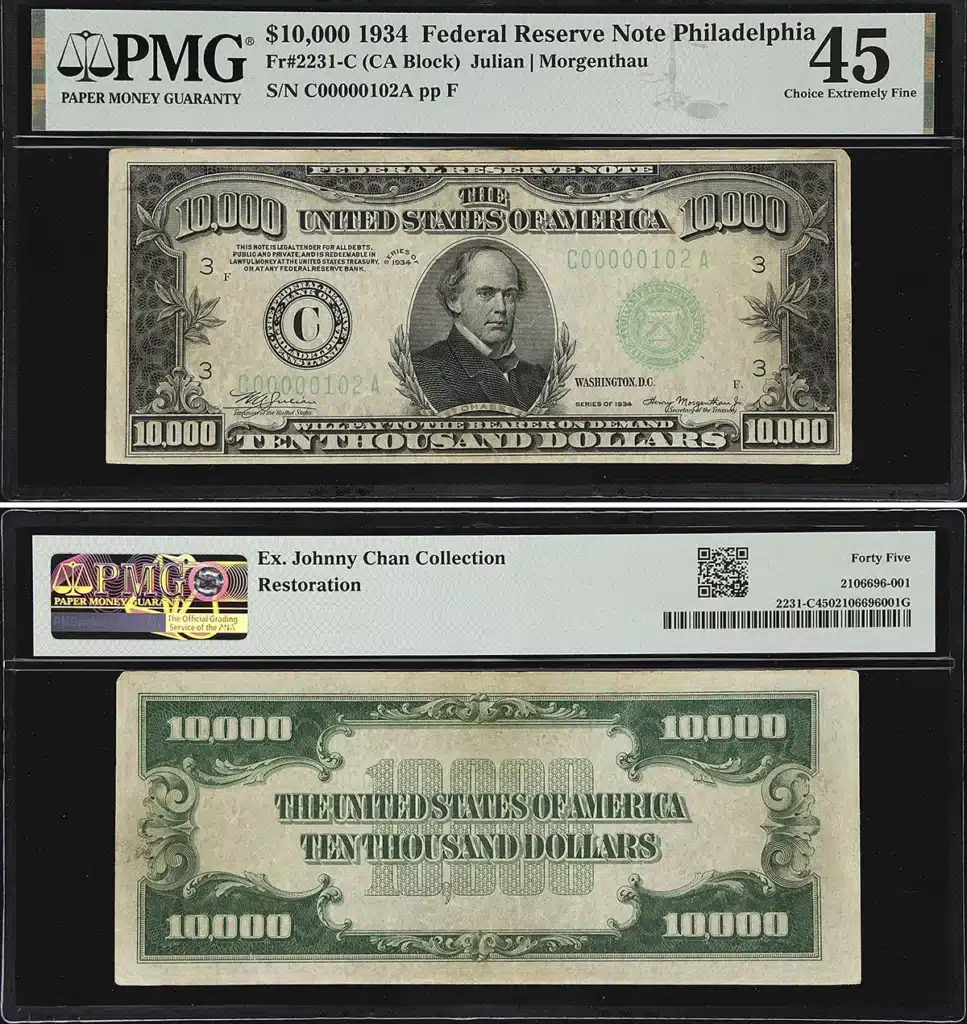
Among the highlights is Lot 20294, a 1934 $10,000 Federal Reserve Note, Fr. 2231-C graded PMG Choice Extremely Fine 45 from the Philadelphia district. This note is pedigreed to professional poker player Johnny Chan. Along similar lines, Lot 20293 is a 1934 $5,000 Federal Reserve Note, Fr. 2221-G graded PMG Choice Extremely Fine 45.
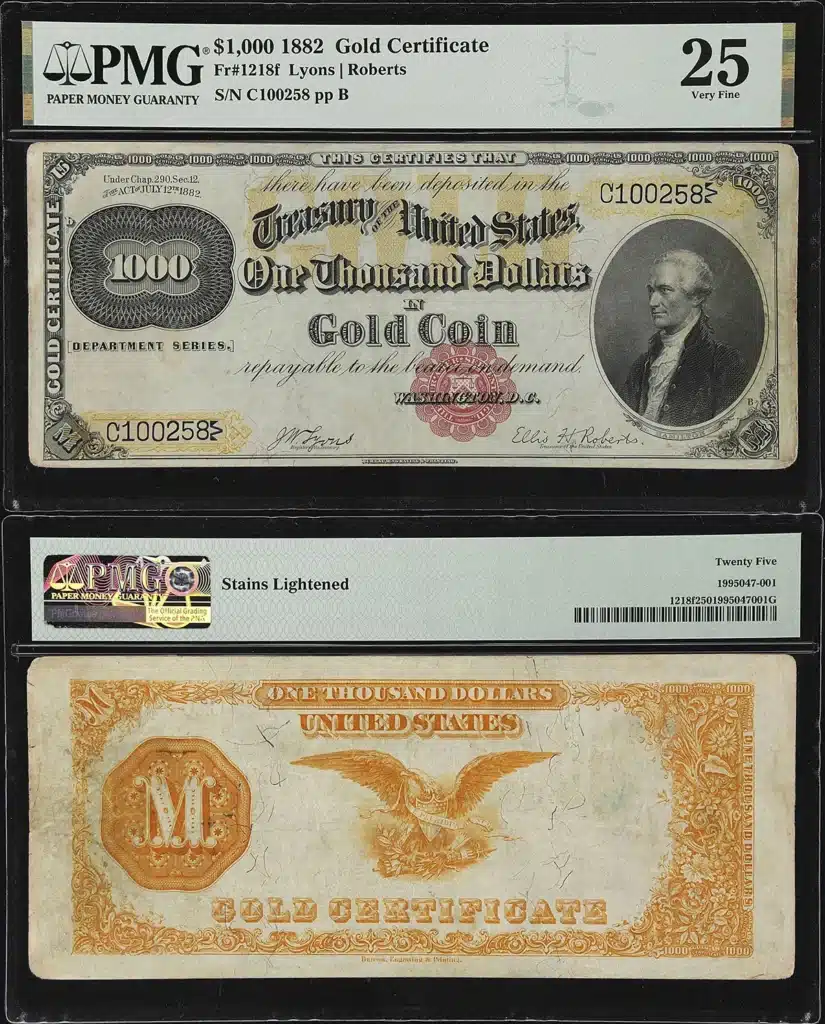
Rare large-size notes in the November U.S. Currency auction include Lot 20236, an 1882 $1,000 Gold Certificate, Fr. 1218f graded PMG Very Fine 25 “Stains Lightened” and Lot 20209, one of just two Uncirculated large-size $500 Federal Reserve Notes, Fr. 1132-L graded PMG Choice Uncirculated 64.
A number of condition rarities featuring iconic designs offered in the U.S. Currency sale include Lot 20111, a PCGS Banknote Superb Gem Uncirculated 67 1901 $10 Fr. 121m “Bison” and Lot 20154, a PCGS Banknote Superb Gem Uncirculated 68 PPQ $5 “Educational” Fr. 268 bearing a very low serial number.
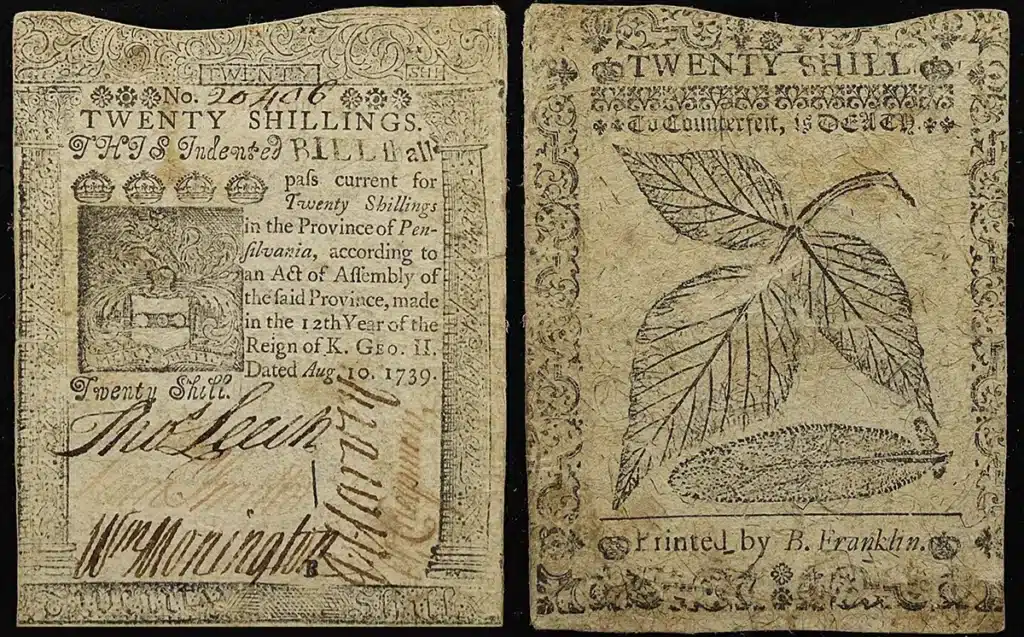
Colonial bank note highlights include a pair of rare Benjamin Franklin-related Pennsylvania notes. First is Lot 20006, an August 10, 1739, 20 Shillings PA-45 graded PMG Choice Very Fine 35, the finest known specimen of the type. It features the imprint of “B. Franklin” and displays a nature print security device on the reverse created by his own hand–which remained in use until the 1780s. Second is Lot 20008, a Continental issue of May 10, 1775, $20 CC-9 graded PMG About Uncirculated 58* EPQ. Although not one of Franklin’s, it is equally important as it was printed on paper supplied by Franklin and is a forerunner of the first federal issues released in 1861. The Stack’s Bowers November 2023 U.S. Currency sale will also offer three uncirculated Continental notes bearing the ever-popular “Fugio/Mind Your Business” motif later found on the Continental dollars of 1776 and the iconic Fugio cents of 1787.
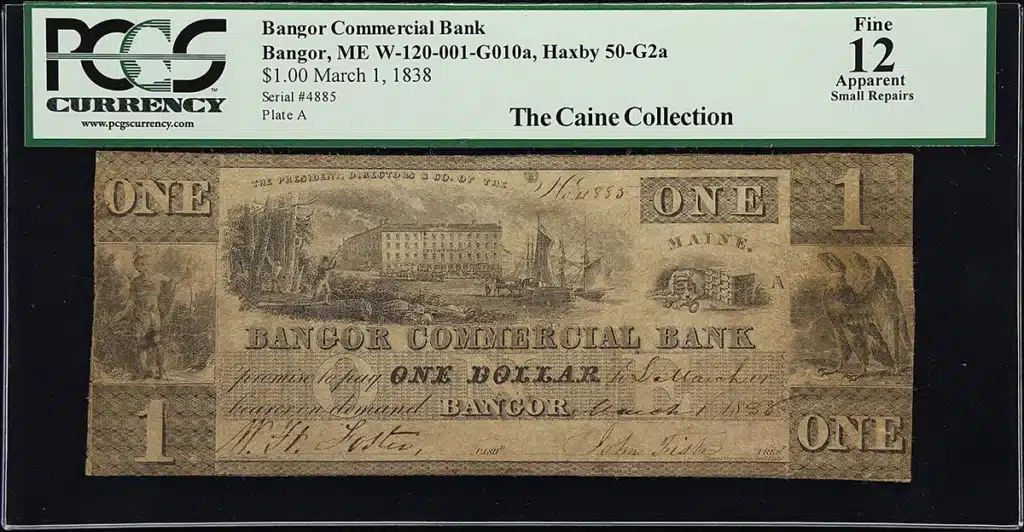
Obsolete Bank Notes from the Caine Collection account for a large part of the U.S. Currency Showcase. Several items from New England are highlighted by Lot 20022, a $1 obsolete from the Bangor Commercial Bank dated 1838, and Lot 20033, a $500 Proof from the Warren Bank of South Danvers, Massachusetts. The offerings are rounded out by obsoletes from the Midwest, the Antebellum and Postbellum South, and the Mid-Atlantic – including Tennessee, Connecticut, Minnesota, Ohio, and Alabama.
Collectors interested in the November 2023 U.S. Currency Showcase Auction can now pre-bid at StacksBowers.com. For more information, contact Stack’s Bowers Galleries at 800-458-4646 or Consign@StacksBowers.com.
* * *
The post Rare U.S. Currency in Stack’s Bowers November 2023 Showcase Auction appeared first on CoinWeek: Rare Coin, Currency, and Bullion News for Collectors.
Counterfeit Gold Coins Filled With Platinum: Hollow Gold
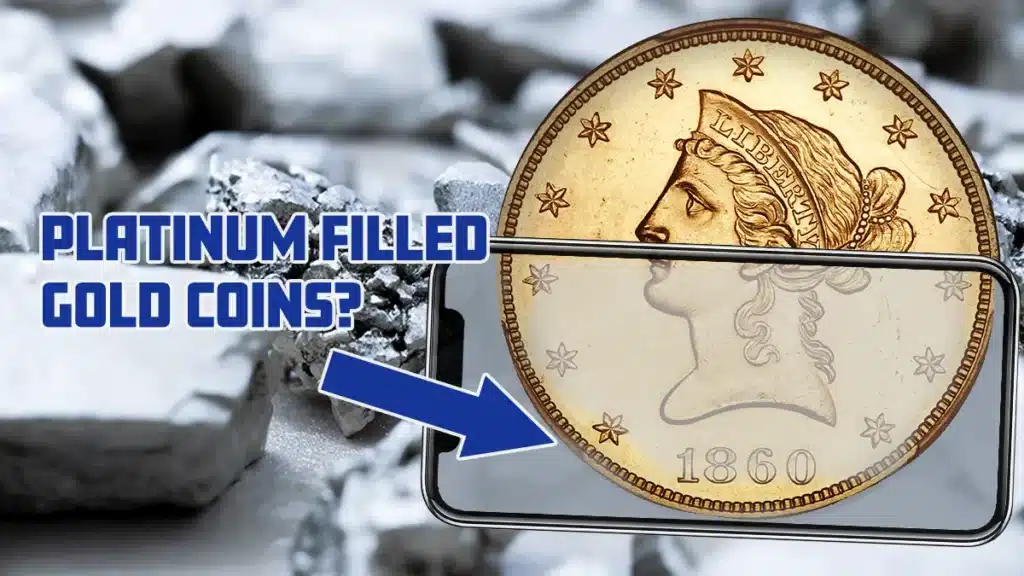
The production of counterfeit gold and silver coins is almost as old as coinage itself.
The usual method involves making something that looks like an authentic coin but using cheaper metal. Success for the criminal was measured by the quantity of fakes they could exchange for legal currency without getting caught[1]. One specialty was making fake silver coins from cheap substitutes, such as tin, that looked like ordinary worn coins. These allowed the use of cast or low-quality false dies without raising too much suspicion about design quality.
Another common counterfeiting approach came into use with the introduction of copper-nickel three-cent and five-cent coins in the latter 1860s. In this fraud, criminals exploited the difference in raw material cost and face value for legal coins. This was the seigniorage (or profit) the United States Mint made when they used one cent of copper-nickel to make a coin with a five-cent face value. Normal U.S. alloy was 75% copper and 25% nickel, but anyone could buy common “maillechort” or “nickel silver” from scrap metal dealers or jewelers for a few cents per pound[2]. This was readily melted, rolled into strips, and cut into blanks ready to be impressed with false dies. Authentic nickels and three-cent pieces were used to make counterfeit dies, and the struck pieces of scrap were easily passed to workers who used them for purchases and train fares.
In 19th-century America and parts of Europe, a more sophisticated and deceptive method came into use along with the large influx of new gold from California and Australia. This used a real coin, such as a $10 eagle or a $20 double eagle, and preserved the faces and most of the edge in original condition. The counterfeiter did not attempt to copy the coin; rather, gold was removed from inside. Visually, the coin appeared genuine, but in reality it had been hollowed out, the gold removed, and the cavity filled with a cheap heavy metal such as platinum[3].
Today, we consider platinum a precious metal widely used in electronics and as a catalyst for certain chemical reactions[4]. But for much of the last 150 years, it has been a specialty metal prized for its limited chemical reactivity and high melting temperature in laboratory and assaying equipment. The chart below plots the market value of platinum versus gold from about 1880 to 1980.

Pure platinum, at 21.45 grams per cubic centimeter, was noticeably denser than pure gold’s 19.3 g/cc, but native platinum contained impurities (including palladium) that reduced its density enough to make it a good replacement for gold in counterfeiting[5].
The Discovery of a New Way of Making Counterfeit Gold Coins
At the beginning of the Civil War in 1860, the Treasury Department and the Mint became aware of a new method of adulterating gold coins with platinum (called “platina” in contemporary letters). Previously, the most common replacement method was to drill small holes through the edge of a coin and replace the gold with a plug of platinum. The damaged edge was repaired and gilded with a bit of gold leaf to hide the work. But the new process was capable of removing as much as half the gold in a $10 Eagle and very difficult to detect.
Here’s what Dr. John Torrey, Assayer at the New York Assay Office, had to say in July 1860:
I procured for you to-day, a fine specimen of a ten-dollar gold coin. It has the proper weight and size, but it is no doubt filled up with platina [i.e. platinum]. It was probably made by sawing through a genuine eagle, and then turning out on a lathe, or filing away, a considerable part of the gold. A disc of platina was then introduced, and a narrow hoop of gold used to fill the saw-cut. The whole was then united with silver solder, and the milling renovated. I have reason to believe there are many of these coins in circulation. We have some ounces of platina taken out of a lot of them, brought to our office. You will have difficulty in finding the seams in the piece I send you. Scarcely a bank in our city would hesitate to take it. I paid five dollars for this piece, which is about its intrinsic value.
Now, how shall we detect these debased pieces? The coinage is genuine, the weight and size correct. I am able to tell them (except when the seams are manifest) only in one way, i.e., by plunging then under nitric acid. This almost immediately acts on the silver solder, producing bubbles of nitrous gas, and a green discoloration around the joint; finally separating the parts completely. A few minutes or even seconds immersion in the nitric acid is generally sufficient to detect the fraud. This method can of course be applied to a considerable number of pieces at once [meaning, ‘at one time’], and the bad ones picked out; the gold ones not being injured by the operation.[6]
According to Torrey, the counterfeiter carefully sliced a normal $10 eagle in half through the edge. Each part was mounted in turn on a small lathe and gold removed from the center without disturbing the edge or penetrating the coin’s faces. Next, a small disc of platinum was inserted in place of the gold. This must have been a precise fit so that when restored, the coin was solid. The two halves were then soldered together with the existing reeds aligned. A piece of gold wire was pushed into the visible saw cut and the reeds restored. This latter step was likely done with a small gear rather than a file so that all the reeds looked normal across the coin’s thickness. Torrey noted that he “…paid $5 for this piece, which is about its intrinsic value” for the adulterated eagle. If this were representative of other gold coins adulterated this way, the counterfeiter was removing about half the face value from every coin.
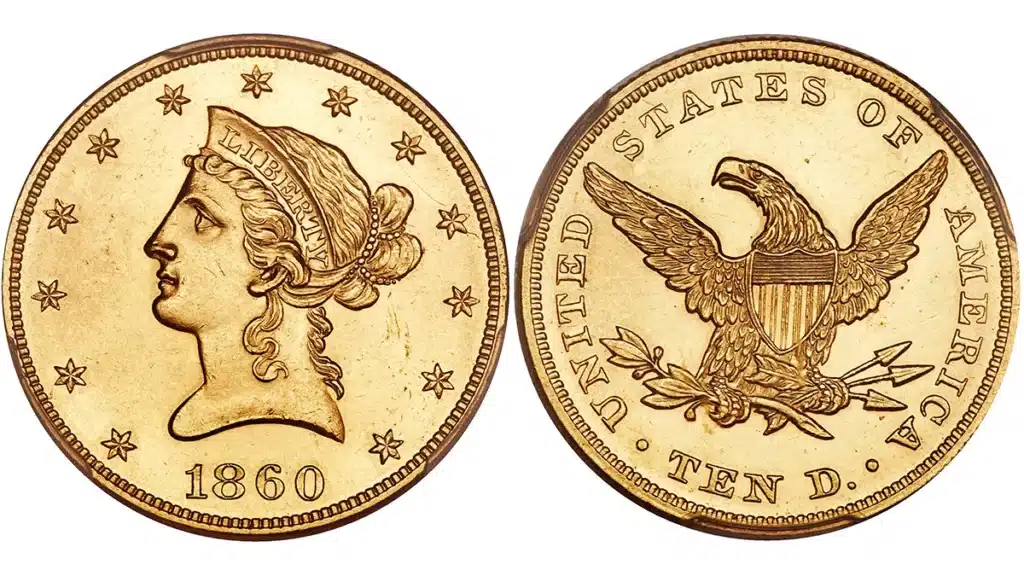
Despite the precise control such operations demanded, this was all easy to accomplish using equipment available in the late 1850s. Weight could be controlled by the thickness of the gold band which covered the cutting and the only visible seam would be between the band and a coin’s normal rim[7]. With careful machine control, weighing the re-joined coin and edge filling to mint specification, and a small toothed gear to reform the reeds, a good machinist-counterfeiter might make five to 10 fakes per day. Using $10 gold pieces, that would mean revenue of $25 to $50 per day – double if $20 coins were used[8].
Compare that to the $3 daily wage of a Philadelphia Mint mechanic.
Dr. Torrey’s detection method was very effective but also not something that was convenient or easily done outside an assay office or mint facility. By the time a potentially counterfeit gold coin could be tested with acid, the person passing the fake would likely be long gone, and some merchant or bank was left holding the residue. The most reliable and readily available test was called the “ring test”. A suspect coin was dropped on a marble countertop and a clerk listened for the characteristic high pitch ring of a normal coin. A struck silver or gold coin is a solid body that makes a ringing sound when balanced on a finger and lightly tapped with a fingernail or solid metal rod. A counterfeit, such as we’ve described, is composed of several pieces and not a solid body. When tested by dropping or tapping it will produce a dull “thump” or “thunk” sound completely unlike that of an authentic coin[9].
Faced with this form of counterfeit gold coins, United States Mint Director James Ross Snowden suggested that “reducing the thickness of our gold coinage is the only mode of preventing the debasement in question.”[10] Multiple experiments were conducted and several pattern coins on wide, thin planchets were made[11].
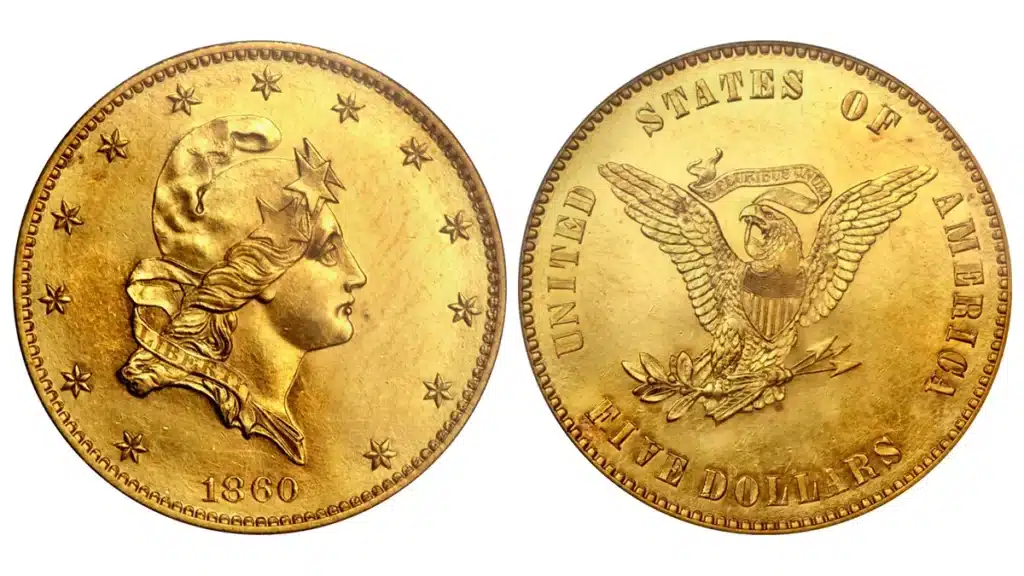
A Possible Solution
A solution eventually emerged from Edward Pratt, the Assistant Treasurer in Boston, in a letter to Treasury Secretary Howell Cobb:
If the Department should determine to employ detectives… it will perhaps be advisable to impart to them the following facts, the accuracy of which can be easily established, viz.: that there are in this country very few purchases of manufactured platina; such being confined almost entirely to dentists and chemists. The Professor of Chemistry at Harvard University informs me that in the course of a year, he uses but about 10 or 12 ounces; and one of the leading dentists if this city tells me that he uses in the same time from six to nine ozs. Much platina is undoubtedly used in the form of crucibles, etc., but it is all manufactured abroad.[12]
Pratt’s observation was that very little platinum was produced or used in the United States. This would naturally limit the extent to which cutting and filling could be performed. Also, anyone acquiring platinum in larger quantities or who was not in a business known to use the metal, would immediately raise suspicion and come under investigation[13]. Simply put, filling gold coins with platinum was severely limited by the metal’s limited availability.
In the end, all the alarm, hand wringing, letter writing, and pattern making was for naught. Cut and filled gold coins quietly evaporated from Mint and Treasury thoughts. Letters ended up in musty anonymous file cases and pattern pieces adorned the Mint Cabinet of Coins & Medals, plus a few select private collections.
* * *
Notes
[1] Traditional punishments were permanent: death by one of several gruesome means; amputation with an axe of both hands; forehead branding and the amputation of one hand; and blinding with mercury fumes were among the options.
[2] Also known as German silver, argentan, new silver, nickel brass, albata, or alpaca. Containing no silver, the alloy consists of copper, nickel, zinc and sometimes tin. It is often used in cheap jewelry as a substitute for Sterling or fine silver.
[3] Platinum was a common impurity in California gold along with iridium and osmium.
[4] Platinum was found in placer deposits during the 16th-century Spanish conquest of South America. It was first thought to be a special kind of silver, and was called “platina del Pinto” (“little silver of the River Pinto”) after the Rio Pinto in Colombia. Because it would not melt with furnaces available to the Spanish, they soon considered it a nuisance and contaminant and often discarded it.
[5] Iridium and osmium, both denser than platinum, were also present in native deposits. This forced criminals making counterfeit gold coins to adapt their techniques to accommodate available metal.
[6] RG104 E-1 Box 59. Letter dated July 14, 1860 to Snowden from Eckfeldt and Dubois.
[7] This might have been another reason the mints were concerned about a fin extending beyond the rim, especially on gold coins. The junction of repaired reeding and rim might have closely resembled a natural fin.
[8] Eagles and half eagles were likely preferred since they circulated in large cities. Double eagles were much less commonly seen and would probably have been more closely checked by merchants and banks.
[9] Some authentic coins will not ring properly if they have inclusions in the planchet or have been damaged.
[10] RG104 E-1 Box 60. Letter dated September 29, 1860 to Cobb from Snowden. Repeated in letter dated October 1, 1860 to Snowden from Cobb.
[11] See Roger W. Burdette. “Dr. Barclay’s Experimental Coinage ~ 1832-1876” in Fads, Fakes and Foibles (Seneca Mill Press LLC, 2021).
[12] RG104 E-1 Box 60. Letter dated September 21, 1860 to Cobb from Pratt. Excerpt. 6-7.
[13] Purchasing assay equipment was not an option because the manufactured goods cost more than the same weight of gold, and would also produce suspicion among the Treasury Department’s customs agents.
* * *
The post Counterfeit Gold Coins Filled With Platinum: Hollow Gold appeared first on CoinWeek: Rare Coin, Currency, and Bullion News for Collectors.
Stephenville Collection Lincoln Cents Offered by Heritage Auctions
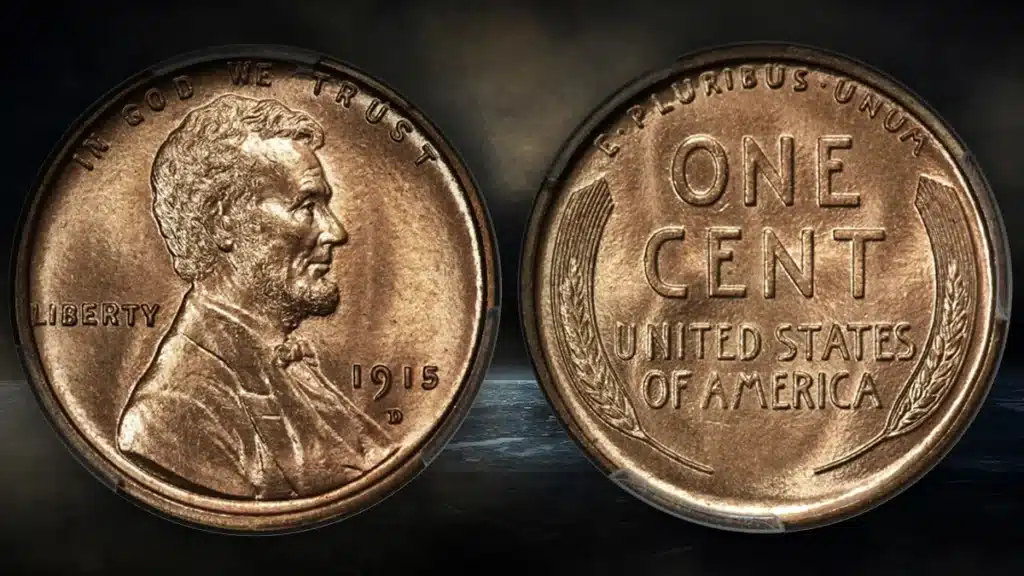
Heritage Auctions is offering The Stephenville Collection, a collection that spans many different U.S. coin series, over the coming months. Prior auctions featured Seated Liberty and Barber coinage, Bust half dollars, Morgan silver dollars, and a number of coins certified with Gold stickers from CAC. The November 2023 sale of the Stephenville Collection will feature a near-complete selection of Lincoln cents through 2022–including Registry Set coins, Proofs, and a large number of Cherrypickers’ varieties. All coins in this offering have been graded by PCGS. Bidding is open now, with a live session to be held on Monday, November 6, at 5:00 PM CT (6:00 PM ET).
One standout condition rarity among the higlights of the Stephenville Collection of Lincoln cents is a Superb Gem 1915-D cent. Collectors will probably have very little trouble finding a specimen of the 1915-D in MS64 or MS65 with Red surfaces, and even Premium Gems are offered every year. But Superb Gems with the Red designation are challenging condition rarities. PCGS has graded four pieces (including the cent offered here) in MS67 Red, with none finer, while NGC has certified just one example in MS67 Red, with none finer. This Superb Gem offers impeccably preserved original red surfaces, with vibrant mint luster and great eye appeal. The design motifs are sharply detailed throughout.
Other highlights in this auction include:
- 1909-S 1C VDB MS66 Red PCGS
- 1909-S/S 1C S Over Horizontal S, FS-1502, MS67 Red PCGS. CAC
- 1917 1C Doubled Die Obverse, FS-101, MS65 Red PCGS. CAC
- 1920-S 1C MS65 Red PCGS
- 1922 1C No D, Strong Reverse, FS-401, MS64 Brown PCGS. Die Pair 2
- 1944-D/S 1C FS-511 MS67 Red PCGS
- 1969-S 1C Doubled Die Obverse, FS-101, MS63 Red and Brown PCGS
- 1916 1C PR67 Red and Brown PCGS
* * *
The post Stephenville Collection Lincoln Cents Offered by Heritage Auctions appeared first on CoinWeek: Rare Coin, Currency, and Bullion News for Collectors.
ANA Dedicates New Young Numismatist Scholarship to Greg Lyon
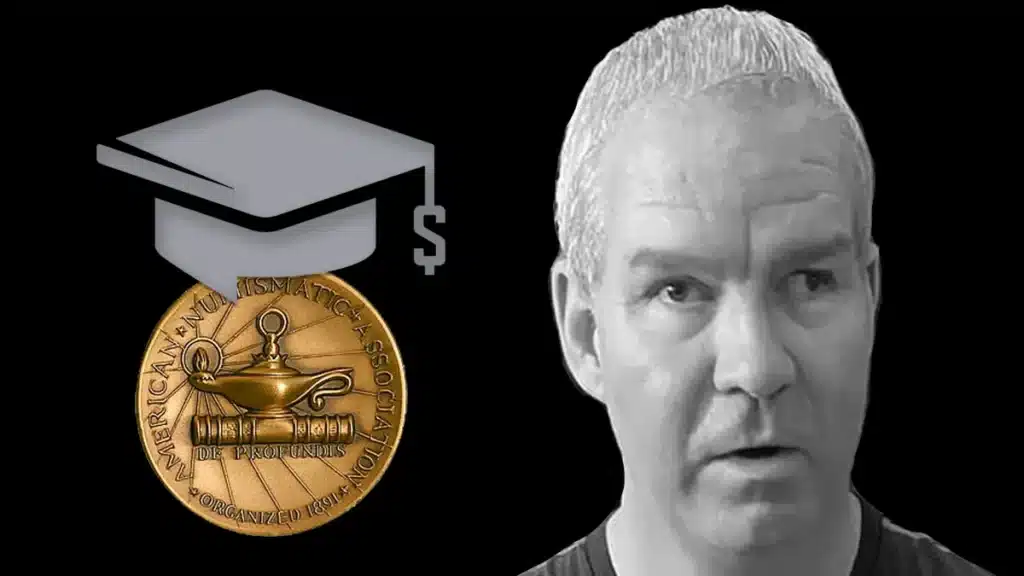
The American Numismatic Association (ANA) hosts the educational Summer Seminar every year for interested coin collectors and numismatists. Many notable individuals in the field of numismatics have attended the two-week event over its history, and many of these same experts return to teach new students in kind. Scholarships are available to both adults and Young Numismatists (YN). Full scholarships cover airfare, tuition, and room and board for one week, and partial scholarships cover just tuition.
The ANA Board of Governors has chosen to honor Greg Lyon, a 10-year member of the Board and ANA parliamentarian who died earlier this year, by setting up the Greg Lyon Memorial YN Scholarship to support young numismatists wishing to attend Summer Seminar. YNs who submit a scholarship application are automatically considered for the award, which will be granted to a YN who best personifies the qualities for which Lyon was known.
Greg attended his first Summer Seminar in 1986 at the age of 14 and was named Young Numismatist of the Year in 1989. He went on to earn other ANA awards, including Adult Advisor of the Year, the Glenn Smedley Memorial Award, and a Presidential Award.
And while he loved coin collecting, Greg especially valued the friendships he made in the hobby through his involvement with the ANA. The Summer Seminar was one of his favorite numismatic activities, which he attended over 20 times, first as a student and later as a mentor. Countless young numismatists credit him as a role model. His knowledge of investments and business management made him a trusted source of information and advice, both to the Board and to the many ANA committees with which he worked.
Greg Lyon Memorial Young Numismatist Scholarship applications can be found at money.org/summer-seminar and must be filled out and submitted no later than February 15, 2024. For additional information, contact the ANA Seminars Department at (719) 482-9848 or seminars@money.org.
* * *
The post ANA Dedicates New Young Numismatist Scholarship to Greg Lyon appeared first on CoinWeek: Rare Coin, Currency, and Bullion News for Collectors.
Spectacular Dutch Coins Garner Almost $5.5 Million in Künker Auction
On September 27 and 28, 2023, Künker auctioned about 1,200 lots of the Lodewijk S. Beuth Collection of Dutch coins minted between 1795 and the present. The 10 lots presented below each realized over $100,000 euros (about $105,355 USD at the time of writing).
* * *
Lodewijk S. Beuth’s career as a collector began when he wanted to acquire some gold coins at the Schulman coin shop in the 1950s, with the end of World War II still a vivid memory. He wanted to purchase some gold so that he would have a small stock for emergencies. Jacques Schulman suggested that he invested in pieces of numismatic importance instead. Beuth was convinced by the charismatic coin dealer’s arguments, caught the collecting bug, and began to dream of assembling the largest and most beautiful collection of Dutch coins of his generation.
The first part of this unique collection was put on the market September 27-28, 2023. Künker sold it in collaboration with Laurens Schulman B. V. in Osnabrück, Germany. It was a major event for the community of collectors of Dutch coins, many of which personally attended the auction sale. After all, it had been almost half a century since a comparable collection entered the market.
This was also reflected by the hammer prices. The total estimate had been a little over two million euros. The total result was 5.2 million euros (about $5,478,460)–i.e., more than two-and-a-half times the estimate.
There were numerous remarkable individual results. We present the 10n most expensive pieces of the Beuth Collection, many of which broke previous records. For example, according to CoinArchives, the highest result of a coin from the Kingdom of the Netherlands had been at 117,000 euros (about $123,265). Read on to find out about the new record.
As always, if two coins achieved the same result, the specimen with the higher increase in price compared to its estimate will receive the higher rank.
10th Place:
((01 – No. 3284. William I, 1813-1840. Silver pattern of 25 cents (Kwartje), 1817, Utrecht. Extremely rare. Purchased in 1954 from the Menso Collection. Proof. Estimate: 25,000 euros. Hammer price: 100,000 euros.))
9th Place:
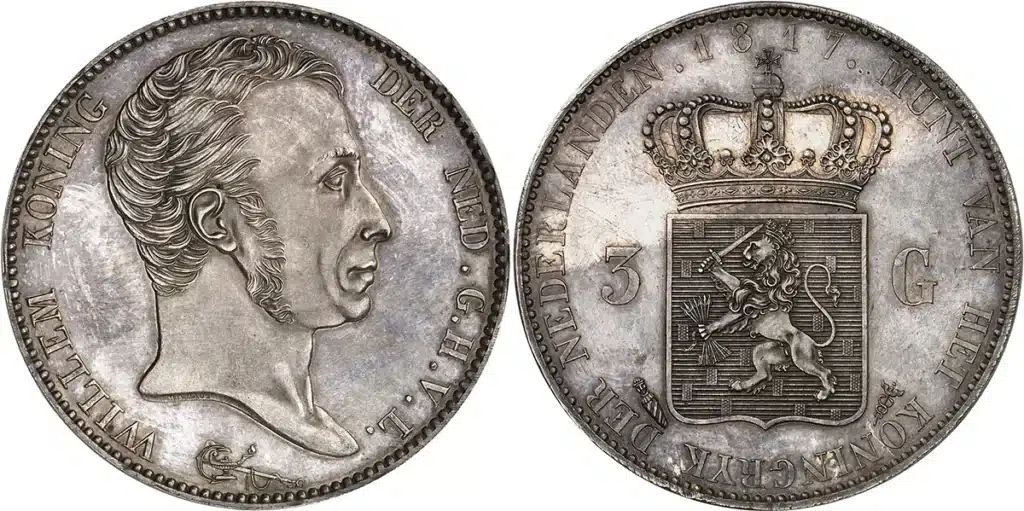
8th Place:

7th Place:

6th Place:
((05 – No. 3696. Wilhelmina, 1890-1948. Silver pattern of the 2 1/2 gulden, 1898, Utrecht. Unique? Purchased in 1955 from a Jacques Schulman sale. Proof, minimally worn. Estimate: 50,000 euros. Hammer price: 120,000 euros.))
4th Place:

4th Place:
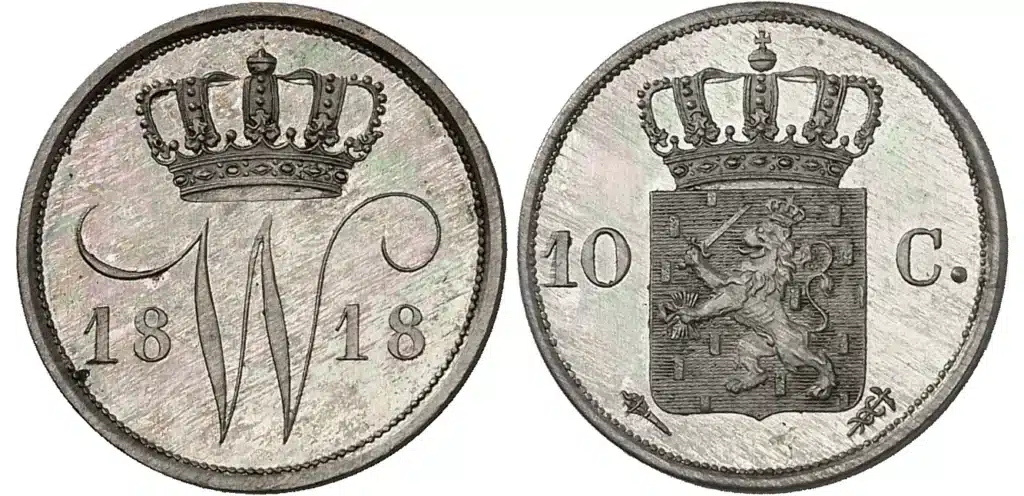
3rd Place:
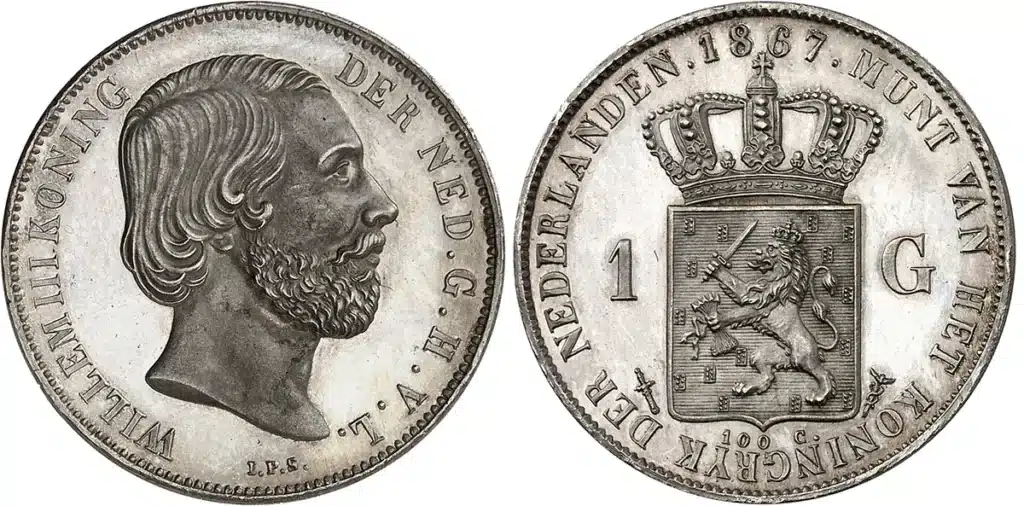
2nd Place:

1st Place:

The joint sale of Künker and Laurens Schulman set several records at once:
At 200,000 euros (about $210,710), No. 3465 – the 1867 double ducat – is the new front runner as the most expensive coin of the Kingdom of the Netherlands.
At 120,000 euros (about $126,246), No. 3325 – the cent pattern of 1817 – holds the new record as the most expensive base metal coin of the Netherlands.
And also at 120,000 euros, No. 3302 – the silver pattern of 10 cents (Dubbeltje) from 1818 – is now the most expensive pattern from the Kingdom of the Netherlands. Nevertheless, its result is only marginally higher than that of the former record-holder, which was sold in 2020 for $130,000 (about 116,974 euros).
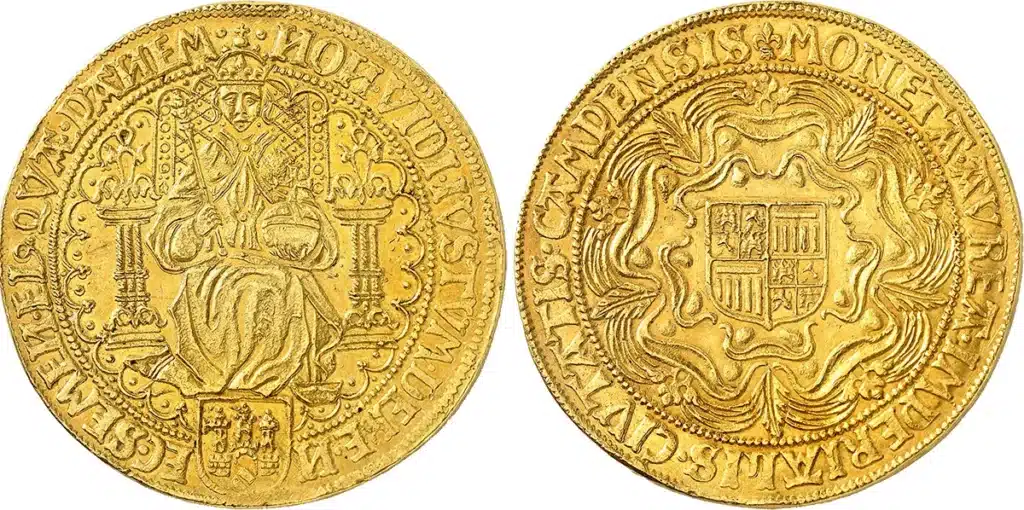
There can be no doubt, however, that the most expensive Dutch coin is still the eightfold rose noble from Campen, sold by Künker in 2022 in the context of the Salton Collection at a hammer price of 700,000 euros (about $737,485).
Although we only presented high-priced coins in this auction review, there were many pieces in both sales that any collector could have afforded. See for yourself and check out the results in detail.
If you have any questions, please do not hesitate to contact us at Künker, Nobbenburger Str. 4a, 49076 Osnabrück; phone: +49 541 / 962020 or via e-mail: service@kuenker.de. Or you can directly contact Laurens Schulman BV, E-mail: Info@laurensschulman.nl, Tel: +31 6 29 112 447
You can also find the auction results online at www.kuenker.de.
The post Spectacular Dutch Coins Garner Almost $5.5 Million in Künker Auction appeared first on CoinWeek: Rare Coin, Currency, and Bullion News for Collectors.
Gold Achieves Another Near 3-Month High with Modest Weekly Gain
On Friday, the prices of most precious metals remained relatively stable, with all of them except gold experiencing slight declines
Top 5 Gold Bullion Coins for Investors
Gold bullion coins are a proven strategy for investors to diversify their portfolios and protect and grow their wealth. For thousands of years, people around the world have understood this.
Owning physical gold has many benefits over “paper” gold like an Exchange-Traded Fund (ETF) or mining stock. ETFs and mining stocks do not always follow the spot price and you never take physical ownership of gold. Notably, there are sometimes outside forces at play that move paper investments at different rates and in different directions than the price of gold. For example, gold mining stocks can be impacted negatively by labor strikes, political strife in the countries where miners operate, poor company management, and accounting issues. Gold could be performing strongly and a mining company’s stock may not reflect the commodity’s performance. ETFs have their own set of unique issues, including management fees, marketing fees, and storage and insurance fees. Investors putting money into ETFs also do not take real possession of the gold.
Clearly, physical gold does not have these same downsides.
To own gold that you can hold in your hand, there are many different coin options to choose from. Below are the five best gold bullion coins for investors to consider. All of these gold coins are recognized around the world for their purity and authenticity and are easily bought and sold.
Another benefit to owning the top five gold coins on our list is that they are all approved by the Internal Revenue Service (IRS) to use in your Individual Retirement Account (IRA). Let’s take a look at the five best gold coins to use in investing.
1. One Ounce American Gold Eagle Bullion Coins
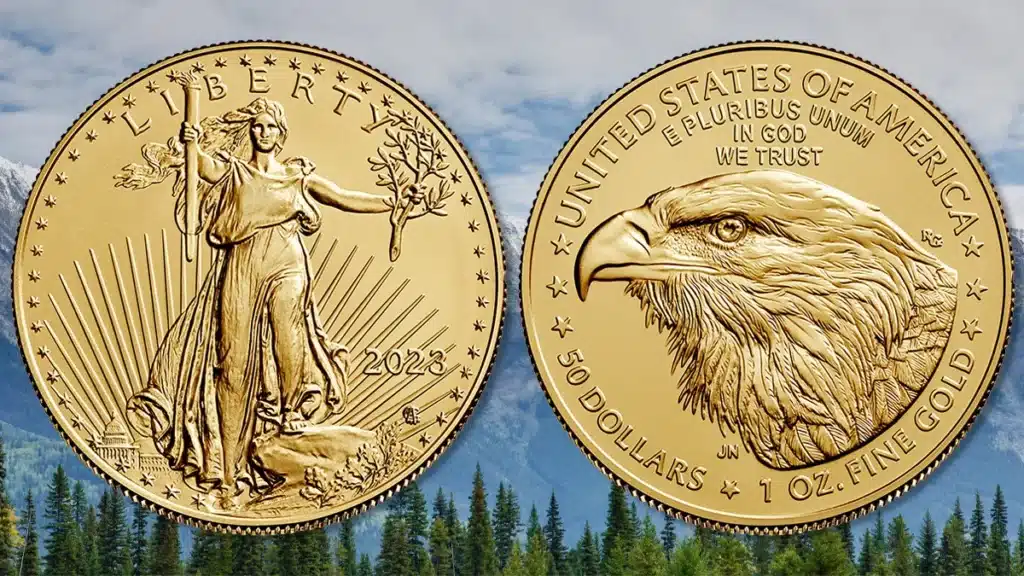
One-ounce American Gold Eagle coins are hands down one of the most popular and widely recognized gold bullion coins around the world. The United States Mint produces these 22-karat gold coins and offers investors a rock-solid investment in an ever-changing economy. The value of American Gold Eagle coins moves independently of the stock and bond markets, which offers investors strong portfolio diversification value. Indeed, when the stock market crashes, the price of American Eagle gold coins has historically went higher. In 1986, President Ronald Reagan signed into law the program to mint American Eagles, which became the global standard for bullion coins. These coins are 100% American-made.
2. One Ounce American Gold Buffalo

Another coin produced by the U.S. Mint for investors and collectors alike is the American Gold Buffalo coin. This stunning gold coin is an homage to our nation’s early history and heritage. For many years, investors could buy only 22-karat gold. But amid growing interest in even greater purity levels, Congress authorized the creation of the 24-karat American Gold Eagle, which debuted in 2006. You may recall the famous Buffalo Nickel designed by James Earle Fraser. This arresting gold bullion coin pays homage to that era and features a Native American chief’s profile on the obverse side and an American buffalo on the reverse.
3. One Ounce Canadian Gold Maple Leaf

Moving beyond the United States, the one-ounce Canadian Gold Maple Leaf is one of the most prestigious and highly sought-after gold bullion coins after the American coins mentioned above. The well-respected Royal Canadian Mint introduced this coin in 1979 and it was the first bullion coin to feature 99.99% pure gold. The one-ounce Canadian Gold Maple Leaf coin represents extraordinary craftsmanship, featuring the iconic and cherished Canadian maple leaf.
4. One Ounce Australian Gold Kangaroo
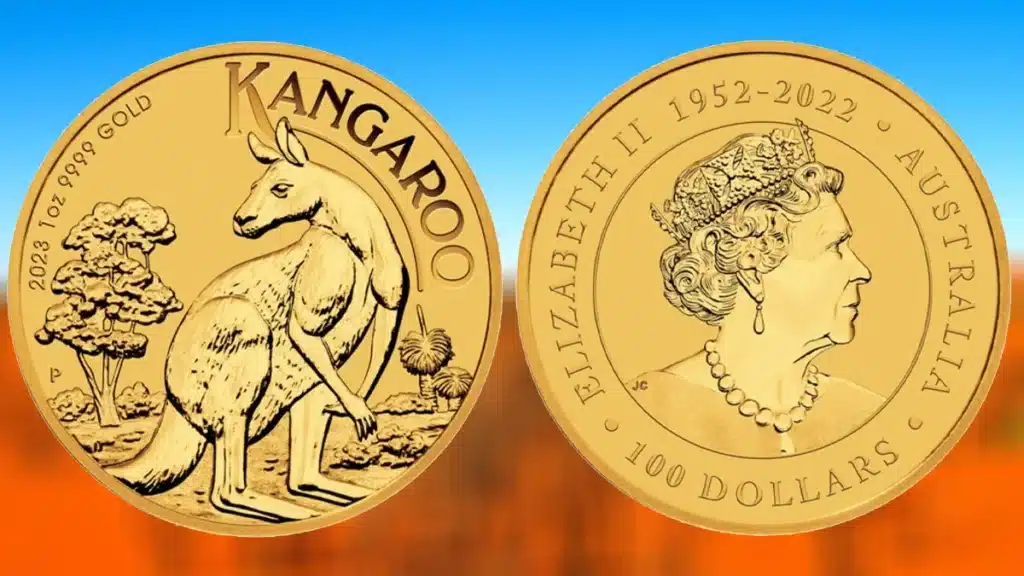
Traveling farther around the globe, the esteemed Perth Mint has produced the one-ounce Australian Gold Kangaroo since 1986, which is another coin highly sought-after by investors. The original version of this gold bullion coin was known as the Australian Gold Nugget. However, in 1990, the Perth Mint redesigned the coin, which now features an iconic kangaroo design paying homage to Australia’s natural heritage. The reverse highlights a magnificent kangaroo with intricate detailing, revealing both the dignity and brawniness of this beloved marsupial. The obverse reveals Queen Elizabeth II, highlighting the country‘s connection to the British monarchy.
5. One Ounce Austrian Gold Philharmonic Bullion Coins
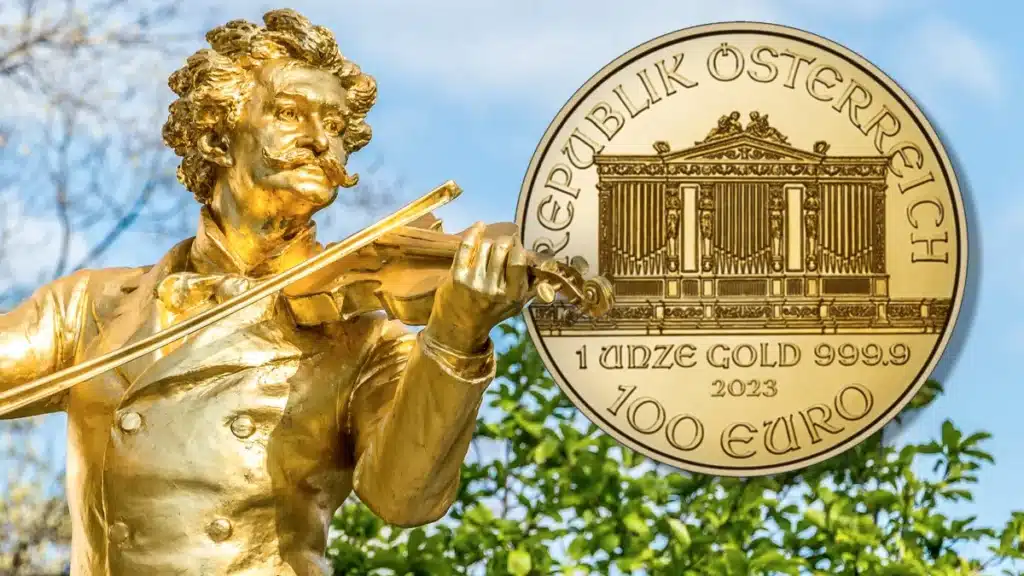
Last but not least, the one-ounce Austrian Gold Philharmonic gold coins are easily one of the most popular bullion coins traded in continental Europe. The Austrian Mint began producing these elegant coins in 1986, which pay homage to the thriving musical history in Austria’s capital city of Vienna. Sometimes called Vienna Gold Philharmonics, investors gravitate to this coin for its widely recognized depiction on the obverse of the Great Organ, an iconic instrument that sits in Vienna’s esteemed Musikverein concert hall. The reverse features a collection of musical instruments, including the cello, violin, harp, flute, and horn, which represent the many sounds that meld together to create a symphony.
* * *
The post Top 5 Gold Bullion Coins for Investors appeared first on CoinWeek: Rare Coin, Currency, and Bullion News for Collectors.
High Gem 1976-D Eisenhower Dollar Offered by David Lawrence

The online November 5 auction from David Lawrence Rare Coins (DLRC) is live with over 600 lots – including 300 No Reserve and 50 Vault Values.
Among the U.S. coin highlights certified by PCGS, NGC, and CAC are a key date 1916-D 10C PCGS/CAC XF40 (OGH); a rare 1873-CC Seated $1 PCGS AU Details (Cleaned); a tied-for-finest 1976-D Eisenhower dollar PCGS MS67+ (Type 1); an 1844-C $5 NGC AU58; a scarce 1862 $20 PCGS AU50; and a 1787 Fugio PCGS/CAC MS65BN (United States, 4 Cinq).
Also in this auction is the Regal Eagle Collection, consisting of more than 50 one-ounce American Gold Eagles and Gold Buffaloes. Graded entirely by PCGS (MS69 and 70 only), David Lawrence is offering these perfect and near-perfect gold coins with no reserve. View and bid on the Regal Eagle Collection here.
Another specialized collection featured in Sunday’s auction is the Clarksville $20 Liberty Collection. Also starting with no reserve, these lots can be viewed and bid on here.
Be sure to check out al lof the highlights before the auction closes on Sunday, November 5.
READY TO SELL YOUR RARE COIN OR COLLECTION? SELL IT TO DAVID LAWRENCE
Like the High Gem 1976-D Eisenhower dollar and other rare classic and modern U.S. coins offered above, David Lawrence Rare Coins always needs coins. When you are ready to sell, we’re here for you. David Lawrence offers three options that provide maximum flexibility to meet your needs while providing the highest quality personal service in the industry:
- You can sell your coins to us outright.
- You can consign your coins.
- You can participate in our Guaranteed Auction Program.
DLRC Consignment Special
Check out our Collector Consignment Special! We are offering the following options that can be combined, or adjusted for your specific needs:
Maximum Returns – For coins over $10,000, consign with a reserve and receive 90% or consign with no reserve and receive 92%.
Immediate Cash Advance – For collections over $10,000, receive an immediate cash advance of up to 75% on unreserved consignments.
Fastest Turnaround – We will get your coins to auction within 3-5 business days of receipt, ending in approximately two weeks.
Standard terms still apply:
- Coins from $1,000 to $10,000 – consign with a reserve and receive 85%; consign with no reserve and receive 90%
- No fee guarantee – no listing fees, no imaging fees, and no buyback fees
- Fast payment – payment within 30 days of sale; for this promotion, we can accelerate payment to two weeks in most cases
The post High Gem 1976-D Eisenhower Dollar Offered by David Lawrence appeared first on CoinWeek: Rare Coin, Currency, and Bullion News for Collectors.
U.S. Mint 2024 Product Schedule Published
Steve Forbes Autographed Silver Eagle Labels at Nashville IMEX – Oct. 27-28
PCGS-certified American Silver Eagle bullion coins with a special insert autographed by Steve Forbes will be available while supplies at the first International Money Expo (www
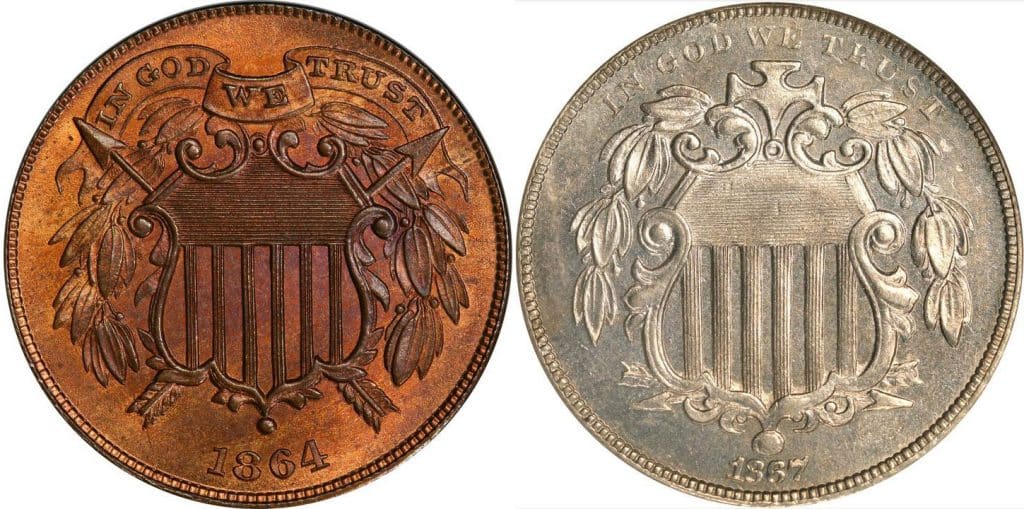
The Two-Cent Piece: The Civil War and In God We Trust
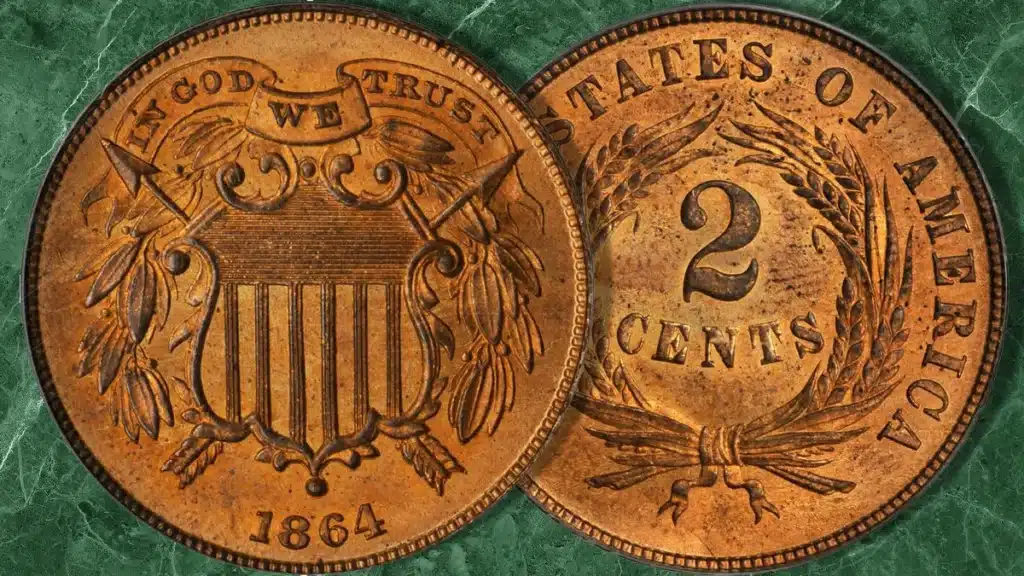
The two-cent piece was a large copper coin struck by the United States Mint. It was first struck in 1864, but public demand for the unusual denomination subsided after just two short years. Produced in ever decreasing numbers after that, the coin was last issued for circulation in 1872. Proof-only versions were struck for collectors the year after that but Congress abolished the coin with the passage of the Coinage Act of 1873.
Slightly smaller than a modern U.S. quarter dollar, the two-cent piece was conceived as a stopgap denomination to facilitate trade at a time when most coins had been withdrawn from circulation and hoarded due to the economic strain caused by the Civil War.
With the war effort costing the Federal Government nearly $3 million per day (in 1864 money), the challenge of keeping silver and gold coins in circulation proved daunting for the Treasury Department. Even copper coins had all but disappeared from circulation within the first two years of fighting. Among the solutions was to issue paper money in various forms and to introduce base metal coins in two-, three-, and five-cent denominations. It wasn’t until the late 1870s that Congress would pass legislation authorizing the resumption of specie (i.e., precious metal) payments.
The Birth of a National Motto
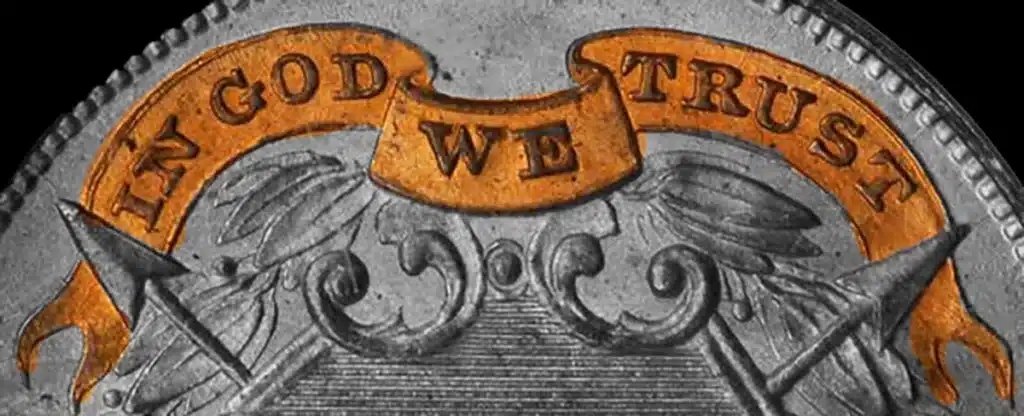
While the two-cent piece didn’t catch on as a circulating coin, it is significant in that it the very first United States coin to carry the motto IN GOD WE TRUST. The motto was placed there on the order of Treasury Secretary Salmon P. Chase, who got the idea from the Reverend M.R. Watkinson, a Baptist preacher from Ridleyville, Pennsylvania, who recommended that the nation recognize God on its coins.
In a letter to Chase dated November 13, 1861, Watkinson wrote:
You are probably a Christian. What if our Republic were not shattered beyond reconstruction? Would not the antiquaries of succeeding centuries rightly reason from our past that we were a heathen nation? What I propose is that instead of the goddess of liberty we shall have next inside the 13 stars a ring inscribed with the words PERPETUAL UNION; within the ring the all seeing eye, crowned with a halo; beneath this eye the American flag, bearing in its field stars equal to the number of the States united; in the folds of the bars the words GOD, LIBERTY, LAW.
From 1861 to ’64, the Mint’s engraving department tested different mottoes before landing on the version that Chase ultimately approved.
Public sentiment was strongly in favor of the motto, and on March 3, 1865, Congress passed legislation that authorized but did not demand the use of IN GOD WE TRUST on “gold, silver, and other coins.” As a result, many other denominations were slightly revised so as to allow for the addition of the new national motto.
The Two-Cent Piece Shield Design

The two-cent piece was designed by United States Mint Chief Engraver James B. Longacre. The coin’s obverse (so designated because it bears the date) has a federal shield with a ribbon over it bearing the national motto IN GOD WE TRUST. Behind the shield are two arrows and a branch with leaves (most likely an olive branch). Although the standalone shield was novel at the time of its production, similar shields have appeared on United States coins since the adoption of the Heraldic Eagle design debuted on the reverse of the 1795 $5 half eagle gold coin.
The two-cent piece’s reverse features a vegetal wreath that surrounds the denomination, which is displayed as a large 2 over a downwardly arched CENTS. The legend UNITED STATES OF AMERICA surrounds the wreath.
This design is similar to the Shield nickel of the same period, which was also designed by Longacre.
Two-Cent Piece Annual Mintage Figures
Two-cent pieces were struck in both Proof and regular circulating finishes. Although the Proof mintages were normally smaller than the regular-issue mintages, more Proofs of high quality survive today since they were treated as special collector coins at the time of release.
While all two-cent pieces are of the same type, many die varieties exist. The most significant of these are the Small Motto and Large Motto varieties of 1864. The Small Motto is much rarer and therefore more valuable. In addition, several doubled dies, coins with prominent die cracks, and various other mint errors are often encountered in this series.
- 1864 – 19,847,500
- 1865 – 13,640,000
- 1866 – 3,177,000
- 1867 – 2,938,750
- 1868 – 2,803,750
- 1869 – 1,546,500
- 1870 – 861,250
- 1871 – 721,250
- 1872 – 65,000
- 1873 (Proof Only) – approx. 1,100 struck
More In-Depth Two-Cent Piece Analysis by CoinWeek

In this article, former CoinWeek contributor Greg Reynolds discusses the history of the denomination and offers his opinion on where the value-buying opportunities lie within the series. Greg also gets the perspective of prominent numismatists John Albanese and Matt Kleinsteuber on this short-lived copper coin series.
Specifications
| Two-Cent Piece | |
| Years Of Issue: | 1864-73 |
| Mintage (Circulation): | High – 19,847,500 (1864); Low – 65,000 (1872) |
| Alloy: | 95% copper, 5% tin and zinc |
| Weight: | 6.20 g |
| Diameter: | 23.00 mm |
| Edge: | Plain |
| OBV Designer | James Barton Longacre |
| REV Designer | James Barton Longacre |
* * *
The post The Two-Cent Piece: The Civil War and In God We Trust appeared first on CoinWeek: Rare Coin, Currency, and Bullion News for Collectors.
Gold Logs Another Near 3-Month High
On Thursday, the prices of precious metals showed minimal changes
Proof Set of 2023 American Innovation Dollars Launches
Debuting today at noon ET from the United States Mint is their 2023 American Innovation $1 Coin Proof Set™
Hera on Ancient Coins – Queen of the Gods
CoinWeek Ancient Coin Series by Mike Markowitz ….. I sing of golden-throned Hera whom Rhea bare. Queen of the immortals is she, surpassing all in beauty: she is the sister and the wife of loud-thundering Zeus, —the glorious one whom all the blessed throughout high Olympus reverence and honour even as Zeus who delights in […]
The post Hera on Ancient Coins – Queen of the Gods appeared first on CoinWeek: Rare Coin, Currency, and Bullion News for Collectors.
U.S. Mint Sales: 2023 Proof Set and ‘S’ Silver Eagle Leads
Gold Bounces to Near Three-Month High
Setting silver aside, which declined for a third straight day, precious metals registered gains on Wednesday
1943 Lincoln Steel Cent – An American Oddity
What Is a 1943 Steel Cent and Why Were They Made? The 1943 Lincoln Steel Cent was the result of the United States Mint’s efforts to conserve strategically important metals during World War II by replacing the copper used in cent production with zinc-plated steel. The appearance of these steel cents is markedly different from […]
The post 1943 Lincoln Steel Cent – An American Oddity appeared first on CoinWeek: Rare Coin, Currency, and Bullion News for Collectors.
1943 Lincoln Steel Cent : History and Value | CoinWeek
What Is a 1943 Steel Cent and Why Were They Made? The 1943 Lincoln Steel Cent was the result of the United States Mint’s efforts to conserve strategically important metals during World War II by replacing the copper used in cent production with zinc-plated steel. The appearance of these steel cents is markedly different from […]
The post 1943 Lincoln Steel Cent : History and Value | CoinWeek appeared first on CoinWeek: Rare Coin, Currency, and Bullion News for Collectors.
1943 Lincoln Steel Cents Steel : History and Value | CoinWeek
What Is a 1943 Steel Cent and Why Were They Made? The 1943 Lincoln Steel Cent was the result of the United States Mint’s efforts to conserve strategically important metals during World War II by replacing the copper used in cent production with zinc-plated steel. The appearance of these steel cents is markedly different from […]
The post 1943 Lincoln Steel Cents Steel : History and Value | CoinWeek appeared first on CoinWeek: Rare Coin, Currency, and Bullion News for Collectors.
Gold Dips for Second Day on Tuesday, Oct. 24
Prices for precious metals declined on Tuesday, with losses ranging from less than 0
Lincoln Wheat Cent (1909-1958) | CoinWeek
The Lincoln Wheat Cent – A Coin Collecting Classic The Lincoln Wheat cent has been a favorite of collectors for many years. Part of the appeal is the fact that it is first circulating U.S. coin to feature the likeness of a real person – that person being the 16th President of the United States […]
The post Lincoln Wheat Cent (1909-1958) | CoinWeek appeared first on CoinWeek: Rare Coin, Currency, and Bullion News for Collectors.
WHAT IS A COIN? | CoinWeek asks Scott A. Travers #coincollecting
https://www.youtube.com/watch?v=esYvCFdxXcQ
Perfectly Circulated Coins: Jeff Garrett
By Jeff Garrett for Numismatic Guaranty Corporation (NGC) …… Much attention in numismatics is focused on quality. One of the most common pieces of wisdom dispensed by experienced numismatists is to buy the best you can afford. The purpose of this article is to highlight the fact that the pursuit of quality is not limited […]
The post Perfectly Circulated Coins: Jeff Garrett appeared first on CoinWeek: Rare Coin, Currency, and Bullion News for Collectors.
From the PCGS Grading Room: Contemporary Imitations, Numismatic Restrikes, & Fantasies
By Kyle Clifford Knapp for PCGS …… Much of the work of a professional authenticator involves verifying that the coin, token, or medal being examined is genuine. In most cases, “genuine” means roughly that a piece was struck at or originated from the sovereign mint or private entity whose name it bears. However, there are […]
The post From the PCGS Grading Room: Contemporary Imitations, Numismatic Restrikes, & Fantasies appeared first on CoinWeek: Rare Coin, Currency, and Bullion News for Collectors.
Royal Mint Introduces New Circulating Coin Designs
Reflecting King Charles III’s famous support of conservation and environmentalism, The Royal Mint recently revealed new designs for circulating UK coins, from the pence to the £2. The eight new designs feature plants and wildlife indigenous to Britain or its waters and will replace the current shield theme that debuted in 2008 under Queen Elizabeth […]
The post Royal Mint Introduces New Circulating Coin Designs appeared first on CoinWeek: Rare Coin, Currency, and Bullion News for Collectors.
Gold Prices Slip from 11-Week High on Monday, Oct. 23
Palladium registered a healthy gain on Monday, platinum remained nearly unchanged, while gold and silver declined from multi-week highs
Lincoln Memorial Cent, Bronze (1959-1982) | CoinWeek
What is the Lincoln Memorial Cent? The Lincoln Memorial cent was first issued in 1959. It was the second reverse design used in the Lincoln cent series, which was introduced originally in 1909 to commemorate the 100th anniversary of the birth of 16th president Abraham Lincoln. The 150th anniversary of that event occasioned another design […]
The post Lincoln Memorial Cent, Bronze (1959-1982) | CoinWeek appeared first on CoinWeek: Rare Coin, Currency, and Bullion News for Collectors.
Ten Extreme U.S. Error Coins Bring Big Prices
By Tyler Rossi for CoinWeek ….. 2000-P Sacagawea Dollar and Washington Quarter Mule Described as the holy grail of United States Mint errors, the 2000-P Sacagawea dollar and Washington quarter mule is the culmination of an unlikely series of events. First, a Mint worker responsible for a coin press striking Sacagawea dollars noticed that […]
The post Ten Extreme U.S. Error Coins Bring Big Prices appeared first on CoinWeek: Rare Coin, Currency, and Bullion News for Collectors.
Maria Tallchief Quarters Now Available in U.S. Mint Rolls and Bags
Today, the United States Mint honors America’s first major prima ballerina with the release of rolls and bags of 2023 Maria Tallchief quarters
American Innovation $1 Coin 2023 Proof Set Available Oct. 26
Modern coin collectors will be able to order the 2023 American Innovation $1 Coin Proof Set (product code 23GA) directly from the United States Mint as of noon Eastern on Thursday, October 26. The intial retail price for the set is $24.00 USD. Each year, four coins in the American Innovation Coin Program are released […]
The post American Innovation $1 Coin 2023 Proof Set Available Oct. 26 appeared first on CoinWeek: Rare Coin, Currency, and Bullion News for Collectors.
Stack’s Bowers October 2023 Hong Kong Paper Money Auction Achieves Outstanding Results
The October 2023 Hong Kong Sale from Stack’s Bowers and Ponterio was one of the largest auctions of world banknotes that the companies have everh held. Especially notable at the auction were two collections: the Keith Austin Collection of Swatow Notes and Other Properties and the London Chelsea Collection of People’s Bank Banknotes. Each collection […]
The post Stack’s Bowers October 2023 Hong Kong Paper Money Auction Achieves Outstanding Results appeared first on CoinWeek: Rare Coin, Currency, and Bullion News for Collectors.
Gold and Silver Reach Multi-Week Highs with Strong Weekly Gains
Gold, silver, and platinum prices rose for both the day and the week, whereas palladium saw a decrease in both categories
1912-D Nickel Tied-for-Finest Offered by David Lawrence
The October 29 online auction from David Lawrence Rare Coins (DLRC) is now available and contains over 575 lots – including 250 No Reserve and 125 Vault Values. Among the PCGS-, NGC-, and CAC-approved highlights in the sale is a tied-for-finest-known 1912-D Liberty nickel PCGS MS67; a rainbow-toned 1943-D 25C PCGS MS68; an 1878-S T$1 […]
The post 1912-D Nickel Tied-for-Finest Offered by David Lawrence appeared first on CoinWeek: Rare Coin, Currency, and Bullion News for Collectors.
Buying Coins From Digital Photographs
Coin Photographs by Dan Duncan – Pinnacle Rarities, Inc …… My first job in the industry was in the back of a coin shop. The store had a “bid board” where collectors put up their coins for sale. Other collectors wrote in bids and the store took a small percentage for its troubles. Today […]
The post Buying Coins From Digital Photographs appeared first on CoinWeek: Rare Coin, Currency, and Bullion News for Collectors.
Coin Collecting Strategies – Buying Coins From Digital Photographs
Coin Photographs By Dan Duncan – Pinnacle Rarities, Inc…….. My first job in the industry was in the back of a coin shop. The store had a “bid board” where collectors put up their coins for sale. Other collectors wrote in bids and the store took a small percentage for its troubles. Today most of […]
The post Coin Collecting Strategies – Buying Coins From Digital Photographs appeared first on CoinWeek: Rare Coin, Currency, and Bullion News for Collectors.
United States 1904-O Morgan Silver Dollar | CoinWeek
Description In mid-to-late 1904, an article appeared in newspapers across the country with the blaring headline: “Passing of the Good Old American Silver Dollar.” Under the subtitle “It Is Probable That No More of Them Will Ever be Coined by the Government,” the author, Katherine Pope, reported “that ponderous and more or less troubling coin, […]
The post United States 1904-O Morgan Silver Dollar | CoinWeek appeared first on CoinWeek: Rare Coin, Currency, and Bullion News for Collectors.
Counterfeit Coins and the Effects on Numismatics
By Harvey Stack – Founder, Stack’s Bowers …… Editors Note: Links to the next two Articles…. Part2 Part 3 Counterfeiting, or making something false, has occurred since goods were exchanged for services or other items. If a bag that was supposed to contain wheat was instead full of another grain or even sand, that […]
The post Counterfeit Coins and the Effects on Numismatics appeared first on CoinWeek: Rare Coin, Currency, and Bullion News for Collectors.
U.S. Mint Produces 546 Million Coins in September; Kennedy Mintages Rise Again
For the fourth consecutive month, the United States Mint reduced its coin production pace in September
Gold Scores 11-Week High on Thursday, Oct. 19
Prices of precious metals were mixed on Thursday, with gold and platinum rising, while silver and palladium fell
U.S. Mint’s Apollo Coin Earns Award at the 2023 Directors Conference in Ottawa
The United States Mint announced it has been honored with the “Best Collectible Silver Coin” award for the 2019 Apollo 11 50th Anniversary Five Ounce Proof Silver Dollar at the 2023 Mint Directors Conference in Ottawa, Canada yesterday
US Mint Sales: 2023-S Proof Silver Eagle Starts Near 205,000
As expected, the U
Maria Tallchief Quarter Enters Circulation on October 23
On Monday, Oct
Gold Prices Reach 7-Week High on Wednesday, Oct. 18
On Wednesday, prices for gold and silver increased, while prices for platinum and palladium declined
Morgan Dollars for Every Collector: Introducing the Morgan 50 – Part II
* * * A Collection of Morgan Dollars Everyone Can Complete Coin dealer and numismatic author Russ Augustin (AU Capital Management, RARCOA) joins Charles Morgan to discuss an innovative new set-collecting idea for Morgan dollars. Designed to fit the budget of every collector but still offer a longterm challenge and collecting goal, The Morgan 50 is comprised of fifty […]
The post Morgan Dollars for Every Collector: Introducing the Morgan 50 – Part II appeared first on CoinWeek: Rare Coin, Currency, and Bullion News for Collectors.
U.S. Mint Announces Honorees for 2025 American Women Quarters
The United States Mint announced the five women to be honored during the fourth and final year of their American Women Quarters™ Program
2025 American Women Quarters Announced by U.S. Mint
The United States Mint has announced the honorees for the 2025 American Women Quarters Program, the fourth and final year of the program featuring coins with reverse designs emblematic of the accomplishments and contributions of American women. The Philadelphia and Denver mints will manufacture the circulating quarters honoring these women. Designs will be revealed in […]
The post 2025 American Women Quarters Announced by U.S. Mint appeared first on CoinWeek: Rare Coin, Currency, and Bullion News for Collectors.
Roman Coins, Silver Bullion, and the Via Domitia: Long Table 153 With Charles Parisot-Sillon
Roman coins from the provinces are usually associated with the Imperial era. In this Long Table from the American Numismatic Society (ANS), Charles Parisot-Sillon, an associate professor in ancient history at the University of Orléans in France talks about how the Roman Republic and its coinage and bullion built up the southern region of […]
The post Roman Coins, Silver Bullion, and the Via Domitia: Long Table 153 With Charles Parisot-Sillon appeared first on CoinWeek: Rare Coin, Currency, and Bullion News for Collectors.
Numismatic Crime – Suspects Wanted in Coin Show Burglaries
Recent Numismatic Crime Alerts from Doug Davis – Founder & President, Numismatic Crime Information Center (NCIC) …… Vehicle Burglary at Michigan Coin Show The Allen Park, Michigan Police Department is investigating a vehicle burglary that occurred on October 1, 2023. A dealer loading up after the monthly Allen Park coin show told police that a […]
The post Numismatic Crime – Suspects Wanted in Coin Show Burglaries appeared first on CoinWeek: Rare Coin, Currency, and Bullion News for Collectors.
Morgan Dollars for Every Collector: Introducing the Morgan 50 – Part I
* * * A Morgan Dollar Collection Every Collector Can Complete Coin dealer Russ Augustin (AU Capital Management, RARCOA) joins Charles Morgan to discuss an innovative new set-collecting idea for the Morgan Dollar series. Designed to fit the budget of every collector but still offer a longterm challenge and collecting goal, The Morgan 50 […]
The post Morgan Dollars for Every Collector: Introducing the Morgan 50 – Part I appeared first on CoinWeek: Rare Coin, Currency, and Bullion News for Collectors.
50 Morgan Dollars for Every Collector: Introducing the Morgan 50 – Part I
* * * A Morgan Dollar Collection Every Collector Can Complete Coin dealer Russ Augustin (AU Capital Management, RARCOA) joins Charles Morgan to discuss an innovative new set collecting idea for the Morgan Dollar series. Designed to fit the budget of every collector but still offer a longterm challenge and collecting goal, The Morgan […]
The post 50 Morgan Dollars for Every Collector: Introducing the Morgan 50 – Part I appeared first on CoinWeek: Rare Coin, Currency, and Bullion News for Collectors.
2000 Cheerios Cent: History and Value | CoinWeek
Why were 10,000,000 Lincoln Cents Distributed in Boxes of Cheerios? As part of an innovative major PR campaign, in 2000, the United States Mint teamed up with processed food manufacturer General Mills. In addition to the millions of dollars spent on TV ads and other activities, the Mint delivered 10 million Lincoln cents and 5,500 […]
The post 2000 Cheerios Cent: History and Value | CoinWeek appeared first on CoinWeek: Rare Coin, Currency, and Bullion News for Collectors.
Gold Rises Slightly as Silver Marks 3-Week High on Tuesday, Oct. 17
Silver aside, which saw a bounce of over 1% and closed at a three-week high, prices for precious metals narrowly changed on Tuesday
Newman Numismatic Portal Symposium
By CoinWeek …. The next Symposium to be held by the Newman Numismatic Portal (NNP) will occur November 2 through 4. The online-only educational event will be facilitated by Zoom and is free to attend. It will cover a variety of numismatic fields and feature around 30 presentations by a number of experts in their […]
The post Newman Numismatic Portal Symposium appeared first on CoinWeek: Rare Coin, Currency, and Bullion News for Collectors.
U.S. Mint to Begin Shipping 2023 Maria Tallchief Quarters
By CoinWeek …. On October 23, the Philadelphia and Denver facilities of the United States Mint will begin distributing the fifth 2023 coin in the American Women Quarters Program commemorating Maria Tallchief. Born in 1925, she was one of if not the first major prima ballerina from the United States. “The fifth coin of the […]
The post U.S. Mint to Begin Shipping 2023 Maria Tallchief Quarters appeared first on CoinWeek: Rare Coin, Currency, and Bullion News for Collectors.
United States Mint Seeks Numismatist to Join CCAC
The United States Mint is accepting applications to potentially join the Citizens Coinage Advisory Committee (CCAC) as the alotted member specifically qualified to serve on the committee by virtue of their education, training, or experience in numismatics. This process is open to the general public. The deadline for applying is December 11, 2023, by 5 […]
The post United States Mint Seeks Numismatist to Join CCAC appeared first on CoinWeek: Rare Coin, Currency, and Bullion News for Collectors.
Gold and Silver Prices Dip on Monday, Oct. 16
Prices for precious metals diverged on Monday, with gold and silver falling modestly — following sharp gains last week, and platinum and palladium rising
Pobjoy Mint to Close at End of 2023
By CoinWeek News Staff …. By the end of 2023, the Pobjoy Mint will be closing, and Managing Director Taya Pobjoy will be retiring from the business. The company’s remaining releases for the year have been moved up so that customers can complete various sets and obtain any other coins they were looking forward to […]
The post Pobjoy Mint to Close at End of 2023 appeared first on CoinWeek: Rare Coin, Currency, and Bullion News for Collectors.
Apply Now: CCAC Numismatics Role – Deadline Dec. 11, 2023
Fun With Fake Coins – 1824 Capped Bust Half Dollar
By Jack D. Young, Early American Coppers (EAC), and the Dark Side Group …… My latest installment of this CoinWeek exclusive series concerning the more “affordable” varieties of fake coins will follow the same format as my previous ones as I present a group of counterfeit Capped Bust half dollars, starting with a listing for […]
The post Fun With Fake Coins – 1824 Capped Bust Half Dollar appeared first on CoinWeek: Rare Coin, Currency, and Bullion News for Collectors.
CoinWeek Podcast #183: Safeguarding History With Kenneth Rendell
In this episode of the CoinWeek Podcast, CoinWeek Editor Charles Morgan sits down with rare document dealer Kenneth Rendell to discuss the many storied events of both his personal and professional life as detailed in his new book Safeguarding History: Trailblazing Adventures Inside the Worlds of Collecting and Forging History (2023), published by Whitman […]
The post CoinWeek Podcast #183: Safeguarding History With Kenneth Rendell appeared first on CoinWeek: Rare Coin, Currency, and Bullion News for Collectors.
Gold and Silver Prices Rally for Sharp Weekly Gains
On Friday, prices for gold and silver soared, resulting in weekly gains of over 5% for each
CoinWeek Podcast Episode #183: Safeguarding History with Kenneth Rendell
https://www.youtube.com/watch?v=ywRVYh1HHuE
Introducing The Morgan 50: 50 Morgan Dollars for Every Collector. Part I: Philly Strikes
https://www.youtube.com/watch?v=GQk42rKlx5Q
Introducing The Morgan 50: 50 Morgan Dollars for Every Collector. Part II: New Orleans Strikes
https://www.youtube.com/watch?v=1wx07eW8o6Y
CAC-Approved Coins Bring Premiums in September 2023
While good prices for CAC-approved coins are often achieved in online auctions, coins certified by the company also performed well at a live auction session in Dallas, Texas. Below are 10 examples of CAC-certified coins that sold during the month. 1. 1921 Peace Dollar in MS-66 CAC has been approving the grades of PCGS- and […]
The post CAC-Approved Coins Bring Premiums in September 2023 appeared first on CoinWeek: Rare Coin, Currency, and Bullion News for Collectors.
Coins of the Dorian Cities of Rhodes
By Dr. Steve Benner for CoinWeek ….. Doris was a small region on the southwest coast of Asia Minor (see Figure 1), which later became a part of Caria. It was settled by the Dorians at the end of the Bronze Age (3300-1200 BCE) and was probably part of the Sea Peoples’ invasions of the […]
The post Coins of the Dorian Cities of Rhodes appeared first on CoinWeek: Rare Coin, Currency, and Bullion News for Collectors.
Gold and Silver Log First Losses in Five Sessions After Inflation Data
Precious metals recorded across-the-board declines on Thursday
Jeff Garrett: Why Rare Coin Security Is So Important
Whether a dealer or collector, here are some tips and suggestions for protecting your rare coins By Jeff Garrett for Numismatic Guaranty Corporation (NGC) …… The rare coin business produces billions of dollars in revenue each year. In fact, a few companies can boast of billion-dollar-plus revenues individually. With this much money floating around, […]
The post Jeff Garrett: Why Rare Coin Security Is So Important appeared first on CoinWeek: Rare Coin, Currency, and Bullion News for Collectors.
Judaean Coinage Offered in Heritage Auctions Oct. 15 Spotlight
The field of Judaean coinage extends from ancient times to the present day, and as such it presents an excellent window into the rich culture and history of the region. Judaean coinage developed under the influence of various historical forces, from the Hellenistic era to symbols of Jewish independence and the Maccabean Revolt, and through […]
The post Judaean Coinage Offered in Heritage Auctions Oct. 15 Spotlight appeared first on CoinWeek: Rare Coin, Currency, and Bullion News for Collectors.
US Mint Sales: Ulysses S. Grant Presidential Silver Medal Debuts
Gold and Silver Mark Fourth Straight Gains on Wednesday, Oct. 11
Prices for precious metals changed little on Wednesday, but gold, silver, and platinum managed to extend their streak of wins to four
Precious Metals Prices Gain on Tuesday, Oct. 10
Prices for gold, silver, and platinum increased again on Tuesday, marking third second consecutive gains, while palladium rebounded strongly from its loss on Monday
1943 Copper Penny : History and Value | CoinWeek
By Charles Morgan and Hubert Walker for CoinWeek ….. 1943 Copper Pennies (officially, 1943 copper cents) have been found in cafeterias, gum ball machines, and circulating in change. One was even held privately by a Mint Chief Engraver. Another is said to have been spirited out by a Denver Mint employee. Regardless of how they […]
The post 1943 Copper Penny : History and Value | CoinWeek appeared first on CoinWeek: Rare Coin, Currency, and Bullion News for Collectors.
Collecting the Native American Dollar
By Joshua McMorrow-Hernandez for PCGS …… The Native American Dollar series was first released by the United States Mint in 2009 and honors the lives and achievements of America’s diverse indigenous peoples. The series was authorized in 2007 by the Native American $1 Coin Act (PDF available here), which requires the coins to carry “images […]
The post Collecting the Native American Dollar appeared first on CoinWeek: Rare Coin, Currency, and Bullion News for Collectors.
What Are the Odds You’ll Find a 1943 Copper Penny in Change?
By Charles Morgan and Hubert Walker for CoinWeek ….. Never say never. 1943 Copper Pennies (officially, 1943 copper cents) have been found in cafeterias, gum ball machines, and circulating in change. One was even held privately by a Mint Chief Engraver. Another is said to have been spirited out by a Denver Mint […]
The post What Are the Odds You’ll Find a 1943 Copper Penny in Change? appeared first on CoinWeek: Rare Coin, Currency, and Bullion News for Collectors.
Stack’s Bowers Donates Salton Collection Proceeds to Charity
Stack’s Bowers Galleries was honored to have helped bring the collections of Mark and Lottie Salton to public auction from January 2022 through June 2023. The 11 parts of the Salton Collection sales–held in collaboration with the esteemed German auction house Künker–realized total hammer prices nearing $20 million for over 10,000 mainly gold and silver […]
The post Stack’s Bowers Donates Salton Collection Proceeds to Charity appeared first on CoinWeek: Rare Coin, Currency, and Bullion News for Collectors.
San Francisco Mint’s 2023-S Proof American Silver Eagle Launches
Starting today at Noon ET, the 2023-S Proof American Silver Eagle is available for purchase from the United States Mint
Edge Collars – Coining’s Third Dimension
By Roger W. Burdette, special to CoinWeek ….. All United States coins have three sides. Collectors pay most of their attention to the obverse (the front or “portrait” side), and the reverse (the back or “denomination” side). Those are where the “meat” of a coin – its design, date, denomination, mintmark, and so forth – […]
The post Edge Collars – Coining’s Third Dimension appeared first on CoinWeek: Rare Coin, Currency, and Bullion News for Collectors.
Civic Coins and Colonies in the Roman Provinces: Long Table 152 With Robyn Le Blanc
In this Long Table from the American Numismatic Society (ANS), Assistant Professor Robyn Le Blanc from the Department of Classical Studies at the University of North Carolina at Greensboro explores how Roman colonies from the first century BCE to the third century CE celebrated their colonial status on bronze coins produced at local mints. […]
The post Civic Coins and Colonies in the Roman Provinces: Long Table 152 With Robyn Le Blanc appeared first on CoinWeek: Rare Coin, Currency, and Bullion News for Collectors.
Act Now: 2026 U.S. Semiquincentennial Coin Survey Closes on Oct. 10
In 2026, America will celebrate the Semiquincentennial, marking 250 years since the nation’s founding
BEP Resumes Sales of Paper Money Collectibles to Public
By CoinWeek News Staff …. As of October 1, 2023, the Bureau of Engraving and Printing (BEP) is once again offering numismatic products for sale to the general public. According to an announcement on the BEP website, the reintroduction of these products will occur in phases, with stocks of Uncut Currency Sheets being replenished […]
The post BEP Resumes Sales of Paper Money Collectibles to Public appeared first on CoinWeek: Rare Coin, Currency, and Bullion News for Collectors.
Gold and Silver Prices Rise on Monday, Oct. 9
Prices for gold, silver, and platinum increased on Monday, marking their second straight gains, while palladium declined
David Lawrence Rare Coins Offers Key Date 1926-S Buffalo Nickel
The October 15 Online Auction from David Lawrence Rare Coins (DLRC) is now active and features over 400 lots that include 150 special No Reserve lots and 75 Vault Values. Among the various PCGS-, NGC-, and CAC-approved items in the sale is a key date 1926-S Buffalo nickel NGC MS64; a Gem 1913 5C Type […]
The post David Lawrence Rare Coins Offers Key Date 1926-S Buffalo Nickel appeared first on CoinWeek: Rare Coin, Currency, and Bullion News for Collectors.
1899 $2 Silver Certificate Offered by GreatCollections
As part of its October 15 online auction, GreatCollections is offering a large size Fr. 258 Series 1899 $2 Silver Certificate graded PMG Very Fine 30. It features the signatures of Speelman and White, which is a popular combination for the Friedberg (Fr.) type. Following the beautiful and extremely popular Educational Note series of Silver […]
The post 1899 $2 Silver Certificate Offered by GreatCollections appeared first on CoinWeek: Rare Coin, Currency, and Bullion News for Collectors.
Christopher Columbus: His Decline in Numismatics and the Nation’s Collective Memory
By Heinz Tschachler ….. When in the early 1990s the United States was getting ready to commemorate the quincentennial of Christopher Columbus first landing on the Caribbean island of Guanahani, a bill was proposed that would eliminate the cent and the half-dollar and create a new small-dollar coin bearing a portrait of the discoverer (Wilcox, […]
The post Christopher Columbus: His Decline in Numismatics and the Nation’s Collective Memory appeared first on CoinWeek: Rare Coin, Currency, and Bullion News for Collectors.
Would Returning to the Gold Standard Be a Bad Idea?
By CoinWeek ….. Most coin collectors know about the gold standard, and many American collectors are aware of the bimetallic system under which the United States operated when Congress wrote the Mint Act of 1792, which established the United States Mint and gave name to the coins that would serve as our money. The […]
The post Would Returning to the Gold Standard Be a Bad Idea? appeared first on CoinWeek: Rare Coin, Currency, and Bullion News for Collectors.
Gold and Silver End Losing Streaks but Decline for the Week
Precious metals rose together on Friday, putting an end to a four-day streak of joint declines and reducing weekly losses, which ranged from over 1% for gold to almost 7
California Charges Precious Metals Dealer in $21 Million Fraud
Funds stolen from tax-deferred retirement accounts Commodity Futures Trading Commission (CFTC) …… The Commodity Futures Trading Commission (CFTC) and the California Department of Financial Protection & Innovation (DFPI) announced on September 28, 2023 a joint civil enforcement action in the U.S. District Court for the Central District of California against precious metals dealer Regal […]
The post California Charges Precious Metals Dealer in $21 Million Fraud appeared first on CoinWeek: Rare Coin, Currency, and Bullion News for Collectors.
Stack’s Bowers Launches Money Talks Season 2
Stack’s Bowers Galleries announces the second season of its series Money Talks. In each show, host David Meltzer talks with guests who have impacted their respective collectible fields. The first episode of Season 2 opens with Nat Turner, CEO of Collectors Universe. His childhood hobbies of collecting baseball and basketball cards stayed with him for […]
The post Stack’s Bowers Launches Money Talks Season 2 appeared first on CoinWeek: Rare Coin, Currency, and Bullion News for Collectors.
Numismatic Crime – Reward for Information in Gold Theft
Recent Numismatic Crime as Reported by Doug Davis – Founder & President, Numismatic Crime Information Center (NCIC) …… Vehicle Burglary – Simi Valley, California Police in Simi Valley, California are investigating the burglary of a large number of PCGS-certified coins from a collector’s vehicle. The victim had stopped at a business and upon returning to […]
The post Numismatic Crime – Reward for Information in Gold Theft appeared first on CoinWeek: Rare Coin, Currency, and Bullion News for Collectors.
Royal Canadian Mint Introduces Single Mine Gold Maple Leaf Coin
by CoinWeek… To demonstrate industry leadership in transparency and refining, the Royal Canadian Mint has sourced its newest gold bullion coin completely from a single mine. The gold for the .9999 fine 1oz 2023 $50 Maple Leaf Single-Sourced Mine bullion coin was extracted from Newmont Corporation’s Éléonore gold mine in Northern Québec. The Mint will […]
The post Royal Canadian Mint Introduces Single Mine Gold Maple Leaf Coin appeared first on CoinWeek: Rare Coin, Currency, and Bullion News for Collectors.
Baboon Featured on Fourth Coin in African Animal Mask Series II
by CoinWeek… Pobjoy Mint announces the release of the fourth coin in their African Animal Masks Series II featuring the baboon. Issued on behalf of the West African country of Sierra Leone, the new series has been produced in Virenium. There are five species of baboon, the world’s largest monkey, represented on this coin. They […]
The post Baboon Featured on Fourth Coin in African Animal Mask Series II appeared first on CoinWeek: Rare Coin, Currency, and Bullion News for Collectors.
2023 Silver Eagle, Tallchief Quarter and Innovation Set Spotlight U.S. Mint Products for October
The month of October is busier for the U
NGCX Certifies Precious Metal Trading Coins for the First Time in Its History
Numismatic Guaranty Company (NGC) is excited to announce that the first precious metal legal tender collectible trading coins created by Celebrity Mint are being certified by NGCX™, the first 10-point grading scale for coins
Gold Prices Settle Near 7-Month Low on Thursday, Oct. 5
Precious metals declined together for a fourth day in a row on Thursday, with losses ranging from 0
NGCX Certifies Trading Coin
Numismatic Guaranty Company (NGC) has announced that NGCX is certifying precious metal legal tender trading coins created by Celebrity Mint. NGCX, of course, certifies coins according to a 10-point grading scale designed to be more analogous to the grading systems used to grade other collectibles. The low-mintage trading coins, which feature sports celebrities and pop […]
The post NGCX Certifies Trading Coin appeared first on CoinWeek: Rare Coin, Currency, and Bullion News for Collectors.
Military Orders & Ancient Coins in Künker November Auctions
By Künker GmbH …… Orders and medals from the estate of the Silesian line of the House of Württemberg as well as a spectacular private collection of Prussian orders and decorations – this is the offer that awaits phaleristic enthusiasts at Künker’s order auction on November 13, 2023. Lovers of ancient issues can, among other […]
The post Military Orders & Ancient Coins in Künker November Auctions appeared first on CoinWeek: Rare Coin, Currency, and Bullion News for Collectors.
RCM Introduces 2023 $50 GML Single-Sourced Mine Bullion Coin
In response to continuing market demand for greater transparency about the origins of precious metals, and to showcase its continually evolving refining capabilities, the Royal Canadian Mint (www
The 1792 Half Disme and Why It Is Important
By CoinWeek ….. The 1792 Half Disme – The Five-Cent Silver Coin That Started It All What is a half disme and why is the 1792 half disme important? A half disme and disme are the first two coin denominations struck by the fledgling U.S. Mint. There were struck within months of passage of the […]
The post The 1792 Half Disme and Why It Is Important appeared first on CoinWeek: Rare Coin, Currency, and Bullion News for Collectors.
The 1792 Half Disme and Why It Is Important
By CoinWeek ….. Martin Logies, Curator of the Cardinal Collection Educational Foundation, proudly exhibited the finest known 1792 half disme at the February 2011 Long Beach Expo. This phenomenal coin traces its origins to the basement of a Philadelphia sawmaker before the first United States Mint building was open for business. In this exclusive […]
The post The 1792 Half Disme and Why It Is Important appeared first on CoinWeek: Rare Coin, Currency, and Bullion News for Collectors.
Stack’s Bowers & Ponterio Unveils October 2023 Hong Kong Auction
Building on its legacy as a leader in high-end numismatics, esteemed auction firm Stack’s Bowers & Ponterio is proud to unveil its October 2023 Hong Kong Auction
Gold Drops for Eighth Consecutive Time on Wednesday, Oct. 4
Precious metals declined together for a third day in a row on Wednesday, with losses generally heavier than those on Tuesday but much lighter than the ones on Monday
Satraps: Ancient Coins of the Persian Governors
CoinWeek Ancient Coin Series by Mike Markowitz ….. THE ACHAEMENID EMPIRE of Persia founded by Cyrus the Great (ruled 559-530 BCE) was eventually conquered (330 BCE) by Alexander the Great. Achaemenid kings ruled their vast, multi-ethnic state through a system of appointed governors or satraps, recruited mainly from a narrow elite of closely related Iranian […]
The post Satraps: Ancient Coins of the Persian Governors appeared first on CoinWeek: Rare Coin, Currency, and Bullion News for Collectors.
Million Dollar Nickels Is an Essential Read
By CoinWeek ….. The 1913 Liberty Head nickel is one of the most valuable and famous of all United States coins. Produced in secrecy and without official authorization in either late 1912 or early 1913, the coin is the last to bear the Liberty Head design created by United States Mint Chief Engraver Charles Barber […]
The post Million Dollar Nickels Is an Essential Read appeared first on CoinWeek: Rare Coin, Currency, and Bullion News for Collectors.
The Legend of Yamashita’s Gold
By CoinWeek …. We at CoinWeek make no secret of our skepticism toward stories of buried treasure. In the age of Tommy Thompson and Forrest Fenn, it’s hard to ignore the greed and recklessness that lays behind the glamour and Romanticism, and the dogged determination of the treasure hunter looks more like obsession and addiction. […]
The post The Legend of Yamashita’s Gold appeared first on CoinWeek: Rare Coin, Currency, and Bullion News for Collectors.
Coin Grading – A Basic Guide to Detecting Doctored Gold Coins
By Doug Winter – RareGoldCoins.com …… CoinWeek Content Partner There is no getting around the fact that doctoring of rare United States gold coins is a problem in the market. Doctoring is not new. I’ve heard stories of American collectors and dealers “messing” with coins from as far back as a century ago, […]
The post Coin Grading – A Basic Guide to Detecting Doctored Gold Coins appeared first on CoinWeek: Rare Coin, Currency, and Bullion News for Collectors.
US Mint Sales: 2023 Holiday Ornaments Debut
The initial set of sales data for the most recent duo of holiday ornaments from the United States Mint is now available
Royal Mint Issues First 2024 Britannia Bullion Coins
The Royal Mint has introduced the complete gold versions and the 1oz silver edition of their 2024 Britannia bullion coins
Gold Logs Seventh Consecutive Loss
Precious metals declined together for a second day in a row on Tuesday, although losses were modest for most, especially when compared to the drops on Monday
Large Size 1934 $10,000 Bill Sells for $480,000 at Heritage Auction
The Long Beach Expo U.S. Currency Signature Auction, held by Heritage Auctions September 13-15, realized a total hammer price of $7,313,357 USD. Together wih the U.S. Coins event, Heritage achieved a total of $15,545,589 at the Expo. The biggest highlight of the sale was a Fr. 2231-A $10,000 1934 Federal Reserve Note. PMG Choice Uncirculated […]
The post Large Size 1934 $10,000 Bill Sells for $480,000 at Heritage Auction appeared first on CoinWeek: Rare Coin, Currency, and Bullion News for Collectors.
Coinage of the Americas Conference (COAC) 2023 Recap
By Dr. Jesse Kraft for American Numismatic Society (ANS) …… On Friday and Saturday, September 22 and 23, 2023, the American Numismatic Society (ANS) held a very successful Coinage of the Americas Conference (COAC), sponsored by the Resolute Americana Collection and the Stack Family. For nearly 40 years now, these conferences have brought together expert […]
The post Coinage of the Americas Conference (COAC) 2023 Recap appeared first on CoinWeek: Rare Coin, Currency, and Bullion News for Collectors.
Jeff Garrett: Great Stories Make Coins Great
By Jeff Garrett for Numismatic Guaranty Corporation (NGC) …… Shortly after finding out that I am a rare coin dealer, new acquaintances will often begin to ask about coin collecting. One of the first questions many people ask is: What are the most expensive coins? Most are astounded when told that a gold coin […]
The post Jeff Garrett: Great Stories Make Coins Great appeared first on CoinWeek: Rare Coin, Currency, and Bullion News for Collectors.
United States 1970 Roosevelt Dime
Struck four years after the last .900 silver dimes were produced (they were dated 1964), the 1970 Roosevelt dime was struck to the tune of 345,570,000 pieces. This would have been an astronomical sum during the silver period, but for the clad era, this was a marked decline from the billion-dollar mintages reported during […]
The post United States 1970 Roosevelt Dime appeared first on CoinWeek: Rare Coin, Currency, and Bullion News for Collectors.
Seymour Unicorn Latest Tudor Beast Coin From The Royal Mint
The fifth entry in The Royal Mint’s Royal Tudor Beasts Collection is a coin featuring the Seymour Unicorn. Working together with Historic Royal Palaces, the organization in charge of Hampton Court Palace, the Royal Tudor Beasts Collection celebrates the world-famous Tudor dynasty, and the Seymour Unicorn commemorates the marriage of King Henry VIII and his […]
The post Seymour Unicorn Latest Tudor Beast Coin From The Royal Mint appeared first on CoinWeek: Rare Coin, Currency, and Bullion News for Collectors.
Stack’s Bowers Ponterio Offers Next Hong Kong Auction
Stack’s Bowers and Ponterio is offering more than 10,000 lots of coins, paper money, medals, and tokens in the 16 sessions of their upcoming Hong Kong Auction running October 5-21. Several rare Chinese coins will be sold during the Oct. 12 Rarities Night session, including a “Reversed Dragon” Dollar offered in SP-62. Other Rarities Night […]
The post Stack’s Bowers Ponterio Offers Next Hong Kong Auction appeared first on CoinWeek: Rare Coin, Currency, and Bullion News for Collectors.
PCGS Now Attributing Trade Dollar Challenge 50 Set Varieties
By Jay Turner for PCGS …… Silver dollar variety collecting has been a passion for many collectors for decades. PCGS now announces an additional variety attribution service to include the recent reference The United States Trade Dollar Challenge 50 Set by John B. Coxe. This variety guide adds to the increasing list of silver dollars […]
The post PCGS Now Attributing Trade Dollar Challenge 50 Set Varieties appeared first on CoinWeek: Rare Coin, Currency, and Bullion News for Collectors.
Gold and Silver Prices Hit More Than 6.5-Month Lows at the Start of October
Precious metals started the new trading week and month on Monday with losses ranging from 1% for gold to 4
Top 10 Lincoln Cents
By CoinWeek ….. Lincoln cents, the most popularly collected of all coins produced by the United States, will mark their 115th year of production in 2024. Once a rite of passage for generations of coin collectors, building a complete set of the series has become increasingly difficult in recent years. From million-dollar rarities to the […]
The post Top 10 Lincoln Cents appeared first on CoinWeek: Rare Coin, Currency, and Bullion News for Collectors.
Ulysses S. Grant Presidential Silver Medal Released
Today at noon ET, the Ulysses S
BEP Releases $1, $2, $10, $20, $50 and $100 Uncut Currency Sheets
Today, Oct, 1, at noon ET, the Bureau of Engraving and Printing (BEP) released uncut currency sheets in denominations of $1, $2, $10, $20, $50 and $100
When Dealing With Eisenhower Dollars, Grade Is Everything
By Charles Morgan for CoinWeek ….. For better or worse, Whitman’s A Guidebook of United States Coins (the Red Book) is still the gold standard in printed price guides, even Eisenhower dollars. That doesn’t mean, however, that its pricing scheme is the best or even the most accurate. But more than any other publication, beginner […]
The post When Dealing With Eisenhower Dollars, Grade Is Everything appeared first on CoinWeek: Rare Coin, Currency, and Bullion News for Collectors.
Big Things Happened at the United States Mint in the Month of October
By CoinWeek ….. October has historically been an important month for the United States Mint. In its earliest days, October marked the beginning of a mission that would span nearly 230 years. Famous coins with infamous backstories were delivered, and famous figures in the lore of U.S. numismatics took their positions this month. The public […]
The post Big Things Happened at the United States Mint in the Month of October appeared first on CoinWeek: Rare Coin, Currency, and Bullion News for Collectors.
United States 1864 Two Cent Coin
With the passage of the Coinage Act of 1864, the United States Congress authorized the design and production of a brand-new denomination, the short-lived Two Cent coin. As part of the government’s experimentation with odd denominations (including the three-cent nickel, the silver trime, the 20-cent piece, and the four-dollar stella gold coin, the two-cent piece […]
The post United States 1864 Two Cent Coin appeared first on CoinWeek: Rare Coin, Currency, and Bullion News for Collectors.
Coin Collecting Merit Badge Tips for Teachers and Scouts
By CoinWeek ….. The Coin Collecting Merit Badge should be a fun, rewarding, and educational experience for scouts. And it not only teaches them about art, history, and money but also about how collectors organize, classify, and preserve these small yet hugely important objects. The requirements for earning the Merit Badge are simple and […]
The post Coin Collecting Merit Badge Tips for Teachers and Scouts appeared first on CoinWeek: Rare Coin, Currency, and Bullion News for Collectors.
Fugio Cents: The First Regular-Issue United States Coin
By John Dannreuther, Gordon Wrubel, Craig Sholley, Brian Greer, Chuck Link, Tony Terranova, Chris Victor-McCawley, David McCarthy, and Erik Goldstein for PCGS …… Over the last few years, a group of Fugio enthusiasts has held discussions about Fugio Cents and whether the pieces should be considered the first regular-issue United States coins. As will […]
The post Fugio Cents: The First Regular-Issue United States Coin appeared first on CoinWeek: Rare Coin, Currency, and Bullion News for Collectors.
Gold and Silver Prices Tumble Weekly, Monthly, and Quarterly
Precious metals ended lower on Friday compared to a week earlier, solidifying sharp monthly and quarterly losses for both gold and silver
Costco Now Offering Gold Bars, Finds Them Hard to Keep in Stock
By CoinWeek …. Taking advantage of the hot market for emergency preparation goods, the Washington-based warehouse club store Costco is now offerig its members the chance to buy 1oz gold bars at its stores and online. But in a scenario familiar to many who’ve tried to buy gold and other products directly from the United […]
The post Costco Now Offering Gold Bars, Finds Them Hard to Keep in Stock appeared first on CoinWeek: Rare Coin, Currency, and Bullion News for Collectors.
Jack Young’s Fun With Fakes – 1872-CC Seated Liberty Dollar
By Jack D. Young, Early American Coppers (EAC), and the Dark Side Group …… Moving on from my initial installment of this CoinWeek exclusive series and following the same format, I present a very counterfeit 1872-CC Liberty Seated dollar! In my initial review of this one, I circled some marks of interest to look for […]
The post Jack Young’s Fun With Fakes – 1872-CC Seated Liberty Dollar appeared first on CoinWeek: Rare Coin, Currency, and Bullion News for Collectors.
Gem Doubled Die 1917 Lincoln Cent Offered by David Lawrence
The upcoming October 8 online auction from David Lawrence Rare Coins (DLRC) is live with over 550 lots – including more than 300 No Reserve and 75 Vault Values. Among the NGC-, PCGS-, and CAC-certified highlights in the October 8 sale are a scarce variety 1917 Lincoln cent PCGS MS66+ RD (Doubled Die Obverse) ex: […]
The post Gem Doubled Die 1917 Lincoln Cent Offered by David Lawrence appeared first on CoinWeek: Rare Coin, Currency, and Bullion News for Collectors.
New CAC Grading to Launch Full Service October 2
Since the middle of June this year, CAC Grading, LLC has been operating under a “trial period” of its coin grading and authentication services. Now the company is ready to offer its complete package of services to the public on October 2. “We started a low-key launch to make sure everything from logistics to hardware […]
The post New CAC Grading to Launch Full Service October 2 appeared first on CoinWeek: Rare Coin, Currency, and Bullion News for Collectors.
Precious Metals Dealers Charged in $7 Million Retirement Account Fraud
Commodity Futures Trading Commission (CFTC) …… The Commodity Futures Trading Commission (CFTC) announced on Tuesday, September 26, that it has filed a complaint in the U.S. District Court for the Northern District of Texas against Dallas-based Damien Moran and precious metals dealer companies Crown Bullion, Inc. and Bright Future Financial LLC (also d/b/a Oakhurst Metals) […]
The post Precious Metals Dealers Charged in $7 Million Retirement Account Fraud appeared first on CoinWeek: Rare Coin, Currency, and Bullion News for Collectors.
U.S. Mint 2023 Holiday Ornaments Showcase Native American Dollar
With less than three months of shopping left before the holiday season, the United States Mint today releases two new gifting options for the coin loving community
What Does MS64 Mean When Grading Coins?
By Joshua McMorrow-Hernandez for PCGS …… There’s no question that grade matters in coin collecting. When it comes to grading, the Sheldon Scale rules, with its 70-point numerical grading basis that denotes the grade of a coin on a scale ranging from 1 (the lowest grade) to 70 (the highest). Along that grading spectrum, certain […]
The post What Does MS64 Mean When Grading Coins? appeared first on CoinWeek: Rare Coin, Currency, and Bullion News for Collectors.
Gold Extends 6.5-Month Low as Other Metals Gain on Thursday, Sept. 28
Precious metals declined as a group for three consecutive days until Thursday, when silver, platinum, and palladium broke the mold with gains
CAC Grading Service Goes Live on October 2
Officials of CAC Grading, LLC (www
Physical Bitcoin Sales Tops $4 Million at Stack’s Bowers
Stack’s Bowers Galleries’ August 2023 sale of Physical Bitcoin and Cryptocurrency achieved record total prices of $730,624 – a more than 30% increase from their August 2022 offering
What Gives a Coin the “Wow” Factor?
By Doug Winter – RareGoldCoins.com …… CoinWeek Content Partner At shows or while viewing auctions, I look at a lot of coins. Most leave no impression, some make me pause for a moment before I resume looking at more coins and a small number get me to stop everything else I’m doing (I’m […]
The post What Gives a Coin the “Wow” Factor? appeared first on CoinWeek: Rare Coin, Currency, and Bullion News for Collectors.
Gold Drops to 6.5-Month Low on Wednesday, Sept 27
For the third day in a row on Wednesday, precious metals declined in tandem
Physical Bitcoin Sales Pass $4 Million at Stack’s Bowers Auction
The August 2023 Stack’s Bowers sale of Physical Bitcoin and Cryptocurrency attained a record total of $730,624 USD–up more than 30% over their offering from the year before, making it Stack’s Bowers’ most valuable Crypto-related offering so far. This result puts the company’s total in this category over $2 million for 2023 and above $4 […]
The post Physical Bitcoin Sales Pass $4 Million at Stack’s Bowers Auction appeared first on CoinWeek: Rare Coin, Currency, and Bullion News for Collectors.
Charles and Hubert Take the U.S. Mint’s 250th Anniversary Survey
Charles: Here we go. Mary Lanin, formerly of the CCAC [Citizens Coinage Advisory Committee], had high hopes for this 2026 program when we last spoke on the topic in March 2023 at the Whitman Expo in Baltimore. I have to admit, the fanfare surrounding the 250th Birthday (I refuse to use the word “semiquincentennial” in […]
The post Charles and Hubert Take the U.S. Mint’s 250th Anniversary Survey appeared first on CoinWeek: Rare Coin, Currency, and Bullion News for Collectors.
Coins Stashed in Garage Top $987,000 at Heritage Auction
Fresh-to-the market coins that had been stored in a Boston garage for decades brought the results of Heritage’s The Boston Collection US Coins Showcase Auction to $987,789 USD on September 11, 2023. Some of the items in the collection were mailed and postmarked as far back as 1942 but remained unopened to this day, including […]
The post Coins Stashed in Garage Top $987,000 at Heritage Auction appeared first on CoinWeek: Rare Coin, Currency, and Bullion News for Collectors.
Emperor Penguin 2-Coin Set Features Past & Present Monarchs
Available in full color and limited to 695 sets 2023 version also available in Proof sterling silver colored 50p * * * Pobjoy Mint announces the release of a new 50 pence emperor penguin two-coin set. The set has been issued on behalf of the British Antarctic Territory featuring these emblematic birds and available in […]
The post Emperor Penguin 2-Coin Set Features Past & Present Monarchs appeared first on CoinWeek: Rare Coin, Currency, and Bullion News for Collectors.
ANA Library Receives Copy of 1st Edition of Van Loon Medal Book
The American Numismatic Association (ANA) Dwight N. Manley Library is perhaps the largest numismatic lending library in the world, possessing more than 128,000 books and other items. A rare piece of history was donated to the library at the ANA President’s Reception, which took place during the World’s Fair of Money in Pittsburgh, Pennsylvania. At […]
The post ANA Library Receives Copy of 1st Edition of Van Loon Medal Book appeared first on CoinWeek: Rare Coin, Currency, and Bullion News for Collectors.
US Mint Sales: 2023 Morgan and Peace Dollars in Top Five
Royal Canadian Mint’s Keepsake Available Until December 2024
As National Truth and Reconciliation Day approaches, the Royal Canadian Mint is reminding people living across Canada that the Truth and Reconciliation Keepsake, a wearable acknowledgement of the truths behind the residential school experience on First Nations, Inuit and Métis children and their families, remains available for purchase until December 2024
Gold Prices Drop to a More Than 5-Week Low on Tuesday, Sept. 26
On Tuesday, for a second consecutive day, precious metals declined together, with losses ranging from 0
Royal Mint Releases 1st 2024 Britannia Bullion Coins
The Royal Mint of the United Kingdom has launched both the gold and 1oz silver 2024 Britannia bullion coins, both of which feature the official effigy of His Majesty King Charles III on the obverse. Britannia bullion coins employ four naked-eye security features that consumers can authenticate by rotating them under a light. The personification […]
The post Royal Mint Releases 1st 2024 Britannia Bullion Coins appeared first on CoinWeek: Rare Coin, Currency, and Bullion News for Collectors.
1841 Proof Braided Hair Half Cent Offered by GreatCollections
As part of their October 8 online auction of classic and rare U.S. coins, GreatCollections is offering an original 1841 Braided Hair half cent graded Proof 63 Red Brown (RB) by PCGS and approved as strong for that grade by CAC. It is stored in a PCGS Original Green Holder (OGH). The Braided Hair design, […]
The post 1841 Proof Braided Hair Half Cent Offered by GreatCollections appeared first on CoinWeek: Rare Coin, Currency, and Bullion News for Collectors.
Ulysses S. Grant Presidential Silver Medal Available Oct. 2
The United States Mint Presidential Silver Medal featuring 18th president Ulysses S. Grant (in office 1869-77) will be available at noon Eastern on October 2. The Treasury Department honors each U.S. president with an official bronze medal struck by the Mint. For a few years now, the U.S. Mint has been offering smaller replicas of […]
The post Ulysses S. Grant Presidential Silver Medal Available Oct. 2 appeared first on CoinWeek: Rare Coin, Currency, and Bullion News for Collectors.
Jeff Garrett: Rising Interest Rates and the Rare Coin Market
The effects of higher costs for borrowing money are rippling through the numismatic marketplace By Jeff Garrett for NGC (Numismatic Guaranty Corporation) …… During the day, my office television is usually set on CNBC for the latest financial headlines. For nearly a year now, the news channel has been hyper-focused on the Federal Reserve […]
The post Jeff Garrett: Rising Interest Rates and the Rare Coin Market appeared first on CoinWeek: Rare Coin, Currency, and Bullion News for Collectors.
The Coin Analyst: Collecting Modern Ukrainian Coins
By Louis Golino, special to CoinWeek ….. Until the current Russian Invasion of Ukraine that began on February 24, Ukrainian coins were most widely collected in Ukraine itself and other European countries. But with the war having transfixed much of the world’s population, interest in the country and its coinage appears to be experiencing […]
The post The Coin Analyst: Collecting Modern Ukrainian Coins appeared first on CoinWeek: Rare Coin, Currency, and Bullion News for Collectors.
CCAC to Review 2025 Quarters, Liberty Coin and Ferencz Medal Designs
The Citizens Coinage Advisory Committee (CCAC) will hold a two-day public meeting on Oct
Gold and Other Precious Metals Decline on Monday, Sept. 25
At the start of the new trading week on Monday, precious metals declined, with losses ranging from 0
United States Mint Holiday Ornaments on Sale September 29
On September 29, 2023, at noon Eastern, the United States Mint will begin accepting orders for the 2023 editions of the Mighty Minters Ornament and the United States Mint Holiday Ornament. There are no household order limits for either product. All of the ornaments feature an uncirculated dollar from the 2023 Native American $1 Coin […]
The post United States Mint Holiday Ornaments on Sale September 29 appeared first on CoinWeek: Rare Coin, Currency, and Bullion News for Collectors.
The 2024 Madison County Coin Club Medal
The Madison County Coin Club of Huntsville, Alabama, has announced that Daniel Carr, designer of the 2001 New York and Rhode Island 50 State quarters and proprietor of the Moonlight Mint of Loveland, Colorado, has been selected to design and strike silver and copper medals for the club in 2024. The issue price will be […]
The post The 2024 Madison County Coin Club Medal appeared first on CoinWeek: Rare Coin, Currency, and Bullion News for Collectors.
Shadow Emperors: Coins of the Fall of Rome
CoinWeek Ancient Coin Series by Mike Markowitz ….. THE ROMAN EMPIRE in the West died not with a bang, but with a whimper. A series of short-lived rulers, mostly puppets of barbarian warlords, presided over the accelerating collapse of a state that had endured for five glorious centuries. The coins issued in the names of […]
The post Shadow Emperors: Coins of the Fall of Rome appeared first on CoinWeek: Rare Coin, Currency, and Bullion News for Collectors.
CoinWeek Podcast #182: A New Coin Show Debuts in Music City
Mobile phone users. Stream this podcast for free by downloading the podomatic app or subscribe to the CoinWeek Podcast on iTunes. * * * In this episode of the CoinWeek Podcast, CoinWeek editor Charles Morgan talks to Gary Adkins and Col. Steve Ellsworth–two past presidents of the American Numismatic Association (ANA)–about the inaugural International Money Exposition (IMEX), a brand new […]
The post CoinWeek Podcast #182: A New Coin Show Debuts in Music City appeared first on CoinWeek: Rare Coin, Currency, and Bullion News for Collectors.
CoinWeek Podcast #182: A New Coin Show Debuts in Music City
https://www.youtube.com/watch?v=WJP3x3hyGX4
FBI Accused of Keeping Gold Coins, Silver of Private Citizens
By CoinWeek …. Civil forfeiture is a controversial tactic of government and law enforcement agencies. Your property can be taken without criminal charges levied against you, and it’s up to the Government to decide when (or if) you get it back. But two people in the Los Angeles area–people who might be considered typical bullion […]
The post FBI Accused of Keeping Gold Coins, Silver of Private Citizens appeared first on CoinWeek: Rare Coin, Currency, and Bullion News for Collectors.
CCAC to Review 2025 Coin Designs, Ferencz Gold Medal
The United States Mint announces that the Citizens Coinage Advisory Committee (CCAC) will hold a two-day teleconference public meeting on October 24-25. The purpose of the meeting is to conduct business related to the CCAC’s responsibility to advise the Secretary of the Treasury on themes and designs pertaining to United States coinage. Agenda (subject to […]
The post CCAC to Review 2025 Coin Designs, Ferencz Gold Medal appeared first on CoinWeek: Rare Coin, Currency, and Bullion News for Collectors.
Mike Byers Mint Error News – Unique Gold Buffalo Nickel
By Mike Byers for Mint Error News …… Unique Gold Buffalo Nickel 1913 Type 2 5¢ with Test Cut Struck on a $5 Gold Planchet (8.33 g) NGC AU 53 As amazing as it sounds, this is a 1913 Buffalo Nickel struck on a U.S. $5 Gold planchet. This unique discovery surfaced in 2019 […]
The post Mike Byers Mint Error News – Unique Gold Buffalo Nickel appeared first on CoinWeek: Rare Coin, Currency, and Bullion News for Collectors.
Jeff Garrett: Tips on How to Collect Capped Bust Half Dollars
The early silver series can be rewarding, regardless of whether you collect by variety By Jeff Garrett for Numismatic Guaranty Corporation (NGC) …… When I wrote an article recently about collecting coins by die variety, Capped Bust Half Dollars were one of the series mentioned. The series, which was produced from 1807 to 1836, […]
The post Jeff Garrett: Tips on How to Collect Capped Bust Half Dollars appeared first on CoinWeek: Rare Coin, Currency, and Bullion News for Collectors.
Gold Remains Virtually Unchanged for the Week, while Silver Surges by 2%
Palladium was the only precious metal to experience a loss on Friday, but it did edge higher for the week
Second Part of Hansen Lincoln Cents Offered by David Lawrence
The 575 lots of the October 1 online auction from David Lawrence Rare Coins (DLRC) are available for bidding online – be sure to check out the more than 225 No Reserve and 50 Vault Values. Some of the highlights of the PCGS-, NGC-, and CAC-approved items in this week’s sale are a rare 1802/0 […]
The post Second Part of Hansen Lincoln Cents Offered by David Lawrence appeared first on CoinWeek: Rare Coin, Currency, and Bullion News for Collectors.
Magic of Gold Series Continues With Coin Featuring India
By Austrian Mint …… The Magic of Gold The Magic of Gold series from the Austrian Mint traces the mysterious nature of gold in the ancient cultures. No other metal has as much symbolic meaning as gold. All the coins are a reflection of ancient art treasures. What was made of gold in the past […]
The post Magic of Gold Series Continues With Coin Featuring India appeared first on CoinWeek: Rare Coin, Currency, and Bullion News for Collectors.
Stack’s Bowers to Offer Rare Coins From Eliasberg Collection
Stack’s Bowers Galleries is delighted to present the last handful of rarities from the collection of Louis E. Eliasberg, Sr., known in his time as the “King of Coins”. These incredibly rare and high-quality United States and world coins were retained or reacquired by the family as personal favorites when the majority of the collection […]
The post Stack’s Bowers to Offer Rare Coins From Eliasberg Collection appeared first on CoinWeek: Rare Coin, Currency, and Bullion News for Collectors.
Egyptian Gods Four-Coin Virenium Set Now Available
New 2023 Egyptian Gods Series featuring the Egyptian Gods Isis, Osiris, Ra, and Anubis Issue limit of 750 Four-coin series available in Virenium * * * Pobjoy Mint is thrilled to announce the release of the new Egyptian Gods four-coin series in Virenium. Issued on behalf of Sierra Leone featuring four Egyptian Gods: Isis, Osiris, […]
The post Egyptian Gods Four-Coin Virenium Set Now Available appeared first on CoinWeek: Rare Coin, Currency, and Bullion News for Collectors.
Greatest Generation Commemorative Coin Designs Unveiled
On September 20, Friends of the National World War II Memorial and the United States Mint unveiled the designs of the Greatest Generation Commemorative Coins at a ceremony at the National World War II Memorial in Washington, D.C.. With designs showcasing the Memorial’s Wall of Stars and a reimagining of the figure of Liberation from […]
The post Greatest Generation Commemorative Coin Designs Unveiled appeared first on CoinWeek: Rare Coin, Currency, and Bullion News for Collectors.
Help Grow the Hobby With the ANA Coins for Grades Program
To nurture an early appreciation for coins and collecting in kids means to nurture numismatics as a whole. The American Numismatic Association’s (ANA) Coins for As program makes it possible to introduce young students to the joys of coin collecting for getting good grades. Students under 18 (including homeschoolers) who receive three or more As […]
The post Help Grow the Hobby With the ANA Coins for Grades Program appeared first on CoinWeek: Rare Coin, Currency, and Bullion News for Collectors.
U.S. Mint Produces 1 Billion Coins in August; Highest Kennedy Mintages Since 2001
For the third consecutive month, the United States Mint reduced its coin production pace in August, but it remained consistent in surpassing the one-billion-coin mark for the eighth month in a row
U.S. Mint Reveals 2024 Greatest Generation Commemorative Coin Designs
The United States announced the designs for the 2024 commemorative coins honoring the Greatest Generation
Persistent Demand Downturn for Perth Mint Bullion in August
The demand for Australian bullion contracted sharply for a second consecutive month in August, according to figures from The Perth Mint of Australia, with sales of both gold and silver products at the lowest point in 3-1/2 years
Gold Marks First Loss in Six Sessions on Thursday, Sept. 21
Precious metals moved together to record losses on Thursday, with platinum taking the lead with a 1
Gold Posts 5th Straight Increase on Wednesday, Sept. 19
Prices for precious metals increased on Wednesday, with platinum being the only exception, posting a modest loss
Hessian Collection Features in Künker Fall Auction 392
By Künker GmbH …… About a year ago, Künker presented the first part of the collection of historian Dr. Hans-Jürgen Loos with coins and medals of the Hessian region. His plan was to create an overview of Hessian coinage, so he rather appropriately called hus collection of around 1,400 numismatic objects covering seven centuries as […]
The post Hessian Collection Features in Künker Fall Auction 392 appeared first on CoinWeek: Rare Coin, Currency, and Bullion News for Collectors.
Stack’s Bowers Royal Mint Sale Realizes More Than $5.1 Million
Stack’s Bowers Galleries achieved more than $5.1 million USD in their auction of special Sovereign and Britannia bullion coins sold in conjunction with The Royal Mint UK. Called the Royal Succession coin series, these pieces represent the final coins struck with the effigy of Queen Elizabeth II and the first coins struck with the portrait […]
The post Stack’s Bowers Royal Mint Sale Realizes More Than $5.1 Million appeared first on CoinWeek: Rare Coin, Currency, and Bullion News for Collectors.
US Mint Sales: Marine 1 oz Silver Medal Enjoys Robust Sales
The United States Mint introduced one new product for collectors last week, the U
$10,000 Bill Sells for $480,000 at Heritage Auctions
An 1899 Twenty Dollar, PR67 Ultra Cameo NGC sold for $468,000 to lead Heritage Auctions’ Long Beach Expo US Coins Signature® Auction September 14-17, and a Fr
Heritage Auctions to Offer Stephenville Collection Bust Half Dollars
Heritage Auctions will be offering The Stephenville Collection, a collection that covers several U.S. coin series, over the coming months. Previous auctions have featured Morgan dollars, Seated Liberty and Barber coinage, and a selection of coins with gold stickers from CAC. The current auction from this collection features nearly 600 Bust half dollars, most of […]
The post Heritage Auctions to Offer Stephenville Collection Bust Half Dollars appeared first on CoinWeek: Rare Coin, Currency, and Bullion News for Collectors.
Gold Logs 4th Straight Gain on Tuesday, Sept. 19
In the precious metals market on Tuesday, prices for gold and silver changed only slightly, while platinum and palladium posted gains of 1
Jack Young’s Fun With Fakes – 1795 Flowing Hair Dollar
By Jack D. Young, Early American Coppers (EAC), and the Dark Side Group …… I am working on a concept for articles that cover some of the less deceptive raw fakes currently seen on internet selling venues. The first one with that concept in mind is this counterfeit 1795 dollar… This recent item was listed […]
The post Jack Young’s Fun With Fakes – 1795 Flowing Hair Dollar appeared first on CoinWeek: Rare Coin, Currency, and Bullion News for Collectors.
Ten Big U.S. Coin “Failures”
By Tyler Rossi for CoinWeek ….. Not every coin produced by the United States Mint is embraced by the public or does its job for a consequential period of time. Some start out promising and then drop off, while others are spectacular failures from the outset. Here is CoinWeek’s list of Ten U.S. Coin […]
The post Ten Big U.S. Coin “Failures” appeared first on CoinWeek: Rare Coin, Currency, and Bullion News for Collectors.
The ANS’s Paul Revere Medal
By David Hill for American Numismatic Society (ANS) …… From the late 19th into the early 20th century, the American Numismatic Society (ANS) had a flourishing medal program. But by the 1920s, it was facing criticism over the predominance of foreign themes in its designs. So the Society decided to issue medals with an American […]
The post The ANS’s Paul Revere Medal appeared first on CoinWeek: Rare Coin, Currency, and Bullion News for Collectors.
Peace Dollars: Art Vs. Commerce
By Victor Bozarth for PCGS …… I’ve always liked Peace Dollars, which I call the underdog of silver dollars. And I’ve always rooted for the underdog… In this two-parter, I’m going to discuss the Peace Dollar and how it came to exist. I’ll also detail the 24-coin series in terms of both its historical price […]
The post Peace Dollars: Art Vs. Commerce appeared first on CoinWeek: Rare Coin, Currency, and Bullion News for Collectors.
Franklin & Kennedy Halves on Cover of New Book in Sept. 21 Auction
Four superb-quality Franklin and Kennedy silver half dollars featured on the front cover of a new reference book will be offered in a live television auction by Rare Collectibles TV (www
Gold, Silver and Platinum Prices Rise on Monday, Sept. 18
At the start of the new trading week on Monday, palladium declined slightly, while gold, silver, and platinum rose modestly
Important Collections Make Headlines as Stack’s Bowers August 2023 Auction Realizes Over $43 Million
In live and online sessions during and following the 2023 ANA World’s Fair of Money, Stack’s Bowers Galleries’ August Global Showcase realized $43,402,487 USD over 25 sessions of United States and World numismatic material. Collectors bid on fresh-to-the-market gold coins from the Fairmont Collection-Rhone Set, New Jersey colonials from the E Pluribus Unum Collection, high-quality […]
The post Important Collections Make Headlines as Stack’s Bowers August 2023 Auction Realizes Over $43 Million appeared first on CoinWeek: Rare Coin, Currency, and Bullion News for Collectors.
Heritage Offering John Jay Knox Collection in Upcoming Auction
John Jay Knox (1828-1892) was a 19th-century banker, author, and politician who served as president of the National Bank of the Republic and helped prepare the Coinage Act of 1873 that famously stopped the production of silver dollars. Heritage Auctions is now offering pieces originally collected by Knox in a Showcase Auction of the John […]
The post Heritage Offering John Jay Knox Collection in Upcoming Auction appeared first on CoinWeek: Rare Coin, Currency, and Bullion News for Collectors.
RAF Cranwell on 4th Coin Celebrating Charles III’s 75th Birthday
King Charles III celebrates two birthdays each year: his actual birthday on November 14 and his official birthday on June 17. To commemorate his 75th birthday this year, The Pobjoy Mint has produced a new 50p series on behalf of the British Antarctic Territory. Each entry in this series of six coins features a building […]
The post RAF Cranwell on 4th Coin Celebrating Charles III’s 75th Birthday appeared first on CoinWeek: Rare Coin, Currency, and Bullion News for Collectors.
BEP Uncut Currency Sheets Get Oct. 1 Release Date
After experiencing multiple delays, release dates are now available for certain collectible money products from the Bureau of Engraving and Printing (BEP)
Gold Ekes Out Weekly Win, while Palladium Soars
On Friday, three out of four major precious metals advanced, with palladium standing out for its daily loss but more so for its impressive weekly gain of over 5%, which was the highest among the group
Sydney F. Martin Collection Part IV Realizes Over $3.8 Million
As an Auctioneer Partner of the ANA World’s Fair of Money, Stack’s Bowers Galleries recently sold Part IV of the Sydney F. Martin Collection in their August 2023 Global Showcase Auction. Named “The New England Sale” due to its numismatic focus, the auction realized a total of $3,817,668 USD. This brings Stack’s Bowers cumulative total […]
The post Sydney F. Martin Collection Part IV Realizes Over $3.8 Million appeared first on CoinWeek: Rare Coin, Currency, and Bullion News for Collectors.
ANA Exhibit Awards at 2023 World’s Fair of Money
The American Numismatic Association (ANA) presented 53 competitive exhibit awards at the 2023 World’s Fair of Money in Pittsburgh, Pennsylvania. Most winners were announced at the Exhibit Awards Presentation and Reception on Friday, August 11, but the top prizes were revealed at the 132nd Anniversary Awards Banquet held that evening. Awards are presented in three […]
The post ANA Exhibit Awards at 2023 World’s Fair of Money appeared first on CoinWeek: Rare Coin, Currency, and Bullion News for Collectors.
Numismatic Crime – Police Look for Suspect in Michigan Coin Show Theft
Recent Numismatic Crime as Reported by Doug Davis – Founder & President, Numismatic Crime Information Center (NCIC) …… Coin Show Theft – Lansing, Michigan Police in Lansing, Michigan are investigating a theft at the Lansing Coin Show on September 2. A female suspect stole a tub of coins from a dealer’s table while the dealer […]
The post Numismatic Crime – Police Look for Suspect in Michigan Coin Show Theft appeared first on CoinWeek: Rare Coin, Currency, and Bullion News for Collectors.
10 Coins Worth More Than Face Value You Can Find in Change
By Tyler Rossi for CoinWeek ….. 1982 No P Roosevelt Dime In 1982, the United States Mint released the first circulation coin that did not bear the correct obverse mint mark: the Roosevelt dime. This error occurred two years after Philadelphia started including a mint mark on dimes. A mint worker must have forgotten to […]
The post 10 Coins Worth More Than Face Value You Can Find in Change appeared first on CoinWeek: Rare Coin, Currency, and Bullion News for Collectors.
Coin Collection Discovered in Garage Tops $987,000 at Heritage Auctions
A collection that had been tucked away for decades in a garage in Boston sparked a frenzy of competitive bidding for an assortment of fresh-to-market coins, lifting Heritage’s The Boston Collection US Coins Showcase Auction to $987,789 September 11
Gold Inches Higher on Thursday, Rebounding from 3-Week Low
On Thursday, prices for precious metals saw minimal changes, with gold and platinum gaining modestly, while silver and palladium experienced slight losses
Hansen Collection Lincoln Cents Offered by David Lawrence Rare Coins
Every Sunday, David Lawrence Rare Coins (DLRC) holds a new online auction of classic and rare United States coins. Collectors can now browse through over 300 lots in the upcoming Sunday, September 24 online auction, which also contains more than 50 coins with no reserve price and 50 Vault Values. Highlights in the Sept. 24 […]
The post Hansen Collection Lincoln Cents Offered by David Lawrence Rare Coins appeared first on CoinWeek: Rare Coin, Currency, and Bullion News for Collectors.
Gem FH 1919-S Standing Liberty Quarter Offered at GreatCollections
In their October 1 auction, GreatCollections is offering a CAC-approved 1919-S Standing Liberty quarter graded MS66+ by PCGS in a Gold Shield holder. A key date in the Standing Liberty quarter series (1916-30), the 1919-S was weakly struck–this is one reason why the coin is popular with collectors even in worn circulated grades–and so nice […]
The post Gem FH 1919-S Standing Liberty Quarter Offered at GreatCollections appeared first on CoinWeek: Rare Coin, Currency, and Bullion News for Collectors.
Stewart Blay Indian Head, Flying Eagle Cent Collection to Be Auctioned by GreatCollections
Sale also to feature Blay Collection of Barber Dimes When GreatCollections sold the Stewart Blay Collection of Lincoln Cents in January 2023, one of if not the finest collection of Lincoln cents ever assembled, several record prices were established for a total of over $7.7 million. Now, GreatCollections will be offering the Blay collections […]
The post Stewart Blay Indian Head, Flying Eagle Cent Collection to Be Auctioned by GreatCollections appeared first on CoinWeek: Rare Coin, Currency, and Bullion News for Collectors.
Gold and Silver Fall as U.S. Inflation Climbs
Except for palladium, precious metals saw modest declines on Wednesday, ranging from 0
Why Coin Mintages Are Often Even Numbers
By Roger W. Burdette, special to CoinWeek ….. Recently, a hobby message board member asked an interesting question: Does anyone know why quarter and half dollar mintages from 1879 through 1890 are divisible by 200? Did they strike halves in ‘blocks’ of 200 coins a block. I noticed that this also seems to be true […]
The post Why Coin Mintages Are Often Even Numbers appeared first on CoinWeek: Rare Coin, Currency, and Bullion News for Collectors.
U.S. Mint Invites Americans to Get Involved in 2026 Coin Designs
The United States will be celebrating its 250th anniversary–also known as a Semiquincentennial–in 2026, and much like it did at the Bicentennial in 1976, the United States Mint will be producing new one-year-only designs for all 2026-dated circulating coinage. Different themes for these new designs are being considered by the Mint, and the public can […]
The post U.S. Mint Invites Americans to Get Involved in 2026 Coin Designs appeared first on CoinWeek: Rare Coin, Currency, and Bullion News for Collectors.
The Key Date 1909-S V.D.B. Lincoln Cent Value Keeps Going Up
By CoinWeek …. Among the many rare coins issued in the 20th century by the United States Mint, the 1909-S V.D.B. Lincoln cent stands out as the one of the greatest. Not because it is the rarest, but because no other coin has captivated as wide a swath of American pocket change collectors. The release […]
The post The Key Date 1909-S V.D.B. Lincoln Cent Value Keeps Going Up appeared first on CoinWeek: Rare Coin, Currency, and Bullion News for Collectors.
US Mint Sales: 2023 Palladium Eagle Reaches 3,683
Two flagship numismatic products for the year, the 2023 Proof Set and the 2023 Silver Proof Set, were the U
Gold Marks 3-Week Low as Other Precious Metals Rise
As other precious metals posted gains on Tuesday, gold ended the day at a three-week settlement low
The Box Matters: Original Packaging as Numismatic History
By Victor Bozarth for PCGS …… I’m a history guy. But when push comes to shove, you have to learn new things while still appreciating the lessons of the past. Putting things into perspective when I write about a subject in terms of a timeline serves to historically set the stage. Numismatically speaking, I was […]
The post The Box Matters: Original Packaging as Numismatic History appeared first on CoinWeek: Rare Coin, Currency, and Bullion News for Collectors.
United States 1931-S Buffalo Nickel
Nickel production at the San Francisco Mint fell to 1.2 million coins in 1931, marking the lowest output of the denomination since 1926 and the second lowest S-mint nickel mintage over the course of the entire series. That number could have been much lower. In January 1931, San Francisco produced 194,000 Buffalo nickels – none […]
The post United States 1931-S Buffalo Nickel appeared first on CoinWeek: Rare Coin, Currency, and Bullion News for Collectors.
GreatCollections to Auction Stewart Blay Collection of Stunning Cents and Dimes
GreatCollections is honored to announce the auction of the late Stewart Blay’s collections of Indian Cents, Flying Eagle Cents and Barber Dimes — each being the finest ever formed
Heritage to Offer Extraordinary Chiappa Collection of Virginia Banknotes
Chiappa Collection of Virginia Obsolete Banknotes As part of its Long Beach Expo US Currency Signature Auction Wednesday through Friday (September 13-15), Heritage Auctions is offering important highlights from the Neil A. Chiappa Collection. It is one of the finest assemblies of Virginia Obsolete Banknotes and private company scrip, and it also includes a focused […]
The post Heritage to Offer Extraordinary Chiappa Collection of Virginia Banknotes appeared first on CoinWeek: Rare Coin, Currency, and Bullion News for Collectors.
Installations, Deinstallations: The Working Lives of Museum Loans
By John Thomassen for American Numismatic Society (ANS) …… The American Numismatic Society’s collection is not housed entirely at 75 Varick Street. This may come as a surprise to some readers, but it’s true. In addition to the objects held offsite (chiefly, our MACO collection), many other objects are housed within the confines of other […]
The post Installations, Deinstallations: The Working Lives of Museum Loans appeared first on CoinWeek: Rare Coin, Currency, and Bullion News for Collectors.
Gold, Silver and Other Metals Gain on Monday, Sept. 11
Precious metals started the new trading week on Monday with gains ranging from 0
A Vintage Book and the Legacy of a Numismatic Hall of Famer
By Charles Morgan for CoinWeek ….. When pursued for maximum enjoyment, numismatics concerns not only the collecting and study of coins, medals, and other objects but also the collecting and study of things that might be considered the far-flung fringes. But it is in these “far-flung fringes” where books, pamphlets, newsletters, photographs, ephemera–even factoids and […]
The post A Vintage Book and the Legacy of a Numismatic Hall of Famer appeared first on CoinWeek: Rare Coin, Currency, and Bullion News for Collectors.
Jeff Garrett: Becoming a Professional Numismatist
If you want to work with coins for a living, here are some ideas on where to start By Jeff Garrett for NGC (Numismatic Guaranty Corporation) …… One of the most amazing developments in numismatics recently has been the explosion of sharp young people entering the business. There are at least 50 to 100 […]
The post Jeff Garrett: Becoming a Professional Numismatist appeared first on CoinWeek: Rare Coin, Currency, and Bullion News for Collectors.
Collup Collection a Key Highlight at Heritage U.S. Paper Money Auctions
The Collup Collection of U.S. Paper Money Think of the criteria that make specific banknotes appeal to serious collectors. The list would certainly include rarity, grade, high denomination, and limited times being available to the public. All of those factors come together in a Fr. 1133-D $1,000 1918 Federal Reserve Note PMG Gem Uncirculated 66 […]
The post Collup Collection a Key Highlight at Heritage U.S. Paper Money Auctions appeared first on CoinWeek: Rare Coin, Currency, and Bullion News for Collectors.
Antelope Is Third Coin in African Animal Mask Series II
Pobjoy Mint announces the release of the third coin in their African Animal Masks Series II featuring the antelope. Issued on behalf of Sierra Leone, this new series has been produced in Virenium. Many years ago, Africa posed as a welcoming habitat for its wildlife, with hundreds of thousands of carnivorous mammals living in nearly […]
The post Antelope Is Third Coin in African Animal Mask Series II appeared first on CoinWeek: Rare Coin, Currency, and Bullion News for Collectors.
First Printed Numismatic Book Donated to American Numismatic Association
The American Numismatic Association’s (ANA) Dwight N. Manley Library contains many rare and old books covering a variety of numismatic topics. Numismatic bibliophile and coin dealer Dr. Bruce D. Wonder recently added to this collection by donating a copy of the first edition of Guillaume Budé’s De Asse et Partibus Eius Libri Quinq, which is […]
The post First Printed Numismatic Book Donated to American Numismatic Association appeared first on CoinWeek: Rare Coin, Currency, and Bullion News for Collectors.
U.S. Marine Corps 1 Ounce Silver Medal Launch
Military and medal enthusiasts will want to take note that today, at noon ET, the United States Mint is launching the U
1899 Double Eagle Featured in Heritage’s Long Beach US Coins Auction
When only the best will do … It’s a catchphrase that has been used in a multitude of ways, perhaps none more appropriately than when applied to a magnificent 1899 Double Eagle PR67 Ultra Cameo NGC
Simpson 1795 Capped Bust Right Half Eagle Offered by GreatCollections
As part of their September 24 online auction, GreatCollections.com is offering a rare date high condition census 1795 Capped Bust Right $5 gold half eagle graded MS64+ by PCGS and certified as strong for the grade by CAC. The 1795 Capped Bust Right gold half eagle, like many United States Mint issues struck in the […]
The post Simpson 1795 Capped Bust Right Half Eagle Offered by GreatCollections appeared first on CoinWeek: Rare Coin, Currency, and Bullion News for Collectors.
Royal Canadian Mint Unveils Its Pink Diamond Opulence Collection
The Royal Canadian Mint is adding to its luxurious and exclusive Opulence Collection with new pure platinum coins featuring some of the world’s rarest precious stones: pink diamonds from the famed Argyle mine. Offered at very low mintages, they are the latest Mint creations to incorporate these treasured gems. Discerning collectors have a unique opportunity […]
The post Royal Canadian Mint Unveils Its Pink Diamond Opulence Collection appeared first on CoinWeek: Rare Coin, Currency, and Bullion News for Collectors.
Oh, You Kid: Goats on Ancient Coins
CoinWeek Ancient Coin Series by Mike Markowitz ….. GOATS WERE FIRST domesticated as long as 11,000 years ago, probably in the Zagros Mountains of Iran (Daly, 1). The goat (Capra hircus) became a vital and much-loved element of ancient Greek agriculture, providing milk, meat, wool, and skins. Sure-footed goats easily managed the rugged mountainous terrain […]
The post Oh, You Kid: Goats on Ancient Coins appeared first on CoinWeek: Rare Coin, Currency, and Bullion News for Collectors.
Famous 1942/1-D Overdate Mercury Dime Offered by David Lawrence
The September 17 Auction from David Lawrence Rare Coins (DLRC) is now live and features over 325 lots that including more than 50 No Reserve and 175 Vault Values. Included among the PCGS-, NGC-, and CAC-certified highlights in this week’s sale is a high-end overdate 1942/1-D Mercury dime NGC/CAC MS64FB; a pleasing 1795 Flowing Hair […]
The post Famous 1942/1-D Overdate Mercury Dime Offered by David Lawrence appeared first on CoinWeek: Rare Coin, Currency, and Bullion News for Collectors.
Stack’s Bowers Partners With PCGS Founder David Hall to Launch Collectible Market Qualified
Stack’s Bowers to also rollout Coins In Motion (CIM) animation technology to its customers in calendar fourth quarter 2023 Stack’s Bowers Galleries, the renowned numismatic auction house, and David Hall, founder of Professional Coin Grading Service (PCGS), have partnered to introduce Collectible Market Qualified (CMQ), a new service offering that aims to identify the […]
The post Stack’s Bowers Partners With PCGS Founder David Hall to Launch Collectible Market Qualified appeared first on CoinWeek: Rare Coin, Currency, and Bullion News for Collectors.
Royal Australian Mint World Heritage Sites Honored on New Coin
By Royal Australian Mint …… Australia’s World Heritage wonders range from prehistoric rainforest wilderness and ancient Aboriginal settlements to unique landscapes and natural attractions, as well as convict sites and iconic 20th-century buildings. All feature on a stunning new coin by the Royal Australian Mint. The Mint has partnered with the International Council on Monuments […]
The post Royal Australian Mint World Heritage Sites Honored on New Coin appeared first on CoinWeek: Rare Coin, Currency, and Bullion News for Collectors.
2023-W $25 Uncirculated American Palladium Eagle Launch
The 2023-W $25 Uncirculated American Palladium Eagle, debuting today at noon ET from the United States Mint in a very limited mintage with a correspondingly high price tag, is struck from one ounce of 99
Certified Coin Marketplace – CAC-Approved Coins Bring Premiums in August 2023
In addition to realizing impressive prices in online sales during the month of August, CAC-approved coins fared well in live auctions in Pittsburgh, Pennsylvania; Dallas County, Texas; and Costa Mesa, California. Here are 10 examples, which were selected from a larger number of results that could have been listed. 1. 1931-S Mercury Dime in MS-65 […]
The post Certified Coin Marketplace – CAC-Approved Coins Bring Premiums in August 2023 appeared first on CoinWeek: Rare Coin, Currency, and Bullion News for Collectors.
Perth Mint Issues 5oz Silver Proof High Relief Gilded Koala Coin
This 5oz silver Proof high relief gilded coin features what is probably Australia’s most loved marsupial, the koala. Elements of this high relief design have been gilded in pink gold, superbly combining two celebrated minting techniques. Each coin is struck by The Perth Mint from 5oz of 99.99% pure silver in proof quality and is […]
The post Perth Mint Issues 5oz Silver Proof High Relief Gilded Koala Coin appeared first on CoinWeek: Rare Coin, Currency, and Bullion News for Collectors.
September Long Beach Expo Boasts Special Deals for Attendees
The Long Beach Expo, the longstanding collectibles show in Southern California, will be held this week September 7-9, 2023, at the Long Beach Convention Center. The show dates back to 1964 and draws thousands of visitors along with hundreds of dealers buying and selling coins, banknotes, sports cards and memorabilia, Funko Pops!, and many other […]
The post September Long Beach Expo Boasts Special Deals for Attendees appeared first on CoinWeek: Rare Coin, Currency, and Bullion News for Collectors.
U.S. Marines 1oz Silver Medal Available September 11
The United States Mint will open sales for the U.S. Marines One Ounce Silver Medal on September 11 at noon EDT. The medal is part of the United States Armed Forces Silver Medal Program, which honors the proud history and unique traditions of each branch of the Armed Forces. Designs featured on this medal are […]
The post U.S. Marines 1oz Silver Medal Available September 11 appeared first on CoinWeek: Rare Coin, Currency, and Bullion News for Collectors.
Künker Fall Auction 393 – Coins of the Netherlands: The Lodewijk S. Beuth Collection
By Künker GmbH …… Dear bidders and coin enthusiasts, In Künker Auction 393, we would like to present something extraordinary: the Lodewijk S. Beuth Collection. According to our Dutch business partner Laurens Schulman, this is the first time in as many as 35 years that such a comprehensive collection of high-quality Dutch coins enters the […]
The post Künker Fall Auction 393 – Coins of the Netherlands: The Lodewijk S. Beuth Collection appeared first on CoinWeek: Rare Coin, Currency, and Bullion News for Collectors.
Apply Now: CCAC Public Representative Role – Deadline Nears
The United States Mint is soliciting applications for appointment as a person representing the interests of the general public to serve a four-year term on the Citizens Coinage Advisory Committee (CCAC)
Master Set of U.S. Mint 1845 Proof Gold Coins to Make West Coast Debut
The first West Coast public display of the finest of only three “Master” sets of United States Mint 1845 proof gold coins will be at the Long Beach Expo (www
US Mint Sales: Mississippi Innovation $1 Debuts
The leading products in this week’s United States Mint sales figures were the newly released Innovation dollars for Mississippi
Saint-Gaudens $20 Rarity in Stack’s Bowers November Auction
By Christopher Maisano – Numismatist, Stack’s Bower Galleries …… A fully original near-Gem example of the rare and coveted 1929 Saint-Gaudens $20 gold double eagle will be featured in the Stack’s Bowers Galleries Official Auction of the Whitman Coin & Collectibles Winter Expo. October 1929 saw the American stock market crash that set off a […]
The post Saint-Gaudens $20 Rarity in Stack’s Bowers November Auction appeared first on CoinWeek: Rare Coin, Currency, and Bullion News for Collectors.
Fresh-to-Market Boston Collection in Heritage Showcase Auction
Heritage Auctions presents The Boston Collection, now offered in a dedicated Showcase auction. The consignors discovered this collection as a hoard in a Boston-area garage, where it was stored for several decades. Their grandfathers put the collection together in the 1940s, ’50s, and ’60s. It’s an amazingly preserved time capsule that includes boxes from the […]
The post Fresh-to-Market Boston Collection in Heritage Showcase Auction appeared first on CoinWeek: Rare Coin, Currency, and Bullion News for Collectors.
Pobjoy Issues 6th Edition of Flagship Pegasus Bullion Coin
Limited to only 10,000 Fine 999. Silver Bullion 1oz Coins Worldwide Fine 999. Gold Bullion already sold out * * * The Pobjoy Mint announces that our flagship Pegasus Reverse Frosted Silver Bullion Coin is back for its sixth edition in 2023. The coin has been issued on behalf of the British Virgin Islands Government, […]
The post Pobjoy Issues 6th Edition of Flagship Pegasus Bullion Coin appeared first on CoinWeek: Rare Coin, Currency, and Bullion News for Collectors.
Royal Mint Lists Rarest Elizabeth II Circulating Coins
* * * The Royal Mint has revealed some of the rarest coins to enter circulation during the reign of Queen Elizabeth II. The list has been compiled as the 2022 figures are published for the first time. 2022 marked a new era for British coinage as the last coins bearing Queen Elizabeth II […]
The post Royal Mint Lists Rarest Elizabeth II Circulating Coins appeared first on CoinWeek: Rare Coin, Currency, and Bullion News for Collectors.
Coin Grading Has Come Far But Still Has a Long Way to Go
By Charles Morgan and Hubert Walker for CoinWeek ….. In 1958, the bustling numismatic hobby experienced a grading revolution with the release of Martin R. Brown and John W. Dunn’s Guide to the Grading of United States Coins. In that book, Brown and Dunn laid out a set of adjectival grades that should be familiar […]
The post Coin Grading Has Come Far But Still Has a Long Way to Go appeared first on CoinWeek: Rare Coin, Currency, and Bullion News for Collectors.
U.S. Mint’s September Product Collection: Palladium Coin and Marine Silver Medal
The dust has already settled after a robust period for the United States Mint, during which it launched several highly-anticipated products last month
Gold and Silver Extend Winning Streak into Second Week
On Friday, prices for precious metals took divergent paths, with gold and palladium showing gains, while silver and platinum experienced declines
Jim Bisognani: Starting a Numismatic Journey
Whether collecting US or world coins, everyone starts somewhere. Jim reflects on his own journey and interviews a friend on how he started his. By Jim Bisognani – NGC Weekly Market Report …… It is the last day of August. For some of you, that may not mean much. But for me, having been […]
The post Jim Bisognani: Starting a Numismatic Journey appeared first on CoinWeek: Rare Coin, Currency, and Bullion News for Collectors.
Elusive 1889-CC Morgan Dollar Offered by GreatCollections
As part of their September 3 online auction, GreatCollections.com is offering a key date 1889-CC Morgan silver dollar graded VF-30 by PCGS and certified as strong for the grade by CAC. Sometimes called the “King of the Carson City Morgans”, the 1889-CC Morgan is scarce in all grades and the most elusive of all Carson […]
The post Elusive 1889-CC Morgan Dollar Offered by GreatCollections appeared first on CoinWeek: Rare Coin, Currency, and Bullion News for Collectors.
UltraBreaks Debuts 2023 Morgan, Peace Dollars With PCGS Holographic Labels
Professional Coin Grading Service (PCGS) was selected to create and debut a set of limited-edition holographic labels for a new program of 2023 Morgan and Peace Dollars. The limited-edition holders are available via UltraBreaks, an innovative new company offering the coins in sealed packs that reveal which of the three holders is within only after […]
The post UltraBreaks Debuts 2023 Morgan, Peace Dollars With PCGS Holographic Labels appeared first on CoinWeek: Rare Coin, Currency, and Bullion News for Collectors.
Big Things Happened at the United States Mint in the Month of September
By CoinWeek ….. In this edition of Big Things, we take a look at a variety of events, historical and numismatic, that have taken place at the United States Mint during the month of September over the course of its 229-year history. One interesting recurring motif is the effect of yellow fever on the Mint’s […]
The post Big Things Happened at the United States Mint in the Month of September appeared first on CoinWeek: Rare Coin, Currency, and Bullion News for Collectors.
GreatCollections Unveils 28,000 Sq. Ft. HQ in Irvine, California
GreatCollections has moved its new headquarters to 17891 Cartwright Road in Irvine, California 92614
2023 American Palladium Eagle Uncirculated Coin Avail. Sept. 7
The United States Mint will begin accepting orders for the 2023 American Eagle One Ounce Palladium Uncirculated Coin (product code 23EK) on September 7 at noon EDT. The coin contains one ounce of 99.95 percent palladium and is the collector version of the official United States Mint American Eagle One Ounce Palladium Bullion Coin, which […]
The post 2023 American Palladium Eagle Uncirculated Coin Avail. Sept. 7 appeared first on CoinWeek: Rare Coin, Currency, and Bullion News for Collectors.
Western Nations Are Losing Control Over the Gold Price
By Jan Nieuwenhuijs for Gainesville Coins …… An important change has unfolded in the global gold market. The “East” has been driving up the gold price, predominantly in late 2022 and the first months of 2023, breaking the “West’s” long-standing pricing power. Until recently, Western institutional money was driving the price of gold in […]
The post Western Nations Are Losing Control Over the Gold Price appeared first on CoinWeek: Rare Coin, Currency, and Bullion News for Collectors.
Gold Prices Fall by 2.2% in August, while Silver Sheds 0.6%
Precious metals declined on Thursday, contributing to the monthly losses of gold, silver, and palladium, while simultaneously reducing platinum’s gains in August
Key Date 1872 Indian Cent Offered by David Lawrence
The September 10th Auction from David Lawrence Rare Coins (DLRC) is now live and features over 425 total lots, which include 175 No Reserve lots and 35 Vault Values. Among the variety of PCGS-, NGC-, and CAC-approved items in this sale are a key date 1872 Indian Head cent PCGS MS65RD; a lowball rarity 1797 […]
The post Key Date 1872 Indian Cent Offered by David Lawrence appeared first on CoinWeek: Rare Coin, Currency, and Bullion News for Collectors.
Mint of Finland Spins Off Coin Collecting App Coiniverse
By Mint of Finland …… Mint of Finland has announced the spin-off of its coin collecting app, Coiniverse, into an independent startup. The move allows Coiniverse to expand its reach to new markets, serve collectors better, and help mints succeed in their collector-related efforts. With more than 100,000 worldwide collectors, Coiniverse already has a growing […]
The post Mint of Finland Spins Off Coin Collecting App Coiniverse appeared first on CoinWeek: Rare Coin, Currency, and Bullion News for Collectors.
US Mint Sales: Slower Start for the 2023 Silver Proof Set
Last week, the United States Mint started selling the 2023 Silver Proof Set, along with five ornaments featuring 2023 American Women quarters honoring Bessie Coleman, Edith Kanakaʻole, Eleanor Roosevelt, Jovita Idar, and Maria Tallchief
Gold Ends Near 1-Month High on Wednesday, Aug. 30
Prices for most precious metals were little changed on Tuesday, with only gold marking the day with an increase
The Spectacular 1715 Velp Hoard: Long Table 151 With Paul Beliën
In 1715, a vast hoard of late Roman gold coins, medallions, and jewels was discovered in Velp in the Netherlands. The gold was buried in the early fifth century CE, at a time when the Western Roman Empire was collapsing and Germanic kingdoms were emerging. Paul Beliën, Curator of the Dutch National Numismatic Collection, […]
The post The Spectacular 1715 Velp Hoard: Long Table 151 With Paul Beliën appeared first on CoinWeek: Rare Coin, Currency, and Bullion News for Collectors.
Künker to Hold Four Auction Sales in September 2023
By Künker GmbH …… Four catalogs with more than 4,000 lot numbers – that is what you can expect from Künker’s Fall Auction Sales, which will be held September 25-29, 2023 at the Vienna House Remarque in Osnabrück, Germany. As always, experts will find an interesting mix of selected individual pieces and extensive special collections. […]
The post Künker to Hold Four Auction Sales in September 2023 appeared first on CoinWeek: Rare Coin, Currency, and Bullion News for Collectors.
Stack’s Bowers Offers Consecutive 1953 10 Yuan Chinese Notes
By Dr. Kelvin Cheung – Director and Senior Numismatist, Stack’s Bowers …… Stack’s Bowers and Ponterio is proud to present a consecutive quartet of the 1953 ‘Large Black Ten’ Yuan from the Second Series Renminbi. This quartet will be offered as one lot from the ‘London Chelsea Collection of People’s Bank Banknotes’, which will be […]
The post Stack’s Bowers Offers Consecutive 1953 10 Yuan Chinese Notes appeared first on CoinWeek: Rare Coin, Currency, and Bullion News for Collectors.
Highest-Graded 1899 Double Eagle in Heritage Long Beach Sale
Sept. 14-17 event also features Stuard Collection of Morgan Dollars A magnificent 1899 Double Eagle PR67 Ultra Cameo NGC. CAC. JD-1, R.5 will be among the top attractions in Heritage Auctions’ Long Beach Expo US Coins Signature Auction September 14-17. “This auction features coins of exceptional quality throughout, and this Liberty Head double eagle […]
The post Highest-Graded 1899 Double Eagle in Heritage Long Beach Sale appeared first on CoinWeek: Rare Coin, Currency, and Bullion News for Collectors.
Gold and Silver Reach Multi-Week Highs on Tuesday, Aug. 29
The price of palladium dipped lower on Tuesday, while the prices of gold, silver, and platinum climbed
Numismatic Crime – Bad Checks for Bullion Orders
A Report on Recent Numismatic Crime by Doug Davis – Founder & President, Numismatic Crime Information Center (NCIC) …… Mail Fraud: Bad Checks for Bullion Orders A dealer in Manakin Sabot, Virginia has reported receiving bad checks through the United States Postal Service from an individual who tried to order over $70,000 USD in coins […]
The post Numismatic Crime – Bad Checks for Bullion Orders appeared first on CoinWeek: Rare Coin, Currency, and Bullion News for Collectors.
The Last Circulating Silver 1 Peso Coins of Mexico
By Joshua McMorrow-Hernandez for PCGS …… Mexico has a long history of producing some highly collectible coinage, ranging from the historic pieces of eight to the popular Libertad bullion coins. Yet, there are few pieces of money that rise to Mexican cultural significance as the peso, which serves as the monetary unit of Mexico and […]
The post The Last Circulating Silver 1 Peso Coins of Mexico appeared first on CoinWeek: Rare Coin, Currency, and Bullion News for Collectors.
Stack’s Bowers Ponterio Relocates to New Hong Kong Offices
Stack’s Bowers Galleries is pleased to announce the relocation of their Hong Kong headquarters to larger corporate offices at Unit 2202-03, 22/F, Mira Place A. This larger footprint signifies the firm’s long-term commitment to the Asian market and the ongoing confidence in the region’s potential. The team of professionals based in this office has brought […]
The post Stack’s Bowers Ponterio Relocates to New Hong Kong Offices appeared first on CoinWeek: Rare Coin, Currency, and Bullion News for Collectors.
Gold and Silver Log Modest Gains on Monday, Aug. 28
In the start of the new trading week, precious metals prices saw gold and silver posting slight gains, while platinum and palladium recorded significant increases
Patina on Ancient Bronze Coins
By Tyler Rossi for CoinWeek ….. Unlike modern coins, ancient coins are not held to the same minute condition requirements of the 70-point Sheldon Grading Scale. What matters instead is eye appeal, and one of the main factors that creates pleasing eye appeal is patina. So, what actually is patina? Basically, true patina is any […]
The post Patina on Ancient Bronze Coins appeared first on CoinWeek: Rare Coin, Currency, and Bullion News for Collectors.
2023 American Innovation Dollar for Mississippi Released
Today at noon ET, the United States Mint will unveil the 2023 Mississippi $1 coin, marking the last American Innovation dollar for the year
Heritage Offers James E. Blake Colonial Coin & Token Collection
The James E. Blake Collection spans the breadth of American colonial coins, ranging from 17th-century issues like the Oak Tree Twopence through the later Washington medals. Additionally, there is a selection of later collectible copies of colonial coinage, mainly from the 1860s. Heritage Auctions is accepting bids on the coins in this collection now at […]
The post Heritage Offers James E. Blake Colonial Coin & Token Collection appeared first on CoinWeek: Rare Coin, Currency, and Bullion News for Collectors.
Royal Australian Mint Issues Humpback Whale Coin
By Royal Australian Mint …… The Royal Australian Mint has launched its latest coin in the Humpback Whale series, paying tribute to one of the ocean’s most amazing creatures. The coin features a spirited humpback whale family as it breaches and dives, filling the air with joyous splashes and echoing songs. This beautiful imagery is […]
The post Royal Australian Mint Issues Humpback Whale Coin appeared first on CoinWeek: Rare Coin, Currency, and Bullion News for Collectors.
ANA Awards Numismatists at 2023 World’s Fair of Money
At the recent American Numismatic Association’s (ANA) World’s Fair of Money hosted in Pittsburgh, members who have contributed to the hobby in profound ways were recognized during two events. On August 10, the Member Awards and Donor Celebration provided the ANA the chance to bestow awards to the Outstanding District Representative and this year’s Glenn […]
The post ANA Awards Numismatists at 2023 World’s Fair of Money appeared first on CoinWeek: Rare Coin, Currency, and Bullion News for Collectors.
Free Coins from CoinWeek – Giveaway #499
CoinWeek is again very pleases to present our weekly Free Coins Giveaway #499. This weeks coin is a 2001-D Buffalo $1 Silver Commemorative certified MS-69 NGC. The iconic Buffalo / Indian Head design was the creation of sculptor James Earle Fraser and is believed my many collectors to one of the best modern coin design […]
The post Free Coins from CoinWeek – Giveaway #499 appeared first on CoinWeek: Rare Coin, Currency, and Bullion News for Collectors.
Gold Gets First Weekly Gain After Four Straight Weeks of Declines
Prices of precious metals changed narrowly on Friday, except for palladium, and all of them recorded weekly gains, except for palladium
Royal Mint’s £2 Coin Commemorates JJR Tolkien’s Legacy
The Royal Mint has launched a new £2 collectible coin to commemorate the life and work of JRR Tolkien, with 2023 marking 50 years since his death
Records Shattered in Stack’s Bowers Rarities Night Auction
United States rarities saw exceptionally strong bidding activity with numerous record prices achieved in Stack’s Bowers Galleries’ Rarities Night session, held on Wednesday, August 16, 2023. Broadcast live from Griffin Studios, the firm’s state-of-the-art auction facility in Costa Mesa, California, gold coins performed with particular brilliance throughout the session, which realized more than $11 million […]
The post Records Shattered in Stack’s Bowers Rarities Night Auction appeared first on CoinWeek: Rare Coin, Currency, and Bullion News for Collectors.
Pittsburgh World’s Fair of Money Lauded for Bourse, Exhibits
Feedback from attendees of the American Numismatic Association’s (ANA) World’s Fair of Money in Pittsburgh has been positive. The five-day event welcomed thousands of people to an exciting bourse–with more than 1,300 dealers and mints from around the world–at the David L. Lawrence Convention Center. Spectacular rarities – many of which have never before been […]
The post Pittsburgh World’s Fair of Money Lauded for Bourse, Exhibits appeared first on CoinWeek: Rare Coin, Currency, and Bullion News for Collectors.
2023 American Women Quarters Ornaments Now Available
The United States Mint 2023 American Women Quarters Ornaments are now available for purchase. The American Women Quarters Program is a four-year program that celebrates the accomplishments and contributions made by women who have shaped our Nation’s history and paved the way for the generations who followed. Each ornament includes a 2023 American Women quarter […]
The post 2023 American Women Quarters Ornaments Now Available appeared first on CoinWeek: Rare Coin, Currency, and Bullion News for Collectors.
A Current Deceptive 1811 Half Cent Counterfeit
By Jack D. Young, Early American Coppers (EAC), and the Dark Side Group …… As a quick intro, I have had over 60 research articles on the subject of current counterfeit coins published in half a dozen different coin forums – with the majority exclusive here on CoinWeek! In previous articles, I have reviewed three […]
The post A Current Deceptive 1811 Half Cent Counterfeit appeared first on CoinWeek: Rare Coin, Currency, and Bullion News for Collectors.
Minimal Movement Seen in Gold Prices on Thursday, Aug. 24
Aside from platinum, prices for precious metals declined on Thursday, led by a near 3% drop in palladium
Venus Featured on Last Coin in Antarctic Glaciers Series
Available in Bi-metal and Proof Fine Silver Issue Limits of 1,950 (Bi-Metal) and 175 (Silver) * * * Pobjoy Mint announces Venus, the sixth and final release in our 2023 £2 coin series (issued on behalf of the British Antarctic Territory) featuring the Antarctic glaciers named after planets of the solar system. The Venus Glacier […]
The post Venus Featured on Last Coin in Antarctic Glaciers Series appeared first on CoinWeek: Rare Coin, Currency, and Bullion News for Collectors.
United States Mint 2023 Silver Proof Set Now Available
The 2023 United States Mint Silver Proof Set became available for purchase on August 22 at noon EDT. The set includes the second annual release of the four-year series of five coins in the American Women Quarters Program. The program celebrates the accomplishments and contributions made by women who have shaped our Nation’s history and […]
The post United States Mint 2023 Silver Proof Set Now Available appeared first on CoinWeek: Rare Coin, Currency, and Bullion News for Collectors.
Ancient Coin Profiles: Greece – Kingdom of Macedon Gold Stater
Gold Stater Overview: Macedon The Kingdom of Macedon was considered a barbaric place by the cultivated Greeks of Attica (such as the Athenians) and the Peloponnese (such as the Spartans) to the South. In fact, a certain king of Macedon named Alexander I (ruled approximately 498-454 BCE) wasn’t even allowed to participate in the Olympic […]
The post Ancient Coin Profiles: Greece – Kingdom of Macedon Gold Stater appeared first on CoinWeek: Rare Coin, Currency, and Bullion News for Collectors.
Proof 68 Deep Cameo 1898 Quarter at David Lawrence Rare Coins
The Sunday, September 3 Auction from David Lawrence Rare Coins (DLRC) is live and features over 400 total lots – including 100 No Reserve lots and 35 Vault Values. Included among the variety of PCGS-, NGC-, and CAC-approved items in this week’s sale is a stunning CACG-graded 1898 25C CACG PR68DCAM; a near-finest 1901-O $1 […]
The post Proof 68 Deep Cameo 1898 Quarter at David Lawrence Rare Coins appeared first on CoinWeek: Rare Coin, Currency, and Bullion News for Collectors.
Coin Market In-Depth: Remembering the Apostrophe Sales, 1978-1990
By David Thomason Alexander for CoinWeek ….. The Background Numismatic auctions in the U.S. were an integral part of the coin collecting scene since the 1850s. The relationship between collectors, professional numismatists, auction firms and the American Numismatic Association (ANA) has been complicated since the national organization was founded in 1891. ANA’s founder Dr. George […]
The post Coin Market In-Depth: Remembering the Apostrophe Sales, 1978-1990 appeared first on CoinWeek: Rare Coin, Currency, and Bullion News for Collectors.
The Coin Which Tells a Remarkable Story: Sealand 50th Anniversary Commemorative Coin
The Treasury of the Principality of Sealand, the world’s oldest man-made micro-nation and self-proclaimed independent state located in the North Sea have announced that a Sealand commemorative coin has been issued in celebration of the 50th anniversary of the declaration of independence which occurred on the 2nd September 1967. On that day 50 years ago, […]
The post The Coin Which Tells a Remarkable Story: Sealand 50th Anniversary Commemorative Coin appeared first on CoinWeek: Rare Coin, Currency, and Bullion News for Collectors.
U.S. Mint’s 2023 American Women Ornament Collection Available
Unique and well-suited for gifting, the United States Mint will begin selling ornaments today at noon ET
Gold Ends Near 2-Week High and Silver Soars 4% on Wed., Aug. 23
On Wednesday, for the second consecutive day, the prices of precious metals advanced in unison
PriceCharting – Major Collectible Pricing Site Adds Free US Coins Price Guide
Major Collectible Pricing Site Adds Free US Coins Price Guide Individual coin price page PriceCharting is one of the web’s most popular price guides for many collectibles and has recently launched a robust and free US Coins price guide. The site aggregates coin sales data across large web marketplaces (eBay and Heritage among others), and […]
The post PriceCharting – Major Collectible Pricing Site Adds Free US Coins Price Guide appeared first on CoinWeek: Rare Coin, Currency, and Bullion News for Collectors.
Jeff Garrett: Buying the 1913 Liberty Nickel
One does not quickly forget placing a multi-million-dollar winning bid on one of the rarest US coins By Jeff Garrett for NGC (Numismatic Guaranty Corporation) …… This month’s 2023 ANA convention marks the 20th anniversary of the rediscovery of the missing Walton 1913 Liberty nickel. I was asked to be part of the team […]
The post Jeff Garrett: Buying the 1913 Liberty Nickel appeared first on CoinWeek: Rare Coin, Currency, and Bullion News for Collectors.
Noteworthy Notes: 1934-B $20 Federal Reserve Note
By Philip Thomas for PCGS …… From rarity and remarkability to vibrancy and value, United States small-size banknotes seem to exist in the shadow of their pre-1929 large-size counterparts in nearly every way possible. In early 1929, the era of Battleships, Bisons, and Black Eagles came to an unceremonious end, giving way to a new […]
The post Noteworthy Notes: 1934-B $20 Federal Reserve Note appeared first on CoinWeek: Rare Coin, Currency, and Bullion News for Collectors.
Register Now for the 2023 Coinage of the Americas Conference
Coinage of the Americas Conference 2023 : 18th- & 19th-Century Design and Production SPONSORED BY THE RESOLUTE AMERICANA COLLECTION & THE STACK FAMILY * * * When: September 22–23, 2023: 9:00 AM–4:00 PM ET Breakfast, lunch, and closing reception included for in-person attendance. Where: American Numismatic Society 75 Varick Street, Floor 11 New York, […]
The post Register Now for the 2023 Coinage of the Americas Conference appeared first on CoinWeek: Rare Coin, Currency, and Bullion News for Collectors.
Rare 1845 Proof Gold Master Set Display at Long Beach
All-Time Finest 1880 Proof Set Also on Display The first West Coast public display of the finest of only three “Master” sets of United States Mint 1845 Proof gold coins will be at the Long Beach Expo, September 7-9, 2023. On behalf of the historic coin’s anonymous owner, Tangible Investments, Inc. of Laguna Beach, […]
The post Rare 1845 Proof Gold Master Set Display at Long Beach appeared first on CoinWeek: Rare Coin, Currency, and Bullion News for Collectors.
US Mint Sales: 2023 Jovita Idar Quarters Top 2.5 Million
Last week, the United States Mint started selling the Andrew Johnson Presidential Silver Medal, along with rolls and bags of Jovita Idar quarters
Gold Marks Third Session of Modest Gains on Tuesday, Aug. 22
The prices of precious metals increased on Tuesday, led by a more than 2% rise in palladium
U.S. Mint 10-Coin 2023 Silver Proof Set Released
Ten coins are included as part of the newest product released today at noon ET by the United States Mint, the 2023 Silver Proof Set
CoinWeek Podcast #181: Nicholas Bruyer on Treasury Notes
Mobile phone users. Stream this podcast for free by downloading the podomatic app or subscribe to the CoinWeek Podcast on iTunes. * * * In this episode of the CoinWeek Podcast, CoinWeek editor Charles Morgan talks with author Nicholas Bruyer on the subject of United States paper money and its multi-faceted role as a money of growth and of last […]
The post CoinWeek Podcast #181: Nicholas Bruyer on Treasury Notes appeared first on CoinWeek: Rare Coin, Currency, and Bullion News for Collectors.
Royal Mint Commemorates JRR Tolkien on New Coin
The Royal Mint commemorates the life and work of JRR Tolkien with a new £2 collectable coin marking 50 years since his death. The coin was previously part of the 2023 Annual Set, and has proved extremely popular among customers, being among the coins for which customers have shown the greatest interest, with 24,500 […]
The post Royal Mint Commemorates JRR Tolkien on New Coin appeared first on CoinWeek: Rare Coin, Currency, and Bullion News for Collectors.
Caernarfon Castle on 3rd Coin Celebrating Charles III 75th Birthday
King Charles III celebrates two birthdays each year: his actual birthday on November 14 and his official birthday on June 17. To commemorate his 75th Birthday, The Pobjoy Mint has produced a new 50p series on behalf of the British Antarctic Territory. Each design in this six-coin series features a building connected to His Majesty’s […]
The post Caernarfon Castle on 3rd Coin Celebrating Charles III 75th Birthday appeared first on CoinWeek: Rare Coin, Currency, and Bullion News for Collectors.
CoinWeek Podcast: Episode 181: Nicholas Bruyer on Treasury Notes and the Impact of Paper Money
https://www.youtube.com/watch?v=C9ocLmWBSFE
Heritage US, World & Ancient Coins Auction Gains Over $66 Million
1889-CC, rarest among Carson City Morgan dollars, and Henry VII ‘Fine Gold’ Sovereign top historic numismatic auctions A magnificent 1889-CC Morgan Dollar, MS65+ from the Del Mar Collection sold for $660,000 USD through Heritage Auctions to lead their ANA US Coins Signature Auction to $25,890,142 August 15-20. At the August 17-19 World & Ancient […]
The post Heritage US, World & Ancient Coins Auction Gains Over $66 Million appeared first on CoinWeek: Rare Coin, Currency, and Bullion News for Collectors.
The Perth Mint’s Bullion Sales Contract Sharply in July
The demand for Australian bullion products waned sharply last month and was much weaker than a year ago, according to figures from The Perth Mint of Australia
Gold Rises Slightly as Silver Jumps 2.7% on Monday, Aug. 21
The precious metals were divided at the start of the new trading week on Monday, with gold and silver gaining while platinum and palladium fell
Ancient Greek Coins of Aiolis: The Minor Cities
By Steve Benner for CoinWeek ….. The previous article that I wrote on Aiolis covered the larger commercial cities of Aigai, Cyme, and Myrina. I singled them out because these cities produced stephanophoric tetradrachms in the mid-second century BCE. This article covers the rest of the cities in Aiolis, which is a small region on […]
The post Ancient Greek Coins of Aiolis: The Minor Cities appeared first on CoinWeek: Rare Coin, Currency, and Bullion News for Collectors.
Two Rare Chinese Pavilion Dollars to Be Offered by Stack’s Bowers
By Jeremy Bostwick – Senior Numismatist & Cataloger, Stack’s Bowers …… The upcoming fall Hong Kong Auction from Stack’s Bowers Galleries will feature a Rarities Night session. Once again, numerous numismatic treasures—mostly from the vintage Chinese series—will cross the auction block. Among them is a pair of Pavilion Dollars from 1921. These crown-sized issues feature […]
The post Two Rare Chinese Pavilion Dollars to Be Offered by Stack’s Bowers appeared first on CoinWeek: Rare Coin, Currency, and Bullion News for Collectors.
Twelve Apostles Join Australian Beauty, Rich and Rare Coin Series
By Royal Australian Mint …… Of Australia’s many natural attractions – Uluru, the Great Barrier Reef, Kakadu National Park – the Twelve Apostles near Victoria stand out for their majestic and rugged grandeur. These towering limestone stacks of the Twelve Apostles, formed by millennia of waves crashing onto the shoreline, are featured on the Royal […]
The post Twelve Apostles Join Australian Beauty, Rich and Rare Coin Series appeared first on CoinWeek: Rare Coin, Currency, and Bullion News for Collectors.
Roosevelt and the Gold Designs of 1907-08: Long Table 146 With Mike Moran
For over a century, numismatists have examined the trials and tribulations of famed sculptor and medallic artist Augustus Saint-Gaudens and the gold coin designs of 1907. Mike Moran, member of the U.S. Citizens Coinage Advisory Committee (CCAC) and Secretary of the Theodore Roosevelt Association, will discuss the critical role of President Theodore Roosevelt in […]
The post Roosevelt and the Gold Designs of 1907-08: Long Table 146 With Mike Moran appeared first on CoinWeek: Rare Coin, Currency, and Bullion News for Collectors.
Regulated Gold: A Rare Segment of Early U.S. Coin History
By Blanchard and Company, Inc …… In early colonial America, it was common to see foreign coins in everyday commerce. Coins from Brazil, Portugal, Spain, France, and England all circulated as legal tender. There were challenges to this hodgepodge of coinage in the early days of our nation as each of these foreign coins had […]
The post Regulated Gold: A Rare Segment of Early U.S. Coin History appeared first on CoinWeek: Rare Coin, Currency, and Bullion News for Collectors.
1907 UHR Double Eagle Brings $4.32 Million at Heritage Auction
Leads Harry W. Bass Jr. Core Collection Part IV Past $20.7 Million Event raises total from four Bass events to more than $83 million earmarked for Dallas-based non-profits A 1907 Ultra High Relief Double Eagle, PR69 and an 1829 Capped Head Left Half Eagle, PR66+ Cameo sold for a combined $8.16 million USD […]
The post 1907 UHR Double Eagle Brings $4.32 Million at Heritage Auction appeared first on CoinWeek: Rare Coin, Currency, and Bullion News for Collectors.
Gold Snaps 9-Session Losing Streak, But Logs 4th Weekly Loss
Precious metals gained on Friday, albeit by a small margin for gold and silver
Hippo Coin Latest in African Animal Mask Coin Series II
Pobjoy Mint announces the release of the second coin in their African Animal Masks Series II. The second coin features the hippo. Issued on behalf of Sierra Leone, this new series has been produced in Virenium. Africa is home to an abundance of wildlife, including some of the world’s most famous fauna. These unique and […]
The post Hippo Coin Latest in African Animal Mask Coin Series II appeared first on CoinWeek: Rare Coin, Currency, and Bullion News for Collectors.
CSNS Convention Hires Veteran Manager Cindy Wibker
The Central States Numismatic Society (CSNS) has hired well-known show coordinator Cindy Wibker as the organization’s new convention manager. She previously served for over 30 years as coordinator of the Florida United Numismatists (FUN) conventions. “Although she retired from FUN earlier this year, Cindy assisted at our 2023 convention this past Spring and now has […]
The post CSNS Convention Hires Veteran Manager Cindy Wibker appeared first on CoinWeek: Rare Coin, Currency, and Bullion News for Collectors.
U.S. Mint Produces Nearly 1.14 Billion Coins for Circulation in July
The pace of striking coins for circulation at the United States Mint slowed for the second consecutive month in July, but it still exceeded the billion mark for the seventh month in a row
ANA Receives Mint Artists’ Prints Commemorating Saint-Gaudens’ “Victory” Statue
The American Numismatic Association (www
Cindy Wibker Takes the Helm as CSNS Convention Manager
The Central States Numismatic Society (www
Gold Falls for 9th Session and Logs 5-Month Low
For the first time this week, precious metals did not decline collectively
Two Online Counterfeit 1883-CC Morgans in Bad Slabs
By Jack D. Young, Early American Coppers (EAC), and the Dark Side Group …… This article presents two more recent listings–purported 1883-CC Morgan dollars–from a Chinese bad seller of counterfeit “coins” in fake “PCGS” slabs. The first example has some of the best seller images I have seen for these, but things go sideways pretty […]
The post Two Online Counterfeit 1883-CC Morgans in Bad Slabs appeared first on CoinWeek: Rare Coin, Currency, and Bullion News for Collectors.
Royal Australian Mint Wins Two Coin of the Year Awards
By Royal Australian Mint …… The Royal Australian Mint has won two prizes at the international Coin of the Year awards in Pittsburgh, Pennsylvania during the 2023 American Numismatic Association (ANA) World’s Fair of Money. Selected from a field of over 500 coins the Mint received awards for Best Circulating Coin for the 2022 $2 […]
The post Royal Australian Mint Wins Two Coin of the Year Awards appeared first on CoinWeek: Rare Coin, Currency, and Bullion News for Collectors.
1937-D Three Legs Buffalo Nickel at David Lawrence Rare Coins
The August 27th Auction from David Lawrence Rare Coins (DLRC) is now live and features over 525 total lots – including 225 No Reserve lots. Included in the variety of fantastic PCGS-, NGC-, and CAC-approved items in this week’s sale is a famous key variety 1937-D 5C 3 Legs PCGS/CAC MS63; a flawless premium Gem […]
The post 1937-D Three Legs Buffalo Nickel at David Lawrence Rare Coins appeared first on CoinWeek: Rare Coin, Currency, and Bullion News for Collectors.
King Andrew I Featured on Latest Coin From Hungarian Mint
By Coin & Currency Institute …… The commemorative coin King Andrew I is the second in the Nation-Building Sovereigns of the Arpad Dynasty series from the Hungarian Mint presenting the most important kings from the House of Arpad. Faithfully preserving historical accuracy, the series focuses on 10 sovereigns, with a new piece to be released […]
The post King Andrew I Featured on Latest Coin From Hungarian Mint appeared first on CoinWeek: Rare Coin, Currency, and Bullion News for Collectors.
PCGS Unveils Grading of Classic Elongated Coins
Professional Coin Grading Service expands elongated coin grading to include pieces cataloged in seminal subject-area book Professional Coin Grading Service (PCGS) has announced it will expand the kinds of elongated coins it grades to include the numerous pieces cataloged in the authoritative catalog known as Yesterday’s Elongates. The 1981 book by Lee Martin and […]
The post PCGS Unveils Grading of Classic Elongated Coins appeared first on CoinWeek: Rare Coin, Currency, and Bullion News for Collectors.
Stack’s Bowers Offers Royal Succession Coins Certified by NGC
Numismatic Guaranty Company (NGC) is honored to have certified a magnificent group of coins that mark the historic transition of British coinage from Queen Elizabeth II to King Charles III. Stack’s Bowers Galleries in has partnered with The Royal Mint in London to offer the last 500 coins struck with the queen’s portrait and the […]
The post Stack’s Bowers Offers Royal Succession Coins Certified by NGC appeared first on CoinWeek: Rare Coin, Currency, and Bullion News for Collectors.
US Mint Sales: 2023 American Liberty Products Debut
Last week, the United States Mint introduced the 2023-W $100 American Liberty Gold Coin, the 2023-P American Liberty Silver Medal, the 2023-S Proof Morgan Silver Dollar, and the 2023-S Proof Peace Silver Dollar
Gold Drops for 8th Session and Marks 6-Week Low
Precious metals ended lower collectively for a third consecutive session on Wednesday, once again being led by a significant drop in palladium, which also marked its lowest closing price since the beginning of 2019
Why Collect Commemoratives? A Better Question Might Be “Why Not?”
Collecting Commemoratives By Ron Drzewucki If you collect modern U. S. coins, then you collect commemoratives. Today, practically every coin the United States Mint produces commemorates someone or something. There’s a president on the obverse of every denomination, including Presidential $1 coins. The reverse of the quarter has been especially busy over the last 15 […]
The post Why Collect Commemoratives? A Better Question Might Be “Why Not?” appeared first on CoinWeek: Rare Coin, Currency, and Bullion News for Collectors.
United States 1940 Jefferson Nickel
Description The Jefferson nickel debuted in 1938, replacing the Buffalo nickel in the 25th year of its production run. A design contest to commemorate Founding Father and third president of the United States Thomas Jefferson, open to “all American sculptors”, was held in 1937. German émigré and American artist Felix Oscar Schlag was the winner, […]
The post United States 1940 Jefferson Nickel appeared first on CoinWeek: Rare Coin, Currency, and Bullion News for Collectors.
A Collectible Counterfeit? The Story of Henning Nickels
By Tyler Rossi for CoinWeek ….. A few years ago, I decided to start coin roll hunting, and with $25 I opened an account at the nearest bank that had a coin counting machine. After becoming friendly with the tellers, I began buying boxes of coins, pennies, nickels, dimes, and quarters to search. While I […]
The post A Collectible Counterfeit? The Story of Henning Nickels appeared first on CoinWeek: Rare Coin, Currency, and Bullion News for Collectors.
New York Lion Dollar – First Dollar of the Americas
The Lion Dollar By Blanchard & Company …… History It’s the mid-17th century and the Dutch Colony of New Amsterdam, better known today as New York, is thriving! New York is the global epicenter of finance, the standard for commerce, fashion, and culture and the entry point for Europeans looking for a better life in […]
The post New York Lion Dollar – First Dollar of the Americas appeared first on CoinWeek: Rare Coin, Currency, and Bullion News for Collectors.
Gold Posts 7th Straight Loss on Tuesday, Aug. 15
Precious metals ended lower collectively for a second consecutive session on Tuesday, once again led by a drop of more than 2
Initial Sales of 2023-S Proof Morgan & Peace Silver Dollars Reach 589,585
Opening sales figures from the United States Mint have been released for the 2023-S Proof Morgan Silver Dollar and the 2023-S Proof Peace Silver Dollar
Jovita Idar Quarters Available in U.S. Mint Rolls and Bags
Rolls and bags of the newest release from the United States Mint become available today at noon ET with the launch of the 2023 Jovita Idar quarter
Assay Commission Medals – Insights Into the 1874 Issue
By Roger W. Burdette, special to CoinWeek ….. The Mint Act of 1792 established the United States Assay Commission to test and verify weight and purity of the country’s coins. Reports went directly to the president and were an integral part of maintaining and promoting the reliability of the new nation’s gold and silver coins. […]
The post Assay Commission Medals – Insights Into the 1874 Issue appeared first on CoinWeek: Rare Coin, Currency, and Bullion News for Collectors.
Stack’s Bowers Offers Rare Mint-Produced 1804 Dollar Electrotype
By Chris Bulfinch – Numismatist, Stack’s Bowers …… Given the profusion of (often low-quality) reproductions and forgeries of 1804 dollars, many collectors are wary of any numismatic item resembling the “King of American Coins.” There are, however, numismatically significant reproductions, one of which, an electrotype recreation of the Class II 1804 dollar, is featured as […]
The post Stack’s Bowers Offers Rare Mint-Produced 1804 Dollar Electrotype appeared first on CoinWeek: Rare Coin, Currency, and Bullion News for Collectors.
Gold Marks 6th Straight Loss, Reaches Over 1-Month Low
Precious metals finished lower on Monday, with palladium leading the declines with a drop of 2
Jovita Idar Quarters Entering Circulation
Today, Aug
Andrew Johnson Presidential Silver Medal Released
The newest product from the United States Mint, released today for $75, is the Andrew Johnson Presidential Silver Medal
CFTC Issues Charges in Ongoing Crypto, Precious Metals Fraud
Commodity Futures Trading Commission (CFTC) …… On Firday, August 11, the Commodity Futures Trading Commission (CFTC) announced that it has filed a complaint in the U.S. District Court for the Middle District of Florida against Rene Larralde of Melbourne, Florida; Juan Pablo Valcarce of West Melbourne, Florida; Brian Early of New Orleans, Louisiana; Alisha Ann […]
The post CFTC Issues Charges in Ongoing Crypto, Precious Metals Fraud appeared first on CoinWeek: Rare Coin, Currency, and Bullion News for Collectors.
Mint Begins Shipping Jovita Idar 2023 American Women Quarters
The United States Mint will begin shipping the fourth coin in the 2023 American Women Quarters Program today, August 14. The Mint facilities at Philadelphia and Denver manufacture these circulating quarters honoring Jovita Idar. Jovita Idar was a Mexican-American journalist, activist, teacher, and suffragist. She made it her mission to pursue civil rights for Mexican […]
The post Mint Begins Shipping Jovita Idar 2023 American Women Quarters appeared first on CoinWeek: Rare Coin, Currency, and Bullion News for Collectors.
Royal Canadian Mint Ghost Ship Coin Wins Most Innovative Award
The Royal Canadian Mint is delighted that its 2022 5 oz. Pure Silver Coin – Canadian Ghost Ship has won the Coin of the Year Award in the Most Innovative category. Under this annual awards program, the Mint competes with global industry peers for the world’s most prestigious recognition of excellence in coin design and […]
The post Royal Canadian Mint Ghost Ship Coin Wins Most Innovative Award appeared first on CoinWeek: Rare Coin, Currency, and Bullion News for Collectors.
Indonesia’s Magic Money
By Jared Goldfarb, ANS Assistant Librarian, for American Numismatic Society (ANS) …… While walking around the streets of New York City, I find myself constantly scouring the ground for lost change in order to buy my favorite budget lunch, dollar pizza! I rarely find much, but it slowly adds up. When I visited Indonesia for […]
The post Indonesia’s Magic Money appeared first on CoinWeek: Rare Coin, Currency, and Bullion News for Collectors.
Gold Records Eighth Loss in Nine Sessions, Marks Third Weekly Decline
Palladium was the only precious metal to record price gains both on Friday and for the week
2023 Jovita Idar Quarter Rolls, Bags on Sale August 15
The United States Mint 2023 American Women Quarters rolls and bags honoring Jovita Idar will be available for purchase on August 15 at noon EDT. The Jovita Idar quarter is the ninth coin in the American Women Quarters Program, a four-year series that celebrates the accomplishments and contributions made by women who have shaped our […]
The post 2023 Jovita Idar Quarter Rolls, Bags on Sale August 15 appeared first on CoinWeek: Rare Coin, Currency, and Bullion News for Collectors.
Heritage Spotlights Byzantine Coins in August 20 Auction
Open for bidding now is the August 20 Heritage Auction Spotlight: Byzantine Empire Showcase Auction, featuring nearly all stylistic periods of Byzantine coinage, beginning with Anastasius I gold and winding through the Empire’s complex numismatic history to end with John VIII silver. Trebizond aspers and Imperial bronze make bold appearances to round out this historic […]
The post Heritage Spotlights Byzantine Coins in August 20 Auction appeared first on CoinWeek: Rare Coin, Currency, and Bullion News for Collectors.
United States 1937-D “3 Legged” Buffalo Nickel
The famous 1937-D “3 Legged” Buffalo nickel is one of the most important modern US coins and probably the most well-known type in the Buffalo or Indian Head nickel series. Ironically, however, the “3 Legged” Buffalo variety of 1937-D is not a true variety since the missing leg was actually included on the new die. […]
The post United States 1937-D “3 Legged” Buffalo Nickel appeared first on CoinWeek: Rare Coin, Currency, and Bullion News for Collectors.
United States 1864-S Seated Liberty Quarter
Consumers in San Francisco and along the West Coast were handling a rarity in the mid-1860s. As their counterparts in the east were vanishing from circulation during the Civil War, silver coins in San Francisco were circulating much more extensively – including the 1864-S Seated Liberty quarter, which turned out to be a major rarity. […]
The post United States 1864-S Seated Liberty Quarter appeared first on CoinWeek: Rare Coin, Currency, and Bullion News for Collectors.
Coin Investing in Ultra Rarities – A Perspective to Consider
Unveiling the Contours of Indulgent Success: Growth and Return on Investment in the New Economy Coin Investing By Bruce Smith – Blanchard and Company…. What does a naked woman reclining on canvas have to do with asset growth and return on investment, and does she illustrate any correlation to the growth in value of rare […]
The post Coin Investing in Ultra Rarities – A Perspective to Consider appeared first on CoinWeek: Rare Coin, Currency, and Bullion News for Collectors.
US Mint Sales: 2023-P Unc. Peace and Morgan Dollars Move Backwards
The top weekly seller for the United States Mint, for the second consecutive time, was the clad 2023 Proof Set
Gold Inches Lower and Palladium Soars After Inflation Data
Gold extended its string of losses to four in a row on Thursday, while silver edged higher
U.S. Coin Highlights of Stack’s Bowers August 2023 Auction
Stack’s Bowers Galleries is excited to present a magnificent selection of United States and related coins in their August 2023 Global Showcase Auction. This impressive offering boasts some of the most challenging rarities from the categories of Numismatic Americana, Colonial coinage, Federal U.S. coin issues, Territorial gold, and Physical Bitcoins and Cryptocurrency. The diverse Numismatic […]
The post U.S. Coin Highlights of Stack’s Bowers August 2023 Auction appeared first on CoinWeek: Rare Coin, Currency, and Bullion News for Collectors.
The 1920 Wilson Dollar: A Counterfeited Rarity
An elusive Wilson Dollar medal represents a challenge for collectors of higher grades The Wilson Dollar By Numismatic Guaranty Corporation …… The Wilson dollar was struck to commemorate the opening of the Manila Mint on July 6, 1920, which was the first and only US mint established outside the continental United States. The obverse is […]
The post The 1920 Wilson Dollar: A Counterfeited Rarity appeared first on CoinWeek: Rare Coin, Currency, and Bullion News for Collectors.
ANA Receives U.S. Mint Artists’ Tributes to Saint-Gaudens Victory
The American Numismatic Association (ANA) received a donation of autographed, specially-produced 20 X 24-inch prints of artworks created by four acclaimed artists who have designed coins and medals for the United States Mint. Their artworks commemorate the famous Victory statue crafted a century ago by another acclaimed numismatic designer, Augustus Saint-Gaudens. The presentation of the […]
The post ANA Receives U.S. Mint Artists’ Tributes to Saint-Gaudens Victory appeared first on CoinWeek: Rare Coin, Currency, and Bullion News for Collectors.
Charles III Coronation 50p Coins Enter Circulation
The Royal Mint has announced that a special 50p coin marking His Majesty King Charles III’s coronation will start to appear in circulation from today (Thursday, August 10). Post Office and bank branches throughout the country will receive five million 50p coins that feature a design produced by Royal Mint Coin Designer Natasha Jenkins to […]
The post Charles III Coronation 50p Coins Enter Circulation appeared first on CoinWeek: Rare Coin, Currency, and Bullion News for Collectors.
Australian Coins Commemorate 50 Years of Sydney Opera House
By Royal Australian Mint …… The Royal Australian Mint has released a collection of five commemorative coins to mark the 50th anniversary of Australia’s most famous building and architectural masterpiece. The commemorative collection has been designed to provide Australians with a special memento of the Sydney Opera House’s milestone year, with each coin featuring a […]
The post Australian Coins Commemorate 50 Years of Sydney Opera House appeared first on CoinWeek: Rare Coin, Currency, and Bullion News for Collectors.
2023 American Liberty Gold Coin and Silver Medal Launching
The 2023-W $100 American Liberty Gold Coin and 2023-P American Liberty Silver Medal debut today from the United States Mint, continuing the multi-year Liberty series that began in 2015
Gold and Silver Extend Losses to Third Day, Palladium Bounces Back
After two consecutive days of simultaneous declines, prices for precious metals diverged slightly on Wednesday
Stack’s Bowers to Auction Nearly 6,000 Ancient and World Coins
Stack’s Bowers Galleries presents an array of Ancient and World coins in their August 2023 Global Showcase Auction. Nearly 6,000 lots will be presented spanning eight sessions, including a special offering of coinage from The British Royal Mint. In total, high estimates for these sessions exceed $13 million USD. While highlights exist at every turn, […]
The post Stack’s Bowers to Auction Nearly 6,000 Ancient and World Coins appeared first on CoinWeek: Rare Coin, Currency, and Bullion News for Collectors.
Certified Coin Marketplace – CAC-Approved Coins Bring Premiums in July 2023
In addition to realizing impressive prices in internet sales during the month of July, CAC-approved coins fared well in a live auction in Dallas County, Texas. Here are 10 examples selected from a large number of results that could have been listed. 1. 1931-D Lincoln Cent in MS-65RD On July 9, GreatCollections sold a CAC-approved […]
The post Certified Coin Marketplace – CAC-Approved Coins Bring Premiums in July 2023 appeared first on CoinWeek: Rare Coin, Currency, and Bullion News for Collectors.
Ancient Greek Silver Fractional Coinage in Heritage Online Auction
In Heritage Auction’s August 13 sale, the spotlight is on Greek Silver Fractions, featuring elusive types that span nearly the entirety of the ancient Greek world. This thematic showcase is the perfect place for new and experienced collectors alike to acquire ancient silver all in one electric venue. Bidding is already open on these coins, […]
The post Ancient Greek Silver Fractional Coinage in Heritage Online Auction appeared first on CoinWeek: Rare Coin, Currency, and Bullion News for Collectors.
The People’s Bank of China Manipulates the SGE Gold Price
By Jan Nieuwenhuijs for Gainesville Coins …… By obstructing gold import and export, the People’s Bank of China (PBoC) greatly amplifies the gold premium or discount on the Shanghai Gold Exchange (SGE) relative to metal traded in London. In the past 12 months, the PBoC has restricted gold import to curb capital flight and defend […]
The post The People’s Bank of China Manipulates the SGE Gold Price appeared first on CoinWeek: Rare Coin, Currency, and Bullion News for Collectors.
Hall of Fame, Charity Auction Honor Late Coin Entrepreneur Michael Miles Standish
Professional Coin Grading Service (PCGS) and GreatCollections are joining forces to honor Michael “Miles” Standish, one of the most prominent figures of the coin industry over the past two decades. Standish passed away on July 11, 2023, at the age of 58, leaving behind a legacy of helping to build the third-party grading industry as […]
The post Hall of Fame, Charity Auction Honor Late Coin Entrepreneur Michael Miles Standish appeared first on CoinWeek: Rare Coin, Currency, and Bullion News for Collectors.
Numismatic Crime – Theft Suspect Caught at St. Louis Coin Show
A Report on Recent Numismatic Crime by Doug Davis – Founder & President, Numismatic Crime Information Center (NCIC) …… Theft Suspect Detained at St. Louis Coin Show The subject pictured below was caught stealing at the Missouri Numismatic Society’s (MNS) coin show in St. Charles. Anyone who has seen or done business with this individual […]
The post Numismatic Crime – Theft Suspect Caught at St. Louis Coin Show appeared first on CoinWeek: Rare Coin, Currency, and Bullion News for Collectors.
2023-S Proof Morgan and Peace Silver Dollars Launching
Another exciting day is planned by the United States Mint for coin collectors with today’s release of the 2023-S Proof Morgan and Peace Silver Dollars
Gold Marks Near 2-Week Low, Other Precious Metals Fare Worse
The precious metals declined collectively again on Tuesday, with platinum leading the way with a 2
PNG Honors Ron Gillio For 50 Years of Membership and Service
The Professional Numismatists Guild (www
